EX-99.3
Published on September 19, 2024

ENDAVA PLC ANNUAL REPORT AND FINANCIAL STATEMENTS FOR THE YEAR ENDED 30 JUNE 2024 COMPANY REGISTRATION NUMBER 05722669 Docusign Envelope ID: 891214E1-7FAC-45C3-AC47-AAB3176B9FC0
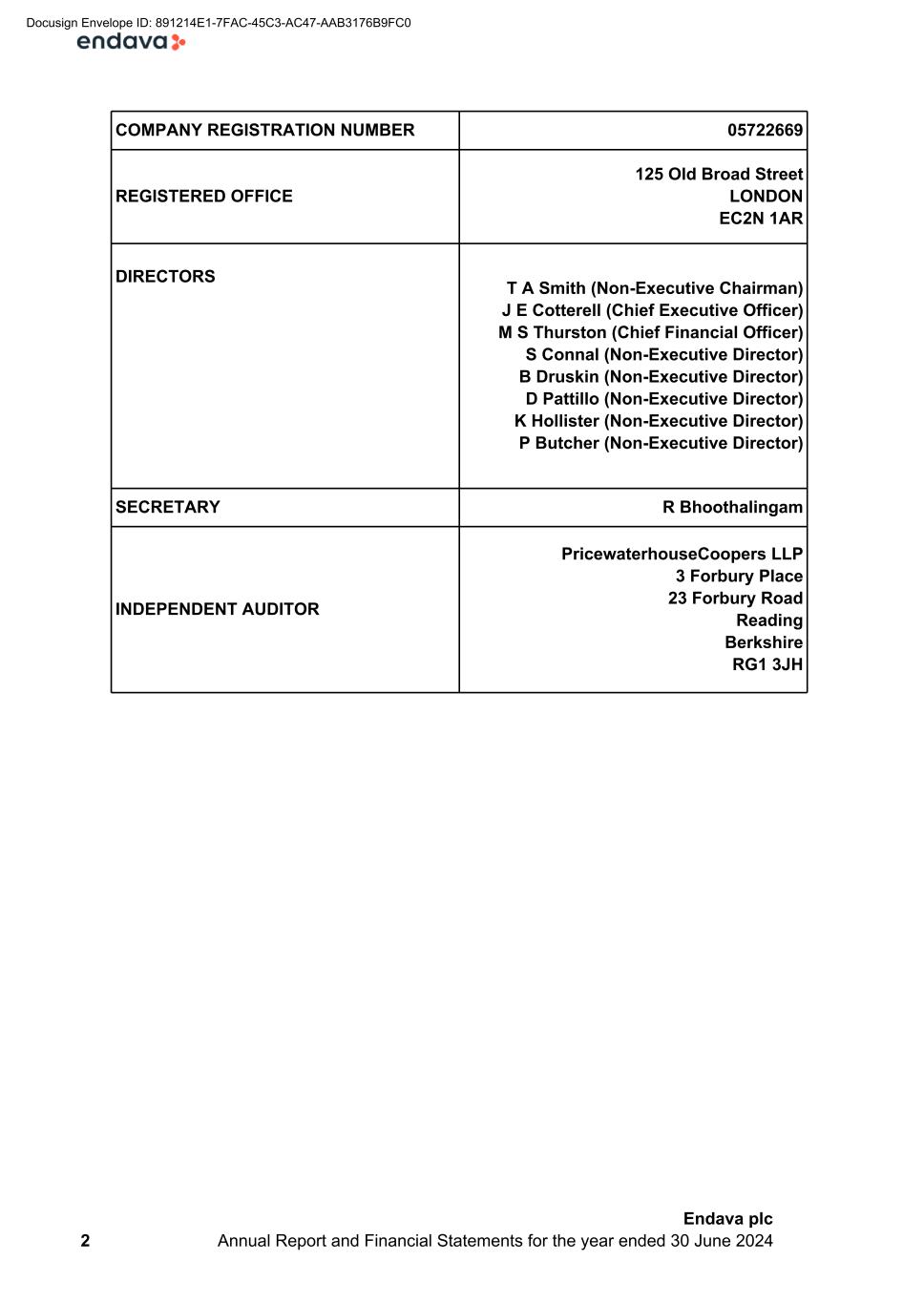
COMPANY REGISTRATION NUMBER 05722669 REGISTERED OFFICE 125 Old Broad Street LONDON EC2N 1AR DIRECTORS T A Smith (Non-Executive Chairman) J E Cotterell (Chief Executive Officer) M S Thurston (Chief Financial Officer) S Connal (Non-Executive Director) B Druskin (Non-Executive Director) D Pattillo (Non-Executive Director) K Hollister (Non-Executive Director) P Butcher (Non-Executive Director) SECRETARY R Bhoothalingam INDEPENDENT AUDITOR PricewaterhouseCoopers LLP 3 Forbury Place 23 Forbury Road Reading Berkshire RG1 3JH 2 Endava plc Annual Report and Financial Statements for the year ended 30 June 2024 Docusign Envelope ID: 891214E1-7FAC-45C3-AC47-AAB3176B9FC0
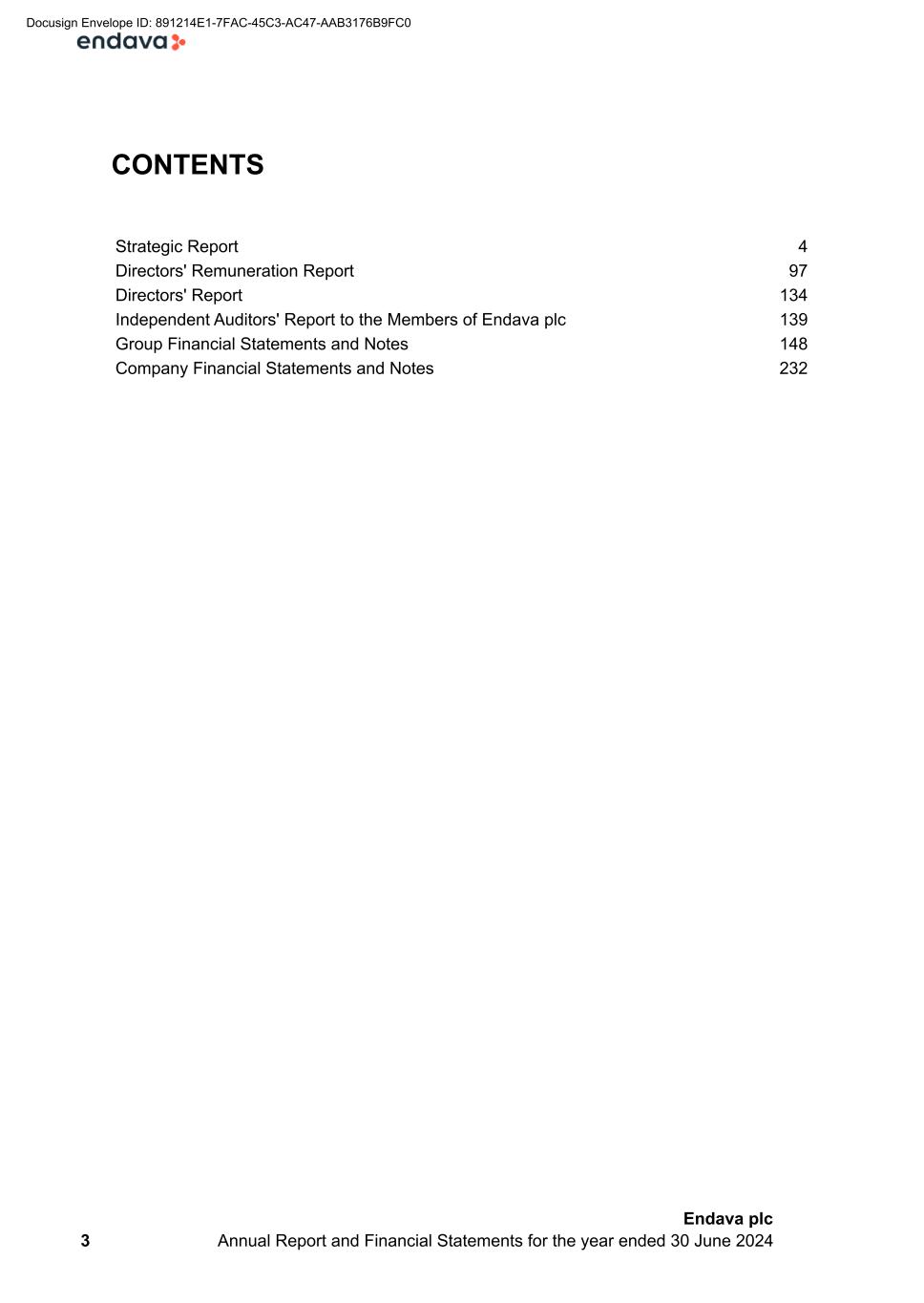
CONTENTS Strategic Report 4 Directors' Remuneration Report 97 Directors' Report 134 Independent Auditors' Report to the Members of Endava plc 139 Group Financial Statements and Notes 148 Company Financial Statements and Notes 232 3 Endava plc Annual Report and Financial Statements for the year ended 30 June 2024 Docusign Envelope ID: 891214E1-7FAC-45C3-AC47-AAB3176B9FC0
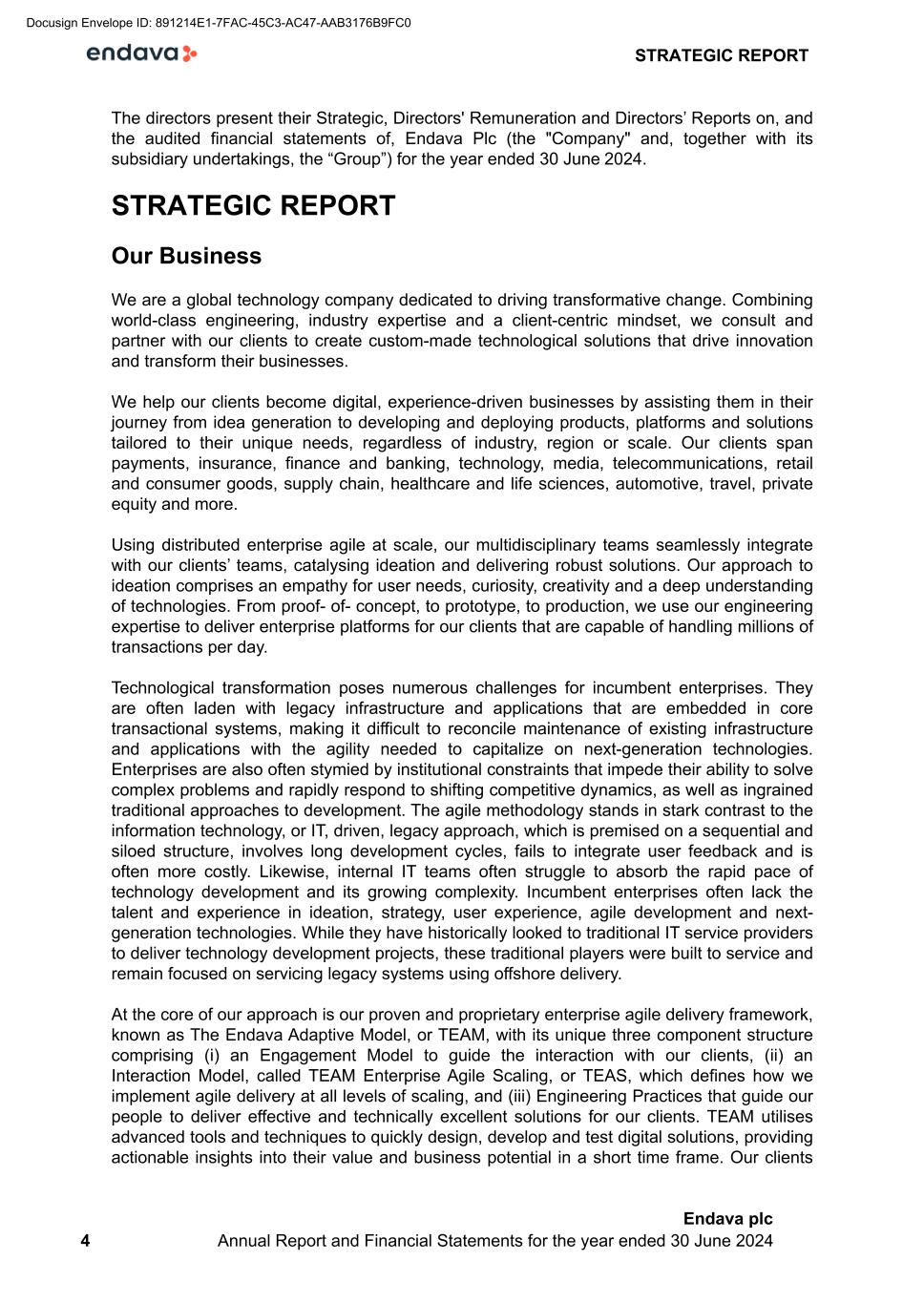
The directors present their Strategic, Directors' Remuneration and Directors’ Reports on, and the audited financial statements of, Endava Plc (the "Company" and, together with its subsidiary undertakings, the “Group”) for the year ended 30 June 2024. STRATEGIC REPORT Our Business We are a global technology company dedicated to driving transformative change. Combining world-class engineering, industry expertise and a client-centric mindset, we consult and partner with our clients to create custom-made technological solutions that drive innovation and transform their businesses. We help our clients become digital, experience-driven businesses by assisting them in their journey from idea generation to developing and deploying products, platforms and solutions tailored to their unique needs, regardless of industry, region or scale. Our clients span payments, insurance, finance and banking, technology, media, telecommunications, retail and consumer goods, supply chain, healthcare and life sciences, automotive, travel, private equity and more. Using distributed enterprise agile at scale, our multidisciplinary teams seamlessly integrate with our clients’ teams, catalysing ideation and delivering robust solutions. Our approach to ideation comprises an empathy for user needs, curiosity, creativity and a deep understanding of technologies. From proof- of- concept, to prototype, to production, we use our engineering expertise to deliver enterprise platforms for our clients that are capable of handling millions of transactions per day. Technological transformation poses numerous challenges for incumbent enterprises. They are often laden with legacy infrastructure and applications that are embedded in core transactional systems, making it difficult to reconcile maintenance of existing infrastructure and applications with the agility needed to capitalize on next-generation technologies. Enterprises are also often stymied by institutional constraints that impede their ability to solve complex problems and rapidly respond to shifting competitive dynamics, as well as ingrained traditional approaches to development. The agile methodology stands in stark contrast to the information technology, or IT, driven, legacy approach, which is premised on a sequential and siloed structure, involves long development cycles, fails to integrate user feedback and is often more costly. Likewise, internal IT teams often struggle to absorb the rapid pace of technology development and its growing complexity. Incumbent enterprises often lack the talent and experience in ideation, strategy, user experience, agile development and next- generation technologies. While they have historically looked to traditional IT service providers to deliver technology development projects, these traditional players were built to service and remain focused on servicing legacy systems using offshore delivery. At the core of our approach is our proven and proprietary enterprise agile delivery framework, known as The Endava Adaptive Model, or TEAM, with its unique three component structure comprising (i) an Engagement Model to guide the interaction with our clients, (ii) an Interaction Model, called TEAM Enterprise Agile Scaling, or TEAS, which defines how we implement agile delivery at all levels of scaling, and (iii) Engineering Practices that guide our people to deliver effective and technically excellent solutions for our clients. TEAM utilises advanced tools and techniques to quickly design, develop and test digital solutions, providing actionable insights into their value and business potential in a short time frame. Our clients STRATEGIC REPORT 4 Endava plc Annual Report and Financial Statements for the year ended 30 June 2024 Docusign Envelope ID: 891214E1-7FAC-45C3-AC47-AAB3176B9FC0
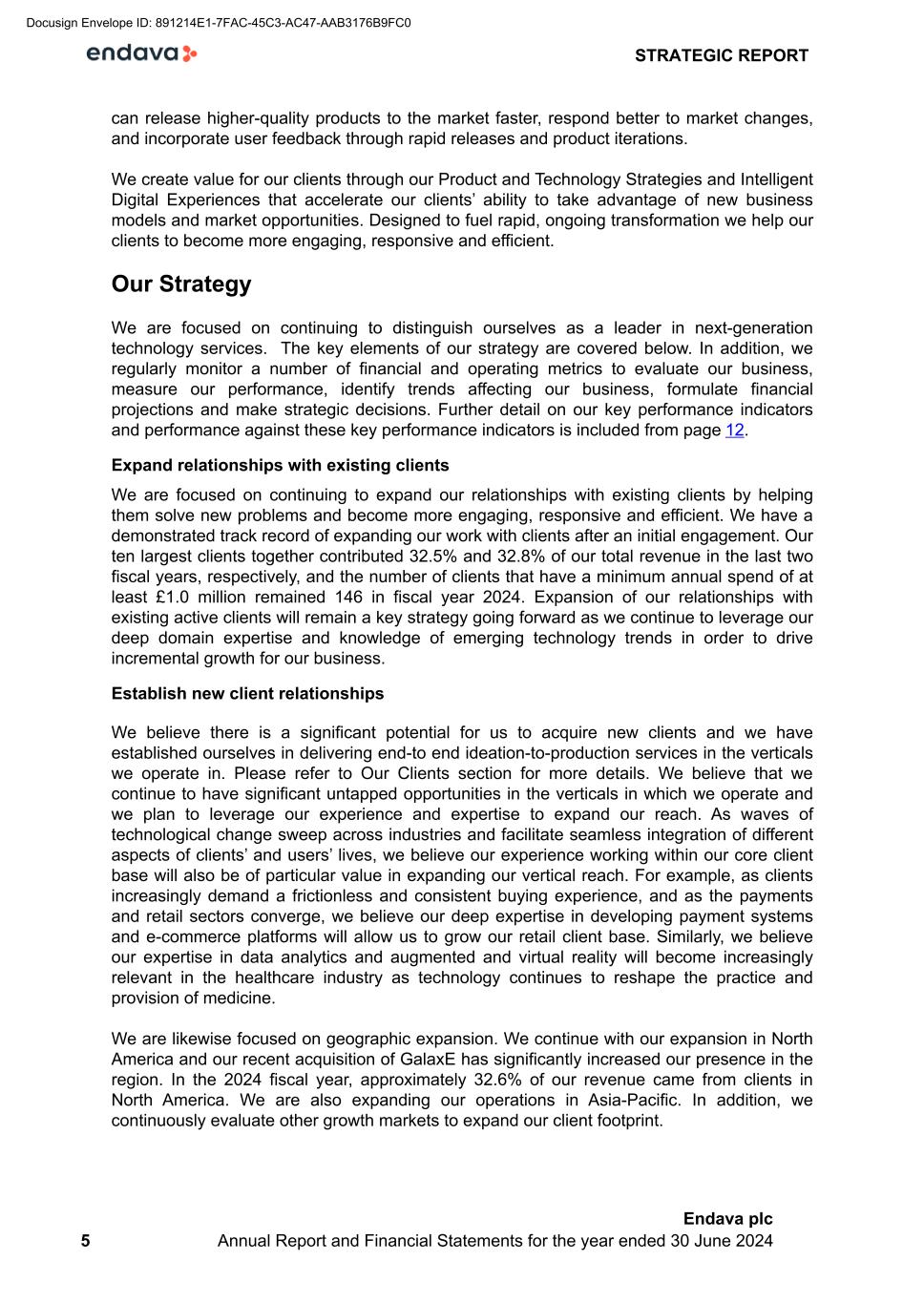
can release higher-quality products to the market faster, respond better to market changes, and incorporate user feedback through rapid releases and product iterations. We create value for our clients through our Product and Technology Strategies and Intelligent Digital Experiences that accelerate our clients’ ability to take advantage of new business models and market opportunities. Designed to fuel rapid, ongoing transformation we help our clients to become more engaging, responsive and efficient. Our Strategy We are focused on continuing to distinguish ourselves as a leader in next-generation technology services. The key elements of our strategy are covered below. In addition, we regularly monitor a number of financial and operating metrics to evaluate our business, measure our performance, identify trends affecting our business, formulate financial projections and make strategic decisions. Further detail on our key performance indicators and performance against these key performance indicators is included from page 12. Expand relationships with existing clients We are focused on continuing to expand our relationships with existing clients by helping them solve new problems and become more engaging, responsive and efficient. We have a demonstrated track record of expanding our work with clients after an initial engagement. Our ten largest clients together contributed 32.5% and 32.8% of our total revenue in the last two fiscal years, respectively, and the number of clients that have a minimum annual spend of at least £1.0 million remained 146 in fiscal year 2024. Expansion of our relationships with existing active clients will remain a key strategy going forward as we continue to leverage our deep domain expertise and knowledge of emerging technology trends in order to drive incremental growth for our business. Establish new client relationships We believe there is a significant potential for us to acquire new clients and we have established ourselves in delivering end-to end ideation-to-production services in the verticals we operate in. Please refer to Our Clients section for more details. We believe that we continue to have significant untapped opportunities in the verticals in which we operate and we plan to leverage our experience and expertise to expand our reach. As waves of technological change sweep across industries and facilitate seamless integration of different aspects of clients’ and users’ lives, we believe our experience working within our core client base will also be of particular value in expanding our vertical reach. For example, as clients increasingly demand a frictionless and consistent buying experience, and as the payments and retail sectors converge, we believe our deep expertise in developing payment systems and e-commerce platforms will allow us to grow our retail client base. Similarly, we believe our expertise in data analytics and augmented and virtual reality will become increasingly relevant in the healthcare industry as technology continues to reshape the practice and provision of medicine. We are likewise focused on geographic expansion. We continue with our expansion in North America and our recent acquisition of GalaxE has significantly increased our presence in the region. In the 2024 fiscal year, approximately 32.6% of our revenue came from clients in North America. We are also expanding our operations in Asia-Pacific. In addition, we continuously evaluate other growth markets to expand our client footprint. STRATEGIC REPORT 5 Endava plc Annual Report and Financial Statements for the year ended 30 June 2024 Docusign Envelope ID: 891214E1-7FAC-45C3-AC47-AAB3176B9FC0
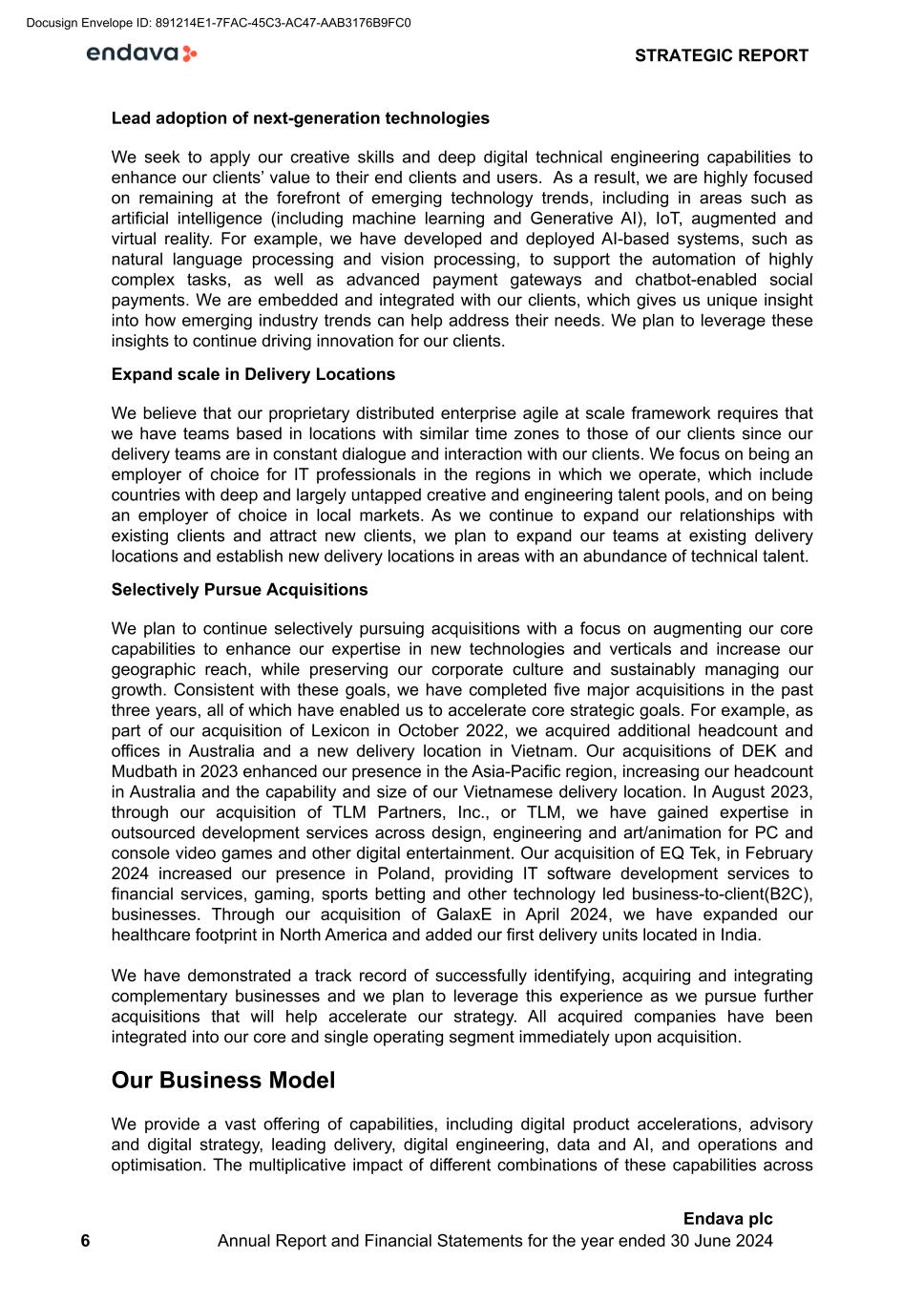
Lead adoption of next-generation technologies We seek to apply our creative skills and deep digital technical engineering capabilities to enhance our clients’ value to their end clients and users. As a result, we are highly focused on remaining at the forefront of emerging technology trends, including in areas such as artificial intelligence (including machine learning and Generative AI), IoT, augmented and virtual reality. For example, we have developed and deployed AI-based systems, such as natural language processing and vision processing, to support the automation of highly complex tasks, as well as advanced payment gateways and chatbot-enabled social payments. We are embedded and integrated with our clients, which gives us unique insight into how emerging industry trends can help address their needs. We plan to leverage these insights to continue driving innovation for our clients. Expand scale in Delivery Locations We believe that our proprietary distributed enterprise agile at scale framework requires that we have teams based in locations with similar time zones to those of our clients since our delivery teams are in constant dialogue and interaction with our clients. We focus on being an employer of choice for IT professionals in the regions in which we operate, which include countries with deep and largely untapped creative and engineering talent pools, and on being an employer of choice in local markets. As we continue to expand our relationships with existing clients and attract new clients, we plan to expand our teams at existing delivery locations and establish new delivery locations in areas with an abundance of technical talent. Selectively Pursue Acquisitions We plan to continue selectively pursuing acquisitions with a focus on augmenting our core capabilities to enhance our expertise in new technologies and verticals and increase our geographic reach, while preserving our corporate culture and sustainably managing our growth. Consistent with these goals, we have completed five major acquisitions in the past three years, all of which have enabled us to accelerate core strategic goals. For example, as part of our acquisition of Lexicon in October 2022, we acquired additional headcount and offices in Australia and a new delivery location in Vietnam. Our acquisitions of DEK and Mudbath in 2023 enhanced our presence in the Asia-Pacific region, increasing our headcount in Australia and the capability and size of our Vietnamese delivery location. In August 2023, through our acquisition of TLM Partners, Inc., or TLM, we have gained expertise in outsourced development services across design, engineering and art/animation for PC and console video games and other digital entertainment. Our acquisition of EQ Tek, in February 2024 increased our presence in Poland, providing IT software development services to financial services, gaming, sports betting and other technology led business-to-client(B2C), businesses. Through our acquisition of GalaxE in April 2024, we have expanded our healthcare footprint in North America and added our first delivery units located in India. We have demonstrated a track record of successfully identifying, acquiring and integrating complementary businesses and we plan to leverage this experience as we pursue further acquisitions that will help accelerate our strategy. All acquired companies have been integrated into our core and single operating segment immediately upon acquisition. Our Business Model We provide a vast offering of capabilities, including digital product accelerations, advisory and digital strategy, leading delivery, digital engineering, data and AI, and operations and optimisation. The multiplicative impact of different combinations of these capabilities across STRATEGIC REPORT 6 Endava plc Annual Report and Financial Statements for the year ended 30 June 2024 Docusign Envelope ID: 891214E1-7FAC-45C3-AC47-AAB3176B9FC0

the delivery of strategies, experiences and engineering allows us to rapidly create real transformation for our clients. These are delivered using top-tier engineering, aiming to assist our clients in enhancing their engagement, responsiveness, and overall efficiency. Our frameworks, methods and tools, including TEAM and TEAS, enhance our ability to develop and deploy solutions based on next-generation technologies. Developed with a focus on providing innovation, quality and productivity at scale, we believe our frameworks, methods and tools allow us to: • Deliver outcome driven programs to our clients, with faster time-to-market and favourable return on investment; • Tailor our approach to the needs of our clients and respond flexibly to changing client objectives and market conditions; • Improve our clients' visibility into budgets, status and progress of technology projects; and • Provide better solutions. We believe the development of a scaled global, nearshore delivery model with selective close-to-client capabilities enables us to deliver high-quality technology services to meet our clients’ needs. Nearshore delivery locations with geographic proximity, cultural affinity and complementary time zones enable increased interaction with our clients, enhance relationships and improve responsiveness for more efficient delivery of our services. As a result, we are able to differentiate ourselves on projects that require a high degree of client collaboration and iteration. STRATEGIC REPORT 7 Endava plc Annual Report and Financial Statements for the year ended 30 June 2024 Docusign Envelope ID: 891214E1-7FAC-45C3-AC47-AAB3176B9FC0
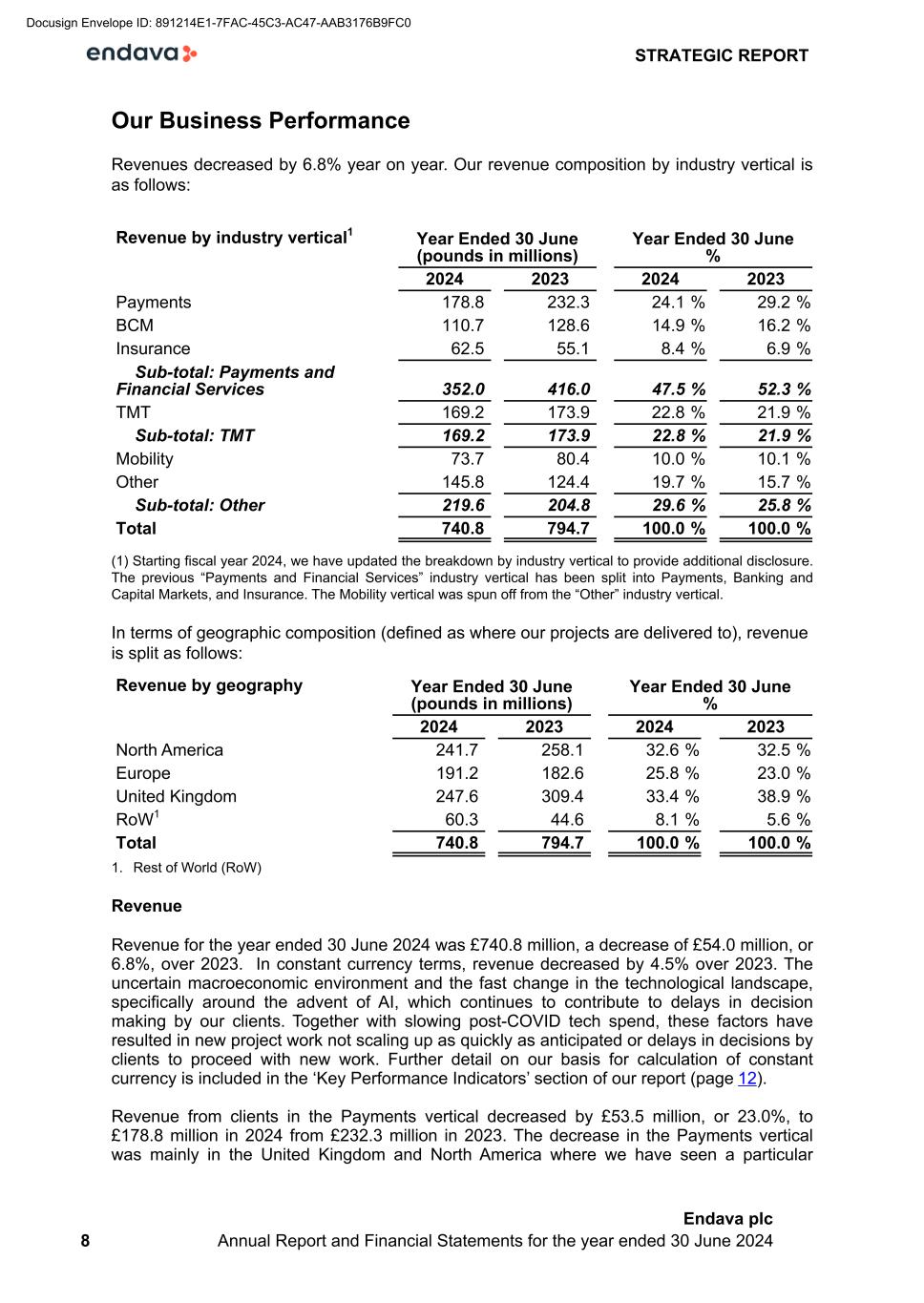
Our Business Performance Revenues decreased by 6.8% year on year. Our revenue composition by industry vertical is as follows: Revenue by industry vertical1 Year Ended 30 June (pounds in millions) Year Ended 30 June % 2024 2023 2024 2023 Payments 178.8 232.3 24.1 % 29.2 % BCM 110.7 128.6 14.9 % 16.2 % Insurance 62.5 55.1 8.4 % 6.9 % Sub-total: Payments and Financial Services 352.0 416.0 47.5 % 52.3 % TMT 169.2 173.9 22.8 % 21.9 % Sub-total: TMT 169.2 173.9 22.8 % 21.9 % Mobility 73.7 80.4 10.0 % 10.1 % Other 145.8 124.4 19.7 % 15.7 % Sub-total: Other 219.6 204.8 29.6 % 25.8 % Total 740.8 794.7 100.0 % 100.0 % (1) Starting fiscal year 2024, we have updated the breakdown by industry vertical to provide additional disclosure. The previous “Payments and Financial Services” industry vertical has been split into Payments, Banking and Capital Markets, and Insurance. The Mobility vertical was spun off from the “Other” industry vertical. In terms of geographic composition (defined as where our projects are delivered to), revenue is split as follows: Revenue by geography Year Ended 30 June (pounds in millions) Year Ended 30 June % 2024 2023 2024 2023 North America 241.7 258.1 32.6 % 32.5 % Europe 191.2 182.6 25.8 % 23.0 % United Kingdom 247.6 309.4 33.4 % 38.9 % RoW1 60.3 44.6 8.1 % 5.6 % Total 740.8 794.7 100.0 % 100.0 % 1. Rest of World (RoW) Revenue Revenue for the year ended 30 June 2024 was £740.8 million, a decrease of £54.0 million, or 6.8%, over 2023. In constant currency terms, revenue decreased by 4.5% over 2023. The uncertain macroeconomic environment and the fast change in the technological landscape, specifically around the advent of AI, which continues to contribute to delays in decision making by our clients. Together with slowing post-COVID tech spend, these factors have resulted in new project work not scaling up as quickly as anticipated or delays in decisions by clients to proceed with new work. Further detail on our basis for calculation of constant currency is included in the ‘Key Performance Indicators’ section of our report (page 12). Revenue from clients in the Payments vertical decreased by £53.5 million, or 23.0%, to £178.8 million in 2024 from £232.3 million in 2023. The decrease in the Payments vertical was mainly in the United Kingdom and North America where we have seen a particular STRATEGIC REPORT 8 Endava plc Annual Report and Financial Statements for the year ended 30 June 2024 Docusign Envelope ID: 891214E1-7FAC-45C3-AC47-AAB3176B9FC0
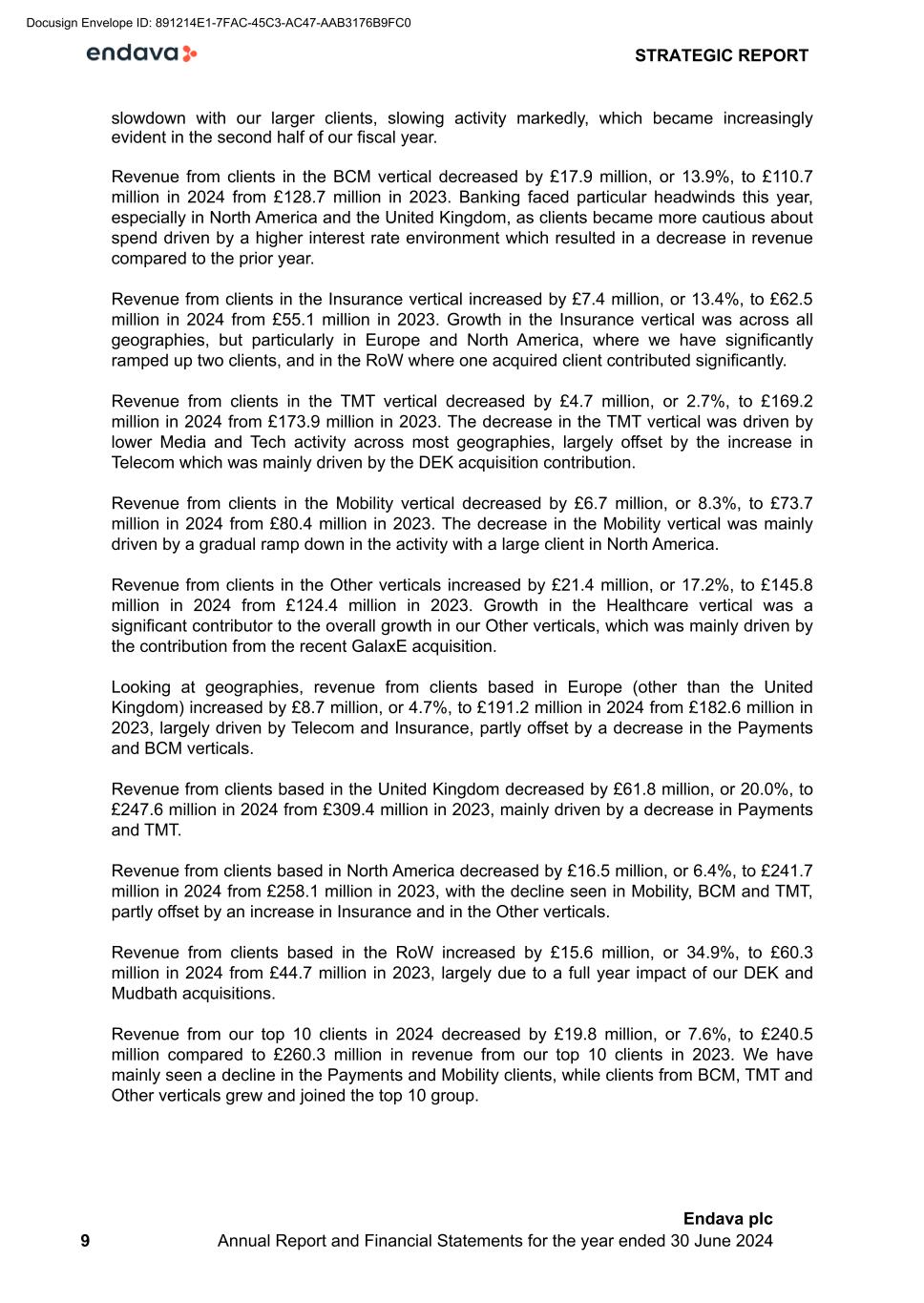
slowdown with our larger clients, slowing activity markedly, which became increasingly evident in the second half of our fiscal year. Revenue from clients in the BCM vertical decreased by £17.9 million, or 13.9%, to £110.7 million in 2024 from £128.7 million in 2023. Banking faced particular headwinds this year, especially in North America and the United Kingdom, as clients became more cautious about spend driven by a higher interest rate environment which resulted in a decrease in revenue compared to the prior year. Revenue from clients in the Insurance vertical increased by £7.4 million, or 13.4%, to £62.5 million in 2024 from £55.1 million in 2023. Growth in the Insurance vertical was across all geographies, but particularly in Europe and North America, where we have significantly ramped up two clients, and in the RoW where one acquired client contributed significantly. Revenue from clients in the TMT vertical decreased by £4.7 million, or 2.7%, to £169.2 million in 2024 from £173.9 million in 2023. The decrease in the TMT vertical was driven by lower Media and Tech activity across most geographies, largely offset by the increase in Telecom which was mainly driven by the DEK acquisition contribution. Revenue from clients in the Mobility vertical decreased by £6.7 million, or 8.3%, to £73.7 million in 2024 from £80.4 million in 2023. The decrease in the Mobility vertical was mainly driven by a gradual ramp down in the activity with a large client in North America. Revenue from clients in the Other verticals increased by £21.4 million, or 17.2%, to £145.8 million in 2024 from £124.4 million in 2023. Growth in the Healthcare vertical was a significant contributor to the overall growth in our Other verticals, which was mainly driven by the contribution from the recent GalaxE acquisition. Looking at geographies, revenue from clients based in Europe (other than the United Kingdom) increased by £8.7 million, or 4.7%, to £191.2 million in 2024 from £182.6 million in 2023, largely driven by Telecom and Insurance, partly offset by a decrease in the Payments and BCM verticals. Revenue from clients based in the United Kingdom decreased by £61.8 million, or 20.0%, to £247.6 million in 2024 from £309.4 million in 2023, mainly driven by a decrease in Payments and TMT. Revenue from clients based in North America decreased by £16.5 million, or 6.4%, to £241.7 million in 2024 from £258.1 million in 2023, with the decline seen in Mobility, BCM and TMT, partly offset by an increase in Insurance and in the Other verticals. Revenue from clients based in the RoW increased by £15.6 million, or 34.9%, to £60.3 million in 2024 from £44.7 million in 2023, largely due to a full year impact of our DEK and Mudbath acquisitions. Revenue from our top 10 clients in 2024 decreased by £19.8 million, or 7.6%, to £240.5 million compared to £260.3 million in revenue from our top 10 clients in 2023. We have mainly seen a decline in the Payments and Mobility clients, while clients from BCM, TMT and Other verticals grew and joined the top 10 group. STRATEGIC REPORT 9 Endava plc Annual Report and Financial Statements for the year ended 30 June 2024 Docusign Envelope ID: 891214E1-7FAC-45C3-AC47-AAB3176B9FC0
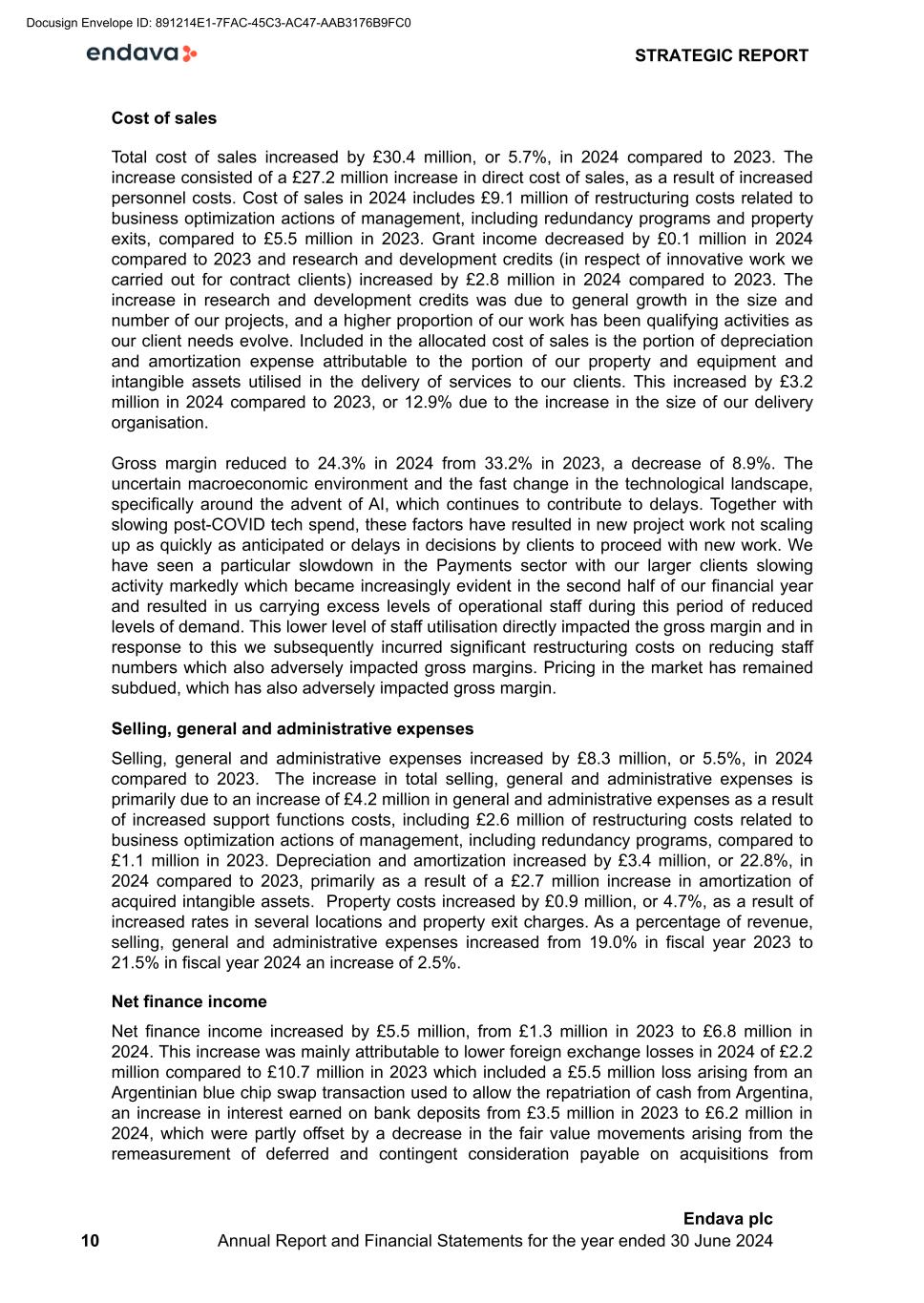
Cost of sales Total cost of sales increased by £30.4 million, or 5.7%, in 2024 compared to 2023. The increase consisted of a £27.2 million increase in direct cost of sales, as a result of increased personnel costs. Cost of sales in 2024 includes £9.1 million of restructuring costs related to business optimization actions of management, including redundancy programs and property exits, compared to £5.5 million in 2023. Grant income decreased by £0.1 million in 2024 compared to 2023 and research and development credits (in respect of innovative work we carried out for contract clients) increased by £2.8 million in 2024 compared to 2023. The increase in research and development credits was due to general growth in the size and number of our projects, and a higher proportion of our work has been qualifying activities as our client needs evolve. Included in the allocated cost of sales is the portion of depreciation and amortization expense attributable to the portion of our property and equipment and intangible assets utilised in the delivery of services to our clients. This increased by £3.2 million in 2024 compared to 2023, or 12.9% due to the increase in the size of our delivery organisation. Gross margin reduced to 24.3% in 2024 from 33.2% in 2023, a decrease of 8.9%. The uncertain macroeconomic environment and the fast change in the technological landscape, specifically around the advent of AI, which continues to contribute to delays. Together with slowing post-COVID tech spend, these factors have resulted in new project work not scaling up as quickly as anticipated or delays in decisions by clients to proceed with new work. We have seen a particular slowdown in the Payments sector with our larger clients slowing activity markedly which became increasingly evident in the second half of our financial year and resulted in us carrying excess levels of operational staff during this period of reduced levels of demand. This lower level of staff utilisation directly impacted the gross margin and in response to this we subsequently incurred significant restructuring costs on reducing staff numbers which also adversely impacted gross margins. Pricing in the market has remained subdued, which has also adversely impacted gross margin. Selling, general and administrative expenses Selling, general and administrative expenses increased by £8.3 million, or 5.5%, in 2024 compared to 2023. The increase in total selling, general and administrative expenses is primarily due to an increase of £4.2 million in general and administrative expenses as a result of increased support functions costs, including £2.6 million of restructuring costs related to business optimization actions of management, including redundancy programs, compared to £1.1 million in 2023. Depreciation and amortization increased by £3.4 million, or 22.8%, in 2024 compared to 2023, primarily as a result of a £2.7 million increase in amortization of acquired intangible assets. Property costs increased by £0.9 million, or 4.7%, as a result of increased rates in several locations and property exit charges. As a percentage of revenue, selling, general and administrative expenses increased from 19.0% in fiscal year 2023 to 21.5% in fiscal year 2024 an increase of 2.5%. Net finance income Net finance income increased by £5.5 million, from £1.3 million in 2023 to £6.8 million in 2024. This increase was mainly attributable to lower foreign exchange losses in 2024 of £2.2 million compared to £10.7 million in 2023 which included a £5.5 million loss arising from an Argentinian blue chip swap transaction used to allow the repatriation of cash from Argentina, an increase in interest earned on bank deposits from £3.5 million in 2023 to £6.2 million in 2024, which were partly offset by a decrease in the fair value movements arising from the remeasurement of deferred and contingent consideration payable on acquisitions from STRATEGIC REPORT 10 Endava plc Annual Report and Financial Statements for the year ended 30 June 2024 Docusign Envelope ID: 891214E1-7FAC-45C3-AC47-AAB3176B9FC0

£11.8 million, including discount unwind, in 2023 to £9.1 million in 2024, and additional interest payable on the revolving credit facility drawn down in 2024 of £2.2 million. Provision for income taxes Provision for income taxes decreased by £10.1 million, or 50.7%, in 2024 compared to 2023. Our annual effective tax rate for 2024 was 36.5%, compared to an annual effective tax rate of 17.5% for 2023. As set out in note 11 to the financial statements, the 2024 rate was impacted by the use of U.K. tax losses in earlier periods when the tax rate was lower, resulting in the write off of a deferred tax asset, a true up to the prior year U.K. current tax position and also the write off of share-based payments deferred tax assets as a result of the decrease in the Endava share price. Profit before tax Our profit before taxes was £27.0 million and £114.2 million for the financial years ended 30 June 2024 and 30 June 2023 respectively. Our profit before taxes as a percentage of revenue was 3.6% and 14.4% respectively, for the same periods. Liquidity and capital resources Net current assets decreased to £113.8 million as at 30 June 2024 from net current assets of £227.4 million as at 30 June 2023. To date, we have financed our operations primarily through sales of information technology services, as well as borrowings under our revolving credit facilities and through our initial public offering, which we completed in July 2018. As of 30 June 2024, we had £62.4 million in cash and cash equivalents. In February 2023, we entered into a Multicurrency Revolving Facility Agreement, or the Facility Agreement, with National Westminster Bank plc as agent, HSBC UK Bank plc, DNB (UK) Limited, Keybank National Association, Banco Bilbao Vizcaya Argentaria, S.A., London Branch and Fifth Third Bank, National Association as mandated lead arrangers, bookrunners and original lenders. The Facility Agreement, which replaced our previous £200.0 million unsecured facility, is an unsecured revolving credit facility in the amount of £350.0 million with a term of four years. The Facility Agreement also provides for uncommitted accordion options for up to an aggregate of £150.0 million in additional borrowing. The Facility Agreement contains customary representations and warranties and customary default provisions, affirmative and negative covenants applicable to the facility parties and our consolidated subsidiaries. As of 30 June 2024, there was £144.8 million outstanding under the £350.0 million primary facility including £2.2 million utilised for bank guarantees issued by HSBC UK Bank plc, and we were not in breach of any covenants. Cashflows Operating activities provided £54.4 million of cash in the year ended 30 June 2024, primarily from profit before tax of £27.0 million and other non-cash items of £57.8 million, a U.K. research and development credit received of £0.5 million offset by tax paid of £14.3 million and adverse net movement in working capital of £16.6 million. The net changes in working capital were primarily driven by a decrease in accruals of £18.7 million, a net decrease in trade receivables and accrued income of £8.2 million, an increase in prepayments of £1.7 million, a decrease in trade payables and deferred income of £4.9 million and a net increase in other debtors and creditors of £0.5 million. STRATEGIC REPORT 11 Endava plc Annual Report and Financial Statements for the year ended 30 June 2024 Docusign Envelope ID: 891214E1-7FAC-45C3-AC47-AAB3176B9FC0
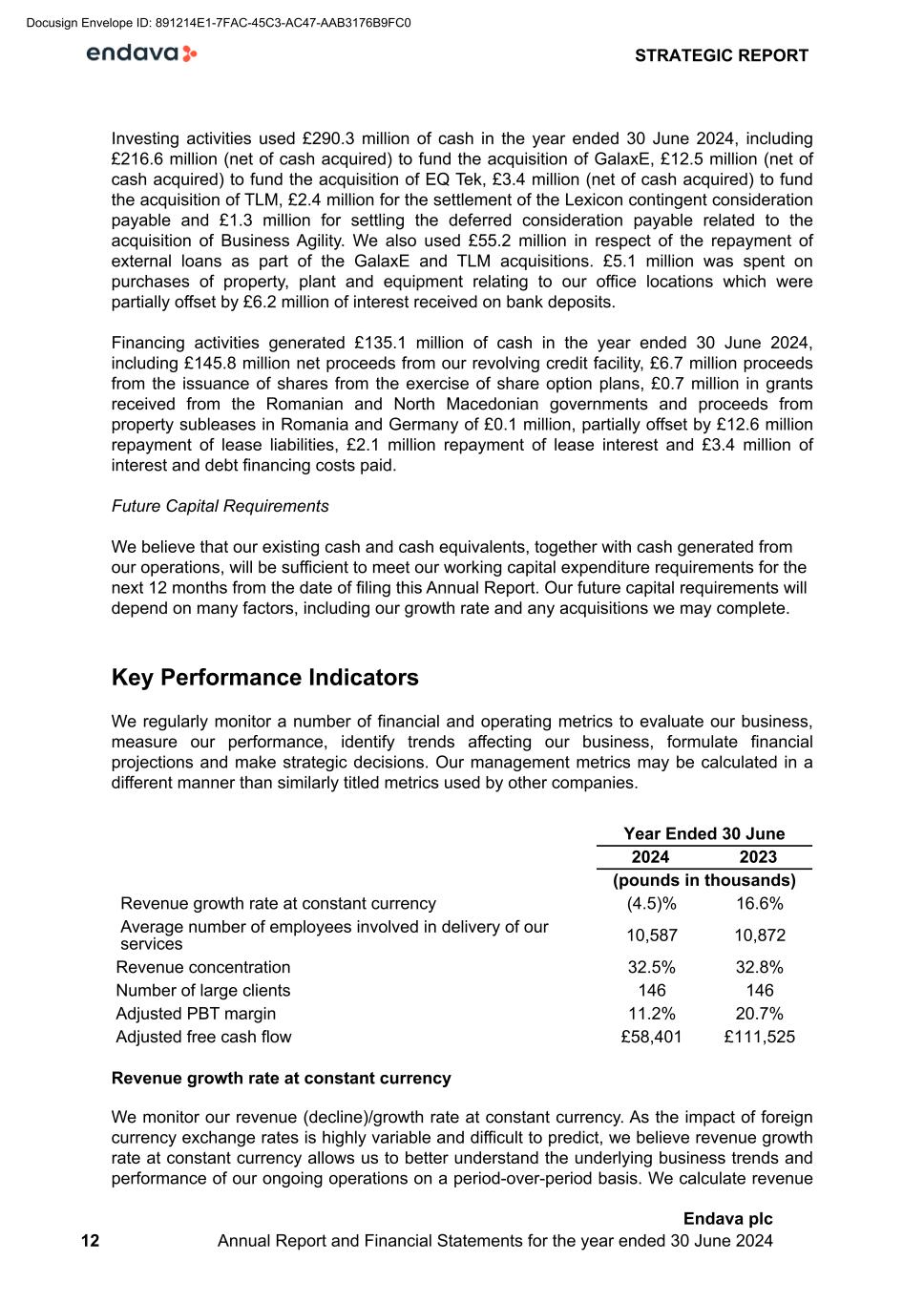
Investing activities used £290.3 million of cash in the year ended 30 June 2024, including £216.6 million (net of cash acquired) to fund the acquisition of GalaxE, £12.5 million (net of cash acquired) to fund the acquisition of EQ Tek, £3.4 million (net of cash acquired) to fund the acquisition of TLM, £2.4 million for the settlement of the Lexicon contingent consideration payable and £1.3 million for settling the deferred consideration payable related to the acquisition of Business Agility. We also used £55.2 million in respect of the repayment of external loans as part of the GalaxE and TLM acquisitions. £5.1 million was spent on purchases of property, plant and equipment relating to our office locations which were partially offset by £6.2 million of interest received on bank deposits. Financing activities generated £135.1 million of cash in the year ended 30 June 2024, including £145.8 million net proceeds from our revolving credit facility, £6.7 million proceeds from the issuance of shares from the exercise of share option plans, £0.7 million in grants received from the Romanian and North Macedonian governments and proceeds from property subleases in Romania and Germany of £0.1 million, partially offset by £12.6 million repayment of lease liabilities, £2.1 million repayment of lease interest and £3.4 million of interest and debt financing costs paid. Future Capital Requirements We believe that our existing cash and cash equivalents, together with cash generated from our operations, will be sufficient to meet our working capital expenditure requirements for the next 12 months from the date of filing this Annual Report. Our future capital requirements will depend on many factors, including our growth rate and any acquisitions we may complete. Key Performance Indicators We regularly monitor a number of financial and operating metrics to evaluate our business, measure our performance, identify trends affecting our business, formulate financial projections and make strategic decisions. Our management metrics may be calculated in a different manner than similarly titled metrics used by other companies. Year Ended 30 June 2024 2023 (pounds in thousands) Revenue growth rate at constant currency (4.5)% 16.6% Average number of employees involved in delivery of our services 10,587 10,872 Revenue concentration 32.5% 32.8% Number of large clients 146 146 Adjusted PBT margin 11.2% 20.7% Adjusted free cash flow £58,401 £111,525 Revenue growth rate at constant currency We monitor our revenue (decline)/growth rate at constant currency. As the impact of foreign currency exchange rates is highly variable and difficult to predict, we believe revenue growth rate at constant currency allows us to better understand the underlying business trends and performance of our ongoing operations on a period-over-period basis. We calculate revenue STRATEGIC REPORT 12 Endava plc Annual Report and Financial Statements for the year ended 30 June 2024 Docusign Envelope ID: 891214E1-7FAC-45C3-AC47-AAB3176B9FC0
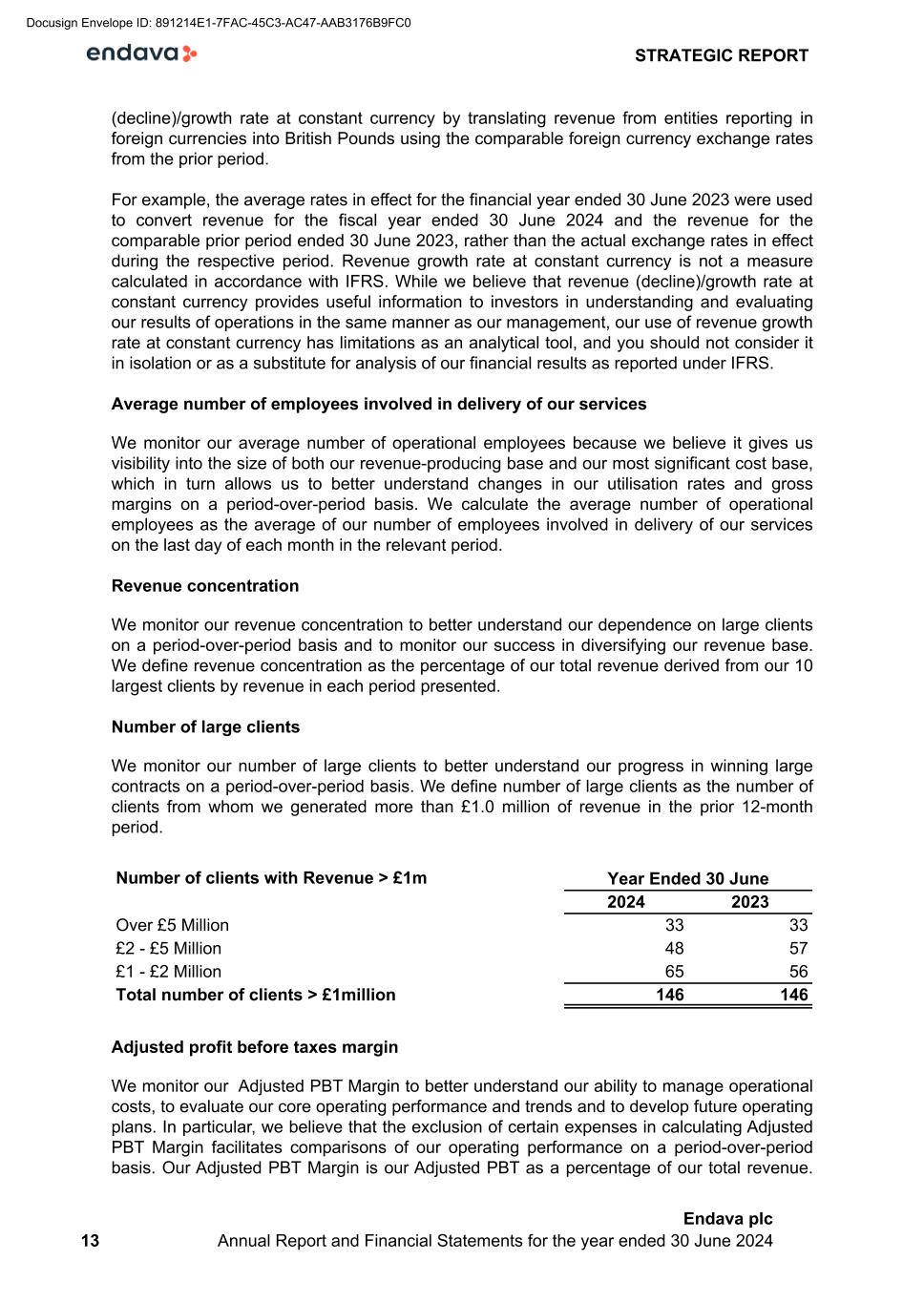
(decline)/growth rate at constant currency by translating revenue from entities reporting in foreign currencies into British Pounds using the comparable foreign currency exchange rates from the prior period. For example, the average rates in effect for the financial year ended 30 June 2023 were used to convert revenue for the fiscal year ended 30 June 2024 and the revenue for the comparable prior period ended 30 June 2023, rather than the actual exchange rates in effect during the respective period. Revenue growth rate at constant currency is not a measure calculated in accordance with IFRS. While we believe that revenue (decline)/growth rate at constant currency provides useful information to investors in understanding and evaluating our results of operations in the same manner as our management, our use of revenue growth rate at constant currency has limitations as an analytical tool, and you should not consider it in isolation or as a substitute for analysis of our financial results as reported under IFRS. Average number of employees involved in delivery of our services We monitor our average number of operational employees because we believe it gives us visibility into the size of both our revenue-producing base and our most significant cost base, which in turn allows us to better understand changes in our utilisation rates and gross margins on a period-over-period basis. We calculate the average number of operational employees as the average of our number of employees involved in delivery of our services on the last day of each month in the relevant period. Revenue concentration We monitor our revenue concentration to better understand our dependence on large clients on a period-over-period basis and to monitor our success in diversifying our revenue base. We define revenue concentration as the percentage of our total revenue derived from our 10 largest clients by revenue in each period presented. Number of large clients We monitor our number of large clients to better understand our progress in winning large contracts on a period-over-period basis. We define number of large clients as the number of clients from whom we generated more than £1.0 million of revenue in the prior 12-month period. Number of clients with Revenue > £1m Year Ended 30 June 2024 2023 Over £5 Million 33 33 £2 - £5 Million 48 57 £1 - £2 Million 65 56 Total number of clients > £1million 146 146 Adjusted profit before taxes margin We monitor our Adjusted PBT Margin to better understand our ability to manage operational costs, to evaluate our core operating performance and trends and to develop future operating plans. In particular, we believe that the exclusion of certain expenses in calculating Adjusted PBT Margin facilitates comparisons of our operating performance on a period-over-period basis. Our Adjusted PBT Margin is our Adjusted PBT as a percentage of our total revenue. STRATEGIC REPORT 13 Endava plc Annual Report and Financial Statements for the year ended 30 June 2024 Docusign Envelope ID: 891214E1-7FAC-45C3-AC47-AAB3176B9FC0
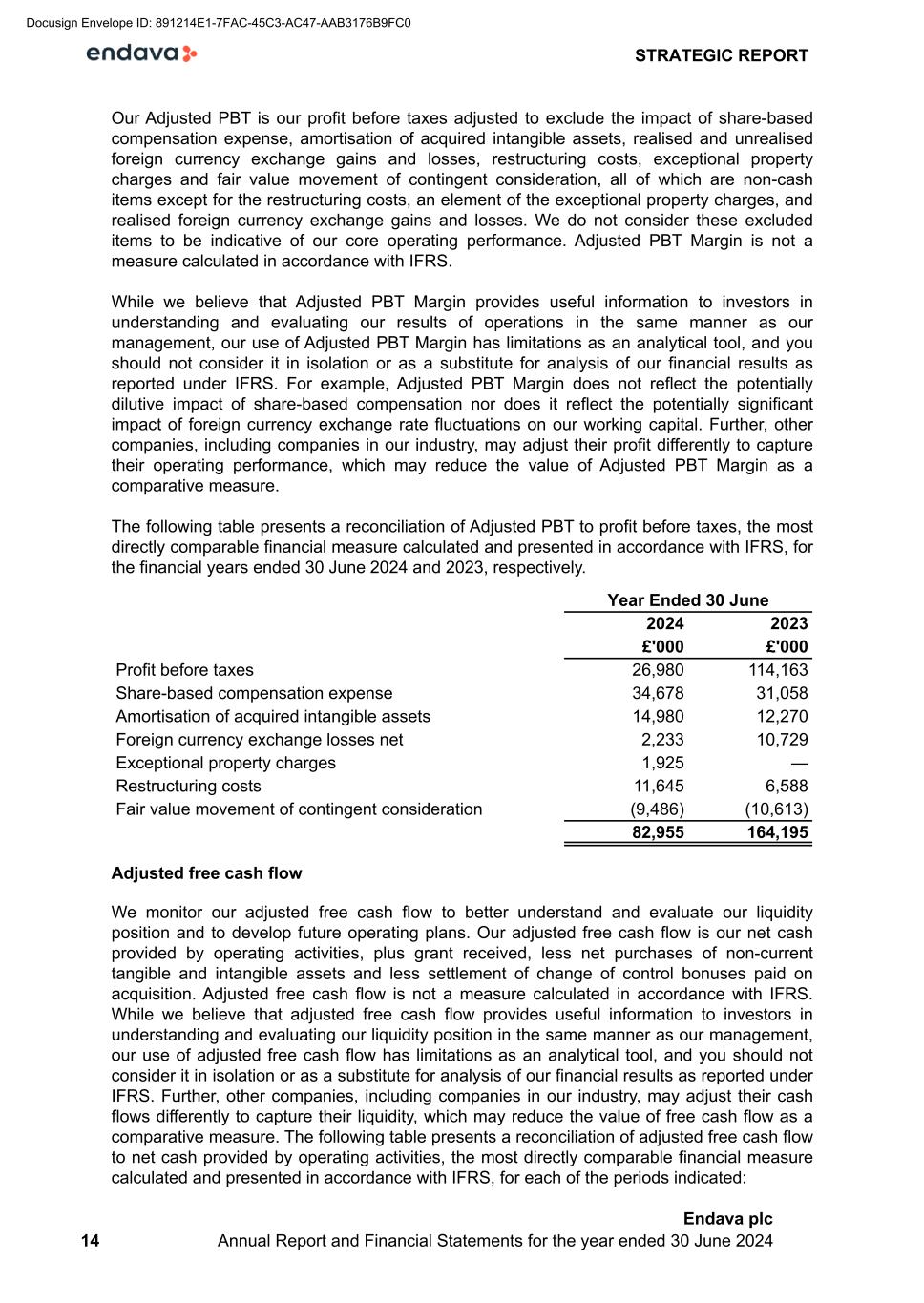
Our Adjusted PBT is our profit before taxes adjusted to exclude the impact of share-based compensation expense, amortisation of acquired intangible assets, realised and unrealised foreign currency exchange gains and losses, restructuring costs, exceptional property charges and fair value movement of contingent consideration, all of which are non-cash items except for the restructuring costs, an element of the exceptional property charges, and realised foreign currency exchange gains and losses. We do not consider these excluded items to be indicative of our core operating performance. Adjusted PBT Margin is not a measure calculated in accordance with IFRS. While we believe that Adjusted PBT Margin provides useful information to investors in understanding and evaluating our results of operations in the same manner as our management, our use of Adjusted PBT Margin has limitations as an analytical tool, and you should not consider it in isolation or as a substitute for analysis of our financial results as reported under IFRS. For example, Adjusted PBT Margin does not reflect the potentially dilutive impact of share-based compensation nor does it reflect the potentially significant impact of foreign currency exchange rate fluctuations on our working capital. Further, other companies, including companies in our industry, may adjust their profit differently to capture their operating performance, which may reduce the value of Adjusted PBT Margin as a comparative measure. The following table presents a reconciliation of Adjusted PBT to profit before taxes, the most directly comparable financial measure calculated and presented in accordance with IFRS, for the financial years ended 30 June 2024 and 2023, respectively. Year Ended 30 June 2024 2023 £'000 £'000 Profit before taxes 26,980 114,163 Share-based compensation expense 34,678 31,058 Amortisation of acquired intangible assets 14,980 12,270 Foreign currency exchange losses net 2,233 10,729 Exceptional property charges 1,925 — Restructuring costs 11,645 6,588 Fair value movement of contingent consideration (9,486) (10,613) 82,955 164,195 Adjusted free cash flow We monitor our adjusted free cash flow to better understand and evaluate our liquidity position and to develop future operating plans. Our adjusted free cash flow is our net cash provided by operating activities, plus grant received, less net purchases of non-current tangible and intangible assets and less settlement of change of control bonuses paid on acquisition. Adjusted free cash flow is not a measure calculated in accordance with IFRS. While we believe that adjusted free cash flow provides useful information to investors in understanding and evaluating our liquidity position in the same manner as our management, our use of adjusted free cash flow has limitations as an analytical tool, and you should not consider it in isolation or as a substitute for analysis of our financial results as reported under IFRS. Further, other companies, including companies in our industry, may adjust their cash flows differently to capture their liquidity, which may reduce the value of free cash flow as a comparative measure. The following table presents a reconciliation of adjusted free cash flow to net cash provided by operating activities, the most directly comparable financial measure calculated and presented in accordance with IFRS, for each of the periods indicated: STRATEGIC REPORT 14 Endava plc Annual Report and Financial Statements for the year ended 30 June 2024 Docusign Envelope ID: 891214E1-7FAC-45C3-AC47-AAB3176B9FC0
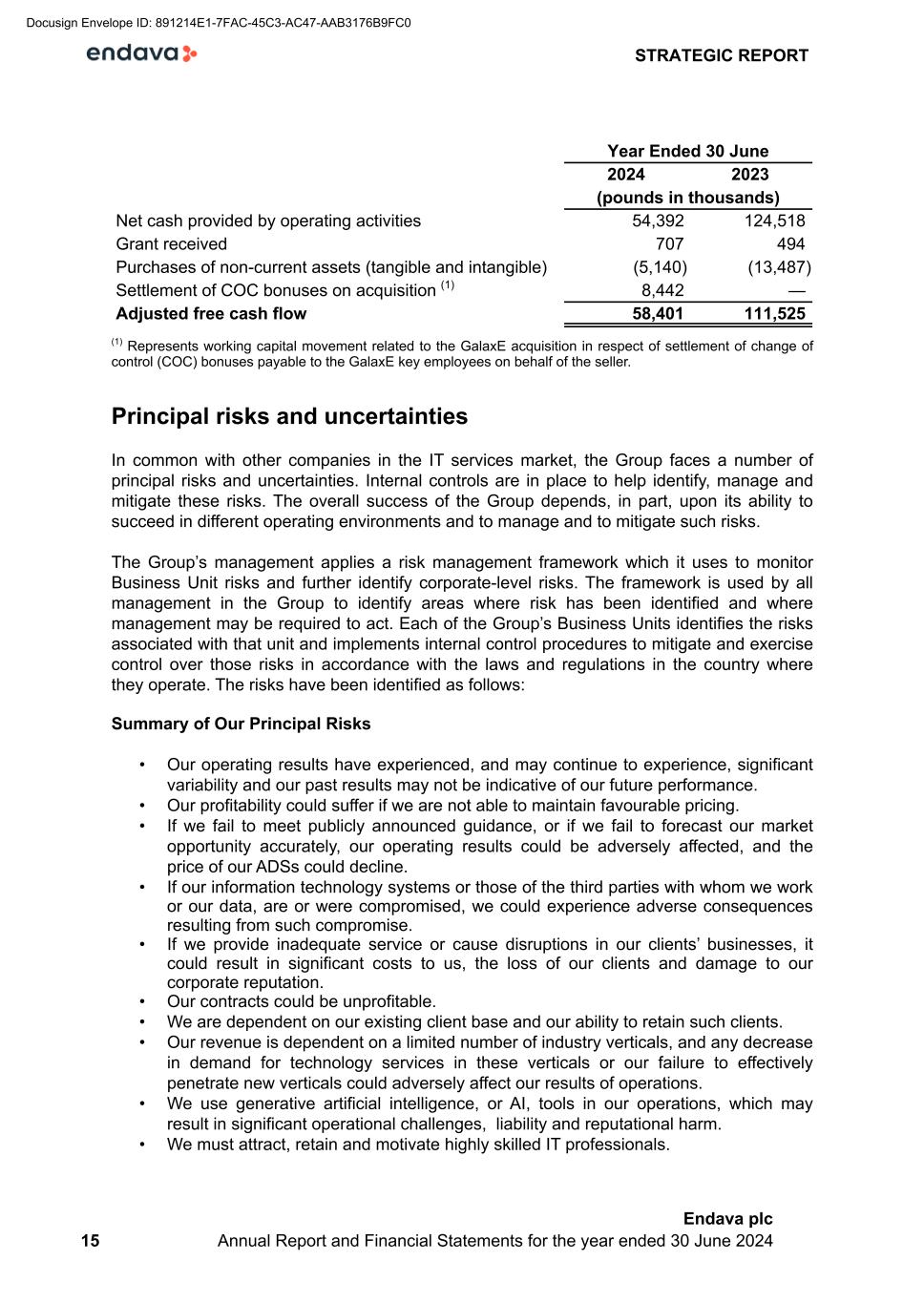
Year Ended 30 June 2024 2023 (pounds in thousands) Net cash provided by operating activities 54,392 124,518 Grant received 707 494 Purchases of non-current assets (tangible and intangible) (5,140) (13,487) Settlement of COC bonuses on acquisition (1) 8,442 — Adjusted free cash flow 58,401 111,525 (1) Represents working capital movement related to the GalaxE acquisition in respect of settlement of change of control (COC) bonuses payable to the GalaxE key employees on behalf of the seller. Principal risks and uncertainties In common with other companies in the IT services market, the Group faces a number of principal risks and uncertainties. Internal controls are in place to help identify, manage and mitigate these risks. The overall success of the Group depends, in part, upon its ability to succeed in different operating environments and to manage and to mitigate such risks. The Group’s management applies a risk management framework which it uses to monitor Business Unit risks and further identify corporate-level risks. The framework is used by all management in the Group to identify areas where risk has been identified and where management may be required to act. Each of the Group’s Business Units identifies the risks associated with that unit and implements internal control procedures to mitigate and exercise control over those risks in accordance with the laws and regulations in the country where they operate. The risks have been identified as follows: Summary of Our Principal Risks • Our operating results have experienced, and may continue to experience, significant variability and our past results may not be indicative of our future performance. • Our profitability could suffer if we are not able to maintain favourable pricing. • If we fail to meet publicly announced guidance, or if we fail to forecast our market opportunity accurately, our operating results could be adversely affected, and the price of our ADSs could decline. • If our information technology systems or those of the third parties with whom we work or our data, are or were compromised, we could experience adverse consequences resulting from such compromise. • If we provide inadequate service or cause disruptions in our clients’ businesses, it could result in significant costs to us, the loss of our clients and damage to our corporate reputation. • Our contracts could be unprofitable. • We are dependent on our existing client base and our ability to retain such clients. • Our revenue is dependent on a limited number of industry verticals, and any decrease in demand for technology services in these verticals or our failure to effectively penetrate new verticals could adversely affect our results of operations. • We use generative artificial intelligence, or AI, tools in our operations, which may result in significant operational challenges, liability and reputational harm. • We must attract, retain and motivate highly skilled IT professionals. STRATEGIC REPORT 15 Endava plc Annual Report and Financial Statements for the year ended 30 June 2024 Docusign Envelope ID: 891214E1-7FAC-45C3-AC47-AAB3176B9FC0

• We are focused on growing our client base in North America and Europe and may not be successful. • If we do not continue to innovate and remain at the forefront of emerging technologies and related market trends, we may lose clients and not remain competitive. • We are dependent on members of our senior management team and other key employees. • Our business may suffer if we fail to identify and acquire appropriate acquisition targets, and recently completed and potential future acquisitions could prove difficult to integrate or may disrupt our business, dilute shareholder value, strain our resources or otherwise adversely affect our business, financial condition or results of operations. • The terms of our revolving credit facility and any further debt we incur may affect our ability to operate our business or secure additional financing in the future. • We have in the past experienced, and may in the future experience, a long selling and implementation cycle with respect to certain projects that require us to make significant resource commitments prior to recognising revenue for our services. • Our business depends on a strong brand and corporate reputation. • We generally do not have long-term commitments from our clients, and our clients may terminate engagements before completion or choose not to enter into new engagements with us. • We have significant fixed costs related to lease facilities and may incur additional expense as we adapt our facilities in response to our transition to a hybrid working model. • We may not receive sufficient intellectual property rights from our employees and contractors to comply with our obligations to our clients and we may not be able to prevent unauthorised use of our intellectual property. • We use software, hardware and software-as-a-service, or SaaS, technologies from third parties that may be difficult to replace or that may cause errors or defects in, or failures of, the services or solutions we provide, which could result in material adverse consequences. • We incorporate third-party open-source software into our client deliverables and our failure to comply with the terms of the underlying open-source software licenses could adversely impact our clients and create potential liability. • Our business and operations could be negatively affected by any pending or future securities litigation or shareholder activism. • We are subject to stringent and evolving laws, regulations, rules, self-regulatory standards, policies, contractual obligations, and other obligations related to data privacy and security, including in the European Union and the United Kingdom, where we have material operations. Our actual or perceived failure to comply with such obligations could expose us to regulatory investigations or actions, litigation, fines and penalties or other financial liabilities, disruption of our business operations, reputational harm, loss of revenue or profit, loss of clients or sales and/or adversely affect our ability to conduct our business. • Our performance and reputation could be adversely affected by increased focus on and demands from clients, investors and regulators with respect to environmental social and governance, or ESG, issues and we may be criticised or penalised for the timing, nature or scope of our ESG disclosures as regulatory standards evolve. • Claims of U.S. civil liabilities may not be enforceable against us. • Our revenue, margins, results of operations and financial condition may be materially adversely affected if general economic conditions in Europe, the United States or the global economy worsen. • Increased inflation rates in the regions in which we operate may reduce our margins, profitability and financial performance. STRATEGIC REPORT 16 Endava plc Annual Report and Financial Statements for the year ended 30 June 2024 Docusign Envelope ID: 891214E1-7FAC-45C3-AC47-AAB3176B9FC0
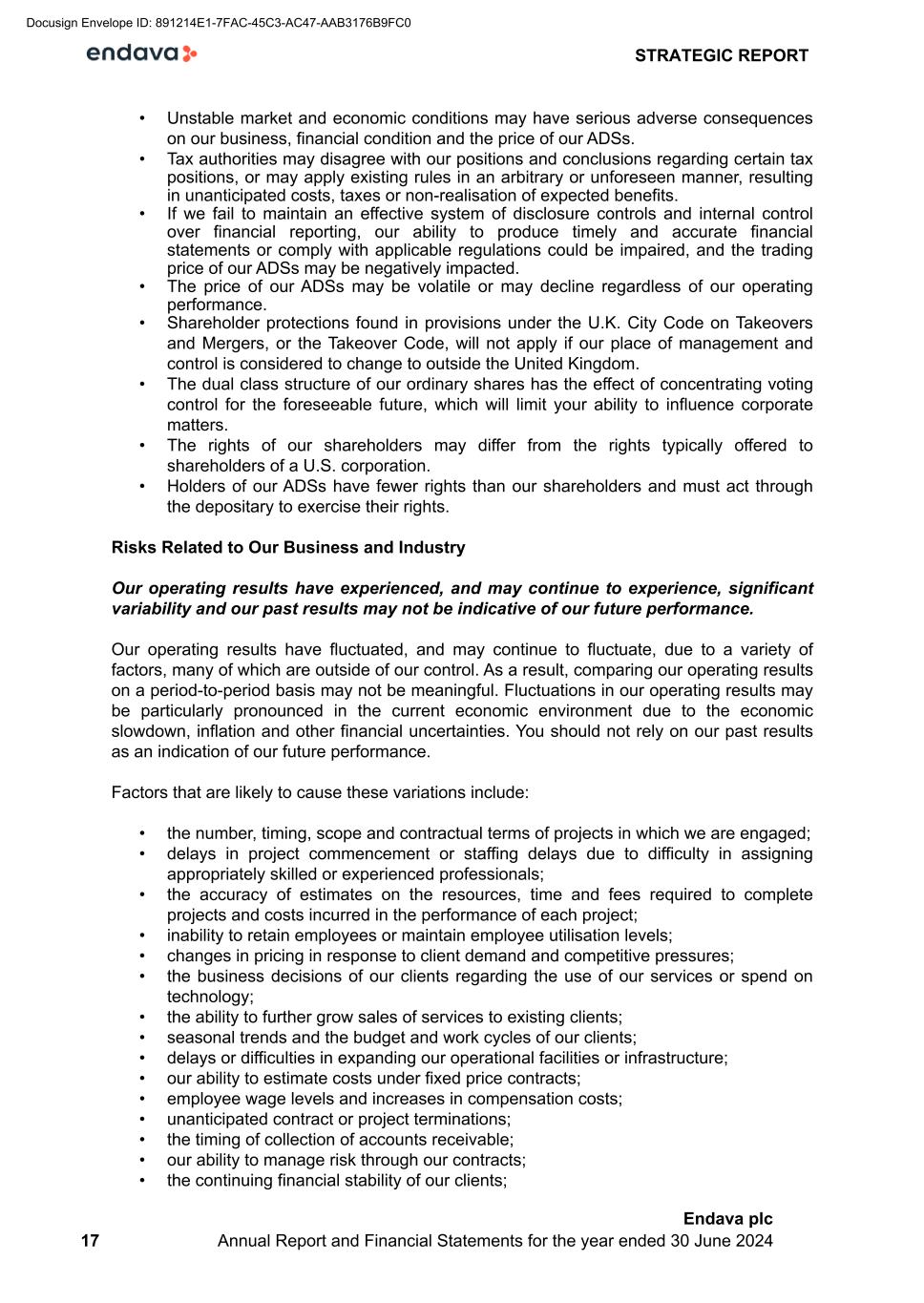
• Unstable market and economic conditions may have serious adverse consequences on our business, financial condition and the price of our ADSs. • Tax authorities may disagree with our positions and conclusions regarding certain tax positions, or may apply existing rules in an arbitrary or unforeseen manner, resulting in unanticipated costs, taxes or non-realisation of expected benefits. • If we fail to maintain an effective system of disclosure controls and internal control over financial reporting, our ability to produce timely and accurate financial statements or comply with applicable regulations could be impaired, and the trading price of our ADSs may be negatively impacted. • The price of our ADSs may be volatile or may decline regardless of our operating performance. • Shareholder protections found in provisions under the U.K. City Code on Takeovers and Mergers, or the Takeover Code, will not apply if our place of management and control is considered to change to outside the United Kingdom. • The dual class structure of our ordinary shares has the effect of concentrating voting control for the foreseeable future, which will limit your ability to influence corporate matters. • The rights of our shareholders may differ from the rights typically offered to shareholders of a U.S. corporation. • Holders of our ADSs have fewer rights than our shareholders and must act through the depositary to exercise their rights. Risks Related to Our Business and Industry Our operating results have experienced, and may continue to experience, significant variability and our past results may not be indicative of our future performance. Our operating results have fluctuated, and may continue to fluctuate, due to a variety of factors, many of which are outside of our control. As a result, comparing our operating results on a period-to-period basis may not be meaningful. Fluctuations in our operating results may be particularly pronounced in the current economic environment due to the economic slowdown, inflation and other financial uncertainties. You should not rely on our past results as an indication of our future performance. Factors that are likely to cause these variations include: • the number, timing, scope and contractual terms of projects in which we are engaged; • delays in project commencement or staffing delays due to difficulty in assigning appropriately skilled or experienced professionals; • the accuracy of estimates on the resources, time and fees required to complete projects and costs incurred in the performance of each project; • inability to retain employees or maintain employee utilisation levels; • changes in pricing in response to client demand and competitive pressures; • the business decisions of our clients regarding the use of our services or spend on technology; • the ability to further grow sales of services to existing clients; • seasonal trends and the budget and work cycles of our clients; • delays or difficulties in expanding our operational facilities or infrastructure; • our ability to estimate costs under fixed price contracts; • employee wage levels and increases in compensation costs; • unanticipated contract or project terminations; • the timing of collection of accounts receivable; • our ability to manage risk through our contracts; • the continuing financial stability of our clients; STRATEGIC REPORT 17 Endava plc Annual Report and Financial Statements for the year ended 30 June 2024 Docusign Envelope ID: 891214E1-7FAC-45C3-AC47-AAB3176B9FC0
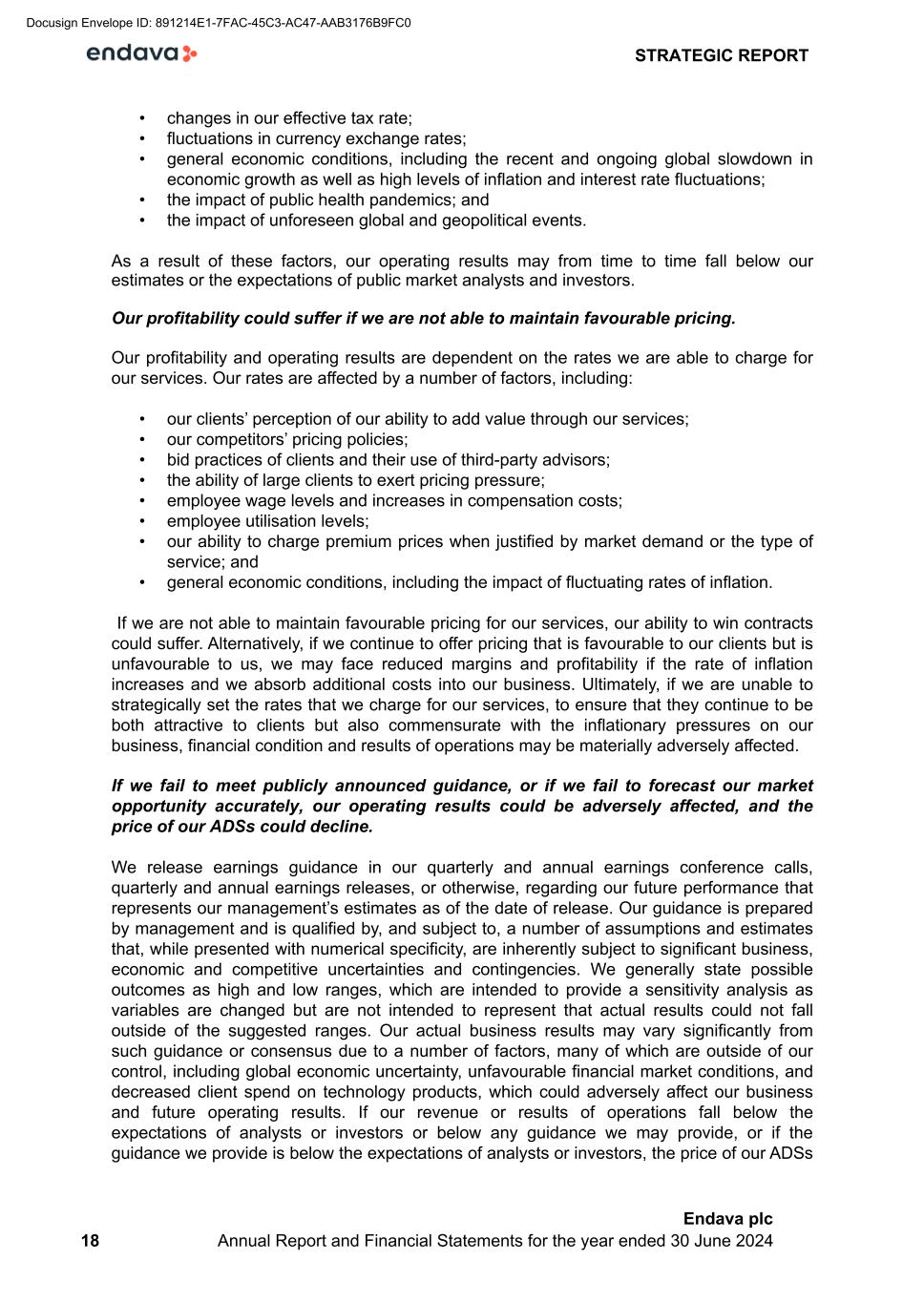
• changes in our effective tax rate; • fluctuations in currency exchange rates; • general economic conditions, including the recent and ongoing global slowdown in economic growth as well as high levels of inflation and interest rate fluctuations; • the impact of public health pandemics; and • the impact of unforeseen global and geopolitical events. As a result of these factors, our operating results may from time to time fall below our estimates or the expectations of public market analysts and investors. Our profitability could suffer if we are not able to maintain favourable pricing. Our profitability and operating results are dependent on the rates we are able to charge for our services. Our rates are affected by a number of factors, including: • our clients’ perception of our ability to add value through our services; • our competitors’ pricing policies; • bid practices of clients and their use of third-party advisors; • the ability of large clients to exert pricing pressure; • employee wage levels and increases in compensation costs; • employee utilisation levels; • our ability to charge premium prices when justified by market demand or the type of service; and • general economic conditions, including the impact of fluctuating rates of inflation. If we are not able to maintain favourable pricing for our services, our ability to win contracts could suffer. Alternatively, if we continue to offer pricing that is favourable to our clients but is unfavourable to us, we may face reduced margins and profitability if the rate of inflation increases and we absorb additional costs into our business. Ultimately, if we are unable to strategically set the rates that we charge for our services, to ensure that they continue to be both attractive to clients but also commensurate with the inflationary pressures on our business, financial condition and results of operations may be materially adversely affected. If we fail to meet publicly announced guidance, or if we fail to forecast our market opportunity accurately, our operating results could be adversely affected, and the price of our ADSs could decline. We release earnings guidance in our quarterly and annual earnings conference calls, quarterly and annual earnings releases, or otherwise, regarding our future performance that represents our management’s estimates as of the date of release. Our guidance is prepared by management and is qualified by, and subject to, a number of assumptions and estimates that, while presented with numerical specificity, are inherently subject to significant business, economic and competitive uncertainties and contingencies. We generally state possible outcomes as high and low ranges, which are intended to provide a sensitivity analysis as variables are changed but are not intended to represent that actual results could not fall outside of the suggested ranges. Our actual business results may vary significantly from such guidance or consensus due to a number of factors, many of which are outside of our control, including global economic uncertainty, unfavourable financial market conditions, and decreased client spend on technology products, which could adversely affect our business and future operating results. If our revenue or results of operations fall below the expectations of analysts or investors or below any guidance we may provide, or if the guidance we provide is below the expectations of analysts or investors, the price of our ADSs STRATEGIC REPORT 18 Endava plc Annual Report and Financial Statements for the year ended 30 June 2024 Docusign Envelope ID: 891214E1-7FAC-45C3-AC47-AAB3176B9FC0
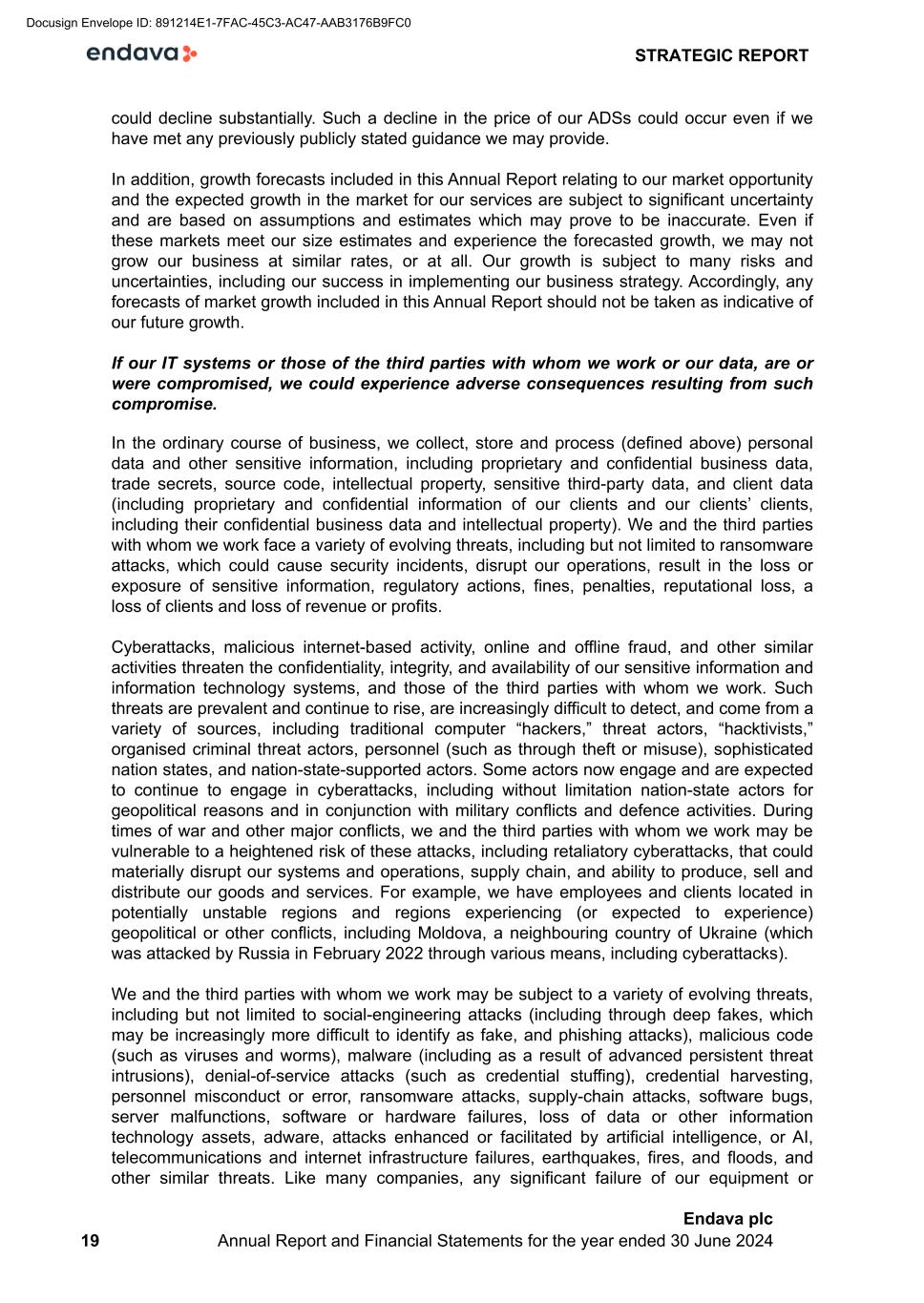
could decline substantially. Such a decline in the price of our ADSs could occur even if we have met any previously publicly stated guidance we may provide. In addition, growth forecasts included in this Annual Report relating to our market opportunity and the expected growth in the market for our services are subject to significant uncertainty and are based on assumptions and estimates which may prove to be inaccurate. Even if these markets meet our size estimates and experience the forecasted growth, we may not grow our business at similar rates, or at all. Our growth is subject to many risks and uncertainties, including our success in implementing our business strategy. Accordingly, any forecasts of market growth included in this Annual Report should not be taken as indicative of our future growth. If our IT systems or those of the third parties with whom we work or our data, are or were compromised, we could experience adverse consequences resulting from such compromise. In the ordinary course of business, we collect, store and process (defined above) personal data and other sensitive information, including proprietary and confidential business data, trade secrets, source code, intellectual property, sensitive third-party data, and client data (including proprietary and confidential information of our clients and our clients’ clients, including their confidential business data and intellectual property). We and the third parties with whom we work face a variety of evolving threats, including but not limited to ransomware attacks, which could cause security incidents, disrupt our operations, result in the loss or exposure of sensitive information, regulatory actions, fines, penalties, reputational loss, a loss of clients and loss of revenue or profits. Cyberattacks, malicious internet-based activity, online and offline fraud, and other similar activities threaten the confidentiality, integrity, and availability of our sensitive information and information technology systems, and those of the third parties with whom we work. Such threats are prevalent and continue to rise, are increasingly difficult to detect, and come from a variety of sources, including traditional computer “hackers,” threat actors, “hacktivists,” organised criminal threat actors, personnel (such as through theft or misuse), sophisticated nation states, and nation-state-supported actors. Some actors now engage and are expected to continue to engage in cyberattacks, including without limitation nation-state actors for geopolitical reasons and in conjunction with military conflicts and defence activities. During times of war and other major conflicts, we and the third parties with whom we work may be vulnerable to a heightened risk of these attacks, including retaliatory cyberattacks, that could materially disrupt our systems and operations, supply chain, and ability to produce, sell and distribute our goods and services. For example, we have employees and clients located in potentially unstable regions and regions experiencing (or expected to experience) geopolitical or other conflicts, including Moldova, a neighbouring country of Ukraine (which was attacked by Russia in February 2022 through various means, including cyberattacks). We and the third parties with whom we work may be subject to a variety of evolving threats, including but not limited to social-engineering attacks (including through deep fakes, which may be increasingly more difficult to identify as fake, and phishing attacks), malicious code (such as viruses and worms), malware (including as a result of advanced persistent threat intrusions), denial-of-service attacks (such as credential stuffing), credential harvesting, personnel misconduct or error, ransomware attacks, supply-chain attacks, software bugs, server malfunctions, software or hardware failures, loss of data or other information technology assets, adware, attacks enhanced or facilitated by artificial intelligence, or AI, telecommunications and internet infrastructure failures, earthquakes, fires, and floods, and other similar threats. Like many companies, any significant failure of our equipment or STRATEGIC REPORT 19 Endava plc Annual Report and Financial Statements for the year ended 30 June 2024 Docusign Envelope ID: 891214E1-7FAC-45C3-AC47-AAB3176B9FC0
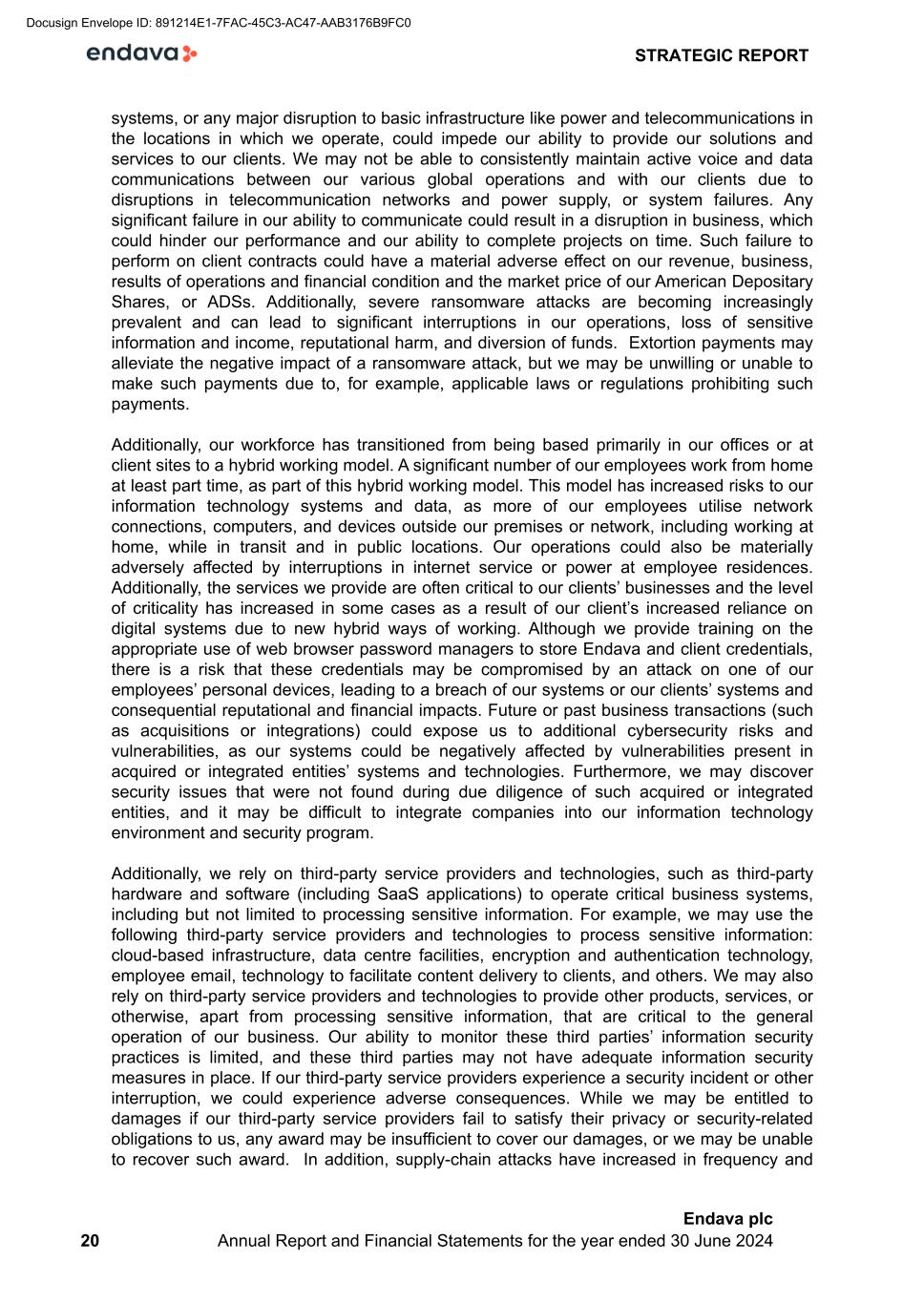
systems, or any major disruption to basic infrastructure like power and telecommunications in the locations in which we operate, could impede our ability to provide our solutions and services to our clients. We may not be able to consistently maintain active voice and data communications between our various global operations and with our clients due to disruptions in telecommunication networks and power supply, or system failures. Any significant failure in our ability to communicate could result in a disruption in business, which could hinder our performance and our ability to complete projects on time. Such failure to perform on client contracts could have a material adverse effect on our revenue, business, results of operations and financial condition and the market price of our American Depositary Shares, or ADSs. Additionally, severe ransomware attacks are becoming increasingly prevalent and can lead to significant interruptions in our operations, loss of sensitive information and income, reputational harm, and diversion of funds. Extortion payments may alleviate the negative impact of a ransomware attack, but we may be unwilling or unable to make such payments due to, for example, applicable laws or regulations prohibiting such payments. Additionally, our workforce has transitioned from being based primarily in our offices or at client sites to a hybrid working model. A significant number of our employees work from home at least part time, as part of this hybrid working model. This model has increased risks to our information technology systems and data, as more of our employees utilise network connections, computers, and devices outside our premises or network, including working at home, while in transit and in public locations. Our operations could also be materially adversely affected by interruptions in internet service or power at employee residences. Additionally, the services we provide are often critical to our clients’ businesses and the level of criticality has increased in some cases as a result of our client’s increased reliance on digital systems due to new hybrid ways of working. Although we provide training on the appropriate use of web browser password managers to store Endava and client credentials, there is a risk that these credentials may be compromised by an attack on one of our employees’ personal devices, leading to a breach of our systems or our clients’ systems and consequential reputational and financial impacts. Future or past business transactions (such as acquisitions or integrations) could expose us to additional cybersecurity risks and vulnerabilities, as our systems could be negatively affected by vulnerabilities present in acquired or integrated entities’ systems and technologies. Furthermore, we may discover security issues that were not found during due diligence of such acquired or integrated entities, and it may be difficult to integrate companies into our information technology environment and security program. Additionally, we rely on third-party service providers and technologies, such as third-party hardware and software (including SaaS applications) to operate critical business systems, including but not limited to processing sensitive information. For example, we may use the following third-party service providers and technologies to process sensitive information: cloud-based infrastructure, data centre facilities, encryption and authentication technology, employee email, technology to facilitate content delivery to clients, and others. We may also rely on third-party service providers and technologies to provide other products, services, or otherwise, apart from processing sensitive information, that are critical to the general operation of our business. Our ability to monitor these third parties’ information security practices is limited, and these third parties may not have adequate information security measures in place. If our third-party service providers experience a security incident or other interruption, we could experience adverse consequences. While we may be entitled to damages if our third-party service providers fail to satisfy their privacy or security-related obligations to us, any award may be insufficient to cover our damages, or we may be unable to recover such award. In addition, supply-chain attacks have increased in frequency and STRATEGIC REPORT 20 Endava plc Annual Report and Financial Statements for the year ended 30 June 2024 Docusign Envelope ID: 891214E1-7FAC-45C3-AC47-AAB3176B9FC0
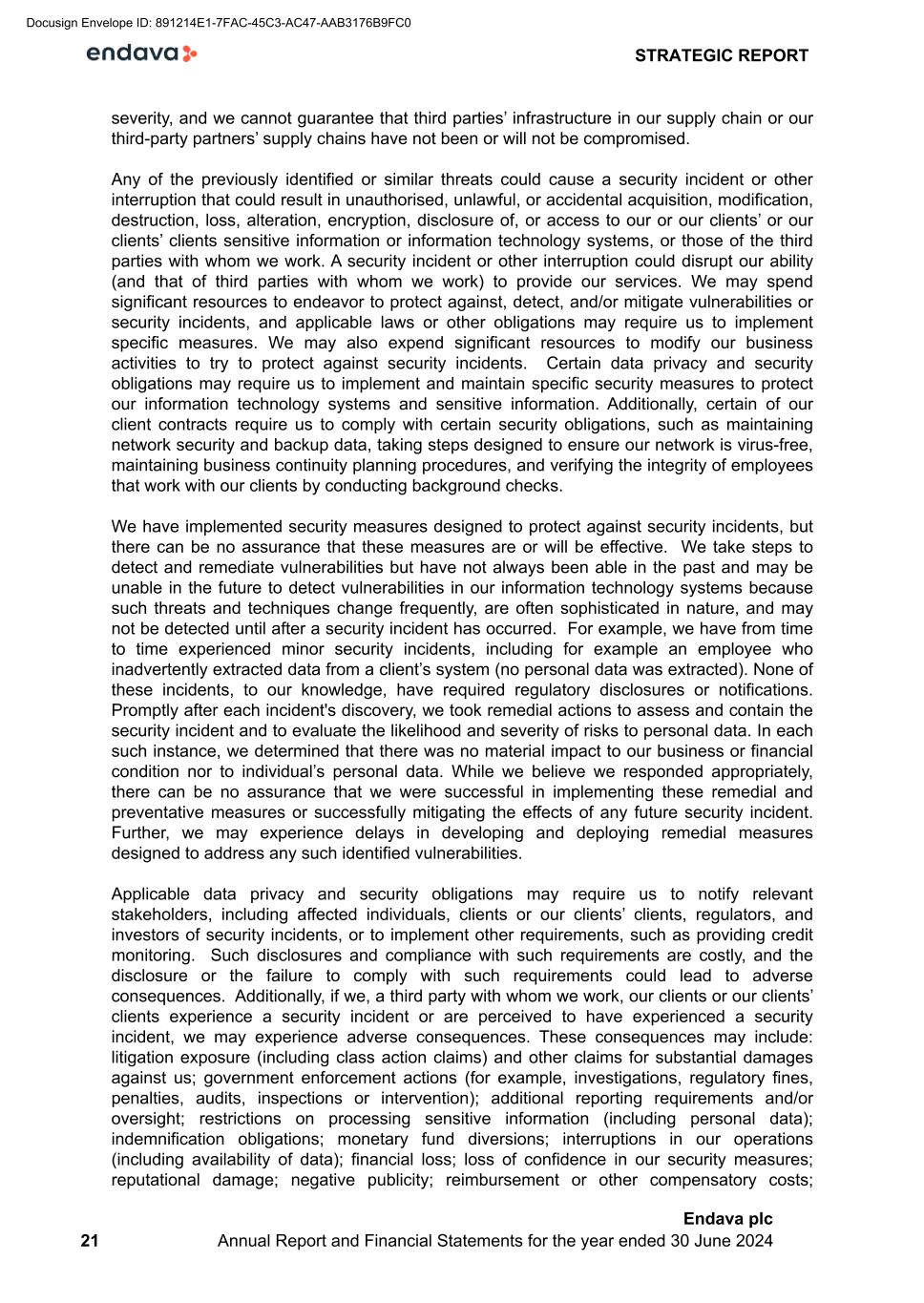
severity, and we cannot guarantee that third parties’ infrastructure in our supply chain or our third-party partners’ supply chains have not been or will not be compromised. Any of the previously identified or similar threats could cause a security incident or other interruption that could result in unauthorised, unlawful, or accidental acquisition, modification, destruction, loss, alteration, encryption, disclosure of, or access to our or our clients’ or our clients’ clients sensitive information or information technology systems, or those of the third parties with whom we work. A security incident or other interruption could disrupt our ability (and that of third parties with whom we work) to provide our services. We may spend significant resources to endeavor to protect against, detect, and/or mitigate vulnerabilities or security incidents, and applicable laws or other obligations may require us to implement specific measures. We may also expend significant resources to modify our business activities to try to protect against security incidents. Certain data privacy and security obligations may require us to implement and maintain specific security measures to protect our information technology systems and sensitive information. Additionally, certain of our client contracts require us to comply with certain security obligations, such as maintaining network security and backup data, taking steps designed to ensure our network is virus-free, maintaining business continuity planning procedures, and verifying the integrity of employees that work with our clients by conducting background checks. We have implemented security measures designed to protect against security incidents, but there can be no assurance that these measures are or will be effective. We take steps to detect and remediate vulnerabilities but have not always been able in the past and may be unable in the future to detect vulnerabilities in our information technology systems because such threats and techniques change frequently, are often sophisticated in nature, and may not be detected until after a security incident has occurred. For example, we have from time to time experienced minor security incidents, including for example an employee who inadvertently extracted data from a client’s system (no personal data was extracted). None of these incidents, to our knowledge, have required regulatory disclosures or notifications. Promptly after each incident's discovery, we took remedial actions to assess and contain the security incident and to evaluate the likelihood and severity of risks to personal data. In each such instance, we determined that there was no material impact to our business or financial condition nor to individual’s personal data. While we believe we responded appropriately, there can be no assurance that we were successful in implementing these remedial and preventative measures or successfully mitigating the effects of any future security incident. Further, we may experience delays in developing and deploying remedial measures designed to address any such identified vulnerabilities. Applicable data privacy and security obligations may require us to notify relevant stakeholders, including affected individuals, clients or our clients’ clients, regulators, and investors of security incidents, or to implement other requirements, such as providing credit monitoring. Such disclosures and compliance with such requirements are costly, and the disclosure or the failure to comply with such requirements could lead to adverse consequences. Additionally, if we, a third party with whom we work, our clients or our clients’ clients experience a security incident or are perceived to have experienced a security incident, we may experience adverse consequences. These consequences may include: litigation exposure (including class action claims) and other claims for substantial damages against us; government enforcement actions (for example, investigations, regulatory fines, penalties, audits, inspections or intervention); additional reporting requirements and/or oversight; restrictions on processing sensitive information (including personal data); indemnification obligations; monetary fund diversions; interruptions in our operations (including availability of data); financial loss; loss of confidence in our security measures; reputational damage; negative publicity; reimbursement or other compensatory costs; STRATEGIC REPORT 21 Endava plc Annual Report and Financial Statements for the year ended 30 June 2024 Docusign Envelope ID: 891214E1-7FAC-45C3-AC47-AAB3176B9FC0

additional compliance costs; and additional similar harms, and therefore could materially adversely affect our revenue, and results of operations, business and prospects, such as causing clients to stop using our services, deter new clients from using our services, and negatively impact our ability to grow and operate our business. If any person, including any of our personnel or former personnel or aforementioned threat actors, compromises our security or accidentally exposes our sensitive information, including our source code, or compromises the security, or accidentally exposes the sensitive information, including source code, of our clients’, our clients’ clients or other third party, or misappropriates such information, then we could be subject to significant liability from our clients, our clients’ clients or other third parties for breaching contractual provisions, including confidentiality, or applicable privacy and data security laws. Additionally, the reliability of the systems that we develop and host for our clients is critical to our success. However, these systems could contain errors, defects, security vulnerabilities or software bugs that are difficult to detect and correct, particularly when such vulnerabilities are first introduced or when new versions of the systems are deployed. It may be costly and difficult to develop and deploy patches for vulnerabilities and delays in releasing patches or difficulties installing them may impact our clients’ or our clients’ clients’ ability to use systems and services, and result in security incidents. Additionally, some of our business depends upon our clients’ appropriate and successful implementation of the systems that we develop and host for them. If our clients fail to implement or use these systems correctly, our clients may suffer a security incident or experience other adverse consequences. Additionally, any failure in a client’s system, whether related to our solutions or services, could result in adverse consequences, including damage to our reputation or substantial damages against us. Even if such incidents are unrelated to our security practices, it could result in our incurring significant economic and operational costs in investigating, remediating, and implementing additional measures to further protect our clients, and could result in reputational harm, as well as other adverse consequences. Our contracts may not contain limitations of liability, and even where they do, there can be no assurance that limitations of liability in our contracts are sufficient to protect us from liabilities, damages, or claims related to our data privacy and security obligations. We cannot be sure that our insurance coverage will be adequate or sufficient to protect us from or to mitigate liabilities arising out of our privacy and security practices, that such coverage will continue to be available on commercially reasonable terms or at all, or that such coverage will pay future claims. In addition to experiencing a security incident, third parties may gather, collect, or infer sensitive information about us from public sources, data brokers, or other means that reveals competitively sensitive details about our organisation and could be used to undermine our competitive advantage or market position. Additionally, our sensitive information or that of our clients could be leaked, disclosed, or revealed as a result of or in connection with our employee’s, personnel’s, or vendor’s use of generative AI technologies. Any sensitive information (including confidential, competitive, proprietary, or personal data) that we input into a third-party generative AI platform could be leaked or disclosed to others, including if sensitive information is used to train the third parties’ AI model. Additionally, where an AI model ingests personal data and makes connections using such data, those technologies may reveal other personal or sensitive information generated by the model. See also “We use generative AI tools in our operations, which may result in significant operational challenges, liability and reputational harm.” STRATEGIC REPORT 22 Endava plc Annual Report and Financial Statements for the year ended 30 June 2024 Docusign Envelope ID: 891214E1-7FAC-45C3-AC47-AAB3176B9FC0

If we provide inadequate service or cause disruptions in our clients’ businesses, it could result in significant costs to us, the loss of our clients and damage to our corporate reputation. Any defects or errors or failure to meet clients’ expectations in the performance of our contracts could result in claims for substantial damages against us. Our contracts generally limit our liability for damages that arise from negligent acts, error, mistakes or omissions in rendering services to our clients. However, we cannot be sure that these contractual provisions will protect us from liability for damages in the event we are sued. In addition, certain liabilities, such as claims of third parties for intellectual property infringement and breaches of data protection and security requirements, for which we may be required to indemnify our clients, could be substantial. The successful assertion of one or more large claims against us in amounts greater than those covered by our current insurance policies could materially adversely affect our business, financial condition and results of operations. Even if such assertions against us are unsuccessful, we may incur reputational harm and substantial legal fees. In addition, a failure or inability to meet a contractual requirement could seriously damage our corporate reputation and limit our ability to attract new business. In certain instances, we guarantee clients that we will complete a project by a scheduled date or that we will maintain certain service levels. We are generally not subject to monetary penalties for failing to complete projects by the scheduled date, but may suffer reputational harm and loss of future business if we do not meet our contractual commitments. In addition, if the project experiences a performance problem, we may not be able to recover the additional costs we will incur, which could exceed revenue realised from a project. Our contracts could be unprofitable. We perform our services primarily under time-and-materials contracts (where materials costs consist of travel and out-of-pocket expenses). We charge out the services performed by our employees under these contracts at daily or hourly rates that are agreed at the time at which the contract is entered. The rates and other pricing terms negotiated with our clients are highly dependent on our internal forecasts of our operating costs and predictions of increases in those costs influenced by wage inflation and other marketplace factors, as well as the volume of work required by the client. Our predictions are based on limited data and could turn out to be inaccurate, resulting in contracts that may not be profitable. Typically, we do not have the ability to increase the rates established at the outset of a client project, other than on an annual basis and often subject to caps. Independent of our right to increase our rates on an annual basis, client expectations regarding the anticipated cost of a project may limit our ability to increase our rates for ongoing work. In addition to our time-and-materials contracts, which are the significant proportion of our revenue, we undertake some engagements on a fixed-price basis. Our pricing in fixed-price contracts is highly dependent on our assumptions and forecasts about the costs we expect to incur to complete the related project, which are based on limited data and could turn out to be inaccurate. Any failure by us to accurately estimate the resources, including the skills and seniority of our employees, required to complete a fixed-price contract on time and on budget, or any unexpected increase in the cost of our employees assigned to the related project, office space or materials could expose us to risks associated with cost overruns and could have a material adverse effect on our business, results of operations and financial condition. In addition, any unexpected changes in economic conditions that affect any of the foregoing assumptions and predictions could render contracts that would have been favourable to us when signed unfavourable. STRATEGIC REPORT 23 Endava plc Annual Report and Financial Statements for the year ended 30 June 2024 Docusign Envelope ID: 891214E1-7FAC-45C3-AC47-AAB3176B9FC0
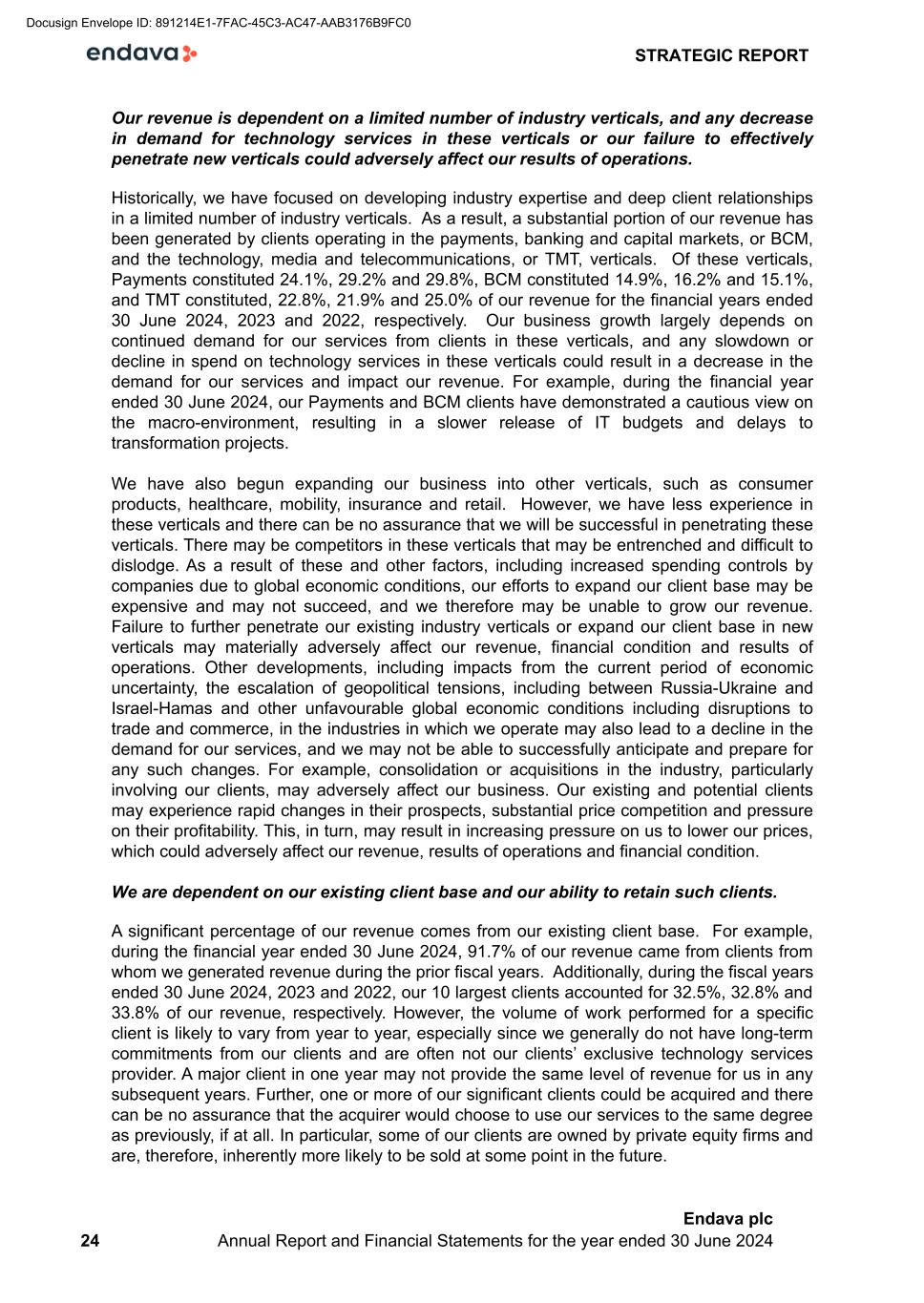
Our revenue is dependent on a limited number of industry verticals, and any decrease in demand for technology services in these verticals or our failure to effectively penetrate new verticals could adversely affect our results of operations. Historically, we have focused on developing industry expertise and deep client relationships in a limited number of industry verticals. As a result, a substantial portion of our revenue has been generated by clients operating in the payments, banking and capital markets, or BCM, and the technology, media and telecommunications, or TMT, verticals. Of these verticals, Payments constituted 24.1%, 29.2% and 29.8%, BCM constituted 14.9%, 16.2% and 15.1%, and TMT constituted, 22.8%, 21.9% and 25.0% of our revenue for the financial years ended 30 June 2024, 2023 and 2022, respectively. Our business growth largely depends on continued demand for our services from clients in these verticals, and any slowdown or decline in spend on technology services in these verticals could result in a decrease in the demand for our services and impact our revenue. For example, during the financial year ended 30 June 2024, our Payments and BCM clients have demonstrated a cautious view on the macro-environment, resulting in a slower release of IT budgets and delays to transformation projects. We have also begun expanding our business into other verticals, such as consumer products, healthcare, mobility, insurance and retail. However, we have less experience in these verticals and there can be no assurance that we will be successful in penetrating these verticals. There may be competitors in these verticals that may be entrenched and difficult to dislodge. As a result of these and other factors, including increased spending controls by companies due to global economic conditions, our efforts to expand our client base may be expensive and may not succeed, and we therefore may be unable to grow our revenue. Failure to further penetrate our existing industry verticals or expand our client base in new verticals may materially adversely affect our revenue, financial condition and results of operations. Other developments, including impacts from the current period of economic uncertainty, the escalation of geopolitical tensions, including between Russia-Ukraine and Israel-Hamas and other unfavourable global economic conditions including disruptions to trade and commerce, in the industries in which we operate may also lead to a decline in the demand for our services, and we may not be able to successfully anticipate and prepare for any such changes. For example, consolidation or acquisitions in the industry, particularly involving our clients, may adversely affect our business. Our existing and potential clients may experience rapid changes in their prospects, substantial price competition and pressure on their profitability. This, in turn, may result in increasing pressure on us to lower our prices, which could adversely affect our revenue, results of operations and financial condition. We are dependent on our existing client base and our ability to retain such clients. A significant percentage of our revenue comes from our existing client base. For example, during the financial year ended 30 June 2024, 91.7% of our revenue came from clients from whom we generated revenue during the prior fiscal years. Additionally, during the fiscal years ended 30 June 2024, 2023 and 2022, our 10 largest clients accounted for 32.5%, 32.8% and 33.8% of our revenue, respectively. However, the volume of work performed for a specific client is likely to vary from year to year, especially since we generally do not have long-term commitments from our clients and are often not our clients’ exclusive technology services provider. A major client in one year may not provide the same level of revenue for us in any subsequent years. Further, one or more of our significant clients could be acquired and there can be no assurance that the acquirer would choose to use our services to the same degree as previously, if at all. In particular, some of our clients are owned by private equity firms and are, therefore, inherently more likely to be sold at some point in the future. STRATEGIC REPORT 24 Endava plc Annual Report and Financial Statements for the year ended 30 June 2024 Docusign Envelope ID: 891214E1-7FAC-45C3-AC47-AAB3176B9FC0

In addition, the services we provide to our clients, and the revenue and income from those services, may decline or vary as the type and quantity of services we provide changes over time. Our reliance on any individual client for a significant portion of our revenue may give that client a certain degree of pricing leverage against us when negotiating contracts and terms of service. In order to successfully perform and market our services, we must establish and maintain long-term relationships with our clients and develop a thorough understanding of their businesses. We anticipate that a limited number of clients will continue to account for a significant portion of our revenue in any given fiscal year for the foreseeable future and, in some cases, a portion of our revenue attributable to an individual client may increase in the future. There can be no assurance that we will be successful in maintaining our relationship with and successfully obtaining new engagements from our existing clients or achieve our revenue growth and other financial goals as a result. Additionally, if our existing client base, notably our largest clients, are adversely impacted by current or future adverse global economic or geopolitical conditions and disruptions to trade, commerce, pricing stability, credit availability and supply chain continuity in both Europe and globally, then we may experience a decrease in demand, delays in payment or postponement of projects, which could have a material adverse effect on our business, results of operations and financial condition. We use generative AI tools in our operations, which may result in significant operational challenges, liability and reputational harm. We use generative AI tools in our operations and expect to continue using generative AI tools in the future. With client consent, we may use generative AI tools to generate code that is incorporated into client deliverables. If we are unable to use generative AI tools, it could make our business less efficient and result in competitive disadvantages. Generative AI refers to AI technology that creates new content (such as text, audio, data, images, video, software code), which we collectively refer to as Output, by leveraging content that the technology was trained on (e.g., through machine learning) in response to prompts submitted by a user, which we refer to as Prompts. Generative AI provides significant opportunities for new and efficient forms of content development, across a wide range of applications. However, the business, legal and ethical landscape regarding generative AI, and its commercialisation and regulation is unsettled and constantly evolving. Uncertainty in the legal regulatory regime relating to AI may require significant resources to modify and maintain business practices to comply with relevant U.S. and non-U.S. laws. Several jurisdictions around the globe, including Europe and certain U.S. states, have already proposed or enacted laws governing AI and we expect other jurisdictions will adopt similar laws. For example, on August 1, 2024, the EU AI Act came into force, imposing onerous obligations that will become applicable in a phased manner. Some of the obligations relate to the use of AI-related systems and which will require us to change our business practices to comply with such obligations. We may provide services to clients who are likely to develop AI-related systems categorized by the EU AI Act as “high risk”, and as a result we will be required over the next few years to adapt our approach to software development to ensure that we are in a position to comply with all obligations that attach to such systems. We may be deemed liable under the EU AI Act for non-compliance due to our role in a client project that is [deemed caught] under the regulations. As such, we may be subject to legal liability, regulatory fines or penalties. In addition, under the EU AI Act certain AI system are deemed to present an unacceptable risk and are classed as “prohibited” AI systems on the basis that they pose an unacceptable health or safety risk or a risk to the fundamental rights of EU STRATEGIC REPORT 25 Endava plc Annual Report and Financial Statements for the year ended 30 June 2024 Docusign Envelope ID: 891214E1-7FAC-45C3-AC47-AAB3176B9FC0
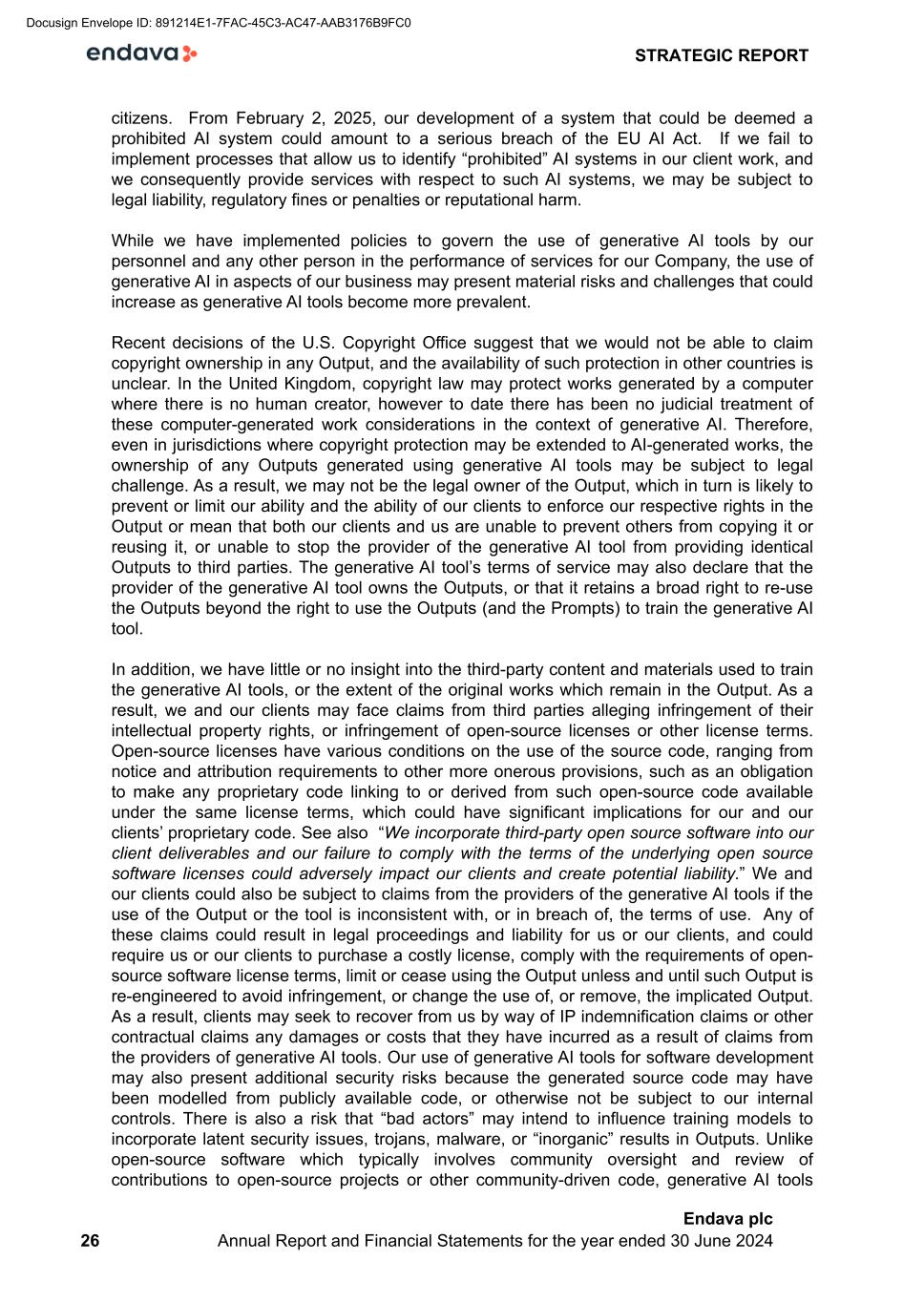
citizens. From February 2, 2025, our development of a system that could be deemed a prohibited AI system could amount to a serious breach of the EU AI Act. If we fail to implement processes that allow us to identify “prohibited” AI systems in our client work, and we consequently provide services with respect to such AI systems, we may be subject to legal liability, regulatory fines or penalties or reputational harm. While we have implemented policies to govern the use of generative AI tools by our personnel and any other person in the performance of services for our Company, the use of generative AI in aspects of our business may present material risks and challenges that could increase as generative AI tools become more prevalent. Recent decisions of the U.S. Copyright Office suggest that we would not be able to claim copyright ownership in any Output, and the availability of such protection in other countries is unclear. In the United Kingdom, copyright law may protect works generated by a computer where there is no human creator, however to date there has been no judicial treatment of these computer-generated work considerations in the context of generative AI. Therefore, even in jurisdictions where copyright protection may be extended to AI-generated works, the ownership of any Outputs generated using generative AI tools may be subject to legal challenge. As a result, we may not be the legal owner of the Output, which in turn is likely to prevent or limit our ability and the ability of our clients to enforce our respective rights in the Output or mean that both our clients and us are unable to prevent others from copying it or reusing it, or unable to stop the provider of the generative AI tool from providing identical Outputs to third parties. The generative AI tool’s terms of service may also declare that the provider of the generative AI tool owns the Outputs, or that it retains a broad right to re-use the Outputs beyond the right to use the Outputs (and the Prompts) to train the generative AI tool. In addition, we have little or no insight into the third-party content and materials used to train the generative AI tools, or the extent of the original works which remain in the Output. As a result, we and our clients may face claims from third parties alleging infringement of their intellectual property rights, or infringement of open-source licenses or other license terms. Open-source licenses have various conditions on the use of the source code, ranging from notice and attribution requirements to other more onerous provisions, such as an obligation to make any proprietary code linking to or derived from such open-source code available under the same license terms, which could have significant implications for our and our clients’ proprietary code. See also “We incorporate third-party open source software into our client deliverables and our failure to comply with the terms of the underlying open source software licenses could adversely impact our clients and create potential liability.” We and our clients could also be subject to claims from the providers of the generative AI tools if the use of the Output or the tool is inconsistent with, or in breach of, the terms of use. Any of these claims could result in legal proceedings and liability for us or our clients, and could require us or our clients to purchase a costly license, comply with the requirements of open- source software license terms, limit or cease using the Output unless and until such Output is re-engineered to avoid infringement, or change the use of, or remove, the implicated Output. As a result, clients may seek to recover from us by way of IP indemnification claims or other contractual claims any damages or costs that they have incurred as a result of claims from the providers of generative AI tools. Our use of generative AI tools for software development may also present additional security risks because the generated source code may have been modelled from publicly available code, or otherwise not be subject to our internal controls. There is also a risk that “bad actors” may intend to influence training models to incorporate latent security issues, trojans, malware, or “inorganic” results in Outputs. Unlike open-source software which typically involves community oversight and review of contributions to open-source projects or other community-driven code, generative AI tools STRATEGIC REPORT 26 Endava plc Annual Report and Financial Statements for the year ended 30 June 2024 Docusign Envelope ID: 891214E1-7FAC-45C3-AC47-AAB3176B9FC0
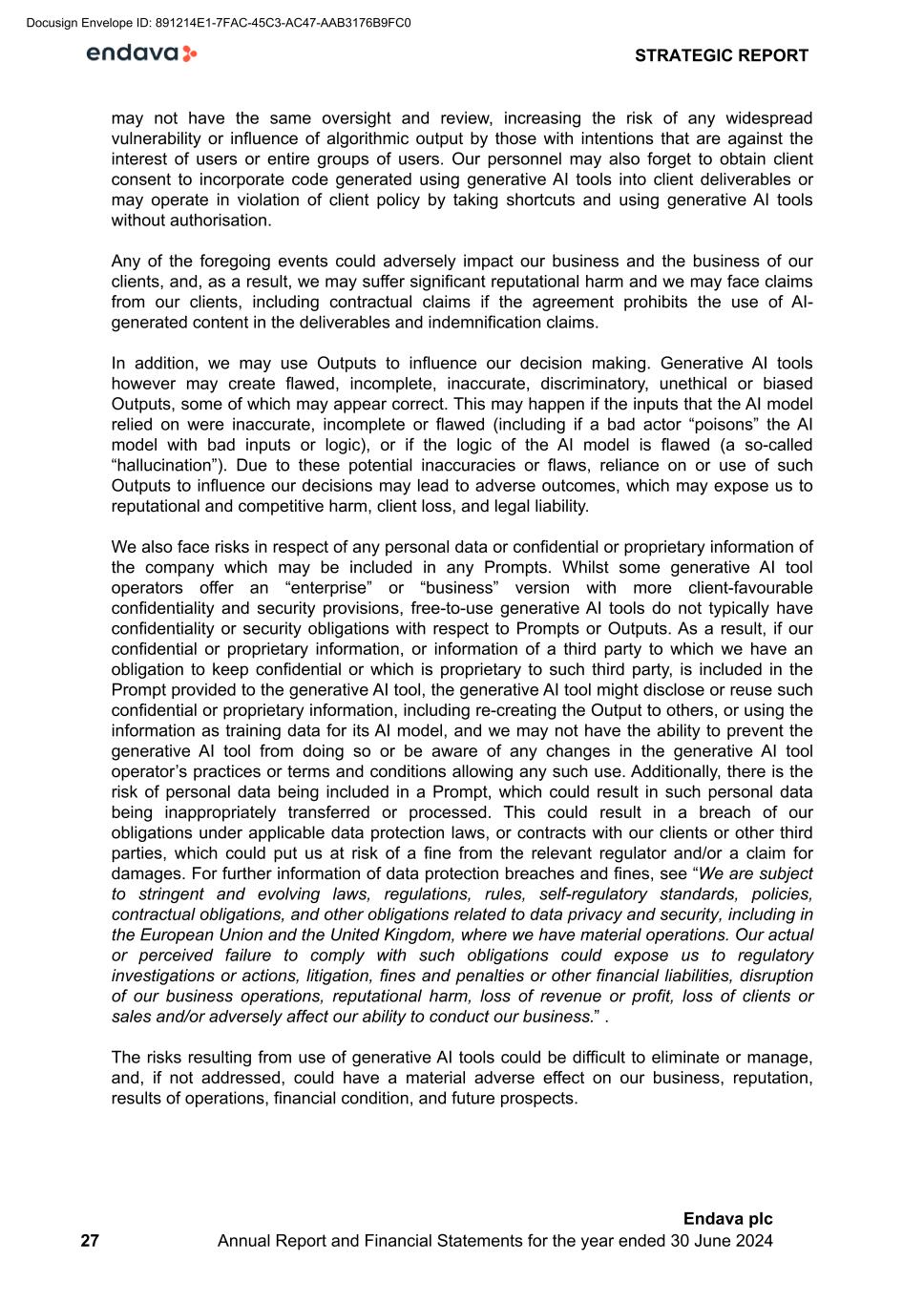
may not have the same oversight and review, increasing the risk of any widespread vulnerability or influence of algorithmic output by those with intentions that are against the interest of users or entire groups of users. Our personnel may also forget to obtain client consent to incorporate code generated using generative AI tools into client deliverables or may operate in violation of client policy by taking shortcuts and using generative AI tools without authorisation. Any of the foregoing events could adversely impact our business and the business of our clients, and, as a result, we may suffer significant reputational harm and we may face claims from our clients, including contractual claims if the agreement prohibits the use of AI- generated content in the deliverables and indemnification claims. In addition, we may use Outputs to influence our decision making. Generative AI tools however may create flawed, incomplete, inaccurate, discriminatory, unethical or biased Outputs, some of which may appear correct. This may happen if the inputs that the AI model relied on were inaccurate, incomplete or flawed (including if a bad actor “poisons” the AI model with bad inputs or logic), or if the logic of the AI model is flawed (a so-called “hallucination”). Due to these potential inaccuracies or flaws, reliance on or use of such Outputs to influence our decisions may lead to adverse outcomes, which may expose us to reputational and competitive harm, client loss, and legal liability. We also face risks in respect of any personal data or confidential or proprietary information of the company which may be included in any Prompts. Whilst some generative AI tool operators offer an “enterprise” or “business” version with more client-favourable confidentiality and security provisions, free-to-use generative AI tools do not typically have confidentiality or security obligations with respect to Prompts or Outputs. As a result, if our confidential or proprietary information, or information of a third party to which we have an obligation to keep confidential or which is proprietary to such third party, is included in the Prompt provided to the generative AI tool, the generative AI tool might disclose or reuse such confidential or proprietary information, including re-creating the Output to others, or using the information as training data for its AI model, and we may not have the ability to prevent the generative AI tool from doing so or be aware of any changes in the generative AI tool operator’s practices or terms and conditions allowing any such use. Additionally, there is the risk of personal data being included in a Prompt, which could result in such personal data being inappropriately transferred or processed. This could result in a breach of our obligations under applicable data protection laws, or contracts with our clients or other third parties, which could put us at risk of a fine from the relevant regulator and/or a claim for damages. For further information of data protection breaches and fines, see “We are subject to stringent and evolving laws, regulations, rules, self-regulatory standards, policies, contractual obligations, and other obligations related to data privacy and security, including in the European Union and the United Kingdom, where we have material operations. Our actual or perceived failure to comply with such obligations could expose us to regulatory investigations or actions, litigation, fines and penalties or other financial liabilities, disruption of our business operations, reputational harm, loss of revenue or profit, loss of clients or sales and/or adversely affect our ability to conduct our business.” . The risks resulting from use of generative AI tools could be difficult to eliminate or manage, and, if not addressed, could have a material adverse effect on our business, reputation, results of operations, financial condition, and future prospects. STRATEGIC REPORT 27 Endava plc Annual Report and Financial Statements for the year ended 30 June 2024 Docusign Envelope ID: 891214E1-7FAC-45C3-AC47-AAB3176B9FC0
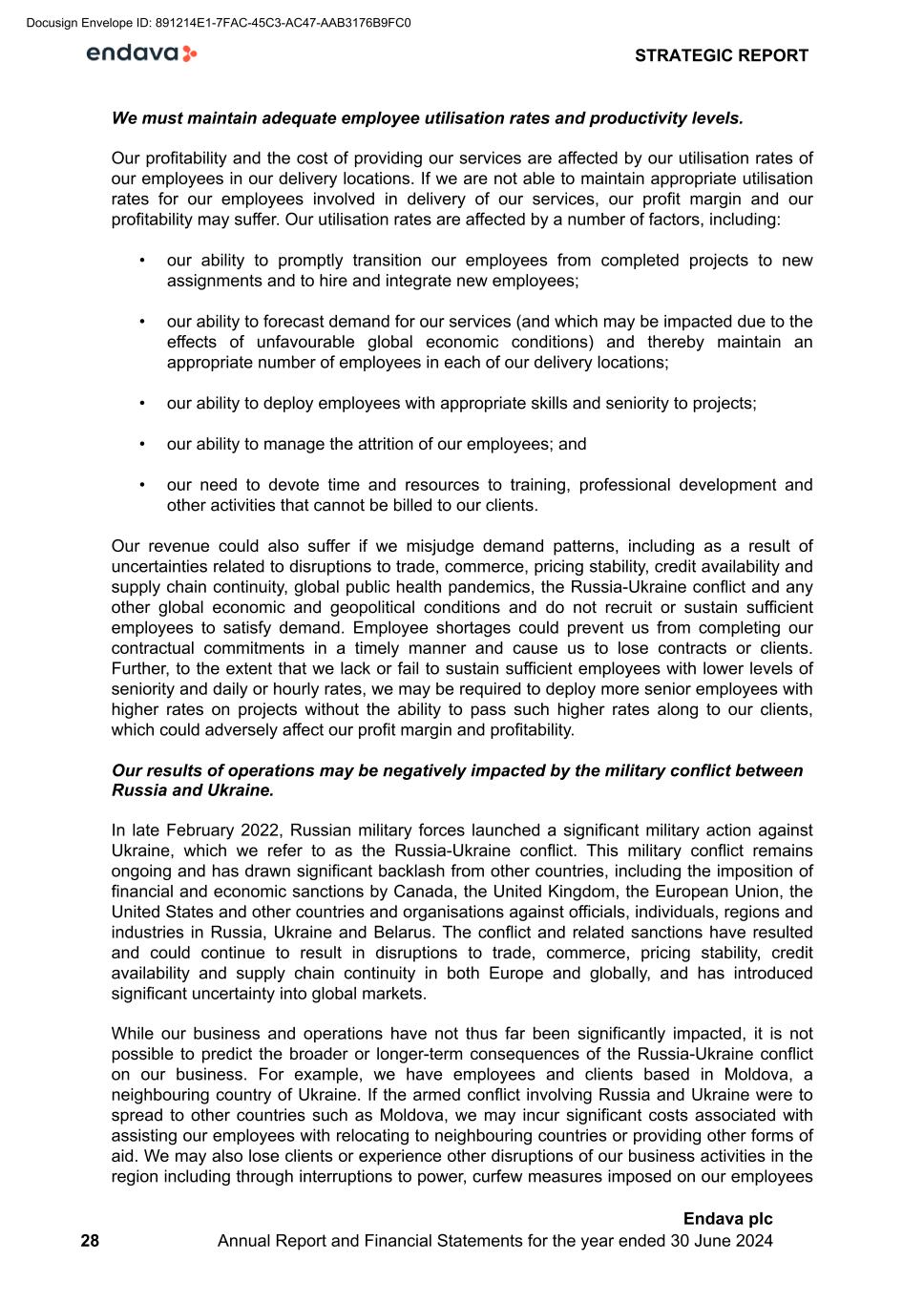
We must maintain adequate employee utilisation rates and productivity levels. Our profitability and the cost of providing our services are affected by our utilisation rates of our employees in our delivery locations. If we are not able to maintain appropriate utilisation rates for our employees involved in delivery of our services, our profit margin and our profitability may suffer. Our utilisation rates are affected by a number of factors, including: • our ability to promptly transition our employees from completed projects to new assignments and to hire and integrate new employees; • our ability to forecast demand for our services (and which may be impacted due to the effects of unfavourable global economic conditions) and thereby maintain an appropriate number of employees in each of our delivery locations; • our ability to deploy employees with appropriate skills and seniority to projects; • our ability to manage the attrition of our employees; and • our need to devote time and resources to training, professional development and other activities that cannot be billed to our clients. Our revenue could also suffer if we misjudge demand patterns, including as a result of uncertainties related to disruptions to trade, commerce, pricing stability, credit availability and supply chain continuity, global public health pandemics, the Russia-Ukraine conflict and any other global economic and geopolitical conditions and do not recruit or sustain sufficient employees to satisfy demand. Employee shortages could prevent us from completing our contractual commitments in a timely manner and cause us to lose contracts or clients. Further, to the extent that we lack or fail to sustain sufficient employees with lower levels of seniority and daily or hourly rates, we may be required to deploy more senior employees with higher rates on projects without the ability to pass such higher rates along to our clients, which could adversely affect our profit margin and profitability. Our results of operations may be negatively impacted by the military conflict between Russia and Ukraine. In late February 2022, Russian military forces launched a significant military action against Ukraine, which we refer to as the Russia-Ukraine conflict. This military conflict remains ongoing and has drawn significant backlash from other countries, including the imposition of financial and economic sanctions by Canada, the United Kingdom, the European Union, the United States and other countries and organisations against officials, individuals, regions and industries in Russia, Ukraine and Belarus. The conflict and related sanctions have resulted and could continue to result in disruptions to trade, commerce, pricing stability, credit availability and supply chain continuity in both Europe and globally, and has introduced significant uncertainty into global markets. While our business and operations have not thus far been significantly impacted, it is not possible to predict the broader or longer-term consequences of the Russia-Ukraine conflict on our business. For example, we have employees and clients based in Moldova, a neighbouring country of Ukraine. If the armed conflict involving Russia and Ukraine were to spread to other countries such as Moldova, we may incur significant costs associated with assisting our employees with relocating to neighbouring countries or providing other forms of aid. We may also lose clients or experience other disruptions of our business activities in the region including through interruptions to power, curfew measures imposed on our employees STRATEGIC REPORT 28 Endava plc Annual Report and Financial Statements for the year ended 30 June 2024 Docusign Envelope ID: 891214E1-7FAC-45C3-AC47-AAB3176B9FC0
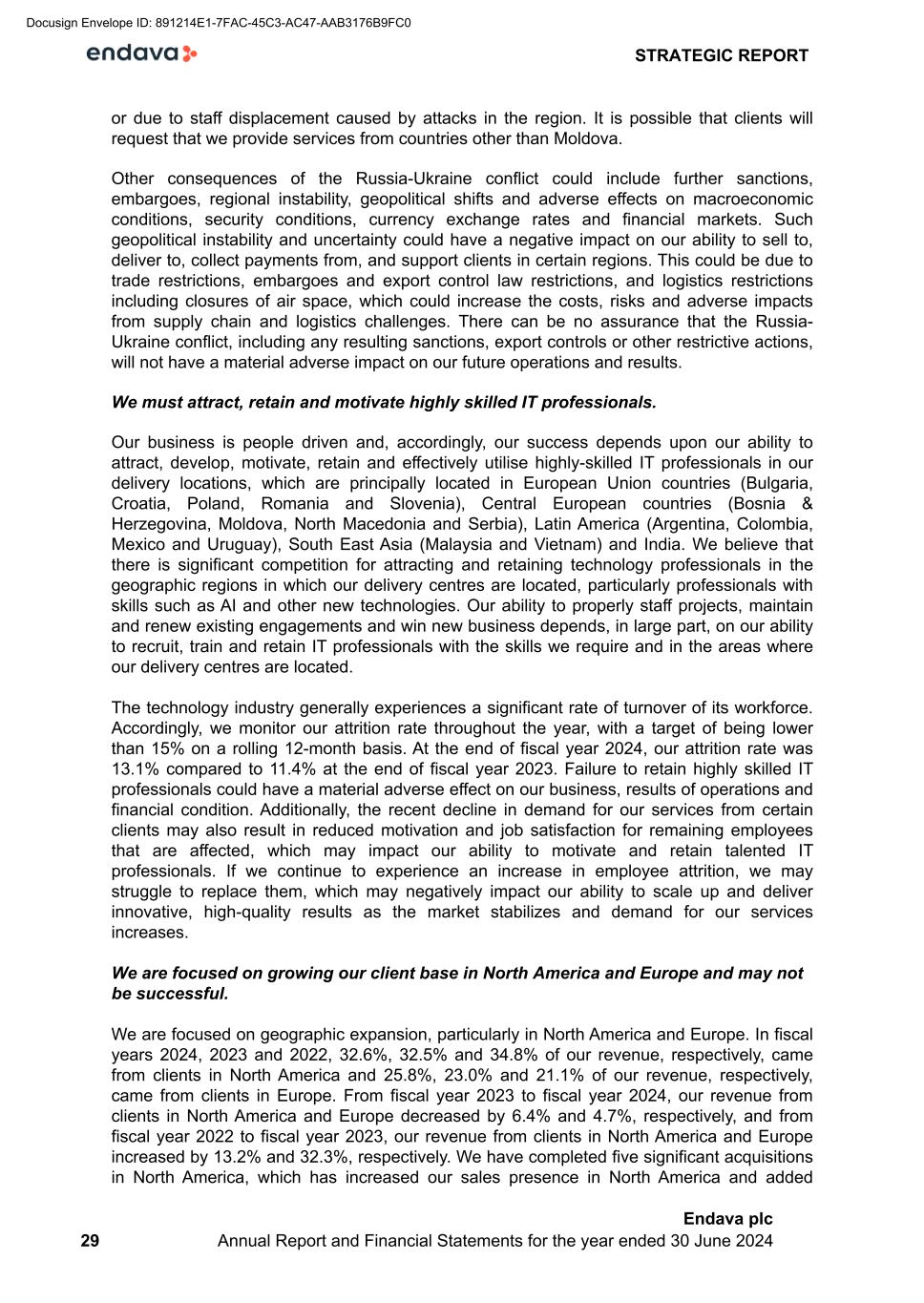
or due to staff displacement caused by attacks in the region. It is possible that clients will request that we provide services from countries other than Moldova. Other consequences of the Russia-Ukraine conflict could include further sanctions, embargoes, regional instability, geopolitical shifts and adverse effects on macroeconomic conditions, security conditions, currency exchange rates and financial markets. Such geopolitical instability and uncertainty could have a negative impact on our ability to sell to, deliver to, collect payments from, and support clients in certain regions. This could be due to trade restrictions, embargoes and export control law restrictions, and logistics restrictions including closures of air space, which could increase the costs, risks and adverse impacts from supply chain and logistics challenges. There can be no assurance that the Russia- Ukraine conflict, including any resulting sanctions, export controls or other restrictive actions, will not have a material adverse impact on our future operations and results. We must attract, retain and motivate highly skilled IT professionals. Our business is people driven and, accordingly, our success depends upon our ability to attract, develop, motivate, retain and effectively utilise highly-skilled IT professionals in our delivery locations, which are principally located in European Union countries (Bulgaria, Croatia, Poland, Romania and Slovenia), Central European countries (Bosnia & Herzegovina, Moldova, North Macedonia and Serbia), Latin America (Argentina, Colombia, Mexico and Uruguay), South East Asia (Malaysia and Vietnam) and India. We believe that there is significant competition for attracting and retaining technology professionals in the geographic regions in which our delivery centres are located, particularly professionals with skills such as AI and other new technologies. Our ability to properly staff projects, maintain and renew existing engagements and win new business depends, in large part, on our ability to recruit, train and retain IT professionals with the skills we require and in the areas where our delivery centres are located. The technology industry generally experiences a significant rate of turnover of its workforce. Accordingly, we monitor our attrition rate throughout the year, with a target of being lower than 15% on a rolling 12-month basis. At the end of fiscal year 2024, our attrition rate was 13.1% compared to 11.4% at the end of fiscal year 2023. Failure to retain highly skilled IT professionals could have a material adverse effect on our business, results of operations and financial condition. Additionally, the recent decline in demand for our services from certain clients may also result in reduced motivation and job satisfaction for remaining employees that are affected, which may impact our ability to motivate and retain talented IT professionals. If we continue to experience an increase in employee attrition, we may struggle to replace them, which may negatively impact our ability to scale up and deliver innovative, high-quality results as the market stabilizes and demand for our services increases. We are focused on growing our client base in North America and Europe and may not be successful. We are focused on geographic expansion, particularly in North America and Europe. In fiscal years 2024, 2023 and 2022, 32.6%, 32.5% and 34.8% of our revenue, respectively, came from clients in North America and 25.8%, 23.0% and 21.1% of our revenue, respectively, came from clients in Europe. From fiscal year 2023 to fiscal year 2024, our revenue from clients in North America and Europe decreased by 6.4% and 4.7%, respectively, and from fiscal year 2022 to fiscal year 2023, our revenue from clients in North America and Europe increased by 13.2% and 32.3%, respectively. We have completed five significant acquisitions in North America, which has increased our sales presence in North America and added STRATEGIC REPORT 29 Endava plc Annual Report and Financial Statements for the year ended 30 June 2024 Docusign Envelope ID: 891214E1-7FAC-45C3-AC47-AAB3176B9FC0
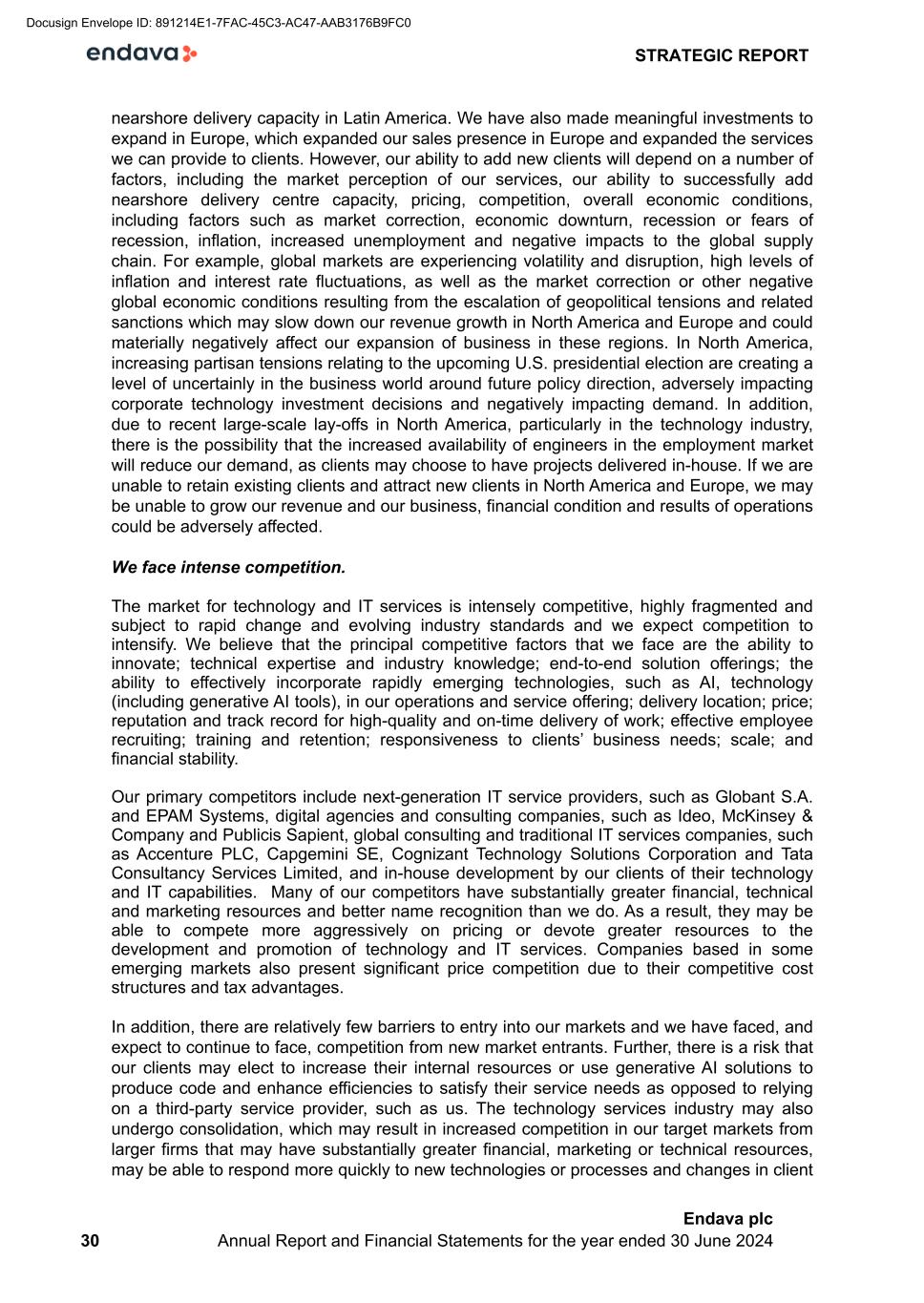
nearshore delivery capacity in Latin America. We have also made meaningful investments to expand in Europe, which expanded our sales presence in Europe and expanded the services we can provide to clients. However, our ability to add new clients will depend on a number of factors, including the market perception of our services, our ability to successfully add nearshore delivery centre capacity, pricing, competition, overall economic conditions, including factors such as market correction, economic downturn, recession or fears of recession, inflation, increased unemployment and negative impacts to the global supply chain. For example, global markets are experiencing volatility and disruption, high levels of inflation and interest rate fluctuations, as well as the market correction or other negative global economic conditions resulting from the escalation of geopolitical tensions and related sanctions which may slow down our revenue growth in North America and Europe and could materially negatively affect our expansion of business in these regions. In North America, increasing partisan tensions relating to the upcoming U.S. presidential election are creating a level of uncertainly in the business world around future policy direction, adversely impacting corporate technology investment decisions and negatively impacting demand. In addition, due to recent large-scale lay-offs in North America, particularly in the technology industry, there is the possibility that the increased availability of engineers in the employment market will reduce our demand, as clients may choose to have projects delivered in-house. If we are unable to retain existing clients and attract new clients in North America and Europe, we may be unable to grow our revenue and our business, financial condition and results of operations could be adversely affected. We face intense competition. The market for technology and IT services is intensely competitive, highly fragmented and subject to rapid change and evolving industry standards and we expect competition to intensify. We believe that the principal competitive factors that we face are the ability to innovate; technical expertise and industry knowledge; end-to-end solution offerings; the ability to effectively incorporate rapidly emerging technologies, such as AI, technology (including generative AI tools), in our operations and service offering; delivery location; price; reputation and track record for high-quality and on-time delivery of work; effective employee recruiting; training and retention; responsiveness to clients’ business needs; scale; and financial stability. Our primary competitors include next-generation IT service providers, such as Globant S.A. and EPAM Systems, digital agencies and consulting companies, such as Ideo, McKinsey & Company and Publicis Sapient, global consulting and traditional IT services companies, such as Accenture PLC, Capgemini SE, Cognizant Technology Solutions Corporation and Tata Consultancy Services Limited, and in-house development by our clients of their technology and IT capabilities. Many of our competitors have substantially greater financial, technical and marketing resources and better name recognition than we do. As a result, they may be able to compete more aggressively on pricing or devote greater resources to the development and promotion of technology and IT services. Companies based in some emerging markets also present significant price competition due to their competitive cost structures and tax advantages. In addition, there are relatively few barriers to entry into our markets and we have faced, and expect to continue to face, competition from new market entrants. Further, there is a risk that our clients may elect to increase their internal resources or use generative AI solutions to produce code and enhance efficiencies to satisfy their service needs as opposed to relying on a third-party service provider, such as us. The technology services industry may also undergo consolidation, which may result in increased competition in our target markets from larger firms that may have substantially greater financial, marketing or technical resources, may be able to respond more quickly to new technologies or processes and changes in client STRATEGIC REPORT 30 Endava plc Annual Report and Financial Statements for the year ended 30 June 2024 Docusign Envelope ID: 891214E1-7FAC-45C3-AC47-AAB3176B9FC0
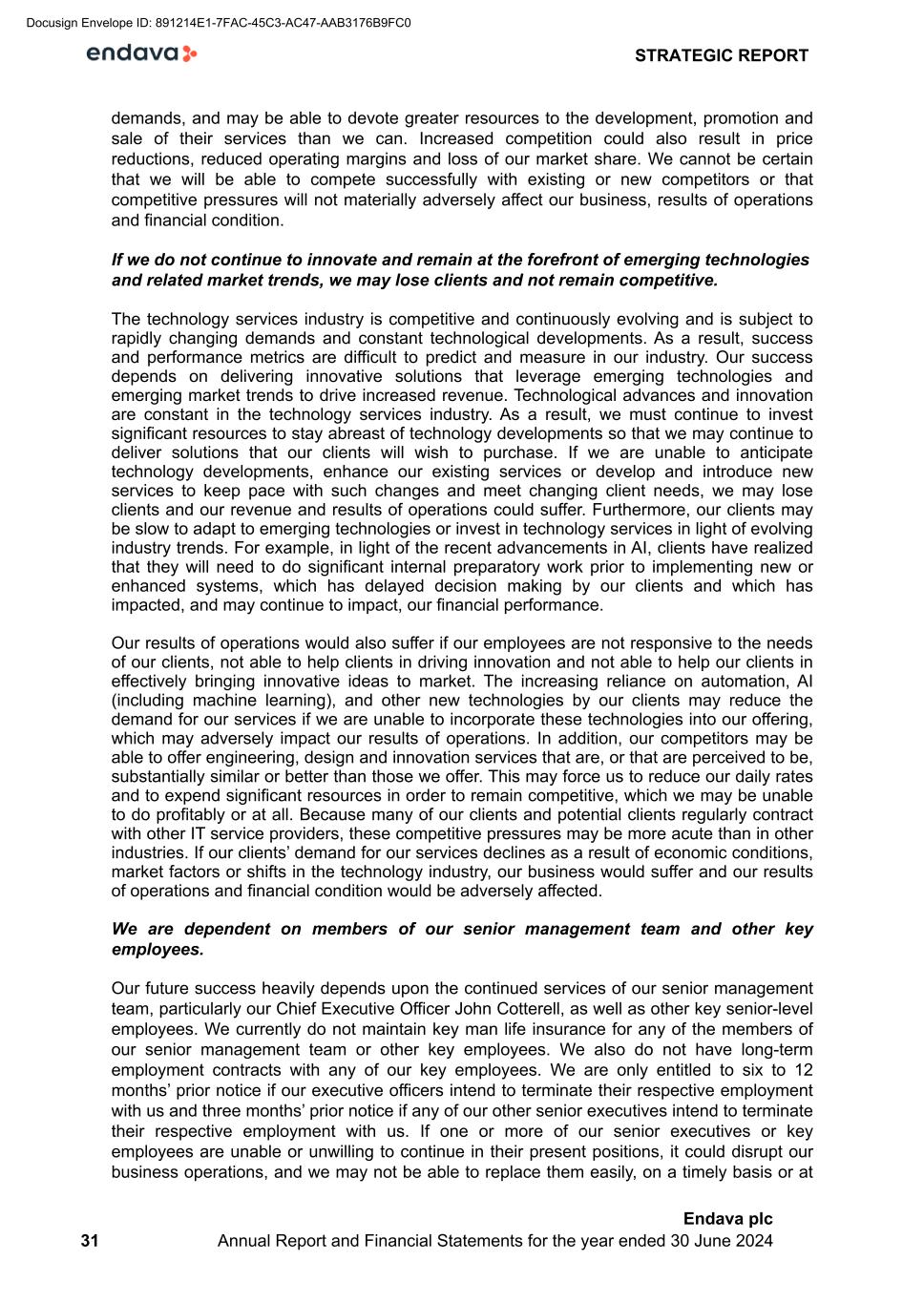
demands, and may be able to devote greater resources to the development, promotion and sale of their services than we can. Increased competition could also result in price reductions, reduced operating margins and loss of our market share. We cannot be certain that we will be able to compete successfully with existing or new competitors or that competitive pressures will not materially adversely affect our business, results of operations and financial condition. If we do not continue to innovate and remain at the forefront of emerging technologies and related market trends, we may lose clients and not remain competitive. The technology services industry is competitive and continuously evolving and is subject to rapidly changing demands and constant technological developments. As a result, success and performance metrics are difficult to predict and measure in our industry. Our success depends on delivering innovative solutions that leverage emerging technologies and emerging market trends to drive increased revenue. Technological advances and innovation are constant in the technology services industry. As a result, we must continue to invest significant resources to stay abreast of technology developments so that we may continue to deliver solutions that our clients will wish to purchase. If we are unable to anticipate technology developments, enhance our existing services or develop and introduce new services to keep pace with such changes and meet changing client needs, we may lose clients and our revenue and results of operations could suffer. Furthermore, our clients may be slow to adapt to emerging technologies or invest in technology services in light of evolving industry trends. For example, in light of the recent advancements in AI, clients have realized that they will need to do significant internal preparatory work prior to implementing new or enhanced systems, which has delayed decision making by our clients and which has impacted, and may continue to impact, our financial performance. Our results of operations would also suffer if our employees are not responsive to the needs of our clients, not able to help clients in driving innovation and not able to help our clients in effectively bringing innovative ideas to market. The increasing reliance on automation, AI (including machine learning), and other new technologies by our clients may reduce the demand for our services if we are unable to incorporate these technologies into our offering, which may adversely impact our results of operations. In addition, our competitors may be able to offer engineering, design and innovation services that are, or that are perceived to be, substantially similar or better than those we offer. This may force us to reduce our daily rates and to expend significant resources in order to remain competitive, which we may be unable to do profitably or at all. Because many of our clients and potential clients regularly contract with other IT service providers, these competitive pressures may be more acute than in other industries. If our clients’ demand for our services declines as a result of economic conditions, market factors or shifts in the technology industry, our business would suffer and our results of operations and financial condition would be adversely affected. We are dependent on members of our senior management team and other key employees. Our future success heavily depends upon the continued services of our senior management team, particularly our Chief Executive Officer John Cotterell, as well as other key senior-level employees. We currently do not maintain key man life insurance for any of the members of our senior management team or other key employees. We also do not have long-term employment contracts with any of our key employees. We are only entitled to six to 12 months’ prior notice if our executive officers intend to terminate their respective employment with us and three months’ prior notice if any of our other senior executives intend to terminate their respective employment with us. If one or more of our senior executives or key employees are unable or unwilling to continue in their present positions, it could disrupt our business operations, and we may not be able to replace them easily, on a timely basis or at STRATEGIC REPORT 31 Endava plc Annual Report and Financial Statements for the year ended 30 June 2024 Docusign Envelope ID: 891214E1-7FAC-45C3-AC47-AAB3176B9FC0

all. In addition, competition for senior executives and key employees in our industry is intense, and we may be unable to retain our senior executives and key employees or attract and retain new senior executives and key employees in the future, in which case our business may be severely disrupted. If any of our senior management team or key employees joins a competitor or forms a competing company, we may lose clients, suppliers, know-how and IT professionals and staff members to them. Also, if any of our sales executives or other sales personnel, who generally maintain close relationships with our clients, joins a competitor or forms a competing company, we may lose clients to that company, and our revenue may be materially adversely affected. Additionally, there could be unauthorised disclosure or use of our technical knowledge, business practices or procedures by such personnel. Any non- competition, non-solicitation or non-disclosure agreements we have with our senior executives or key employees might not provide effective protection to us in light of legal uncertainties associated with the enforceability of such agreements. Our business may suffer if we fail to identify and acquire appropriate acquisition targets, and recently completed and potential future acquisitions could prove difficult to integrate or may disrupt our business, dilute shareholder value, strain our resources or otherwise adversely affect our business, financial condition or results of operations. We have completed three acquisitions in the past fiscal year; GalaxE Group, Inc. and its subsidiaries in April 2024, EQ Tek SP z.o.o., or EQ Tek, in February 2024 and TLM Partners, Inc. and its subsidiaries in August 2023. If there is a lack of supply of businesses that satisfy our criteria and are willing to be acquired by us, or we fail to successfully acquire such businesses, this may negatively impact our growth targets and progress on strategic goals. In the future, we may pursue additional acquisition opportunities to enhance our capabilities, client base, geographic reach, country and industry diversification, financial performance and other factors. Realizing the benefits of acquisitions depends in part on the successful integration of operations and personnel. Integrating the operations of acquired businesses successfully or otherwise realizing any of the anticipated benefits of acquisitions, including anticipated cost savings and additional revenue opportunities, is complex and time- consuming and involves a number of potential challenges. These include the effective and timely alignment of the acquired entity’s processes and systems with ours, arranging suitably rigorous external audits of these acquired entities, reviewing the appropriateness of their key accounting policies, developing robust accounting systems, and ensuring that appropriate internal controls over these accounting systems are introduced to eventually operate in a regulated SOX environment. The failure to meet these integration challenges could delay full integration of the newly acquired businesses and could seriously harm our financial condition and results of operations. Past acquisitions and any acquisitions we may complete in the future will give rise to certain risks and we may encounter unexpected difficulties or incur unexpected costs, including: • diversion of management attention from ongoing business concerns to integration matters; • lack of available staff to perform the integration in a timely manner or inability of staff to perform ongoing business activities due to their integration work; • consolidating and rationalising information technology platforms and administrative infrastructures; STRATEGIC REPORT 32 Endava plc Annual Report and Financial Statements for the year ended 30 June 2024 Docusign Envelope ID: 891214E1-7FAC-45C3-AC47-AAB3176B9FC0
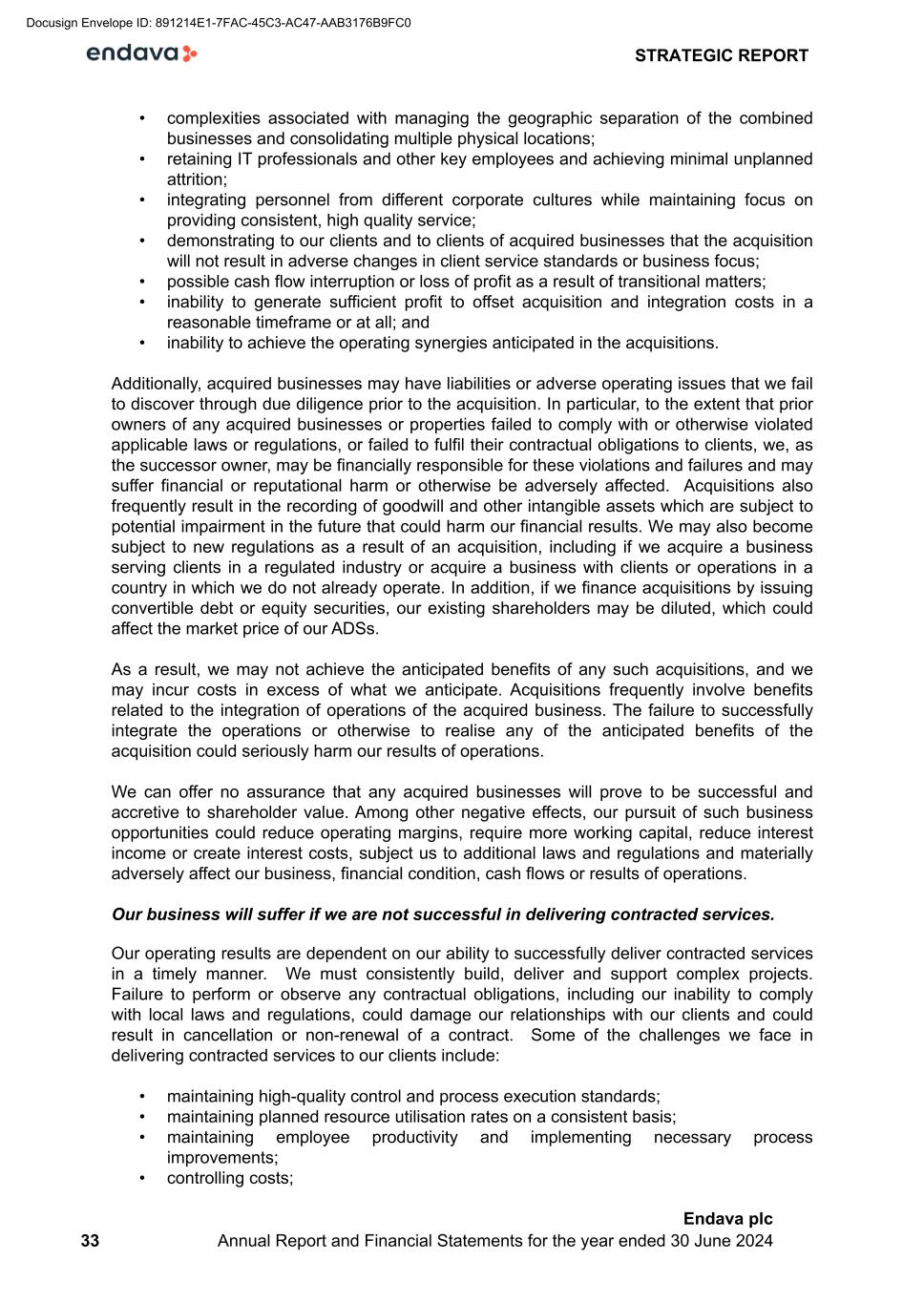
• complexities associated with managing the geographic separation of the combined businesses and consolidating multiple physical locations; • retaining IT professionals and other key employees and achieving minimal unplanned attrition; • integrating personnel from different corporate cultures while maintaining focus on providing consistent, high quality service; • demonstrating to our clients and to clients of acquired businesses that the acquisition will not result in adverse changes in client service standards or business focus; • possible cash flow interruption or loss of profit as a result of transitional matters; • inability to generate sufficient profit to offset acquisition and integration costs in a reasonable timeframe or at all; and • inability to achieve the operating synergies anticipated in the acquisitions. Additionally, acquired businesses may have liabilities or adverse operating issues that we fail to discover through due diligence prior to the acquisition. In particular, to the extent that prior owners of any acquired businesses or properties failed to comply with or otherwise violated applicable laws or regulations, or failed to fulfil their contractual obligations to clients, we, as the successor owner, may be financially responsible for these violations and failures and may suffer financial or reputational harm or otherwise be adversely affected. Acquisitions also frequently result in the recording of goodwill and other intangible assets which are subject to potential impairment in the future that could harm our financial results. We may also become subject to new regulations as a result of an acquisition, including if we acquire a business serving clients in a regulated industry or acquire a business with clients or operations in a country in which we do not already operate. In addition, if we finance acquisitions by issuing convertible debt or equity securities, our existing shareholders may be diluted, which could affect the market price of our ADSs. As a result, we may not achieve the anticipated benefits of any such acquisitions, and we may incur costs in excess of what we anticipate. Acquisitions frequently involve benefits related to the integration of operations of the acquired business. The failure to successfully integrate the operations or otherwise to realise any of the anticipated benefits of the acquisition could seriously harm our results of operations. We can offer no assurance that any acquired businesses will prove to be successful and accretive to shareholder value. Among other negative effects, our pursuit of such business opportunities could reduce operating margins, require more working capital, reduce interest income or create interest costs, subject us to additional laws and regulations and materially adversely affect our business, financial condition, cash flows or results of operations. Our business will suffer if we are not successful in delivering contracted services. Our operating results are dependent on our ability to successfully deliver contracted services in a timely manner. We must consistently build, deliver and support complex projects. Failure to perform or observe any contractual obligations, including our inability to comply with local laws and regulations, could damage our relationships with our clients and could result in cancellation or non-renewal of a contract. Some of the challenges we face in delivering contracted services to our clients include: • maintaining high-quality control and process execution standards; • maintaining planned resource utilisation rates on a consistent basis; • maintaining employee productivity and implementing necessary process improvements; • controlling costs; STRATEGIC REPORT 33 Endava plc Annual Report and Financial Statements for the year ended 30 June 2024 Docusign Envelope ID: 891214E1-7FAC-45C3-AC47-AAB3176B9FC0
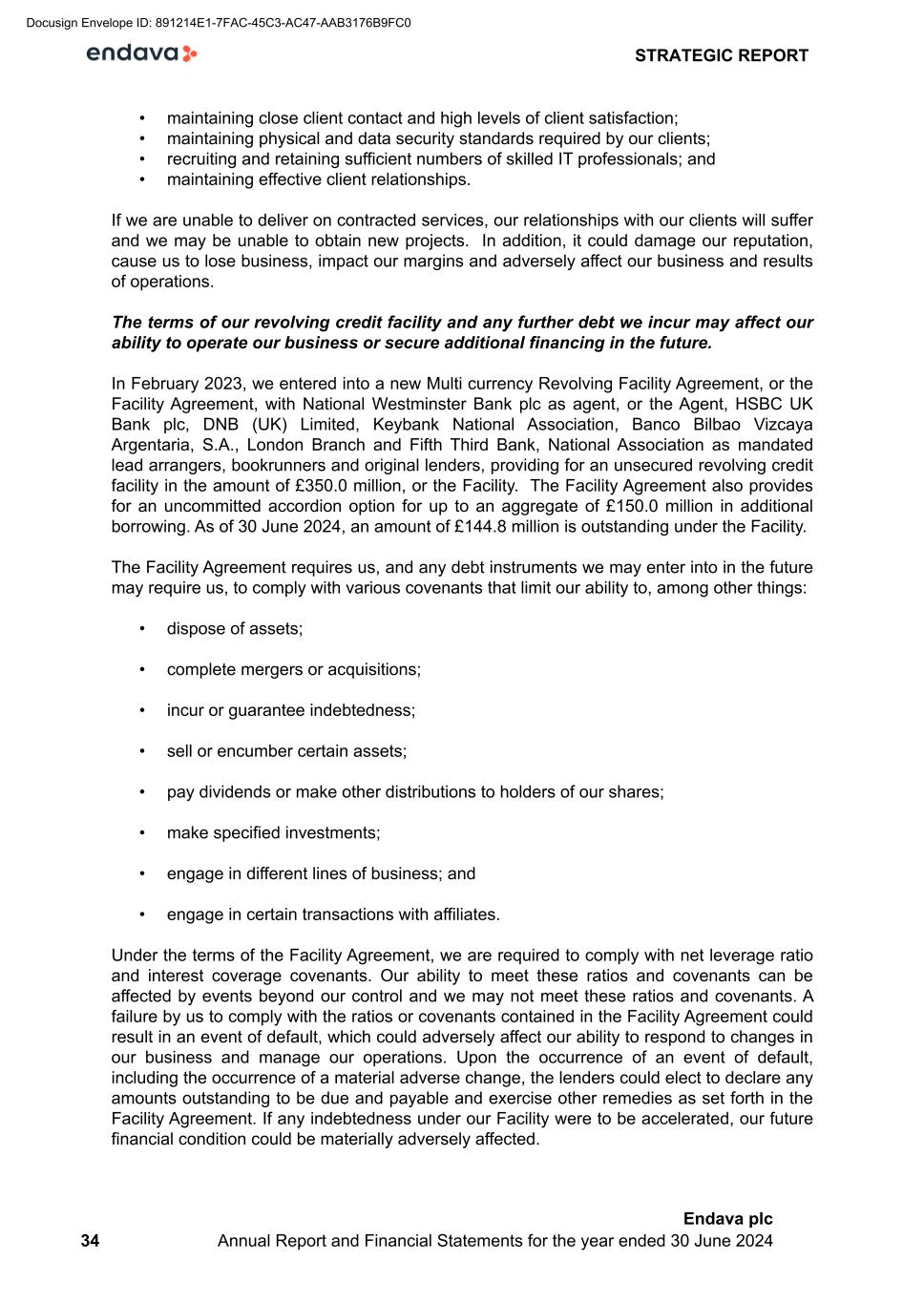
• maintaining close client contact and high levels of client satisfaction; • maintaining physical and data security standards required by our clients; • recruiting and retaining sufficient numbers of skilled IT professionals; and • maintaining effective client relationships. If we are unable to deliver on contracted services, our relationships with our clients will suffer and we may be unable to obtain new projects. In addition, it could damage our reputation, cause us to lose business, impact our margins and adversely affect our business and results of operations. The terms of our revolving credit facility and any further debt we incur may affect our ability to operate our business or secure additional financing in the future. In February 2023, we entered into a new Multi currency Revolving Facility Agreement, or the Facility Agreement, with National Westminster Bank plc as agent, or the Agent, HSBC UK Bank plc, DNB (UK) Limited, Keybank National Association, Banco Bilbao Vizcaya Argentaria, S.A., London Branch and Fifth Third Bank, National Association as mandated lead arrangers, bookrunners and original lenders, providing for an unsecured revolving credit facility in the amount of £350.0 million, or the Facility. The Facility Agreement also provides for an uncommitted accordion option for up to an aggregate of £150.0 million in additional borrowing. As of 30 June 2024, an amount of £144.8 million is outstanding under the Facility. The Facility Agreement requires us, and any debt instruments we may enter into in the future may require us, to comply with various covenants that limit our ability to, among other things: • dispose of assets; • complete mergers or acquisitions; • incur or guarantee indebtedness; • sell or encumber certain assets; • pay dividends or make other distributions to holders of our shares; • make specified investments; • engage in different lines of business; and • engage in certain transactions with affiliates. Under the terms of the Facility Agreement, we are required to comply with net leverage ratio and interest coverage covenants. Our ability to meet these ratios and covenants can be affected by events beyond our control and we may not meet these ratios and covenants. A failure by us to comply with the ratios or covenants contained in the Facility Agreement could result in an event of default, which could adversely affect our ability to respond to changes in our business and manage our operations. Upon the occurrence of an event of default, including the occurrence of a material adverse change, the lenders could elect to declare any amounts outstanding to be due and payable and exercise other remedies as set forth in the Facility Agreement. If any indebtedness under our Facility were to be accelerated, our future financial condition could be materially adversely affected. STRATEGIC REPORT 34 Endava plc Annual Report and Financial Statements for the year ended 30 June 2024 Docusign Envelope ID: 891214E1-7FAC-45C3-AC47-AAB3176B9FC0
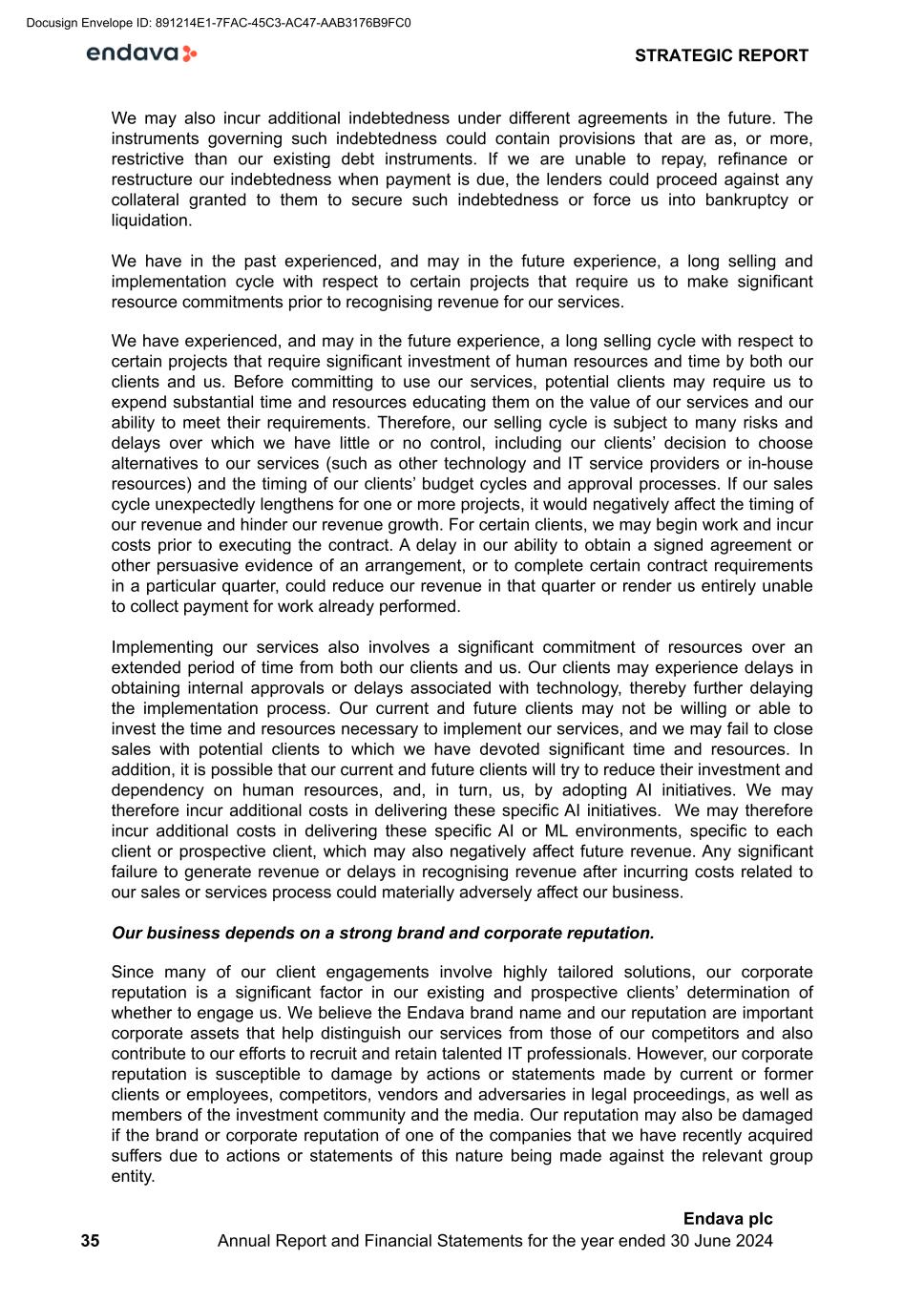
We may also incur additional indebtedness under different agreements in the future. The instruments governing such indebtedness could contain provisions that are as, or more, restrictive than our existing debt instruments. If we are unable to repay, refinance or restructure our indebtedness when payment is due, the lenders could proceed against any collateral granted to them to secure such indebtedness or force us into bankruptcy or liquidation. We have in the past experienced, and may in the future experience, a long selling and implementation cycle with respect to certain projects that require us to make significant resource commitments prior to recognising revenue for our services. We have experienced, and may in the future experience, a long selling cycle with respect to certain projects that require significant investment of human resources and time by both our clients and us. Before committing to use our services, potential clients may require us to expend substantial time and resources educating them on the value of our services and our ability to meet their requirements. Therefore, our selling cycle is subject to many risks and delays over which we have little or no control, including our clients’ decision to choose alternatives to our services (such as other technology and IT service providers or in-house resources) and the timing of our clients’ budget cycles and approval processes. If our sales cycle unexpectedly lengthens for one or more projects, it would negatively affect the timing of our revenue and hinder our revenue growth. For certain clients, we may begin work and incur costs prior to executing the contract. A delay in our ability to obtain a signed agreement or other persuasive evidence of an arrangement, or to complete certain contract requirements in a particular quarter, could reduce our revenue in that quarter or render us entirely unable to collect payment for work already performed. Implementing our services also involves a significant commitment of resources over an extended period of time from both our clients and us. Our clients may experience delays in obtaining internal approvals or delays associated with technology, thereby further delaying the implementation process. Our current and future clients may not be willing or able to invest the time and resources necessary to implement our services, and we may fail to close sales with potential clients to which we have devoted significant time and resources. In addition, it is possible that our current and future clients will try to reduce their investment and dependency on human resources, and, in turn, us, by adopting AI initiatives. We may therefore incur additional costs in delivering these specific AI initiatives. We may therefore incur additional costs in delivering these specific AI or ML environments, specific to each client or prospective client, which may also negatively affect future revenue. Any significant failure to generate revenue or delays in recognising revenue after incurring costs related to our sales or services process could materially adversely affect our business. Our business depends on a strong brand and corporate reputation. Since many of our client engagements involve highly tailored solutions, our corporate reputation is a significant factor in our existing and prospective clients’ determination of whether to engage us. We believe the Endava brand name and our reputation are important corporate assets that help distinguish our services from those of our competitors and also contribute to our efforts to recruit and retain talented IT professionals. However, our corporate reputation is susceptible to damage by actions or statements made by current or former clients or employees, competitors, vendors and adversaries in legal proceedings, as well as members of the investment community and the media. Our reputation may also be damaged if the brand or corporate reputation of one of the companies that we have recently acquired suffers due to actions or statements of this nature being made against the relevant group entity. STRATEGIC REPORT 35 Endava plc Annual Report and Financial Statements for the year ended 30 June 2024 Docusign Envelope ID: 891214E1-7FAC-45C3-AC47-AAB3176B9FC0
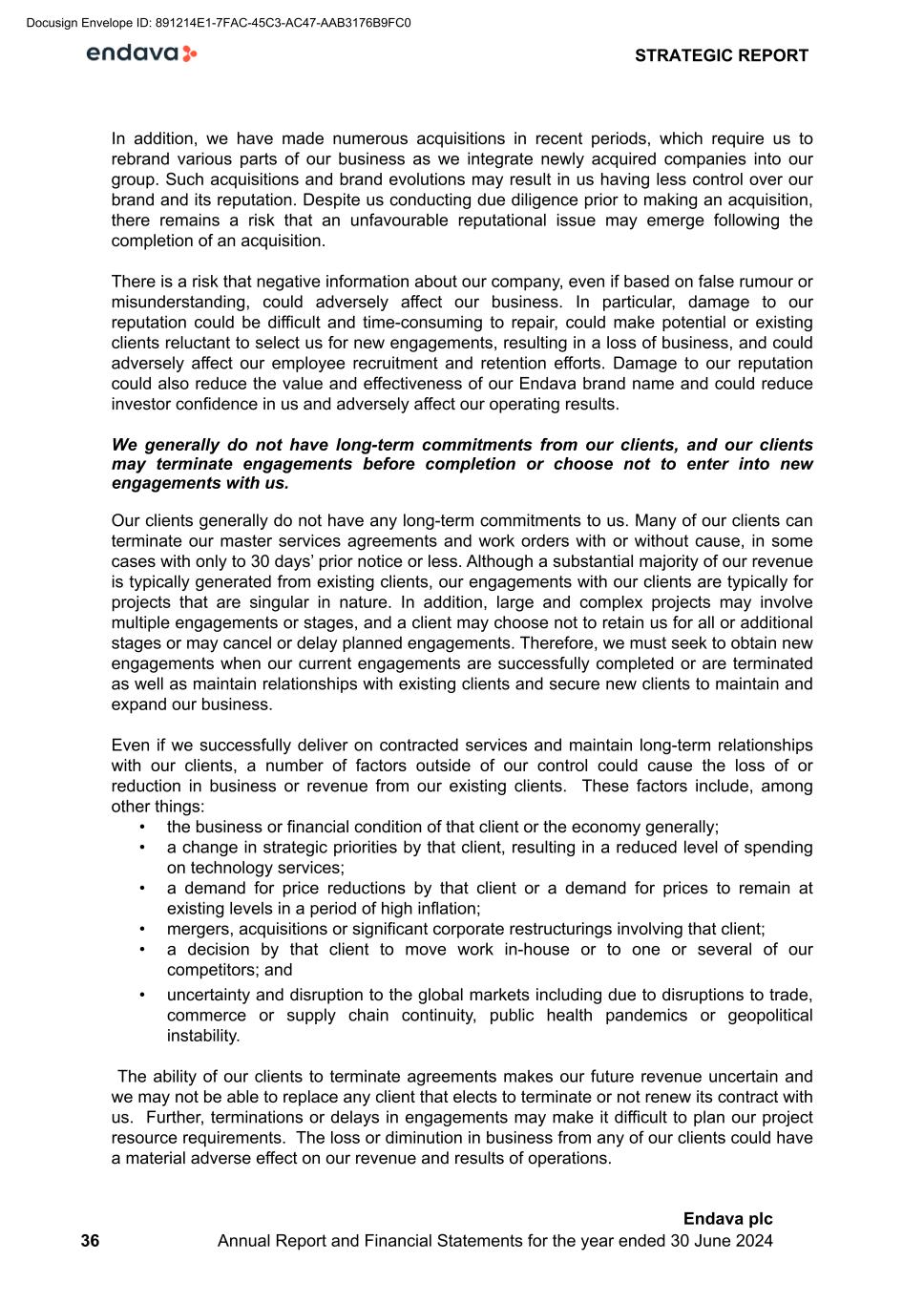
In addition, we have made numerous acquisitions in recent periods, which require us to rebrand various parts of our business as we integrate newly acquired companies into our group. Such acquisitions and brand evolutions may result in us having less control over our brand and its reputation. Despite us conducting due diligence prior to making an acquisition, there remains a risk that an unfavourable reputational issue may emerge following the completion of an acquisition. There is a risk that negative information about our company, even if based on false rumour or misunderstanding, could adversely affect our business. In particular, damage to our reputation could be difficult and time-consuming to repair, could make potential or existing clients reluctant to select us for new engagements, resulting in a loss of business, and could adversely affect our employee recruitment and retention efforts. Damage to our reputation could also reduce the value and effectiveness of our Endava brand name and could reduce investor confidence in us and adversely affect our operating results. We generally do not have long-term commitments from our clients, and our clients may terminate engagements before completion or choose not to enter into new engagements with us. Our clients generally do not have any long-term commitments to us. Many of our clients can terminate our master services agreements and work orders with or without cause, in some cases with only to 30 days’ prior notice or less. Although a substantial majority of our revenue is typically generated from existing clients, our engagements with our clients are typically for projects that are singular in nature. In addition, large and complex projects may involve multiple engagements or stages, and a client may choose not to retain us for all or additional stages or may cancel or delay planned engagements. Therefore, we must seek to obtain new engagements when our current engagements are successfully completed or are terminated as well as maintain relationships with existing clients and secure new clients to maintain and expand our business. Even if we successfully deliver on contracted services and maintain long-term relationships with our clients, a number of factors outside of our control could cause the loss of or reduction in business or revenue from our existing clients. These factors include, among other things: • the business or financial condition of that client or the economy generally; • a change in strategic priorities by that client, resulting in a reduced level of spending on technology services; • a demand for price reductions by that client or a demand for prices to remain at existing levels in a period of high inflation; • mergers, acquisitions or significant corporate restructurings involving that client; • a decision by that client to move work in-house or to one or several of our competitors; and • uncertainty and disruption to the global markets including due to disruptions to trade, commerce or supply chain continuity, public health pandemics or geopolitical instability. The ability of our clients to terminate agreements makes our future revenue uncertain and we may not be able to replace any client that elects to terminate or not renew its contract with us. Further, terminations or delays in engagements may make it difficult to plan our project resource requirements. The loss or diminution in business from any of our clients could have a material adverse effect on our revenue and results of operations. STRATEGIC REPORT 36 Endava plc Annual Report and Financial Statements for the year ended 30 June 2024 Docusign Envelope ID: 891214E1-7FAC-45C3-AC47-AAB3176B9FC0
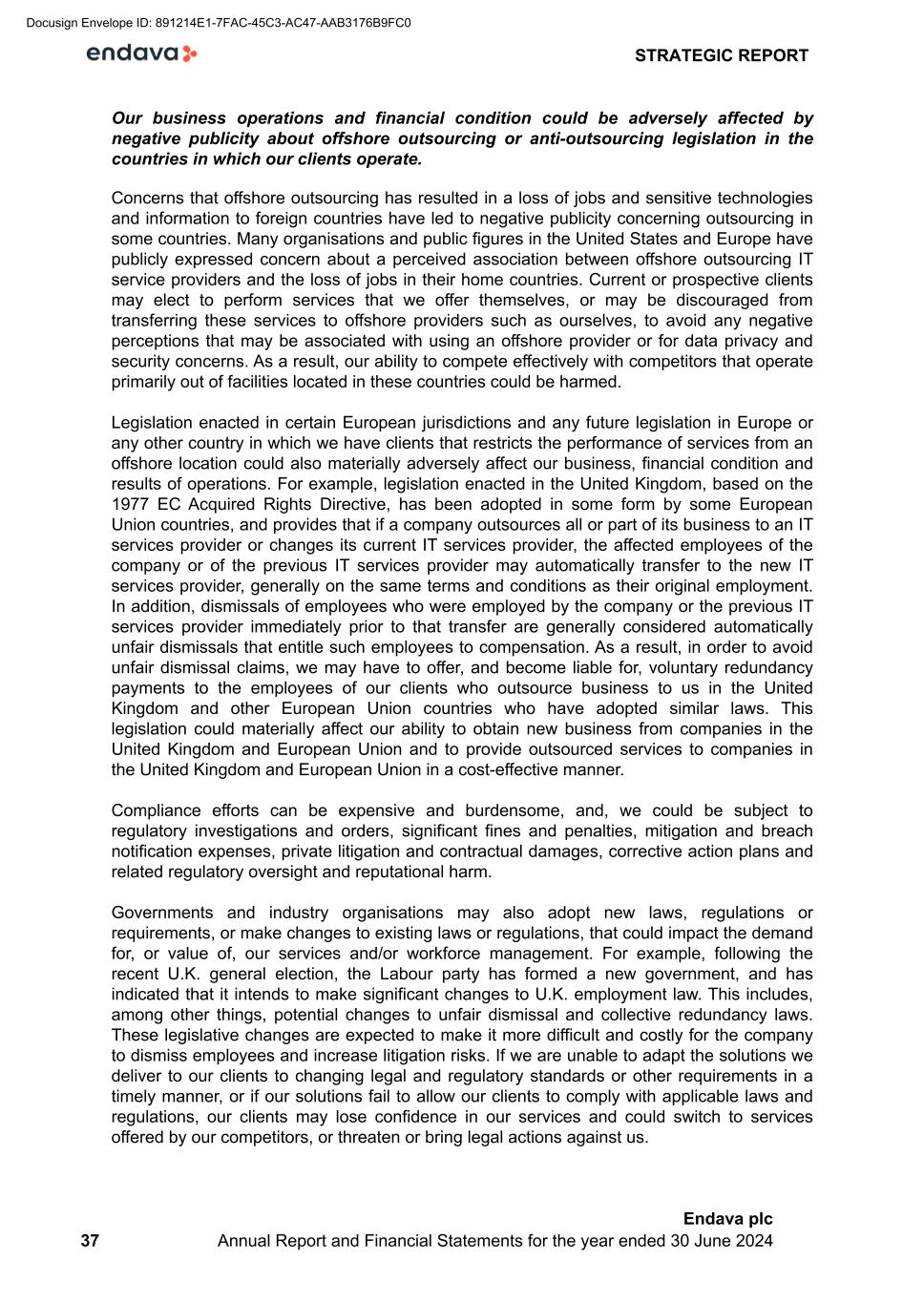
Our business operations and financial condition could be adversely affected by negative publicity about offshore outsourcing or anti-outsourcing legislation in the countries in which our clients operate. Concerns that offshore outsourcing has resulted in a loss of jobs and sensitive technologies and information to foreign countries have led to negative publicity concerning outsourcing in some countries. Many organisations and public figures in the United States and Europe have publicly expressed concern about a perceived association between offshore outsourcing IT service providers and the loss of jobs in their home countries. Current or prospective clients may elect to perform services that we offer themselves, or may be discouraged from transferring these services to offshore providers such as ourselves, to avoid any negative perceptions that may be associated with using an offshore provider or for data privacy and security concerns. As a result, our ability to compete effectively with competitors that operate primarily out of facilities located in these countries could be harmed. Legislation enacted in certain European jurisdictions and any future legislation in Europe or any other country in which we have clients that restricts the performance of services from an offshore location could also materially adversely affect our business, financial condition and results of operations. For example, legislation enacted in the United Kingdom, based on the 1977 EC Acquired Rights Directive, has been adopted in some form by some European Union countries, and provides that if a company outsources all or part of its business to an IT services provider or changes its current IT services provider, the affected employees of the company or of the previous IT services provider may automatically transfer to the new IT services provider, generally on the same terms and conditions as their original employment. In addition, dismissals of employees who were employed by the company or the previous IT services provider immediately prior to that transfer are generally considered automatically unfair dismissals that entitle such employees to compensation. As a result, in order to avoid unfair dismissal claims, we may have to offer, and become liable for, voluntary redundancy payments to the employees of our clients who outsource business to us in the United Kingdom and other European Union countries who have adopted similar laws. This legislation could materially affect our ability to obtain new business from companies in the United Kingdom and European Union and to provide outsourced services to companies in the United Kingdom and European Union in a cost-effective manner. Compliance efforts can be expensive and burdensome, and, we could be subject to regulatory investigations and orders, significant fines and penalties, mitigation and breach notification expenses, private litigation and contractual damages, corrective action plans and related regulatory oversight and reputational harm. Governments and industry organisations may also adopt new laws, regulations or requirements, or make changes to existing laws or regulations, that could impact the demand for, or value of, our services and/or workforce management. For example, following the recent U.K. general election, the Labour party has formed a new government, and has indicated that it intends to make significant changes to U.K. employment law. This includes, among other things, potential changes to unfair dismissal and collective redundancy laws. These legislative changes are expected to make it more difficult and costly for the company to dismiss employees and increase litigation risks. If we are unable to adapt the solutions we deliver to our clients to changing legal and regulatory standards or other requirements in a timely manner, or if our solutions fail to allow our clients to comply with applicable laws and regulations, our clients may lose confidence in our services and could switch to services offered by our competitors, or threaten or bring legal actions against us. STRATEGIC REPORT 37 Endava plc Annual Report and Financial Statements for the year ended 30 June 2024 Docusign Envelope ID: 891214E1-7FAC-45C3-AC47-AAB3176B9FC0
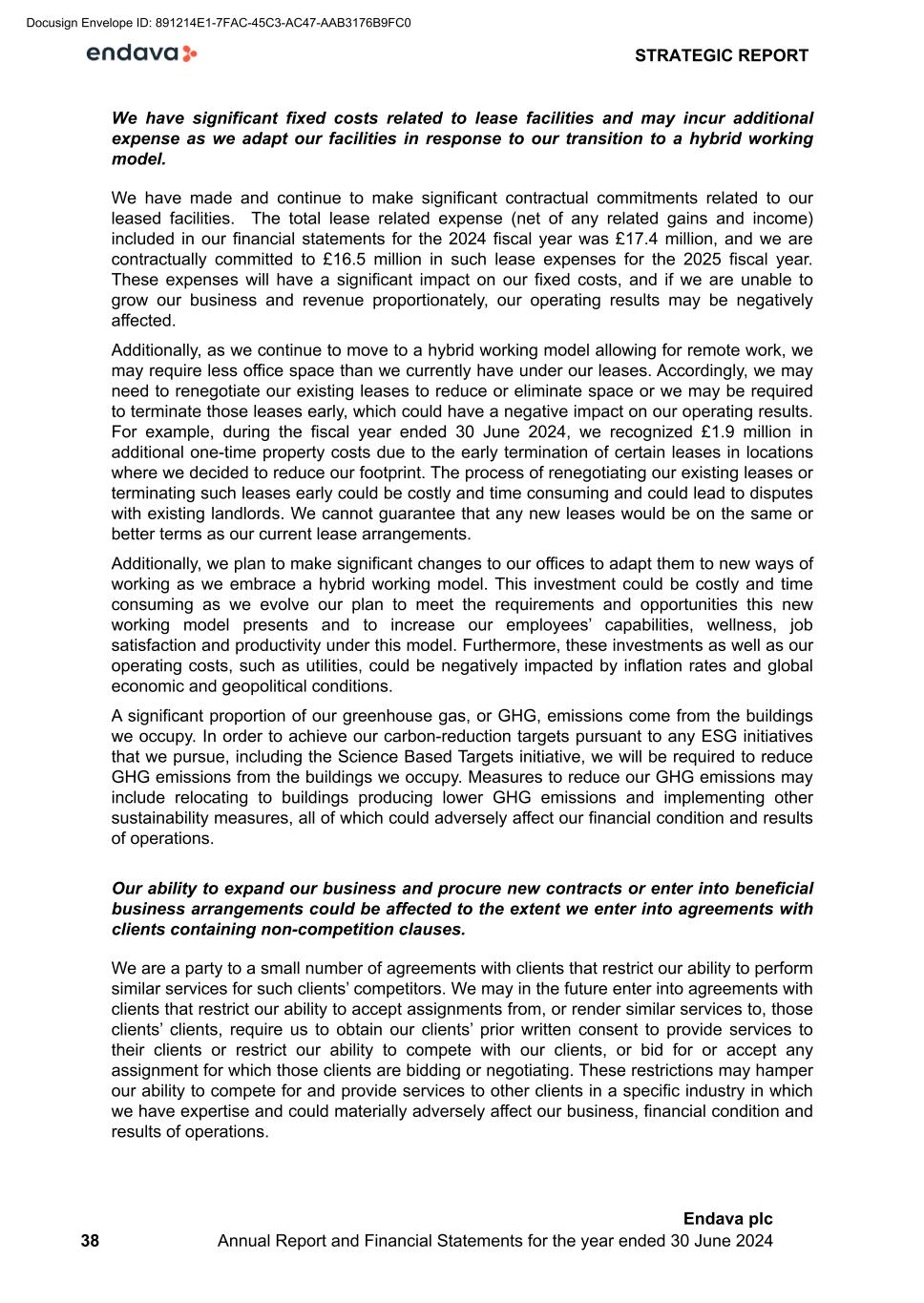
We have significant fixed costs related to lease facilities and may incur additional expense as we adapt our facilities in response to our transition to a hybrid working model. We have made and continue to make significant contractual commitments related to our leased facilities. The total lease related expense (net of any related gains and income) included in our financial statements for the 2024 fiscal year was £17.4 million, and we are contractually committed to £16.5 million in such lease expenses for the 2025 fiscal year. These expenses will have a significant impact on our fixed costs, and if we are unable to grow our business and revenue proportionately, our operating results may be negatively affected. Additionally, as we continue to move to a hybrid working model allowing for remote work, we may require less office space than we currently have under our leases. Accordingly, we may need to renegotiate our existing leases to reduce or eliminate space or we may be required to terminate those leases early, which could have a negative impact on our operating results. For example, during the fiscal year ended 30 June 2024, we recognized £1.9 million in additional one-time property costs due to the early termination of certain leases in locations where we decided to reduce our footprint. The process of renegotiating our existing leases or terminating such leases early could be costly and time consuming and could lead to disputes with existing landlords. We cannot guarantee that any new leases would be on the same or better terms as our current lease arrangements. Additionally, we plan to make significant changes to our offices to adapt them to new ways of working as we embrace a hybrid working model. This investment could be costly and time consuming as we evolve our plan to meet the requirements and opportunities this new working model presents and to increase our employees’ capabilities, wellness, job satisfaction and productivity under this model. Furthermore, these investments as well as our operating costs, such as utilities, could be negatively impacted by inflation rates and global economic and geopolitical conditions. A significant proportion of our greenhouse gas, or GHG, emissions come from the buildings we occupy. In order to achieve our carbon-reduction targets pursuant to any ESG initiatives that we pursue, including the Science Based Targets initiative, we will be required to reduce GHG emissions from the buildings we occupy. Measures to reduce our GHG emissions may include relocating to buildings producing lower GHG emissions and implementing other sustainability measures, all of which could adversely affect our financial condition and results of operations. Our ability to expand our business and procure new contracts or enter into beneficial business arrangements could be affected to the extent we enter into agreements with clients containing non-competition clauses. We are a party to a small number of agreements with clients that restrict our ability to perform similar services for such clients’ competitors. We may in the future enter into agreements with clients that restrict our ability to accept assignments from, or render similar services to, those clients’ clients, require us to obtain our clients’ prior written consent to provide services to their clients or restrict our ability to compete with our clients, or bid for or accept any assignment for which those clients are bidding or negotiating. These restrictions may hamper our ability to compete for and provide services to other clients in a specific industry in which we have expertise and could materially adversely affect our business, financial condition and results of operations. STRATEGIC REPORT 38 Endava plc Annual Report and Financial Statements for the year ended 30 June 2024 Docusign Envelope ID: 891214E1-7FAC-45C3-AC47-AAB3176B9FC0
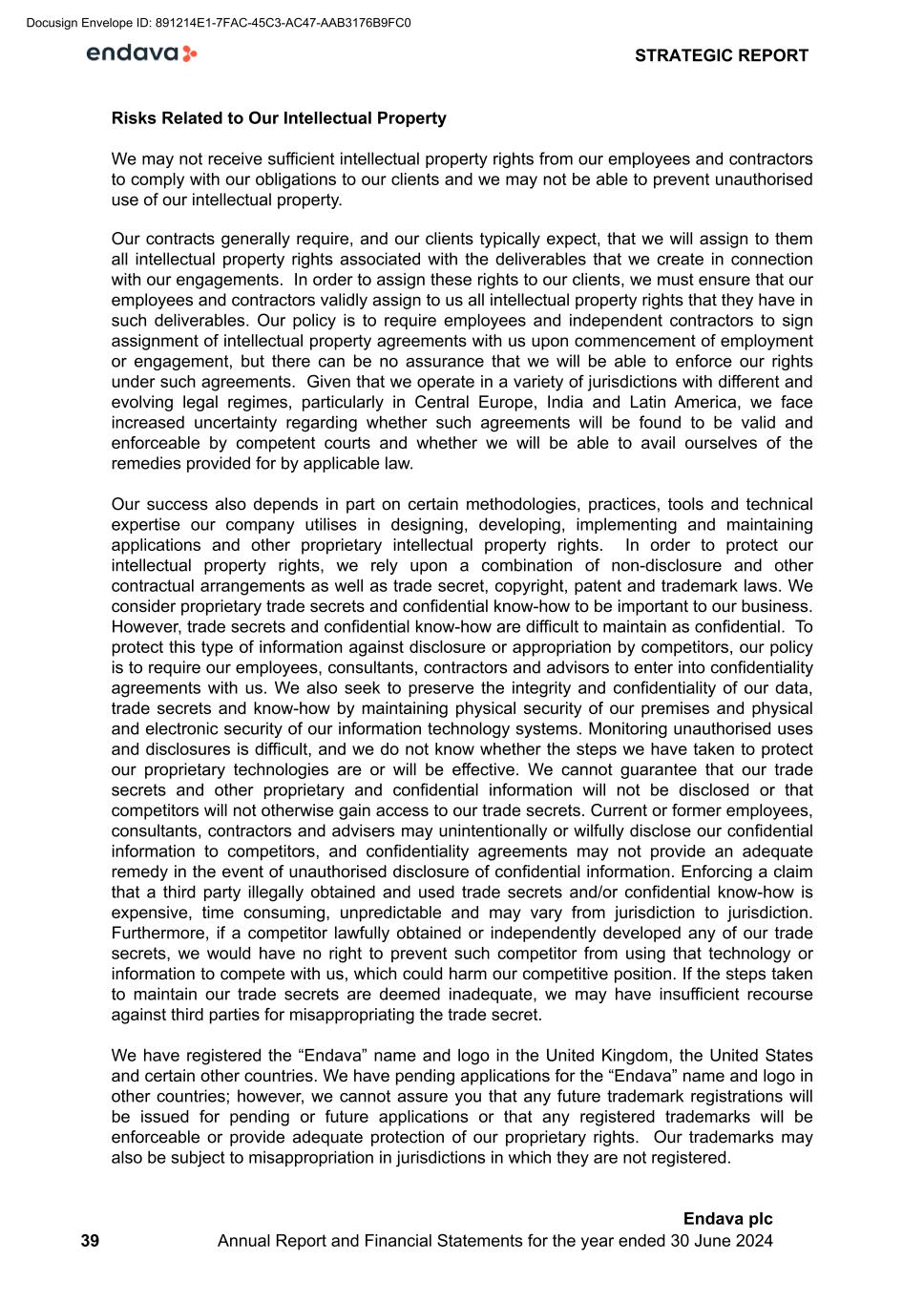
Risks Related to Our Intellectual Property We may not receive sufficient intellectual property rights from our employees and contractors to comply with our obligations to our clients and we may not be able to prevent unauthorised use of our intellectual property. Our contracts generally require, and our clients typically expect, that we will assign to them all intellectual property rights associated with the deliverables that we create in connection with our engagements. In order to assign these rights to our clients, we must ensure that our employees and contractors validly assign to us all intellectual property rights that they have in such deliverables. Our policy is to require employees and independent contractors to sign assignment of intellectual property agreements with us upon commencement of employment or engagement, but there can be no assurance that we will be able to enforce our rights under such agreements. Given that we operate in a variety of jurisdictions with different and evolving legal regimes, particularly in Central Europe, India and Latin America, we face increased uncertainty regarding whether such agreements will be found to be valid and enforceable by competent courts and whether we will be able to avail ourselves of the remedies provided for by applicable law. Our success also depends in part on certain methodologies, practices, tools and technical expertise our company utilises in designing, developing, implementing and maintaining applications and other proprietary intellectual property rights. In order to protect our intellectual property rights, we rely upon a combination of non-disclosure and other contractual arrangements as well as trade secret, copyright, patent and trademark laws. We consider proprietary trade secrets and confidential know-how to be important to our business. However, trade secrets and confidential know-how are difficult to maintain as confidential. To protect this type of information against disclosure or appropriation by competitors, our policy is to require our employees, consultants, contractors and advisors to enter into confidentiality agreements with us. We also seek to preserve the integrity and confidentiality of our data, trade secrets and know-how by maintaining physical security of our premises and physical and electronic security of our information technology systems. Monitoring unauthorised uses and disclosures is difficult, and we do not know whether the steps we have taken to protect our proprietary technologies are or will be effective. We cannot guarantee that our trade secrets and other proprietary and confidential information will not be disclosed or that competitors will not otherwise gain access to our trade secrets. Current or former employees, consultants, contractors and advisers may unintentionally or wilfully disclose our confidential information to competitors, and confidentiality agreements may not provide an adequate remedy in the event of unauthorised disclosure of confidential information. Enforcing a claim that a third party illegally obtained and used trade secrets and/or confidential know-how is expensive, time consuming, unpredictable and may vary from jurisdiction to jurisdiction. Furthermore, if a competitor lawfully obtained or independently developed any of our trade secrets, we would have no right to prevent such competitor from using that technology or information to compete with us, which could harm our competitive position. If the steps taken to maintain our trade secrets are deemed inadequate, we may have insufficient recourse against third parties for misappropriating the trade secret. We have registered the “Endava” name and logo in the United Kingdom, the United States and certain other countries. We have pending applications for the “Endava” name and logo in other countries; however, we cannot assure you that any future trademark registrations will be issued for pending or future applications or that any registered trademarks will be enforceable or provide adequate protection of our proprietary rights. Our trademarks may also be subject to misappropriation in jurisdictions in which they are not registered. STRATEGIC REPORT 39 Endava plc Annual Report and Financial Statements for the year ended 30 June 2024 Docusign Envelope ID: 891214E1-7FAC-45C3-AC47-AAB3176B9FC0

We may be subject to claims by third parties asserting that companies we have acquired, our employees or we have misappropriated their intellectual property, or claiming ownership of what we regard as our own intellectual property. We could be subject to claims by third parties that companies we have acquired, our employees or we have misappropriated their intellectual property. Many of our employees were previously employed at our competitors or potential competitors. Some of these employees executed proprietary rights, non-disclosure and non-competition agreements in connection with such previous employment. Although we try to ensure that our employees do not use the proprietary information of others in their work for us, we may be subject to claims that we or these employees have used or disclosed confidential information or intellectual property, including trade secrets or other proprietary information, of any such employee's former employer. Litigation may be necessary to defend against these claims. In addition, we are subject to additional risks as a result of our recent and future acquisitions. The developers of the technology that we have acquired or may acquire may not have appropriately created, maintained or enforced intellectual property rights in such technology. Indemnification and other rights under acquisition documents may be limited in term and scope and may therefore provide little or no protection from these risks. If we fail in prosecuting or defending any such claims, in addition to paying monetary damages, we may lose valuable intellectual property rights or personnel or sustain damages. Such intellectual property rights could be awarded to a third party. Even if we successfully prosecute or defend against such claims, litigation could result in substantial costs and distract management. If we incur any liability for a violation of the intellectual property rights of others, our reputation, business, financial condition and prospects may be adversely affected. Our success largely depends on our ability to use and develop our technology, tools, code, methodologies and services without infringing the intellectual property rights of third parties, including patents, copyrights, trade secrets and trademarks. We may be subject to litigation involving claims of patent infringement or violation of other intellectual property rights of third parties. Parties making infringement claims may be able to obtain an injunction to prevent us from delivering our services or using technology involving the allegedly infringing intellectual property. A successful infringement claim against us, whether with or without merit, could, among other things, require us to pay substantial damages, develop substitute non-infringing technology, or rebrand our name or enter into royalty or license agreements that may not be available on acceptable terms, if at all, and would require us to cease making, licensing or using products that have infringed a third party’s intellectual property rights. Protracted litigation could also result in existing or potential clients deferring or limiting their purchase or use of our services until resolution of such litigation, or could require us to indemnify our clients against infringement claims in certain instances. Any intellectual property claim or litigation, whether we ultimately win or lose, could damage our reputation and materially adversely affect our business, financial condition and results of operations. In addition, we typically indemnify clients who purchase our services and solutions against potential infringement of intellectual property rights, which subjects us to the risk of indemnification claims. These claims may require us to initiate or defend protracted and costly litigation on behalf of our clients, regardless of the merits of these claims and are often not subject to liability limits or exclusion of consequential, indirect or punitive damages. If any of these claims succeed, we may be forced to pay damages on behalf of our clients, redesign or cease offering our allegedly infringing services or solutions, or obtain licenses for the intellectual property related to such services or solutions. If we cannot obtain all necessary STRATEGIC REPORT 40 Endava plc Annual Report and Financial Statements for the year ended 30 June 2024 Docusign Envelope ID: 891214E1-7FAC-45C3-AC47-AAB3176B9FC0
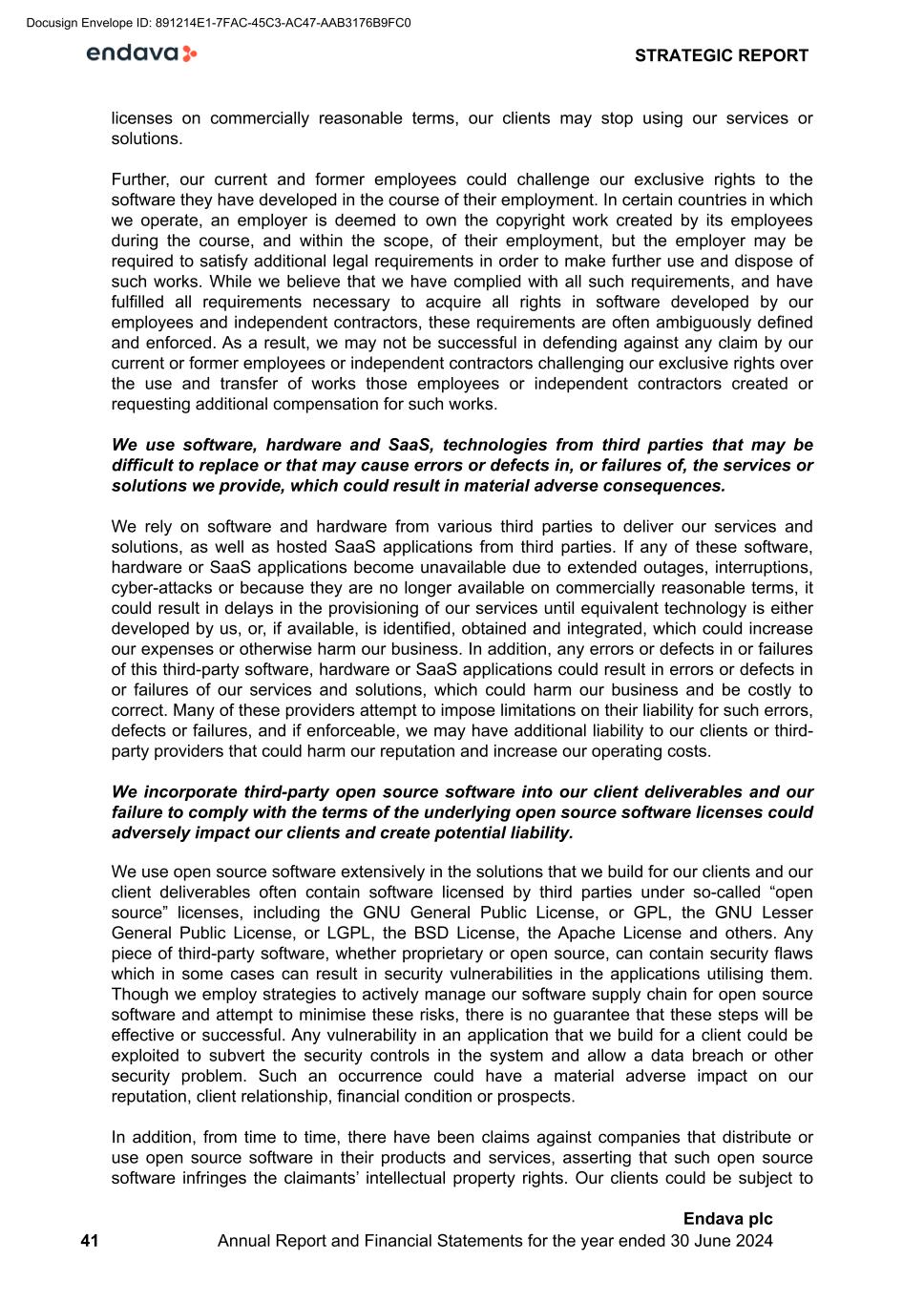
licenses on commercially reasonable terms, our clients may stop using our services or solutions. Further, our current and former employees could challenge our exclusive rights to the software they have developed in the course of their employment. In certain countries in which we operate, an employer is deemed to own the copyright work created by its employees during the course, and within the scope, of their employment, but the employer may be required to satisfy additional legal requirements in order to make further use and dispose of such works. While we believe that we have complied with all such requirements, and have fulfilled all requirements necessary to acquire all rights in software developed by our employees and independent contractors, these requirements are often ambiguously defined and enforced. As a result, we may not be successful in defending against any claim by our current or former employees or independent contractors challenging our exclusive rights over the use and transfer of works those employees or independent contractors created or requesting additional compensation for such works. We use software, hardware and SaaS, technologies from third parties that may be difficult to replace or that may cause errors or defects in, or failures of, the services or solutions we provide, which could result in material adverse consequences. We rely on software and hardware from various third parties to deliver our services and solutions, as well as hosted SaaS applications from third parties. If any of these software, hardware or SaaS applications become unavailable due to extended outages, interruptions, cyber-attacks or because they are no longer available on commercially reasonable terms, it could result in delays in the provisioning of our services until equivalent technology is either developed by us, or, if available, is identified, obtained and integrated, which could increase our expenses or otherwise harm our business. In addition, any errors or defects in or failures of this third-party software, hardware or SaaS applications could result in errors or defects in or failures of our services and solutions, which could harm our business and be costly to correct. Many of these providers attempt to impose limitations on their liability for such errors, defects or failures, and if enforceable, we may have additional liability to our clients or third- party providers that could harm our reputation and increase our operating costs. We incorporate third-party open source software into our client deliverables and our failure to comply with the terms of the underlying open source software licenses could adversely impact our clients and create potential liability. We use open source software extensively in the solutions that we build for our clients and our client deliverables often contain software licensed by third parties under so-called “open source” licenses, including the GNU General Public License, or GPL, the GNU Lesser General Public License, or LGPL, the BSD License, the Apache License and others. Any piece of third-party software, whether proprietary or open source, can contain security flaws which in some cases can result in security vulnerabilities in the applications utilising them. Though we employ strategies to actively manage our software supply chain for open source software and attempt to minimise these risks, there is no guarantee that these steps will be effective or successful. Any vulnerability in an application that we build for a client could be exploited to subvert the security controls in the system and allow a data breach or other security problem. Such an occurrence could have a material adverse impact on our reputation, client relationship, financial condition or prospects. In addition, from time to time, there have been claims against companies that distribute or use open source software in their products and services, asserting that such open source software infringes the claimants’ intellectual property rights. Our clients could be subject to STRATEGIC REPORT 41 Endava plc Annual Report and Financial Statements for the year ended 30 June 2024 Docusign Envelope ID: 891214E1-7FAC-45C3-AC47-AAB3176B9FC0
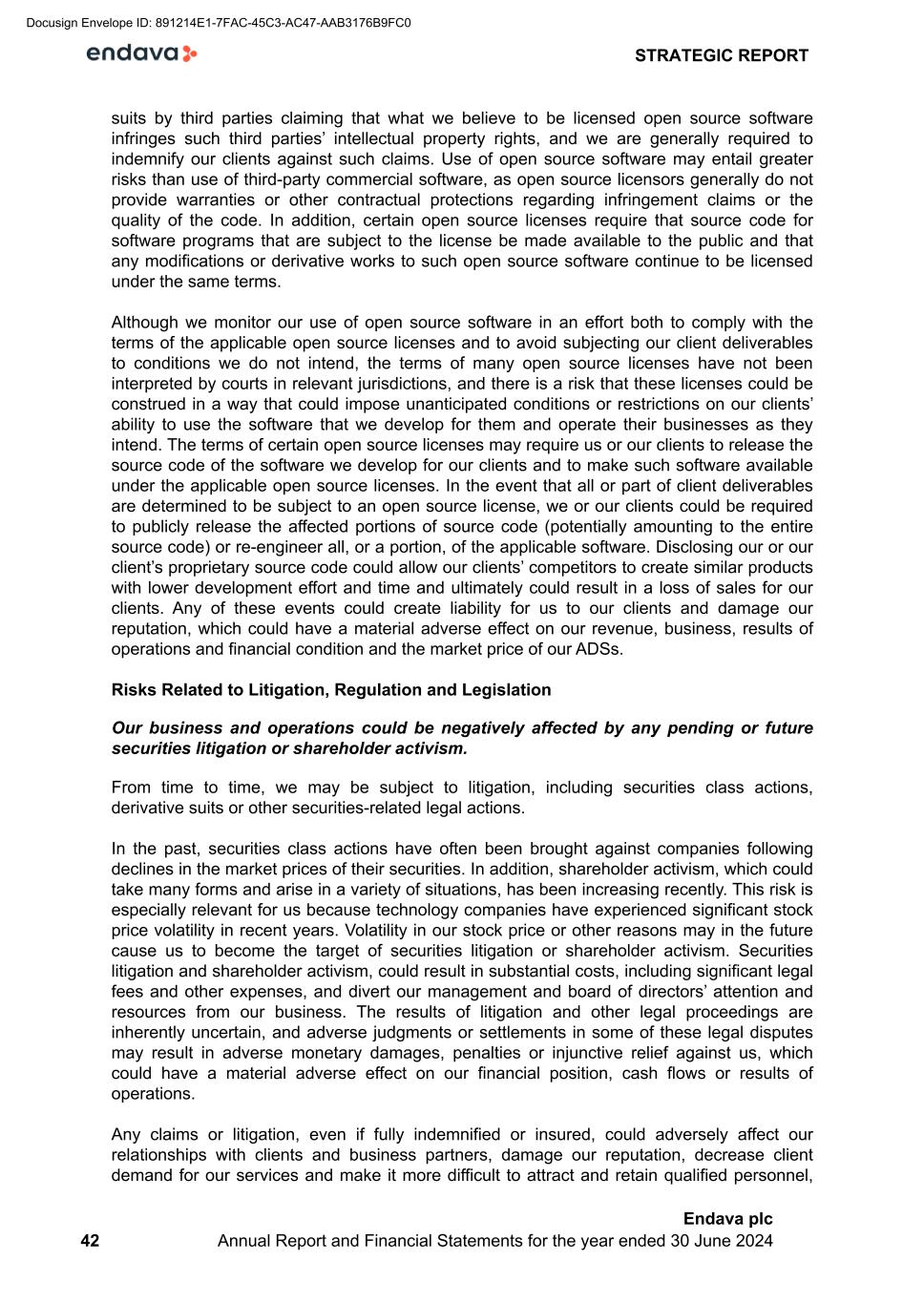
suits by third parties claiming that what we believe to be licensed open source software infringes such third parties’ intellectual property rights, and we are generally required to indemnify our clients against such claims. Use of open source software may entail greater risks than use of third-party commercial software, as open source licensors generally do not provide warranties or other contractual protections regarding infringement claims or the quality of the code. In addition, certain open source licenses require that source code for software programs that are subject to the license be made available to the public and that any modifications or derivative works to such open source software continue to be licensed under the same terms. Although we monitor our use of open source software in an effort both to comply with the terms of the applicable open source licenses and to avoid subjecting our client deliverables to conditions we do not intend, the terms of many open source licenses have not been interpreted by courts in relevant jurisdictions, and there is a risk that these licenses could be construed in a way that could impose unanticipated conditions or restrictions on our clients’ ability to use the software that we develop for them and operate their businesses as they intend. The terms of certain open source licenses may require us or our clients to release the source code of the software we develop for our clients and to make such software available under the applicable open source licenses. In the event that all or part of client deliverables are determined to be subject to an open source license, we or our clients could be required to publicly release the affected portions of source code (potentially amounting to the entire source code) or re-engineer all, or a portion, of the applicable software. Disclosing our or our client’s proprietary source code could allow our clients’ competitors to create similar products with lower development effort and time and ultimately could result in a loss of sales for our clients. Any of these events could create liability for us to our clients and damage our reputation, which could have a material adverse effect on our revenue, business, results of operations and financial condition and the market price of our ADSs. Risks Related to Litigation, Regulation and Legislation Our business and operations could be negatively affected by any pending or future securities litigation or shareholder activism. From time to time, we may be subject to litigation, including securities class actions, derivative suits or other securities-related legal actions. In the past, securities class actions have often been brought against companies following declines in the market prices of their securities. In addition, shareholder activism, which could take many forms and arise in a variety of situations, has been increasing recently. This risk is especially relevant for us because technology companies have experienced significant stock price volatility in recent years. Volatility in our stock price or other reasons may in the future cause us to become the target of securities litigation or shareholder activism. Securities litigation and shareholder activism, could result in substantial costs, including significant legal fees and other expenses, and divert our management and board of directors’ attention and resources from our business. The results of litigation and other legal proceedings are inherently uncertain, and adverse judgments or settlements in some of these legal disputes may result in adverse monetary damages, penalties or injunctive relief against us, which could have a material adverse effect on our financial position, cash flows or results of operations. Any claims or litigation, even if fully indemnified or insured, could adversely affect our relationships with clients and business partners, damage our reputation, decrease client demand for our services and make it more difficult to attract and retain qualified personnel, STRATEGIC REPORT 42 Endava plc Annual Report and Financial Statements for the year ended 30 June 2024 Docusign Envelope ID: 891214E1-7FAC-45C3-AC47-AAB3176B9FC0
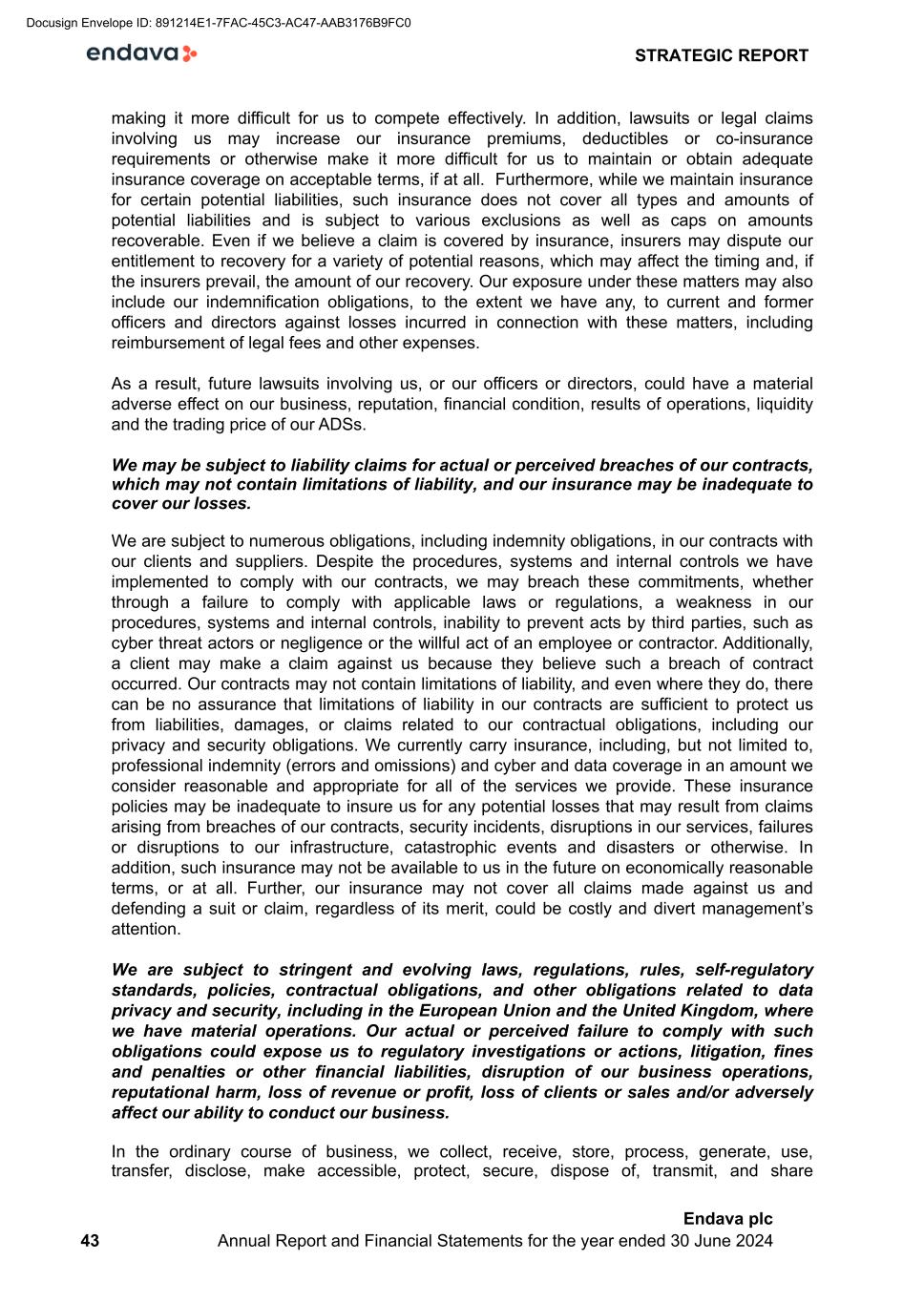
making it more difficult for us to compete effectively. In addition, lawsuits or legal claims involving us may increase our insurance premiums, deductibles or co-insurance requirements or otherwise make it more difficult for us to maintain or obtain adequate insurance coverage on acceptable terms, if at all. Furthermore, while we maintain insurance for certain potential liabilities, such insurance does not cover all types and amounts of potential liabilities and is subject to various exclusions as well as caps on amounts recoverable. Even if we believe a claim is covered by insurance, insurers may dispute our entitlement to recovery for a variety of potential reasons, which may affect the timing and, if the insurers prevail, the amount of our recovery. Our exposure under these matters may also include our indemnification obligations, to the extent we have any, to current and former officers and directors against losses incurred in connection with these matters, including reimbursement of legal fees and other expenses. As a result, future lawsuits involving us, or our officers or directors, could have a material adverse effect on our business, reputation, financial condition, results of operations, liquidity and the trading price of our ADSs. We may be subject to liability claims for actual or perceived breaches of our contracts, which may not contain limitations of liability, and our insurance may be inadequate to cover our losses. We are subject to numerous obligations, including indemnity obligations, in our contracts with our clients and suppliers. Despite the procedures, systems and internal controls we have implemented to comply with our contracts, we may breach these commitments, whether through a failure to comply with applicable laws or regulations, a weakness in our procedures, systems and internal controls, inability to prevent acts by third parties, such as cyber threat actors or negligence or the willful act of an employee or contractor. Additionally, a client may make a claim against us because they believe such a breach of contract occurred. Our contracts may not contain limitations of liability, and even where they do, there can be no assurance that limitations of liability in our contracts are sufficient to protect us from liabilities, damages, or claims related to our contractual obligations, including our privacy and security obligations. We currently carry insurance, including, but not limited to, professional indemnity (errors and omissions) and cyber and data coverage in an amount we consider reasonable and appropriate for all of the services we provide. These insurance policies may be inadequate to insure us for any potential losses that may result from claims arising from breaches of our contracts, security incidents, disruptions in our services, failures or disruptions to our infrastructure, catastrophic events and disasters or otherwise. In addition, such insurance may not be available to us in the future on economically reasonable terms, or at all. Further, our insurance may not cover all claims made against us and defending a suit or claim, regardless of its merit, could be costly and divert management’s attention. We are subject to stringent and evolving laws, regulations, rules, self-regulatory standards, policies, contractual obligations, and other obligations related to data privacy and security, including in the European Union and the United Kingdom, where we have material operations. Our actual or perceived failure to comply with such obligations could expose us to regulatory investigations or actions, litigation, fines and penalties or other financial liabilities, disruption of our business operations, reputational harm, loss of revenue or profit, loss of clients or sales and/or adversely affect our ability to conduct our business. In the ordinary course of business, we collect, receive, store, process, generate, use, transfer, disclose, make accessible, protect, secure, dispose of, transmit, and share STRATEGIC REPORT 43 Endava plc Annual Report and Financial Statements for the year ended 30 June 2024 Docusign Envelope ID: 891214E1-7FAC-45C3-AC47-AAB3176B9FC0
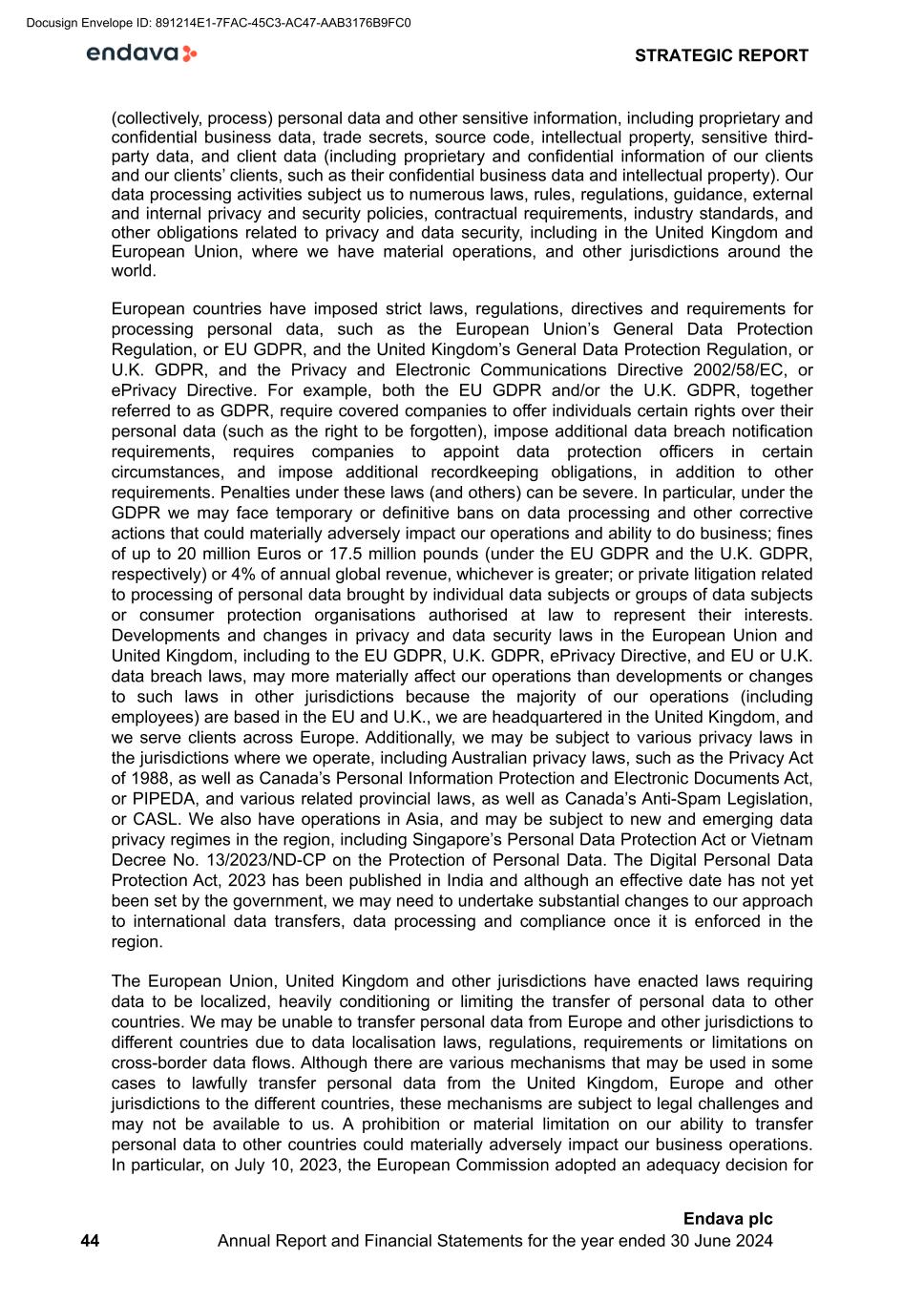
(collectively, process) personal data and other sensitive information, including proprietary and confidential business data, trade secrets, source code, intellectual property, sensitive third- party data, and client data (including proprietary and confidential information of our clients and our clients’ clients, such as their confidential business data and intellectual property). Our data processing activities subject us to numerous laws, rules, regulations, guidance, external and internal privacy and security policies, contractual requirements, industry standards, and other obligations related to privacy and data security, including in the United Kingdom and European Union, where we have material operations, and other jurisdictions around the world. European countries have imposed strict laws, regulations, directives and requirements for processing personal data, such as the European Union’s General Data Protection Regulation, or EU GDPR, and the United Kingdom’s General Data Protection Regulation, or U.K. GDPR, and the Privacy and Electronic Communications Directive 2002/58/EC, or ePrivacy Directive. For example, both the EU GDPR and/or the U.K. GDPR, together referred to as GDPR, require covered companies to offer individuals certain rights over their personal data (such as the right to be forgotten), impose additional data breach notification requirements, requires companies to appoint data protection officers in certain circumstances, and impose additional recordkeeping obligations, in addition to other requirements. Penalties under these laws (and others) can be severe. In particular, under the GDPR we may face temporary or definitive bans on data processing and other corrective actions that could materially adversely impact our operations and ability to do business; fines of up to 20 million Euros or 17.5 million pounds (under the EU GDPR and the U.K. GDPR, respectively) or 4% of annual global revenue, whichever is greater; or private litigation related to processing of personal data brought by individual data subjects or groups of data subjects or consumer protection organisations authorised at law to represent their interests. Developments and changes in privacy and data security laws in the European Union and United Kingdom, including to the EU GDPR, U.K. GDPR, ePrivacy Directive, and EU or U.K. data breach laws, may more materially affect our operations than developments or changes to such laws in other jurisdictions because the majority of our operations (including employees) are based in the EU and U.K., we are headquartered in the United Kingdom, and we serve clients across Europe. Additionally, we may be subject to various privacy laws in the jurisdictions where we operate, including Australian privacy laws, such as the Privacy Act of 1988, as well as Canada’s Personal Information Protection and Electronic Documents Act, or PIPEDA, and various related provincial laws, as well as Canada’s Anti-Spam Legislation, or CASL. We also have operations in Asia, and may be subject to new and emerging data privacy regimes in the region, including Singapore’s Personal Data Protection Act or Vietnam Decree No. 13/2023/ND-CP on the Protection of Personal Data. The Digital Personal Data Protection Act, 2023 has been published in India and although an effective date has not yet been set by the government, we may need to undertake substantial changes to our approach to international data transfers, data processing and compliance once it is enforced in the region. The European Union, United Kingdom and other jurisdictions have enacted laws requiring data to be localized, heavily conditioning or limiting the transfer of personal data to other countries. We may be unable to transfer personal data from Europe and other jurisdictions to different countries due to data localisation laws, regulations, requirements or limitations on cross-border data flows. Although there are various mechanisms that may be used in some cases to lawfully transfer personal data from the United Kingdom, Europe and other jurisdictions to the different countries, these mechanisms are subject to legal challenges and may not be available to us. A prohibition or material limitation on our ability to transfer personal data to other countries could materially adversely impact our business operations. In particular, on July 10, 2023, the European Commission adopted an adequacy decision for STRATEGIC REPORT 44 Endava plc Annual Report and Financial Statements for the year ended 30 June 2024 Docusign Envelope ID: 891214E1-7FAC-45C3-AC47-AAB3176B9FC0
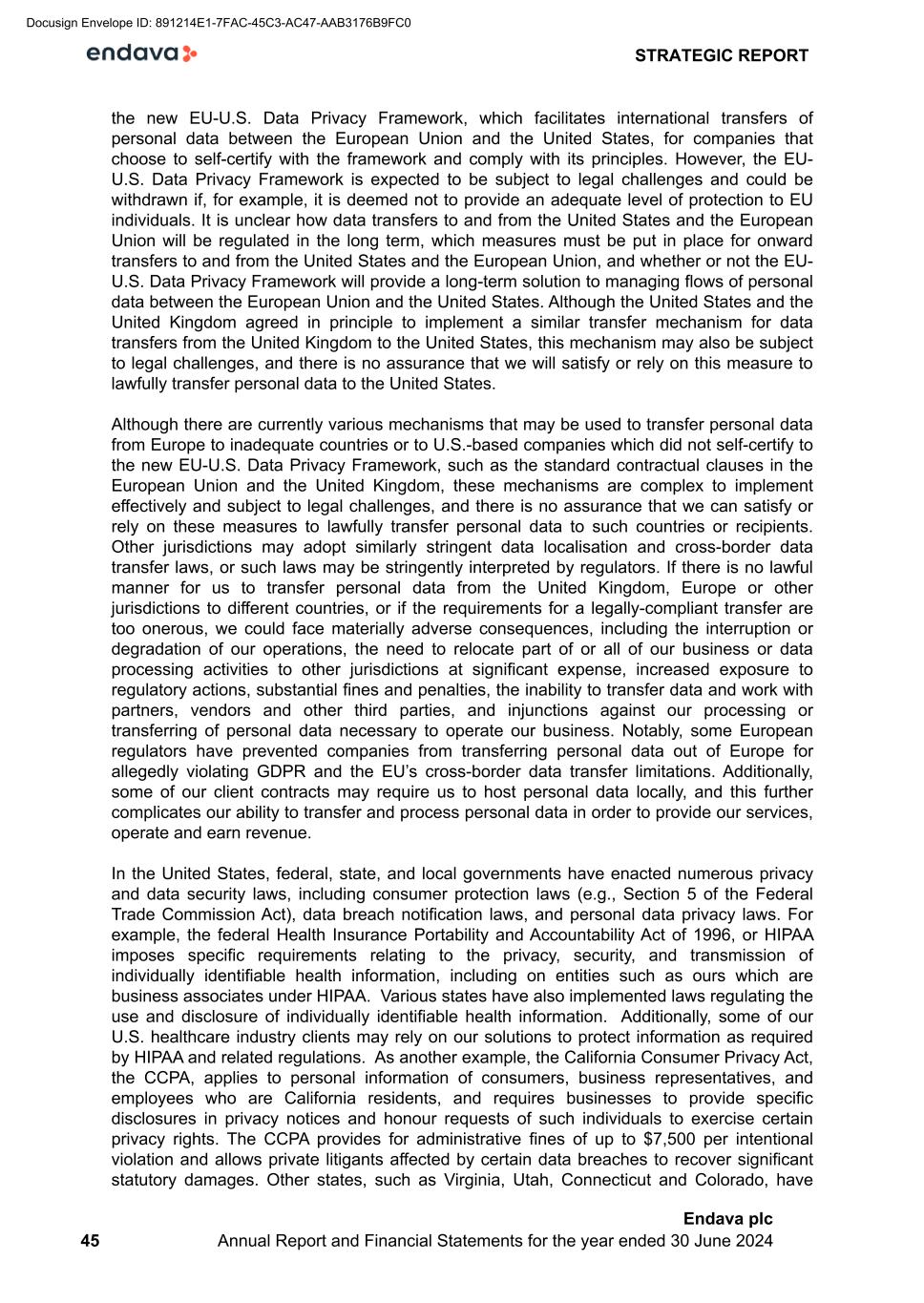
the new EU-U.S. Data Privacy Framework, which facilitates international transfers of personal data between the European Union and the United States, for companies that choose to self-certify with the framework and comply with its principles. However, the EU- U.S. Data Privacy Framework is expected to be subject to legal challenges and could be withdrawn if, for example, it is deemed not to provide an adequate level of protection to EU individuals. It is unclear how data transfers to and from the United States and the European Union will be regulated in the long term, which measures must be put in place for onward transfers to and from the United States and the European Union, and whether or not the EU- U.S. Data Privacy Framework will provide a long-term solution to managing flows of personal data between the European Union and the United States. Although the United States and the United Kingdom agreed in principle to implement a similar transfer mechanism for data transfers from the United Kingdom to the United States, this mechanism may also be subject to legal challenges, and there is no assurance that we will satisfy or rely on this measure to lawfully transfer personal data to the United States. Although there are currently various mechanisms that may be used to transfer personal data from Europe to inadequate countries or to U.S.-based companies which did not self-certify to the new EU-U.S. Data Privacy Framework, such as the standard contractual clauses in the European Union and the United Kingdom, these mechanisms are complex to implement effectively and subject to legal challenges, and there is no assurance that we can satisfy or rely on these measures to lawfully transfer personal data to such countries or recipients. Other jurisdictions may adopt similarly stringent data localisation and cross-border data transfer laws, or such laws may be stringently interpreted by regulators. If there is no lawful manner for us to transfer personal data from the United Kingdom, Europe or other jurisdictions to different countries, or if the requirements for a legally-compliant transfer are too onerous, we could face materially adverse consequences, including the interruption or degradation of our operations, the need to relocate part of or all of our business or data processing activities to other jurisdictions at significant expense, increased exposure to regulatory actions, substantial fines and penalties, the inability to transfer data and work with partners, vendors and other third parties, and injunctions against our processing or transferring of personal data necessary to operate our business. Notably, some European regulators have prevented companies from transferring personal data out of Europe for allegedly violating GDPR and the EU’s cross-border data transfer limitations. Additionally, some of our client contracts may require us to host personal data locally, and this further complicates our ability to transfer and process personal data in order to provide our services, operate and earn revenue. In the United States, federal, state, and local governments have enacted numerous privacy and data security laws, including consumer protection laws (e.g., Section 5 of the Federal Trade Commission Act), data breach notification laws, and personal data privacy laws. For example, the federal Health Insurance Portability and Accountability Act of 1996, or HIPAA imposes specific requirements relating to the privacy, security, and transmission of individually identifiable health information, including on entities such as ours which are business associates under HIPAA. Various states have also implemented laws regulating the use and disclosure of individually identifiable health information. Additionally, some of our U.S. healthcare industry clients may rely on our solutions to protect information as required by HIPAA and related regulations. As another example, the California Consumer Privacy Act, the CCPA, applies to personal information of consumers, business representatives, and employees who are California residents, and requires businesses to provide specific disclosures in privacy notices and honour requests of such individuals to exercise certain privacy rights. The CCPA provides for administrative fines of up to $7,500 per intentional violation and allows private litigants affected by certain data breaches to recover significant statutory damages. Other states, such as Virginia, Utah, Connecticut and Colorado, have STRATEGIC REPORT 45 Endava plc Annual Report and Financial Statements for the year ended 30 June 2024 Docusign Envelope ID: 891214E1-7FAC-45C3-AC47-AAB3176B9FC0
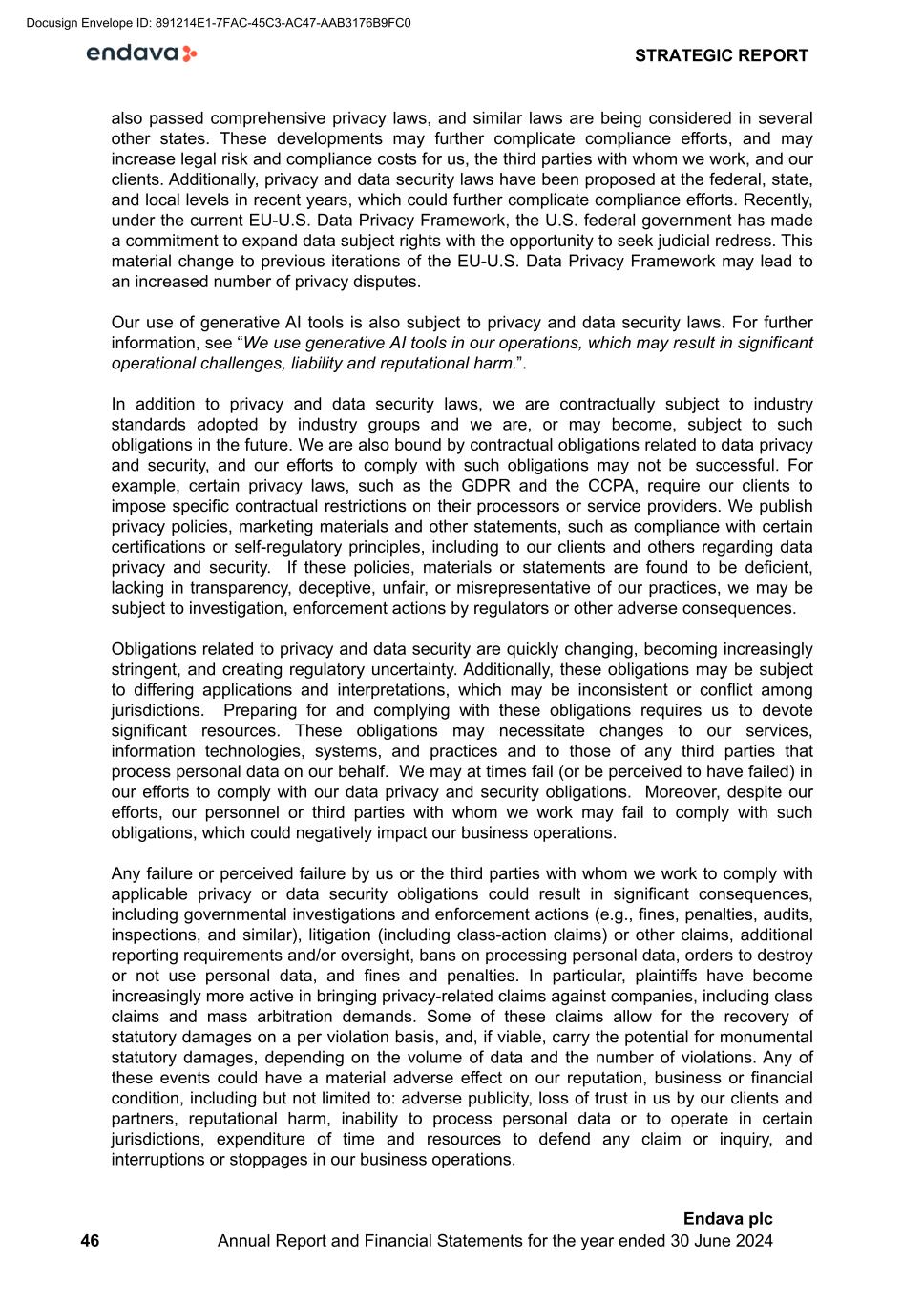
also passed comprehensive privacy laws, and similar laws are being considered in several other states. These developments may further complicate compliance efforts, and may increase legal risk and compliance costs for us, the third parties with whom we work, and our clients. Additionally, privacy and data security laws have been proposed at the federal, state, and local levels in recent years, which could further complicate compliance efforts. Recently, under the current EU-U.S. Data Privacy Framework, the U.S. federal government has made a commitment to expand data subject rights with the opportunity to seek judicial redress. This material change to previous iterations of the EU-U.S. Data Privacy Framework may lead to an increased number of privacy disputes. Our use of generative AI tools is also subject to privacy and data security laws. For further information, see “We use generative AI tools in our operations, which may result in significant operational challenges, liability and reputational harm.”. In addition to privacy and data security laws, we are contractually subject to industry standards adopted by industry groups and we are, or may become, subject to such obligations in the future. We are also bound by contractual obligations related to data privacy and security, and our efforts to comply with such obligations may not be successful. For example, certain privacy laws, such as the GDPR and the CCPA, require our clients to impose specific contractual restrictions on their processors or service providers. We publish privacy policies, marketing materials and other statements, such as compliance with certain certifications or self-regulatory principles, including to our clients and others regarding data privacy and security. If these policies, materials or statements are found to be deficient, lacking in transparency, deceptive, unfair, or misrepresentative of our practices, we may be subject to investigation, enforcement actions by regulators or other adverse consequences. Obligations related to privacy and data security are quickly changing, becoming increasingly stringent, and creating regulatory uncertainty. Additionally, these obligations may be subject to differing applications and interpretations, which may be inconsistent or conflict among jurisdictions. Preparing for and complying with these obligations requires us to devote significant resources. These obligations may necessitate changes to our services, information technologies, systems, and practices and to those of any third parties that process personal data on our behalf. We may at times fail (or be perceived to have failed) in our efforts to comply with our data privacy and security obligations. Moreover, despite our efforts, our personnel or third parties with whom we work may fail to comply with such obligations, which could negatively impact our business operations. Any failure or perceived failure by us or the third parties with whom we work to comply with applicable privacy or data security obligations could result in significant consequences, including governmental investigations and enforcement actions (e.g., fines, penalties, audits, inspections, and similar), litigation (including class-action claims) or other claims, additional reporting requirements and/or oversight, bans on processing personal data, orders to destroy or not use personal data, and fines and penalties. In particular, plaintiffs have become increasingly more active in bringing privacy-related claims against companies, including class claims and mass arbitration demands. Some of these claims allow for the recovery of statutory damages on a per violation basis, and, if viable, carry the potential for monumental statutory damages, depending on the volume of data and the number of violations. Any of these events could have a material adverse effect on our reputation, business or financial condition, including but not limited to: adverse publicity, loss of trust in us by our clients and partners, reputational harm, inability to process personal data or to operate in certain jurisdictions, expenditure of time and resources to defend any claim or inquiry, and interruptions or stoppages in our business operations. STRATEGIC REPORT 46 Endava plc Annual Report and Financial Statements for the year ended 30 June 2024 Docusign Envelope ID: 891214E1-7FAC-45C3-AC47-AAB3176B9FC0
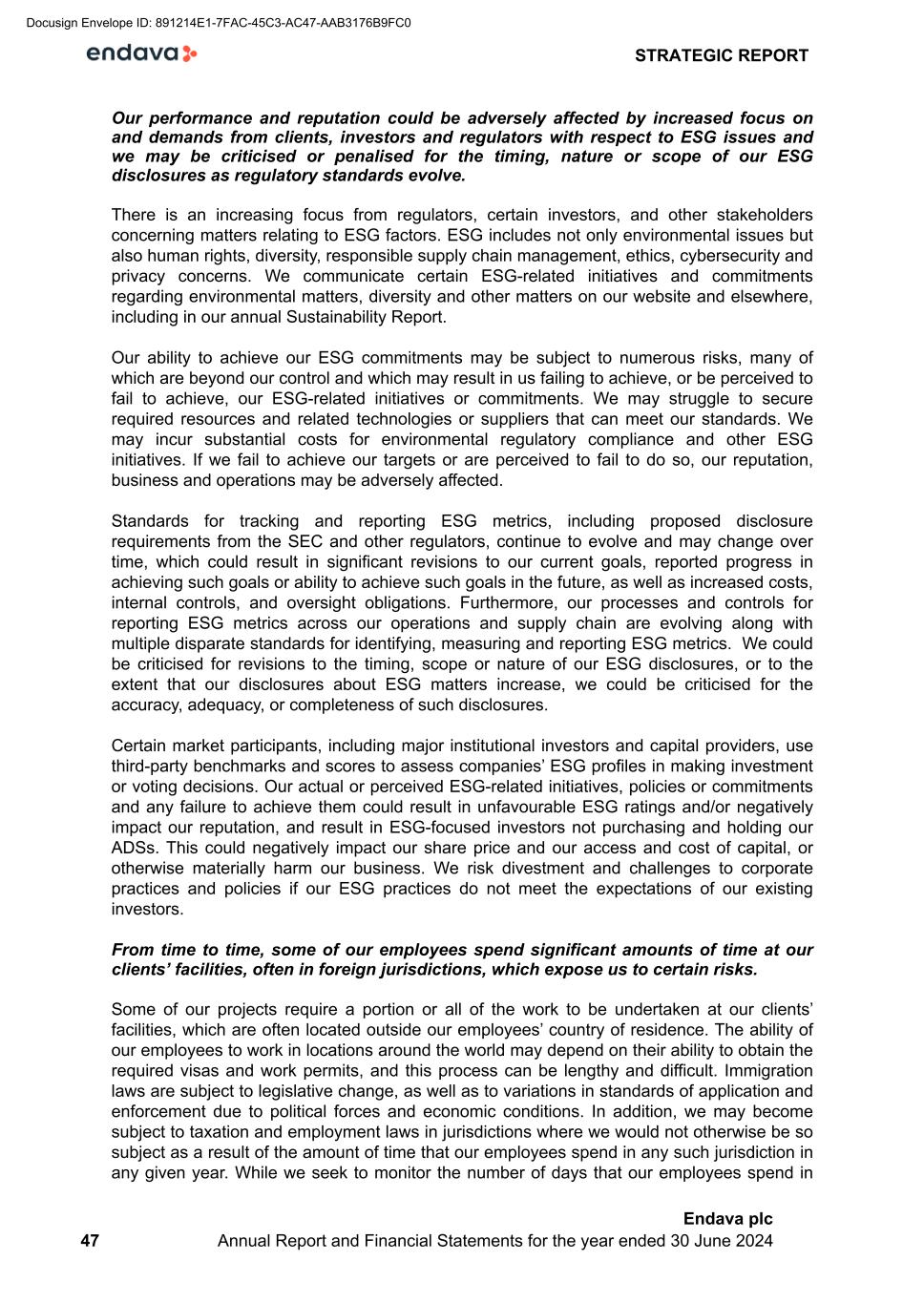
Our performance and reputation could be adversely affected by increased focus on and demands from clients, investors and regulators with respect to ESG issues and we may be criticised or penalised for the timing, nature or scope of our ESG disclosures as regulatory standards evolve. There is an increasing focus from regulators, certain investors, and other stakeholders concerning matters relating to ESG factors. ESG includes not only environmental issues but also human rights, diversity, responsible supply chain management, ethics, cybersecurity and privacy concerns. We communicate certain ESG-related initiatives and commitments regarding environmental matters, diversity and other matters on our website and elsewhere, including in our annual Sustainability Report. Our ability to achieve our ESG commitments may be subject to numerous risks, many of which are beyond our control and which may result in us failing to achieve, or be perceived to fail to achieve, our ESG-related initiatives or commitments. We may struggle to secure required resources and related technologies or suppliers that can meet our standards. We may incur substantial costs for environmental regulatory compliance and other ESG initiatives. If we fail to achieve our targets or are perceived to fail to do so, our reputation, business and operations may be adversely affected. Standards for tracking and reporting ESG metrics, including proposed disclosure requirements from the SEC and other regulators, continue to evolve and may change over time, which could result in significant revisions to our current goals, reported progress in achieving such goals or ability to achieve such goals in the future, as well as increased costs, internal controls, and oversight obligations. Furthermore, our processes and controls for reporting ESG metrics across our operations and supply chain are evolving along with multiple disparate standards for identifying, measuring and reporting ESG metrics. We could be criticised for revisions to the timing, scope or nature of our ESG disclosures, or to the extent that our disclosures about ESG matters increase, we could be criticised for the accuracy, adequacy, or completeness of such disclosures. Certain market participants, including major institutional investors and capital providers, use third-party benchmarks and scores to assess companies’ ESG profiles in making investment or voting decisions. Our actual or perceived ESG-related initiatives, policies or commitments and any failure to achieve them could result in unfavourable ESG ratings and/or negatively impact our reputation, and result in ESG-focused investors not purchasing and holding our ADSs. This could negatively impact our share price and our access and cost of capital, or otherwise materially harm our business. We risk divestment and challenges to corporate practices and policies if our ESG practices do not meet the expectations of our existing investors. From time to time, some of our employees spend significant amounts of time at our clients’ facilities, often in foreign jurisdictions, which expose us to certain risks. Some of our projects require a portion or all of the work to be undertaken at our clients’ facilities, which are often located outside our employees’ country of residence. The ability of our employees to work in locations around the world may depend on their ability to obtain the required visas and work permits, and this process can be lengthy and difficult. Immigration laws are subject to legislative change, as well as to variations in standards of application and enforcement due to political forces and economic conditions. In addition, we may become subject to taxation and employment laws in jurisdictions where we would not otherwise be so subject as a result of the amount of time that our employees spend in any such jurisdiction in any given year. While we seek to monitor the number of days that our employees spend in STRATEGIC REPORT 47 Endava plc Annual Report and Financial Statements for the year ended 30 June 2024 Docusign Envelope ID: 891214E1-7FAC-45C3-AC47-AAB3176B9FC0
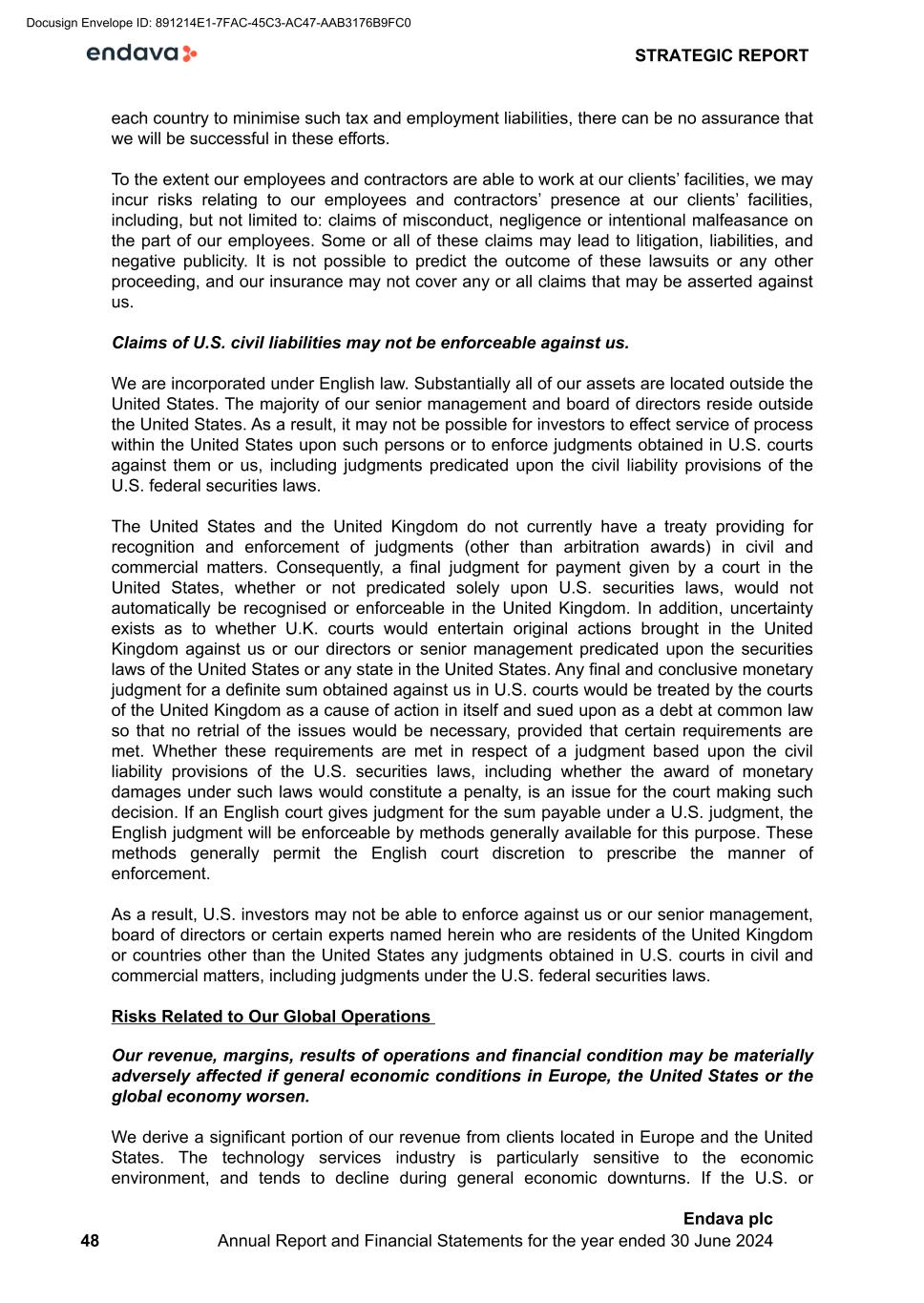
each country to minimise such tax and employment liabilities, there can be no assurance that we will be successful in these efforts. To the extent our employees and contractors are able to work at our clients’ facilities, we may incur risks relating to our employees and contractors’ presence at our clients’ facilities, including, but not limited to: claims of misconduct, negligence or intentional malfeasance on the part of our employees. Some or all of these claims may lead to litigation, liabilities, and negative publicity. It is not possible to predict the outcome of these lawsuits or any other proceeding, and our insurance may not cover any or all claims that may be asserted against us. Claims of U.S. civil liabilities may not be enforceable against us. We are incorporated under English law. Substantially all of our assets are located outside the United States. The majority of our senior management and board of directors reside outside the United States. As a result, it may not be possible for investors to effect service of process within the United States upon such persons or to enforce judgments obtained in U.S. courts against them or us, including judgments predicated upon the civil liability provisions of the U.S. federal securities laws. The United States and the United Kingdom do not currently have a treaty providing for recognition and enforcement of judgments (other than arbitration awards) in civil and commercial matters. Consequently, a final judgment for payment given by a court in the United States, whether or not predicated solely upon U.S. securities laws, would not automatically be recognised or enforceable in the United Kingdom. In addition, uncertainty exists as to whether U.K. courts would entertain original actions brought in the United Kingdom against us or our directors or senior management predicated upon the securities laws of the United States or any state in the United States. Any final and conclusive monetary judgment for a definite sum obtained against us in U.S. courts would be treated by the courts of the United Kingdom as a cause of action in itself and sued upon as a debt at common law so that no retrial of the issues would be necessary, provided that certain requirements are met. Whether these requirements are met in respect of a judgment based upon the civil liability provisions of the U.S. securities laws, including whether the award of monetary damages under such laws would constitute a penalty, is an issue for the court making such decision. If an English court gives judgment for the sum payable under a U.S. judgment, the English judgment will be enforceable by methods generally available for this purpose. These methods generally permit the English court discretion to prescribe the manner of enforcement. As a result, U.S. investors may not be able to enforce against us or our senior management, board of directors or certain experts named herein who are residents of the United Kingdom or countries other than the United States any judgments obtained in U.S. courts in civil and commercial matters, including judgments under the U.S. federal securities laws. Risks Related to Our Global Operations Our revenue, margins, results of operations and financial condition may be materially adversely affected if general economic conditions in Europe, the United States or the global economy worsen. We derive a significant portion of our revenue from clients located in Europe and the United States. The technology services industry is particularly sensitive to the economic environment, and tends to decline during general economic downturns. If the U.S. or STRATEGIC REPORT 48 Endava plc Annual Report and Financial Statements for the year ended 30 June 2024 Docusign Envelope ID: 891214E1-7FAC-45C3-AC47-AAB3176B9FC0
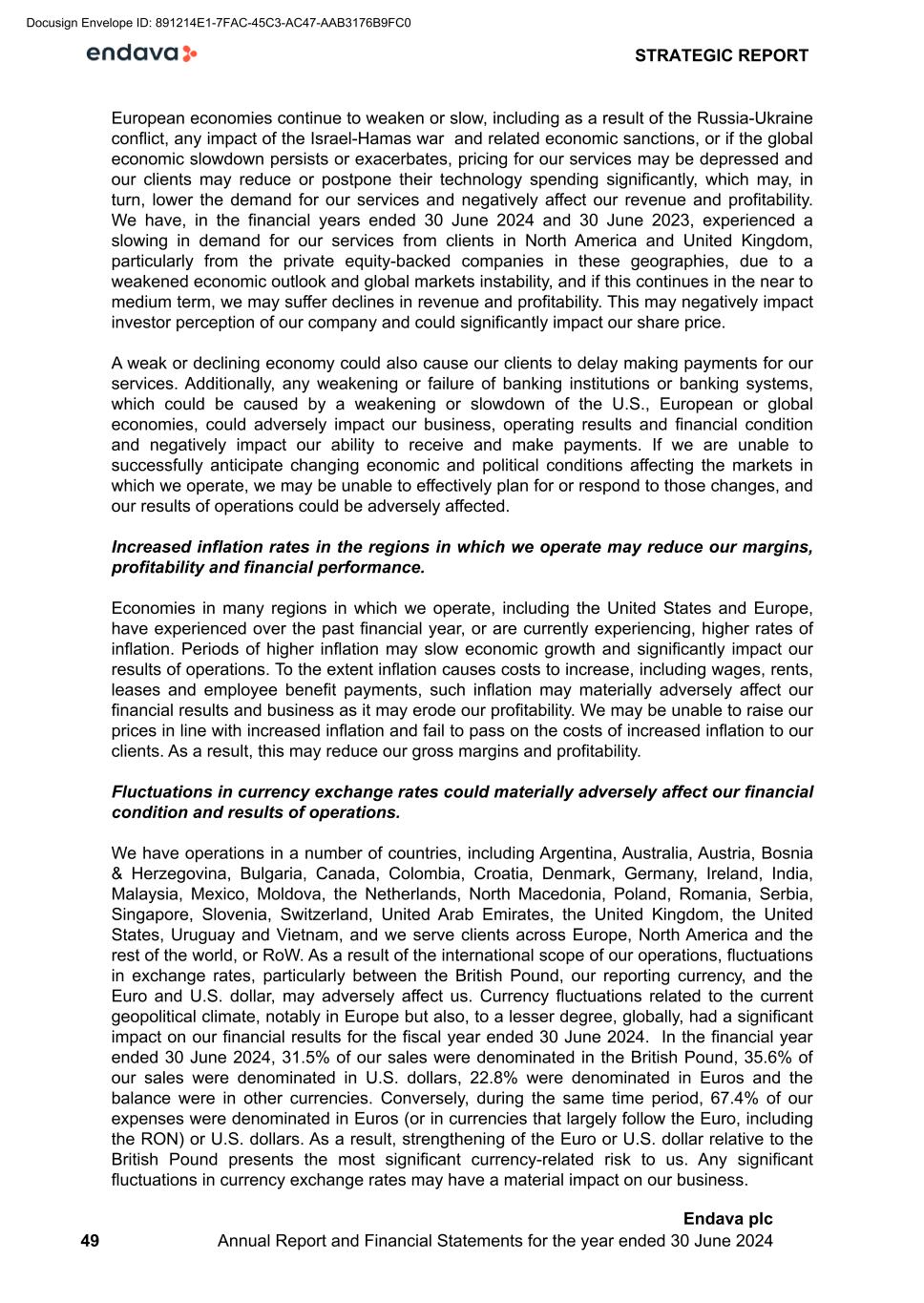
European economies continue to weaken or slow, including as a result of the Russia-Ukraine conflict, any impact of the Israel-Hamas war and related economic sanctions, or if the global economic slowdown persists or exacerbates, pricing for our services may be depressed and our clients may reduce or postpone their technology spending significantly, which may, in turn, lower the demand for our services and negatively affect our revenue and profitability. We have, in the financial years ended 30 June 2024 and 30 June 2023, experienced a slowing in demand for our services from clients in North America and United Kingdom, particularly from the private equity-backed companies in these geographies, due to a weakened economic outlook and global markets instability, and if this continues in the near to medium term, we may suffer declines in revenue and profitability. This may negatively impact investor perception of our company and could significantly impact our share price. A weak or declining economy could also cause our clients to delay making payments for our services. Additionally, any weakening or failure of banking institutions or banking systems, which could be caused by a weakening or slowdown of the U.S., European or global economies, could adversely impact our business, operating results and financial condition and negatively impact our ability to receive and make payments. If we are unable to successfully anticipate changing economic and political conditions affecting the markets in which we operate, we may be unable to effectively plan for or respond to those changes, and our results of operations could be adversely affected. Increased inflation rates in the regions in which we operate may reduce our margins, profitability and financial performance. Economies in many regions in which we operate, including the United States and Europe, have experienced over the past financial year, or are currently experiencing, higher rates of inflation. Periods of higher inflation may slow economic growth and significantly impact our results of operations. To the extent inflation causes costs to increase, including wages, rents, leases and employee benefit payments, such inflation may materially adversely affect our financial results and business as it may erode our profitability. We may be unable to raise our prices in line with increased inflation and fail to pass on the costs of increased inflation to our clients. As a result, this may reduce our gross margins and profitability. Fluctuations in currency exchange rates could materially adversely affect our financial condition and results of operations. We have operations in a number of countries, including Argentina, Australia, Austria, Bosnia & Herzegovina, Bulgaria, Canada, Colombia, Croatia, Denmark, Germany, Ireland, India, Malaysia, Mexico, Moldova, the Netherlands, North Macedonia, Poland, Romania, Serbia, Singapore, Slovenia, Switzerland, United Arab Emirates, the United Kingdom, the United States, Uruguay and Vietnam, and we serve clients across Europe, North America and the rest of the world, or RoW. As a result of the international scope of our operations, fluctuations in exchange rates, particularly between the British Pound, our reporting currency, and the Euro and U.S. dollar, may adversely affect us. Currency fluctuations related to the current geopolitical climate, notably in Europe but also, to a lesser degree, globally, had a significant impact on our financial results for the fiscal year ended 30 June 2024. In the financial year ended 30 June 2024, 31.5% of our sales were denominated in the British Pound, 35.6% of our sales were denominated in U.S. dollars, 22.8% were denominated in Euros and the balance were in other currencies. Conversely, during the same time period, 67.4% of our expenses were denominated in Euros (or in currencies that largely follow the Euro, including the RON) or U.S. dollars. As a result, strengthening of the Euro or U.S. dollar relative to the British Pound presents the most significant currency-related risk to us. Any significant fluctuations in currency exchange rates may have a material impact on our business. STRATEGIC REPORT 49 Endava plc Annual Report and Financial Statements for the year ended 30 June 2024 Docusign Envelope ID: 891214E1-7FAC-45C3-AC47-AAB3176B9FC0
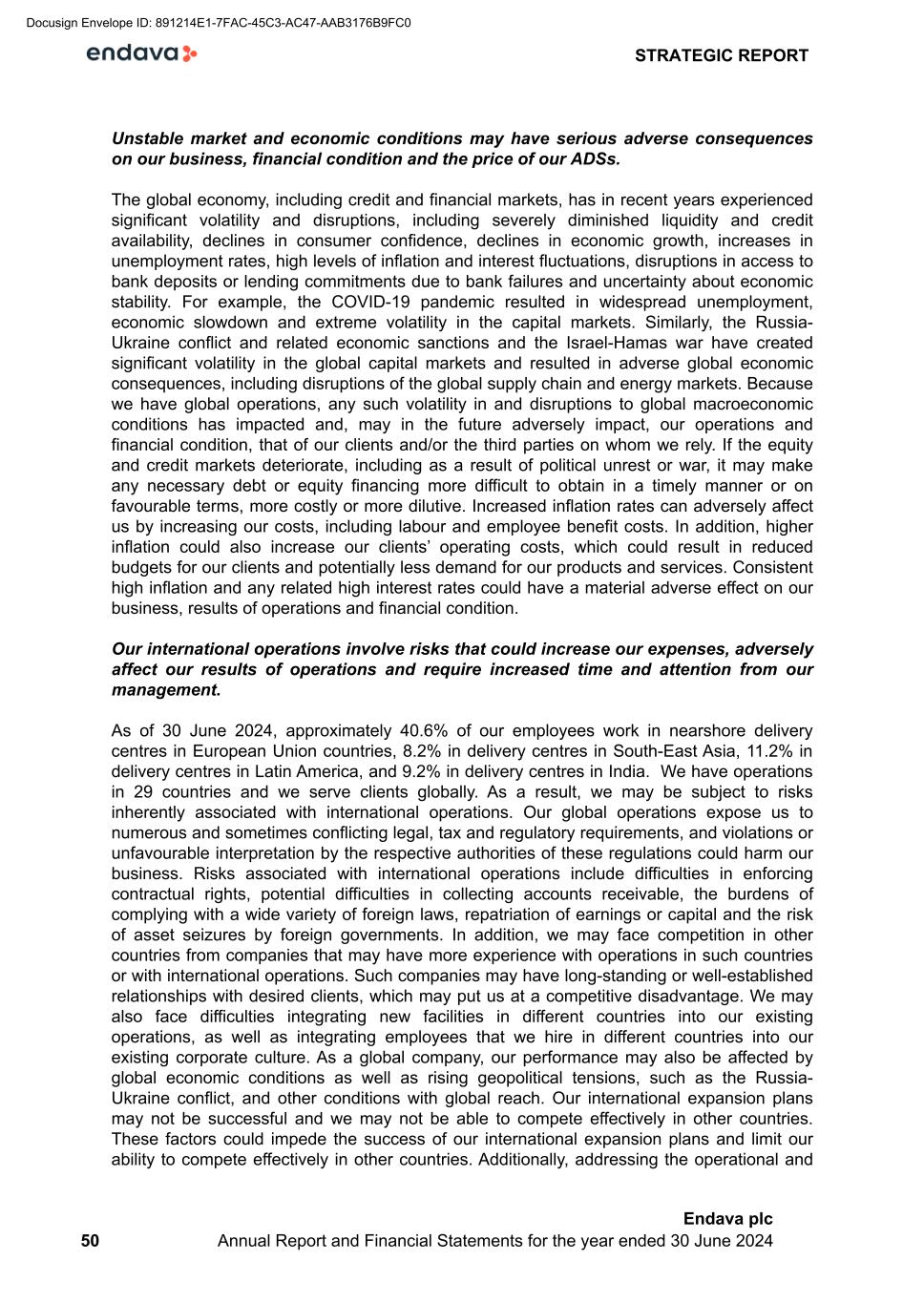
Unstable market and economic conditions may have serious adverse consequences on our business, financial condition and the price of our ADSs. The global economy, including credit and financial markets, has in recent years experienced significant volatility and disruptions, including severely diminished liquidity and credit availability, declines in consumer confidence, declines in economic growth, increases in unemployment rates, high levels of inflation and interest fluctuations, disruptions in access to bank deposits or lending commitments due to bank failures and uncertainty about economic stability. For example, the COVID-19 pandemic resulted in widespread unemployment, economic slowdown and extreme volatility in the capital markets. Similarly, the Russia- Ukraine conflict and related economic sanctions and the Israel-Hamas war have created significant volatility in the global capital markets and resulted in adverse global economic consequences, including disruptions of the global supply chain and energy markets. Because we have global operations, any such volatility in and disruptions to global macroeconomic conditions has impacted and, may in the future adversely impact, our operations and financial condition, that of our clients and/or the third parties on whom we rely. If the equity and credit markets deteriorate, including as a result of political unrest or war, it may make any necessary debt or equity financing more difficult to obtain in a timely manner or on favourable terms, more costly or more dilutive. Increased inflation rates can adversely affect us by increasing our costs, including labour and employee benefit costs. In addition, higher inflation could also increase our clients’ operating costs, which could result in reduced budgets for our clients and potentially less demand for our products and services. Consistent high inflation and any related high interest rates could have a material adverse effect on our business, results of operations and financial condition. Our international operations involve risks that could increase our expenses, adversely affect our results of operations and require increased time and attention from our management. As of 30 June 2024, approximately 40.6% of our employees work in nearshore delivery centres in European Union countries, 8.2% in delivery centres in South-East Asia, 11.2% in delivery centres in Latin America, and 9.2% in delivery centres in India. We have operations in 29 countries and we serve clients globally. As a result, we may be subject to risks inherently associated with international operations. Our global operations expose us to numerous and sometimes conflicting legal, tax and regulatory requirements, and violations or unfavourable interpretation by the respective authorities of these regulations could harm our business. Risks associated with international operations include difficulties in enforcing contractual rights, potential difficulties in collecting accounts receivable, the burdens of complying with a wide variety of foreign laws, repatriation of earnings or capital and the risk of asset seizures by foreign governments. In addition, we may face competition in other countries from companies that may have more experience with operations in such countries or with international operations. Such companies may have long-standing or well-established relationships with desired clients, which may put us at a competitive disadvantage. We may also face difficulties integrating new facilities in different countries into our existing operations, as well as integrating employees that we hire in different countries into our existing corporate culture. As a global company, our performance may also be affected by global economic conditions as well as rising geopolitical tensions, such as the Russia- Ukraine conflict, and other conditions with global reach. Our international expansion plans may not be successful and we may not be able to compete effectively in other countries. These factors could impede the success of our international expansion plans and limit our ability to compete effectively in other countries. Additionally, addressing the operational and STRATEGIC REPORT 50 Endava plc Annual Report and Financial Statements for the year ended 30 June 2024 Docusign Envelope ID: 891214E1-7FAC-45C3-AC47-AAB3176B9FC0

other challenges posed by our international operations will require significant time and attention from management. Our business, results of operations and financial condition may be adversely affected by the various conflicting legal and regulatory requirements imposed on us by the countries where we operate. Since we maintain operations and provide services to clients throughout the world, we are subject to numerous, and sometimes conflicting, legal requirements on matters as diverse as import/export controls, content requirements, trade restrictions, tariffs, taxation, sanctions, government affairs, anti-bribery, whistle blowing, internal and disclosure control obligations, data protection and privacy and labour relations. Our failure to comply with these regulations in the conduct of our business could result in fines, penalties, criminal sanctions against us or our officers, disgorgement of profits, prohibitions on doing business, unfavourable publicity, adverse impact on our reputation and allegations by our clients that we have not performed our contractual obligations. Due to the varying degree of development of the legal systems of the countries in which we operate, local laws might be insufficient to defend us and preserve our rights. We are also subject to risks relating to compliance with a variety of national and local laws including multiple tax regimes, labour laws, employee health safety and wages and benefits laws. We may, from time to time, be subject to litigation or administrative actions resulting from claims against us by current or former employees individually or as part of class actions, including claims of wrongful terminations, discrimination, misclassification or other violations of labour law or other alleged conduct. We may also, from time to time, be subject to litigation resulting from claims against us by third parties, including claims of breach of non-compete and confidentiality provisions of our employees’ former employment agreements with such third parties. Our failure to comply with applicable regulatory requirements could have a material adverse effect on our revenue, business, results of operations and financial condition. Many commercial laws and regulations in Central Europe and Latin America are relatively new and have been subject to limited interpretation. As a result, their application can be unpredictable. Government authorities have a high degree of discretion in certain countries in which we have operations and at times have exercised their discretion in ways that may be perceived as selective or arbitrary. These governments also have the power, in certain circumstances, to interfere with the performance of, nullify or terminate contracts. Selective or arbitrary actions have included withdrawal of licenses, sudden and unexpected tax audits, criminal prosecutions and civil actions. In this environment, our competitors could receive preferential treatment from the government, potentially giving them a competitive advantage, which may in turn materially adversely affect our business, financial condition and results of operations. Changes and uncertainties in the tax system in the countries in which we have operations could materially adversely affect our financial condition and results of operations. We conduct business globally and file income tax returns in multiple jurisdictions. Our consolidated effective income tax rate could be materially adversely affected by several factors, including: changing tax laws (such as the increase in the headline rate of corporation tax in the United Kingdom), regulations and treaties, or the interpretation thereof; tax policy initiatives and reforms under consideration (such as those related to the Organisation for Economic Co-Operation and Development’s, or OECD, Base Erosion and Profit Shifting, or STRATEGIC REPORT 51 Endava plc Annual Report and Financial Statements for the year ended 30 June 2024 Docusign Envelope ID: 891214E1-7FAC-45C3-AC47-AAB3176B9FC0
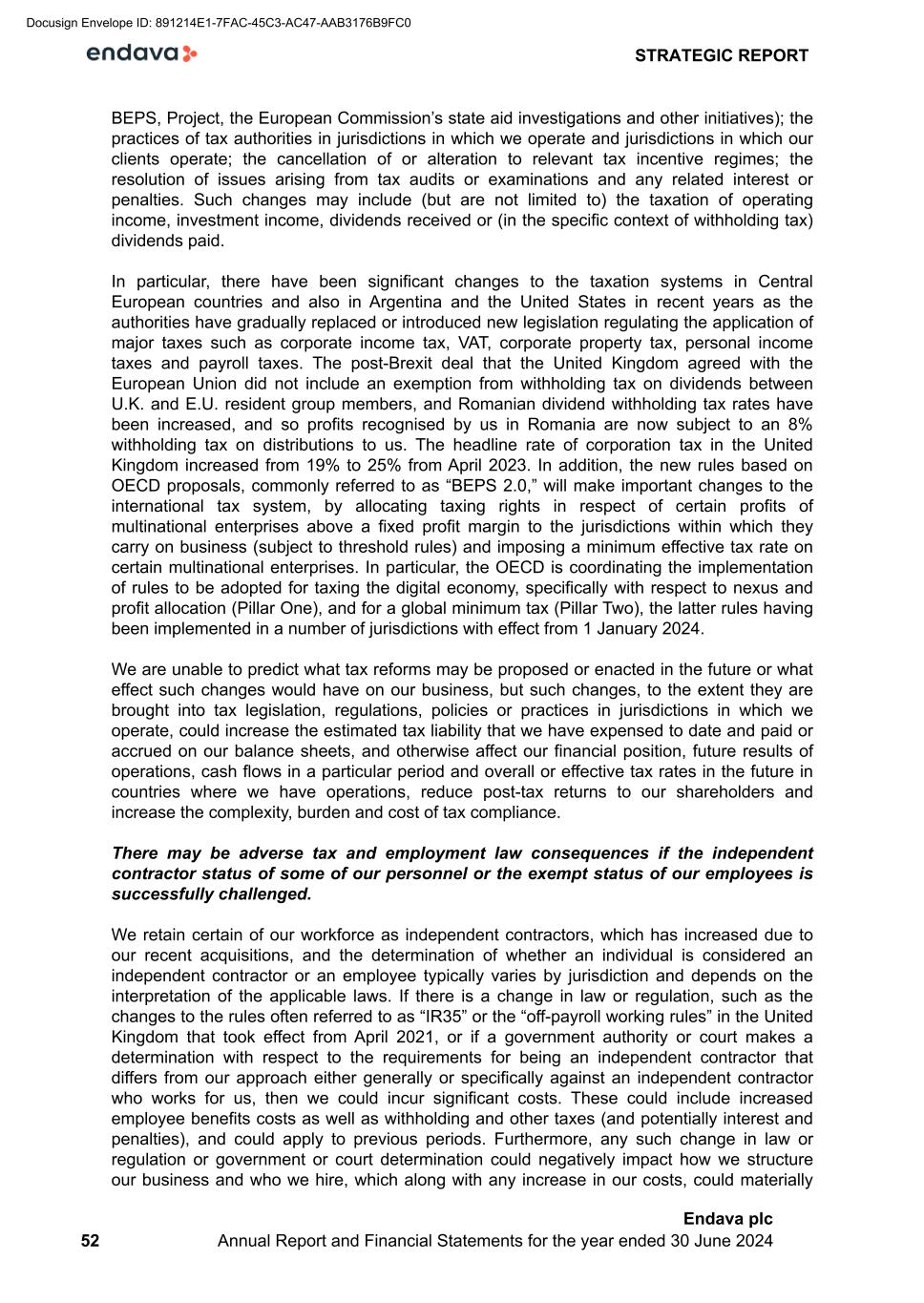
BEPS, Project, the European Commission’s state aid investigations and other initiatives); the practices of tax authorities in jurisdictions in which we operate and jurisdictions in which our clients operate; the cancellation of or alteration to relevant tax incentive regimes; the resolution of issues arising from tax audits or examinations and any related interest or penalties. Such changes may include (but are not limited to) the taxation of operating income, investment income, dividends received or (in the specific context of withholding tax) dividends paid. In particular, there have been significant changes to the taxation systems in Central European countries and also in Argentina and the United States in recent years as the authorities have gradually replaced or introduced new legislation regulating the application of major taxes such as corporate income tax, VAT, corporate property tax, personal income taxes and payroll taxes. The post-Brexit deal that the United Kingdom agreed with the European Union did not include an exemption from withholding tax on dividends between U.K. and E.U. resident group members, and Romanian dividend withholding tax rates have been increased, and so profits recognised by us in Romania are now subject to an 8% withholding tax on distributions to us. The headline rate of corporation tax in the United Kingdom increased from 19% to 25% from April 2023. In addition, the new rules based on OECD proposals, commonly referred to as “BEPS 2.0,” will make important changes to the international tax system, by allocating taxing rights in respect of certain profits of multinational enterprises above a fixed profit margin to the jurisdictions within which they carry on business (subject to threshold rules) and imposing a minimum effective tax rate on certain multinational enterprises. In particular, the OECD is coordinating the implementation of rules to be adopted for taxing the digital economy, specifically with respect to nexus and profit allocation (Pillar One), and for a global minimum tax (Pillar Two), the latter rules having been implemented in a number of jurisdictions with effect from 1 January 2024. We are unable to predict what tax reforms may be proposed or enacted in the future or what effect such changes would have on our business, but such changes, to the extent they are brought into tax legislation, regulations, policies or practices in jurisdictions in which we operate, could increase the estimated tax liability that we have expensed to date and paid or accrued on our balance sheets, and otherwise affect our financial position, future results of operations, cash flows in a particular period and overall or effective tax rates in the future in countries where we have operations, reduce post-tax returns to our shareholders and increase the complexity, burden and cost of tax compliance. There may be adverse tax and employment law consequences if the independent contractor status of some of our personnel or the exempt status of our employees is successfully challenged. We retain certain of our workforce as independent contractors, which has increased due to our recent acquisitions, and the determination of whether an individual is considered an independent contractor or an employee typically varies by jurisdiction and depends on the interpretation of the applicable laws. If there is a change in law or regulation, such as the changes to the rules often referred to as “IR35” or the “off-payroll working rules” in the United Kingdom that took effect from April 2021, or if a government authority or court makes a determination with respect to the requirements for being an independent contractor that differs from our approach either generally or specifically against an independent contractor who works for us, then we could incur significant costs. These could include increased employee benefits costs as well as withholding and other taxes (and potentially interest and penalties), and could apply to previous periods. Furthermore, any such change in law or regulation or government or court determination could negatively impact how we structure our business and who we hire, which along with any increase in our costs, could materially STRATEGIC REPORT 52 Endava plc Annual Report and Financial Statements for the year ended 30 June 2024 Docusign Envelope ID: 891214E1-7FAC-45C3-AC47-AAB3176B9FC0
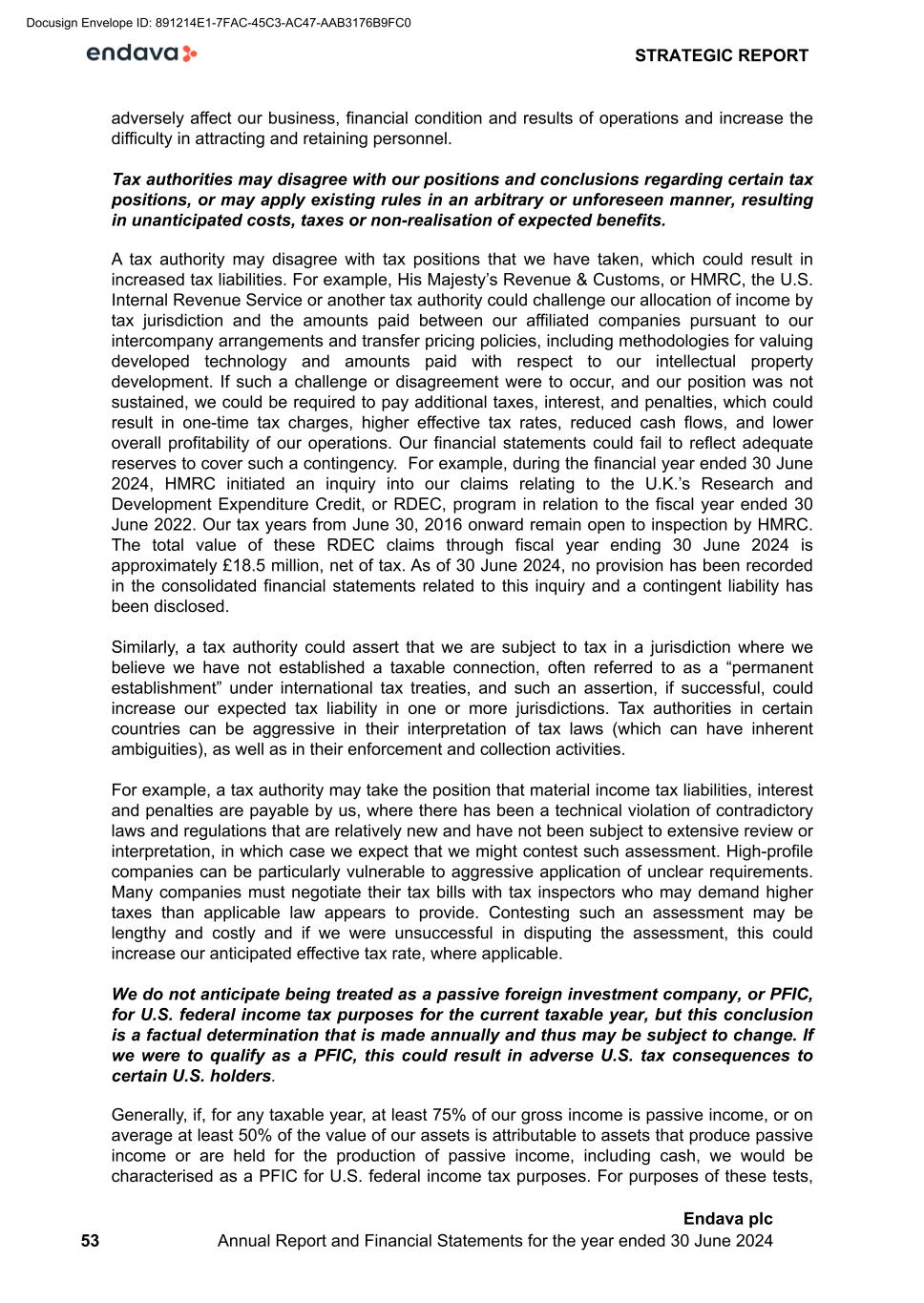
adversely affect our business, financial condition and results of operations and increase the difficulty in attracting and retaining personnel. Tax authorities may disagree with our positions and conclusions regarding certain tax positions, or may apply existing rules in an arbitrary or unforeseen manner, resulting in unanticipated costs, taxes or non-realisation of expected benefits. A tax authority may disagree with tax positions that we have taken, which could result in increased tax liabilities. For example, His Majesty’s Revenue & Customs, or HMRC, the U.S. Internal Revenue Service or another tax authority could challenge our allocation of income by tax jurisdiction and the amounts paid between our affiliated companies pursuant to our intercompany arrangements and transfer pricing policies, including methodologies for valuing developed technology and amounts paid with respect to our intellectual property development. If such a challenge or disagreement were to occur, and our position was not sustained, we could be required to pay additional taxes, interest, and penalties, which could result in one-time tax charges, higher effective tax rates, reduced cash flows, and lower overall profitability of our operations. Our financial statements could fail to reflect adequate reserves to cover such a contingency. For example, during the financial year ended 30 June 2024, HMRC initiated an inquiry into our claims relating to the U.K.’s Research and Development Expenditure Credit, or RDEC, program in relation to the fiscal year ended 30 June 2022. Our tax years from June 30, 2016 onward remain open to inspection by HMRC. The total value of these RDEC claims through fiscal year ending 30 June 2024 is approximately £18.5 million, net of tax. As of 30 June 2024, no provision has been recorded in the consolidated financial statements related to this inquiry and a contingent liability has been disclosed. Similarly, a tax authority could assert that we are subject to tax in a jurisdiction where we believe we have not established a taxable connection, often referred to as a “permanent establishment” under international tax treaties, and such an assertion, if successful, could increase our expected tax liability in one or more jurisdictions. Tax authorities in certain countries can be aggressive in their interpretation of tax laws (which can have inherent ambiguities), as well as in their enforcement and collection activities. For example, a tax authority may take the position that material income tax liabilities, interest and penalties are payable by us, where there has been a technical violation of contradictory laws and regulations that are relatively new and have not been subject to extensive review or interpretation, in which case we expect that we might contest such assessment. High-profile companies can be particularly vulnerable to aggressive application of unclear requirements. Many companies must negotiate their tax bills with tax inspectors who may demand higher taxes than applicable law appears to provide. Contesting such an assessment may be lengthy and costly and if we were unsuccessful in disputing the assessment, this could increase our anticipated effective tax rate, where applicable. We do not anticipate being treated as a passive foreign investment company, or PFIC, for U.S. federal income tax purposes for the current taxable year, but this conclusion is a factual determination that is made annually and thus may be subject to change. If we were to qualify as a PFIC, this could result in adverse U.S. tax consequences to certain U.S. holders. Generally, if, for any taxable year, at least 75% of our gross income is passive income, or on average at least 50% of the value of our assets is attributable to assets that produce passive income or are held for the production of passive income, including cash, we would be characterised as a PFIC for U.S. federal income tax purposes. For purposes of these tests, STRATEGIC REPORT 53 Endava plc Annual Report and Financial Statements for the year ended 30 June 2024 Docusign Envelope ID: 891214E1-7FAC-45C3-AC47-AAB3176B9FC0
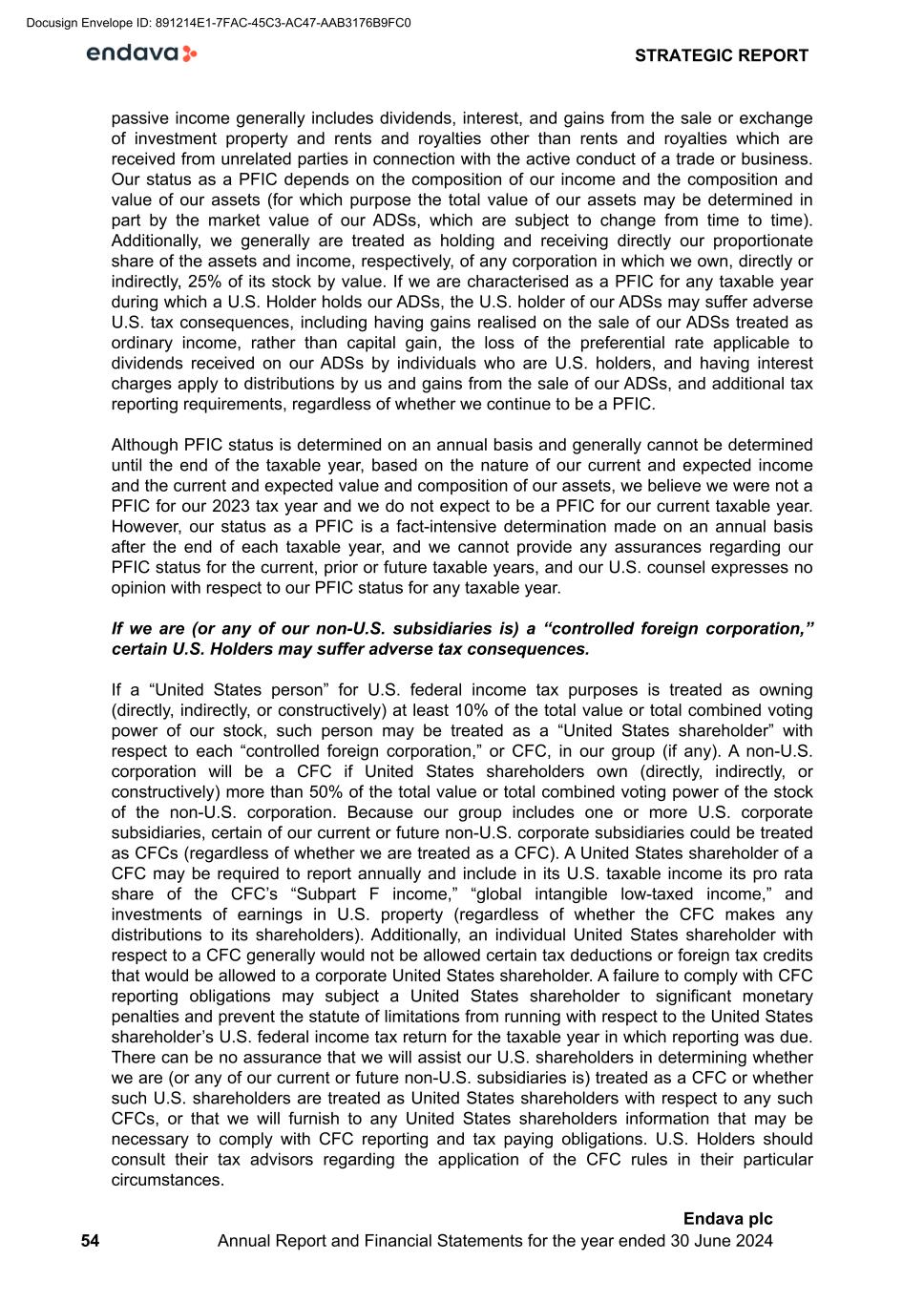
passive income generally includes dividends, interest, and gains from the sale or exchange of investment property and rents and royalties other than rents and royalties which are received from unrelated parties in connection with the active conduct of a trade or business. Our status as a PFIC depends on the composition of our income and the composition and value of our assets (for which purpose the total value of our assets may be determined in part by the market value of our ADSs, which are subject to change from time to time). Additionally, we generally are treated as holding and receiving directly our proportionate share of the assets and income, respectively, of any corporation in which we own, directly or indirectly, 25% of its stock by value. If we are characterised as a PFIC for any taxable year during which a U.S. Holder holds our ADSs, the U.S. holder of our ADSs may suffer adverse U.S. tax consequences, including having gains realised on the sale of our ADSs treated as ordinary income, rather than capital gain, the loss of the preferential rate applicable to dividends received on our ADSs by individuals who are U.S. holders, and having interest charges apply to distributions by us and gains from the sale of our ADSs, and additional tax reporting requirements, regardless of whether we continue to be a PFIC. Although PFIC status is determined on an annual basis and generally cannot be determined until the end of the taxable year, based on the nature of our current and expected income and the current and expected value and composition of our assets, we believe we were not a PFIC for our 2023 tax year and we do not expect to be a PFIC for our current taxable year. However, our status as a PFIC is a fact-intensive determination made on an annual basis after the end of each taxable year, and we cannot provide any assurances regarding our PFIC status for the current, prior or future taxable years, and our U.S. counsel expresses no opinion with respect to our PFIC status for any taxable year. If we are (or any of our non-U.S. subsidiaries is) a “controlled foreign corporation,” certain U.S. Holders may suffer adverse tax consequences. If a “United States person” for U.S. federal income tax purposes is treated as owning (directly, indirectly, or constructively) at least 10% of the total value or total combined voting power of our stock, such person may be treated as a “United States shareholder” with respect to each “controlled foreign corporation,” or CFC, in our group (if any). A non-U.S. corporation will be a CFC if United States shareholders own (directly, indirectly, or constructively) more than 50% of the total value or total combined voting power of the stock of the non-U.S. corporation. Because our group includes one or more U.S. corporate subsidiaries, certain of our current or future non-U.S. corporate subsidiaries could be treated as CFCs (regardless of whether we are treated as a CFC). A United States shareholder of a CFC may be required to report annually and include in its U.S. taxable income its pro rata share of the CFC’s “Subpart F income,” “global intangible low-taxed income,” and investments of earnings in U.S. property (regardless of whether the CFC makes any distributions to its shareholders). Additionally, an individual United States shareholder with respect to a CFC generally would not be allowed certain tax deductions or foreign tax credits that would be allowed to a corporate United States shareholder. A failure to comply with CFC reporting obligations may subject a United States shareholder to significant monetary penalties and prevent the statute of limitations from running with respect to the United States shareholder’s U.S. federal income tax return for the taxable year in which reporting was due. There can be no assurance that we will assist our U.S. shareholders in determining whether we are (or any of our current or future non-U.S. subsidiaries is) treated as a CFC or whether such U.S. shareholders are treated as United States shareholders with respect to any such CFCs, or that we will furnish to any United States shareholders information that may be necessary to comply with CFC reporting and tax paying obligations. U.S. Holders should consult their tax advisors regarding the application of the CFC rules in their particular circumstances. STRATEGIC REPORT 54 Endava plc Annual Report and Financial Statements for the year ended 30 June 2024 Docusign Envelope ID: 891214E1-7FAC-45C3-AC47-AAB3176B9FC0

Emerging markets are subject to greater risks than more developed markets, and financial turmoil in any emerging market could disrupt our business. Certain countries in South Asia, Central Europe and Latin America are generally considered to be emerging markets, which are subject to rapid change and greater legal, economic and political risks than more established markets. Financial problems or an increase in the perceived risks associated with investing in emerging economies could dampen foreign investment in South East Asia, Central Europe and Latin America and adversely affect the economy of the region. Political instability could result in a worsening overall economic situation, including capital flight and slowdown of investment and business activity. Current and future changes in governments of the countries in which we have or develop operations, as well as major policy shifts or lack of consensus between various branches of the government and powerful economic groups, could lead to political instability and disrupt or reverse political, economic and regulatory reforms, which could materially adversely affect our business and operations in those countries. In addition, political and economic relations between certain of the countries in which we operate are complex, and recent conflicts have arisen between certain of their governments. Political, ethnic, religious, historical and other differences have, on occasion, given rise to tensions and, in certain cases, military conflicts among Central European, Latin American or South East Asian countries which can halt normal economic activity and disrupt the economies of neighbouring regions. The emergence of new or escalated tensions in South East Asia, Central European or Latin American countries could further exacerbate tensions between such countries and the United Kingdom, the United States and the European Union, which may have a negative effect on their economy, our ability to develop or maintain our operations in those countries and our ability to attract and retain employees, any of which could materially adversely affect our business and operations. In addition, banking and other financial systems in certain countries in which we have operations are less developed and regulated than in some more developed markets, and legislation relating to banks and bank accounts is subject to varying interpretations and inconsistent application. Banks in these regions often do not meet the banking standards of more developed markets, and the transparency of the banking sector lags behind international standards. Furthermore, in certain countries in which we operate, bank deposits made by corporate entities generally either are not insured or are insured only to specified limits. As a result, the banking sector remains subject to periodic instability. Another banking crisis, or the bankruptcy or insolvency of banks through which we receive or with which we hold funds may result in the loss of our deposits or adversely affect our ability to complete banking transactions in certain countries in which we have operations, which could materially adversely affect our business and financial condition. Wage inflation and other compensation expense for our IT professionals could adversely affect our financial results. Wage costs for IT professionals in South East Asia, Central European, Latin American countries and in India are typically lower than comparable wage costs in more developed countries. However, wage costs in the technology services industry in these countries may increase at a faster rate than in the past and wage inflation for the IT industry may be higher than overall wage inflation within these countries. We may need to increase the levels of employee compensation more rapidly than in the past to remain competitive, and we may not be able to pass on these increased costs to our clients. In addition, we have observed increased wage expectations on a global scale due to inflation and adverse global economic conditions. Such wage expectations could create challenges for our recruiting efforts in light STRATEGIC REPORT 55 Endava plc Annual Report and Financial Statements for the year ended 30 June 2024 Docusign Envelope ID: 891214E1-7FAC-45C3-AC47-AAB3176B9FC0
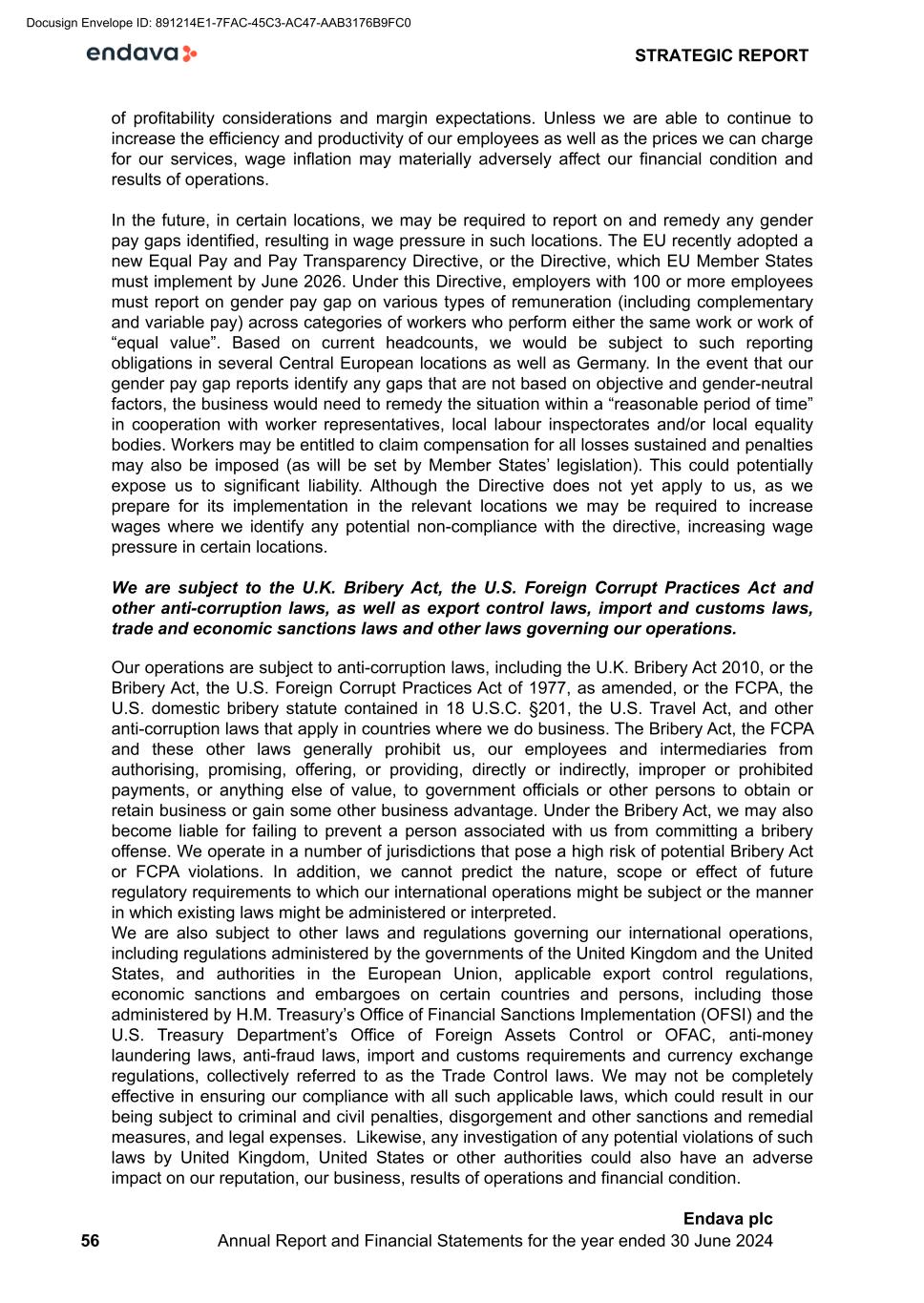
of profitability considerations and margin expectations. Unless we are able to continue to increase the efficiency and productivity of our employees as well as the prices we can charge for our services, wage inflation may materially adversely affect our financial condition and results of operations. In the future, in certain locations, we may be required to report on and remedy any gender pay gaps identified, resulting in wage pressure in such locations. The EU recently adopted a new Equal Pay and Pay Transparency Directive, or the Directive, which EU Member States must implement by June 2026. Under this Directive, employers with 100 or more employees must report on gender pay gap on various types of remuneration (including complementary and variable pay) across categories of workers who perform either the same work or work of “equal value”. Based on current headcounts, we would be subject to such reporting obligations in several Central European locations as well as Germany. In the event that our gender pay gap reports identify any gaps that are not based on objective and gender-neutral factors, the business would need to remedy the situation within a “reasonable period of time” in cooperation with worker representatives, local labour inspectorates and/or local equality bodies. Workers may be entitled to claim compensation for all losses sustained and penalties may also be imposed (as will be set by Member States’ legislation). This could potentially expose us to significant liability. Although the Directive does not yet apply to us, as we prepare for its implementation in the relevant locations we may be required to increase wages where we identify any potential non-compliance with the directive, increasing wage pressure in certain locations. We are subject to the U.K. Bribery Act, the U.S. Foreign Corrupt Practices Act and other anti-corruption laws, as well as export control laws, import and customs laws, trade and economic sanctions laws and other laws governing our operations. Our operations are subject to anti-corruption laws, including the U.K. Bribery Act 2010, or the Bribery Act, the U.S. Foreign Corrupt Practices Act of 1977, as amended, or the FCPA, the U.S. domestic bribery statute contained in 18 U.S.C. §201, the U.S. Travel Act, and other anti-corruption laws that apply in countries where we do business. The Bribery Act, the FCPA and these other laws generally prohibit us, our employees and intermediaries from authorising, promising, offering, or providing, directly or indirectly, improper or prohibited payments, or anything else of value, to government officials or other persons to obtain or retain business or gain some other business advantage. Under the Bribery Act, we may also become liable for failing to prevent a person associated with us from committing a bribery offense. We operate in a number of jurisdictions that pose a high risk of potential Bribery Act or FCPA violations. In addition, we cannot predict the nature, scope or effect of future regulatory requirements to which our international operations might be subject or the manner in which existing laws might be administered or interpreted. We are also subject to other laws and regulations governing our international operations, including regulations administered by the governments of the United Kingdom and the United States, and authorities in the European Union, applicable export control regulations, economic sanctions and embargoes on certain countries and persons, including those administered by H.M. Treasury’s Office of Financial Sanctions Implementation (OFSI) and the U.S. Treasury Department’s Office of Foreign Assets Control or OFAC, anti-money laundering laws, anti-fraud laws, import and customs requirements and currency exchange regulations, collectively referred to as the Trade Control laws. We may not be completely effective in ensuring our compliance with all such applicable laws, which could result in our being subject to criminal and civil penalties, disgorgement and other sanctions and remedial measures, and legal expenses. Likewise, any investigation of any potential violations of such laws by United Kingdom, United States or other authorities could also have an adverse impact on our reputation, our business, results of operations and financial condition. STRATEGIC REPORT 56 Endava plc Annual Report and Financial Statements for the year ended 30 June 2024 Docusign Envelope ID: 891214E1-7FAC-45C3-AC47-AAB3176B9FC0
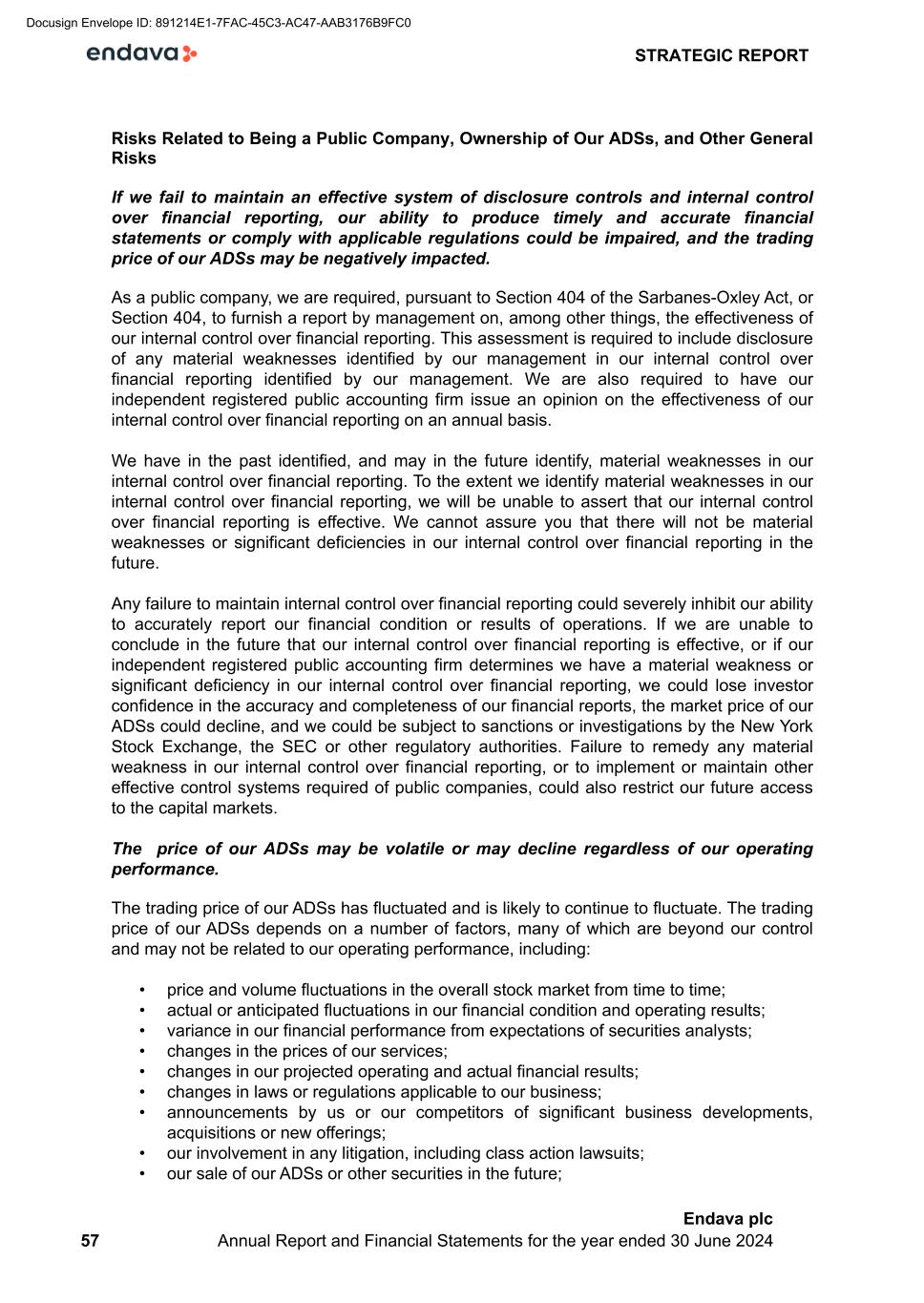
Risks Related to Being a Public Company, Ownership of Our ADSs, and Other General Risks If we fail to maintain an effective system of disclosure controls and internal control over financial reporting, our ability to produce timely and accurate financial statements or comply with applicable regulations could be impaired, and the trading price of our ADSs may be negatively impacted. As a public company, we are required, pursuant to Section 404 of the Sarbanes-Oxley Act, or Section 404, to furnish a report by management on, among other things, the effectiveness of our internal control over financial reporting. This assessment is required to include disclosure of any material weaknesses identified by our management in our internal control over financial reporting identified by our management. We are also required to have our independent registered public accounting firm issue an opinion on the effectiveness of our internal control over financial reporting on an annual basis. We have in the past identified, and may in the future identify, material weaknesses in our internal control over financial reporting. To the extent we identify material weaknesses in our internal control over financial reporting, we will be unable to assert that our internal control over financial reporting is effective. We cannot assure you that there will not be material weaknesses or significant deficiencies in our internal control over financial reporting in the future. Any failure to maintain internal control over financial reporting could severely inhibit our ability to accurately report our financial condition or results of operations. If we are unable to conclude in the future that our internal control over financial reporting is effective, or if our independent registered public accounting firm determines we have a material weakness or significant deficiency in our internal control over financial reporting, we could lose investor confidence in the accuracy and completeness of our financial reports, the market price of our ADSs could decline, and we could be subject to sanctions or investigations by the New York Stock Exchange, the SEC or other regulatory authorities. Failure to remedy any material weakness in our internal control over financial reporting, or to implement or maintain other effective control systems required of public companies, could also restrict our future access to the capital markets. The price of our ADSs may be volatile or may decline regardless of our operating performance. The trading price of our ADSs has fluctuated and is likely to continue to fluctuate. The trading price of our ADSs depends on a number of factors, many of which are beyond our control and may not be related to our operating performance, including: • price and volume fluctuations in the overall stock market from time to time; • actual or anticipated fluctuations in our financial condition and operating results; • variance in our financial performance from expectations of securities analysts; • changes in the prices of our services; • changes in our projected operating and actual financial results; • changes in laws or regulations applicable to our business; • announcements by us or our competitors of significant business developments, acquisitions or new offerings; • our involvement in any litigation, including class action lawsuits; • our sale of our ADSs or other securities in the future; STRATEGIC REPORT 57 Endava plc Annual Report and Financial Statements for the year ended 30 June 2024 Docusign Envelope ID: 891214E1-7FAC-45C3-AC47-AAB3176B9FC0
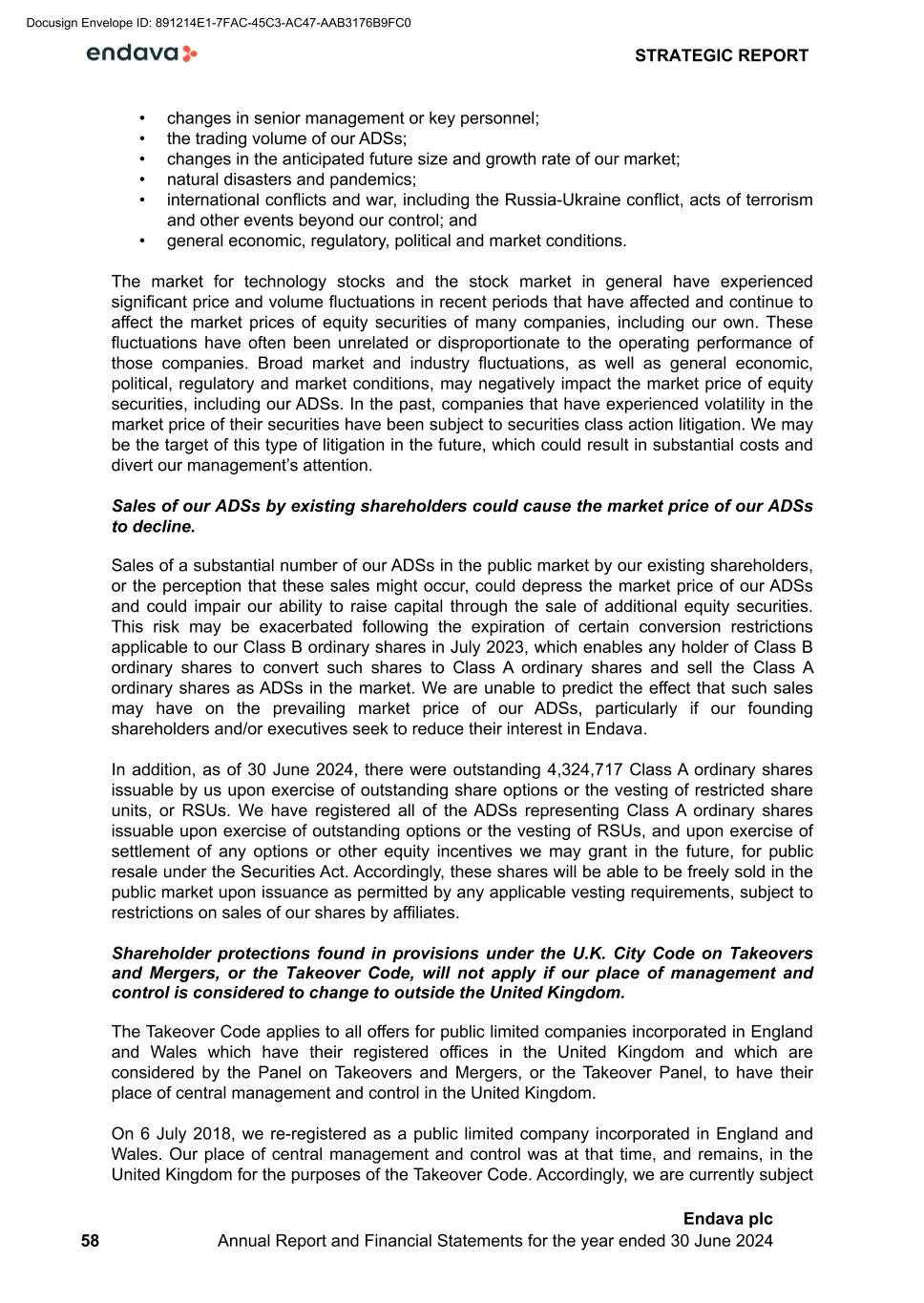
• changes in senior management or key personnel; • the trading volume of our ADSs; • changes in the anticipated future size and growth rate of our market; • natural disasters and pandemics; • international conflicts and war, including the Russia-Ukraine conflict, acts of terrorism and other events beyond our control; and • general economic, regulatory, political and market conditions. The market for technology stocks and the stock market in general have experienced significant price and volume fluctuations in recent periods that have affected and continue to affect the market prices of equity securities of many companies, including our own. These fluctuations have often been unrelated or disproportionate to the operating performance of those companies. Broad market and industry fluctuations, as well as general economic, political, regulatory and market conditions, may negatively impact the market price of equity securities, including our ADSs. In the past, companies that have experienced volatility in the market price of their securities have been subject to securities class action litigation. We may be the target of this type of litigation in the future, which could result in substantial costs and divert our management’s attention. Sales of our ADSs by existing shareholders could cause the market price of our ADSs to decline. Sales of a substantial number of our ADSs in the public market by our existing shareholders, or the perception that these sales might occur, could depress the market price of our ADSs and could impair our ability to raise capital through the sale of additional equity securities. This risk may be exacerbated following the expiration of certain conversion restrictions applicable to our Class B ordinary shares in July 2023, which enables any holder of Class B ordinary shares to convert such shares to Class A ordinary shares and sell the Class A ordinary shares as ADSs in the market. We are unable to predict the effect that such sales may have on the prevailing market price of our ADSs, particularly if our founding shareholders and/or executives seek to reduce their interest in Endava. In addition, as of 30 June 2024, there were outstanding 4,324,717 Class A ordinary shares issuable by us upon exercise of outstanding share options or the vesting of restricted share units, or RSUs. We have registered all of the ADSs representing Class A ordinary shares issuable upon exercise of outstanding options or the vesting of RSUs, and upon exercise of settlement of any options or other equity incentives we may grant in the future, for public resale under the Securities Act. Accordingly, these shares will be able to be freely sold in the public market upon issuance as permitted by any applicable vesting requirements, subject to restrictions on sales of our shares by affiliates. Shareholder protections found in provisions under the U.K. City Code on Takeovers and Mergers, or the Takeover Code, will not apply if our place of management and control is considered to change to outside the United Kingdom. The Takeover Code applies to all offers for public limited companies incorporated in England and Wales which have their registered offices in the United Kingdom and which are considered by the Panel on Takeovers and Mergers, or the Takeover Panel, to have their place of central management and control in the United Kingdom. On 6 July 2018, we re-registered as a public limited company incorporated in England and Wales. Our place of central management and control was at that time, and remains, in the United Kingdom for the purposes of the Takeover Code. Accordingly, we are currently subject STRATEGIC REPORT 58 Endava plc Annual Report and Financial Statements for the year ended 30 June 2024 Docusign Envelope ID: 891214E1-7FAC-45C3-AC47-AAB3176B9FC0
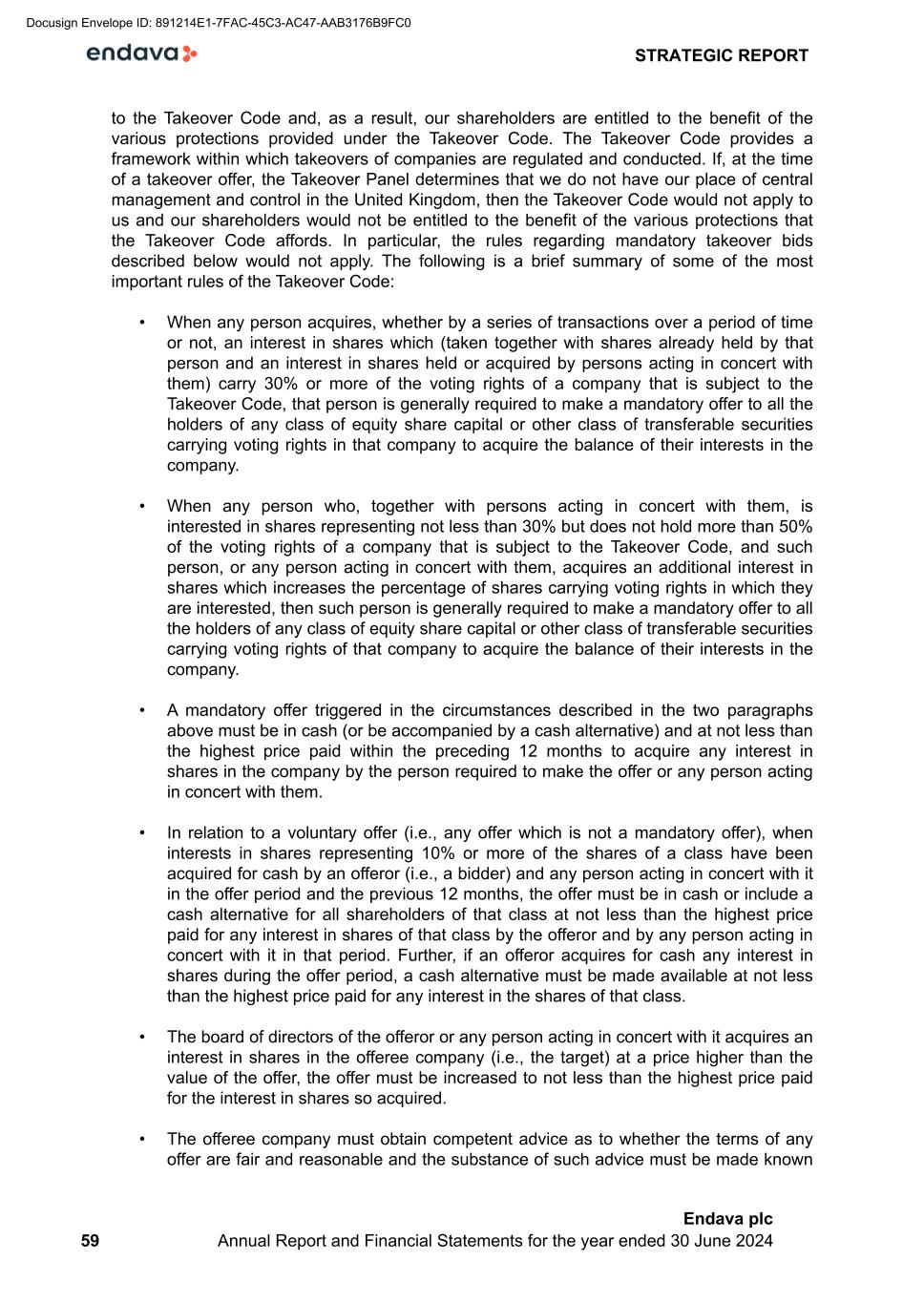
to the Takeover Code and, as a result, our shareholders are entitled to the benefit of the various protections provided under the Takeover Code. The Takeover Code provides a framework within which takeovers of companies are regulated and conducted. If, at the time of a takeover offer, the Takeover Panel determines that we do not have our place of central management and control in the United Kingdom, then the Takeover Code would not apply to us and our shareholders would not be entitled to the benefit of the various protections that the Takeover Code affords. In particular, the rules regarding mandatory takeover bids described below would not apply. The following is a brief summary of some of the most important rules of the Takeover Code: • When any person acquires, whether by a series of transactions over a period of time or not, an interest in shares which (taken together with shares already held by that person and an interest in shares held or acquired by persons acting in concert with them) carry 30% or more of the voting rights of a company that is subject to the Takeover Code, that person is generally required to make a mandatory offer to all the holders of any class of equity share capital or other class of transferable securities carrying voting rights in that company to acquire the balance of their interests in the company. • When any person who, together with persons acting in concert with them, is interested in shares representing not less than 30% but does not hold more than 50% of the voting rights of a company that is subject to the Takeover Code, and such person, or any person acting in concert with them, acquires an additional interest in shares which increases the percentage of shares carrying voting rights in which they are interested, then such person is generally required to make a mandatory offer to all the holders of any class of equity share capital or other class of transferable securities carrying voting rights of that company to acquire the balance of their interests in the company. • A mandatory offer triggered in the circumstances described in the two paragraphs above must be in cash (or be accompanied by a cash alternative) and at not less than the highest price paid within the preceding 12 months to acquire any interest in shares in the company by the person required to make the offer or any person acting in concert with them. • In relation to a voluntary offer (i.e., any offer which is not a mandatory offer), when interests in shares representing 10% or more of the shares of a class have been acquired for cash by an offeror (i.e., a bidder) and any person acting in concert with it in the offer period and the previous 12 months, the offer must be in cash or include a cash alternative for all shareholders of that class at not less than the highest price paid for any interest in shares of that class by the offeror and by any person acting in concert with it in that period. Further, if an offeror acquires for cash any interest in shares during the offer period, a cash alternative must be made available at not less than the highest price paid for any interest in the shares of that class. • The board of directors of the offeror or any person acting in concert with it acquires an interest in shares in the offeree company (i.e., the target) at a price higher than the value of the offer, the offer must be increased to not less than the highest price paid for the interest in shares so acquired. • The offeree company must obtain competent advice as to whether the terms of any offer are fair and reasonable and the substance of such advice must be made known STRATEGIC REPORT 59 Endava plc Annual Report and Financial Statements for the year ended 30 June 2024 Docusign Envelope ID: 891214E1-7FAC-45C3-AC47-AAB3176B9FC0

to all the shareholders, together with the opinion of the board of directors of the offeree company. • Special deals with favourable conditions for selected shareholders are not permitted. • All shareholders must be given the same information. • Each document published in connection with an offer by or on behalf of the offeror or offeree must state that the directors of the offeror or the offeree, as the case may be, accept responsibility for the information contained therein. • Profit forecasts, quantified financial benefits statements and asset valuations must be made to specified standards and must be reported on by professional advisers. • Misleading, inaccurate or unsubstantiated statements made in documents or to the media must be publicly corrected immediately. • Actions during the course of an offer by the offeree company, which might frustrate the offer, are generally prohibited unless shareholders approve these plans. • Stringent and detailed requirements are laid down for the disclosure of dealings in relevant securities during an offer. • Employee representatives or employees of both the offeror and the offeree company and the trustees of the offeree company’s pension scheme must be informed about an offer. In addition, the offeree company’s employee representatives and pension scheme trustees have the right to have a separate opinion on the effects of the offer on employment and pension scheme(s), respectively, appended to the offeree board of directors’ circular or published on a website. The dual class structure of our ordinary shares has the effect of concentrating voting control for the foreseeable future, which will limit your ability to influence corporate matters. Our Class B ordinary shares have 10 votes per share, and our Class A ordinary shares, which are the shares underlying the ADSs, have one vote per share. Given the greater number of votes per share attributed to our Class B ordinary shares, holders of Class B ordinary shares collectively beneficially hold shares representing approximately 76.3% of the voting rights of our outstanding share capital as of 15 August 2024. Further, John Cotterell, our Chief Executive Officer, beneficially holds Class B ordinary shares, which along with the Class A ordinary shares he beneficially owns, represents approximately 45.2% of the voting rights of our outstanding share capital as of 15 August 2024. Consequently, Mr. Cotterell will continue to be able to have a significant influence on corporate matters submitted to a vote of shareholders. Notwithstanding this concentration of control, we do not currently qualify as a “controlled company” under New York Stock Exchange listing rules. This concentrated control will limit the ability of other shareholders to influence corporate matters for the foreseeable future. This concentrated control could also discourage a potential investor from acquiring our ADSs due to the limited voting power of the Class A ordinary shares underlying the ADSs relative to the Class B ordinary shares and might harm the market price of our ADSs. In addition, Mr. Cotterell has the ability to control the management and major strategic investments of our company as a result of his position as our Chief Executive Officer. As a member of our board of directors, Mr. Cotterell owes statutory and fiduciary duties to us and must act in good faith and in a manner that he STRATEGIC REPORT 60 Endava plc Annual Report and Financial Statements for the year ended 30 June 2024 Docusign Envelope ID: 891214E1-7FAC-45C3-AC47-AAB3176B9FC0
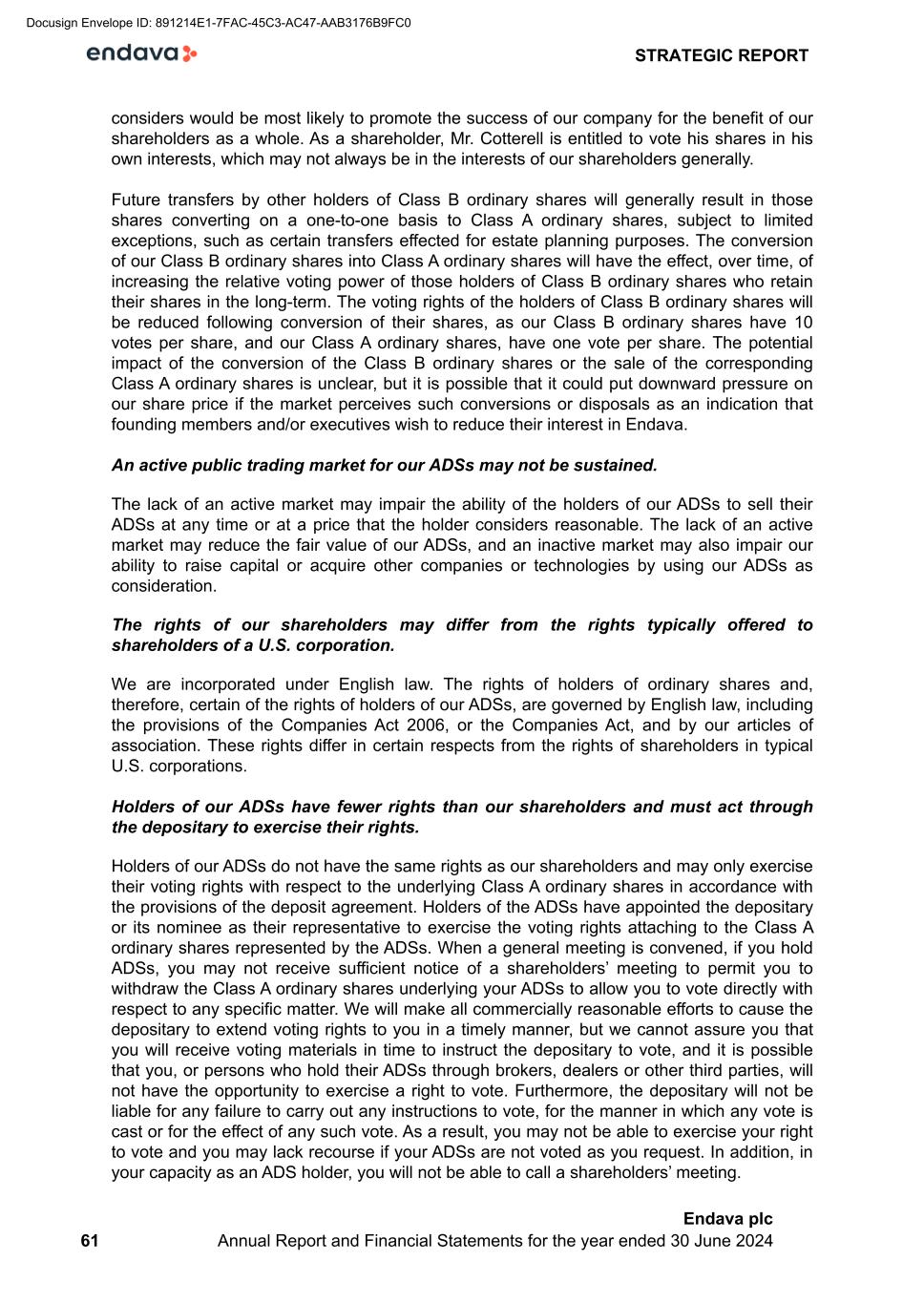
considers would be most likely to promote the success of our company for the benefit of our shareholders as a whole. As a shareholder, Mr. Cotterell is entitled to vote his shares in his own interests, which may not always be in the interests of our shareholders generally. Future transfers by other holders of Class B ordinary shares will generally result in those shares converting on a one-to-one basis to Class A ordinary shares, subject to limited exceptions, such as certain transfers effected for estate planning purposes. The conversion of our Class B ordinary shares into Class A ordinary shares will have the effect, over time, of increasing the relative voting power of those holders of Class B ordinary shares who retain their shares in the long-term. The voting rights of the holders of Class B ordinary shares will be reduced following conversion of their shares, as our Class B ordinary shares have 10 votes per share, and our Class A ordinary shares, have one vote per share. The potential impact of the conversion of the Class B ordinary shares or the sale of the corresponding Class A ordinary shares is unclear, but it is possible that it could put downward pressure on our share price if the market perceives such conversions or disposals as an indication that founding members and/or executives wish to reduce their interest in Endava. An active public trading market for our ADSs may not be sustained. The lack of an active market may impair the ability of the holders of our ADSs to sell their ADSs at any time or at a price that the holder considers reasonable. The lack of an active market may reduce the fair value of our ADSs, and an inactive market may also impair our ability to raise capital or acquire other companies or technologies by using our ADSs as consideration. The rights of our shareholders may differ from the rights typically offered to shareholders of a U.S. corporation. We are incorporated under English law. The rights of holders of ordinary shares and, therefore, certain of the rights of holders of our ADSs, are governed by English law, including the provisions of the Companies Act 2006, or the Companies Act, and by our articles of association. These rights differ in certain respects from the rights of shareholders in typical U.S. corporations. Holders of our ADSs have fewer rights than our shareholders and must act through the depositary to exercise their rights. Holders of our ADSs do not have the same rights as our shareholders and may only exercise their voting rights with respect to the underlying Class A ordinary shares in accordance with the provisions of the deposit agreement. Holders of the ADSs have appointed the depositary or its nominee as their representative to exercise the voting rights attaching to the Class A ordinary shares represented by the ADSs. When a general meeting is convened, if you hold ADSs, you may not receive sufficient notice of a shareholders’ meeting to permit you to withdraw the Class A ordinary shares underlying your ADSs to allow you to vote directly with respect to any specific matter. We will make all commercially reasonable efforts to cause the depositary to extend voting rights to you in a timely manner, but we cannot assure you that you will receive voting materials in time to instruct the depositary to vote, and it is possible that you, or persons who hold their ADSs through brokers, dealers or other third parties, will not have the opportunity to exercise a right to vote. Furthermore, the depositary will not be liable for any failure to carry out any instructions to vote, for the manner in which any vote is cast or for the effect of any such vote. As a result, you may not be able to exercise your right to vote and you may lack recourse if your ADSs are not voted as you request. In addition, in your capacity as an ADS holder, you will not be able to call a shareholders’ meeting. STRATEGIC REPORT 61 Endava plc Annual Report and Financial Statements for the year ended 30 June 2024 Docusign Envelope ID: 891214E1-7FAC-45C3-AC47-AAB3176B9FC0
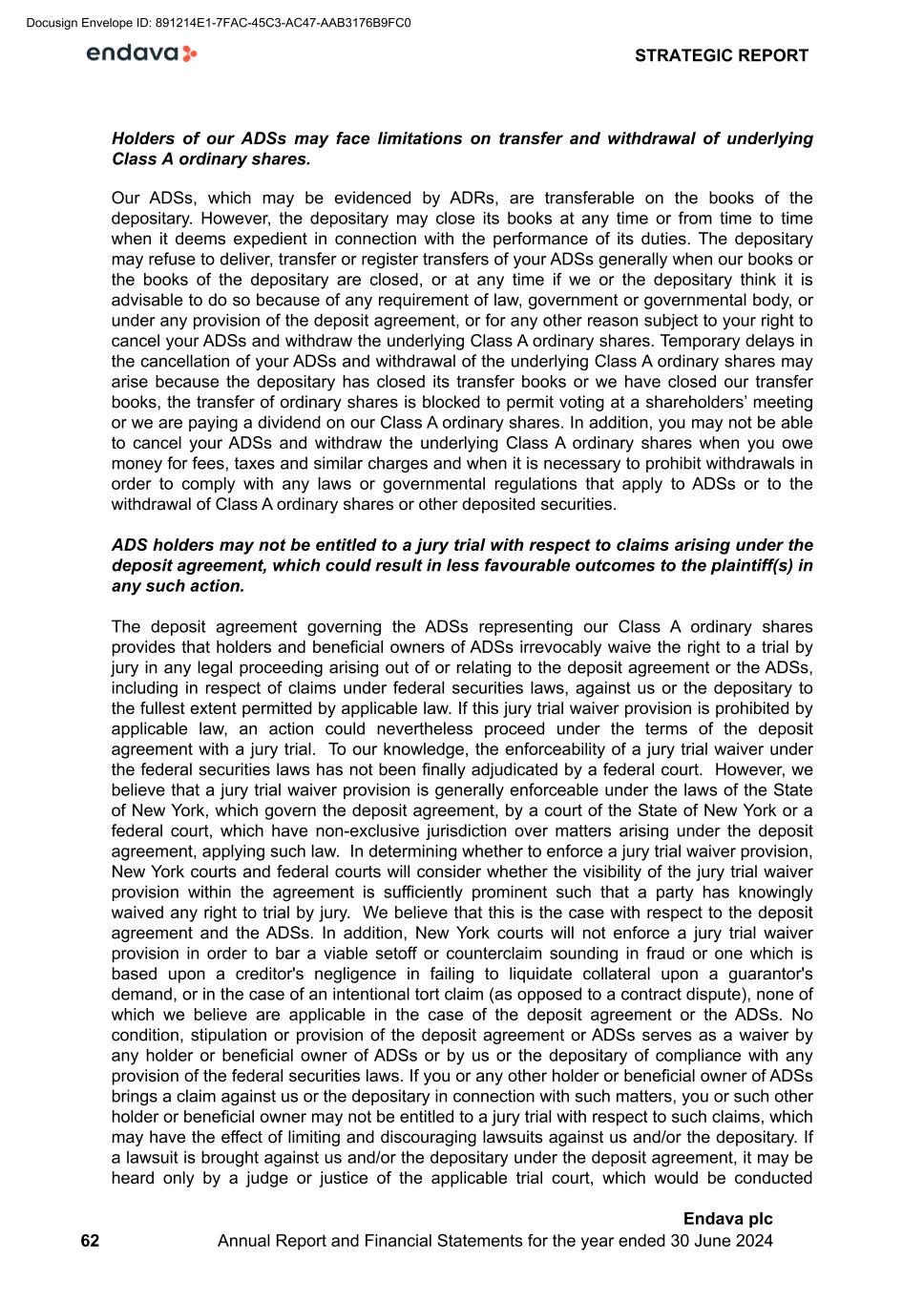
Holders of our ADSs may face limitations on transfer and withdrawal of underlying Class A ordinary shares. Our ADSs, which may be evidenced by ADRs, are transferable on the books of the depositary. However, the depositary may close its books at any time or from time to time when it deems expedient in connection with the performance of its duties. The depositary may refuse to deliver, transfer or register transfers of your ADSs generally when our books or the books of the depositary are closed, or at any time if we or the depositary think it is advisable to do so because of any requirement of law, government or governmental body, or under any provision of the deposit agreement, or for any other reason subject to your right to cancel your ADSs and withdraw the underlying Class A ordinary shares. Temporary delays in the cancellation of your ADSs and withdrawal of the underlying Class A ordinary shares may arise because the depositary has closed its transfer books or we have closed our transfer books, the transfer of ordinary shares is blocked to permit voting at a shareholders’ meeting or we are paying a dividend on our Class A ordinary shares. In addition, you may not be able to cancel your ADSs and withdraw the underlying Class A ordinary shares when you owe money for fees, taxes and similar charges and when it is necessary to prohibit withdrawals in order to comply with any laws or governmental regulations that apply to ADSs or to the withdrawal of Class A ordinary shares or other deposited securities. ADS holders may not be entitled to a jury trial with respect to claims arising under the deposit agreement, which could result in less favourable outcomes to the plaintiff(s) in any such action. The deposit agreement governing the ADSs representing our Class A ordinary shares provides that holders and beneficial owners of ADSs irrevocably waive the right to a trial by jury in any legal proceeding arising out of or relating to the deposit agreement or the ADSs, including in respect of claims under federal securities laws, against us or the depositary to the fullest extent permitted by applicable law. If this jury trial waiver provision is prohibited by applicable law, an action could nevertheless proceed under the terms of the deposit agreement with a jury trial. To our knowledge, the enforceability of a jury trial waiver under the federal securities laws has not been finally adjudicated by a federal court. However, we believe that a jury trial waiver provision is generally enforceable under the laws of the State of New York, which govern the deposit agreement, by a court of the State of New York or a federal court, which have non-exclusive jurisdiction over matters arising under the deposit agreement, applying such law. In determining whether to enforce a jury trial waiver provision, New York courts and federal courts will consider whether the visibility of the jury trial waiver provision within the agreement is sufficiently prominent such that a party has knowingly waived any right to trial by jury. We believe that this is the case with respect to the deposit agreement and the ADSs. In addition, New York courts will not enforce a jury trial waiver provision in order to bar a viable setoff or counterclaim sounding in fraud or one which is based upon a creditor's negligence in failing to liquidate collateral upon a guarantor's demand, or in the case of an intentional tort claim (as opposed to a contract dispute), none of which we believe are applicable in the case of the deposit agreement or the ADSs. No condition, stipulation or provision of the deposit agreement or ADSs serves as a waiver by any holder or beneficial owner of ADSs or by us or the depositary of compliance with any provision of the federal securities laws. If you or any other holder or beneficial owner of ADSs brings a claim against us or the depositary in connection with such matters, you or such other holder or beneficial owner may not be entitled to a jury trial with respect to such claims, which may have the effect of limiting and discouraging lawsuits against us and/or the depositary. If a lawsuit is brought against us and/or the depositary under the deposit agreement, it may be heard only by a judge or justice of the applicable trial court, which would be conducted STRATEGIC REPORT 62 Endava plc Annual Report and Financial Statements for the year ended 30 June 2024 Docusign Envelope ID: 891214E1-7FAC-45C3-AC47-AAB3176B9FC0
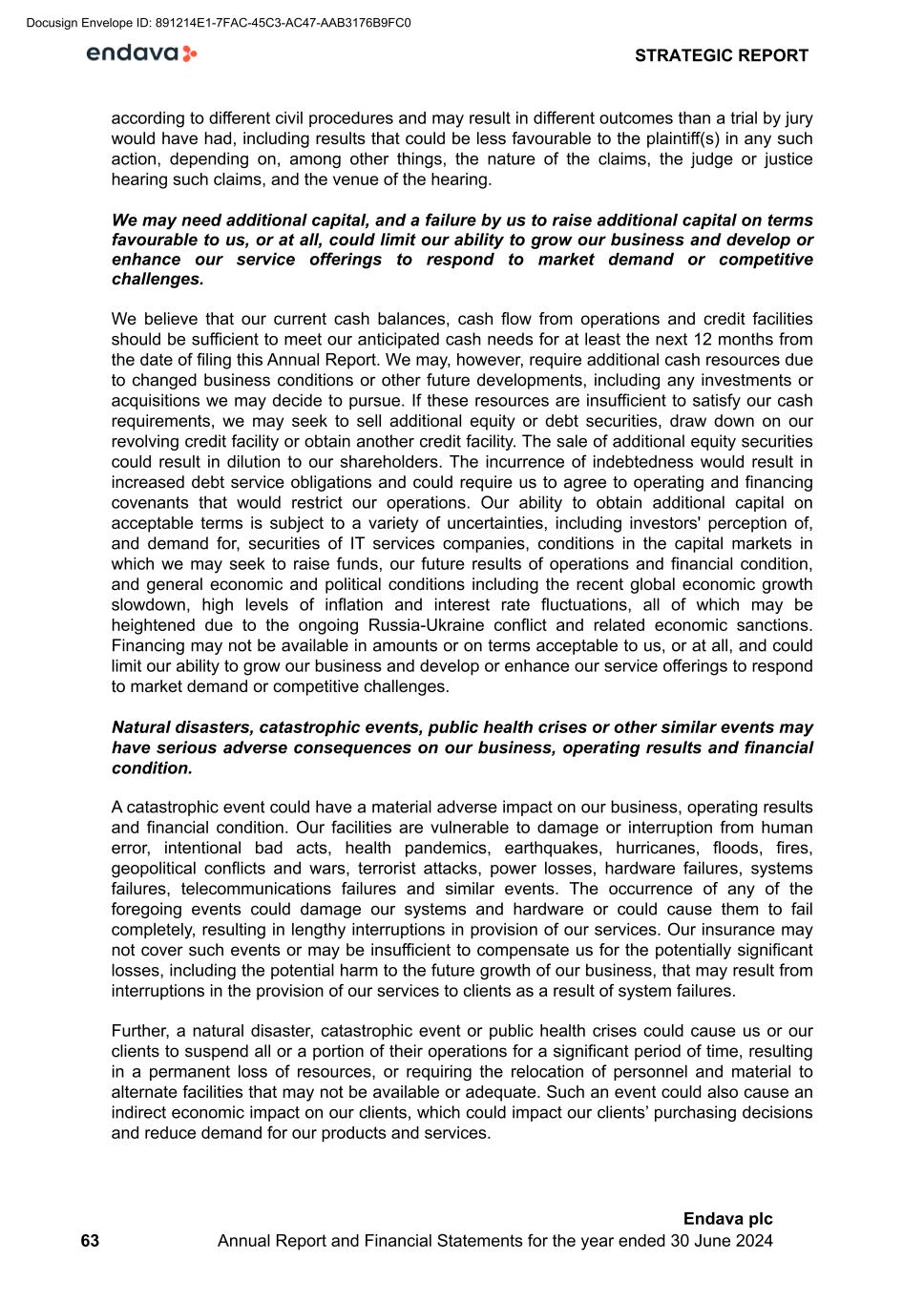
according to different civil procedures and may result in different outcomes than a trial by jury would have had, including results that could be less favourable to the plaintiff(s) in any such action, depending on, among other things, the nature of the claims, the judge or justice hearing such claims, and the venue of the hearing. We may need additional capital, and a failure by us to raise additional capital on terms favourable to us, or at all, could limit our ability to grow our business and develop or enhance our service offerings to respond to market demand or competitive challenges. We believe that our current cash balances, cash flow from operations and credit facilities should be sufficient to meet our anticipated cash needs for at least the next 12 months from the date of filing this Annual Report. We may, however, require additional cash resources due to changed business conditions or other future developments, including any investments or acquisitions we may decide to pursue. If these resources are insufficient to satisfy our cash requirements, we may seek to sell additional equity or debt securities, draw down on our revolving credit facility or obtain another credit facility. The sale of additional equity securities could result in dilution to our shareholders. The incurrence of indebtedness would result in increased debt service obligations and could require us to agree to operating and financing covenants that would restrict our operations. Our ability to obtain additional capital on acceptable terms is subject to a variety of uncertainties, including investors' perception of, and demand for, securities of IT services companies, conditions in the capital markets in which we may seek to raise funds, our future results of operations and financial condition, and general economic and political conditions including the recent global economic growth slowdown, high levels of inflation and interest rate fluctuations, all of which may be heightened due to the ongoing Russia-Ukraine conflict and related economic sanctions. Financing may not be available in amounts or on terms acceptable to us, or at all, and could limit our ability to grow our business and develop or enhance our service offerings to respond to market demand or competitive challenges. Natural disasters, catastrophic events, public health crises or other similar events may have serious adverse consequences on our business, operating results and financial condition. A catastrophic event could have a material adverse impact on our business, operating results and financial condition. Our facilities are vulnerable to damage or interruption from human error, intentional bad acts, health pandemics, earthquakes, hurricanes, floods, fires, geopolitical conflicts and wars, terrorist attacks, power losses, hardware failures, systems failures, telecommunications failures and similar events. The occurrence of any of the foregoing events could damage our systems and hardware or could cause them to fail completely, resulting in lengthy interruptions in provision of our services. Our insurance may not cover such events or may be insufficient to compensate us for the potentially significant losses, including the potential harm to the future growth of our business, that may result from interruptions in the provision of our services to clients as a result of system failures. Further, a natural disaster, catastrophic event or public health crises could cause us or our clients to suspend all or a portion of their operations for a significant period of time, resulting in a permanent loss of resources, or requiring the relocation of personnel and material to alternate facilities that may not be available or adequate. Such an event could also cause an indirect economic impact on our clients, which could impact our clients’ purchasing decisions and reduce demand for our products and services. STRATEGIC REPORT 63 Endava plc Annual Report and Financial Statements for the year ended 30 June 2024 Docusign Envelope ID: 891214E1-7FAC-45C3-AC47-AAB3176B9FC0

All of the aforementioned risks may be exacerbated if our disaster recovery plan proves to be inadequate. To the extent that any of the above results in delayed, reduced or cessation of our sales or increases our cost of sales, our business, financial condition and results of operations could be adversely affected. As a foreign private issuer, we are exempt from a number of rules under the U.S. securities laws and are permitted to file less information with the SEC than U.S. public companies. We are a “foreign private issuer,” as defined in the SEC rules and regulations and, consequently, we are not subject to all of the disclosure requirements applicable to companies organised within the United States. For example, we are exempt from certain rules under the U.S. Securities Exchange Act of 1934, as amended, or the Exchange Act, that regulate disclosure obligations and procedural requirements related to the solicitation of proxies, consents or authorisations applicable to a security registered under the Exchange Act. In addition, our officers and directors are exempt from the reporting and “short-swing” profit recovery provisions of Section 16 of the Exchange Act and related rules with respect to their purchases and sales of our securities. Further, we are not required to comply with Regulation FD, which restricts the selective disclosure of material information. Moreover, we are not required to file periodic reports and financial statements with the SEC as frequently or as promptly as U.S. public companies. Accordingly, there may be less publicly available information concerning our company than there is for U.S. public companies. As a foreign private issuer, we file annual reports on Form 20-F within four months of the close of each financial year ended 30 June and reports on Form 6-K relating to certain material events promptly after we publicly announce these events. However, because of the above exemptions for foreign private issuers, our shareholders are not afforded the same protections or information generally available to investors holding shares in public companies organised in the United States. While we are a foreign private issuer, we are not subject to certain New York Stock Exchange corporate governance listing standards applicable to U.S. listed companies. We are entitled to rely on a provision in the New York Stock Exchange’s corporate governance listing standards that allows us to follow English corporate law and the Companies Act with regard to certain aspects of corporate governance. This allows us to follow certain corporate governance practices that differ in significant respects from the corporate governance requirements applicable to U.S. companies listed on the New York Stock Exchange. For example, we are exempt from New York Stock Exchange regulations that require a listed U.S. company to have a majority of the board of directors consist of independent directors, require regularly scheduled executive sessions with only independent directors each year and have a remuneration committee or a nominations or corporate governance committee consisting entirely of independent directors. In accordance with our New York Stock Exchange listing, our audit committee is required to comply with the provisions of Section 301 of the Sarbanes-Oxley Act and Rule 10A-3 of the Exchange Act, both of which are also applicable to New York Stock Exchange-listed U.S. companies. Because we are a foreign private issuer, however, our audit committee is not subject to additional New York Stock Exchange requirements applicable to listed U.S. companies, including an affirmative determination that all members of the audit committee are “independent,” using more stringent criteria than those applicable to us as a foreign private issuer. Furthermore, the New York Stock Exchange’s corporate governance listing STRATEGIC REPORT 64 Endava plc Annual Report and Financial Statements for the year ended 30 June 2024 Docusign Envelope ID: 891214E1-7FAC-45C3-AC47-AAB3176B9FC0
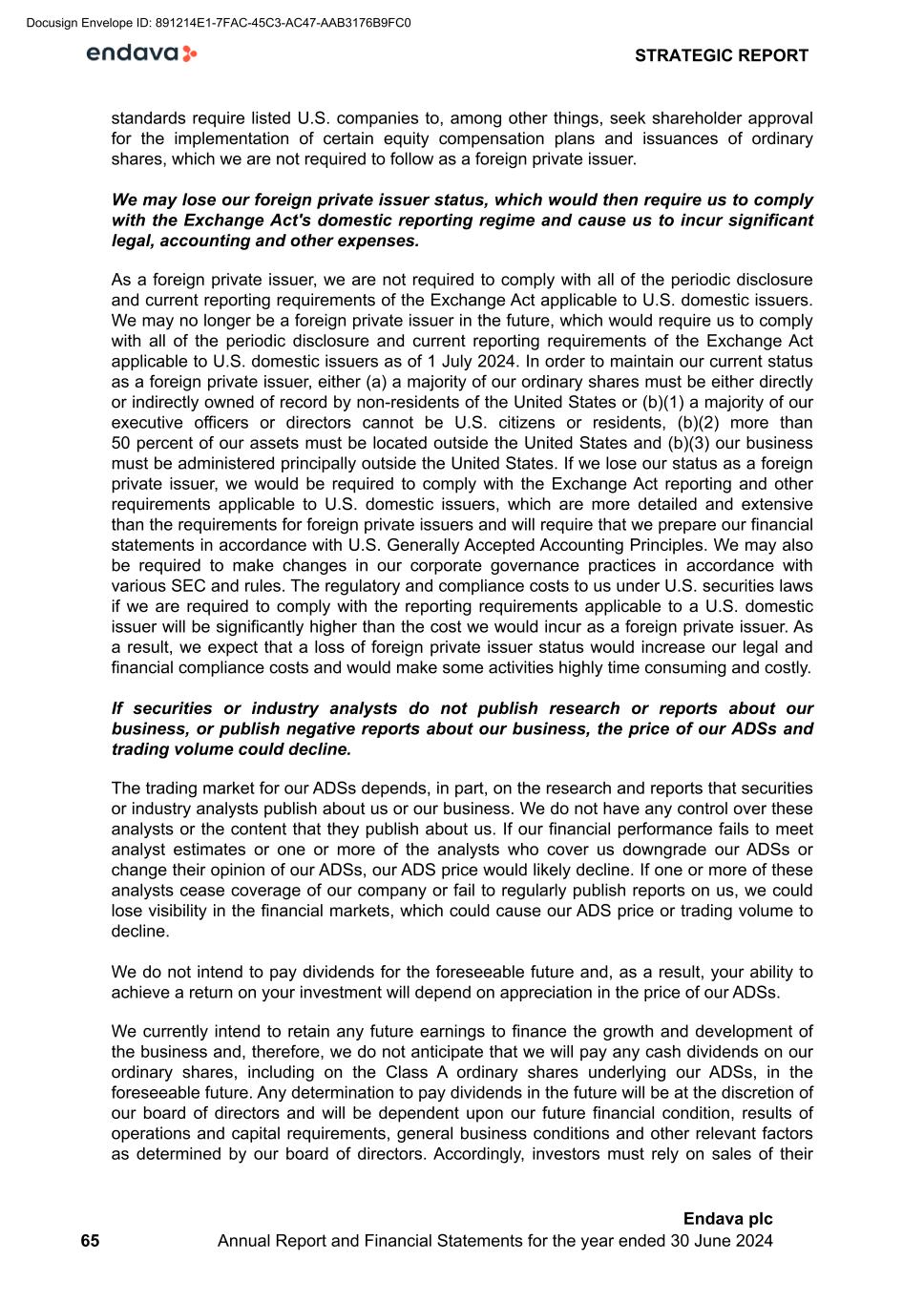
standards require listed U.S. companies to, among other things, seek shareholder approval for the implementation of certain equity compensation plans and issuances of ordinary shares, which we are not required to follow as a foreign private issuer. We may lose our foreign private issuer status, which would then require us to comply with the Exchange Act's domestic reporting regime and cause us to incur significant legal, accounting and other expenses. As a foreign private issuer, we are not required to comply with all of the periodic disclosure and current reporting requirements of the Exchange Act applicable to U.S. domestic issuers. We may no longer be a foreign private issuer in the future, which would require us to comply with all of the periodic disclosure and current reporting requirements of the Exchange Act applicable to U.S. domestic issuers as of 1 July 2024. In order to maintain our current status as a foreign private issuer, either (a) a majority of our ordinary shares must be either directly or indirectly owned of record by non-residents of the United States or (b)(1) a majority of our executive officers or directors cannot be U.S. citizens or residents, (b)(2) more than 50 percent of our assets must be located outside the United States and (b)(3) our business must be administered principally outside the United States. If we lose our status as a foreign private issuer, we would be required to comply with the Exchange Act reporting and other requirements applicable to U.S. domestic issuers, which are more detailed and extensive than the requirements for foreign private issuers and will require that we prepare our financial statements in accordance with U.S. Generally Accepted Accounting Principles. We may also be required to make changes in our corporate governance practices in accordance with various SEC and rules. The regulatory and compliance costs to us under U.S. securities laws if we are required to comply with the reporting requirements applicable to a U.S. domestic issuer will be significantly higher than the cost we would incur as a foreign private issuer. As a result, we expect that a loss of foreign private issuer status would increase our legal and financial compliance costs and would make some activities highly time consuming and costly. If securities or industry analysts do not publish research or reports about our business, or publish negative reports about our business, the price of our ADSs and trading volume could decline. The trading market for our ADSs depends, in part, on the research and reports that securities or industry analysts publish about us or our business. We do not have any control over these analysts or the content that they publish about us. If our financial performance fails to meet analyst estimates or one or more of the analysts who cover us downgrade our ADSs or change their opinion of our ADSs, our ADS price would likely decline. If one or more of these analysts cease coverage of our company or fail to regularly publish reports on us, we could lose visibility in the financial markets, which could cause our ADS price or trading volume to decline. We do not intend to pay dividends for the foreseeable future and, as a result, your ability to achieve a return on your investment will depend on appreciation in the price of our ADSs. We currently intend to retain any future earnings to finance the growth and development of the business and, therefore, we do not anticipate that we will pay any cash dividends on our ordinary shares, including on the Class A ordinary shares underlying our ADSs, in the foreseeable future. Any determination to pay dividends in the future will be at the discretion of our board of directors and will be dependent upon our future financial condition, results of operations and capital requirements, general business conditions and other relevant factors as determined by our board of directors. Accordingly, investors must rely on sales of their STRATEGIC REPORT 65 Endava plc Annual Report and Financial Statements for the year ended 30 June 2024 Docusign Envelope ID: 891214E1-7FAC-45C3-AC47-AAB3176B9FC0
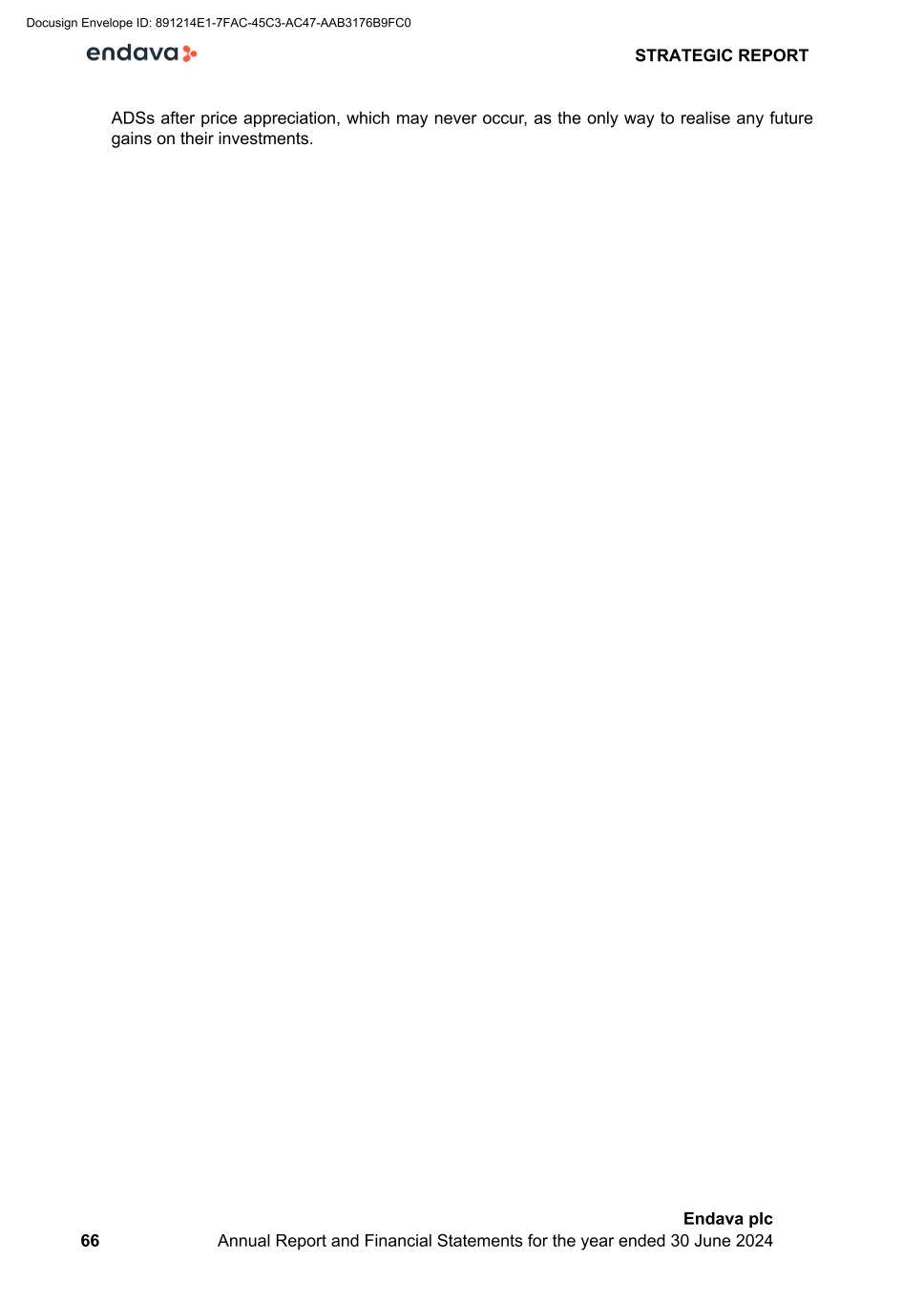
ADSs after price appreciation, which may never occur, as the only way to realise any future gains on their investments. STRATEGIC REPORT 66 Endava plc Annual Report and Financial Statements for the year ended 30 June 2024 Docusign Envelope ID: 891214E1-7FAC-45C3-AC47-AAB3176B9FC0
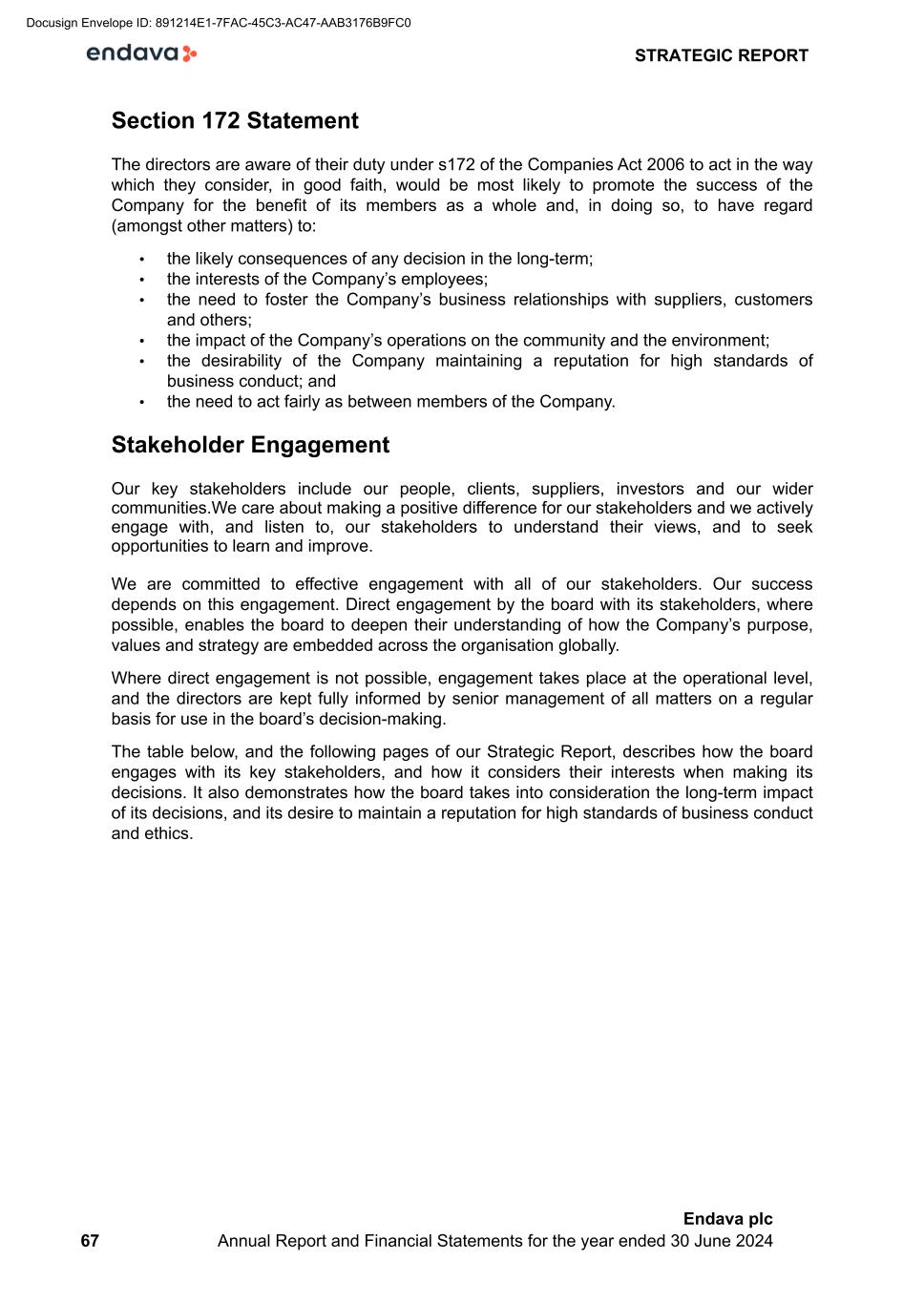
Section 172 Statement The directors are aware of their duty under s172 of the Companies Act 2006 to act in the way which they consider, in good faith, would be most likely to promote the success of the Company for the benefit of its members as a whole and, in doing so, to have regard (amongst other matters) to: • the likely consequences of any decision in the long-term; • the interests of the Company’s employees; • the need to foster the Company’s business relationships with suppliers, customers and others; • the impact of the Company’s operations on the community and the environment; • the desirability of the Company maintaining a reputation for high standards of business conduct; and • the need to act fairly as between members of the Company. Stakeholder Engagement Our key stakeholders include our people, clients, suppliers, investors and our wider communities.We care about making a positive difference for our stakeholders and we actively engage with, and listen to, our stakeholders to understand their views, and to seek opportunities to learn and improve. We are committed to effective engagement with all of our stakeholders. Our success depends on this engagement. Direct engagement by the board with its stakeholders, where possible, enables the board to deepen their understanding of how the Company’s purpose, values and strategy are embedded across the organisation globally. Where direct engagement is not possible, engagement takes place at the operational level, and the directors are kept fully informed by senior management of all matters on a regular basis for use in the board’s decision-making. The table below, and the following pages of our Strategic Report, describes how the board engages with its key stakeholders, and how it considers their interests when making its decisions. It also demonstrates how the board takes into consideration the long-term impact of its decisions, and its desire to maintain a reputation for high standards of business conduct and ethics. STRATEGIC REPORT 67 Endava plc Annual Report and Financial Statements for the year ended 30 June 2024 Docusign Envelope ID: 891214E1-7FAC-45C3-AC47-AAB3176B9FC0
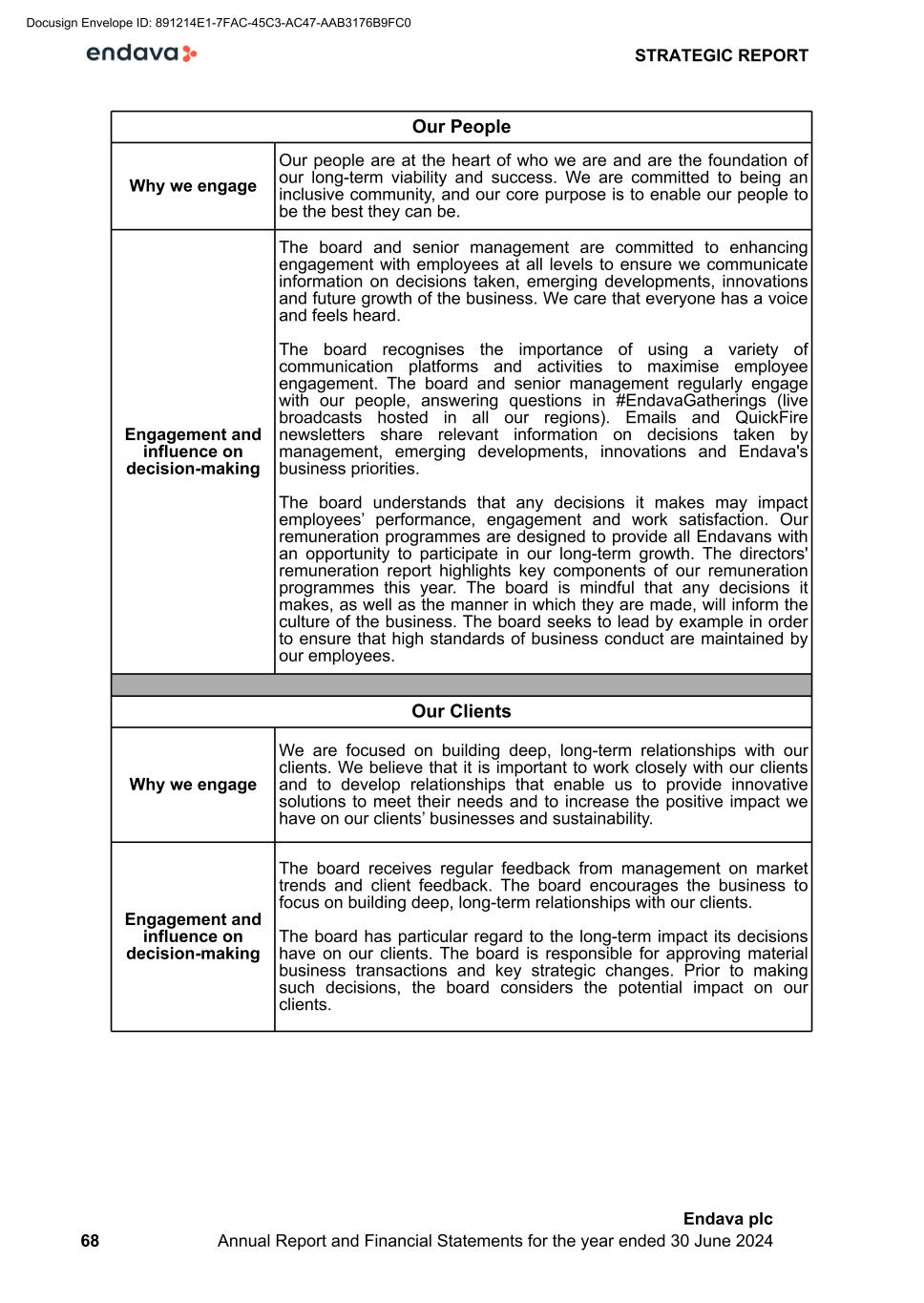
Our People Why we engage Our people are at the heart of who we are and are the foundation of our long-term viability and success. We are committed to being an inclusive community, and our core purpose is to enable our people to be the best they can be. Engagement and influence on decision-making The board and senior management are committed to enhancing engagement with employees at all levels to ensure we communicate information on decisions taken, emerging developments, innovations and future growth of the business. We care that everyone has a voice and feels heard. The board recognises the importance of using a variety of communication platforms and activities to maximise employee engagement. The board and senior management regularly engage with our people, answering questions in #EndavaGatherings (live broadcasts hosted in all our regions). Emails and QuickFire newsletters share relevant information on decisions taken by management, emerging developments, innovations and Endava's business priorities. The board understands that any decisions it makes may impact employees’ performance, engagement and work satisfaction. Our remuneration programmes are designed to provide all Endavans with an opportunity to participate in our long-term growth. The directors' remuneration report highlights key components of our remuneration programmes this year. The board is mindful that any decisions it makes, as well as the manner in which they are made, will inform the culture of the business. The board seeks to lead by example in order to ensure that high standards of business conduct are maintained by our employees. Our Clients Why we engage We are focused on building deep, long-term relationships with our clients. We believe that it is important to work closely with our clients and to develop relationships that enable us to provide innovative solutions to meet their needs and to increase the positive impact we have on our clients’ businesses and sustainability. Engagement and influence on decision-making The board receives regular feedback from management on market trends and client feedback. The board encourages the business to focus on building deep, long-term relationships with our clients. The board has particular regard to the long-term impact its decisions have on our clients. The board is responsible for approving material business transactions and key strategic changes. Prior to making such decisions, the board considers the potential impact on our clients. STRATEGIC REPORT 68 Endava plc Annual Report and Financial Statements for the year ended 30 June 2024 Docusign Envelope ID: 891214E1-7FAC-45C3-AC47-AAB3176B9FC0
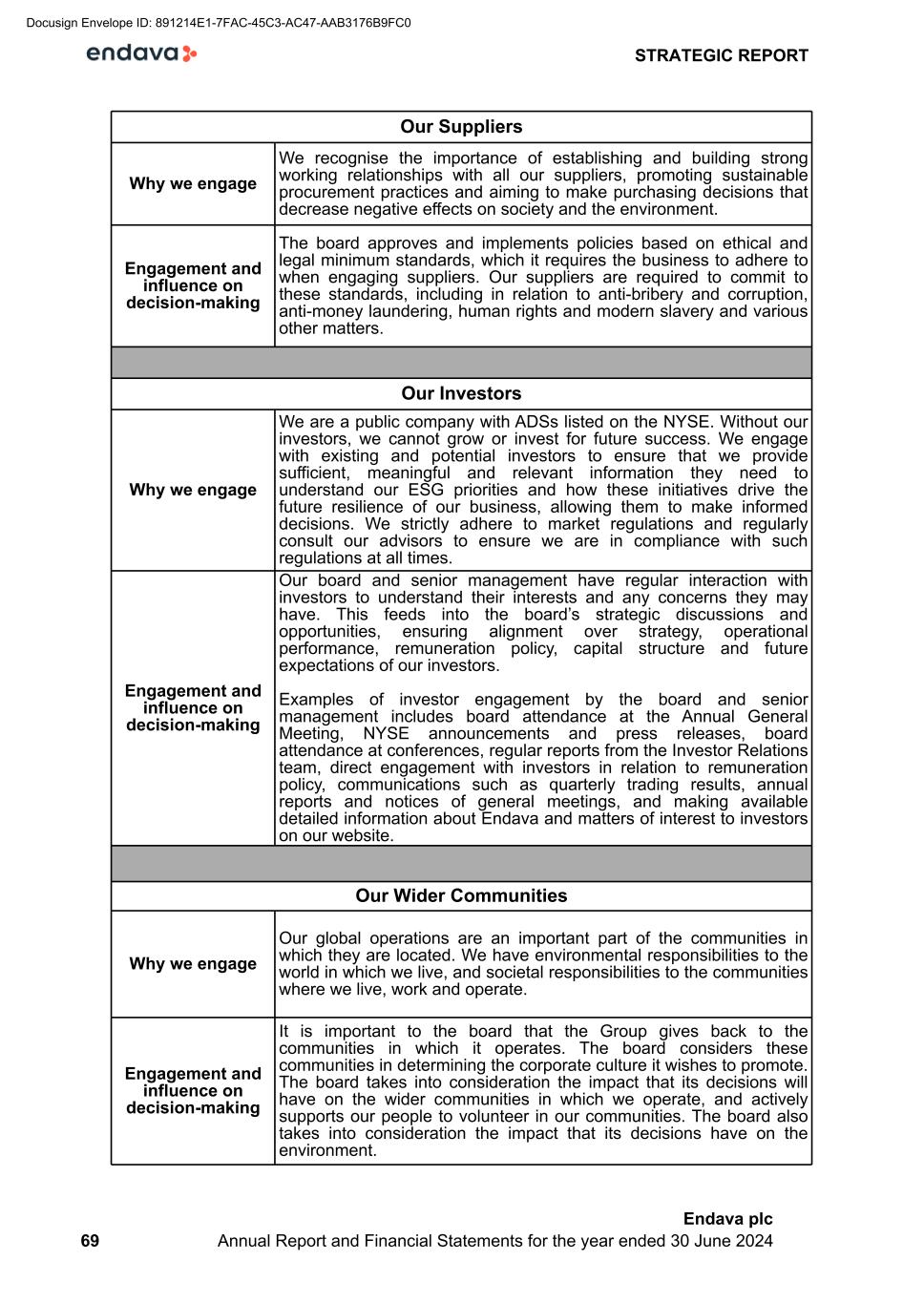
Our Suppliers Why we engage We recognise the importance of establishing and building strong working relationships with all our suppliers, promoting sustainable procurement practices and aiming to make purchasing decisions that decrease negative effects on society and the environment. Engagement and influence on decision-making The board approves and implements policies based on ethical and legal minimum standards, which it requires the business to adhere to when engaging suppliers. Our suppliers are required to commit to these standards, including in relation to anti-bribery and corruption, anti-money laundering, human rights and modern slavery and various other matters. Our Investors Why we engage We are a public company with ADSs listed on the NYSE. Without our investors, we cannot grow or invest for future success. We engage with existing and potential investors to ensure that we provide sufficient, meaningful and relevant information they need to understand our ESG priorities and how these initiatives drive the future resilience of our business, allowing them to make informed decisions. We strictly adhere to market regulations and regularly consult our advisors to ensure we are in compliance with such regulations at all times. Engagement and influence on decision-making Our board and senior management have regular interaction with investors to understand their interests and any concerns they may have. This feeds into the board’s strategic discussions and opportunities, ensuring alignment over strategy, operational performance, remuneration policy, capital structure and future expectations of our investors. Examples of investor engagement by the board and senior management includes board attendance at the Annual General Meeting, NYSE announcements and press releases, board attendance at conferences, regular reports from the Investor Relations team, direct engagement with investors in relation to remuneration policy, communications such as quarterly trading results, annual reports and notices of general meetings, and making available detailed information about Endava and matters of interest to investors on our website. Our Wider Communities Why we engage Our global operations are an important part of the communities in which they are located. We have environmental responsibilities to the world in which we live, and societal responsibilities to the communities where we live, work and operate. Engagement and influence on decision-making It is important to the board that the Group gives back to the communities in which it operates. The board considers these communities in determining the corporate culture it wishes to promote. The board takes into consideration the impact that its decisions will have on the wider communities in which we operate, and actively supports our people to volunteer in our communities. The board also takes into consideration the impact that its decisions have on the environment. STRATEGIC REPORT 69 Endava plc Annual Report and Financial Statements for the year ended 30 June 2024 Docusign Envelope ID: 891214E1-7FAC-45C3-AC47-AAB3176B9FC0
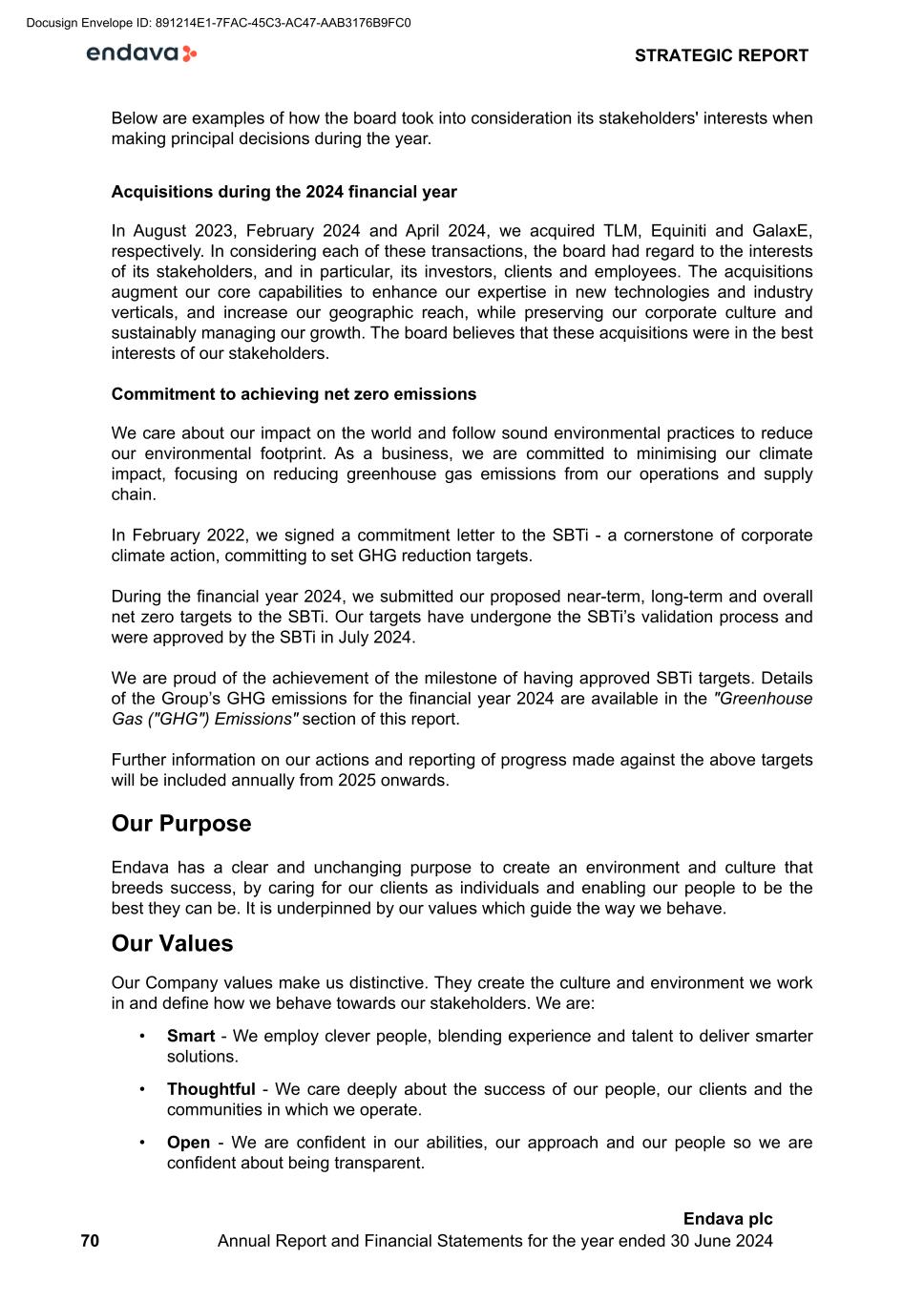
Below are examples of how the board took into consideration its stakeholders' interests when making principal decisions during the year. Acquisitions during the 2024 financial year In August 2023, February 2024 and April 2024, we acquired TLM, Equiniti and GalaxE, respectively. In considering each of these transactions, the board had regard to the interests of its stakeholders, and in particular, its investors, clients and employees. The acquisitions augment our core capabilities to enhance our expertise in new technologies and industry verticals, and increase our geographic reach, while preserving our corporate culture and sustainably managing our growth. The board believes that these acquisitions were in the best interests of our stakeholders. Commitment to achieving net zero emissions We care about our impact on the world and follow sound environmental practices to reduce our environmental footprint. As a business, we are committed to minimising our climate impact, focusing on reducing greenhouse gas emissions from our operations and supply chain. In February 2022, we signed a commitment letter to the SBTi - a cornerstone of corporate climate action, committing to set GHG reduction targets. During the financial year 2024, we submitted our proposed near-term, long-term and overall net zero targets to the SBTi. Our targets have undergone the SBTi’s validation process and were approved by the SBTi in July 2024. We are proud of the achievement of the milestone of having approved SBTi targets. Details of the Group’s GHG emissions for the financial year 2024 are available in the "Greenhouse Gas ("GHG") Emissions" section of this report. Further information on our actions and reporting of progress made against the above targets will be included annually from 2025 onwards. Our Purpose Endava has a clear and unchanging purpose to create an environment and culture that breeds success, by caring for our clients as individuals and enabling our people to be the best they can be. It is underpinned by our values which guide the way we behave. Our Values Our Company values make us distinctive. They create the culture and environment we work in and define how we behave towards our stakeholders. We are: • Smart - We employ clever people, blending experience and talent to deliver smarter solutions. • Thoughtful - We care deeply about the success of our people, our clients and the communities in which we operate. • Open - We are confident in our abilities, our approach and our people so we are confident about being transparent. STRATEGIC REPORT 70 Endava plc Annual Report and Financial Statements for the year ended 30 June 2024 Docusign Envelope ID: 891214E1-7FAC-45C3-AC47-AAB3176B9FC0
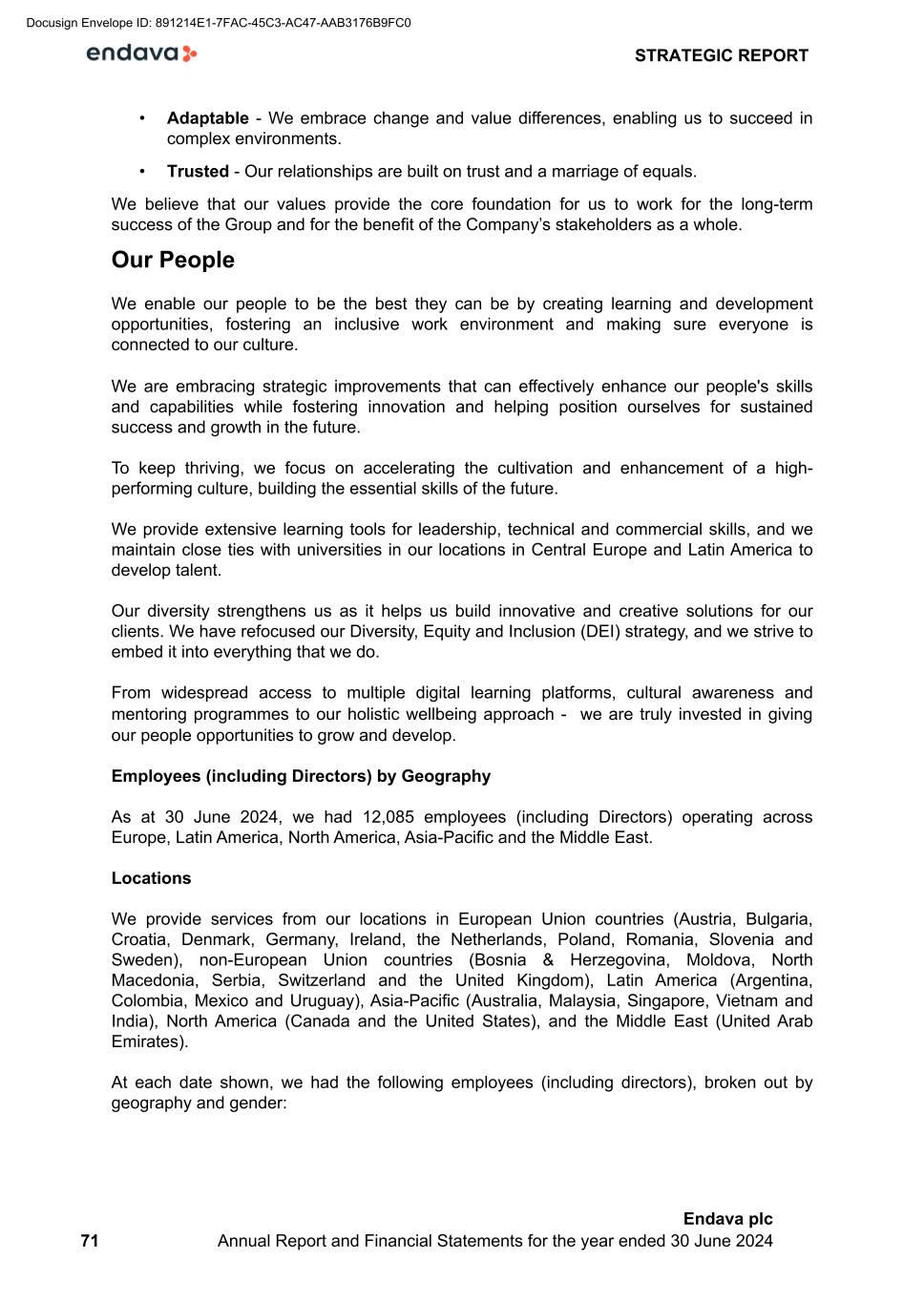
• Adaptable - We embrace change and value differences, enabling us to succeed in complex environments. • Trusted - Our relationships are built on trust and a marriage of equals. We believe that our values provide the core foundation for us to work for the long-term success of the Group and for the benefit of the Company’s stakeholders as a whole. Our People We enable our people to be the best they can be by creating learning and development opportunities, fostering an inclusive work environment and making sure everyone is connected to our culture. We are embracing strategic improvements that can effectively enhance our people's skills and capabilities while fostering innovation and helping position ourselves for sustained success and growth in the future. To keep thriving, we focus on accelerating the cultivation and enhancement of a high- performing culture, building the essential skills of the future. We provide extensive learning tools for leadership, technical and commercial skills, and we maintain close ties with universities in our locations in Central Europe and Latin America to develop talent. Our diversity strengthens us as it helps us build innovative and creative solutions for our clients. We have refocused our Diversity, Equity and Inclusion (DEI) strategy, and we strive to embed it into everything that we do. From widespread access to multiple digital learning platforms, cultural awareness and mentoring programmes to our holistic wellbeing approach - we are truly invested in giving our people opportunities to grow and develop. Employees (including Directors) by Geography As at 30 June 2024, we had 12,085 employees (including Directors) operating across Europe, Latin America, North America, Asia-Pacific and the Middle East. Locations We provide services from our locations in European Union countries (Austria, Bulgaria, Croatia, Denmark, Germany, Ireland, the Netherlands, Poland, Romania, Slovenia and Sweden), non-European Union countries (Bosnia & Herzegovina, Moldova, North Macedonia, Serbia, Switzerland and the United Kingdom), Latin America (Argentina, Colombia, Mexico and Uruguay), Asia-Pacific (Australia, Malaysia, Singapore, Vietnam and India), North America (Canada and the United States), and the Middle East (United Arab Emirates). At each date shown, we had the following employees (including directors), broken out by geography and gender: STRATEGIC REPORT 71 Endava plc Annual Report and Financial Statements for the year ended 30 June 2024 Docusign Envelope ID: 891214E1-7FAC-45C3-AC47-AAB3176B9FC0
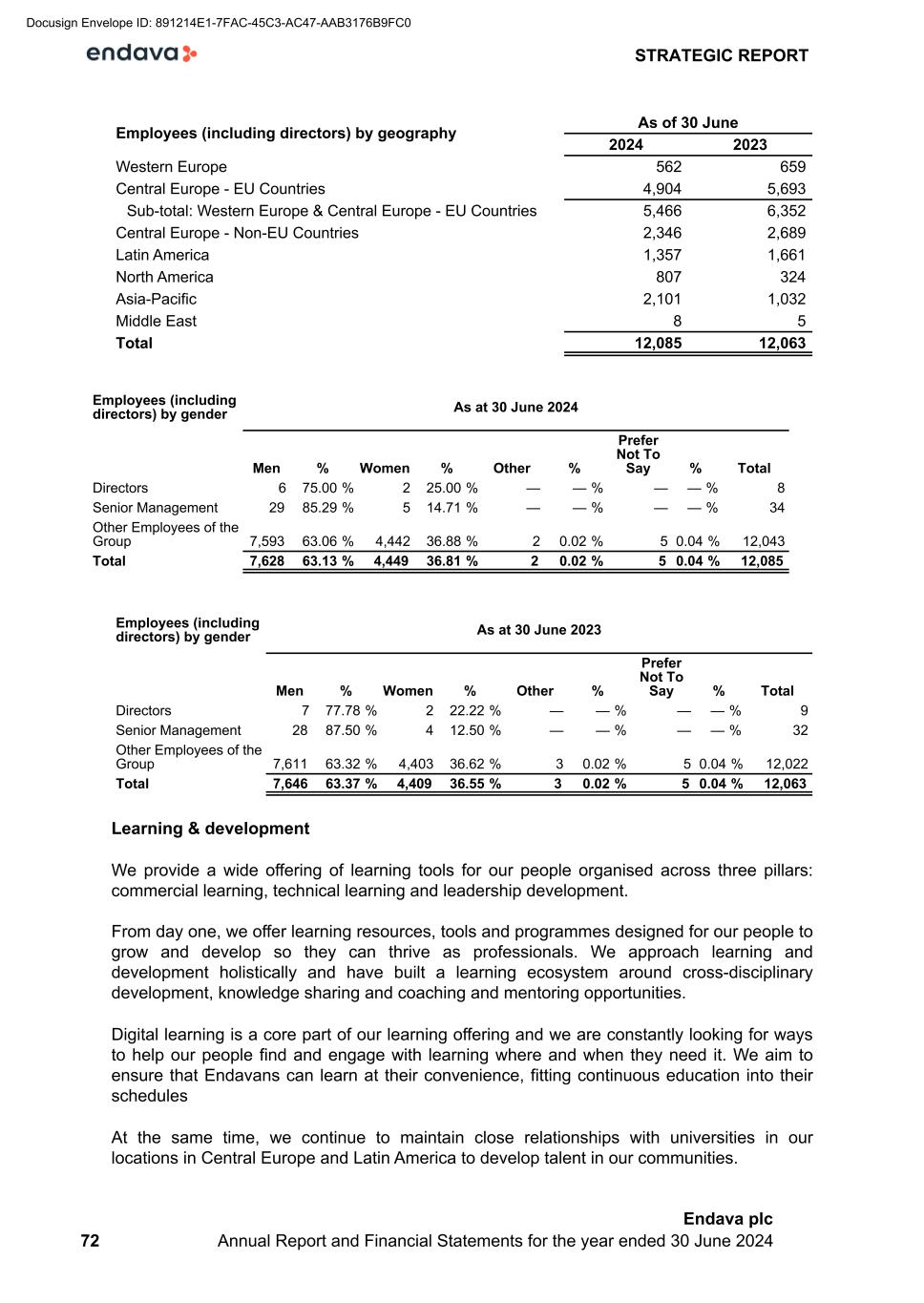
Employees (including directors) by geography As of 30 June 2024 2023 Western Europe 562 659 Central Europe - EU Countries 4,904 5,693 Sub-total: Western Europe & Central Europe - EU Countries 5,466 6,352 Central Europe - Non-EU Countries 2,346 2,689 Latin America 1,357 1,661 North America 807 324 Asia-Pacific 2,101 1,032 Middle East 8 5 Total 12,085 12,063 Employees (including directors) by gender As at 30 June 2024 Men % Women % Other % Prefer Not To Say % Total Directors 6 75.00 % 2 25.00 % — — % — — % 8 Senior Management 29 85.29 % 5 14.71 % — — % — — % 34 Other Employees of the Group 7,593 63.06 % 4,442 36.88 % 2 0.02 % 5 0.04 % 12,043 Total 7,628 63.13 % 4,449 36.81 % 2 0.02 % 5 0.04 % 12,085 Employees (including directors) by gender As at 30 June 2023 Men % Women % Other % Prefer Not To Say % Total Directors 7 77.78 % 2 22.22 % — — % — — % 9 Senior Management 28 87.50 % 4 12.50 % — — % — — % 32 Other Employees of the Group 7,611 63.32 % 4,403 36.62 % 3 0.02 % 5 0.04 % 12,022 Total 7,646 63.37 % 4,409 36.55 % 3 0.02 % 5 0.04 % 12,063 Learning & development We provide a wide offering of learning tools for our people organised across three pillars: commercial learning, technical learning and leadership development. From day one, we offer learning resources, tools and programmes designed for our people to grow and develop so they can thrive as professionals. We approach learning and development holistically and have built a learning ecosystem around cross-disciplinary development, knowledge sharing and coaching and mentoring opportunities. Digital learning is a core part of our learning offering and we are constantly looking for ways to help our people find and engage with learning where and when they need it. We aim to ensure that Endavans can learn at their convenience, fitting continuous education into their schedules At the same time, we continue to maintain close relationships with universities in our locations in Central Europe and Latin America to develop talent in our communities. STRATEGIC REPORT 72 Endava plc Annual Report and Financial Statements for the year ended 30 June 2024 Docusign Envelope ID: 891214E1-7FAC-45C3-AC47-AAB3176B9FC0

One Endava Leadership is our comprehensive approach to building a unified programme for developing leadership skills and competencies across our organisation. We piloted this programme with our senior leadership team and plan to refine it based on their feedback. With the assistance of learning and organisation development specialists, we plan to offer the programme to all our Endavans in the coming years. Diversity, Equity and Inclusion Our vision is to have an inclusive and diverse community where all our people are respected and empowered to be the best that they can be so that we can build high-performing, thriving teams who create innovative solutions for our clients and the communities where we live and work. We implement this vision through our new Diversity, Equity and Inclusion (DEI) strategy that aligns with our Endava purpose and values and embeds DEI into everything that we do. Our strategy is centred around four key pillars: inclusive culture, workplace diversity, policies & procedures and leadership & accountability. • Inclusive culture: We cultivate an inclusive and safe workplace that builds a high- performance culture and maximises the talent, skills and diversity of our people. • Workplace diversity: We identify, attract and retain diverse talent at all levels of the organisation and help our people progress in their careers. • Policies & procedures: We drive equity and break down systemic barriers by embedding DEI into our policies, practices and the entire employee lifecycle. • Leadership & accountability: We equip our managers and leaders with the right tools and resources to lead the way and hold everyone accountable for a sustainable and inclusive culture. Well-being This year marks the fourth year of Endava Well-being, a holistic programme with a simple goal: to support Endavans and their families to be physically, emotionally and mentally well, keeping them connected worldwide. In September 2023, we introduced a new series of interactive workshops and monthly masterclasses focusing on 25 key wellness topics. We also launched Well-being Bites, quick 5-minute bite-sized resources, and Well-being Retreats, immersive and experiential wellness sessions designed to help Endavans unwind during a busy day. To further support mental health, our 20 Endava Well-being Champions, located worldwide, are on hand to guide colleagues through the mental health support options and resources available within Endava. Integrity and ethics We expect all Endavans to behave ethically, honestly and fairly. We have a people-centric culture based on our core value of trust. Our Code of Business Conduct and Ethics (‘Code of Conduct’) is rooted in our values and provides a framework for conducting ourselves at work. STRATEGIC REPORT 73 Endava plc Annual Report and Financial Statements for the year ended 30 June 2024 Docusign Envelope ID: 891214E1-7FAC-45C3-AC47-AAB3176B9FC0
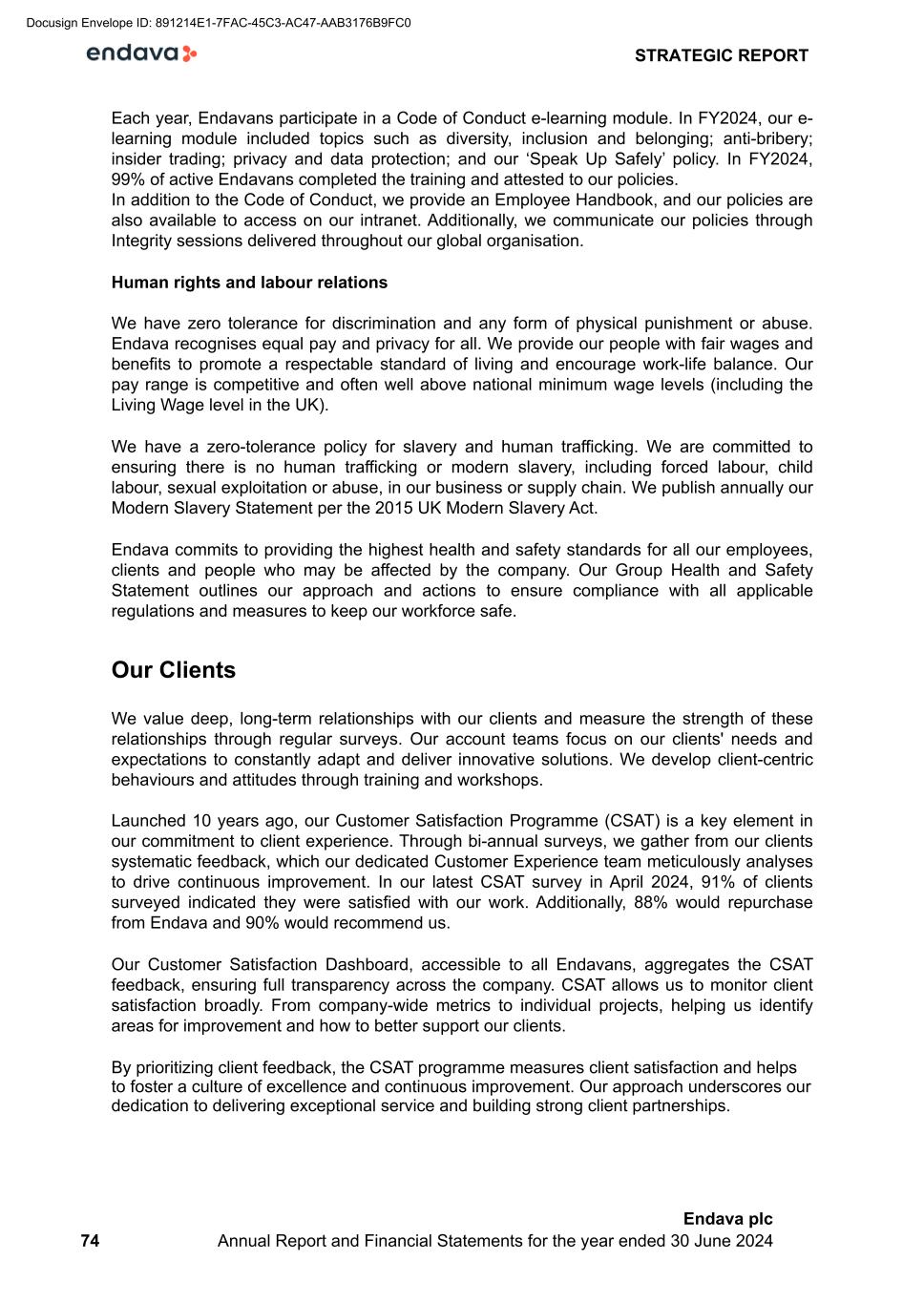
Each year, Endavans participate in a Code of Conduct e-learning module. In FY2024, our e- learning module included topics such as diversity, inclusion and belonging; anti-bribery; insider trading; privacy and data protection; and our ‘Speak Up Safely’ policy. In FY2024, 99% of active Endavans completed the training and attested to our policies. In addition to the Code of Conduct, we provide an Employee Handbook, and our policies are also available to access on our intranet. Additionally, we communicate our policies through Integrity sessions delivered throughout our global organisation. Human rights and labour relations We have zero tolerance for discrimination and any form of physical punishment or abuse. Endava recognises equal pay and privacy for all. We provide our people with fair wages and benefits to promote a respectable standard of living and encourage work-life balance. Our pay range is competitive and often well above national minimum wage levels (including the Living Wage level in the UK). We have a zero-tolerance policy for slavery and human trafficking. We are committed to ensuring there is no human trafficking or modern slavery, including forced labour, child labour, sexual exploitation or abuse, in our business or supply chain. We publish annually our Modern Slavery Statement per the 2015 UK Modern Slavery Act. Endava commits to providing the highest health and safety standards for all our employees, clients and people who may be affected by the company. Our Group Health and Safety Statement outlines our approach and actions to ensure compliance with all applicable regulations and measures to keep our workforce safe. Our Clients We value deep, long-term relationships with our clients and measure the strength of these relationships through regular surveys. Our account teams focus on our clients' needs and expectations to constantly adapt and deliver innovative solutions. We develop client-centric behaviours and attitudes through training and workshops. Launched 10 years ago, our Customer Satisfaction Programme (CSAT) is a key element in our commitment to client experience. Through bi-annual surveys, we gather from our clients systematic feedback, which our dedicated Customer Experience team meticulously analyses to drive continuous improvement. In our latest CSAT survey in April 2024, 91% of clients surveyed indicated they were satisfied with our work. Additionally, 88% would repurchase from Endava and 90% would recommend us. Our Customer Satisfaction Dashboard, accessible to all Endavans, aggregates the CSAT feedback, ensuring full transparency across the company. CSAT allows us to monitor client satisfaction broadly. From company-wide metrics to individual projects, helping us identify areas for improvement and how to better support our clients. By prioritizing client feedback, the CSAT programme measures client satisfaction and helps to foster a culture of excellence and continuous improvement. Our approach underscores our dedication to delivering exceptional service and building strong client partnerships. STRATEGIC REPORT 74 Endava plc Annual Report and Financial Statements for the year ended 30 June 2024 Docusign Envelope ID: 891214E1-7FAC-45C3-AC47-AAB3176B9FC0
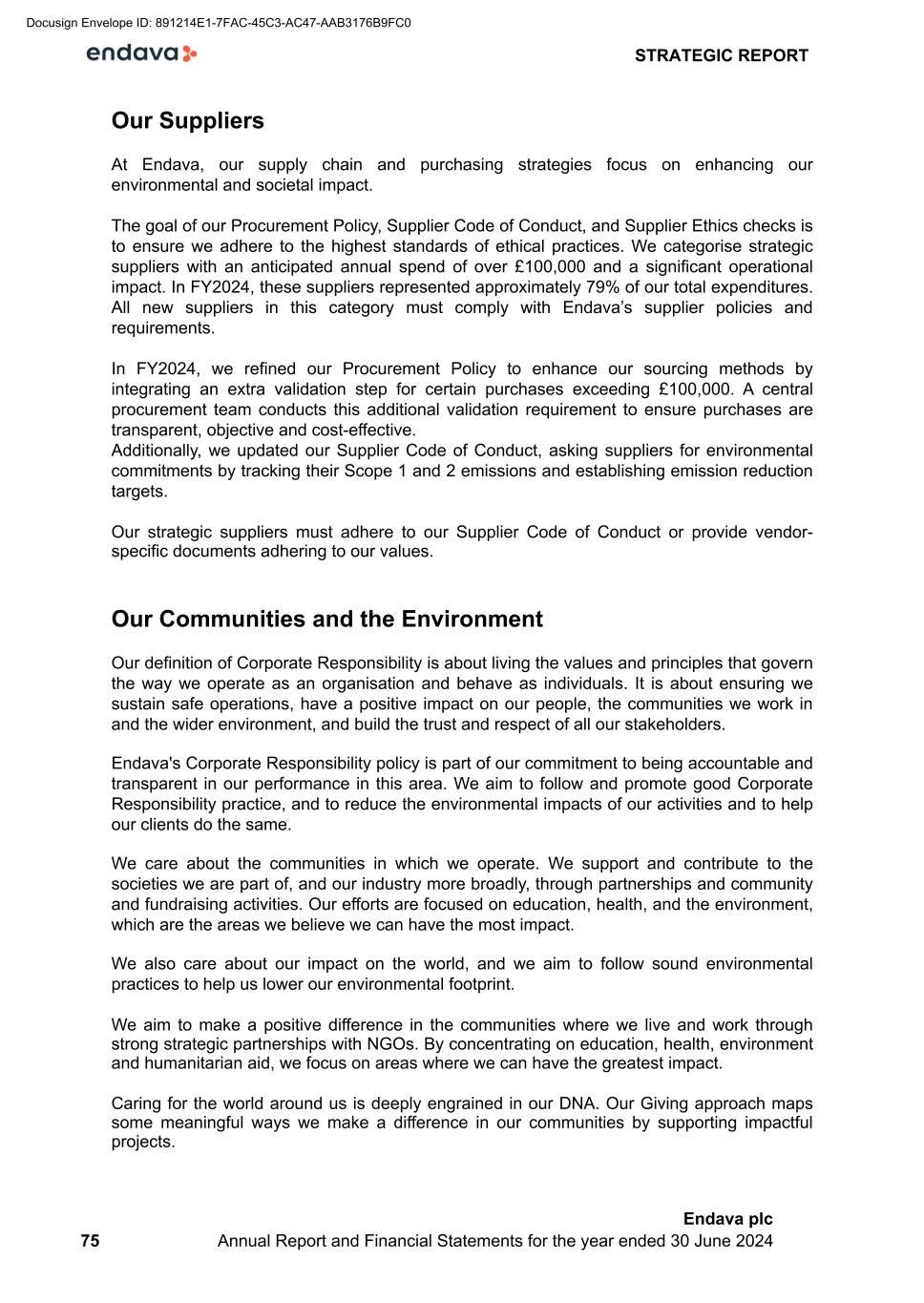
Our Suppliers At Endava, our supply chain and purchasing strategies focus on enhancing our environmental and societal impact. The goal of our Procurement Policy, Supplier Code of Conduct, and Supplier Ethics checks is to ensure we adhere to the highest standards of ethical practices. We categorise strategic suppliers with an anticipated annual spend of over £100,000 and a significant operational impact. In FY2024, these suppliers represented approximately 79% of our total expenditures. All new suppliers in this category must comply with Endava’s supplier policies and requirements. In FY2024, we refined our Procurement Policy to enhance our sourcing methods by integrating an extra validation step for certain purchases exceeding £100,000. A central procurement team conducts this additional validation requirement to ensure purchases are transparent, objective and cost-effective. Additionally, we updated our Supplier Code of Conduct, asking suppliers for environmental commitments by tracking their Scope 1 and 2 emissions and establishing emission reduction targets. Our strategic suppliers must adhere to our Supplier Code of Conduct or provide vendor- specific documents adhering to our values. Our Communities and the Environment Our definition of Corporate Responsibility is about living the values and principles that govern the way we operate as an organisation and behave as individuals. It is about ensuring we sustain safe operations, have a positive impact on our people, the communities we work in and the wider environment, and build the trust and respect of all our stakeholders. Endava's Corporate Responsibility policy is part of our commitment to being accountable and transparent in our performance in this area. We aim to follow and promote good Corporate Responsibility practice, and to reduce the environmental impacts of our activities and to help our clients do the same. We care about the communities in which we operate. We support and contribute to the societies we are part of, and our industry more broadly, through partnerships and community and fundraising activities. Our efforts are focused on education, health, and the environment, which are the areas we believe we can have the most impact. We also care about our impact on the world, and we aim to follow sound environmental practices to help us lower our environmental footprint. We aim to make a positive difference in the communities where we live and work through strong strategic partnerships with NGOs. By concentrating on education, health, environment and humanitarian aid, we focus on areas where we can have the greatest impact. Caring for the world around us is deeply engrained in our DNA. Our Giving approach maps some meaningful ways we make a difference in our communities by supporting impactful projects. STRATEGIC REPORT 75 Endava plc Annual Report and Financial Statements for the year ended 30 June 2024 Docusign Envelope ID: 891214E1-7FAC-45C3-AC47-AAB3176B9FC0
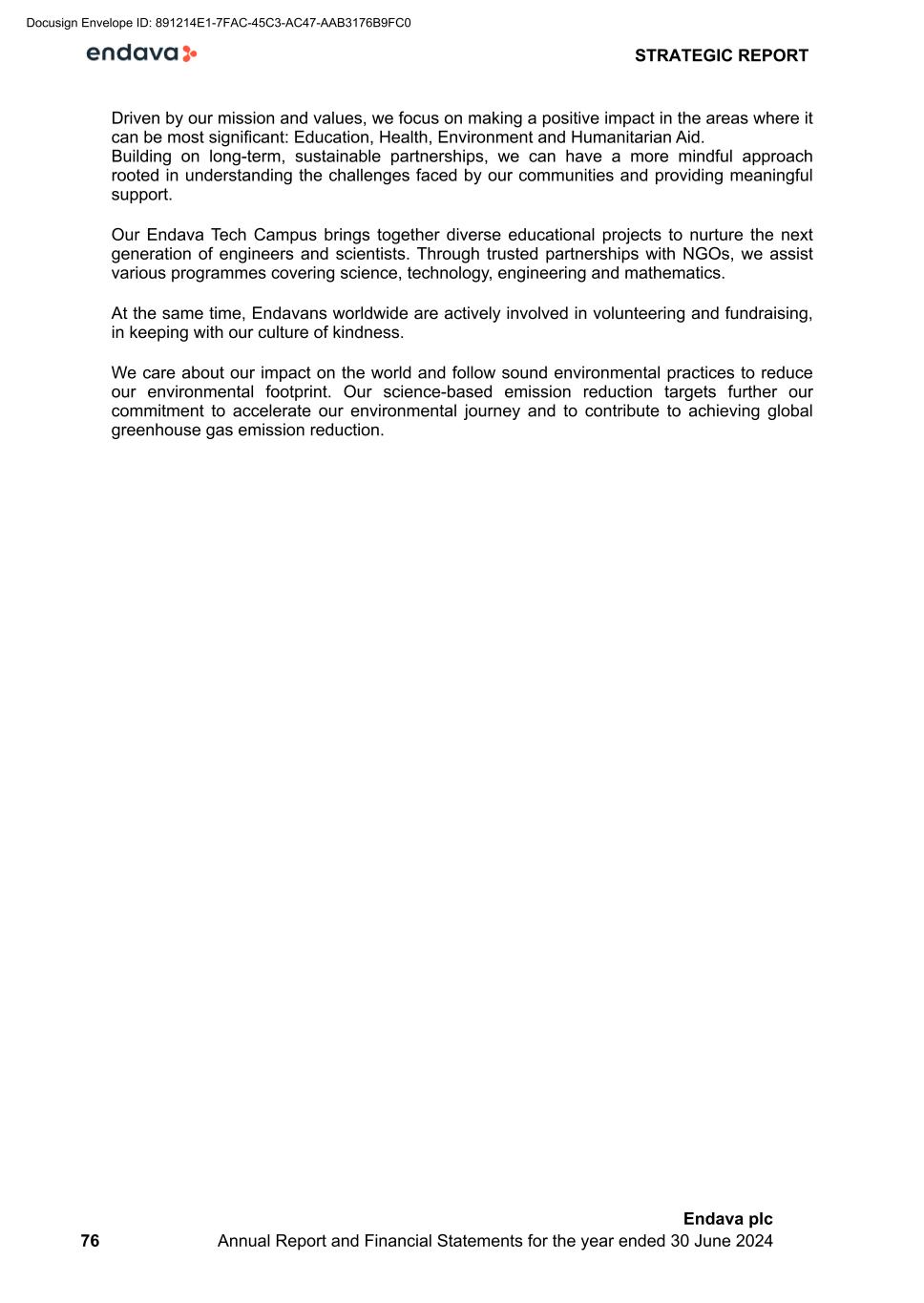
Driven by our mission and values, we focus on making a positive impact in the areas where it can be most significant: Education, Health, Environment and Humanitarian Aid. Building on long-term, sustainable partnerships, we can have a more mindful approach rooted in understanding the challenges faced by our communities and providing meaningful support. Our Endava Tech Campus brings together diverse educational projects to nurture the next generation of engineers and scientists. Through trusted partnerships with NGOs, we assist various programmes covering science, technology, engineering and mathematics. At the same time, Endavans worldwide are actively involved in volunteering and fundraising, in keeping with our culture of kindness. We care about our impact on the world and follow sound environmental practices to reduce our environmental footprint. Our science-based emission reduction targets further our commitment to accelerate our environmental journey and to contribute to achieving global greenhouse gas emission reduction. STRATEGIC REPORT 76 Endava plc Annual Report and Financial Statements for the year ended 30 June 2024 Docusign Envelope ID: 891214E1-7FAC-45C3-AC47-AAB3176B9FC0
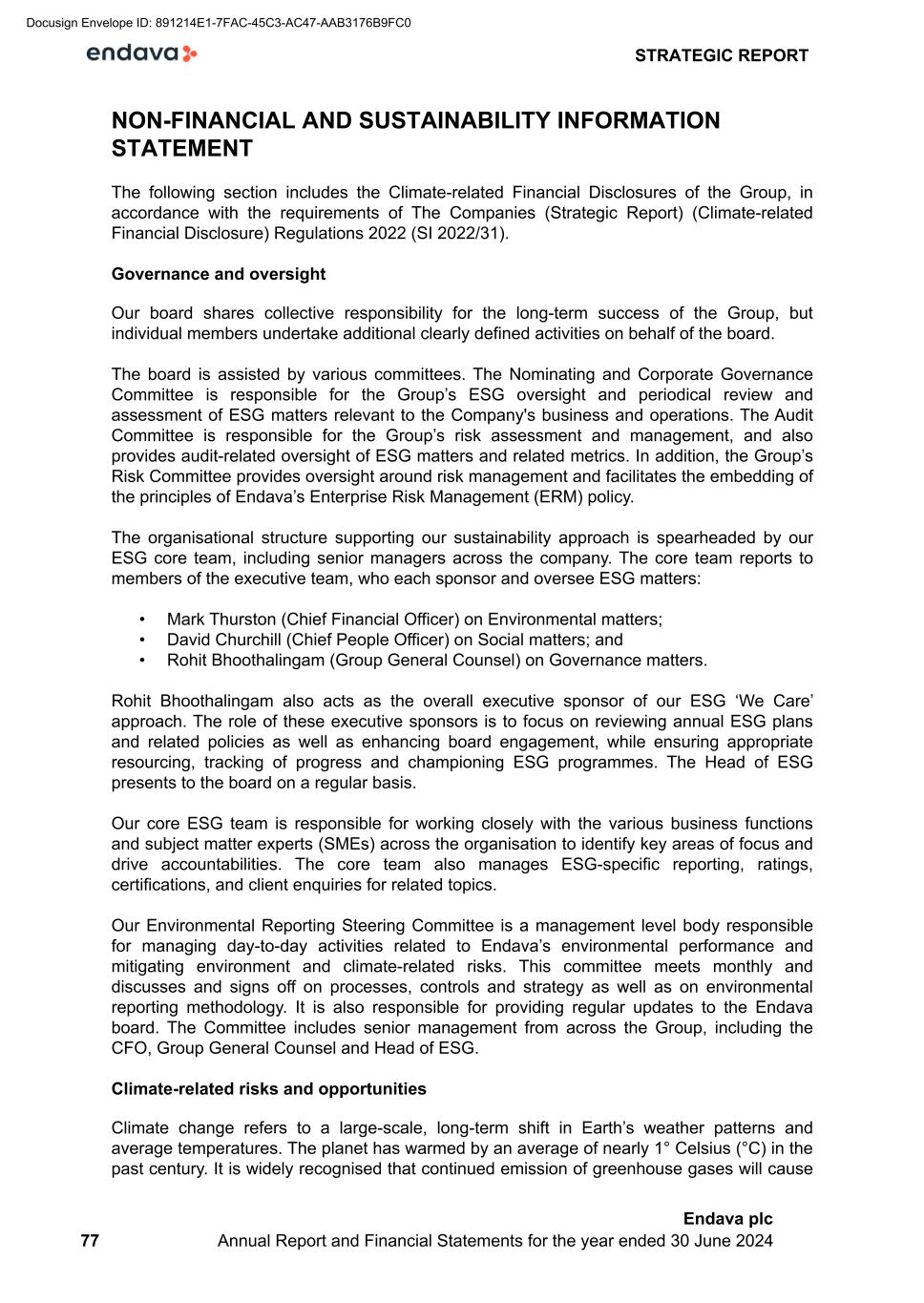
NON-FINANCIAL AND SUSTAINABILITY INFORMATION STATEMENT The following section includes the Climate-related Financial Disclosures of the Group, in accordance with the requirements of The Companies (Strategic Report) (Climate-related Financial Disclosure) Regulations 2022 (SI 2022/31). Governance and oversight Our board shares collective responsibility for the long-term success of the Group, but individual members undertake additional clearly defined activities on behalf of the board. The board is assisted by various committees. The Nominating and Corporate Governance Committee is responsible for the Group’s ESG oversight and periodical review and assessment of ESG matters relevant to the Company's business and operations. The Audit Committee is responsible for the Group’s risk assessment and management, and also provides audit-related oversight of ESG matters and related metrics. In addition, the Group’s Risk Committee provides oversight around risk management and facilitates the embedding of the principles of Endava’s Enterprise Risk Management (ERM) policy. The organisational structure supporting our sustainability approach is spearheaded by our ESG core team, including senior managers across the company. The core team reports to members of the executive team, who each sponsor and oversee ESG matters: • Mark Thurston (Chief Financial Officer) on Environmental matters; • David Churchill (Chief People Officer) on Social matters; and • Rohit Bhoothalingam (Group General Counsel) on Governance matters. Rohit Bhoothalingam also acts as the overall executive sponsor of our ESG ‘We Care’ approach. The role of these executive sponsors is to focus on reviewing annual ESG plans and related policies as well as enhancing board engagement, while ensuring appropriate resourcing, tracking of progress and championing ESG programmes. The Head of ESG presents to the board on a regular basis. Our core ESG team is responsible for working closely with the various business functions and subject matter experts (SMEs) across the organisation to identify key areas of focus and drive accountabilities. The core team also manages ESG-specific reporting, ratings, certifications, and client enquiries for related topics. Our Environmental Reporting Steering Committee is a management level body responsible for managing day-to-day activities related to Endava’s environmental performance and mitigating environment and climate-related risks. This committee meets monthly and discusses and signs off on processes, controls and strategy as well as on environmental reporting methodology. It is also responsible for providing regular updates to the Endava board. The Committee includes senior management from across the Group, including the CFO, Group General Counsel and Head of ESG. Climate-related risks and opportunities Climate change refers to a large-scale, long-term shift in Earth’s weather patterns and average temperatures. The planet has warmed by an average of nearly 1° Celsius (°C) in the past century. It is widely recognised that continued emission of greenhouse gases will cause STRATEGIC REPORT 77 Endava plc Annual Report and Financial Statements for the year ended 30 June 2024 Docusign Envelope ID: 891214E1-7FAC-45C3-AC47-AAB3176B9FC0
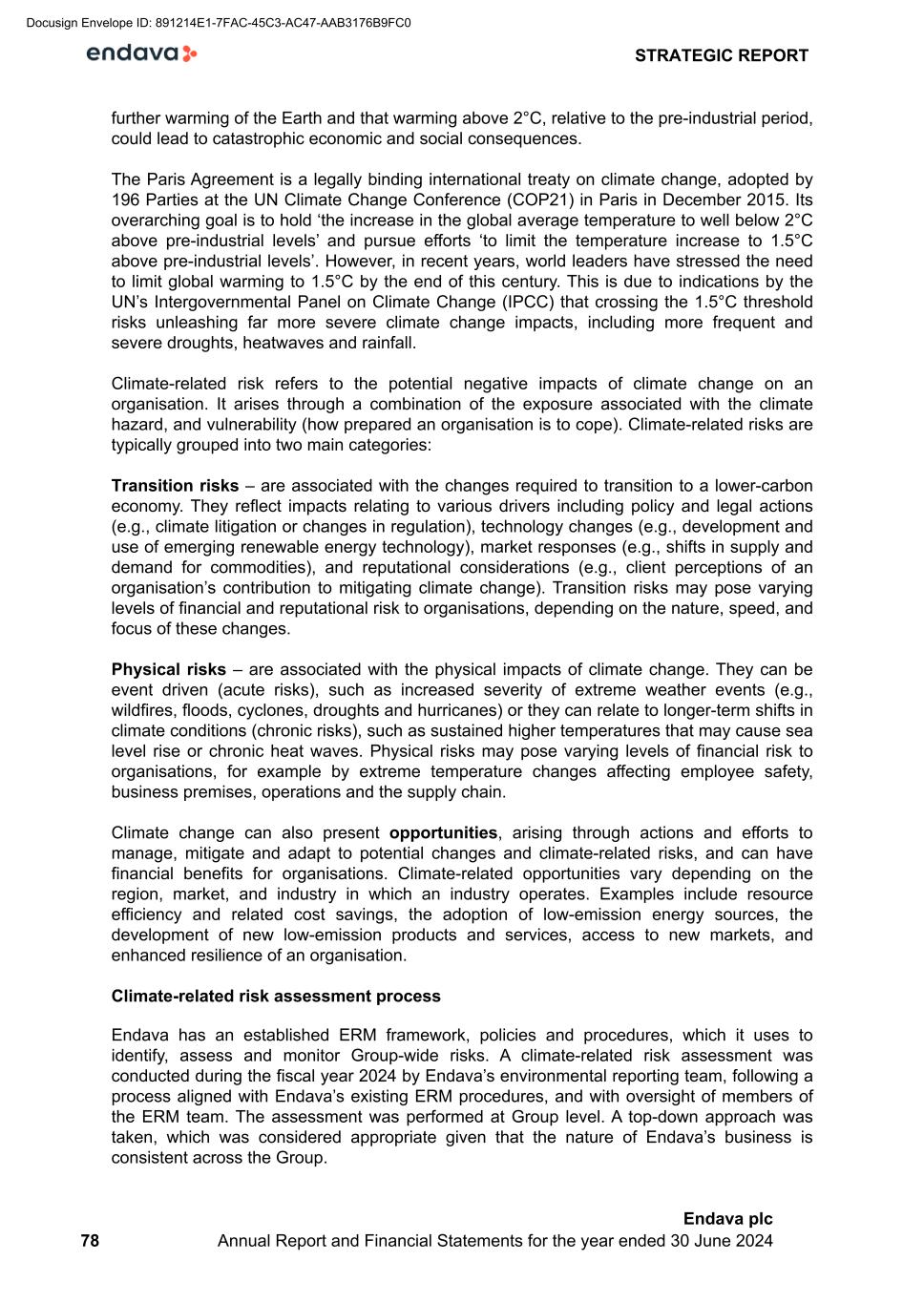
further warming of the Earth and that warming above 2°C, relative to the pre-industrial period, could lead to catastrophic economic and social consequences. The Paris Agreement is a legally binding international treaty on climate change, adopted by 196 Parties at the UN Climate Change Conference (COP21) in Paris in December 2015. Its overarching goal is to hold ‘the increase in the global average temperature to well below 2°C above pre-industrial levels’ and pursue efforts ‘to limit the temperature increase to 1.5°C above pre-industrial levels’. However, in recent years, world leaders have stressed the need to limit global warming to 1.5°C by the end of this century. This is due to indications by the UN’s Intergovernmental Panel on Climate Change (IPCC) that crossing the 1.5°C threshold risks unleashing far more severe climate change impacts, including more frequent and severe droughts, heatwaves and rainfall. Climate-related risk refers to the potential negative impacts of climate change on an organisation. It arises through a combination of the exposure associated with the climate hazard, and vulnerability (how prepared an organisation is to cope). Climate-related risks are typically grouped into two main categories: Transition risks – are associated with the changes required to transition to a lower-carbon economy. They reflect impacts relating to various drivers including policy and legal actions (e.g., climate litigation or changes in regulation), technology changes (e.g., development and use of emerging renewable energy technology), market responses (e.g., shifts in supply and demand for commodities), and reputational considerations (e.g., client perceptions of an organisation’s contribution to mitigating climate change). Transition risks may pose varying levels of financial and reputational risk to organisations, depending on the nature, speed, and focus of these changes. Physical risks – are associated with the physical impacts of climate change. They can be event driven (acute risks), such as increased severity of extreme weather events (e.g., wildfires, floods, cyclones, droughts and hurricanes) or they can relate to longer-term shifts in climate conditions (chronic risks), such as sustained higher temperatures that may cause sea level rise or chronic heat waves. Physical risks may pose varying levels of financial risk to organisations, for example by extreme temperature changes affecting employee safety, business premises, operations and the supply chain. Climate change can also present opportunities, arising through actions and efforts to manage, mitigate and adapt to potential changes and climate-related risks, and can have financial benefits for organisations. Climate-related opportunities vary depending on the region, market, and industry in which an industry operates. Examples include resource efficiency and related cost savings, the adoption of low-emission energy sources, the development of new low-emission products and services, access to new markets, and enhanced resilience of an organisation. Climate-related risk assessment process Endava has an established ERM framework, policies and procedures, which it uses to identify, assess and monitor Group-wide risks. A climate-related risk assessment was conducted during the fiscal year 2024 by Endava’s environmental reporting team, following a process aligned with Endava’s existing ERM procedures, and with oversight of members of the ERM team. The assessment was performed at Group level. A top-down approach was taken, which was considered appropriate given that the nature of Endava’s business is consistent across the Group. STRATEGIC REPORT 78 Endava plc Annual Report and Financial Statements for the year ended 30 June 2024 Docusign Envelope ID: 891214E1-7FAC-45C3-AC47-AAB3176B9FC0
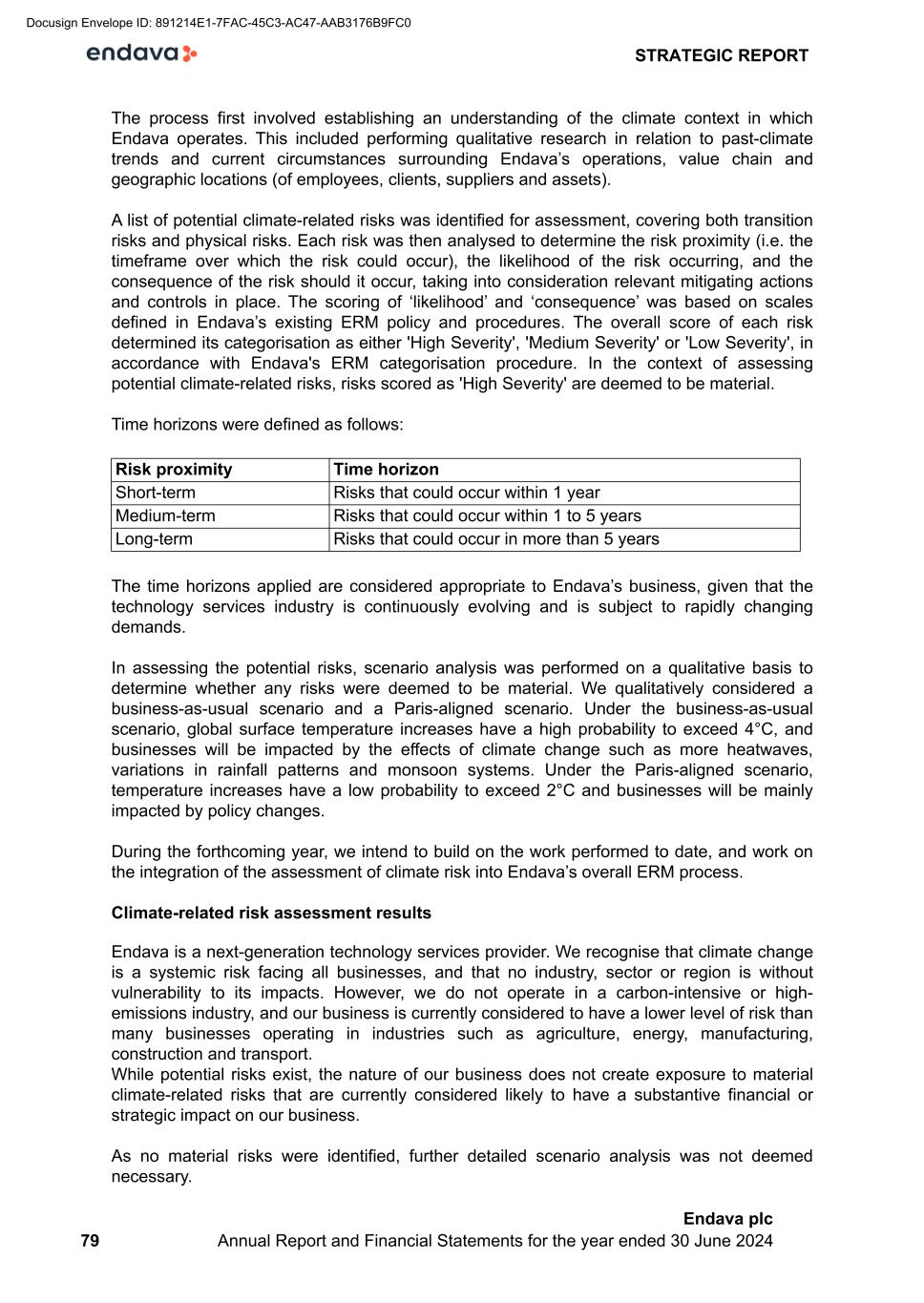
The process first involved establishing an understanding of the climate context in which Endava operates. This included performing qualitative research in relation to past-climate trends and current circumstances surrounding Endava’s operations, value chain and geographic locations (of employees, clients, suppliers and assets). A list of potential climate-related risks was identified for assessment, covering both transition risks and physical risks. Each risk was then analysed to determine the risk proximity (i.e. the timeframe over which the risk could occur), the likelihood of the risk occurring, and the consequence of the risk should it occur, taking into consideration relevant mitigating actions and controls in place. The scoring of ‘likelihood’ and ‘consequence’ was based on scales defined in Endava’s existing ERM policy and procedures. The overall score of each risk determined its categorisation as either 'High Severity', 'Medium Severity' or 'Low Severity', in accordance with Endava's ERM categorisation procedure. In the context of assessing potential climate-related risks, risks scored as 'High Severity' are deemed to be material. Time horizons were defined as follows: Risk proximity Time horizon Short-term Risks that could occur within 1 year Medium-term Risks that could occur within 1 to 5 years Long-term Risks that could occur in more than 5 years The time horizons applied are considered appropriate to Endava’s business, given that the technology services industry is continuously evolving and is subject to rapidly changing demands. In assessing the potential risks, scenario analysis was performed on a qualitative basis to determine whether any risks were deemed to be material. We qualitatively considered a business-as-usual scenario and a Paris-aligned scenario. Under the business-as-usual scenario, global surface temperature increases have a high probability to exceed 4°C, and businesses will be impacted by the effects of climate change such as more heatwaves, variations in rainfall patterns and monsoon systems. Under the Paris-aligned scenario, temperature increases have a low probability to exceed 2°C and businesses will be mainly impacted by policy changes. During the forthcoming year, we intend to build on the work performed to date, and work on the integration of the assessment of climate risk into Endava’s overall ERM process. Climate-related risk assessment results Endava is a next-generation technology services provider. We recognise that climate change is a systemic risk facing all businesses, and that no industry, sector or region is without vulnerability to its impacts. However, we do not operate in a carbon-intensive or high- emissions industry, and our business is currently considered to have a lower level of risk than many businesses operating in industries such as agriculture, energy, manufacturing, construction and transport. While potential risks exist, the nature of our business does not create exposure to material climate-related risks that are currently considered likely to have a substantive financial or strategic impact on our business. As no material risks were identified, further detailed scenario analysis was not deemed necessary. STRATEGIC REPORT 79 Endava plc Annual Report and Financial Statements for the year ended 30 June 2024 Docusign Envelope ID: 891214E1-7FAC-45C3-AC47-AAB3176B9FC0
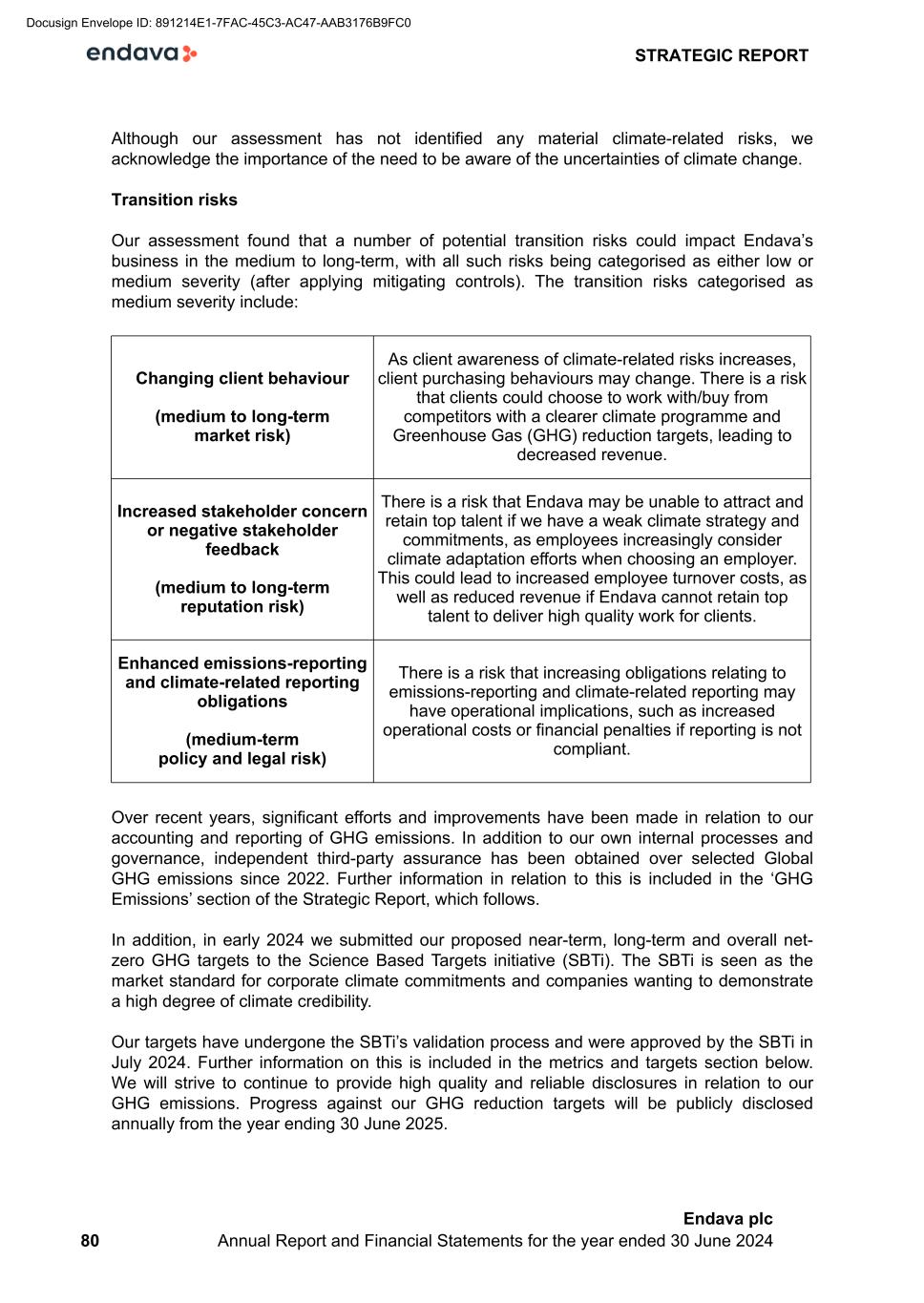
Although our assessment has not identified any material climate-related risks, we acknowledge the importance of the need to be aware of the uncertainties of climate change. Transition risks Our assessment found that a number of potential transition risks could impact Endava’s business in the medium to long-term, with all such risks being categorised as either low or medium severity (after applying mitigating controls). The transition risks categorised as medium severity include: Changing client behaviour (medium to long-term market risk) As client awareness of climate-related risks increases, client purchasing behaviours may change. There is a risk that clients could choose to work with/buy from competitors with a clearer climate programme and Greenhouse Gas (GHG) reduction targets, leading to decreased revenue. Increased stakeholder concern or negative stakeholder feedback (medium to long-term reputation risk) There is a risk that Endava may be unable to attract and retain top talent if we have a weak climate strategy and commitments, as employees increasingly consider climate adaptation efforts when choosing an employer. This could lead to increased employee turnover costs, as well as reduced revenue if Endava cannot retain top talent to deliver high quality work for clients. Enhanced emissions-reporting and climate-related reporting obligations (medium-term policy and legal risk) There is a risk that increasing obligations relating to emissions-reporting and climate-related reporting may have operational implications, such as increased operational costs or financial penalties if reporting is not compliant. Over recent years, significant efforts and improvements have been made in relation to our accounting and reporting of GHG emissions. In addition to our own internal processes and governance, independent third-party assurance has been obtained over selected Global GHG emissions since 2022. Further information in relation to this is included in the ‘GHG Emissions’ section of the Strategic Report, which follows. In addition, in early 2024 we submitted our proposed near-term, long-term and overall net- zero GHG targets to the Science Based Targets initiative (SBTi). The SBTi is seen as the market standard for corporate climate commitments and companies wanting to demonstrate a high degree of climate credibility. Our targets have undergone the SBTi’s validation process and were approved by the SBTi in July 2024. Further information on this is included in the metrics and targets section below. We will strive to continue to provide high quality and reliable disclosures in relation to our GHG emissions. Progress against our GHG reduction targets will be publicly disclosed annually from the year ending 30 June 2025. STRATEGIC REPORT 80 Endava plc Annual Report and Financial Statements for the year ended 30 June 2024 Docusign Envelope ID: 891214E1-7FAC-45C3-AC47-AAB3176B9FC0

The above actions are considered sufficient to mitigate these potential transition risks to an acceptable level. Physical risks Our people are at the heart of who we are and are the most material driver of our success as a business, working globally across 29 countries and 71 cities. The majority of our people are based across 17 countries in Europe. Asia-Pacific is our second largest region of employees by location, with people based across 5 countries. We also have people based across 7 countries in Latin America, North America and the Middle East. Climate change is impacting natural weather cycles, increasing the severity of extreme weather events, changing precipitation patterns, rising mean temperatures and sea levels. This produces a range of potential risks to our people, business, operating results and financial condition, including reduced employee well-being, health and safety risks, damage to assets, supply chain disruption, and disruption to business operations, leading to potentially reduced revenue and profits. Our assessment found that both acute and chronic physical risks could potentially impact Endava’s business in the long-term, with such risks being categorised as medium severity (after applying mitigating actions and controls). Endava has an established Group-wide Business Continuity Management System (BCMS), which is a key mechanism to restore and deliver continuity of key operations and services in the event of a disruptive incident. The Group BCMS is certified against the international standard for business continuity, ISO 22301:2019. This is considered sufficient to mitigate potential physical climate risks to an acceptable level. Climate-related opportunities Efforts to mitigate and adapt to climate change can also produce opportunities for businesses. During our assessment of climate-related risks, we have also identified potential opportunities. The main opportunities that we have currently identified relate to the progress we have made in relation to the submission and approval of our SBTi targets. Companies with SBTi targets may benefit in a number of ways, including: • Competitive advantage – companies with SBTi targets may benefit from enhanced reputation, resulting in an advantage over competitors. • Employee attraction and retention – companies with SBTi targets may benefit from increased attraction and retention of top talent. • Regulatory readiness – companies with SBTi targets are better able to respond to future regulations as governments increase climate action. • Energy and resource efficiency - reducing energy and resource consumption can lead to increased overall operating efficiency and costs savings. Metrics and targets In February 2022, we signed a commitment letter to the SBTi - a cornerstone of corporate climate action, committing to set GHG reduction targets. STRATEGIC REPORT 81 Endava plc Annual Report and Financial Statements for the year ended 30 June 2024 Docusign Envelope ID: 891214E1-7FAC-45C3-AC47-AAB3176B9FC0

As noted above, during the fiscal year 2024, we submitted our proposed near-term, long-term and overall net- zero targets to the SBTi. Our targets have undergone the SBTi’s validation process and were approved by the SBTi in July 2024. Endava plc's approved near and long-term science-based emission reduction targets are as follows: Overall Net-Zero Target • Endava plc commits to reach net-zero greenhouse gas emissions across the value chain by FY2050. Near-Term Targets • Endava plc commits to reduce absolute scope 1 and 2 GHG emissions 42% by FY2030 from a FY2023 base year. • Endava plc also commits to reduce scope 3 GHG emissions from fuel and energy- related activities and business travel 52% per full time employee (FTE) within the same timeframe. • Endava plc further commits that 64% of its suppliers by spend covering purchased goods and services and capital goods will have science-based targets by FY2028. Long-Term Targets • Endava plc commits to reduce absolute scope 1 and 2 GHG emissions 90% by FY2050 from a FY2023 base year. • Endava plc also commits to reduce scope 3 GHG emissions 97% per full time employee (FTE) within the same timeframe. We are proud of the achievement of the milestone of having approved SBTi targets. Details of the Group’s GHG emissions for the fiscal year 2024 are included in the ‘GHG Emissions’ section of the Strategic Report, which follows. Further information on our actions and reporting of progress made against the above targets will be included annually from 2025 onwards. STRATEGIC REPORT 82 Endava plc Annual Report and Financial Statements for the year ended 30 June 2024 Docusign Envelope ID: 891214E1-7FAC-45C3-AC47-AAB3176B9FC0
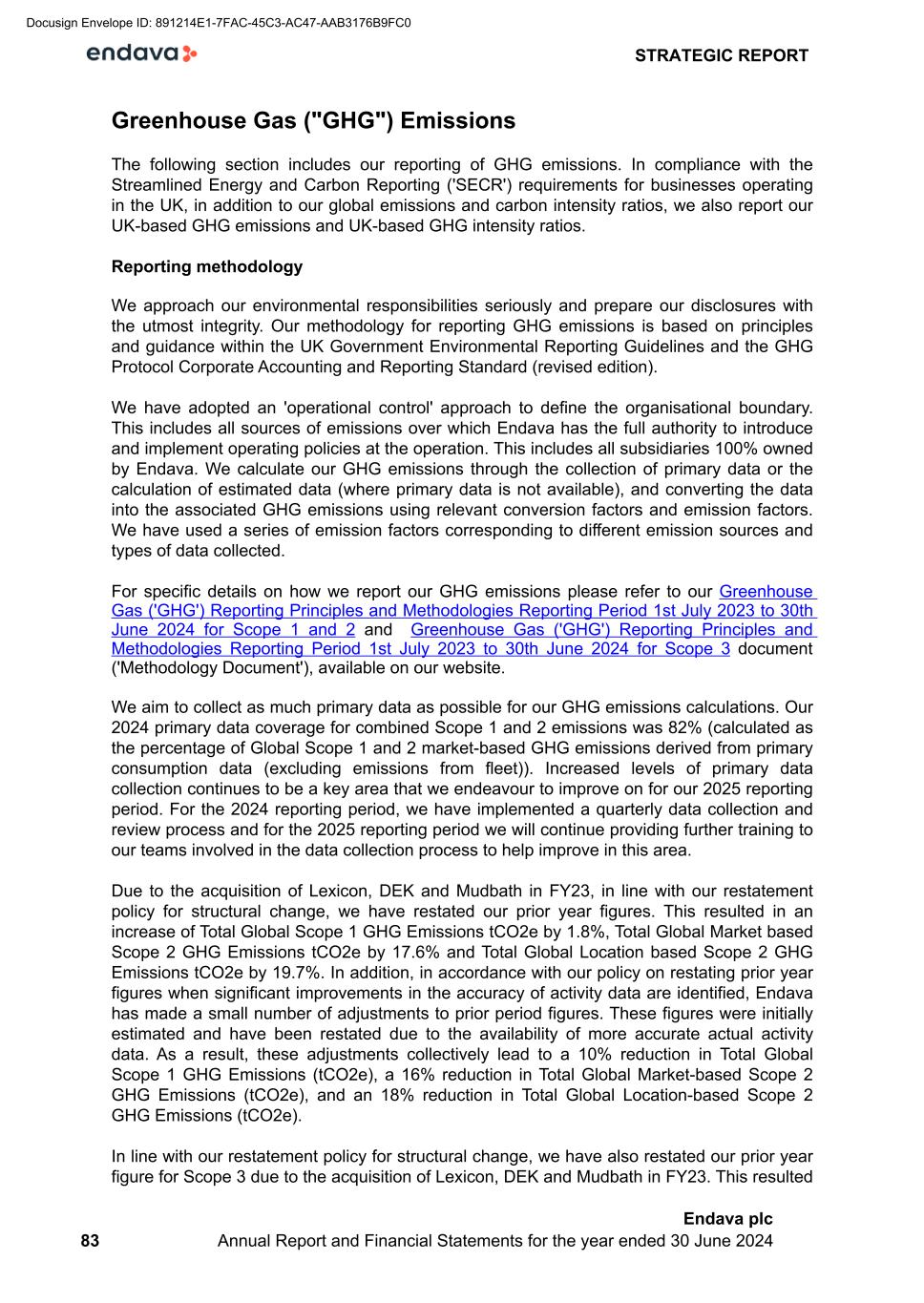
Greenhouse Gas ("GHG") Emissions The following section includes our reporting of GHG emissions. In compliance with the Streamlined Energy and Carbon Reporting ('SECR') requirements for businesses operating in the UK, in addition to our global emissions and carbon intensity ratios, we also report our UK-based GHG emissions and UK-based GHG intensity ratios. Reporting methodology We approach our environmental responsibilities seriously and prepare our disclosures with the utmost integrity. Our methodology for reporting GHG emissions is based on principles and guidance within the UK Government Environmental Reporting Guidelines and the GHG Protocol Corporate Accounting and Reporting Standard (revised edition). We have adopted an 'operational control' approach to define the organisational boundary. This includes all sources of emissions over which Endava has the full authority to introduce and implement operating policies at the operation. This includes all subsidiaries 100% owned by Endava. We calculate our GHG emissions through the collection of primary data or the calculation of estimated data (where primary data is not available), and converting the data into the associated GHG emissions using relevant conversion factors and emission factors. We have used a series of emission factors corresponding to different emission sources and types of data collected. For specific details on how we report our GHG emissions please refer to our Greenhouse Gas ('GHG') Reporting Principles and Methodologies Reporting Period 1st July 2023 to 30th June 2024 for Scope 1 and 2 and Greenhouse Gas ('GHG') Reporting Principles and Methodologies Reporting Period 1st July 2023 to 30th June 2024 for Scope 3 document ('Methodology Document'), available on our website. We aim to collect as much primary data as possible for our GHG emissions calculations. Our 2024 primary data coverage for combined Scope 1 and 2 emissions was 82% (calculated as the percentage of Global Scope 1 and 2 market-based GHG emissions derived from primary consumption data (excluding emissions from fleet)). Increased levels of primary data collection continues to be a key area that we endeavour to improve on for our 2025 reporting period. For the 2024 reporting period, we have implemented a quarterly data collection and review process and for the 2025 reporting period we will continue providing further training to our teams involved in the data collection process to help improve in this area. Due to the acquisition of Lexicon, DEK and Mudbath in FY23, in line with our restatement policy for structural change, we have restated our prior year figures. This resulted in an increase of Total Global Scope 1 GHG Emissions tCO2e by 1.8%, Total Global Market based Scope 2 GHG Emissions tCO2e by 17.6% and Total Global Location based Scope 2 GHG Emissions tCO2e by 19.7%. In addition, in accordance with our policy on restating prior year figures when significant improvements in the accuracy of activity data are identified, Endava has made a small number of adjustments to prior period figures. These figures were initially estimated and have been restated due to the availability of more accurate actual activity data. As a result, these adjustments collectively lead to a 10% reduction in Total Global Scope 1 GHG Emissions (tCO2e), a 16% reduction in Total Global Market-based Scope 2 GHG Emissions (tCO2e), and an 18% reduction in Total Global Location-based Scope 2 GHG Emissions (tCO2e). In line with our restatement policy for structural change, we have also restated our prior year figure for Scope 3 due to the acquisition of Lexicon, DEK and Mudbath in FY23. This resulted STRATEGIC REPORT 83 Endava plc Annual Report and Financial Statements for the year ended 30 June 2024 Docusign Envelope ID: 891214E1-7FAC-45C3-AC47-AAB3176B9FC0
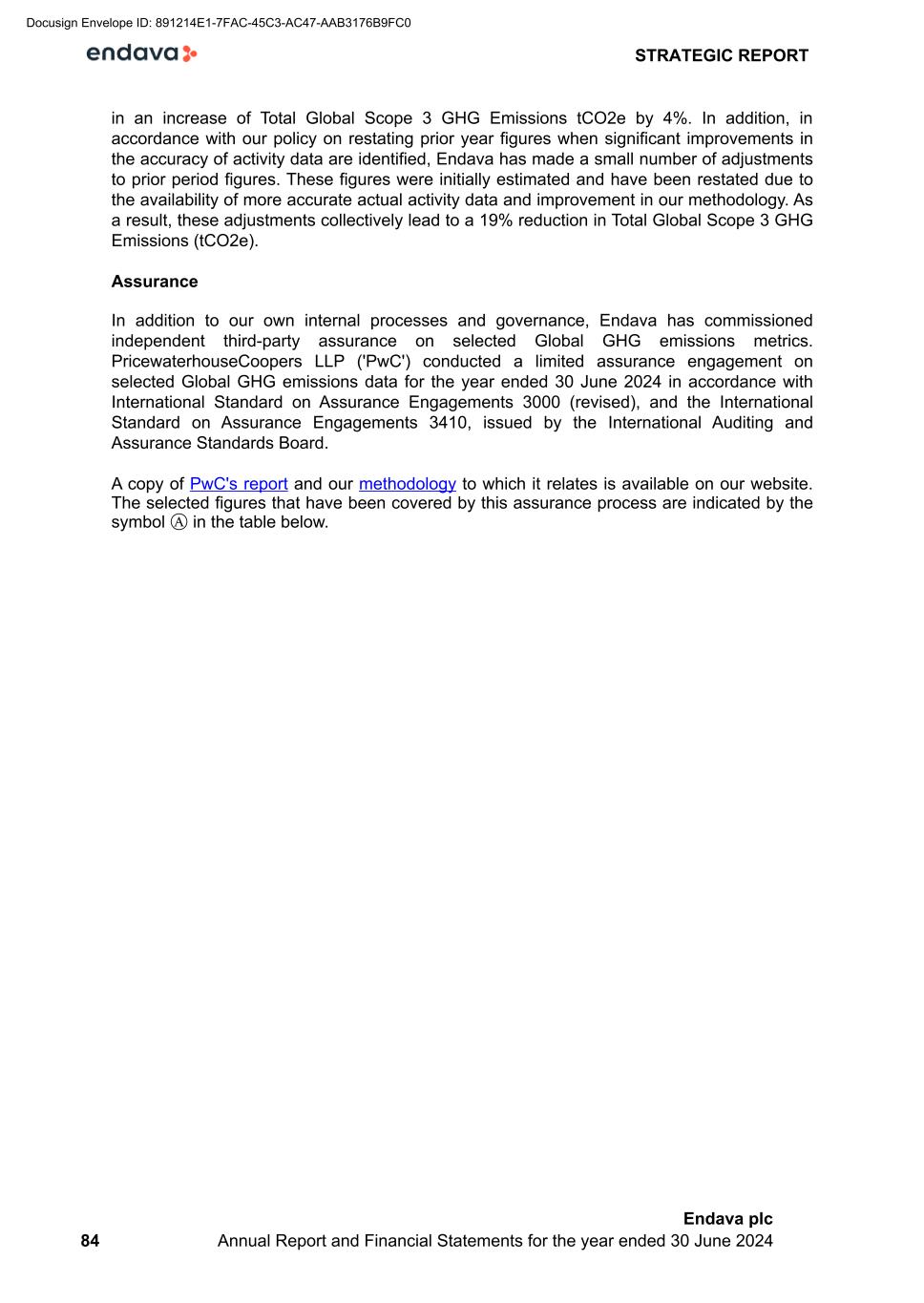
in an increase of Total Global Scope 3 GHG Emissions tCO2e by 4%. In addition, in accordance with our policy on restating prior year figures when significant improvements in the accuracy of activity data are identified, Endava has made a small number of adjustments to prior period figures. These figures were initially estimated and have been restated due to the availability of more accurate actual activity data and improvement in our methodology. As a result, these adjustments collectively lead to a 19% reduction in Total Global Scope 3 GHG Emissions (tCO2e). Assurance In addition to our own internal processes and governance, Endava has commissioned independent third-party assurance on selected Global GHG emissions metrics. PricewaterhouseCoopers LLP ('PwC') conducted a limited assurance engagement on selected Global GHG emissions data for the year ended 30 June 2024 in accordance with International Standard on Assurance Engagements 3000 (revised), and the International Standard on Assurance Engagements 3410, issued by the International Auditing and Assurance Standards Board. A copy of PwC's report and our methodology to which it relates is available on our website. The selected figures that have been covered by this assurance process are indicated by the symbol Ⓐ in the table below. STRATEGIC REPORT 84 Endava plc Annual Report and Financial Statements for the year ended 30 June 2024 Docusign Envelope ID: 891214E1-7FAC-45C3-AC47-AAB3176B9FC0
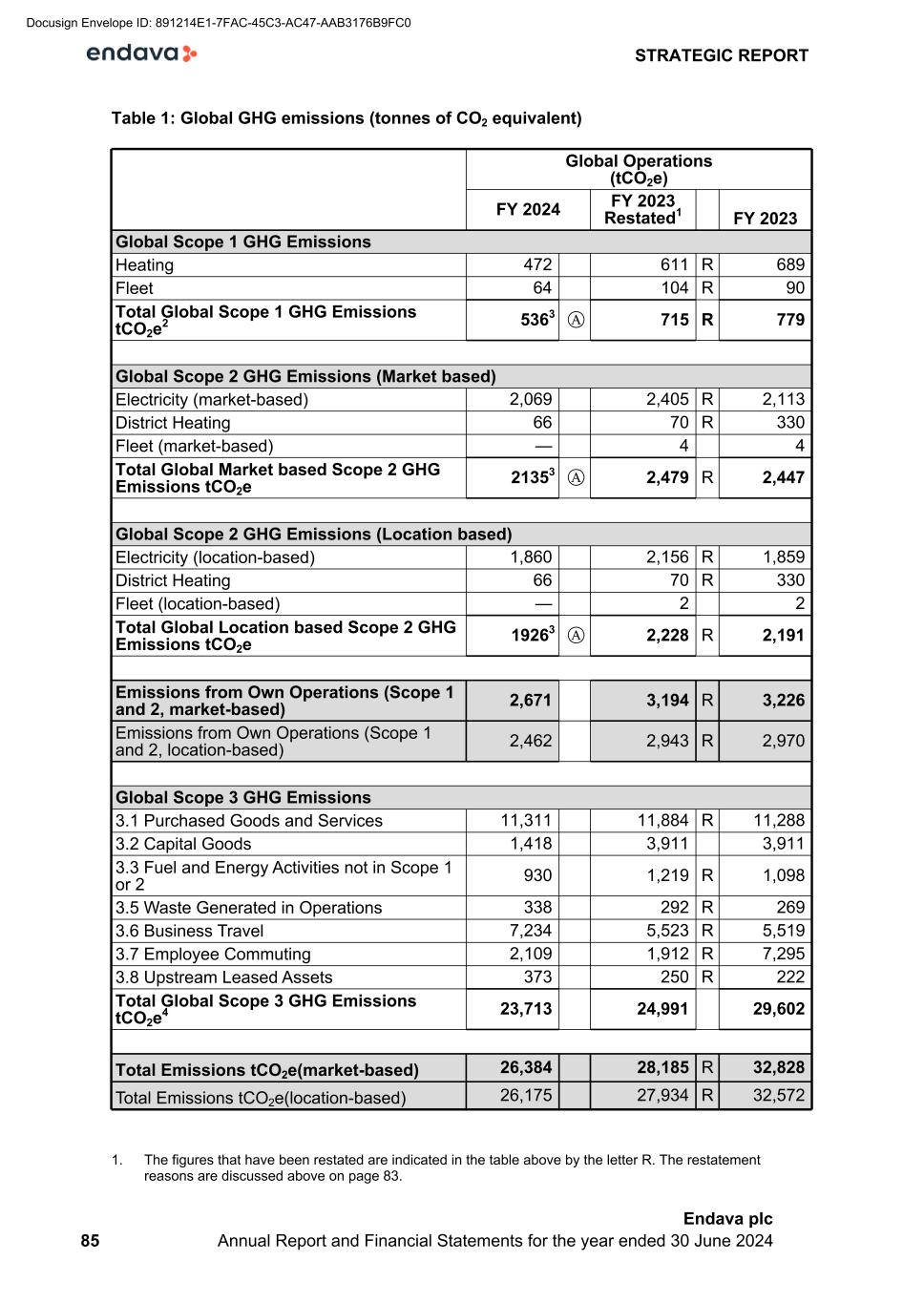
Table 1: Global GHG emissions (tonnes of CO2 equivalent) Global Operations (tCO2e) FY 2024 FY 2023 Restated1 FY 2023 Global Scope 1 GHG Emissions Heating 472 611 R 689 Fleet 64 104 R 90 Total Global Scope 1 GHG Emissions tCO2e2 5363 Ⓐ 715 R 779 Global Scope 2 GHG Emissions (Market based) Electricity (market-based) 2,069 2,405 R 2,113 District Heating 66 70 R 330 Fleet (market-based) — 4 4 Total Global Market based Scope 2 GHG Emissions tCO2e 21353 Ⓐ 2,479 R 2,447 Global Scope 2 GHG Emissions (Location based) Electricity (location-based) 1,860 2,156 R 1,859 District Heating 66 70 R 330 Fleet (location-based) — 2 2 Total Global Location based Scope 2 GHG Emissions tCO2e 19263 Ⓐ 2,228 R 2,191 Emissions from Own Operations (Scope 1 and 2, market-based) 2,671 3,194 R 3,226 Emissions from Own Operations (Scope 1 and 2, location-based) 2,462 2,943 R 2,970 Global Scope 3 GHG Emissions 3.1 Purchased Goods and Services 11,311 11,884 R 11,288 3.2 Capital Goods 1,418 3,911 3,911 3.3 Fuel and Energy Activities not in Scope 1 or 2 930 1,219 R 1,098 3.5 Waste Generated in Operations 338 292 R 269 3.6 Business Travel 7,234 5,523 R 5,519 3.7 Employee Commuting 2,109 1,912 R 7,295 3.8 Upstream Leased Assets 373 250 R 222 Total Global Scope 3 GHG Emissions tCO2e4 23,713 24,991 29,602 Total Emissions tCO2e(market-based) 26,384 28,185 R 32,828 Total Emissions tCO2e(location-based) 26,175 27,934 R 32,572 1. The figures that have been restated are indicated in the table above by the letter R. The restatement reasons are discussed above on page 83. STRATEGIC REPORT 85 Endava plc Annual Report and Financial Statements for the year ended 30 June 2024 Docusign Envelope ID: 891214E1-7FAC-45C3-AC47-AAB3176B9FC0
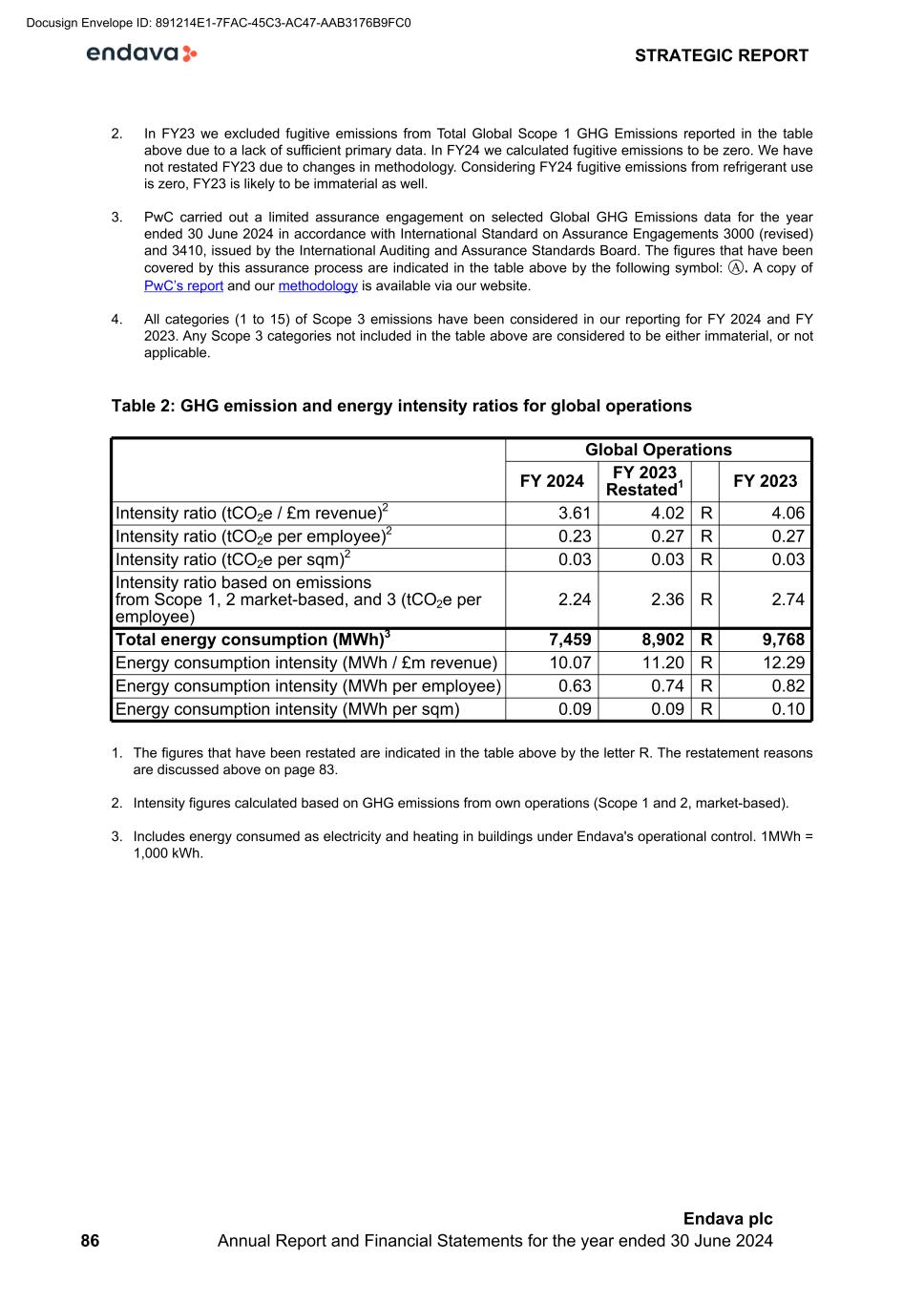
2. In FY23 we excluded fugitive emissions from Total Global Scope 1 GHG Emissions reported in the table above due to a lack of sufficient primary data. In FY24 we calculated fugitive emissions to be zero. We have not restated FY23 due to changes in methodology. Considering FY24 fugitive emissions from refrigerant use is zero, FY23 is likely to be immaterial as well. 3. PwC carried out a limited assurance engagement on selected Global GHG Emissions data for the year ended 30 June 2024 in accordance with International Standard on Assurance Engagements 3000 (revised) and 3410, issued by the International Auditing and Assurance Standards Board. The figures that have been covered by this assurance process are indicated in the table above by the following symbol: Ⓐ. A copy of PwC’s report and our methodology is available via our website. 4. All categories (1 to 15) of Scope 3 emissions have been considered in our reporting for FY 2024 and FY 2023. Any Scope 3 categories not included in the table above are considered to be either immaterial, or not applicable. Table 2: GHG emission and energy intensity ratios for global operations Global Operations FY 2024 FY 2023 Restated1 FY 2023 Intensity ratio (tCO2e / £m revenue)2 3.61 4.02 R 4.06 Intensity ratio (tCO2e per employee)2 0.23 0.27 R 0.27 Intensity ratio (tCO2e per sqm)2 0.03 0.03 R 0.03 Intensity ratio based on emissions from Scope 1, 2 market-based, and 3 (tCO2e per employee) 2.24 2.36 R 2.74 Total energy consumption (MWh)3 7,459 8,902 R 9,768 Energy consumption intensity (MWh / £m revenue) 10.07 11.20 R 12.29 Energy consumption intensity (MWh per employee) 0.63 0.74 R 0.82 Energy consumption intensity (MWh per sqm) 0.09 0.09 R 0.10 1. The figures that have been restated are indicated in the table above by the letter R. The restatement reasons are discussed above on page 83. 2. Intensity figures calculated based on GHG emissions from own operations (Scope 1 and 2, market-based). 3. Includes energy consumed as electricity and heating in buildings under Endava's operational control. 1MWh = 1,000 kWh. STRATEGIC REPORT 86 Endava plc Annual Report and Financial Statements for the year ended 30 June 2024 Docusign Envelope ID: 891214E1-7FAC-45C3-AC47-AAB3176B9FC0
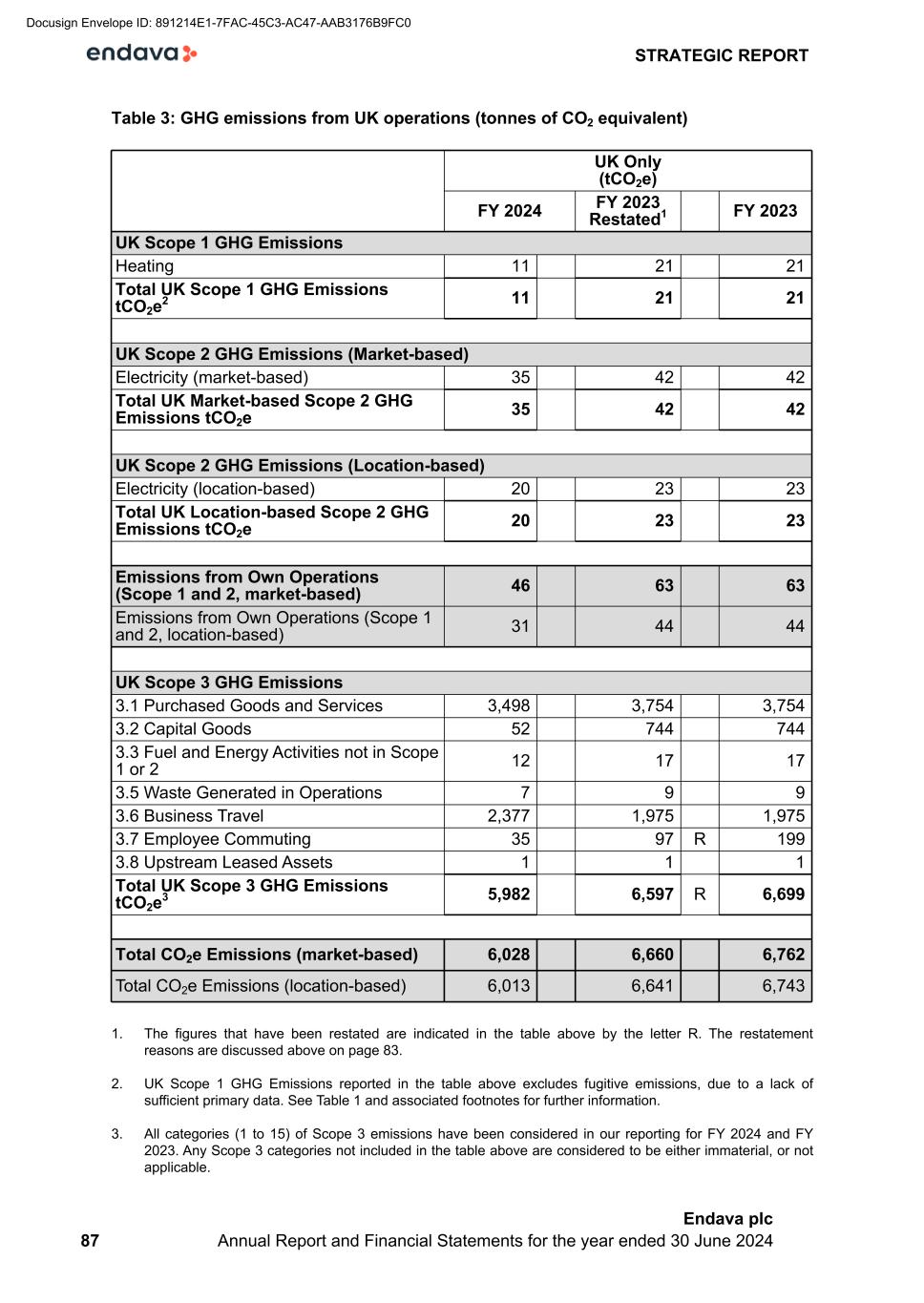
Table 3: GHG emissions from UK operations (tonnes of CO2 equivalent) UK Only (tCO2e) FY 2024 FY 2023 Restated1 FY 2023 UK Scope 1 GHG Emissions Heating 11 21 21 Total UK Scope 1 GHG Emissions tCO2e2 11 21 21 UK Scope 2 GHG Emissions (Market-based) Electricity (market-based) 35 42 42 Total UK Market-based Scope 2 GHG Emissions tCO2e 35 42 42 UK Scope 2 GHG Emissions (Location-based) Electricity (location-based) 20 23 23 Total UK Location-based Scope 2 GHG Emissions tCO2e 20 23 23 Emissions from Own Operations (Scope 1 and 2, market-based) 46 63 63 Emissions from Own Operations (Scope 1 and 2, location-based) 31 44 44 UK Scope 3 GHG Emissions 3.1 Purchased Goods and Services 3,498 3,754 3,754 3.2 Capital Goods 52 744 744 3.3 Fuel and Energy Activities not in Scope 1 or 2 12 17 17 3.5 Waste Generated in Operations 7 9 9 3.6 Business Travel 2,377 1,975 1,975 3.7 Employee Commuting 35 97 R 199 3.8 Upstream Leased Assets 1 1 1 Total UK Scope 3 GHG Emissions tCO2e3 5,982 6,597 R 6,699 Total CO2e Emissions (market-based) 6,028 6,660 6,762 Total CO2e Emissions (location-based) 6,013 6,641 6,743 1. The figures that have been restated are indicated in the table above by the letter R. The restatement reasons are discussed above on page 83. 2. UK Scope 1 GHG Emissions reported in the table above excludes fugitive emissions, due to a lack of sufficient primary data. See Table 1 and associated footnotes for further information. 3. All categories (1 to 15) of Scope 3 emissions have been considered in our reporting for FY 2024 and FY 2023. Any Scope 3 categories not included in the table above are considered to be either immaterial, or not applicable. STRATEGIC REPORT 87 Endava plc Annual Report and Financial Statements for the year ended 30 June 2024 Docusign Envelope ID: 891214E1-7FAC-45C3-AC47-AAB3176B9FC0

Table 4: GHG emission and energy intensity ratios for UK operations UK Only FY 2024 FY 2023 Restated1 FY 2023 Intensity ratio (tCO2e per employee)2 0.16 0.17 0.17 Intensity ratio (tCO2e per sqm)2 0.03 0.04 0.04 Total energy consumption (MWh)3 159 235 235 Energy consumption intensity (MWh per employee) 0.55 0.65 0.65 Energy consumption intensity (MWh per sqm) 0.10 0.13 0.13 1. The figures that have been restated are indicated in the table above by the letter R. The restatement reasons are discussed above on page 83. 2. Intensity figures calculated based on GHG emissions from own operations (Scope 1 and 2, market-based). 3. Includes energy consumed as electricity and heating in buildings under Endava's operational control. 1MWh = 1,000 kWh. Analysis Scope 1 and Scope 2 emissions, which make up approximately 10% of our total carbon footprint for the year ended 30 June 2024, are produced through our own operations either directly (through use of heating systems and use of conventional cars that are part of our fleet, based on fossil fuels), or indirectly (through purchased electricity or district heating). Global Scope 1 emissions have decreased by 25% in the year ended 30 June 2024, from 715 tCO2e to 536 tC02e. Global Scope 2 market-based emissions have decreased by 14% in the year ended 30 June 2024, from 2,479 tCO2e to 2,135 tCO2e, and Global Scope 2 location-based emissions have decreased by 14% in the year ended 30 June 2024, from 2,228 tCO2e to 1,926 tCO2e. In the short term, we plan to minimise these as a priority by reducing our dependence on fossil fuels and increasing the share of renewables in our operations. Global Scope 3 emissions have decreased by 5% in the year ended 30 June 2024, from 24,991 tCO2e to 23,713 tC02e. Our analysis of our Scope 3 emissions shows that like other companies, the main contributor to Endava’s carbon footprint (approximately 26,384 for the year ended 30 June 2024) is our value chain. To this end, we have already begun the process of engaging with our suppliers to identify emission reduction opportunities and the partnerships that will be required to support them. Other notable sources are commuting of Endavans, and business travel. We will continue to encourage more mindful and environmentally friendly alternatives for working and travelling. STRATEGIC REPORT 88 Endava plc Annual Report and Financial Statements for the year ended 30 June 2024 Docusign Envelope ID: 891214E1-7FAC-45C3-AC47-AAB3176B9FC0
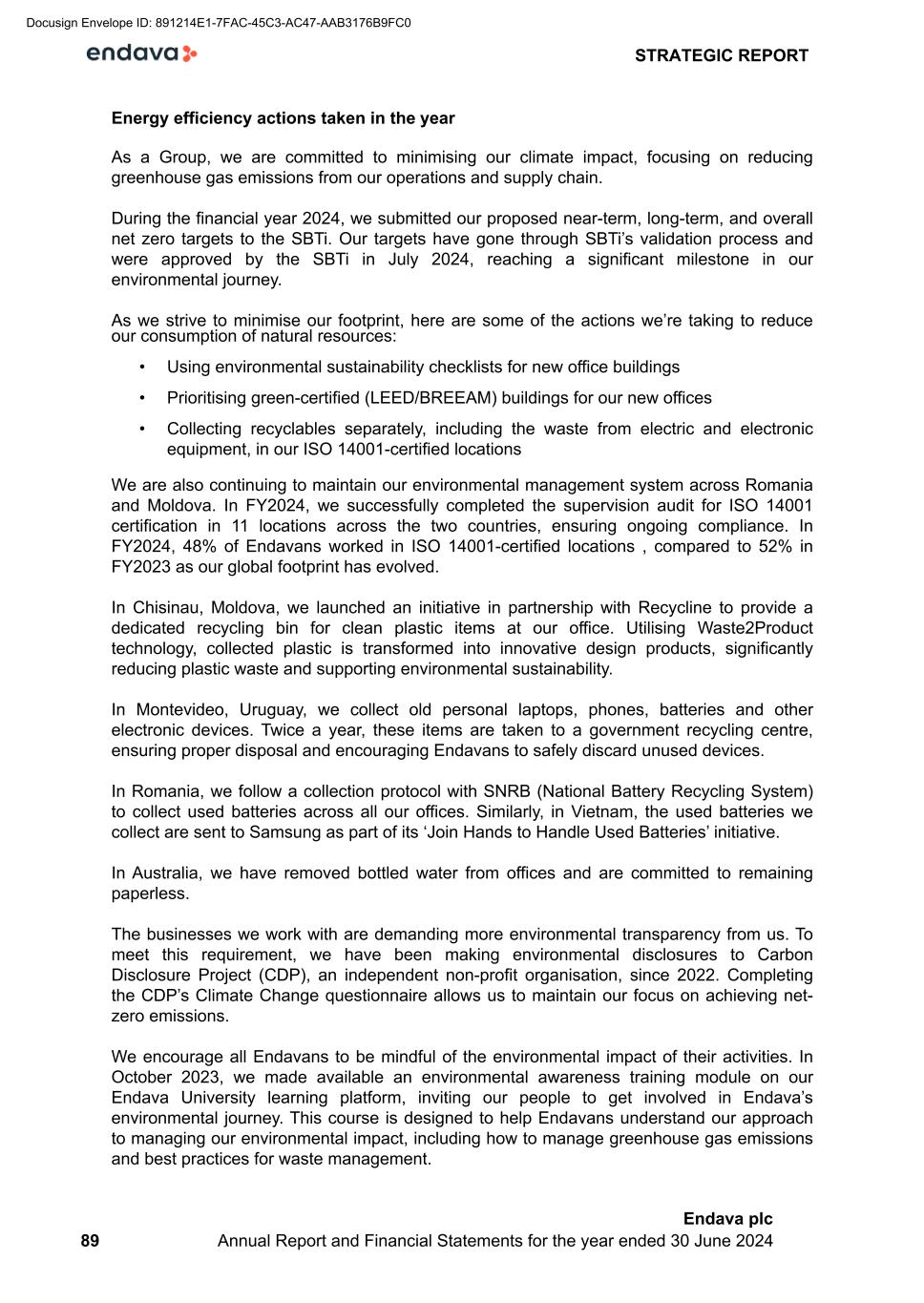
Energy efficiency actions taken in the year As a Group, we are committed to minimising our climate impact, focusing on reducing greenhouse gas emissions from our operations and supply chain. During the financial year 2024, we submitted our proposed near-term, long-term, and overall net zero targets to the SBTi. Our targets have gone through SBTi’s validation process and were approved by the SBTi in July 2024, reaching a significant milestone in our environmental journey. As we strive to minimise our footprint, here are some of the actions we’re taking to reduce our consumption of natural resources: • Using environmental sustainability checklists for new office buildings • Prioritising green-certified (LEED/BREEAM) buildings for our new offices • Collecting recyclables separately, including the waste from electric and electronic equipment, in our ISO 14001-certified locations We are also continuing to maintain our environmental management system across Romania and Moldova. In FY2024, we successfully completed the supervision audit for ISO 14001 certification in 11 locations across the two countries, ensuring ongoing compliance. In FY2024, 48% of Endavans worked in ISO 14001-certified locations , compared to 52% in FY2023 as our global footprint has evolved. In Chisinau, Moldova, we launched an initiative in partnership with Recycline to provide a dedicated recycling bin for clean plastic items at our office. Utilising Waste2Product technology, collected plastic is transformed into innovative design products, significantly reducing plastic waste and supporting environmental sustainability. In Montevideo, Uruguay, we collect old personal laptops, phones, batteries and other electronic devices. Twice a year, these items are taken to a government recycling centre, ensuring proper disposal and encouraging Endavans to safely discard unused devices. In Romania, we follow a collection protocol with SNRB (National Battery Recycling System) to collect used batteries across all our offices. Similarly, in Vietnam, the used batteries we collect are sent to Samsung as part of its ‘Join Hands to Handle Used Batteries’ initiative. In Australia, we have removed bottled water from offices and are committed to remaining paperless. The businesses we work with are demanding more environmental transparency from us. To meet this requirement, we have been making environmental disclosures to Carbon Disclosure Project (CDP), an independent non-profit organisation, since 2022. Completing the CDP’s Climate Change questionnaire allows us to maintain our focus on achieving net- zero emissions. We encourage all Endavans to be mindful of the environmental impact of their activities. In October 2023, we made available an environmental awareness training module on our Endava University learning platform, inviting our people to get involved in Endava’s environmental journey. This course is designed to help Endavans understand our approach to managing our environmental impact, including how to manage greenhouse gas emissions and best practices for waste management. STRATEGIC REPORT 89 Endava plc Annual Report and Financial Statements for the year ended 30 June 2024 Docusign Envelope ID: 891214E1-7FAC-45C3-AC47-AAB3176B9FC0
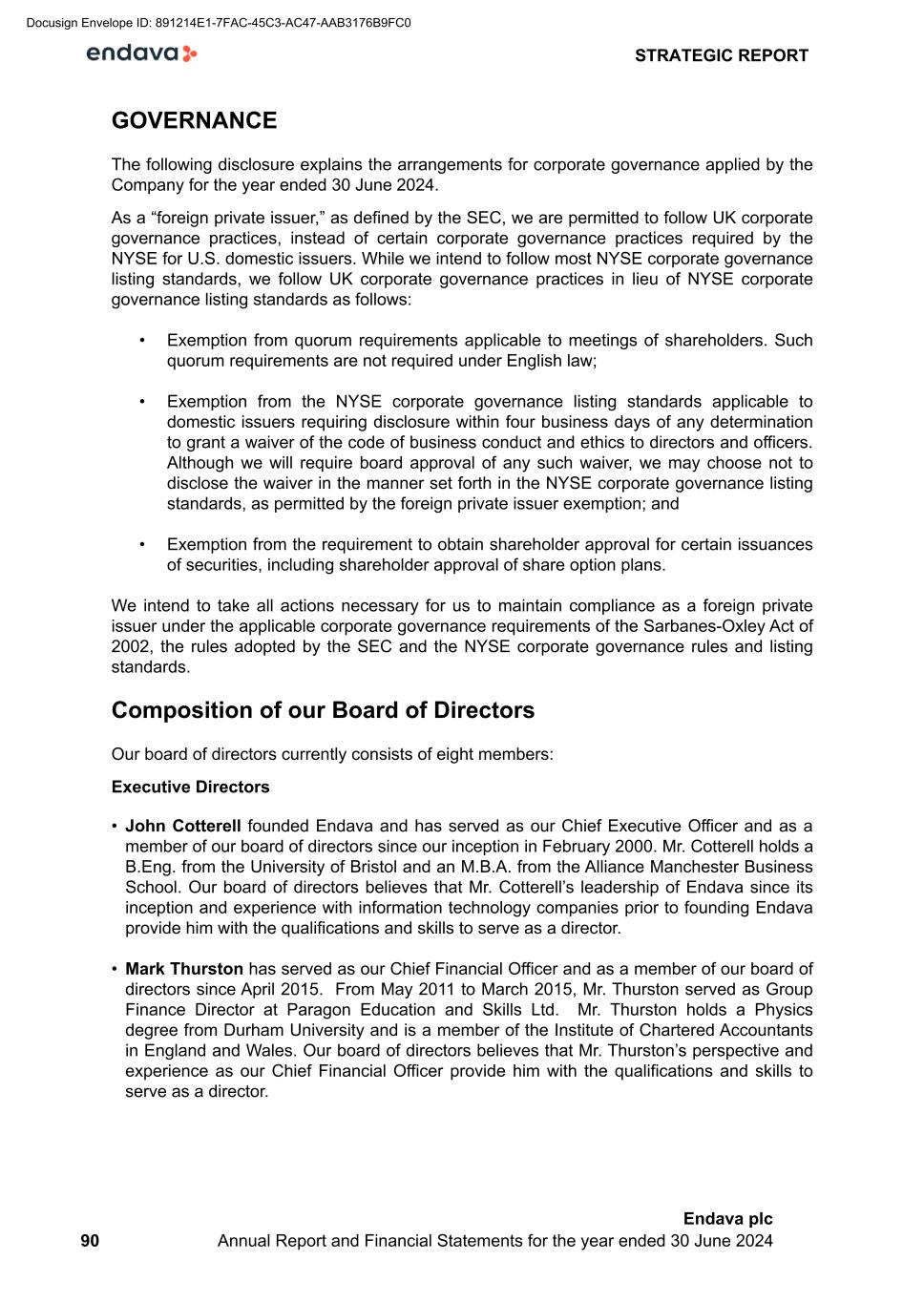
GOVERNANCE The following disclosure explains the arrangements for corporate governance applied by the Company for the year ended 30 June 2024. As a “foreign private issuer,” as defined by the SEC, we are permitted to follow UK corporate governance practices, instead of certain corporate governance practices required by the NYSE for U.S. domestic issuers. While we intend to follow most NYSE corporate governance listing standards, we follow UK corporate governance practices in lieu of NYSE corporate governance listing standards as follows: • Exemption from quorum requirements applicable to meetings of shareholders. Such quorum requirements are not required under English law; • Exemption from the NYSE corporate governance listing standards applicable to domestic issuers requiring disclosure within four business days of any determination to grant a waiver of the code of business conduct and ethics to directors and officers. Although we will require board approval of any such waiver, we may choose not to disclose the waiver in the manner set forth in the NYSE corporate governance listing standards, as permitted by the foreign private issuer exemption; and • Exemption from the requirement to obtain shareholder approval for certain issuances of securities, including shareholder approval of share option plans. We intend to take all actions necessary for us to maintain compliance as a foreign private issuer under the applicable corporate governance requirements of the Sarbanes-Oxley Act of 2002, the rules adopted by the SEC and the NYSE corporate governance rules and listing standards. Composition of our Board of Directors Our board of directors currently consists of eight members: Executive Directors • John Cotterell founded Endava and has served as our Chief Executive Officer and as a member of our board of directors since our inception in February 2000. Mr. Cotterell holds a B.Eng. from the University of Bristol and an M.B.A. from the Alliance Manchester Business School. Our board of directors believes that Mr. Cotterell’s leadership of Endava since its inception and experience with information technology companies prior to founding Endava provide him with the qualifications and skills to serve as a director. • Mark Thurston has served as our Chief Financial Officer and as a member of our board of directors since April 2015. From May 2011 to March 2015, Mr. Thurston served as Group Finance Director at Paragon Education and Skills Ltd. Mr. Thurston holds a Physics degree from Durham University and is a member of the Institute of Chartered Accountants in England and Wales. Our board of directors believes that Mr. Thurston’s perspective and experience as our Chief Financial Officer provide him with the qualifications and skills to serve as a director. STRATEGIC REPORT 90 Endava plc Annual Report and Financial Statements for the year ended 30 June 2024 Docusign Envelope ID: 891214E1-7FAC-45C3-AC47-AAB3176B9FC0

Non-Executive Directors • Trevor Smith has served as a member of our board of directors since June 2013 and as our chairman since July 2016. Prior to his retirement, Mr. Smith held various roles at Goldman, Sachs & Co., an investment bank, including Chief Information Officer for the EMEA Region from January 2000 to September 2009 and in a part-time Business Resiliency & Crisis Management and Special Project role from March 2010 until June 2013. Mr. Smith holds a B.Sc. in Economics from UCW Aberystwyth. Our board of directors believes that Mr. Smith’s experience in information technology and delivery of large projects provide him with the qualifications and skills to serve as a director. • Patrick Butcher has served as a member of our board of directors since May 2023. Mr. Butcher most recently served as Group Chief Financial Officer of the Headlam Group plc from April 2022 until March 2023. From January 2019 to November 2020, he served as Group Chief Financial Officer at Capita plc. Prior to that, Mr. Butcher served as Chief Financial Officer at various companies including The Go-Ahead Group plc, Network Rail Limited, English, Welsh and Scottish Railway and Mapeley Limited. Mr. Butcher received his B. Compt. (Hons) in Accounting and Finance from the University of South Africa and is a qualified Chartered Accountant (South Africa). Our board of directors believes that Mr. Butcher’s financial expertise and his significant leadership experience provide him with the qualifications and skills to serve as a director. • Sulina Connal has served as a member of our board of directors since September 2019. Since April 2020, she has been working on partnerships at Google and is currently Managing Director of News and Books Partnerships for EMEA. Previously, Ms. Connal served as the Director of Mobile and Connectivity Partnerships at Facebook from October 2017 to April 2020. Prior to that, from April 2014 until September 2017, she served as the Senior Vice President of Strategic Partnerships at Orange. Ms. Connal holds an M.A. from the University of Oxford. Our board of directors believes that Ms. Connal's business experience provides her with the qualifications and skills to serve as a director. • Ben Druskin has served as a member of our board of directors since September 2017. Mr. Druskin retired from Citigroup in August 2017. From 2014 until his retirement, Mr. Druskin served as the Chairman of the Global Technology, Media and Telecom Investment Banking Group. Prior to becoming Chairman, Mr. Druskin was co-head of the Global Technology, Media and Telecom Investment Banking Group. Mr. Druskin has served as a member of the board of directors of Zensar Technologies since November 2017, and served as a member of the board of directors of Global Synergy Acquisition Corp. between October 2020 and August 2022. Mr. Druskin holds a B.A. in Economics from Rutgers College and an M.B.A. in Finance from The Stern School of Business at New York University. Our board of directors believes that Mr. Druskin’s expertise in capital raising and merger and acquisition transactions provide him with the qualifications and skills to serve as a director. • Kathryn Hollister has served as a member of our board of directors since October 2022. Since June 2021, Ms. Hollister has served as a member of the board of directors of Clear Secure, Inc. and as a member of the board’s audit and compensation committees. From March 2021 to May 2022, Ms. Hollister served as a member of the board of directors of First Solar, Inc. and as a member of the board’s audit and compensation committees. Ms. Hollister was an active partner at Deloitte for over 25 years until September 2020, where she served as the Chief Strategy Officer of Deloitte Global Tax and Legal practice from 2015 until 2019 and in a variety of leadership roles, including Chief Strategy Officer of Deloitte Tax LLP (USA), managing partner of the U.S. Business Tax Service line, and served both public and private clients. Ms. Hollister was a member of the board of directors STRATEGIC REPORT 91 Endava plc Annual Report and Financial Statements for the year ended 30 June 2024 Docusign Envelope ID: 891214E1-7FAC-45C3-AC47-AAB3176B9FC0
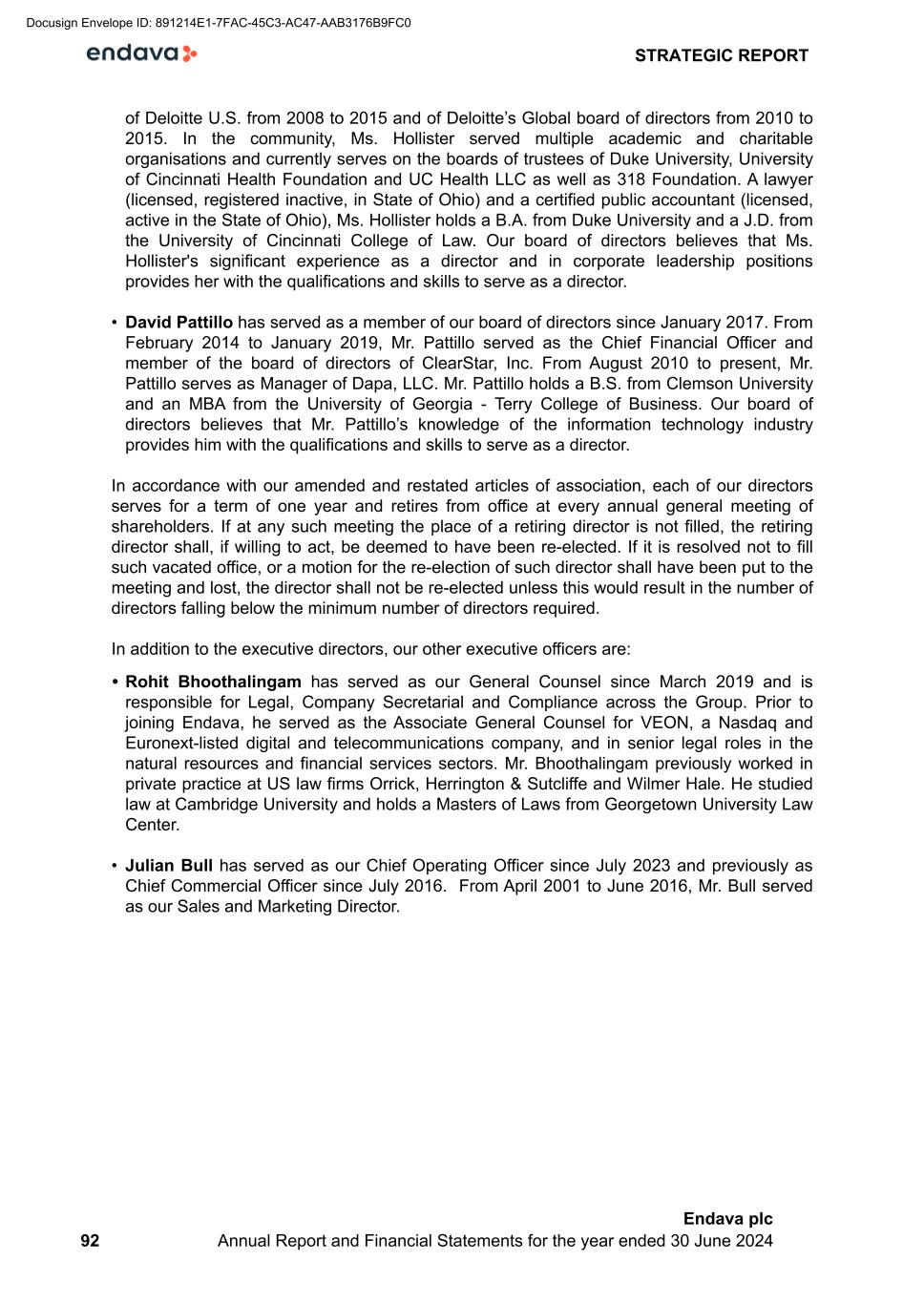
of Deloitte U.S. from 2008 to 2015 and of Deloitte’s Global board of directors from 2010 to 2015. In the community, Ms. Hollister served multiple academic and charitable organisations and currently serves on the boards of trustees of Duke University, University of Cincinnati Health Foundation and UC Health LLC as well as 318 Foundation. A lawyer (licensed, registered inactive, in State of Ohio) and a certified public accountant (licensed, active in the State of Ohio), Ms. Hollister holds a B.A. from Duke University and a J.D. from the University of Cincinnati College of Law. Our board of directors believes that Ms. Hollister's significant experience as a director and in corporate leadership positions provides her with the qualifications and skills to serve as a director. • David Pattillo has served as a member of our board of directors since January 2017. From February 2014 to January 2019, Mr. Pattillo served as the Chief Financial Officer and member of the board of directors of ClearStar, Inc. From August 2010 to present, Mr. Pattillo serves as Manager of Dapa, LLC. Mr. Pattillo holds a B.S. from Clemson University and an MBA from the University of Georgia - Terry College of Business. Our board of directors believes that Mr. Pattillo’s knowledge of the information technology industry provides him with the qualifications and skills to serve as a director. In accordance with our amended and restated articles of association, each of our directors serves for a term of one year and retires from office at every annual general meeting of shareholders. If at any such meeting the place of a retiring director is not filled, the retiring director shall, if willing to act, be deemed to have been re-elected. If it is resolved not to fill such vacated office, or a motion for the re-election of such director shall have been put to the meeting and lost, the director shall not be re-elected unless this would result in the number of directors falling below the minimum number of directors required. In addition to the executive directors, our other executive officers are: • Rohit Bhoothalingam has served as our General Counsel since March 2019 and is responsible for Legal, Company Secretarial and Compliance across the Group. Prior to joining Endava, he served as the Associate General Counsel for VEON, a Nasdaq and Euronext-listed digital and telecommunications company, and in senior legal roles in the natural resources and financial services sectors. Mr. Bhoothalingam previously worked in private practice at US law firms Orrick, Herrington & Sutcliffe and Wilmer Hale. He studied law at Cambridge University and holds a Masters of Laws from Georgetown University Law Center. • Julian Bull has served as our Chief Operating Officer since July 2023 and previously as Chief Commercial Officer since July 2016. From April 2001 to June 2016, Mr. Bull served as our Sales and Marketing Director. STRATEGIC REPORT 92 Endava plc Annual Report and Financial Statements for the year ended 30 June 2024 Docusign Envelope ID: 891214E1-7FAC-45C3-AC47-AAB3176B9FC0

• David Churchill has served as our Chief People Officer since July 2021, and was promoted to the executive team in the same position in July 2023. Mr. Churchill joined Endava in July 2016 as Head of People and Organisation. Prior to joining Endava, Mr. Churchill led across multiple HR disciplines in listed and privately owned media, telecommunications and technology businesses in the United Kingdom and Europe, holding people strategy and operations positions with BT from 2008 to 2013 and Arqiva from 2013 to 2016 as they moved through change of ownership. Mr. Churchill holds a 2:1 (B.A) in Business and French from Bournemouth University. • Matt Cloke has served as our Chief Technology Officer since July 2023. Mr. Cloke joined Endava in 2014 and has served in various positions prior to his appointment as Chief Technology Officer, including most recently serving as our Chief Catalyst. Prior to joining Endava, Mr. Cloke was an Executive Director at UBS Investment Bank where he was responsible for the Investment Banks P&L financial reporting technology. Between 1997 and 2005, Mr. Cloke was a Principal Consultant at American Management Systems, latterly purchased by CGI. Mr. Cloke holds a 2:1 (B.Sc.) in Computer Science and Psychology from Brunel University. Division of Board Responsibilities Our board shares collective responsibility for the long-term success of the Group but individual members undertake additional clearly-defined activities on behalf of the board. The roles and responsibilities of the board, its committees, Chairman and CEO are documented and regularly reviewed. The board is assisted by various committees, as further explained below. Our board of directors has three standing committees: an audit committee, a remuneration committee and a nominating and corporate governance committee. Audit Committee The audit committee, which currently consists of Messrs. Butcher, Pattillo and Smith, assists the board of directors in overseeing our accounting and financial reporting processes and the audits of our financial statements. Mr. Pattillo serves as chairman of the committee. The audit committee consists exclusively of members of our board of directors who are financially literate, and Mr. Pattillo is considered an “audit committee financial expert” as defined by applicable SEC rules. Our board of directors has determined that all of the members of the audit committee satisfy the “independence” requirements set forth in Rule 10A-3 under the Exchange Act. The audit committee is governed by a charter that complies with NYSE rules. The audit committee’s responsibilities include: • assessing, reviewing and discussing with the executive officers, the board of directors and the independent auditor our financial statements and our financial reporting process, including significant issues regarding accounting principles, policies and practices; • monitoring and reviewing with executive officers and the independent auditor the adequacy and effectiveness of internal control over financial reporting and disclosure controls and procedures; • evaluating and making recommendations to the board of directors regarding the appointment, compensation, retention and oversight of any accounting firm engaged STRATEGIC REPORT 93 Endava plc Annual Report and Financial Statements for the year ended 30 June 2024 Docusign Envelope ID: 891214E1-7FAC-45C3-AC47-AAB3176B9FC0
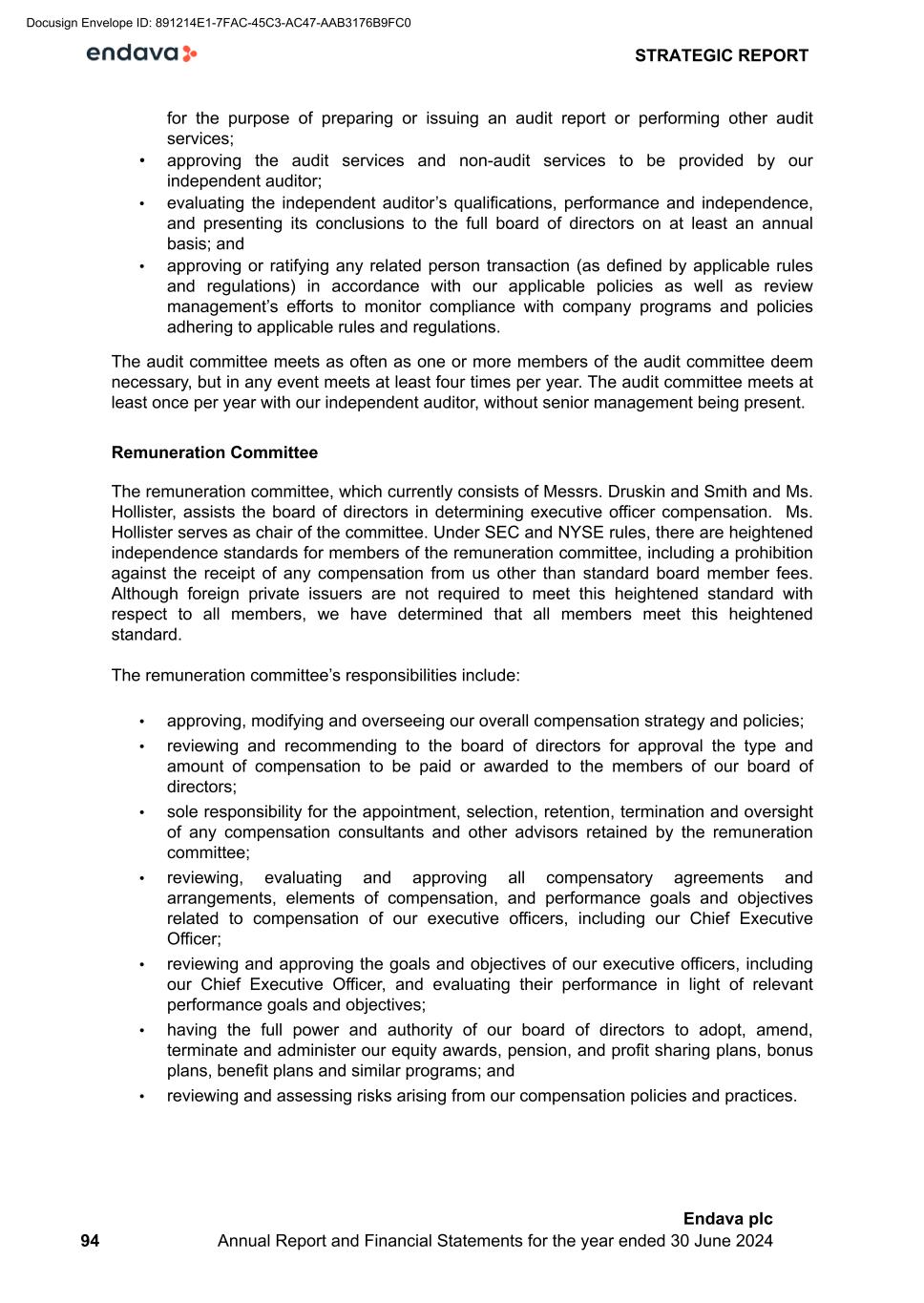
for the purpose of preparing or issuing an audit report or performing other audit services; • approving the audit services and non-audit services to be provided by our independent auditor; • evaluating the independent auditor’s qualifications, performance and independence, and presenting its conclusions to the full board of directors on at least an annual basis; and • approving or ratifying any related person transaction (as defined by applicable rules and regulations) in accordance with our applicable policies as well as review management’s efforts to monitor compliance with company programs and policies adhering to applicable rules and regulations. The audit committee meets as often as one or more members of the audit committee deem necessary, but in any event meets at least four times per year. The audit committee meets at least once per year with our independent auditor, without senior management being present. Remuneration Committee The remuneration committee, which currently consists of Messrs. Druskin and Smith and Ms. Hollister, assists the board of directors in determining executive officer compensation. Ms. Hollister serves as chair of the committee. Under SEC and NYSE rules, there are heightened independence standards for members of the remuneration committee, including a prohibition against the receipt of any compensation from us other than standard board member fees. Although foreign private issuers are not required to meet this heightened standard with respect to all members, we have determined that all members meet this heightened standard. The remuneration committee’s responsibilities include: • approving, modifying and overseeing our overall compensation strategy and policies; • reviewing and recommending to the board of directors for approval the type and amount of compensation to be paid or awarded to the members of our board of directors; • sole responsibility for the appointment, selection, retention, termination and oversight of any compensation consultants and other advisors retained by the remuneration committee; • reviewing, evaluating and approving all compensatory agreements and arrangements, elements of compensation, and performance goals and objectives related to compensation of our executive officers, including our Chief Executive Officer; • reviewing and approving the goals and objectives of our executive officers, including our Chief Executive Officer, and evaluating their performance in light of relevant performance goals and objectives; • having the full power and authority of our board of directors to adopt, amend, terminate and administer our equity awards, pension, and profit sharing plans, bonus plans, benefit plans and similar programs; and • reviewing and assessing risks arising from our compensation policies and practices. STRATEGIC REPORT 94 Endava plc Annual Report and Financial Statements for the year ended 30 June 2024 Docusign Envelope ID: 891214E1-7FAC-45C3-AC47-AAB3176B9FC0
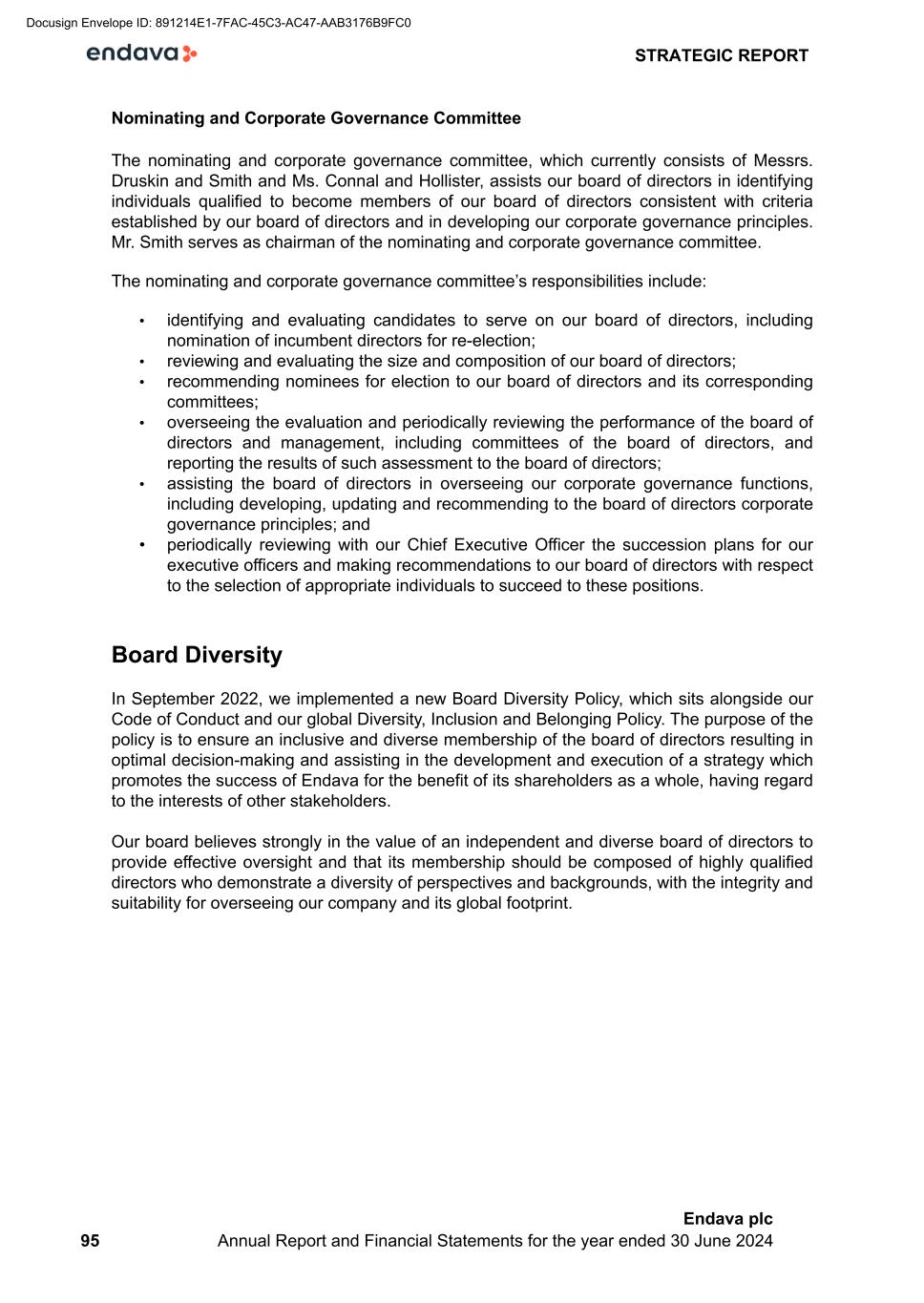
Nominating and Corporate Governance Committee The nominating and corporate governance committee, which currently consists of Messrs. Druskin and Smith and Ms. Connal and Hollister, assists our board of directors in identifying individuals qualified to become members of our board of directors consistent with criteria established by our board of directors and in developing our corporate governance principles. Mr. Smith serves as chairman of the nominating and corporate governance committee. The nominating and corporate governance committee’s responsibilities include: • identifying and evaluating candidates to serve on our board of directors, including nomination of incumbent directors for re-election; • reviewing and evaluating the size and composition of our board of directors; • recommending nominees for election to our board of directors and its corresponding committees; • overseeing the evaluation and periodically reviewing the performance of the board of directors and management, including committees of the board of directors, and reporting the results of such assessment to the board of directors; • assisting the board of directors in overseeing our corporate governance functions, including developing, updating and recommending to the board of directors corporate governance principles; and • periodically reviewing with our Chief Executive Officer the succession plans for our executive officers and making recommendations to our board of directors with respect to the selection of appropriate individuals to succeed to these positions. Board Diversity In September 2022, we implemented a new Board Diversity Policy, which sits alongside our Code of Conduct and our global Diversity, Inclusion and Belonging Policy. The purpose of the policy is to ensure an inclusive and diverse membership of the board of directors resulting in optimal decision-making and assisting in the development and execution of a strategy which promotes the success of Endava for the benefit of its shareholders as a whole, having regard to the interests of other stakeholders. Our board believes strongly in the value of an independent and diverse board of directors to provide effective oversight and that its membership should be composed of highly qualified directors who demonstrate a diversity of perspectives and backgrounds, with the integrity and suitability for overseeing our company and its global footprint. STRATEGIC REPORT 95 Endava plc Annual Report and Financial Statements for the year ended 30 June 2024 Docusign Envelope ID: 891214E1-7FAC-45C3-AC47-AAB3176B9FC0

Future outlook Looking back, the past fiscal year has been challenging for Endava with our revenue declining by 4.5% in constant currency as a result of significant headwinds across the business, in particular due to our exposure to the UK market and Payments industry vertical. Today, our industry and geographical concentration are more diversified and we have broadened our delivery footprint, evolving into a truly global delivery organization. We are increasing our investment in the people and skills required to support the next wave of digital transformation, which we believe will help us gradually return to stronger levels of profitability. On behalf of the board J E COTTERELL CHIEF EXECUTIVE OFFICER 19 September 2024 STRATEGIC REPORT 96 Endava plc Annual Report and Financial Statements for the year ended 30 June 2024 Docusign Envelope ID: 891214E1-7FAC-45C3-AC47-AAB3176B9FC0
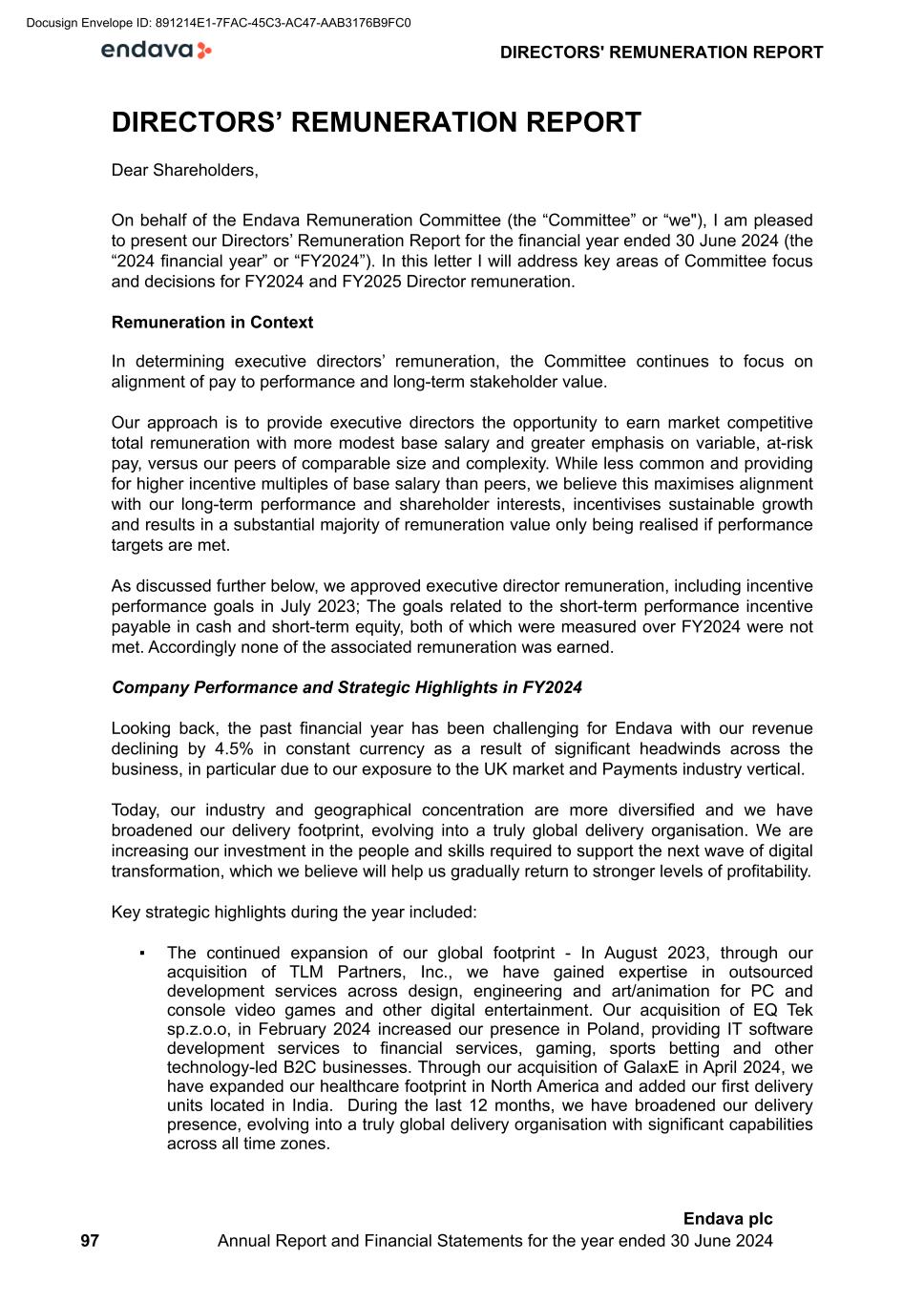
DIRECTORS’ REMUNERATION REPORT Dear Shareholders, On behalf of the Endava Remuneration Committee (the “Committee” or “we"), I am pleased to present our Directors’ Remuneration Report for the financial year ended 30 June 2024 (the “2024 financial year” or “FY2024”). In this letter I will address key areas of Committee focus and decisions for FY2024 and FY2025 Director remuneration. Remuneration in Context In determining executive directors’ remuneration, the Committee continues to focus on alignment of pay to performance and long-term stakeholder value. Our approach is to provide executive directors the opportunity to earn market competitive total remuneration with more modest base salary and greater emphasis on variable, at-risk pay, versus our peers of comparable size and complexity. While less common and providing for higher incentive multiples of base salary than peers, we believe this maximises alignment with our long-term performance and shareholder interests, incentivises sustainable growth and results in a substantial majority of remuneration value only being realised if performance targets are met. As discussed further below, we approved executive director remuneration, including incentive performance goals in July 2023; The goals related to the short-term performance incentive payable in cash and short-term equity, both of which were measured over FY2024 were not met. Accordingly none of the associated remuneration was earned. Company Performance and Strategic Highlights in FY2024 Looking back, the past financial year has been challenging for Endava with our revenue declining by 4.5% in constant currency as a result of significant headwinds across the business, in particular due to our exposure to the UK market and Payments industry vertical. Today, our industry and geographical concentration are more diversified and we have broadened our delivery footprint, evolving into a truly global delivery organisation. We are increasing our investment in the people and skills required to support the next wave of digital transformation, which we believe will help us gradually return to stronger levels of profitability. Key strategic highlights during the year included: ▪ The continued expansion of our global footprint - In August 2023, through our acquisition of TLM Partners, Inc., we have gained expertise in outsourced development services across design, engineering and art/animation for PC and console video games and other digital entertainment. Our acquisition of EQ Tek sp.z.o.o, in February 2024 increased our presence in Poland, providing IT software development services to financial services, gaming, sports betting and other technology-led B2C businesses. Through our acquisition of GalaxE in April 2024, we have expanded our healthcare footprint in North America and added our first delivery units located in India. During the last 12 months, we have broadened our delivery presence, evolving into a truly global delivery organisation with significant capabilities across all time zones. DIRECTORS' REMUNERATION REPORT 97 Endava plc Annual Report and Financial Statements for the year ended 30 June 2024 Docusign Envelope ID: 891214E1-7FAC-45C3-AC47-AAB3176B9FC0
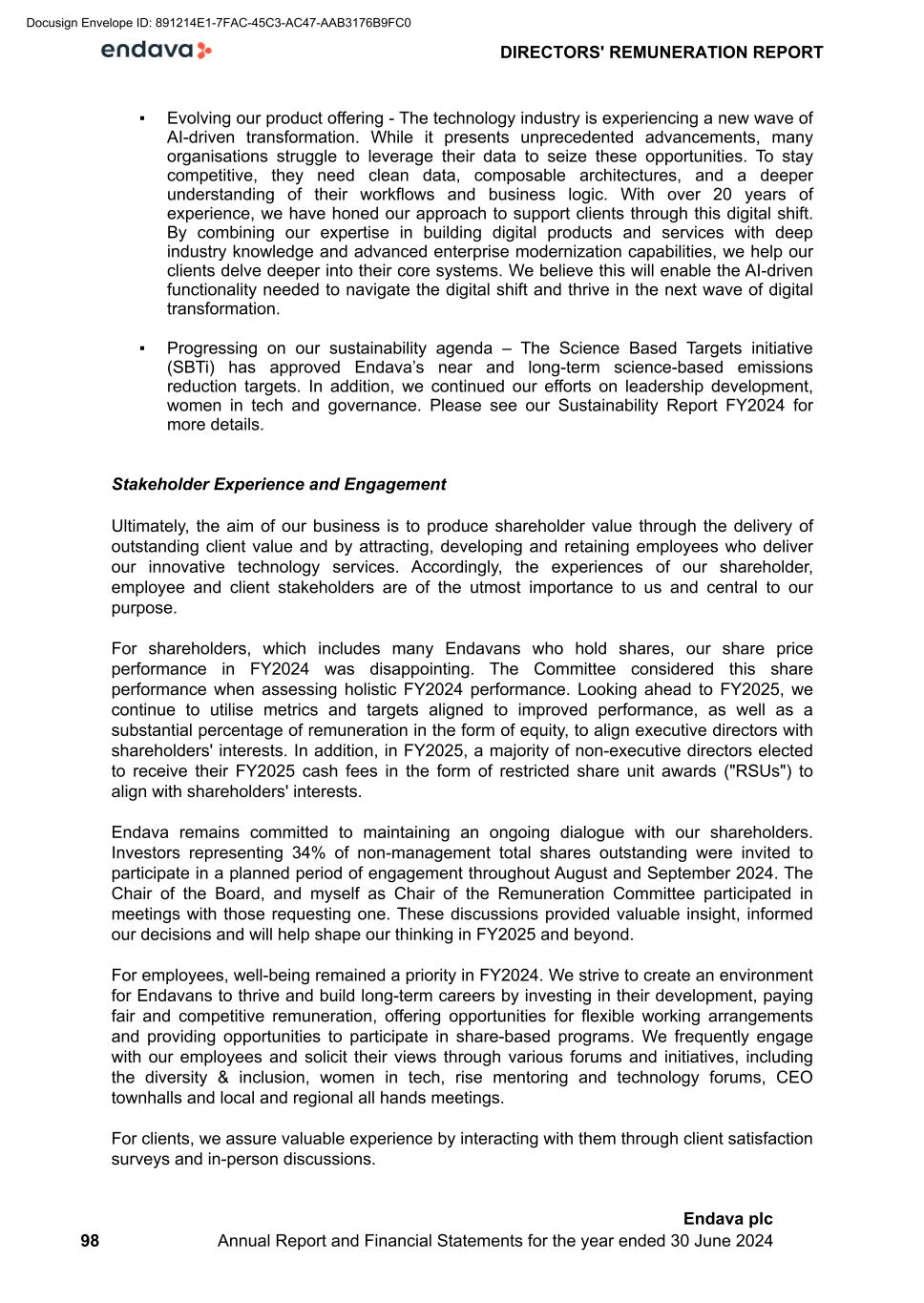
▪ Evolving our product offering - The technology industry is experiencing a new wave of AI-driven transformation. While it presents unprecedented advancements, many organisations struggle to leverage their data to seize these opportunities. To stay competitive, they need clean data, composable architectures, and a deeper understanding of their workflows and business logic. With over 20 years of experience, we have honed our approach to support clients through this digital shift. By combining our expertise in building digital products and services with deep industry knowledge and advanced enterprise modernization capabilities, we help our clients delve deeper into their core systems. We believe this will enable the AI-driven functionality needed to navigate the digital shift and thrive in the next wave of digital transformation. ▪ Progressing on our sustainability agenda – The Science Based Targets initiative (SBTi) has approved Endava’s near and long-term science-based emissions reduction targets. In addition, we continued our efforts on leadership development, women in tech and governance. Please see our Sustainability Report FY2024 for more details. Stakeholder Experience and Engagement Ultimately, the aim of our business is to produce shareholder value through the delivery of outstanding client value and by attracting, developing and retaining employees who deliver our innovative technology services. Accordingly, the experiences of our shareholder, employee and client stakeholders are of the utmost importance to us and central to our purpose. For shareholders, which includes many Endavans who hold shares, our share price performance in FY2024 was disappointing. The Committee considered this share performance when assessing holistic FY2024 performance. Looking ahead to FY2025, we continue to utilise metrics and targets aligned to improved performance, as well as a substantial percentage of remuneration in the form of equity, to align executive directors with shareholders' interests. In addition, in FY2025, a majority of non-executive directors elected to receive their FY2025 cash fees in the form of restricted share unit awards ("RSUs") to align with shareholders' interests. Endava remains committed to maintaining an ongoing dialogue with our shareholders. Investors representing 34% of non-management total shares outstanding were invited to participate in a planned period of engagement throughout August and September 2024. The Chair of the Board, and myself as Chair of the Remuneration Committee participated in meetings with those requesting one. These discussions provided valuable insight, informed our decisions and will help shape our thinking in FY2025 and beyond. For employees, well-being remained a priority in FY2024. We strive to create an environment for Endavans to thrive and build long-term careers by investing in their development, paying fair and competitive remuneration, offering opportunities for flexible working arrangements and providing opportunities to participate in share-based programs. We frequently engage with our employees and solicit their views through various forums and initiatives, including the diversity & inclusion, women in tech, rise mentoring and technology forums, CEO townhalls and local and regional all hands meetings. For clients, we assure valuable experience by interacting with them through client satisfaction surveys and in-person discussions. DIRECTORS' REMUNERATION REPORT 98 Endava plc Annual Report and Financial Statements for the year ended 30 June 2024 Docusign Envelope ID: 891214E1-7FAC-45C3-AC47-AAB3176B9FC0
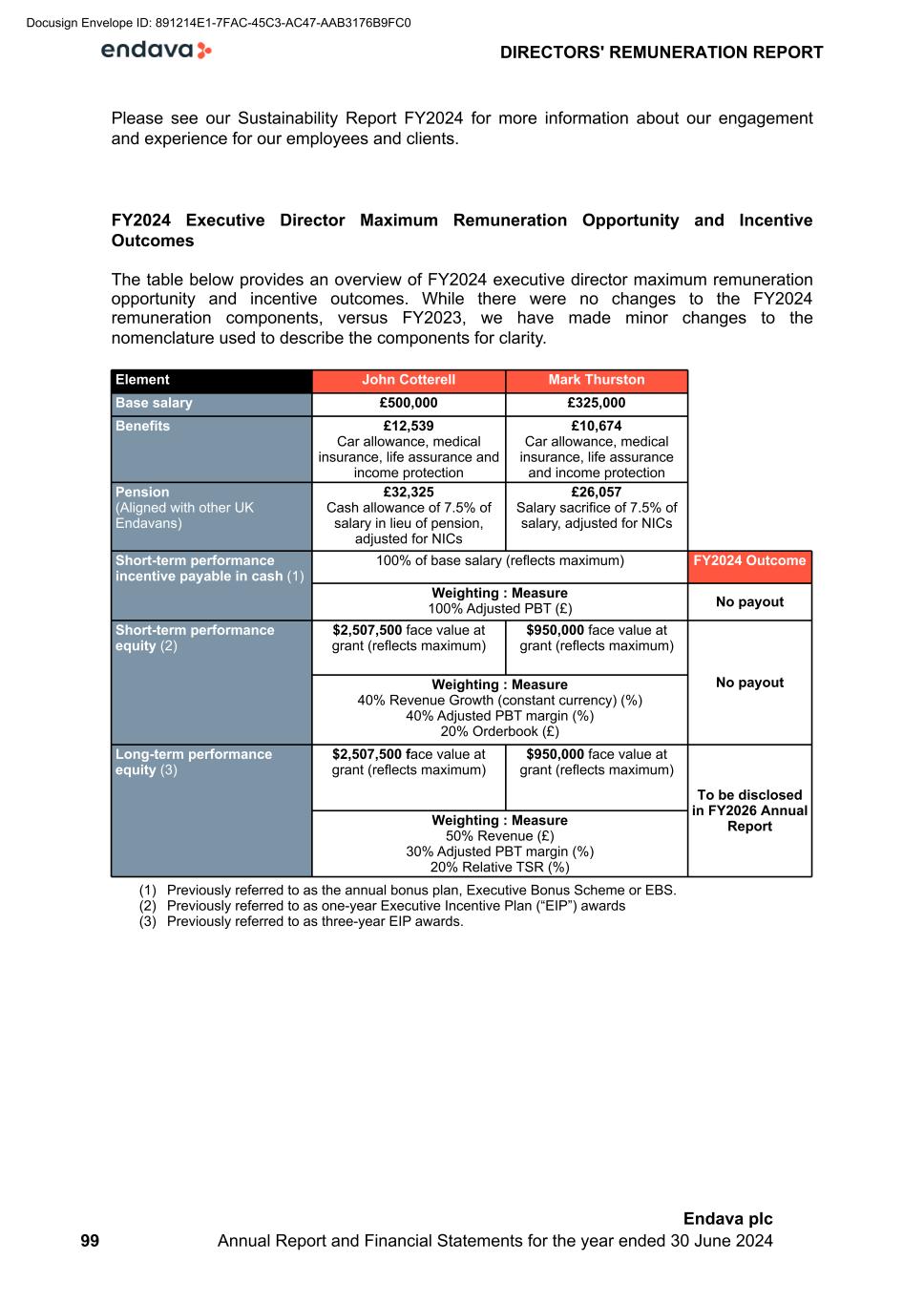
Please see our Sustainability Report FY2024 for more information about our engagement and experience for our employees and clients. FY2024 Executive Director Maximum Remuneration Opportunity and Incentive Outcomes The table below provides an overview of FY2024 executive director maximum remuneration opportunity and incentive outcomes. While there were no changes to the FY2024 remuneration components, versus FY2023, we have made minor changes to the nomenclature used to describe the components for clarity. Element John Cotterell Mark Thurston Base salary £500,000 £325,000 Benefits £12,539 Car allowance, medical insurance, life assurance and income protection £10,674 Car allowance, medical insurance, life assurance and income protection Pension (Aligned with other UK Endavans) £32,325 Cash allowance of 7.5% of salary in lieu of pension, adjusted for NICs £26,057 Salary sacrifice of 7.5% of salary, adjusted for NICs Short-term performance incentive payable in cash (1) 100% of base salary (reflects maximum) FY2024 Outcome Weighting : Measure 100% Adjusted PBT (£) No payout Short-term performance equity (2) $2,507,500 face value at grant (reflects maximum) $950,000 face value at grant (reflects maximum) No payoutWeighting : Measure 40% Revenue Growth (constant currency) (%) 40% Adjusted PBT margin (%) 20% Orderbook (£) Long-term performance equity (3) $2,507,500 face value at grant (reflects maximum) $950,000 face value at grant (reflects maximum) To be disclosed in FY2026 Annual ReportWeighting : Measure 50% Revenue (£) 30% Adjusted PBT margin (%) 20% Relative TSR (%) (1) Previously referred to as the annual bonus plan, Executive Bonus Scheme or EBS. (2) Previously referred to as one-year Executive Incentive Plan (“EIP”) awards (3) Previously referred to as three-year EIP awards. DIRECTORS' REMUNERATION REPORT 99 Endava plc Annual Report and Financial Statements for the year ended 30 June 2024 Docusign Envelope ID: 891214E1-7FAC-45C3-AC47-AAB3176B9FC0
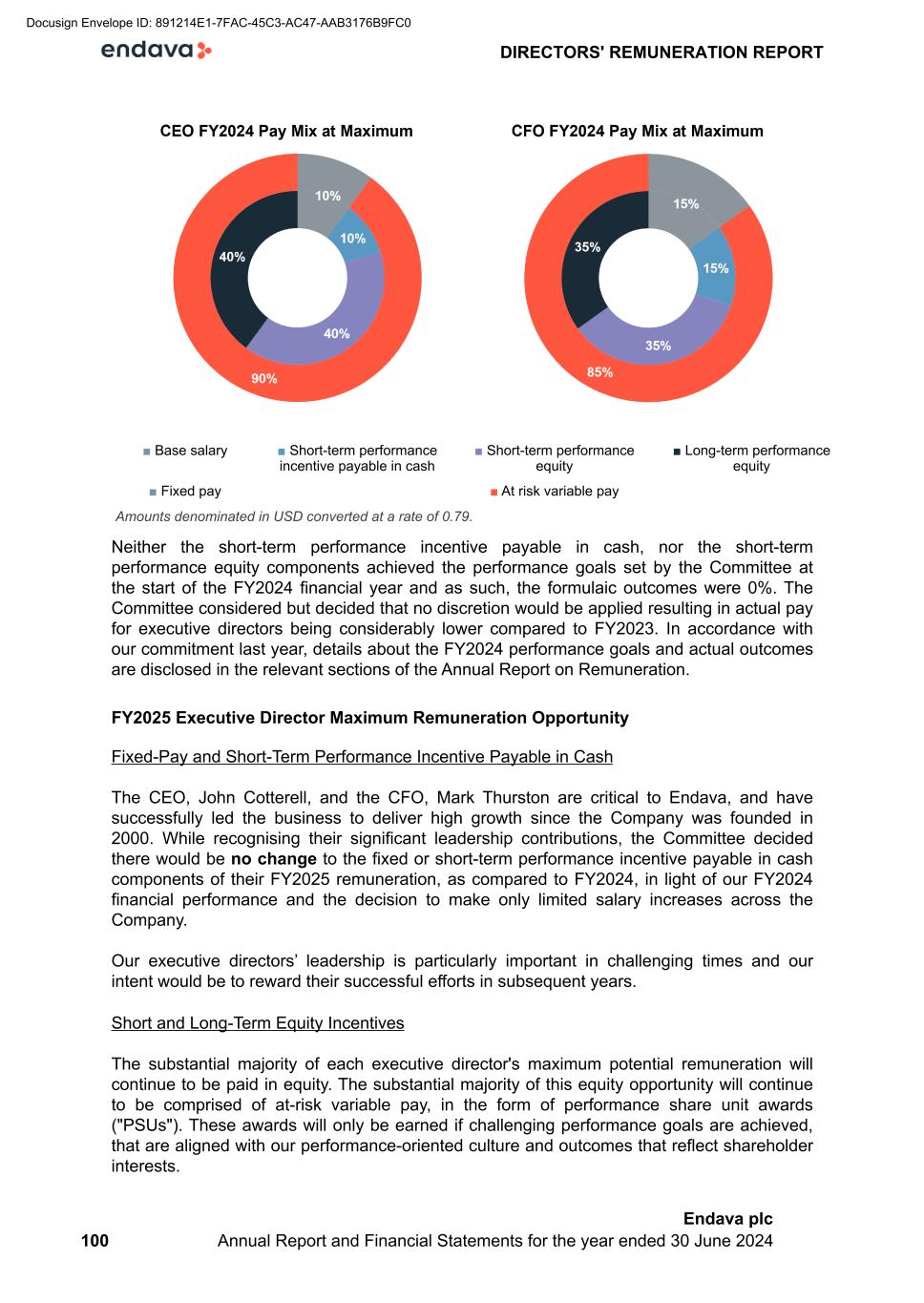
■ Base salary ■ Short-term performance incentive payable in cash ■ Short-term performance equity ■ Long-term performance equity ■ Fixed pay ■ At risk variable pay Amounts denominated in USD converted at a rate of 0.79. Neither the short-term performance incentive payable in cash, nor the short-term performance equity components achieved the performance goals set by the Committee at the start of the FY2024 financial year and as such, the formulaic outcomes were 0%. The Committee considered but decided that no discretion would be applied resulting in actual pay for executive directors being considerably lower compared to FY2023. In accordance with our commitment last year, details about the FY2024 performance goals and actual outcomes are disclosed in the relevant sections of the Annual Report on Remuneration. FY2025 Executive Director Maximum Remuneration Opportunity Fixed-Pay and Short-Term Performance Incentive Payable in Cash The CEO, John Cotterell, and the CFO, Mark Thurston are critical to Endava, and have successfully led the business to deliver high growth since the Company was founded in 2000. While recognising their significant leadership contributions, the Committee decided there would be no change to the fixed or short-term performance incentive payable in cash components of their FY2025 remuneration, as compared to FY2024, in light of our FY2024 financial performance and the decision to make only limited salary increases across the Company. Our executive directors’ leadership is particularly important in challenging times and our intent would be to reward their successful efforts in subsequent years. Short and Long-Term Equity Incentives The substantial majority of each executive director's maximum potential remuneration will continue to be paid in equity. The substantial majority of this equity opportunity will continue to be comprised of at-risk variable pay, in the form of performance share unit awards ("PSUs"). These awards will only be earned if challenging performance goals are achieved, that are aligned with our performance-oriented culture and outcomes that reflect shareholder interests. DIRECTORS' REMUNERATION REPORT 100 Endava plc Annual Report and Financial Statements for the year ended 30 June 2024 Docusign Envelope ID: 891214E1-7FAC-45C3-AC47-AAB3176B9FC0

As described below, for FY2025 we will make one change to remuneration components – a relatively small portion of equity incentive will be granted as long-term service equity, in the form of RSUs. Further, we will make one change to the measurement weighting for the long-term performance equity component. The FY2025 maximum equity incentive opportunity for each executive director, compared to FY2024, is below, and a detailed description of the FY2025 changes follows. Long-Term Service Equity Observing various remuneration market competitiveness trends, the Committee recommended to the Board that a long-term service equity award in the form of RSUs, be introduced for executive directors in FY2025. Given their reduced risk profile, the RSUs will be granted at a 50% discount from the previously issued FY2024 PSU award face value. The RSUs will vest annually in equal tranches over three years, subject to continued employment, with the first tranche vesting in October 2025. In accordance with our Remuneration Policy and UK-based investors' and proxy advisors' expectations, the Committee will also apply a performance underpin before releasing the shares each year, considering a range of quantitative and qualitative performance factors. The following influenced our decision to introduce long-term service equity RSUs: ▪ Over 80% of both our industry and founder peers provide service-vested equity without any attached performance conditions. ▪ While relatively uncommon in UK Plcs (but an acknowledged trend), service equity RSUs are widely observed across US industries. ▪ In contrast, we did not have service equity, resulting in a performance percentage of pay substantially exceeding our peers (in FY2024 90% and 85% of pay was performance- based for our CEO and CFO respectively, refer to graphic on page 100). ▪ RSUs somewhat mitigate the potential retention risk associated with long-term performance goals in challenging environments ▪ RSUs were introduced in FY2025 for other Endavans on a more generous basis than for Executive Directors. DIRECTORS' REMUNERATION REPORT 101 Endava plc Annual Report and Financial Statements for the year ended 30 June 2024 Docusign Envelope ID: 891214E1-7FAC-45C3-AC47-AAB3176B9FC0
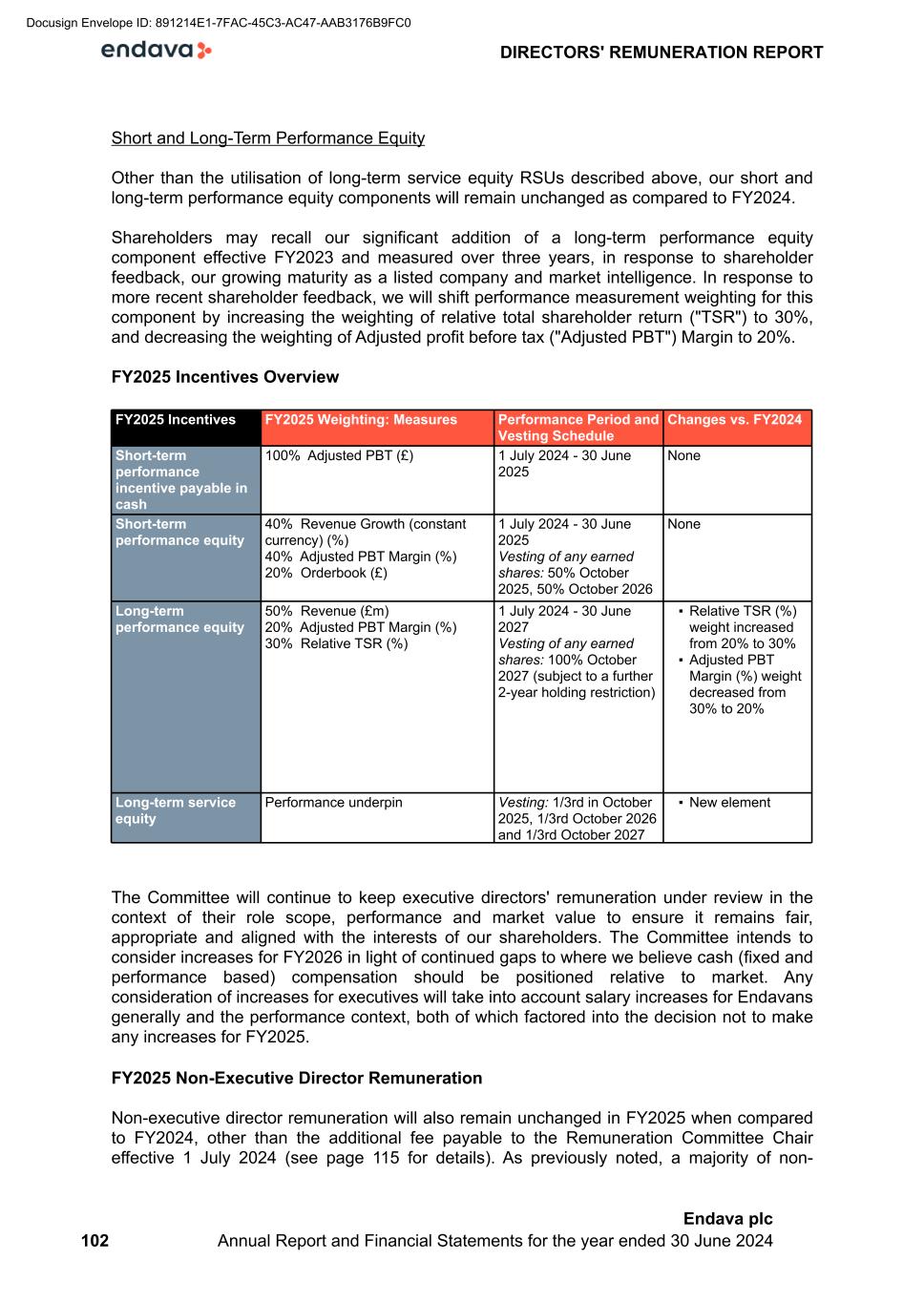
Short and Long-Term Performance Equity Other than the utilisation of long-term service equity RSUs described above, our short and long-term performance equity components will remain unchanged as compared to FY2024. Shareholders may recall our significant addition of a long-term performance equity component effective FY2023 and measured over three years, in response to shareholder feedback, our growing maturity as a listed company and market intelligence. In response to more recent shareholder feedback, we will shift performance measurement weighting for this component by increasing the weighting of relative total shareholder return ("TSR") to 30%, and decreasing the weighting of Adjusted profit before tax ("Adjusted PBT") Margin to 20%. FY2025 Incentives Overview FY2025 Incentives FY2025 Weighting: Measures Performance Period and Vesting Schedule Changes vs. FY2024 Short-term performance incentive payable in cash 100% Adjusted PBT (£) 1 July 2024 - 30 June 2025 None Short-term performance equity 40% Revenue Growth (constant currency) (%) 40% Adjusted PBT Margin (%) 20% Orderbook (£) 1 July 2024 - 30 June 2025 Vesting of any earned shares: 50% October 2025, 50% October 2026 None Long-term performance equity 50% Revenue (£m) 20% Adjusted PBT Margin (%) 30% Relative TSR (%) 1 July 2024 - 30 June 2027 Vesting of any earned shares: 100% October 2027 (subject to a further 2-year holding restriction) ▪ Relative TSR (%) weight increased from 20% to 30% ▪ Adjusted PBT Margin (%) weight decreased from 30% to 20% Long-term service equity Performance underpin Vesting: 1/3rd in October 2025, 1/3rd October 2026 and 1/3rd October 2027 ▪ New element The Committee will continue to keep executive directors' remuneration under review in the context of their role scope, performance and market value to ensure it remains fair, appropriate and aligned with the interests of our shareholders. The Committee intends to consider increases for FY2026 in light of continued gaps to where we believe cash (fixed and performance based) compensation should be positioned relative to market. Any consideration of increases for executives will take into account salary increases for Endavans generally and the performance context, both of which factored into the decision not to make any increases for FY2025. FY2025 Non-Executive Director Remuneration Non-executive director remuneration will also remain unchanged in FY2025 when compared to FY2024, other than the additional fee payable to the Remuneration Committee Chair effective 1 July 2024 (see page 115 for details). As previously noted, a majority of non- DIRECTORS' REMUNERATION REPORT 102 Endava plc Annual Report and Financial Statements for the year ended 30 June 2024 Docusign Envelope ID: 891214E1-7FAC-45C3-AC47-AAB3176B9FC0
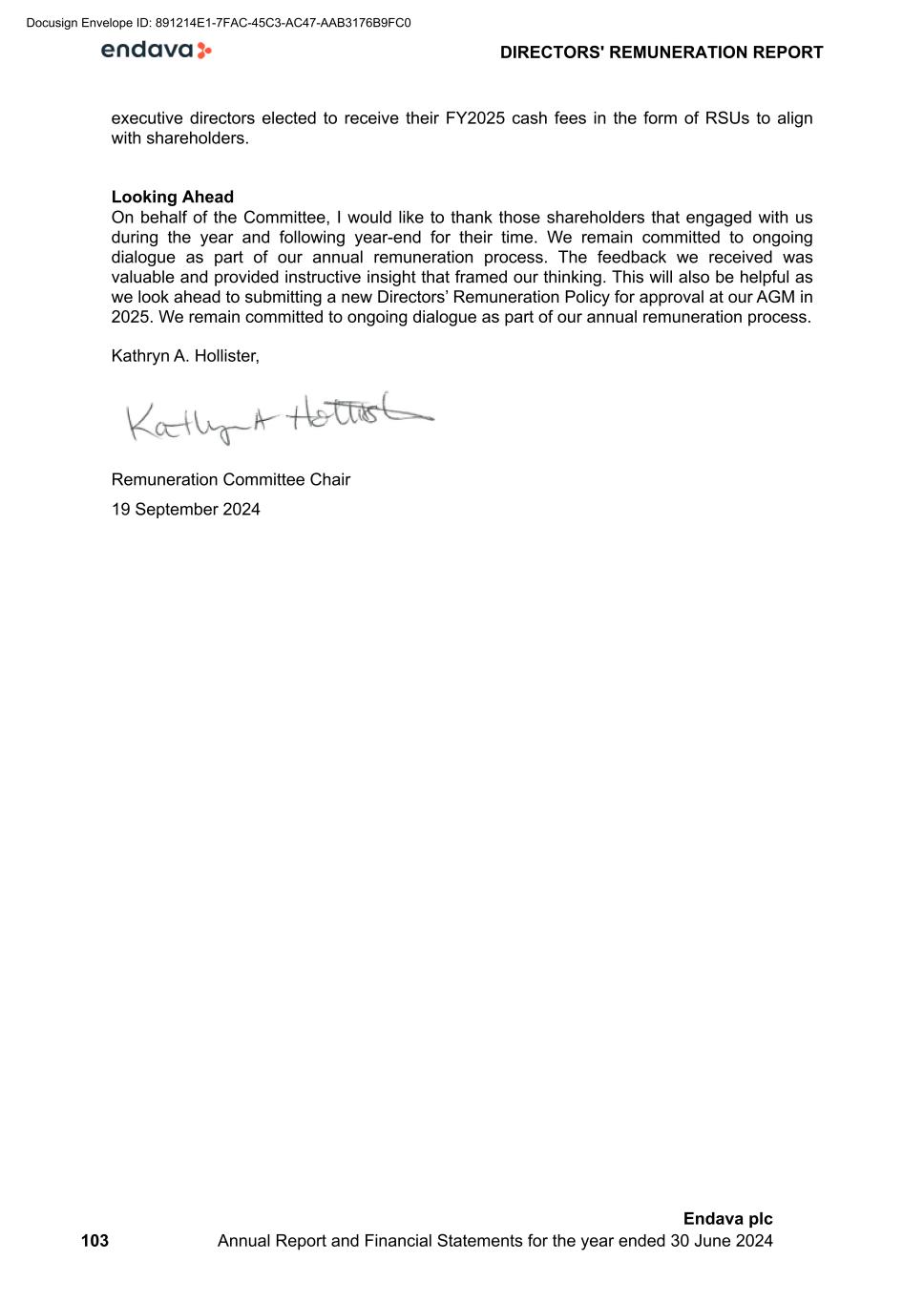
executive directors elected to receive their FY2025 cash fees in the form of RSUs to align with shareholders. Looking Ahead On behalf of the Committee, I would like to thank those shareholders that engaged with us during the year and following year-end for their time. We remain committed to ongoing dialogue as part of our annual remuneration process. The feedback we received was valuable and provided instructive insight that framed our thinking. This will also be helpful as we look ahead to submitting a new Directors’ Remuneration Policy for approval at our AGM in 2025. We remain committed to ongoing dialogue as part of our annual remuneration process. Kathryn A. Hollister, Remuneration Committee Chair 19 September 2024 DIRECTORS' REMUNERATION REPORT 103 Endava plc Annual Report and Financial Statements for the year ended 30 June 2024 Docusign Envelope ID: 891214E1-7FAC-45C3-AC47-AAB3176B9FC0
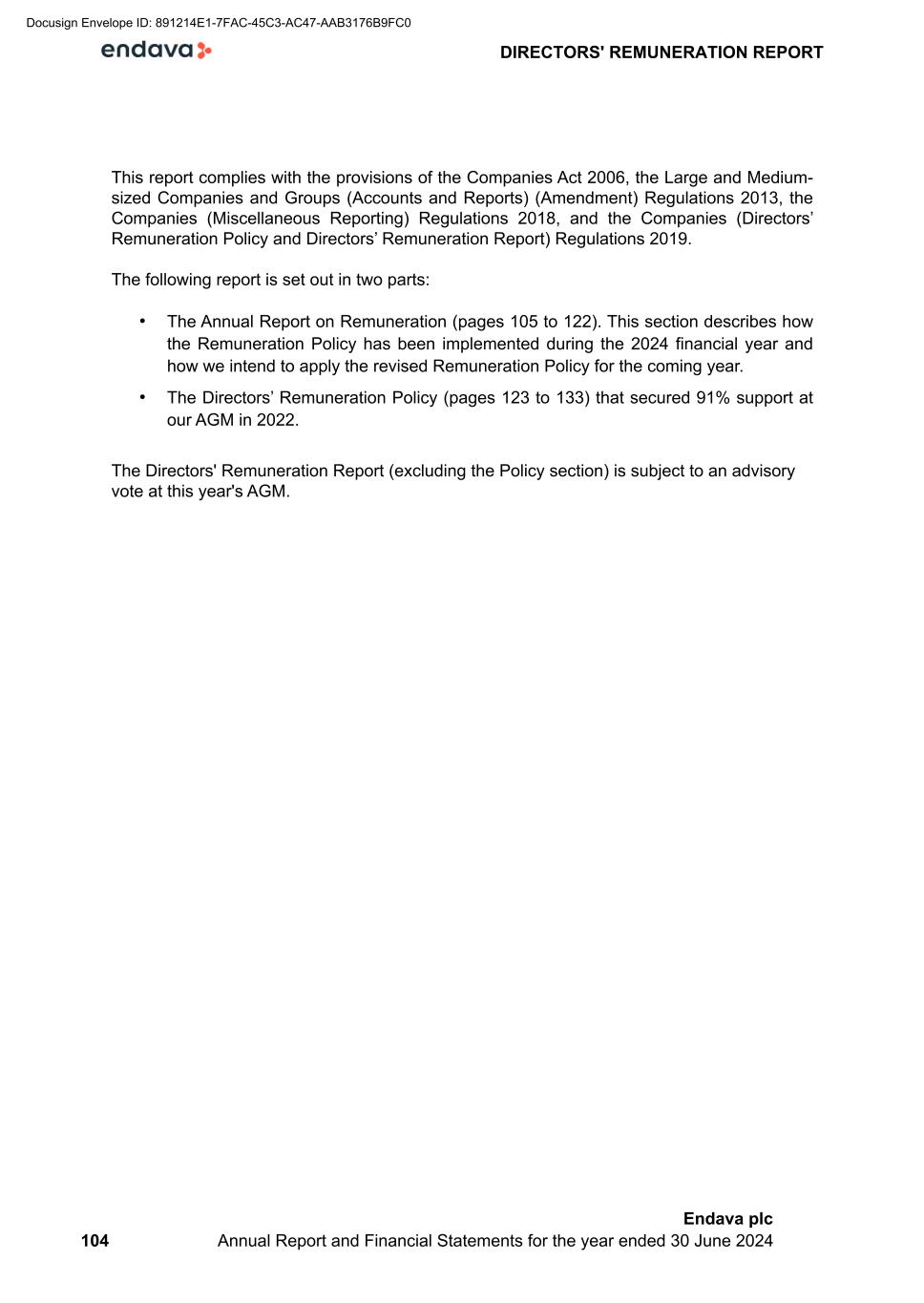
This report complies with the provisions of the Companies Act 2006, the Large and Medium- sized Companies and Groups (Accounts and Reports) (Amendment) Regulations 2013, the Companies (Miscellaneous Reporting) Regulations 2018, and the Companies (Directors’ Remuneration Policy and Directors’ Remuneration Report) Regulations 2019. The following report is set out in two parts: • The Annual Report on Remuneration (pages 105 to 122). This section describes how the Remuneration Policy has been implemented during the 2024 financial year and how we intend to apply the revised Remuneration Policy for the coming year. • The Directors’ Remuneration Policy (pages 123 to 133) that secured 91% support at our AGM in 2022. The Directors' Remuneration Report (excluding the Policy section) is subject to an advisory vote at this year's AGM. DIRECTORS' REMUNERATION REPORT 104 Endava plc Annual Report and Financial Statements for the year ended 30 June 2024 Docusign Envelope ID: 891214E1-7FAC-45C3-AC47-AAB3176B9FC0
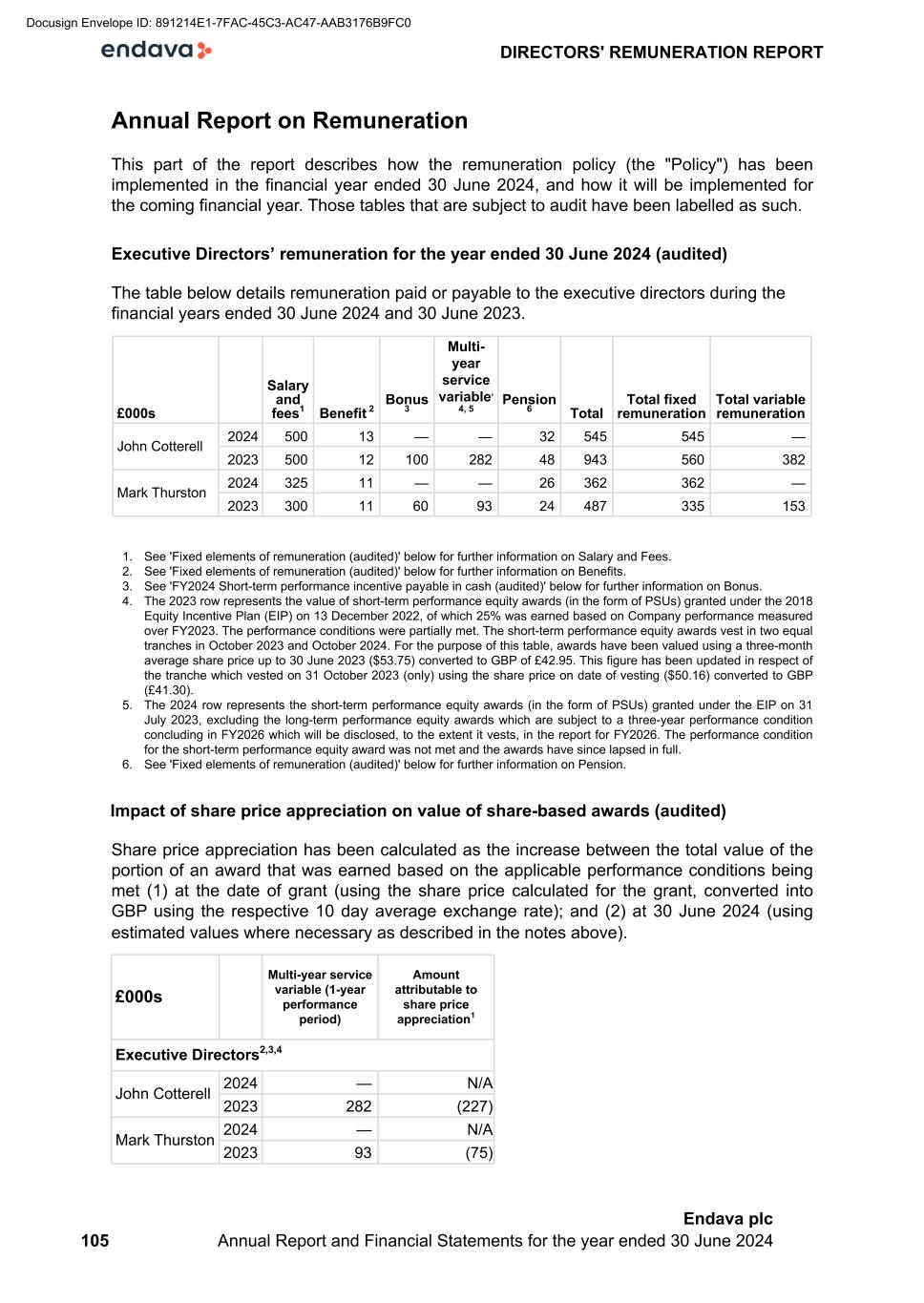
Annual Report on Remuneration This part of the report describes how the remuneration policy (the "Policy") has been implemented in the financial year ended 30 June 2024, and how it will be implemented for the coming financial year. Those tables that are subject to audit have been labelled as such. Executive Directors’ remuneration for the year ended 30 June 2024 (audited) The table below details remuneration paid or payable to the executive directors during the financial years ended 30 June 2024 and 30 June 2023. £000s Salary and fees1 Benefit 2 Bonus 3 Multi- year service variable, 4, 5 Pension 6 Total Total fixed remuneration Total variable remuneration John Cotterell 2024 500 13 — — 32 545 545 — 2023 500 12 100 282 48 943 560 382 Mark Thurston 2024 325 11 — — 26 362 362 — 2023 300 11 60 93 24 487 335 153 1. See 'Fixed elements of remuneration (audited)' below for further information on Salary and Fees. 2. See 'Fixed elements of remuneration (audited)' below for further information on Benefits. 3. See 'FY2024 Short-term performance incentive payable in cash (audited)' below for further information on Bonus. 4. The 2023 row represents the value of short-term performance equity awards (in the form of PSUs) granted under the 2018 Equity Incentive Plan (EIP) on 13 December 2022, of which 25% was earned based on Company performance measured over FY2023. The performance conditions were partially met. The short-term performance equity awards vest in two equal tranches in October 2023 and October 2024. For the purpose of this table, awards have been valued using a three-month average share price up to 30 June 2023 ($53.75) converted to GBP of £42.95. This figure has been updated in respect of the tranche which vested on 31 October 2023 (only) using the share price on date of vesting ($50.16) converted to GBP (£41.30). 5. The 2024 row represents the short-term performance equity awards (in the form of PSUs) granted under the EIP on 31 July 2023, excluding the long-term performance equity awards which are subject to a three-year performance condition concluding in FY2026 which will be disclosed, to the extent it vests, in the report for FY2026. The performance condition for the short-term performance equity award was not met and the awards have since lapsed in full. 6. See 'Fixed elements of remuneration (audited)' below for further information on Pension. Impact of share price appreciation on value of share-based awards (audited) Share price appreciation has been calculated as the increase between the total value of the portion of an award that was earned based on the applicable performance conditions being met (1) at the date of grant (using the share price calculated for the grant, converted into GBP using the respective 10 day average exchange rate); and (2) at 30 June 2024 (using estimated values where necessary as described in the notes above). £000s Multi-year service variable (1-year performance period) Amount attributable to share price appreciation1 Executive Directors2,3,4 John Cotterell 2024 — N/A 2023 282 (227) Mark Thurston 2024 — N/A 2023 93 (75) DIRECTORS' REMUNERATION REPORT 105 Endava plc Annual Report and Financial Statements for the year ended 30 June 2024 Docusign Envelope ID: 891214E1-7FAC-45C3-AC47-AAB3176B9FC0
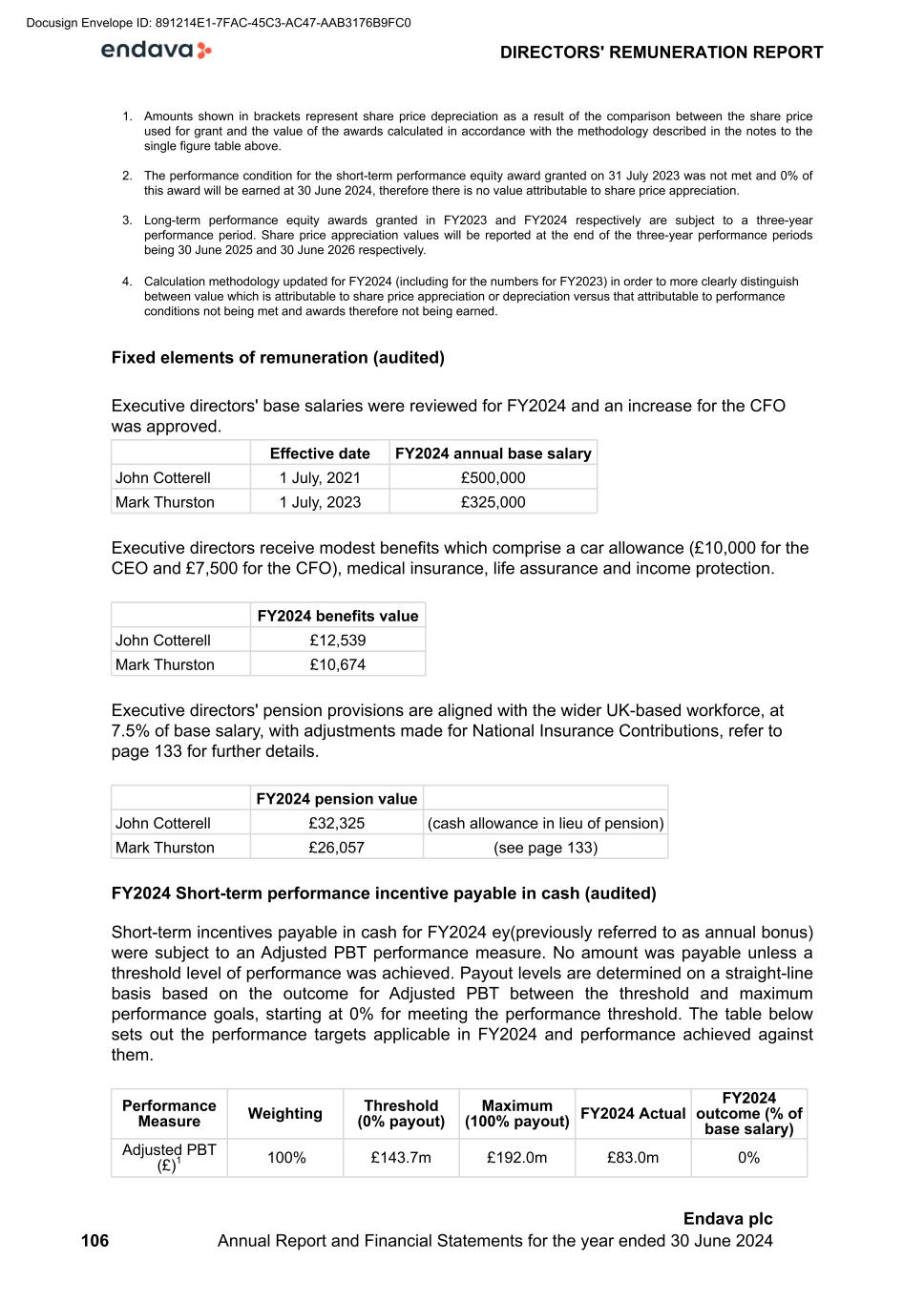
1. Amounts shown in brackets represent share price depreciation as a result of the comparison between the share price used for grant and the value of the awards calculated in accordance with the methodology described in the notes to the single figure table above. 2. The performance condition for the short-term performance equity award granted on 31 July 2023 was not met and 0% of this award will be earned at 30 June 2024, therefore there is no value attributable to share price appreciation. 3. Long-term performance equity awards granted in FY2023 and FY2024 respectively are subject to a three-year performance period. Share price appreciation values will be reported at the end of the three-year performance periods being 30 June 2025 and 30 June 2026 respectively. 4. Calculation methodology updated for FY2024 (including for the numbers for FY2023) in order to more clearly distinguish between value which is attributable to share price appreciation or depreciation versus that attributable to performance conditions not being met and awards therefore not being earned. Fixed elements of remuneration (audited) Executive directors' base salaries were reviewed for FY2024 and an increase for the CFO was approved. Effective date FY2024 annual base salary John Cotterell 1 July, 2021 £500,000 Mark Thurston 1 July, 2023 £325,000 Executive directors receive modest benefits which comprise a car allowance (£10,000 for the CEO and £7,500 for the CFO), medical insurance, life assurance and income protection. FY2024 benefits value John Cotterell £12,539 Mark Thurston £10,674 Executive directors' pension provisions are aligned with the wider UK-based workforce, at 7.5% of base salary, with adjustments made for National Insurance Contributions, refer to page 133 for further details. FY2024 pension value John Cotterell £32,325 (cash allowance in lieu of pension) Mark Thurston £26,057 (see page 133) FY2024 Short-term performance incentive payable in cash (audited) Short-term incentives payable in cash for FY2024 ey(previously referred to as annual bonus) were subject to an Adjusted PBT performance measure. No amount was payable unless a threshold level of performance was achieved. Payout levels are determined on a straight-line basis based on the outcome for Adjusted PBT between the threshold and maximum performance goals, starting at 0% for meeting the performance threshold. The table below sets out the performance targets applicable in FY2024 and performance achieved against them. Performance Measure Weighting Threshold (0% payout) Maximum (100% payout) FY2024 Actual FY2024 outcome (% of base salary) Adjusted PBT (£)1 100% £143.7m £192.0m £83.0m 0% DIRECTORS' REMUNERATION REPORT 106 Endava plc Annual Report and Financial Statements for the year ended 30 June 2024 Docusign Envelope ID: 891214E1-7FAC-45C3-AC47-AAB3176B9FC0
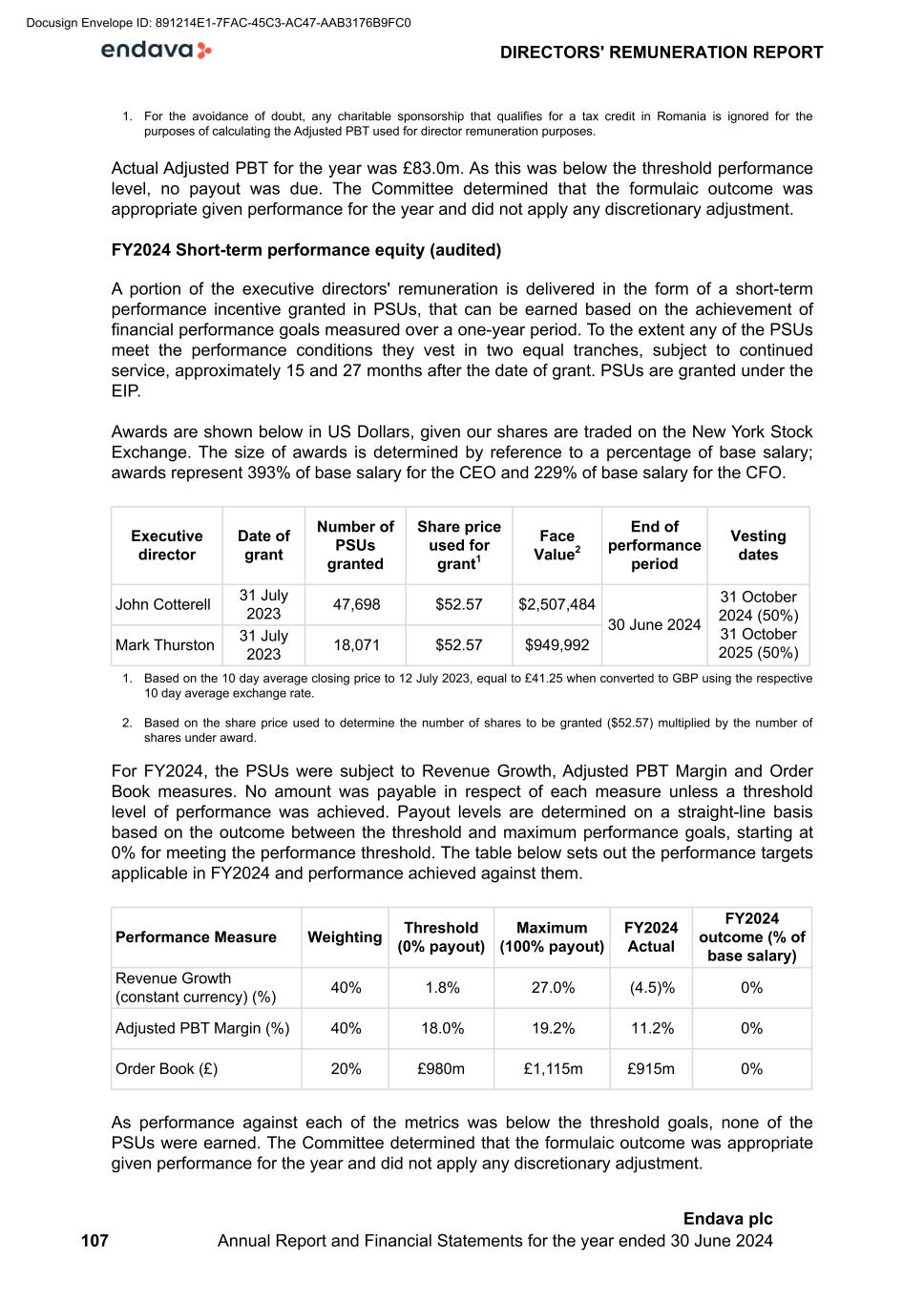
1. For the avoidance of doubt, any charitable sponsorship that qualifies for a tax credit in Romania is ignored for the purposes of calculating the Adjusted PBT used for director remuneration purposes. Actual Adjusted PBT for the year was £83.0m. As this was below the threshold performance level, no payout was due. The Committee determined that the formulaic outcome was appropriate given performance for the year and did not apply any discretionary adjustment. FY2024 Short-term performance equity (audited) A portion of the executive directors' remuneration is delivered in the form of a short-term performance incentive granted in PSUs, that can be earned based on the achievement of financial performance goals measured over a one-year period. To the extent any of the PSUs meet the performance conditions they vest in two equal tranches, subject to continued service, approximately 15 and 27 months after the date of grant. PSUs are granted under the EIP. Awards are shown below in US Dollars, given our shares are traded on the New York Stock Exchange. The size of awards is determined by reference to a percentage of base salary; awards represent 393% of base salary for the CEO and 229% of base salary for the CFO. Executive director Date of grant Number of PSUs granted Share price used for grant1 Face Value2 End of performance period Vesting dates John Cotterell 31 July 2023 47,698 $52.57 $2,507,484 30 June 2024 31 October 2024 (50%) 31 October 2025 (50%)Mark Thurston 31 July 2023 18,071 $52.57 $949,992 1. Based on the 10 day average closing price to 12 July 2023, equal to £41.25 when converted to GBP using the respective 10 day average exchange rate. 2. Based on the share price used to determine the number of shares to be granted ($52.57) multiplied by the number of shares under award. For FY2024, the PSUs were subject to Revenue Growth, Adjusted PBT Margin and Order Book measures. No amount was payable in respect of each measure unless a threshold level of performance was achieved. Payout levels are determined on a straight-line basis based on the outcome between the threshold and maximum performance goals, starting at 0% for meeting the performance threshold. The table below sets out the performance targets applicable in FY2024 and performance achieved against them. Performance Measure Weighting Threshold (0% payout) Maximum (100% payout) FY2024 Actual FY2024 outcome (% of base salary) Revenue Growth (constant currency) (%) 40% 1.8% 27.0% (4.5)% 0% Adjusted PBT Margin (%) 40% 18.0% 19.2% 11.2% 0% Order Book (£) 20% £980m £1,115m £915m 0% As performance against each of the metrics was below the threshold goals, none of the PSUs were earned. The Committee determined that the formulaic outcome was appropriate given performance for the year and did not apply any discretionary adjustment. DIRECTORS' REMUNERATION REPORT 107 Endava plc Annual Report and Financial Statements for the year ended 30 June 2024 Docusign Envelope ID: 891214E1-7FAC-45C3-AC47-AAB3176B9FC0
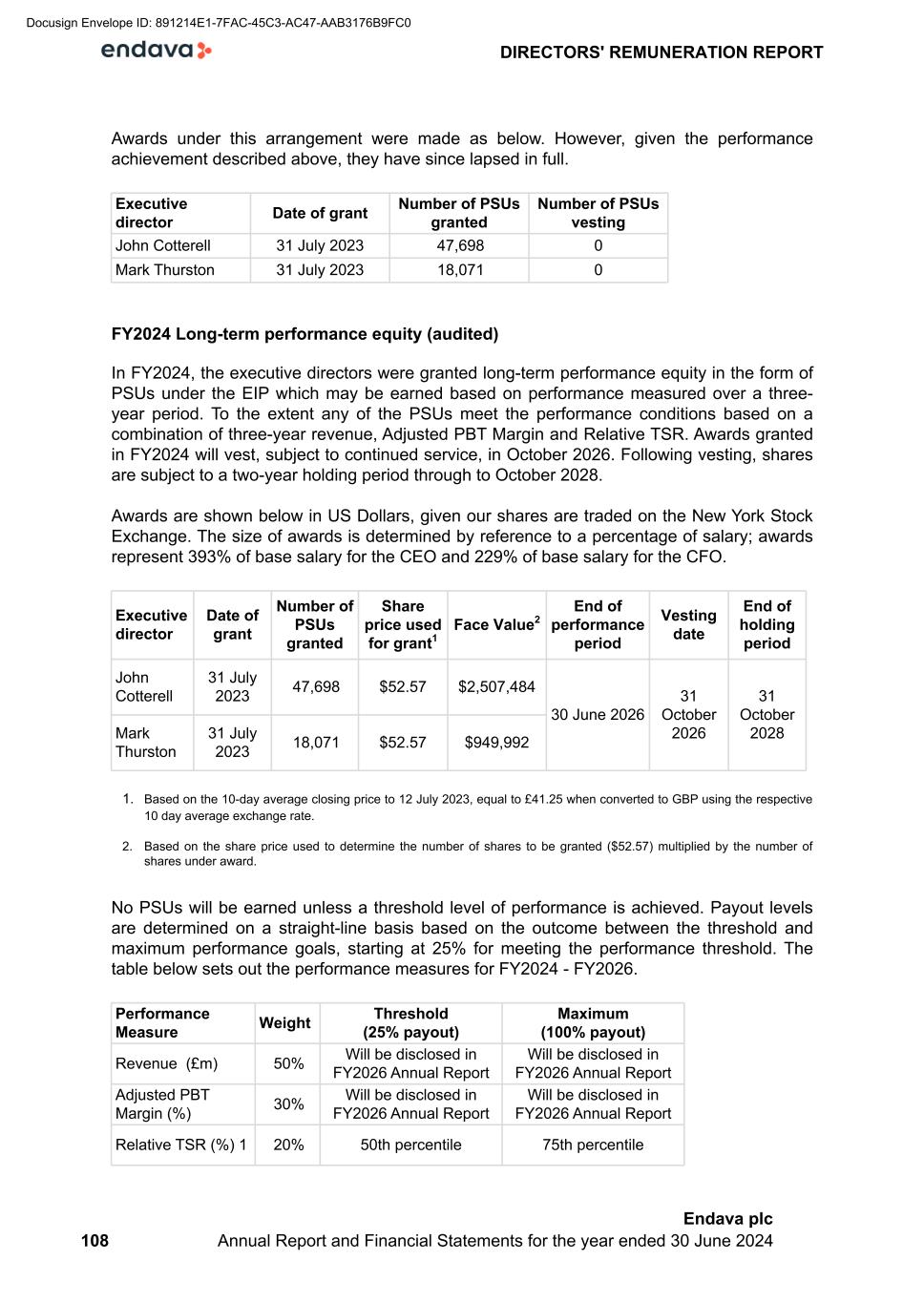
Awards under this arrangement were made as below. However, given the performance achievement described above, they have since lapsed in full. Executive director Date of grant Number of PSUs granted Number of PSUs vesting John Cotterell 31 July 2023 47,698 0 Mark Thurston 31 July 2023 18,071 0 FY2024 Long-term performance equity (audited) In FY2024, the executive directors were granted long-term performance equity in the form of PSUs under the EIP which may be earned based on performance measured over a three- year period. To the extent any of the PSUs meet the performance conditions based on a combination of three-year revenue, Adjusted PBT Margin and Relative TSR. Awards granted in FY2024 will vest, subject to continued service, in October 2026. Following vesting, shares are subject to a two-year holding period through to October 2028. Awards are shown below in US Dollars, given our shares are traded on the New York Stock Exchange. The size of awards is determined by reference to a percentage of salary; awards represent 393% of base salary for the CEO and 229% of base salary for the CFO. Executive director Date of grant Number of PSUs granted Share price used for grant1 Face Value2 End of performance period Vesting date End of holding period John Cotterell 31 July 2023 47,698 $52.57 $2,507,484 30 June 2026 31 October 2026 31 October 2028Mark Thurston 31 July 2023 18,071 $52.57 $949,992 1. Based on the 10-day average closing price to 12 July 2023, equal to £41.25 when converted to GBP using the respective 10 day average exchange rate. 2. Based on the share price used to determine the number of shares to be granted ($52.57) multiplied by the number of shares under award. No PSUs will be earned unless a threshold level of performance is achieved. Payout levels are determined on a straight-line basis based on the outcome between the threshold and maximum performance goals, starting at 25% for meeting the performance threshold. The table below sets out the performance measures for FY2024 - FY2026. Performance Measure Weight Threshold (25% payout) Maximum (100% payout) Revenue (£m) 50% Will be disclosed in FY2026 Annual Report Will be disclosed in FY2026 Annual Report Adjusted PBT Margin (%) 30% Will be disclosed in FY2026 Annual Report Will be disclosed in FY2026 Annual Report Relative TSR (%) 1 20% 50th percentile 75th percentile DIRECTORS' REMUNERATION REPORT 108 Endava plc Annual Report and Financial Statements for the year ended 30 June 2024 Docusign Envelope ID: 891214E1-7FAC-45C3-AC47-AAB3176B9FC0
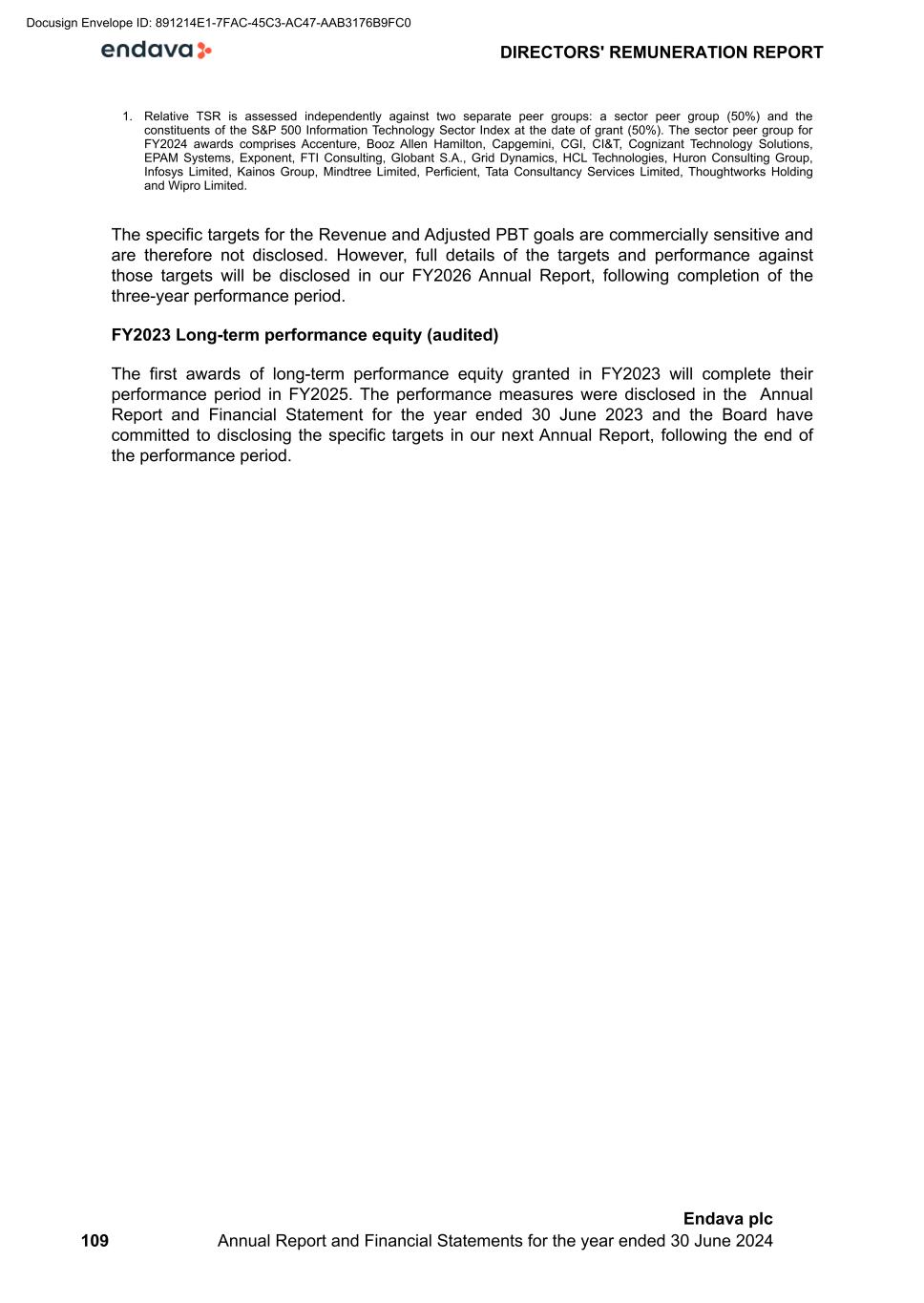
1. Relative TSR is assessed independently against two separate peer groups: a sector peer group (50%) and the constituents of the S&P 500 Information Technology Sector Index at the date of grant (50%). The sector peer group for FY2024 awards comprises Accenture, Booz Allen Hamilton, Capgemini, CGI, CI&T, Cognizant Technology Solutions, EPAM Systems, Exponent, FTI Consulting, Globant S.A., Grid Dynamics, HCL Technologies, Huron Consulting Group, Infosys Limited, Kainos Group, Mindtree Limited, Perficient, Tata Consultancy Services Limited, Thoughtworks Holding and Wipro Limited. The specific targets for the Revenue and Adjusted PBT goals are commercially sensitive and are therefore not disclosed. However, full details of the targets and performance against those targets will be disclosed in our FY2026 Annual Report, following completion of the three-year performance period. FY2023 Long-term performance equity (audited) The first awards of long-term performance equity granted in FY2023 will complete their performance period in FY2025. The performance measures were disclosed in the Annual Report and Financial Statement for the year ended 30 June 2023 and the Board have committed to disclosing the specific targets in our next Annual Report, following the end of the performance period. DIRECTORS' REMUNERATION REPORT 109 Endava plc Annual Report and Financial Statements for the year ended 30 June 2024 Docusign Envelope ID: 891214E1-7FAC-45C3-AC47-AAB3176B9FC0
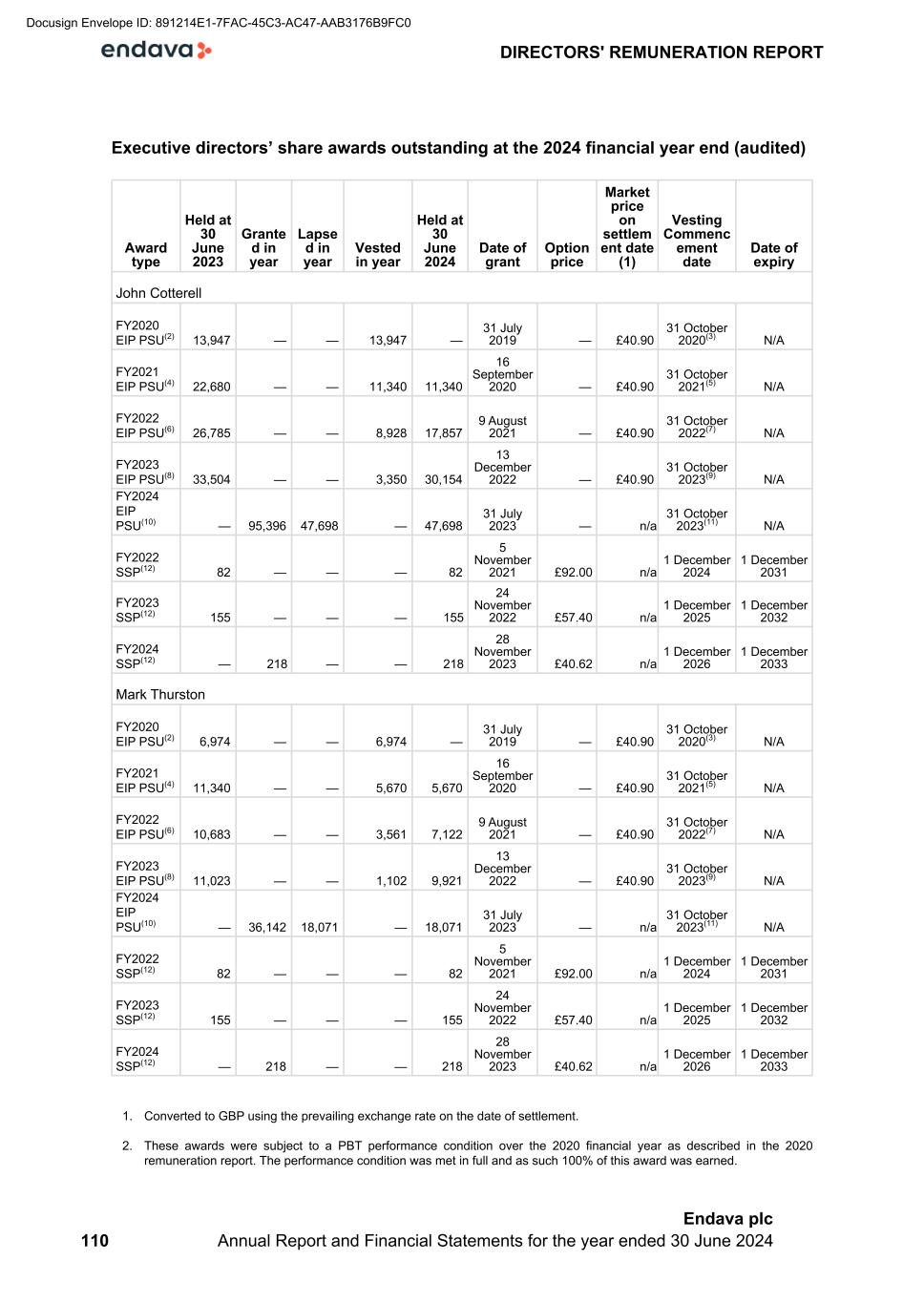
Executive directors’ share awards outstanding at the 2024 financial year end (audited) Award type Held at 30 June 2023 Grante d in year Lapse d in year Vested in year Held at 30 June 2024 Date of grant Option price Market price on settlem ent date (1) Vesting Commenc ement date Date of expiry John Cotterell FY2020 EIP PSU(2) 13,947 — — 13,947 — 31 July 2019 — £40.90 31 October 2020(3) N/A FY2021 EIP PSU(4) 22,680 — — 11,340 11,340 16 September 2020 — £40.90 31 October 2021(5) N/A FY2022 EIP PSU(6) 26,785 — — 8,928 17,857 9 August 2021 — £40.90 31 October 2022(7) N/A FY2023 EIP PSU(8) 33,504 — — 3,350 30,154 13 December 2022 — £40.90 31 October 2023(9) N/A FY2024 EIP PSU(10) — 95,396 47,698 — 47,698 31 July 2023 — n/a 31 October 2023(11) N/A FY2022 SSP(12) 82 — — — 82 5 November 2021 £92.00 n/a 1 December 2024 1 December 2031 FY2023 SSP(12) 155 — — — 155 24 November 2022 £57.40 n/a 1 December 2025 1 December 2032 FY2024 SSP(12) — 218 — — 218 28 November 2023 £40.62 n/a 1 December 2026 1 December 2033 Mark Thurston FY2020 EIP PSU(2) 6,974 — — 6,974 — 31 July 2019 — £40.90 31 October 2020(3) N/A FY2021 EIP PSU(4) 11,340 — — 5,670 5,670 16 September 2020 — £40.90 31 October 2021(5) N/A FY2022 EIP PSU(6) 10,683 — — 3,561 7,122 9 August 2021 — £40.90 31 October 2022(7) N/A FY2023 EIP PSU(8) 11,023 — — 1,102 9,921 13 December 2022 — £40.90 31 October 2023(9) N/A FY2024 EIP PSU(10) — 36,142 18,071 — 18,071 31 July 2023 — n/a 31 October 2023(11) N/A FY2022 SSP(12) 82 — — — 82 5 November 2021 £92.00 n/a 1 December 2024 1 December 2031 FY2023 SSP(12) 155 — — — 155 24 November 2022 £57.40 n/a 1 December 2025 1 December 2032 FY2024 SSP(12) — 218 — — 218 28 November 2023 £40.62 n/a 1 December 2026 1 December 2033 1. Converted to GBP using the prevailing exchange rate on the date of settlement. 2. These awards were subject to a PBT performance condition over the 2020 financial year as described in the 2020 remuneration report. The performance condition was met in full and as such 100% of this award was earned. DIRECTORS' REMUNERATION REPORT 110 Endava plc Annual Report and Financial Statements for the year ended 30 June 2024 Docusign Envelope ID: 891214E1-7FAC-45C3-AC47-AAB3176B9FC0
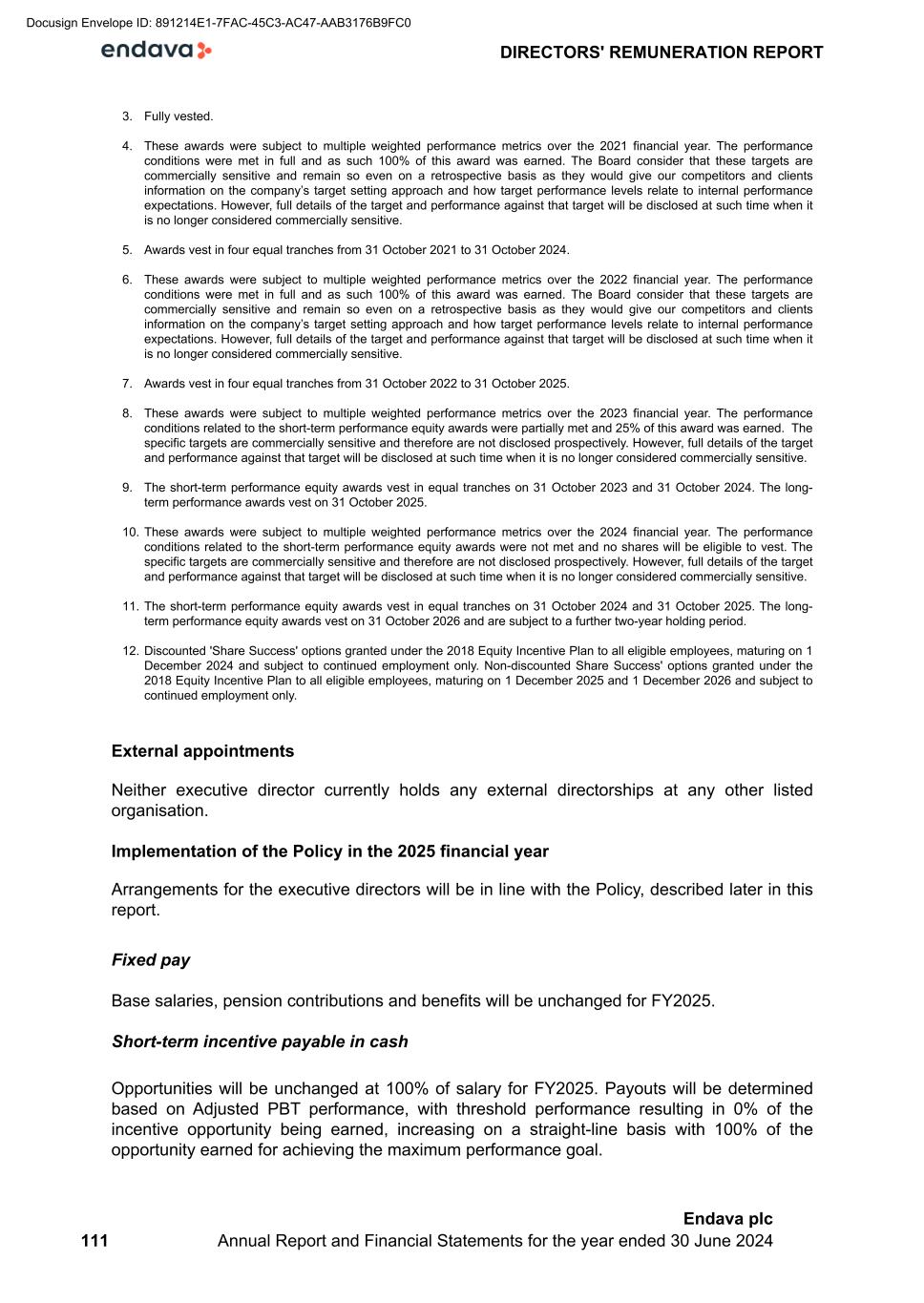
3. Fully vested. 4. These awards were subject to multiple weighted performance metrics over the 2021 financial year. The performance conditions were met in full and as such 100% of this award was earned. The Board consider that these targets are commercially sensitive and remain so even on a retrospective basis as they would give our competitors and clients information on the company’s target setting approach and how target performance levels relate to internal performance expectations. However, full details of the target and performance against that target will be disclosed at such time when it is no longer considered commercially sensitive. 5. Awards vest in four equal tranches from 31 October 2021 to 31 October 2024. 6. These awards were subject to multiple weighted performance metrics over the 2022 financial year. The performance conditions were met in full and as such 100% of this award was earned. The Board consider that these targets are commercially sensitive and remain so even on a retrospective basis as they would give our competitors and clients information on the company’s target setting approach and how target performance levels relate to internal performance expectations. However, full details of the target and performance against that target will be disclosed at such time when it is no longer considered commercially sensitive. 7. Awards vest in four equal tranches from 31 October 2022 to 31 October 2025. 8. These awards were subject to multiple weighted performance metrics over the 2023 financial year. The performance conditions related to the short-term performance equity awards were partially met and 25% of this award was earned. The specific targets are commercially sensitive and therefore are not disclosed prospectively. However, full details of the target and performance against that target will be disclosed at such time when it is no longer considered commercially sensitive. 9. The short-term performance equity awards vest in equal tranches on 31 October 2023 and 31 October 2024. The long- term performance awards vest on 31 October 2025. 10. These awards were subject to multiple weighted performance metrics over the 2024 financial year. The performance conditions related to the short-term performance equity awards were not met and no shares will be eligible to vest. The specific targets are commercially sensitive and therefore are not disclosed prospectively. However, full details of the target and performance against that target will be disclosed at such time when it is no longer considered commercially sensitive. 11. The short-term performance equity awards vest in equal tranches on 31 October 2024 and 31 October 2025. The long- term performance equity awards vest on 31 October 2026 and are subject to a further two-year holding period. 12. Discounted 'Share Success' options granted under the 2018 Equity Incentive Plan to all eligible employees, maturing on 1 December 2024 and subject to continued employment only. Non-discounted Share Success' options granted under the 2018 Equity Incentive Plan to all eligible employees, maturing on 1 December 2025 and 1 December 2026 and subject to continued employment only. External appointments Neither executive director currently holds any external directorships at any other listed organisation. Implementation of the Policy in the 2025 financial year Arrangements for the executive directors will be in line with the Policy, described later in this report. Fixed pay Base salaries, pension contributions and benefits will be unchanged for FY2025. Short-term incentive payable in cash Opportunities will be unchanged at 100% of salary for FY2025. Payouts will be determined based on Adjusted PBT performance, with threshold performance resulting in 0% of the incentive opportunity being earned, increasing on a straight-line basis with 100% of the opportunity earned for achieving the maximum performance goal. DIRECTORS' REMUNERATION REPORT 111 Endava plc Annual Report and Financial Statements for the year ended 30 June 2024 Docusign Envelope ID: 891214E1-7FAC-45C3-AC47-AAB3176B9FC0
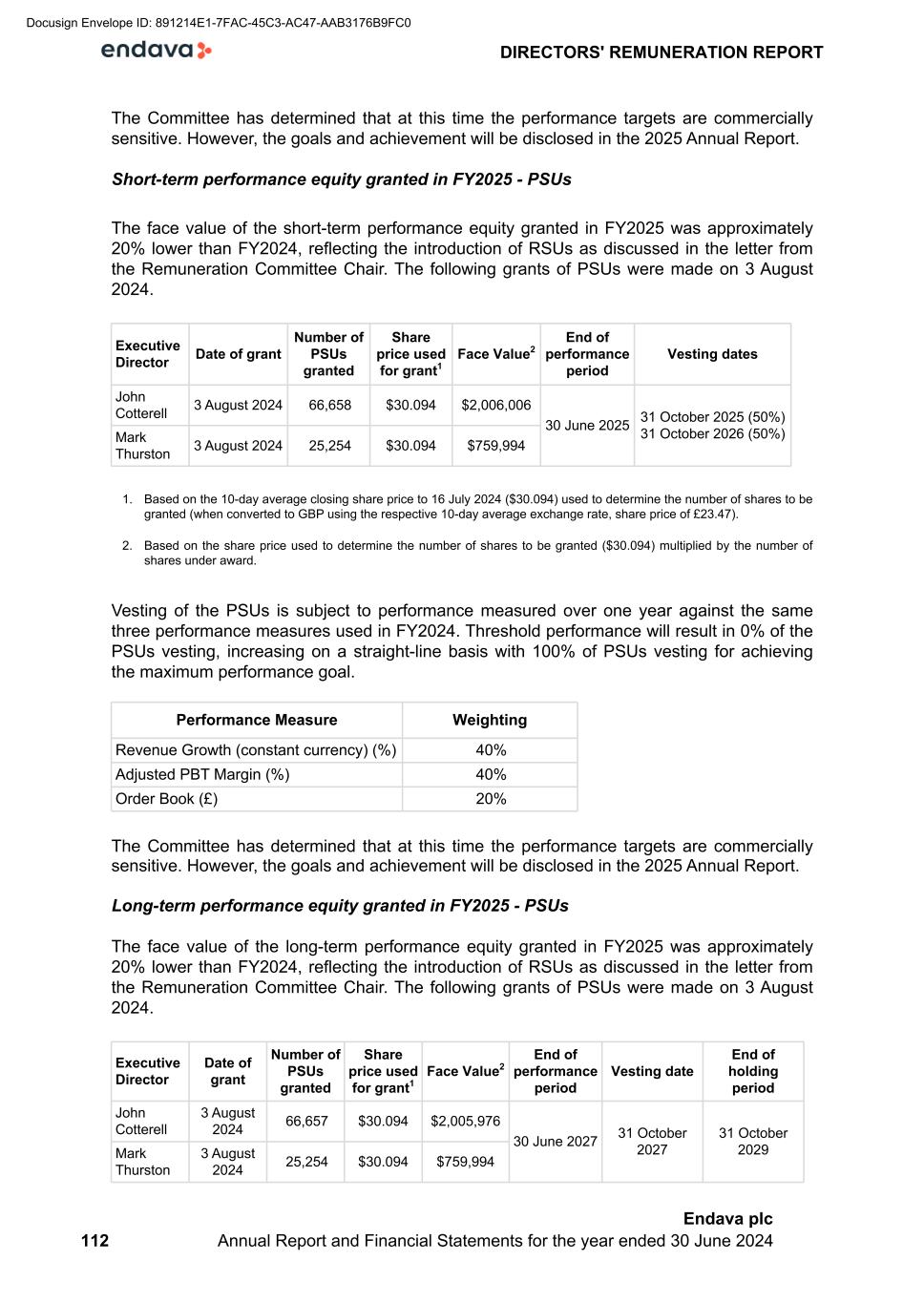
The Committee has determined that at this time the performance targets are commercially sensitive. However, the goals and achievement will be disclosed in the 2025 Annual Report. Short-term performance equity granted in FY2025 - PSUs The face value of the short-term performance equity granted in FY2025 was approximately 20% lower than FY2024, reflecting the introduction of RSUs as discussed in the letter from the Remuneration Committee Chair. The following grants of PSUs were made on 3 August 2024. Executive Director Date of grant Number of PSUs granted Share price used for grant1 Face Value2 End of performance period Vesting dates John Cotterell 3 August 2024 66,658 $30.094 $2,006,006 30 June 2025 31 October 2025 (50%) 31 October 2026 (50%)Mark Thurston 3 August 2024 25,254 $30.094 $759,994 1. Based on the 10-day average closing share price to 16 July 2024 ($30.094) used to determine the number of shares to be granted (when converted to GBP using the respective 10-day average exchange rate, share price of £23.47). 2. Based on the share price used to determine the number of shares to be granted ($30.094) multiplied by the number of shares under award. Vesting of the PSUs is subject to performance measured over one year against the same three performance measures used in FY2024. Threshold performance will result in 0% of the PSUs vesting, increasing on a straight-line basis with 100% of PSUs vesting for achieving the maximum performance goal. Performance Measure Weighting Revenue Growth (constant currency) (%) 40% Adjusted PBT Margin (%) 40% Order Book (£) 20% The Committee has determined that at this time the performance targets are commercially sensitive. However, the goals and achievement will be disclosed in the 2025 Annual Report. Long-term performance equity granted in FY2025 - PSUs The face value of the long-term performance equity granted in FY2025 was approximately 20% lower than FY2024, reflecting the introduction of RSUs as discussed in the letter from the Remuneration Committee Chair. The following grants of PSUs were made on 3 August 2024. Executive Director Date of grant Number of PSUs granted Share price used for grant1 Face Value2 End of performance period Vesting date End of holding period John Cotterell 3 August 2024 66,657 $30.094 $2,005,976 30 June 2027 31 October 2027 31 October 2029Mark Thurston 3 August 2024 25,254 $30.094 $759,994 DIRECTORS' REMUNERATION REPORT 112 Endava plc Annual Report and Financial Statements for the year ended 30 June 2024 Docusign Envelope ID: 891214E1-7FAC-45C3-AC47-AAB3176B9FC0
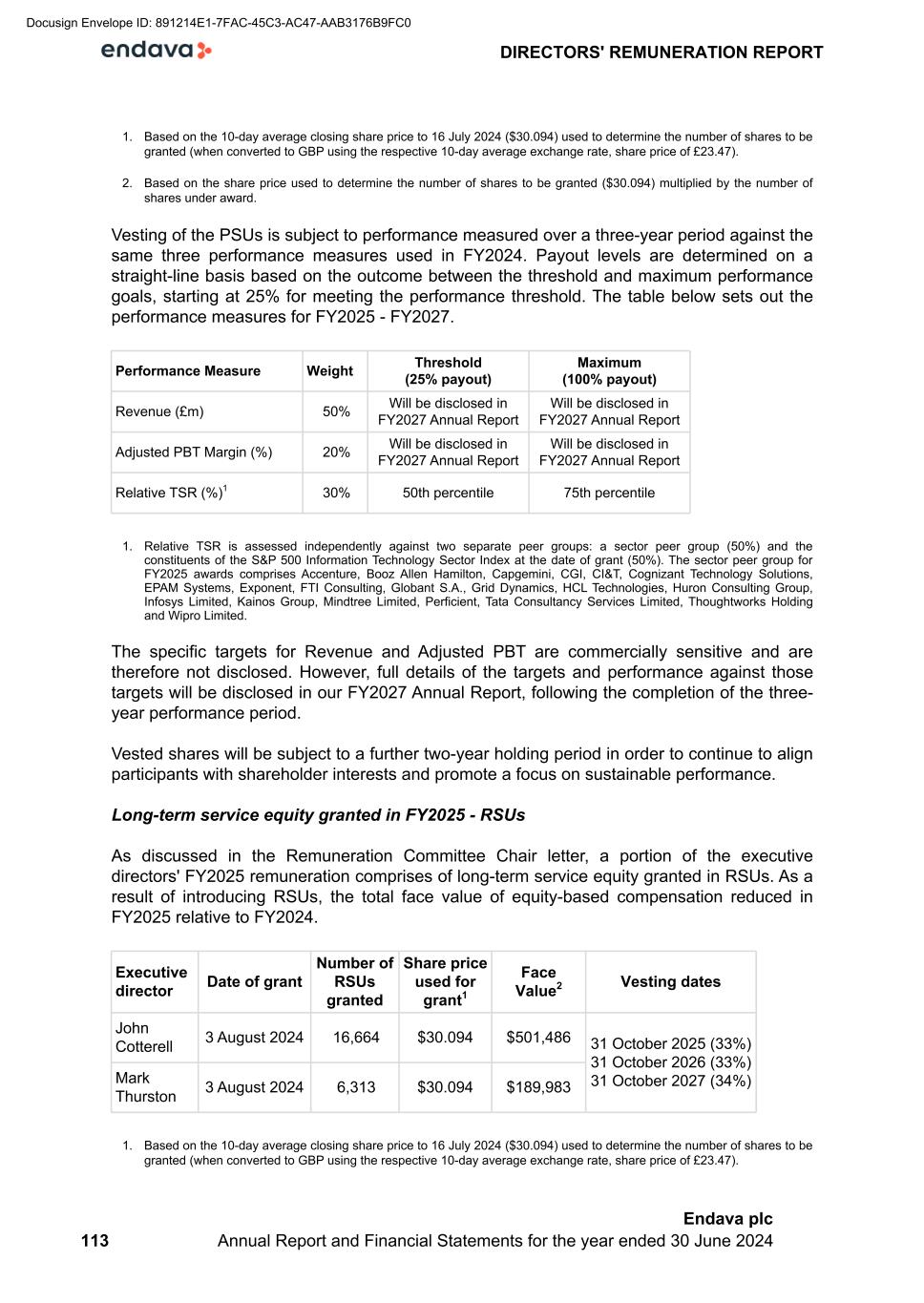
1. Based on the 10-day average closing share price to 16 July 2024 ($30.094) used to determine the number of shares to be granted (when converted to GBP using the respective 10-day average exchange rate, share price of £23.47). 2. Based on the share price used to determine the number of shares to be granted ($30.094) multiplied by the number of shares under award. Vesting of the PSUs is subject to performance measured over a three-year period against the same three performance measures used in FY2024. Payout levels are determined on a straight-line basis based on the outcome between the threshold and maximum performance goals, starting at 25% for meeting the performance threshold. The table below sets out the performance measures for FY2025 - FY2027. Performance Measure Weight Threshold (25% payout) Maximum (100% payout) Revenue (£m) 50% Will be disclosed in FY2027 Annual Report Will be disclosed in FY2027 Annual Report Adjusted PBT Margin (%) 20% Will be disclosed in FY2027 Annual Report Will be disclosed in FY2027 Annual Report Relative TSR (%)1 30% 50th percentile 75th percentile 1. Relative TSR is assessed independently against two separate peer groups: a sector peer group (50%) and the constituents of the S&P 500 Information Technology Sector Index at the date of grant (50%). The sector peer group for FY2025 awards comprises Accenture, Booz Allen Hamilton, Capgemini, CGI, CI&T, Cognizant Technology Solutions, EPAM Systems, Exponent, FTI Consulting, Globant S.A., Grid Dynamics, HCL Technologies, Huron Consulting Group, Infosys Limited, Kainos Group, Mindtree Limited, Perficient, Tata Consultancy Services Limited, Thoughtworks Holding and Wipro Limited. The specific targets for Revenue and Adjusted PBT are commercially sensitive and are therefore not disclosed. However, full details of the targets and performance against those targets will be disclosed in our FY2027 Annual Report, following the completion of the three- year performance period. Vested shares will be subject to a further two-year holding period in order to continue to align participants with shareholder interests and promote a focus on sustainable performance. Long-term service equity granted in FY2025 - RSUs As discussed in the Remuneration Committee Chair letter, a portion of the executive directors' FY2025 remuneration comprises of long-term service equity granted in RSUs. As a result of introducing RSUs, the total face value of equity-based compensation reduced in FY2025 relative to FY2024. Executive director Date of grant Number of RSUs granted Share price used for grant1 Face Value2 Vesting dates John Cotterell 3 August 2024 16,664 $30.094 $501,486 31 October 2025 (33%) 31 October 2026 (33%) 31 October 2027 (34%)Mark Thurston 3 August 2024 6,313 $30.094 $189,983 1. Based on the 10-day average closing share price to 16 July 2024 ($30.094) used to determine the number of shares to be granted (when converted to GBP using the respective 10-day average exchange rate, share price of £23.47). DIRECTORS' REMUNERATION REPORT 113 Endava plc Annual Report and Financial Statements for the year ended 30 June 2024 Docusign Envelope ID: 891214E1-7FAC-45C3-AC47-AAB3176B9FC0
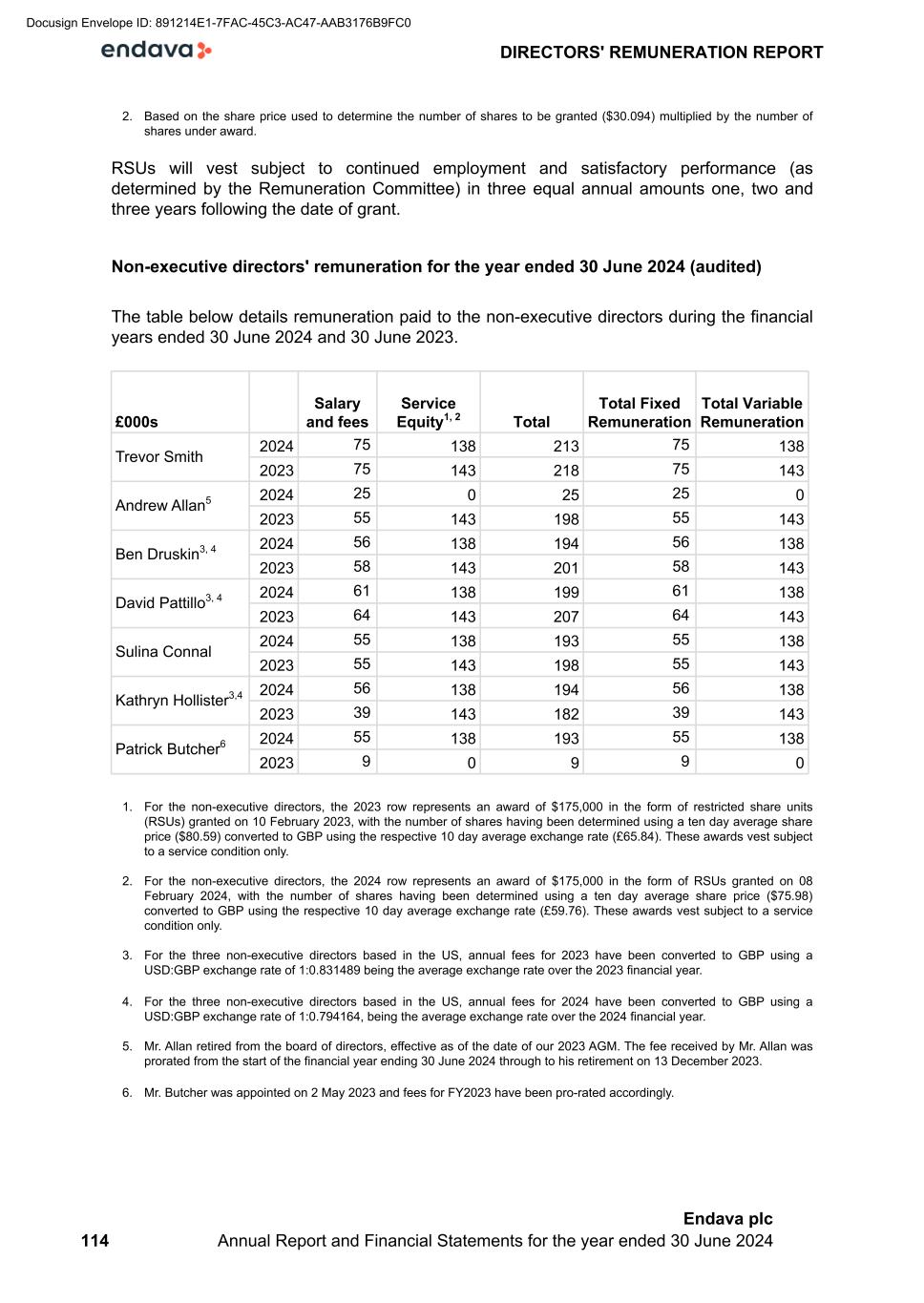
2. Based on the share price used to determine the number of shares to be granted ($30.094) multiplied by the number of shares under award. RSUs will vest subject to continued employment and satisfactory performance (as determined by the Remuneration Committee) in three equal annual amounts one, two and three years following the date of grant. Non-executive directors' remuneration for the year ended 30 June 2024 (audited) The table below details remuneration paid to the non-executive directors during the financial years ended 30 June 2024 and 30 June 2023. £000s Salary and fees Service Equity1, 2 Total Total Fixed Remuneration Total Variable Remuneration Trevor Smith 2024 75 138 213 75 138 2023 75 143 218 75 143 Andrew Allan5 2024 25 0 25 25 0 2023 55 143 198 55 143 Ben Druskin3, 4 2024 56 138 194 56 138 2023 58 143 201 58 143 David Pattillo3, 4 2024 61 138 199 61 138 2023 64 143 207 64 143 Sulina Connal 2024 55 138 193 55 138 2023 55 143 198 55 143 Kathryn Hollister3,4 2024 56 138 194 56 138 2023 39 143 182 39 143 Patrick Butcher6 2024 55 138 193 55 138 2023 9 0 9 9 0 1. For the non-executive directors, the 2023 row represents an award of $175,000 in the form of restricted share units (RSUs) granted on 10 February 2023, with the number of shares having been determined using a ten day average share price ($80.59) converted to GBP using the respective 10 day average exchange rate (£65.84). These awards vest subject to a service condition only. 2. For the non-executive directors, the 2024 row represents an award of $175,000 in the form of RSUs granted on 08 February 2024, with the number of shares having been determined using a ten day average share price ($75.98) converted to GBP using the respective 10 day average exchange rate (£59.76). These awards vest subject to a service condition only. 3. For the three non-executive directors based in the US, annual fees for 2023 have been converted to GBP using a USD:GBP exchange rate of 1:0.831489 being the average exchange rate over the 2023 financial year. 4. For the three non-executive directors based in the US, annual fees for 2024 have been converted to GBP using a USD:GBP exchange rate of 1:0.794164, being the average exchange rate over the 2024 financial year. 5. Mr. Allan retired from the board of directors, effective as of the date of our 2023 AGM. The fee received by Mr. Allan was prorated from the start of the financial year ending 30 June 2024 through to his retirement on 13 December 2023. 6. Mr. Butcher was appointed on 2 May 2023 and fees for FY2023 have been pro-rated accordingly. DIRECTORS' REMUNERATION REPORT 114 Endava plc Annual Report and Financial Statements for the year ended 30 June 2024 Docusign Envelope ID: 891214E1-7FAC-45C3-AC47-AAB3176B9FC0
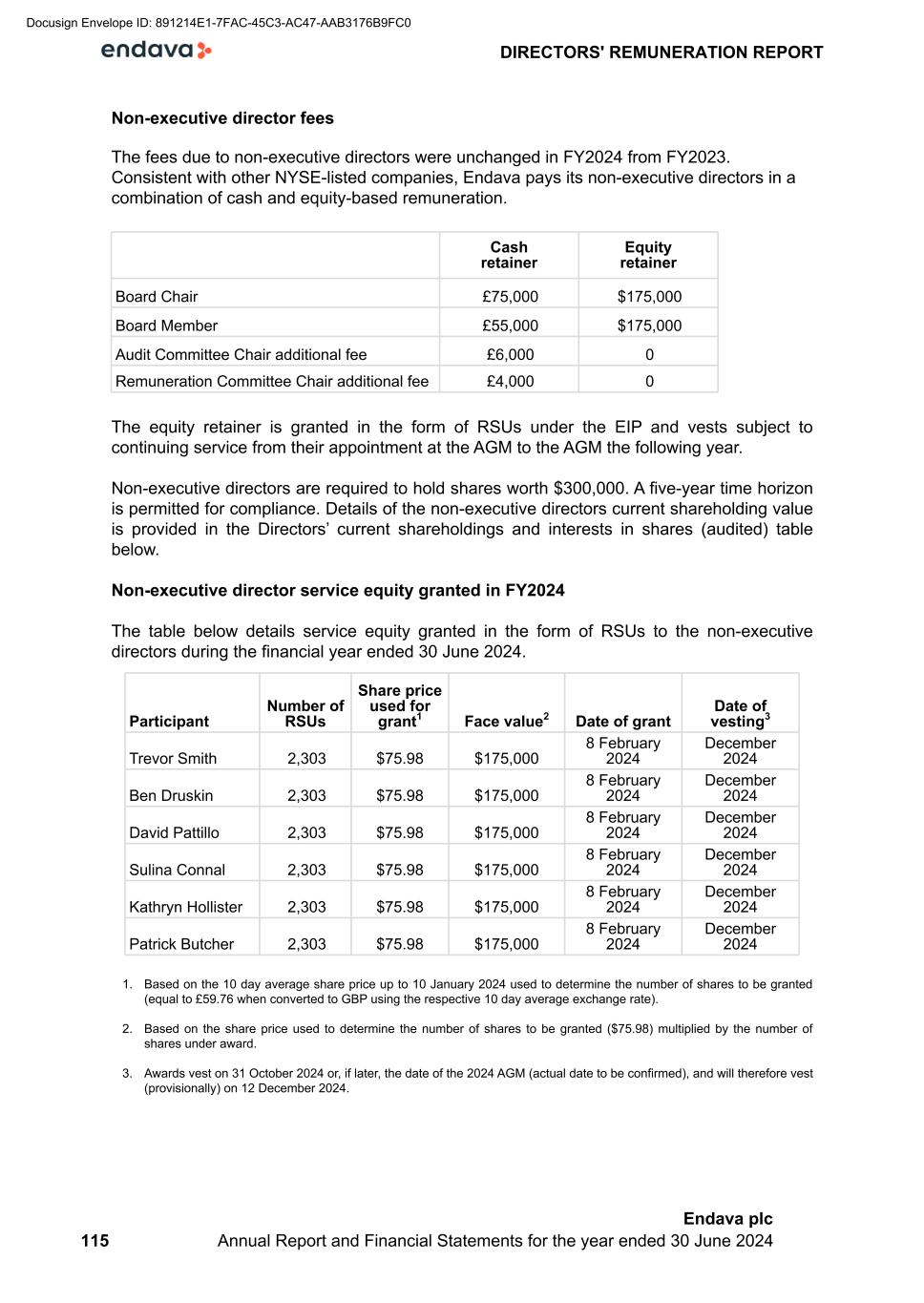
Non-executive director fees The fees due to non-executive directors were unchanged in FY2024 from FY2023. Consistent with other NYSE-listed companies, Endava pays its non-executive directors in a combination of cash and equity-based remuneration. Cash retainer Equity retainer Board Chair £75,000 $175,000 Board Member £55,000 $175,000 Audit Committee Chair additional fee £6,000 0 Remuneration Committee Chair additional fee £4,000 0 The equity retainer is granted in the form of RSUs under the EIP and vests subject to continuing service from their appointment at the AGM to the AGM the following year. Non-executive directors are required to hold shares worth $300,000. A five-year time horizon is permitted for compliance. Details of the non-executive directors current shareholding value is provided in the Directors’ current shareholdings and interests in shares (audited) table below. Non-executive director service equity granted in FY2024 The table below details service equity granted in the form of RSUs to the non-executive directors during the financial year ended 30 June 2024. Participant Number of RSUs Share price used for grant1 Face value2 Date of grant Date of vesting3 Trevor Smith 2,303 $75.98 $175,000 8 February 2024 December 2024 Ben Druskin 2,303 $75.98 $175,000 8 February 2024 December 2024 David Pattillo 2,303 $75.98 $175,000 8 February 2024 December 2024 Sulina Connal 2,303 $75.98 $175,000 8 February 2024 December 2024 Kathryn Hollister 2,303 $75.98 $175,000 8 February 2024 December 2024 Patrick Butcher 2,303 $75.98 $175,000 8 February 2024 December 2024 1. Based on the 10 day average share price up to 10 January 2024 used to determine the number of shares to be granted (equal to £59.76 when converted to GBP using the respective 10 day average exchange rate). 2. Based on the share price used to determine the number of shares to be granted ($75.98) multiplied by the number of shares under award. 3. Awards vest on 31 October 2024 or, if later, the date of the 2024 AGM (actual date to be confirmed), and will therefore vest (provisionally) on 12 December 2024. DIRECTORS' REMUNERATION REPORT 115 Endava plc Annual Report and Financial Statements for the year ended 30 June 2024 Docusign Envelope ID: 891214E1-7FAC-45C3-AC47-AAB3176B9FC0

Payments for loss of office and payments to past directors (audited) No payments for loss of office or to past directors were made during the year. Directors’ current shareholdings and interests in shares (audited) The table below provides details on the directors' current shareholdings as well as their interests in outstanding share awards at 30 June 2024. Unconditionally- owned shares1 Shareholding guideline (% base salary) Percentage of salary/fees applicable to share ownership requirement2 Share Award Share Options8 EIP (unvested; still subject to performance) EIP (unvested; subject only to service condition) SSP (unvested options; not subject to performance) Total Executive directors John Cotterell 8,631,2363 300% 39999% 74,5024 32,5475 455 107,504 Mark Thurston 41,464 300% 378% 26,8904 13,8945 455 41,239 Non-executive directors Shareholding guideline ($ value)6 % guideline met7 Trevor Smith 72,479 $ 300,000 728% — 2,303 — 2,303 Ben Druskin 55,863 $ 300,000 566% — 2,303 — 2,303 David Pattillo 32,863 $ 300,000 341% — 2,303 — 2,303 Sulina Connal 4,149 $ 300,000 62% — 2,303 — 2,303 Kathryn Hollister 1,186 $ 300,000 33% — 2,303 — 2,303 Patrick Butcher — $ 300,000 0% — 2,303 — 2,303 1. Represents shares in which no connected persons hold any interests. 2. This value includes all unconditionally-owned shares, plus the value of outstanding tranches of prior EIP awards that are subject to service conditions only (on a net of tax basis), valued using the share price on 30 June 2024 ($29.24) converted to GBP of £23.12. Executive directors are required to build and maintain a shareholding to the value of 300% of salary within five years of appointment. 3. Includes 2,000,000 shares held in trust. 4. Including a number of EIP awards granted on 31 July 2023, subject to a performance period ending 30 June 2026. 5. Includes a number of EIP awards granted on 16 September 2020, of which 100% was earned based on performance up to 30 June 2021. Includes a number of EIP awards granted on 9 August 2021, of which 100% was earned based on performance up to 30 June 2022. Includes a number of EIP awards granted on 13 December 2022, of which 25% was earned based on performance up to 30 June 2023. 6. In past years there has not been a formal shareholding requirement in place for non-executive directors. However, (as described on page 128) the Policy, approved by shareholders at the December 2022 AGM, now includes a requirement to build and maintain a holding equivalent to $300,000 within five years from the approval of the policy or, if later, their date of appointment. 7. Valued using the share price of $29.24, being the closing share price on 30 June 2024. 8. There are no vested but unexercised options. There have been no changes in directors’ shareholdings or interests in shares between 30 June 2024 and the date of this report, other than those described above. DIRECTORS' REMUNERATION REPORT 116 Endava plc Annual Report and Financial Statements for the year ended 30 June 2024 Docusign Envelope ID: 891214E1-7FAC-45C3-AC47-AAB3176B9FC0
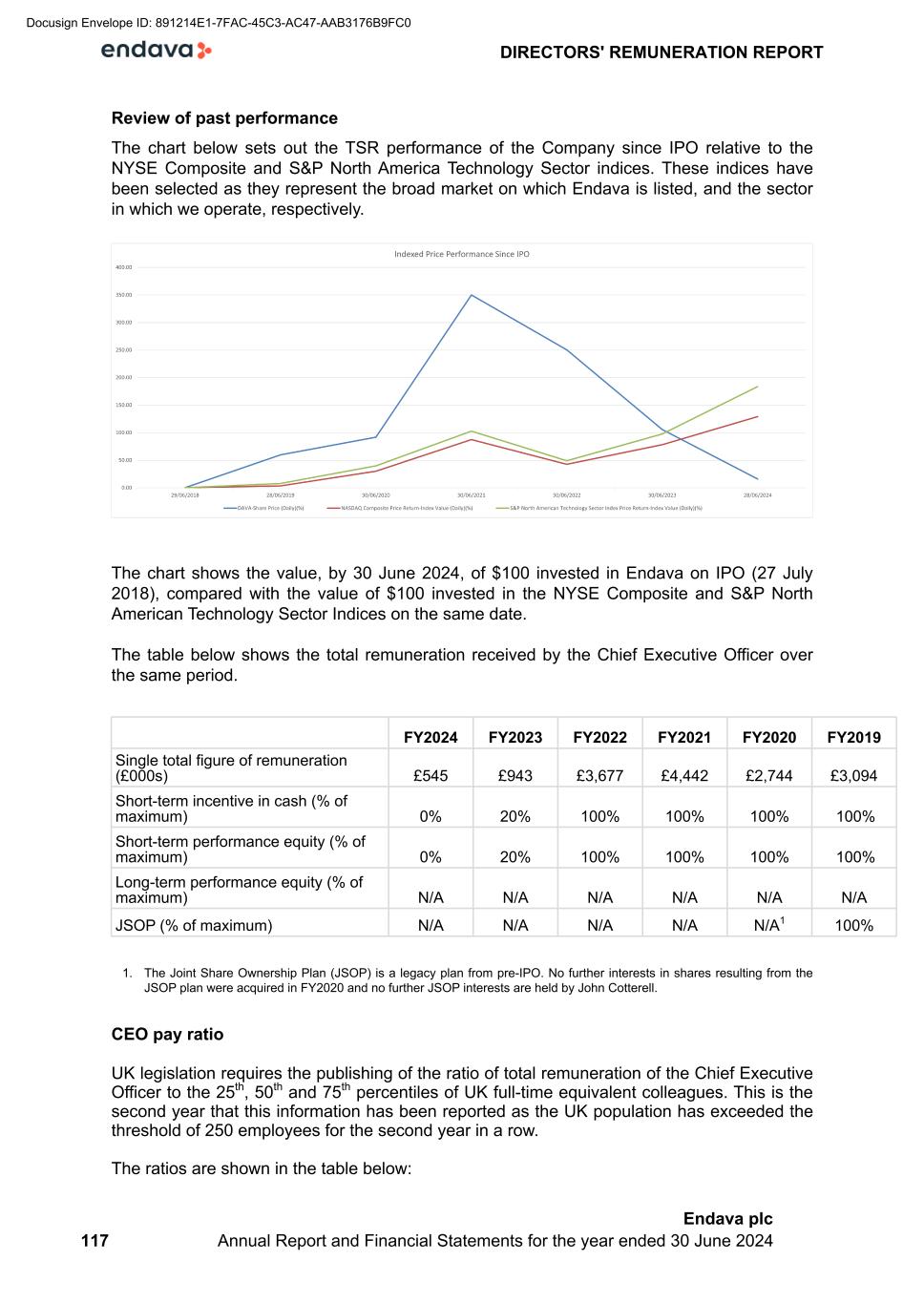
Review of past performance The chart below sets out the TSR performance of the Company since IPO relative to the NYSE Composite and S&P North America Technology Sector indices. These indices have been selected as they represent the broad market on which Endava is listed, and the sector in which we operate, respectively. The chart shows the value, by 30 June 2024, of $100 invested in Endava on IPO (27 July 2018), compared with the value of $100 invested in the NYSE Composite and S&P North American Technology Sector Indices on the same date. The table below shows the total remuneration received by the Chief Executive Officer over the same period. FY2024 FY2023 FY2022 FY2021 FY2020 FY2019 Single total figure of remuneration (£000s) £545 £943 £3,677 £4,442 £2,744 £3,094 Short-term incentive in cash (% of maximum) 0% 20% 100% 100% 100% 100% Short-term performance equity (% of maximum) 0% 20% 100% 100% 100% 100% Long-term performance equity (% of maximum) N/A N/A N/A N/A N/A N/A JSOP (% of maximum) N/A N/A N/A N/A N/A1 100% 1. The Joint Share Ownership Plan (JSOP) is a legacy plan from pre-IPO. No further interests in shares resulting from the JSOP plan were acquired in FY2020 and no further JSOP interests are held by John Cotterell. CEO pay ratio UK legislation requires the publishing of the ratio of total remuneration of the Chief Executive Officer to the 25th, 50th and 75th percentiles of UK full-time equivalent colleagues. This is the second year that this information has been reported as the UK population has exceeded the threshold of 250 employees for the second year in a row. The ratios are shown in the table below: DIRECTORS' REMUNERATION REPORT 117 Endava plc Annual Report and Financial Statements for the year ended 30 June 2024 Docusign Envelope ID: 891214E1-7FAC-45C3-AC47-AAB3176B9FC0
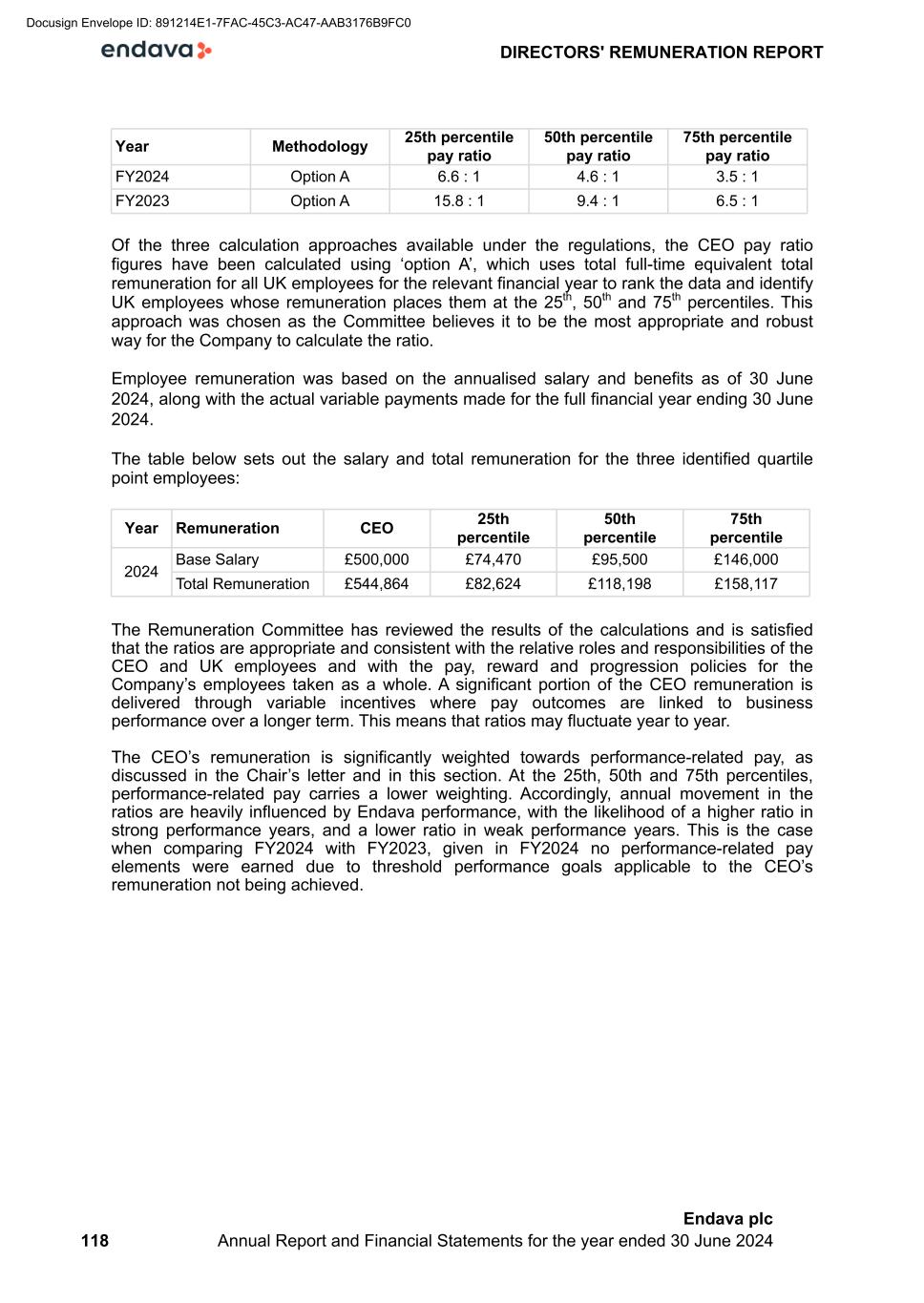
Year Methodology 25th percentile pay ratio 50th percentile pay ratio 75th percentile pay ratio FY2024 Option A 6.6 : 1 4.6 : 1 3.5 : 1 FY2023 Option A 15.8 : 1 9.4 : 1 6.5 : 1 Of the three calculation approaches available under the regulations, the CEO pay ratio figures have been calculated using ‘option A’, which uses total full-time equivalent total remuneration for all UK employees for the relevant financial year to rank the data and identify UK employees whose remuneration places them at the 25th, 50th and 75th percentiles. This approach was chosen as the Committee believes it to be the most appropriate and robust way for the Company to calculate the ratio. Employee remuneration was based on the annualised salary and benefits as of 30 June 2024, along with the actual variable payments made for the full financial year ending 30 June 2024. The table below sets out the salary and total remuneration for the three identified quartile point employees: Year Remuneration CEO 25th percentile 50th percentile 75th percentile 2024 Base Salary £500,000 £74,470 £95,500 £146,000 Total Remuneration £544,864 £82,624 £118,198 £158,117 The Remuneration Committee has reviewed the results of the calculations and is satisfied that the ratios are appropriate and consistent with the relative roles and responsibilities of the CEO and UK employees and with the pay, reward and progression policies for the Company’s employees taken as a whole. A significant portion of the CEO remuneration is delivered through variable incentives where pay outcomes are linked to business performance over a longer term. This means that ratios may fluctuate year to year. The CEO’s remuneration is significantly weighted towards performance-related pay, as discussed in the Chair’s letter and in this section. At the 25th, 50th and 75th percentiles, performance-related pay carries a lower weighting. Accordingly, annual movement in the ratios are heavily influenced by Endava performance, with the likelihood of a higher ratio in strong performance years, and a lower ratio in weak performance years. This is the case when comparing FY2024 with FY2023, given in FY2024 no performance-related pay elements were earned due to threshold performance goals applicable to the CEO’s remuneration not being achieved. DIRECTORS' REMUNERATION REPORT 118 Endava plc Annual Report and Financial Statements for the year ended 30 June 2024 Docusign Envelope ID: 891214E1-7FAC-45C3-AC47-AAB3176B9FC0
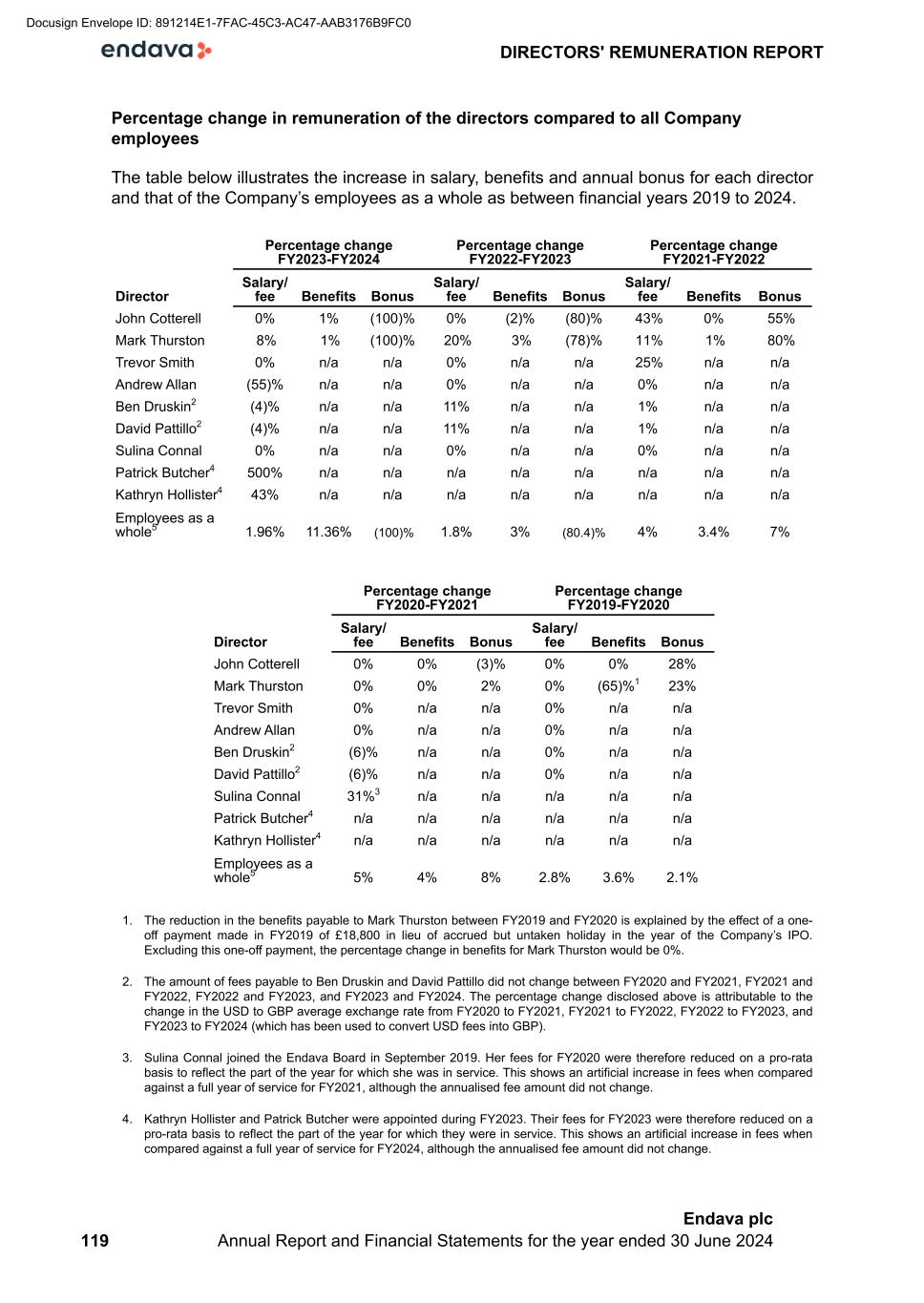
Percentage change in remuneration of the directors compared to all Company employees The table below illustrates the increase in salary, benefits and annual bonus for each director and that of the Company’s employees as a whole as between financial years 2019 to 2024. Percentage change FY2023-FY2024 Percentage change FY2022-FY2023 Percentage change FY2021-FY2022 Director Salary/ fee Benefits Bonus Salary/ fee Benefits Bonus Salary/ fee Benefits Bonus John Cotterell 0% 1% (100)% 0% (2)% (80)% 43% 0% 55% Mark Thurston 8% 1% (100)% 20% 3% (78)% 11% 1% 80% Trevor Smith 0% n/a n/a 0% n/a n/a 25% n/a n/a Andrew Allan (55)% n/a n/a 0% n/a n/a 0% n/a n/a Ben Druskin2 (4)% n/a n/a 11% n/a n/a 1% n/a n/a David Pattillo2 (4)% n/a n/a 11% n/a n/a 1% n/a n/a Sulina Connal 0% n/a n/a 0% n/a n/a 0% n/a n/a Patrick Butcher4 500% n/a n/a n/a n/a n/a n/a n/a n/a Kathryn Hollister4 43% n/a n/a n/a n/a n/a n/a n/a n/a Employees as a whole5 1.96% 11.36% (100)% 1.8% 3% (80.4)% 4% 3.4% 7% Percentage change FY2020-FY2021 Percentage change FY2019-FY2020 Director Salary/ fee Benefits Bonus Salary/ fee Benefits Bonus John Cotterell 0% 0% (3)% 0% 0% 28% Mark Thurston 0% 0% 2% 0% (65)%1 23% Trevor Smith 0% n/a n/a 0% n/a n/a Andrew Allan 0% n/a n/a 0% n/a n/a Ben Druskin2 (6)% n/a n/a 0% n/a n/a David Pattillo2 (6)% n/a n/a 0% n/a n/a Sulina Connal 31%3 n/a n/a n/a n/a n/a Patrick Butcher4 n/a n/a n/a n/a n/a n/a Kathryn Hollister4 n/a n/a n/a n/a n/a n/a Employees as a whole5 5% 4% 8% 2.8% 3.6% 2.1% 1. The reduction in the benefits payable to Mark Thurston between FY2019 and FY2020 is explained by the effect of a one- off payment made in FY2019 of £18,800 in lieu of accrued but untaken holiday in the year of the Company’s IPO. Excluding this one-off payment, the percentage change in benefits for Mark Thurston would be 0%. 2. The amount of fees payable to Ben Druskin and David Pattillo did not change between FY2020 and FY2021, FY2021 and FY2022, FY2022 and FY2023, and FY2023 and FY2024. The percentage change disclosed above is attributable to the change in the USD to GBP average exchange rate from FY2020 to FY2021, FY2021 to FY2022, FY2022 to FY2023, and FY2023 to FY2024 (which has been used to convert USD fees into GBP). 3. Sulina Connal joined the Endava Board in September 2019. Her fees for FY2020 were therefore reduced on a pro-rata basis to reflect the part of the year for which she was in service. This shows an artificial increase in fees when compared against a full year of service for FY2021, although the annualised fee amount did not change. 4. Kathryn Hollister and Patrick Butcher were appointed during FY2023. Their fees for FY2023 were therefore reduced on a pro-rata basis to reflect the part of the year for which they were in service. This shows an artificial increase in fees when compared against a full year of service for FY2024, although the annualised fee amount did not change. DIRECTORS' REMUNERATION REPORT 119 Endava plc Annual Report and Financial Statements for the year ended 30 June 2024 Docusign Envelope ID: 891214E1-7FAC-45C3-AC47-AAB3176B9FC0
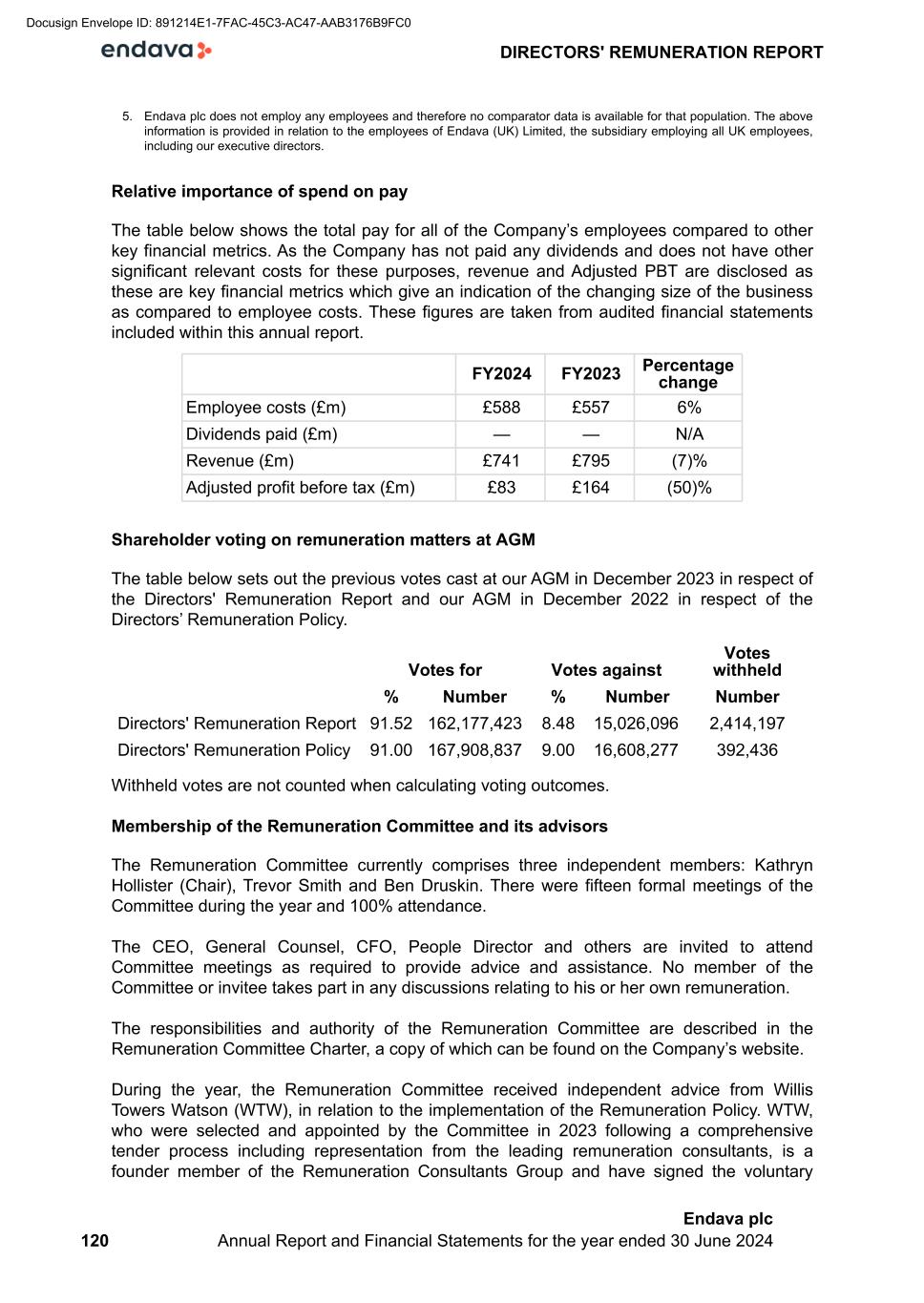
5. Endava plc does not employ any employees and therefore no comparator data is available for that population. The above information is provided in relation to the employees of Endava (UK) Limited, the subsidiary employing all UK employees, including our executive directors. Relative importance of spend on pay The table below shows the total pay for all of the Company’s employees compared to other key financial metrics. As the Company has not paid any dividends and does not have other significant relevant costs for these purposes, revenue and Adjusted PBT are disclosed as these are key financial metrics which give an indication of the changing size of the business as compared to employee costs. These figures are taken from audited financial statements included within this annual report. FY2024 FY2023 Percentage change Employee costs (£m) £588 £557 6% Dividends paid (£m) — — N/A Revenue (£m) £741 £795 (7)% Adjusted profit before tax (£m) £83 £164 (50)% Shareholder voting on remuneration matters at AGM The table below sets out the previous votes cast at our AGM in December 2023 in respect of the Directors' Remuneration Report and our AGM in December 2022 in respect of the Directors’ Remuneration Policy. Votes for Votes against Votes withheld % Number % Number Number Directors' Remuneration Report 91.52 162,177,423 8.48 15,026,096 2,414,197 Directors' Remuneration Policy 91.00 167,908,837 9.00 16,608,277 392,436 Withheld votes are not counted when calculating voting outcomes. Membership of the Remuneration Committee and its advisors The Remuneration Committee currently comprises three independent members: Kathryn Hollister (Chair), Trevor Smith and Ben Druskin. There were fifteen formal meetings of the Committee during the year and 100% attendance. The CEO, General Counsel, CFO, People Director and others are invited to attend Committee meetings as required to provide advice and assistance. No member of the Committee or invitee takes part in any discussions relating to his or her own remuneration. The responsibilities and authority of the Remuneration Committee are described in the Remuneration Committee Charter, a copy of which can be found on the Company’s website. During the year, the Remuneration Committee received independent advice from Willis Towers Watson (WTW), in relation to the implementation of the Remuneration Policy. WTW, who were selected and appointed by the Committee in 2023 following a comprehensive tender process including representation from the leading remuneration consultants, is a founder member of the Remuneration Consultants Group and have signed the voluntary DIRECTORS' REMUNERATION REPORT 120 Endava plc Annual Report and Financial Statements for the year ended 30 June 2024 Docusign Envelope ID: 891214E1-7FAC-45C3-AC47-AAB3176B9FC0

Code of Conduct for remuneration consultants. As a result, the Committee is satisfied that advice provided by WTW is independent and objective. WTW received fees on a time spent basis of £198,000 in respect of their advice to the Committee during the financial period. In addition, WTW received fees of approximately £9,000 in respect of equity grant valuation support provided separately to management. Peer Groups used to inform remuneration decisions The Compensation Peer Group, as previously approved by the Remuneration Committee, is used to both understand the competitiveness of remuneration and compare our relative TSR performance. Accenture Exponent Kainos Group Booz Allen Hamilton FTI Consulting Mindtree Limited Capgemini Globant S.A. Perficient CGI Grid Dynamics Tata Consultancy Services Limited CI&T HCL Technologies Thoughtworks Holding Cognizant Technology Solutions Huron Consulting Group Wipro Limited EPAM Systems Infosys Limited During FY2024, the Committee also developed and considered a separate peer group of founder-owned companies in similar industries which listed at a similar time to Endava. This group was used as a secondary reference to assess pay levels and pay design. The Committee also considers pay data for broad UK and US indices, as an additional contextual point of reference. Shareholding requirements The executive directors are required to build and maintain a share ownership requirement of 300% of salary. In addition to the share ownership requirement, a post-employment shareholding requirement applies under which executive directors will be required to continue to hold shares equivalent to the lower of the shareholding at termination or 300% of base salary at the time of termination for a period of two years after leaving employment. Both executive directors are in compliance with the applicable shareholder requirements. Clawback On 9 November 2023 our board of directors adopted an Incentive Compensation Recoupment Policy, or the "Dodd-Frank Clawback Policy", effective as of 2 October 2023. The Dodd-Frank Clawback Policy is administered by our Remuneration Committee and was adopted in compliance with Section 10D of the Exchange Act and applicable rules of the New York Stock Exchange. The Dodd-Frank Clawback Policy provides that if we are required to record an accounting restatement, then we will seek to recover incentive-based compensation from certain current or former executive officers' that was erroneously awarded and received during the three completed financial years immediately preceding the date we are required to record such accounting restatement, as well as any transition period DIRECTORS' REMUNERATION REPORT 121 Endava plc Annual Report and Financial Statements for the year ended 30 June 2024 Docusign Envelope ID: 891214E1-7FAC-45C3-AC47-AAB3176B9FC0
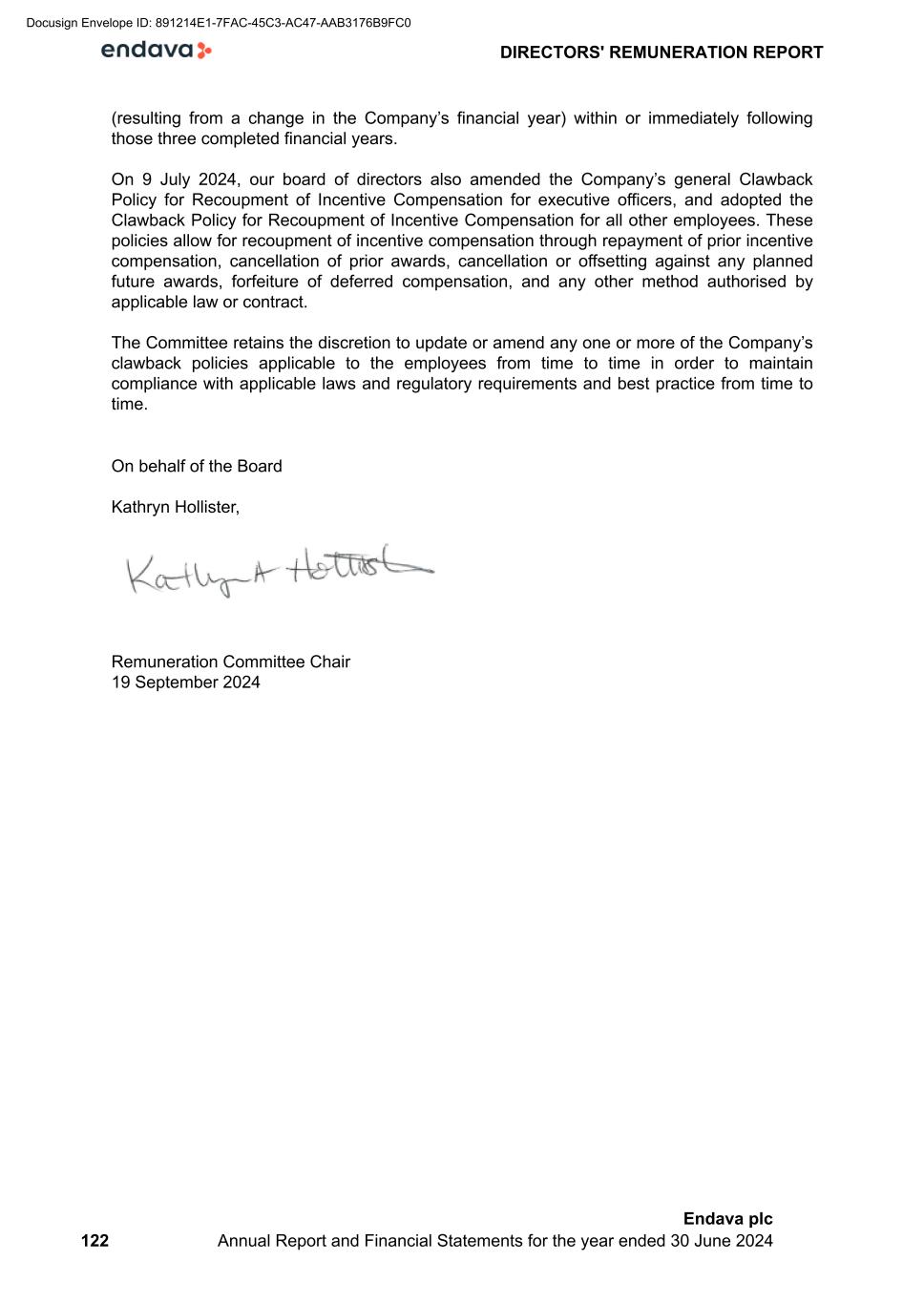
(resulting from a change in the Company’s financial year) within or immediately following those three completed financial years. On 9 July 2024, our board of directors also amended the Company’s general Clawback Policy for Recoupment of Incentive Compensation for executive officers, and adopted the Clawback Policy for Recoupment of Incentive Compensation for all other employees. These policies allow for recoupment of incentive compensation through repayment of prior incentive compensation, cancellation of prior awards, cancellation or offsetting against any planned future awards, forfeiture of deferred compensation, and any other method authorised by applicable law or contract. The Committee retains the discretion to update or amend any one or more of the Company’s clawback policies applicable to the employees from time to time in order to maintain compliance with applicable laws and regulatory requirements and best practice from time to time. On behalf of the Board Kathryn Hollister, Remuneration Committee Chair 19 September 2024 DIRECTORS' REMUNERATION REPORT 122 Endava plc Annual Report and Financial Statements for the year ended 30 June 2024 Docusign Envelope ID: 891214E1-7FAC-45C3-AC47-AAB3176B9FC0
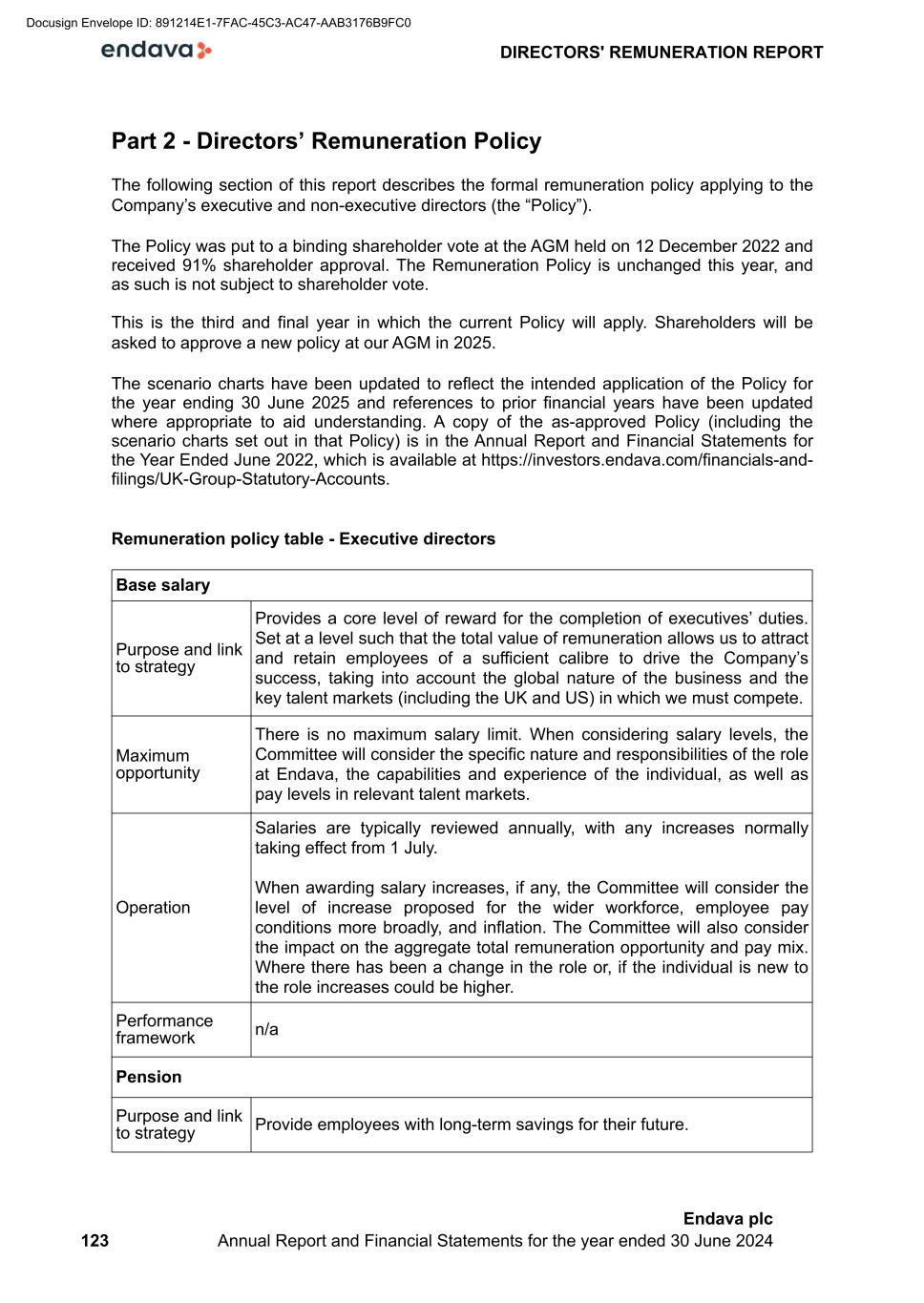
Part 2 - Directors’ Remuneration Policy The following section of this report describes the formal remuneration policy applying to the Company’s executive and non-executive directors (the “Policy”). The Policy was put to a binding shareholder vote at the AGM held on 12 December 2022 and received 91% shareholder approval. The Remuneration Policy is unchanged this year, and as such is not subject to shareholder vote. This is the third and final year in which the current Policy will apply. Shareholders will be asked to approve a new policy at our AGM in 2025. The scenario charts have been updated to reflect the intended application of the Policy for the year ending 30 June 2025 and references to prior financial years have been updated where appropriate to aid understanding. A copy of the as-approved Policy (including the scenario charts set out in that Policy) is in the Annual Report and Financial Statements for the Year Ended June 2022, which is available at https://investors.endava.com/financials-and- filings/UK-Group-Statutory-Accounts. Remuneration policy table - Executive directors Base salary Purpose and link to strategy Provides a core level of reward for the completion of executives’ duties. Set at a level such that the total value of remuneration allows us to attract and retain employees of a sufficient calibre to drive the Company’s success, taking into account the global nature of the business and the key talent markets (including the UK and US) in which we must compete. Maximum opportunity There is no maximum salary limit. When considering salary levels, the Committee will consider the specific nature and responsibilities of the role at Endava, the capabilities and experience of the individual, as well as pay levels in relevant talent markets. Operation Salaries are typically reviewed annually, with any increases normally taking effect from 1 July. When awarding salary increases, if any, the Committee will consider the level of increase proposed for the wider workforce, employee pay conditions more broadly, and inflation. The Committee will also consider the impact on the aggregate total remuneration opportunity and pay mix. Where there has been a change in the role or, if the individual is new to the role increases could be higher. Performance framework n/a Pension Purpose and link to strategy Provide employees with long-term savings for their future. DIRECTORS' REMUNERATION REPORT 123 Endava plc Annual Report and Financial Statements for the year ended 30 June 2024 Docusign Envelope ID: 891214E1-7FAC-45C3-AC47-AAB3176B9FC0
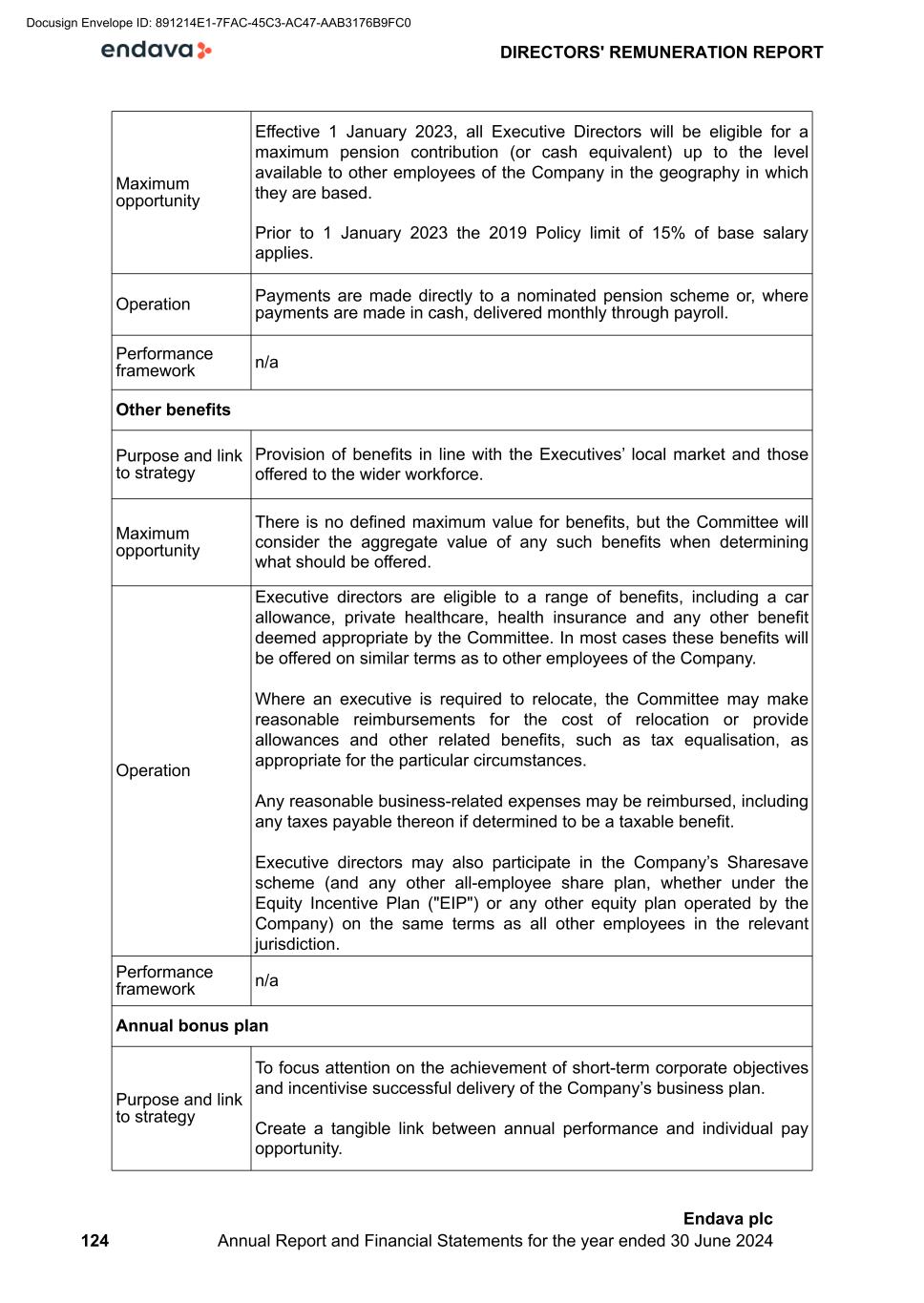
Maximum opportunity Effective 1 January 2023, all Executive Directors will be eligible for a maximum pension contribution (or cash equivalent) up to the level available to other employees of the Company in the geography in which they are based. Prior to 1 January 2023 the 2019 Policy limit of 15% of base salary applies. Operation Payments are made directly to a nominated pension scheme or, where payments are made in cash, delivered monthly through payroll. Performance framework n/a Other benefits Purpose and link to strategy Provision of benefits in line with the Executives’ local market and those offered to the wider workforce. Maximum opportunity There is no defined maximum value for benefits, but the Committee will consider the aggregate value of any such benefits when determining what should be offered. Operation Executive directors are eligible to a range of benefits, including a car allowance, private healthcare, health insurance and any other benefit deemed appropriate by the Committee. In most cases these benefits will be offered on similar terms as to other employees of the Company. Where an executive is required to relocate, the Committee may make reasonable reimbursements for the cost of relocation or provide allowances and other related benefits, such as tax equalisation, as appropriate for the particular circumstances. Any reasonable business-related expenses may be reimbursed, including any taxes payable thereon if determined to be a taxable benefit. Executive directors may also participate in the Company’s Sharesave scheme (and any other all-employee share plan, whether under the Equity Incentive Plan ("EIP") or any other equity plan operated by the Company) on the same terms as all other employees in the relevant jurisdiction. Performance framework n/a Annual bonus plan Purpose and link to strategy To focus attention on the achievement of short-term corporate objectives and incentivise successful delivery of the Company’s business plan. Create a tangible link between annual performance and individual pay opportunity. DIRECTORS' REMUNERATION REPORT 124 Endava plc Annual Report and Financial Statements for the year ended 30 June 2024 Docusign Envelope ID: 891214E1-7FAC-45C3-AC47-AAB3176B9FC0
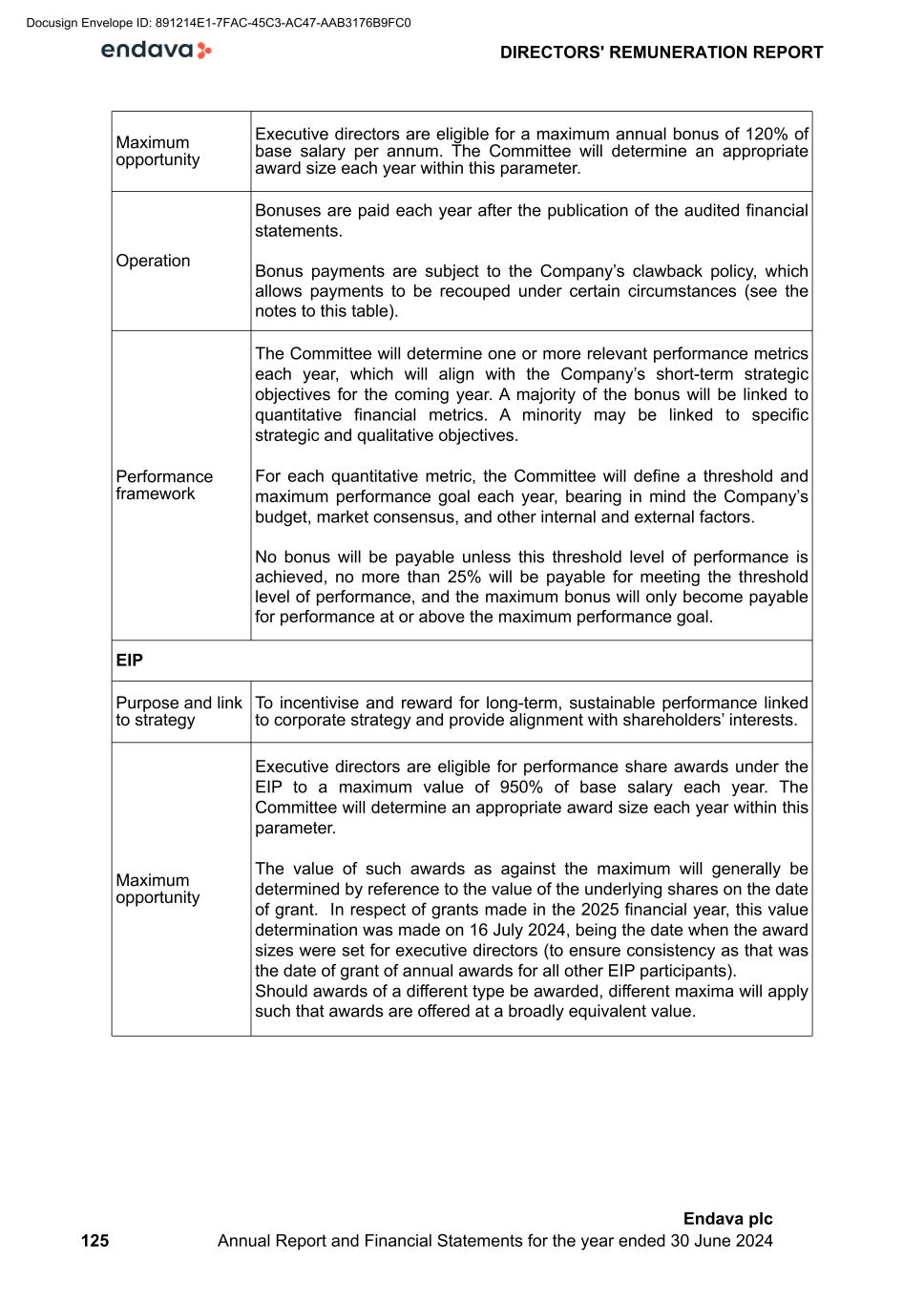
Maximum opportunity Executive directors are eligible for a maximum annual bonus of 120% of base salary per annum. The Committee will determine an appropriate award size each year within this parameter. Operation Bonuses are paid each year after the publication of the audited financial statements. Bonus payments are subject to the Company’s clawback policy, which allows payments to be recouped under certain circumstances (see the notes to this table). Performance framework The Committee will determine one or more relevant performance metrics each year, which will align with the Company’s short-term strategic objectives for the coming year. A majority of the bonus will be linked to quantitative financial metrics. A minority may be linked to specific strategic and qualitative objectives. For each quantitative metric, the Committee will define a threshold and maximum performance goal each year, bearing in mind the Company’s budget, market consensus, and other internal and external factors. No bonus will be payable unless this threshold level of performance is achieved, no more than 25% will be payable for meeting the threshold level of performance, and the maximum bonus will only become payable for performance at or above the maximum performance goal. EIP Purpose and link to strategy To incentivise and reward for long-term, sustainable performance linked to corporate strategy and provide alignment with shareholders’ interests. Maximum opportunity Executive directors are eligible for performance share awards under the EIP to a maximum value of 950% of base salary each year. The Committee will determine an appropriate award size each year within this parameter. The value of such awards as against the maximum will generally be determined by reference to the value of the underlying shares on the date of grant. In respect of grants made in the 2025 financial year, this value determination was made on 16 July 2024, being the date when the award sizes were set for executive directors (to ensure consistency as that was the date of grant of annual awards for all other EIP participants). Should awards of a different type be awarded, different maxima will apply such that awards are offered at a broadly equivalent value. DIRECTORS' REMUNERATION REPORT 125 Endava plc Annual Report and Financial Statements for the year ended 30 June 2024 Docusign Envelope ID: 891214E1-7FAC-45C3-AC47-AAB3176B9FC0
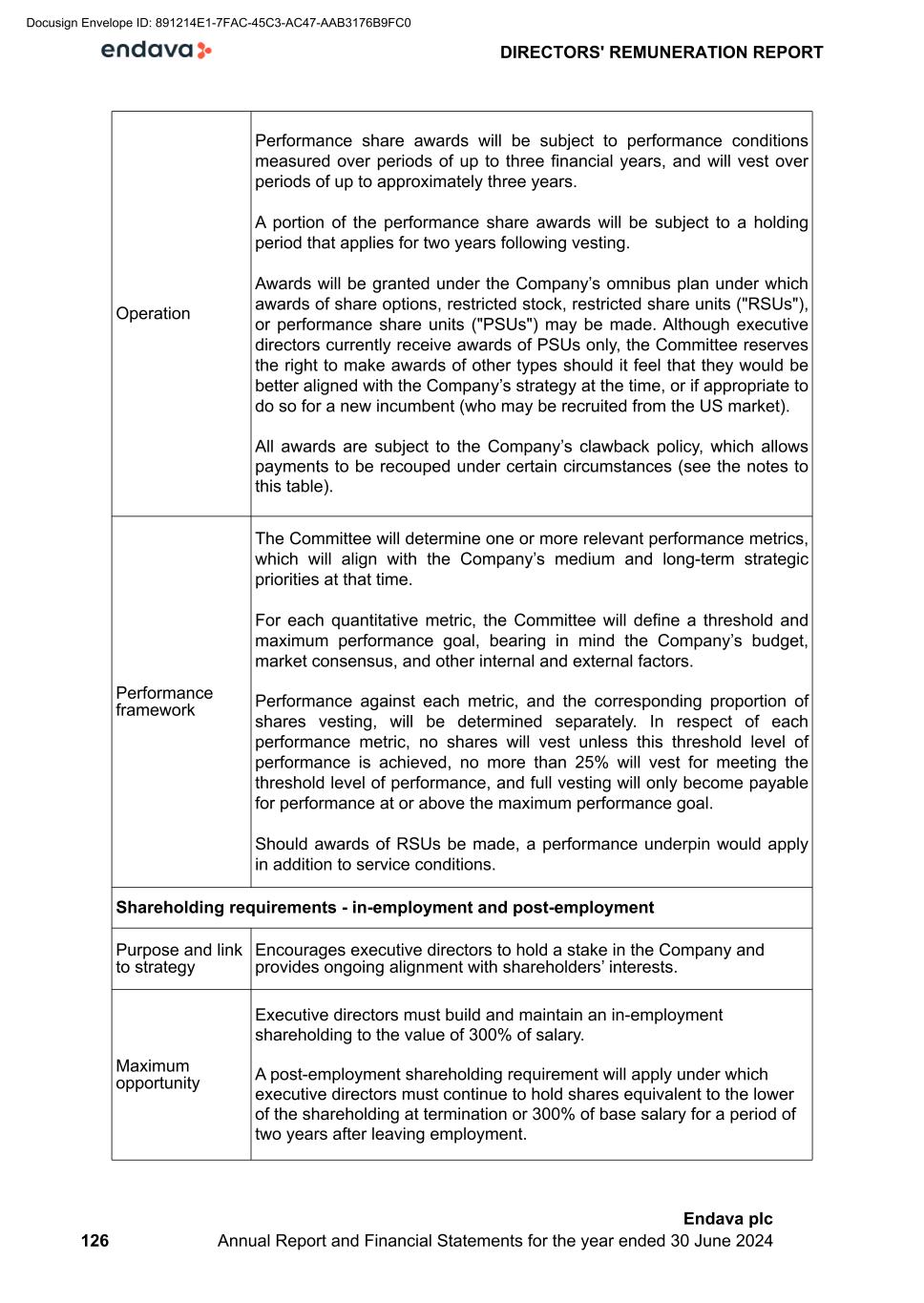
Operation Performance share awards will be subject to performance conditions measured over periods of up to three financial years, and will vest over periods of up to approximately three years. A portion of the performance share awards will be subject to a holding period that applies for two years following vesting. Awards will be granted under the Company’s omnibus plan under which awards of share options, restricted stock, restricted share units ("RSUs"), or performance share units ("PSUs") may be made. Although executive directors currently receive awards of PSUs only, the Committee reserves the right to make awards of other types should it feel that they would be better aligned with the Company’s strategy at the time, or if appropriate to do so for a new incumbent (who may be recruited from the US market). All awards are subject to the Company’s clawback policy, which allows payments to be recouped under certain circumstances (see the notes to this table). Performance framework The Committee will determine one or more relevant performance metrics, which will align with the Company’s medium and long-term strategic priorities at that time. For each quantitative metric, the Committee will define a threshold and maximum performance goal, bearing in mind the Company’s budget, market consensus, and other internal and external factors. Performance against each metric, and the corresponding proportion of shares vesting, will be determined separately. In respect of each performance metric, no shares will vest unless this threshold level of performance is achieved, no more than 25% will vest for meeting the threshold level of performance, and full vesting will only become payable for performance at or above the maximum performance goal. Should awards of RSUs be made, a performance underpin would apply in addition to service conditions. Shareholding requirements - in-employment and post-employment Purpose and link to strategy Encourages executive directors to hold a stake in the Company and provides ongoing alignment with shareholders’ interests. Maximum opportunity Executive directors must build and maintain an in-employment shareholding to the value of 300% of salary. A post-employment shareholding requirement will apply under which executive directors must continue to hold shares equivalent to the lower of the shareholding at termination or 300% of base salary for a period of two years after leaving employment. DIRECTORS' REMUNERATION REPORT 126 Endava plc Annual Report and Financial Statements for the year ended 30 June 2024 Docusign Envelope ID: 891214E1-7FAC-45C3-AC47-AAB3176B9FC0

Operation Executives are expected to meet the in-employment guideline within five years of appointment. Performance framework n/a Remuneration policy table - Non-executive directors Fees Purpose and link to strategy Supports recruitment and retention of non-executive directors with the required skills and experience to lead the Company. Maximum opportunity Aggregate fees are subject to the limit set out in the Articles of Association. Operation Non-executive directors receive a base fee for performance of their duties. The Company may also pay additional fees in recognition of any additional responsibilities, such as being the chair of Board committees. In addition, to ensure that remuneration is competitive relative to the US market, where such practices are typical, non-executive directors may receive equity awards on an annual basis. Fees are reviewed on a regular basis with reference to pay levels in relevant talent markets, taking into account the specific roles and responsibilities, as well as expected time commitment. The Company reserves the right to pay additional fees in any given year to reflect a material, but temporary, increase in time commitment during the period. Any reasonable business-related expenses may be reimbursed, including any taxes payable thereon if determined to be a taxable benefit. For any director required to undertake significant travel to attend Board and Committee meetings, the Company may also pay a travel allowance to recognise the additional time commitment required. Performance framework n/a Shareholding requirements Purpose and link to strategy Encourages non-executive directors to hold a stake in the Company and provides ongoing alignment with shareholders’ interests. DIRECTORS' REMUNERATION REPORT 127 Endava plc Annual Report and Financial Statements for the year ended 30 June 2024 Docusign Envelope ID: 891214E1-7FAC-45C3-AC47-AAB3176B9FC0
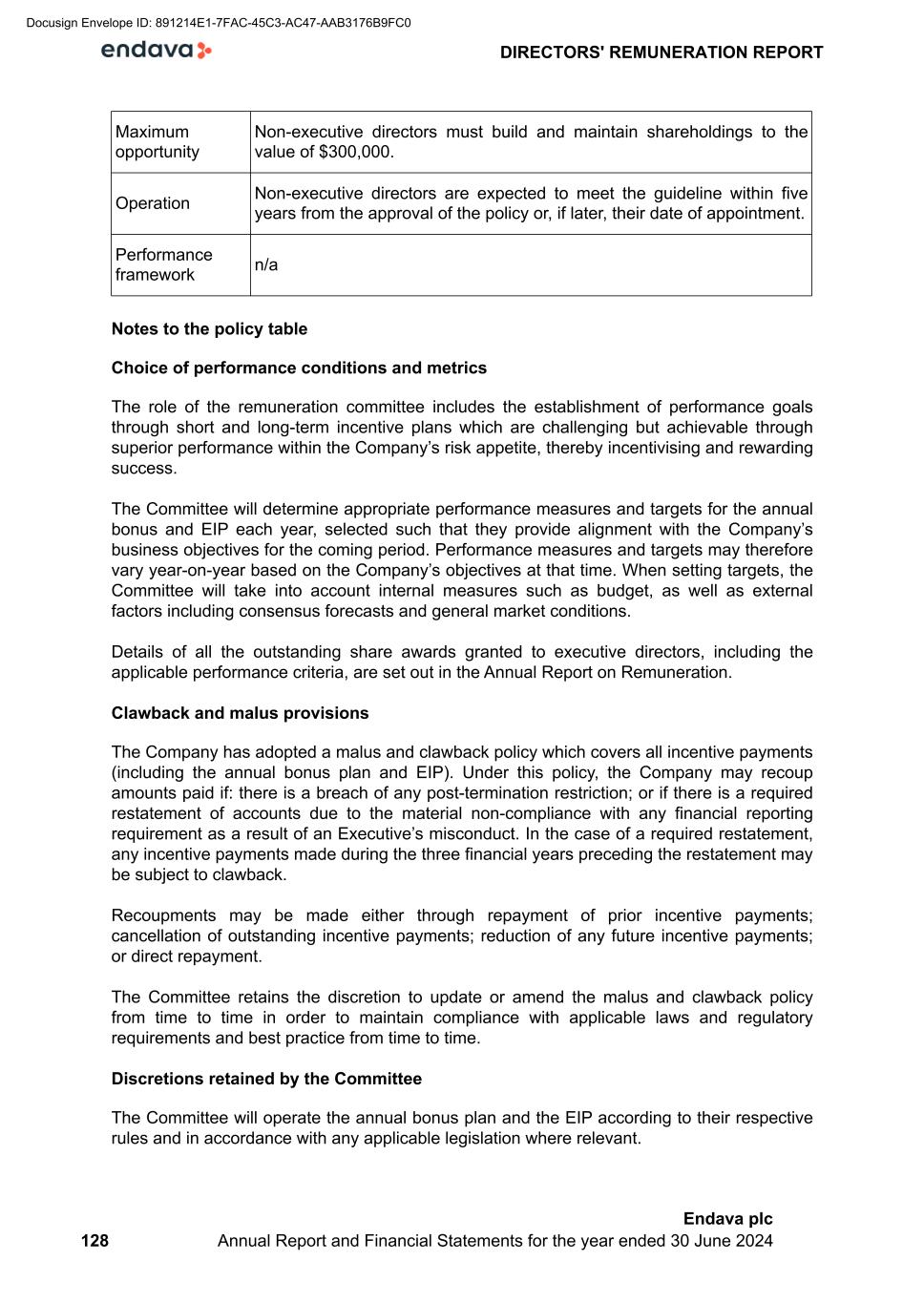
Maximum opportunity Non-executive directors must build and maintain shareholdings to the value of $300,000. Operation Non-executive directors are expected to meet the guideline within five years from the approval of the policy or, if later, their date of appointment. Performance framework n/a Notes to the policy table Choice of performance conditions and metrics The role of the remuneration committee includes the establishment of performance goals through short and long-term incentive plans which are challenging but achievable through superior performance within the Company’s risk appetite, thereby incentivising and rewarding success. The Committee will determine appropriate performance measures and targets for the annual bonus and EIP each year, selected such that they provide alignment with the Company’s business objectives for the coming period. Performance measures and targets may therefore vary year-on-year based on the Company’s objectives at that time. When setting targets, the Committee will take into account internal measures such as budget, as well as external factors including consensus forecasts and general market conditions. Details of all the outstanding share awards granted to executive directors, including the applicable performance criteria, are set out in the Annual Report on Remuneration. Clawback and malus provisions The Company has adopted a malus and clawback policy which covers all incentive payments (including the annual bonus plan and EIP). Under this policy, the Company may recoup amounts paid if: there is a breach of any post-termination restriction; or if there is a required restatement of accounts due to the material non-compliance with any financial reporting requirement as a result of an Executive’s misconduct. In the case of a required restatement, any incentive payments made during the three financial years preceding the restatement may be subject to clawback. Recoupments may be made either through repayment of prior incentive payments; cancellation of outstanding incentive payments; reduction of any future incentive payments; or direct repayment. The Committee retains the discretion to update or amend the malus and clawback policy from time to time in order to maintain compliance with applicable laws and regulatory requirements and best practice from time to time. Discretions retained by the Committee The Committee will operate the annual bonus plan and the EIP according to their respective rules and in accordance with any applicable legislation where relevant. DIRECTORS' REMUNERATION REPORT 128 Endava plc Annual Report and Financial Statements for the year ended 30 June 2024 Docusign Envelope ID: 891214E1-7FAC-45C3-AC47-AAB3176B9FC0
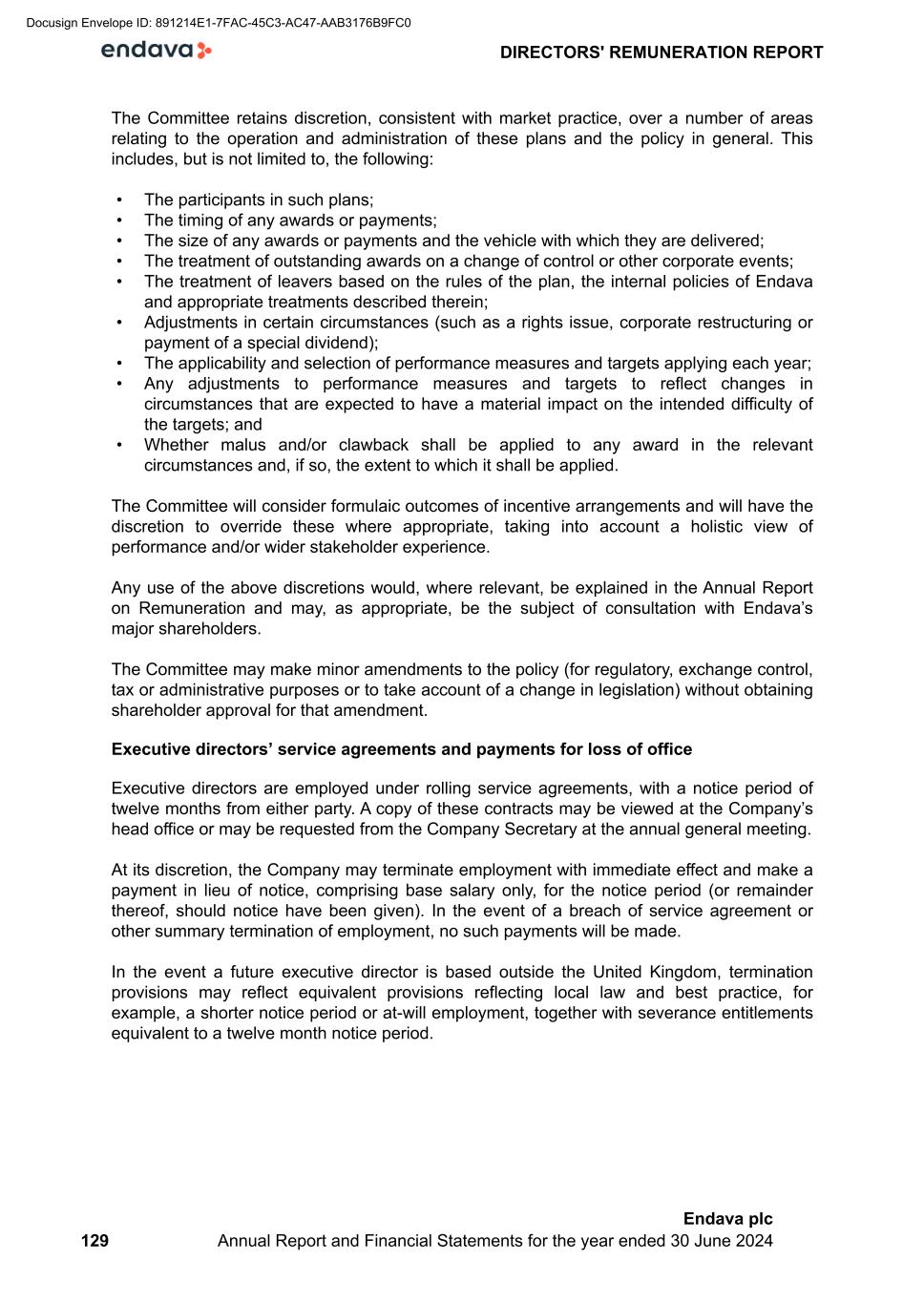
The Committee retains discretion, consistent with market practice, over a number of areas relating to the operation and administration of these plans and the policy in general. This includes, but is not limited to, the following: • The participants in such plans; • The timing of any awards or payments; • The size of any awards or payments and the vehicle with which they are delivered; • The treatment of outstanding awards on a change of control or other corporate events; • The treatment of leavers based on the rules of the plan, the internal policies of Endava and appropriate treatments described therein; • Adjustments in certain circumstances (such as a rights issue, corporate restructuring or payment of a special dividend); • The applicability and selection of performance measures and targets applying each year; • Any adjustments to performance measures and targets to reflect changes in circumstances that are expected to have a material impact on the intended difficulty of the targets; and • Whether malus and/or clawback shall be applied to any award in the relevant circumstances and, if so, the extent to which it shall be applied. The Committee will consider formulaic outcomes of incentive arrangements and will have the discretion to override these where appropriate, taking into account a holistic view of performance and/or wider stakeholder experience. Any use of the above discretions would, where relevant, be explained in the Annual Report on Remuneration and may, as appropriate, be the subject of consultation with Endava’s major shareholders. The Committee may make minor amendments to the policy (for regulatory, exchange control, tax or administrative purposes or to take account of a change in legislation) without obtaining shareholder approval for that amendment. Executive directors’ service agreements and payments for loss of office Executive directors are employed under rolling service agreements, with a notice period of twelve months from either party. A copy of these contracts may be viewed at the Company’s head office or may be requested from the Company Secretary at the annual general meeting. At its discretion, the Company may terminate employment with immediate effect and make a payment in lieu of notice, comprising base salary only, for the notice period (or remainder thereof, should notice have been given). In the event of a breach of service agreement or other summary termination of employment, no such payments will be made. In the event a future executive director is based outside the United Kingdom, termination provisions may reflect equivalent provisions reflecting local law and best practice, for example, a shorter notice period or at-will employment, together with severance entitlements equivalent to a twelve month notice period. DIRECTORS' REMUNERATION REPORT 129 Endava plc Annual Report and Financial Statements for the year ended 30 June 2024 Docusign Envelope ID: 891214E1-7FAC-45C3-AC47-AAB3176B9FC0
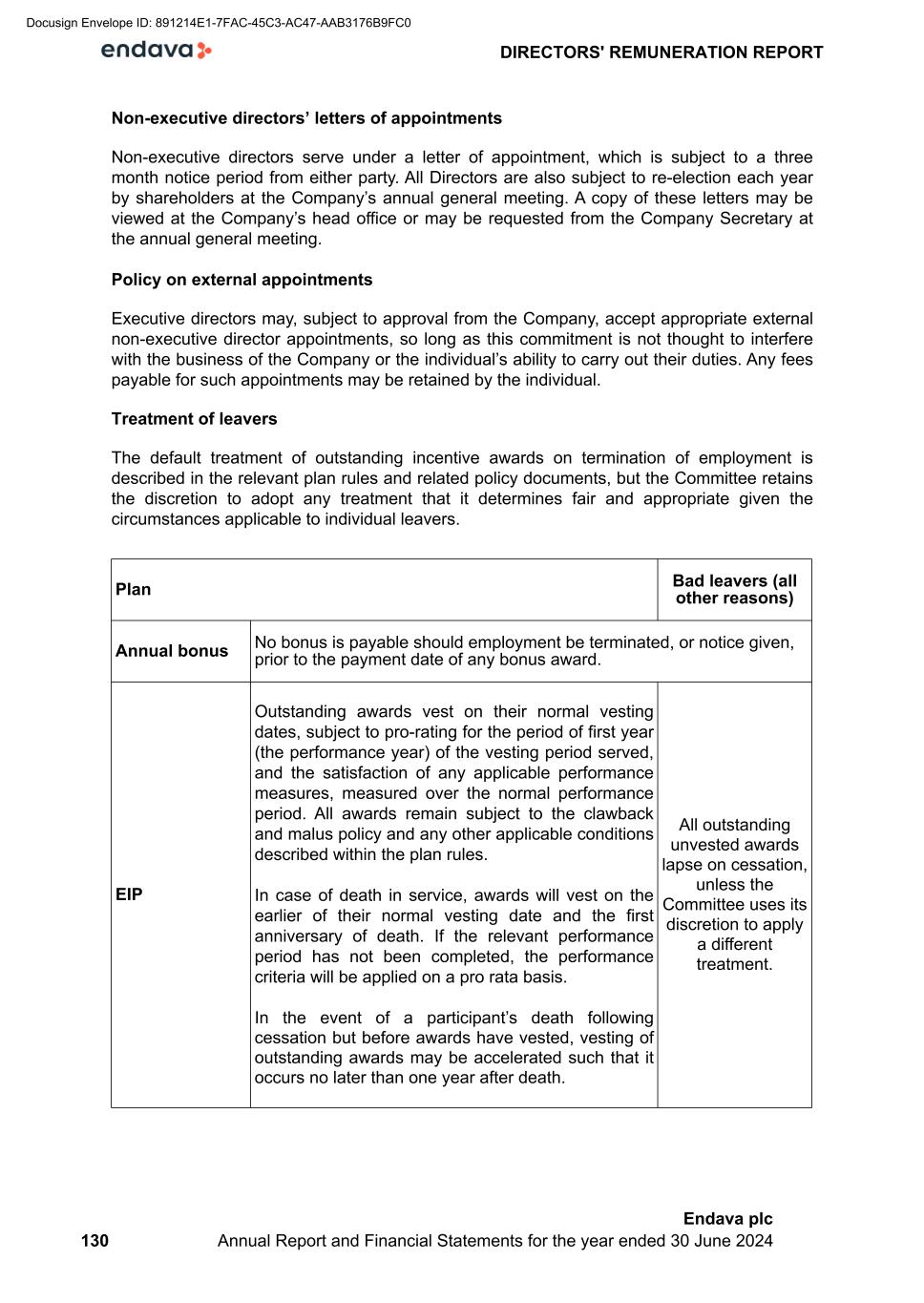
Non-executive directors’ letters of appointments Non-executive directors serve under a letter of appointment, which is subject to a three month notice period from either party. All Directors are also subject to re-election each year by shareholders at the Company’s annual general meeting. A copy of these letters may be viewed at the Company’s head office or may be requested from the Company Secretary at the annual general meeting. Policy on external appointments Executive directors may, subject to approval from the Company, accept appropriate external non-executive director appointments, so long as this commitment is not thought to interfere with the business of the Company or the individual’s ability to carry out their duties. Any fees payable for such appointments may be retained by the individual. Treatment of leavers The default treatment of outstanding incentive awards on termination of employment is described in the relevant plan rules and related policy documents, but the Committee retains the discretion to adopt any treatment that it determines fair and appropriate given the circumstances applicable to individual leavers. Plan Bad leavers (all other reasons) Annual bonus No bonus is payable should employment be terminated, or notice given, prior to the payment date of any bonus award. EIP Outstanding awards vest on their normal vesting dates, subject to pro-rating for the period of first year (the performance year) of the vesting period served, and the satisfaction of any applicable performance measures, measured over the normal performance period. All awards remain subject to the clawback and malus policy and any other applicable conditions described within the plan rules. In case of death in service, awards will vest on the earlier of their normal vesting date and the first anniversary of death. If the relevant performance period has not been completed, the performance criteria will be applied on a pro rata basis. In the event of a participant’s death following cessation but before awards have vested, vesting of outstanding awards may be accelerated such that it occurs no later than one year after death. All outstanding unvested awards lapse on cessation, unless the Committee uses its discretion to apply a different treatment. DIRECTORS' REMUNERATION REPORT 130 Endava plc Annual Report and Financial Statements for the year ended 30 June 2024 Docusign Envelope ID: 891214E1-7FAC-45C3-AC47-AAB3176B9FC0
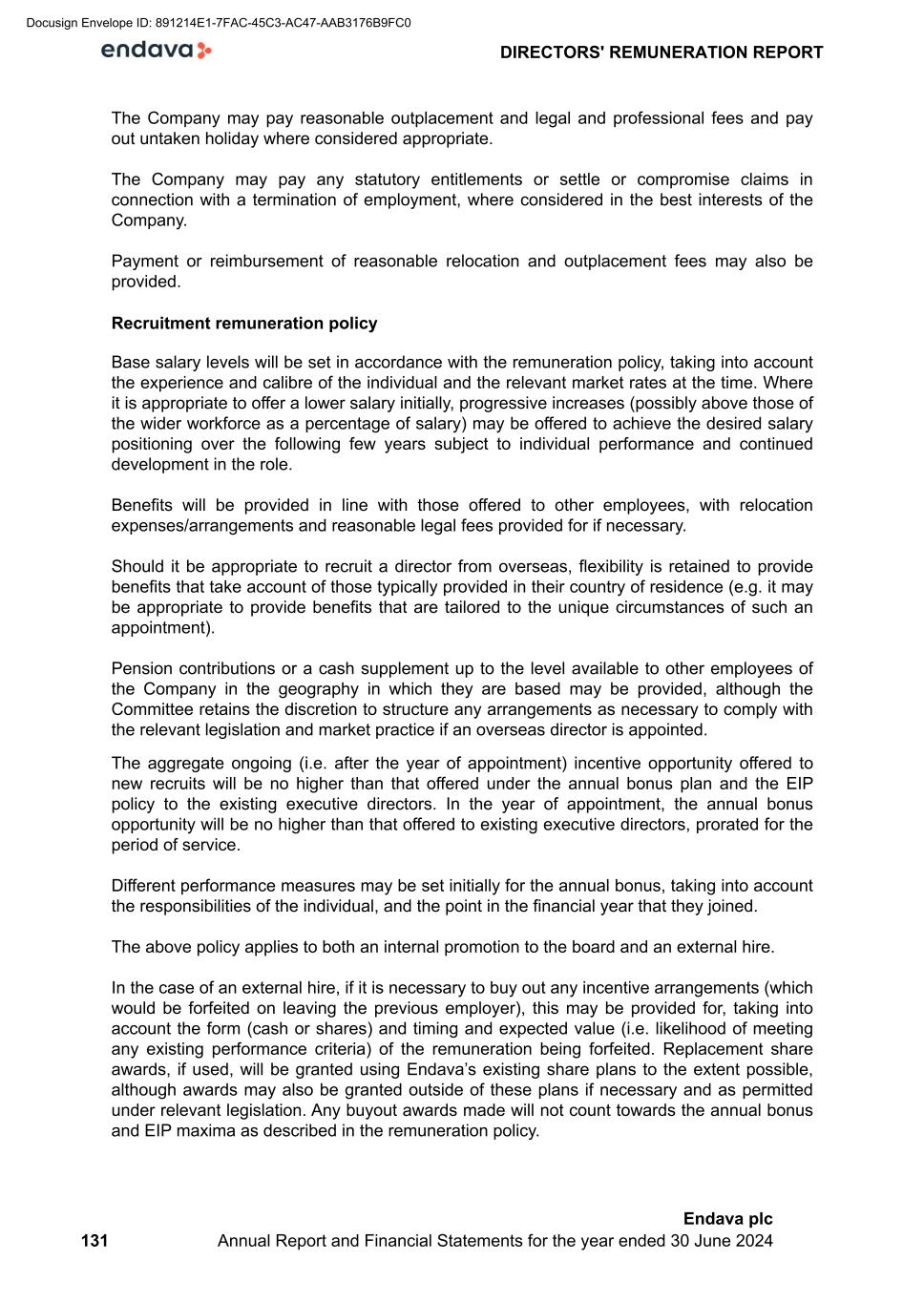
The Company may pay reasonable outplacement and legal and professional fees and pay out untaken holiday where considered appropriate. The Company may pay any statutory entitlements or settle or compromise claims in connection with a termination of employment, where considered in the best interests of the Company. Payment or reimbursement of reasonable relocation and outplacement fees may also be provided. Recruitment remuneration policy Base salary levels will be set in accordance with the remuneration policy, taking into account the experience and calibre of the individual and the relevant market rates at the time. Where it is appropriate to offer a lower salary initially, progressive increases (possibly above those of the wider workforce as a percentage of salary) may be offered to achieve the desired salary positioning over the following few years subject to individual performance and continued development in the role. Benefits will be provided in line with those offered to other employees, with relocation expenses/arrangements and reasonable legal fees provided for if necessary. Should it be appropriate to recruit a director from overseas, flexibility is retained to provide benefits that take account of those typically provided in their country of residence (e.g. it may be appropriate to provide benefits that are tailored to the unique circumstances of such an appointment). Pension contributions or a cash supplement up to the level available to other employees of the Company in the geography in which they are based may be provided, although the Committee retains the discretion to structure any arrangements as necessary to comply with the relevant legislation and market practice if an overseas director is appointed. The aggregate ongoing (i.e. after the year of appointment) incentive opportunity offered to new recruits will be no higher than that offered under the annual bonus plan and the EIP policy to the existing executive directors. In the year of appointment, the annual bonus opportunity will be no higher than that offered to existing executive directors, prorated for the period of service. Different performance measures may be set initially for the annual bonus, taking into account the responsibilities of the individual, and the point in the financial year that they joined. The above policy applies to both an internal promotion to the board and an external hire. In the case of an external hire, if it is necessary to buy out any incentive arrangements (which would be forfeited on leaving the previous employer), this may be provided for, taking into account the form (cash or shares) and timing and expected value (i.e. likelihood of meeting any existing performance criteria) of the remuneration being forfeited. Replacement share awards, if used, will be granted using Endava’s existing share plans to the extent possible, although awards may also be granted outside of these plans if necessary and as permitted under relevant legislation. Any buyout awards made will not count towards the annual bonus and EIP maxima as described in the remuneration policy. DIRECTORS' REMUNERATION REPORT 131 Endava plc Annual Report and Financial Statements for the year ended 30 June 2024 Docusign Envelope ID: 891214E1-7FAC-45C3-AC47-AAB3176B9FC0
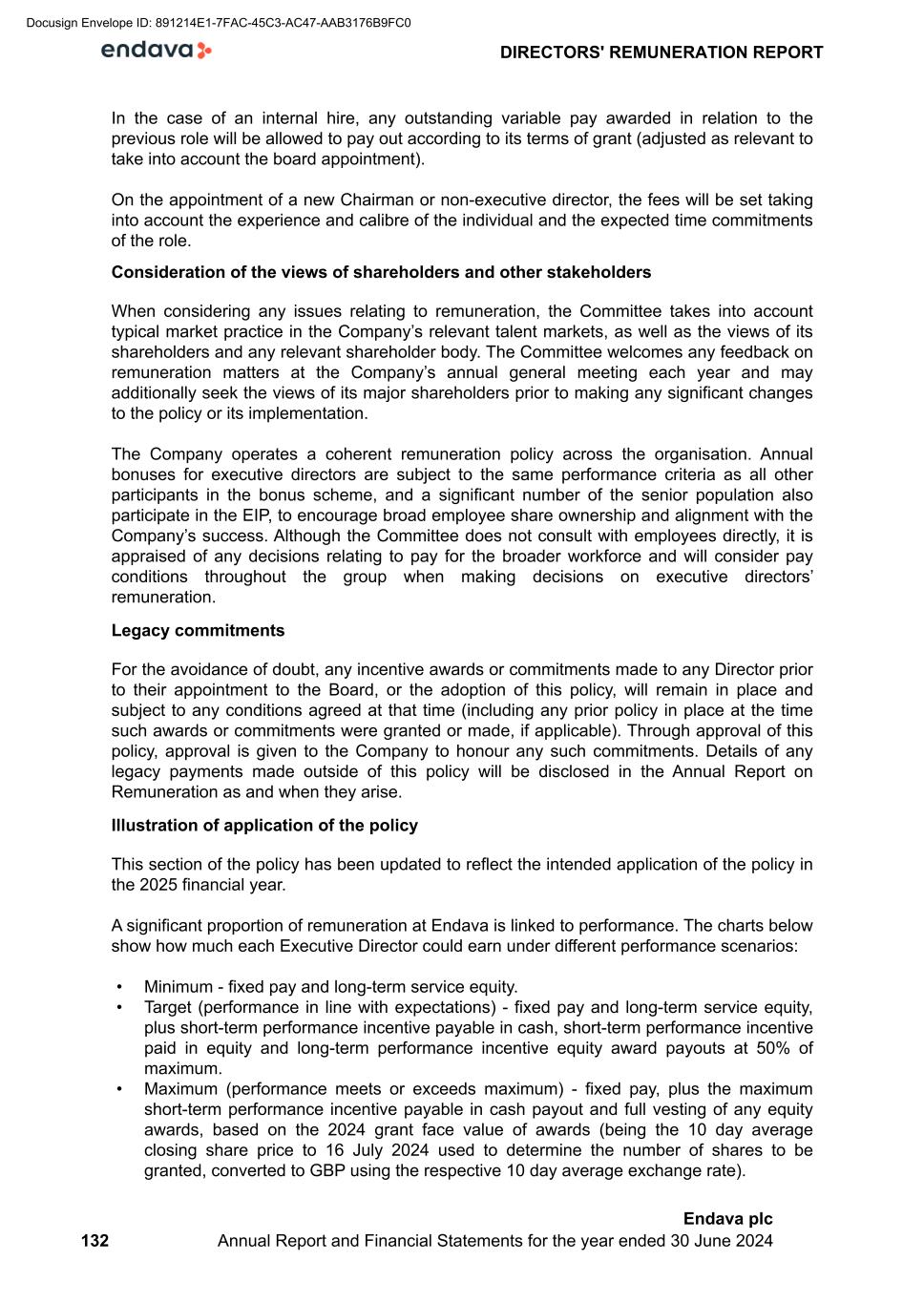
In the case of an internal hire, any outstanding variable pay awarded in relation to the previous role will be allowed to pay out according to its terms of grant (adjusted as relevant to take into account the board appointment). On the appointment of a new Chairman or non-executive director, the fees will be set taking into account the experience and calibre of the individual and the expected time commitments of the role. Consideration of the views of shareholders and other stakeholders When considering any issues relating to remuneration, the Committee takes into account typical market practice in the Company’s relevant talent markets, as well as the views of its shareholders and any relevant shareholder body. The Committee welcomes any feedback on remuneration matters at the Company’s annual general meeting each year and may additionally seek the views of its major shareholders prior to making any significant changes to the policy or its implementation. The Company operates a coherent remuneration policy across the organisation. Annual bonuses for executive directors are subject to the same performance criteria as all other participants in the bonus scheme, and a significant number of the senior population also participate in the EIP, to encourage broad employee share ownership and alignment with the Company’s success. Although the Committee does not consult with employees directly, it is appraised of any decisions relating to pay for the broader workforce and will consider pay conditions throughout the group when making decisions on executive directors’ remuneration. Legacy commitments For the avoidance of doubt, any incentive awards or commitments made to any Director prior to their appointment to the Board, or the adoption of this policy, will remain in place and subject to any conditions agreed at that time (including any prior policy in place at the time such awards or commitments were granted or made, if applicable). Through approval of this policy, approval is given to the Company to honour any such commitments. Details of any legacy payments made outside of this policy will be disclosed in the Annual Report on Remuneration as and when they arise. Illustration of application of the policy This section of the policy has been updated to reflect the intended application of the policy in the 2025 financial year. A significant proportion of remuneration at Endava is linked to performance. The charts below show how much each Executive Director could earn under different performance scenarios: • Minimum - fixed pay and long-term service equity. • Target (performance in line with expectations) - fixed pay and long-term service equity, plus short-term performance incentive payable in cash, short-term performance incentive paid in equity and long-term performance incentive equity award payouts at 50% of maximum. • Maximum (performance meets or exceeds maximum) - fixed pay, plus the maximum short-term performance incentive payable in cash payout and full vesting of any equity awards, based on the 2024 grant face value of awards (being the 10 day average closing share price to 16 July 2024 used to determine the number of shares to be granted, converted to GBP using the respective 10 day average exchange rate). DIRECTORS' REMUNERATION REPORT 132 Endava plc Annual Report and Financial Statements for the year ended 30 June 2024 Docusign Envelope ID: 891214E1-7FAC-45C3-AC47-AAB3176B9FC0
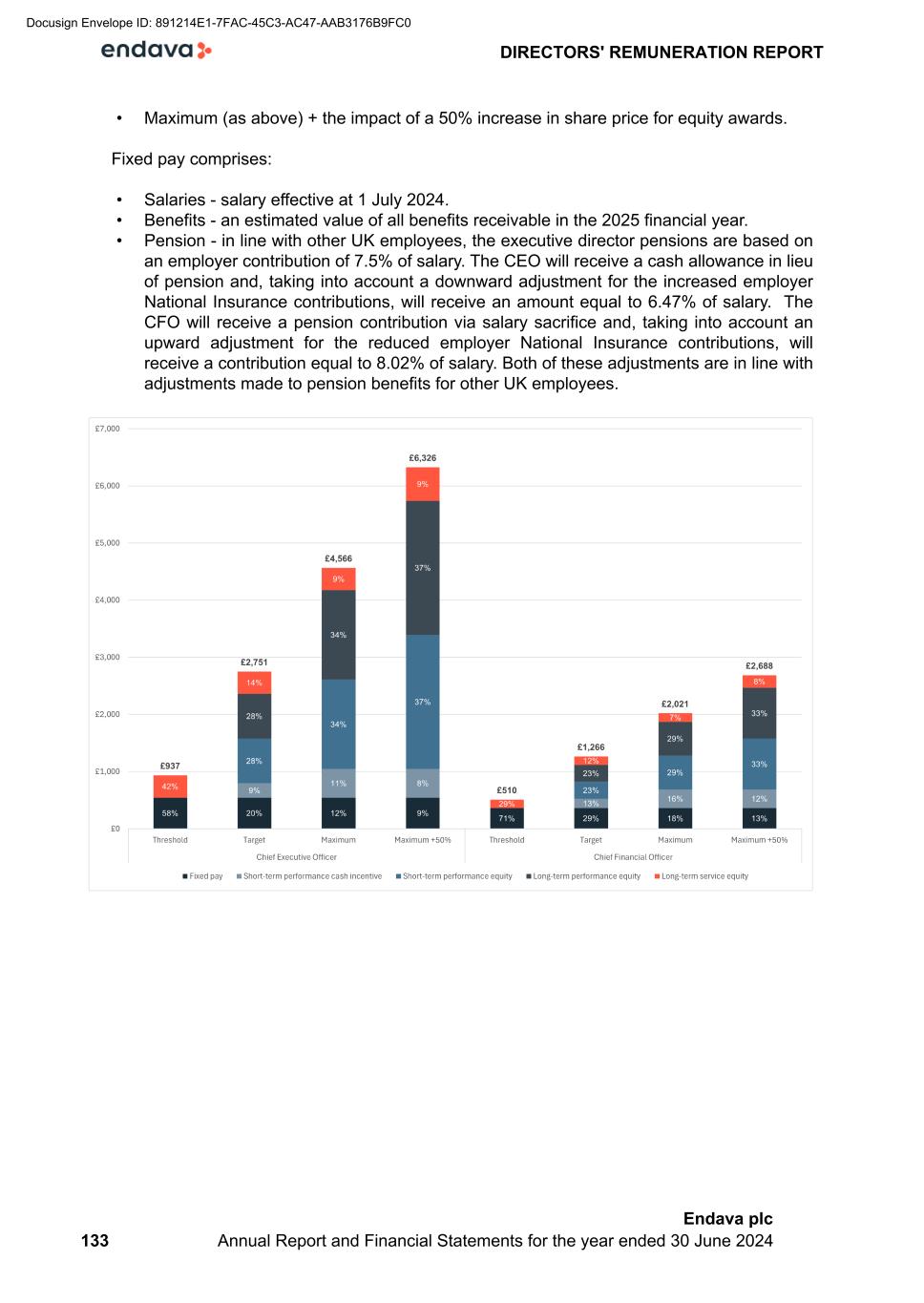
• Maximum (as above) + the impact of a 50% increase in share price for equity awards. Fixed pay comprises: • Salaries - salary effective at 1 July 2024. • Benefits - an estimated value of all benefits receivable in the 2025 financial year. • Pension - in line with other UK employees, the executive director pensions are based on an employer contribution of 7.5% of salary. The CEO will receive a cash allowance in lieu of pension and, taking into account a downward adjustment for the increased employer National Insurance contributions, will receive an amount equal to 6.47% of salary. The CFO will receive a pension contribution via salary sacrifice and, taking into account an upward adjustment for the reduced employer National Insurance contributions, will receive a contribution equal to 8.02% of salary. Both of these adjustments are in line with adjustments made to pension benefits for other UK employees. DIRECTORS' REMUNERATION REPORT 133 Endava plc Annual Report and Financial Statements for the year ended 30 June 2024 Docusign Envelope ID: 891214E1-7FAC-45C3-AC47-AAB3176B9FC0
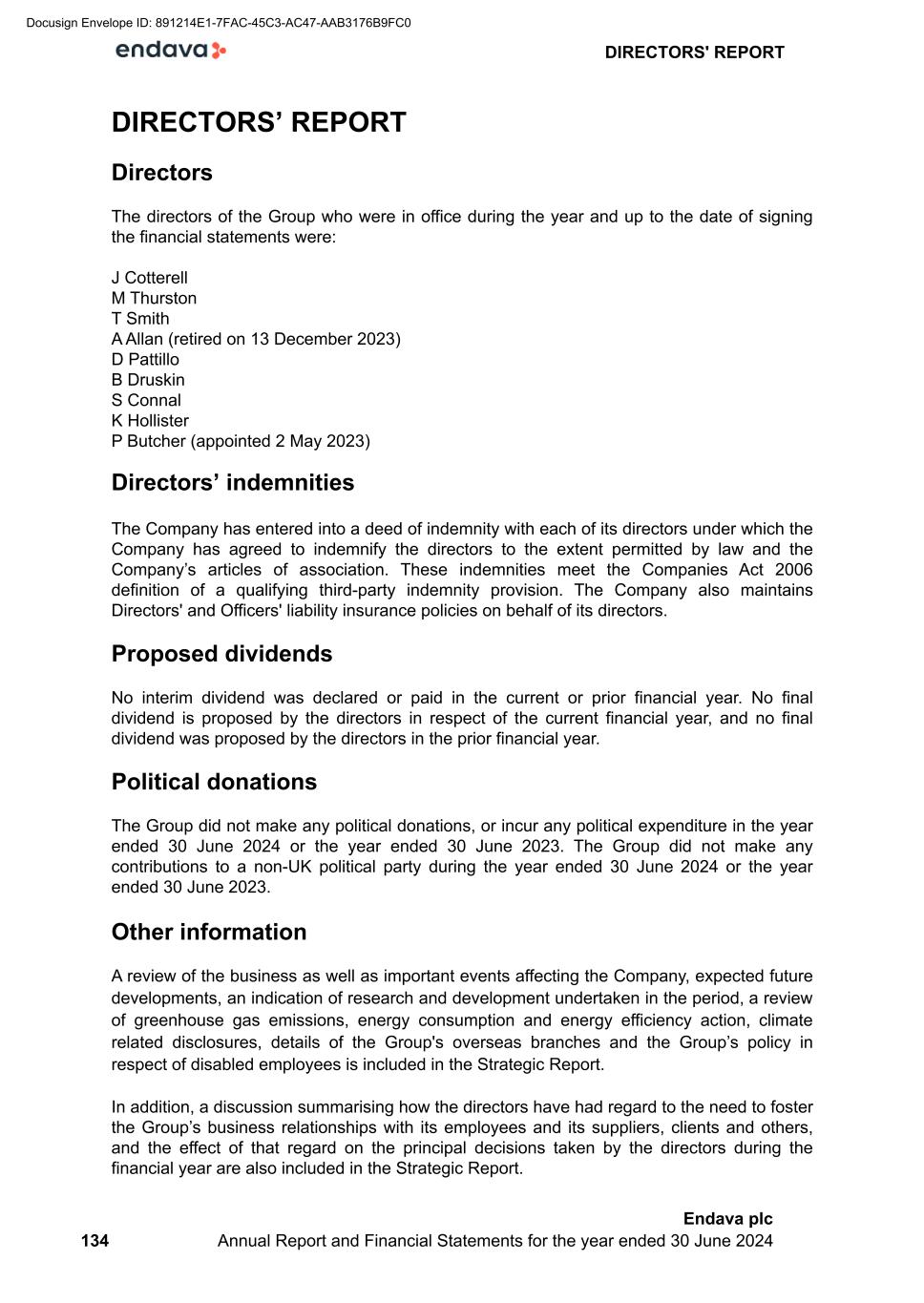
DIRECTORS’ REPORT Directors The directors of the Group who were in office during the year and up to the date of signing the financial statements were: J Cotterell M Thurston T Smith A Allan (retired on 13 December 2023) D Pattillo B Druskin S Connal K Hollister P Butcher (appointed 2 May 2023) Directors’ indemnities The Company has entered into a deed of indemnity with each of its directors under which the Company has agreed to indemnify the directors to the extent permitted by law and the Company’s articles of association. These indemnities meet the Companies Act 2006 definition of a qualifying third-party indemnity provision. The Company also maintains Directors' and Officers' liability insurance policies on behalf of its directors. Proposed dividends No interim dividend was declared or paid in the current or prior financial year. No final dividend is proposed by the directors in respect of the current financial year, and no final dividend was proposed by the directors in the prior financial year. Political donations The Group did not make any political donations, or incur any political expenditure in the year ended 30 June 2024 or the year ended 30 June 2023. The Group did not make any contributions to a non-UK political party during the year ended 30 June 2024 or the year ended 30 June 2023. Other information A review of the business as well as important events affecting the Company, expected future developments, an indication of research and development undertaken in the period, a review of greenhouse gas emissions, energy consumption and energy efficiency action, climate related disclosures, details of the Group's overseas branches and the Group’s policy in respect of disabled employees is included in the Strategic Report. In addition, a discussion summarising how the directors have had regard to the need to foster the Group’s business relationships with its employees and its suppliers, clients and others, and the effect of that regard on the principal decisions taken by the directors during the financial year are also included in the Strategic Report. DIRECTORS' REPORT 134 Endava plc Annual Report and Financial Statements for the year ended 30 June 2024 Docusign Envelope ID: 891214E1-7FAC-45C3-AC47-AAB3176B9FC0

Finally, the statement of corporate governance arrangements for the Company for the financial year is included in the Strategic Report under the heading “Governance”. Financial risk management Details of financial risk management and the use of financial instruments are disclosed in Note 31 of the Group financial statements. Independent auditors The independent auditors for the year ended 30 June 2024 were PricewaterhouseCoopers LLP, or PwC. At the Company's annual general meeting held on 13 December 2023, a resolution was passed to appoint PwC as the Company's auditor to act as such until the Company's next annual general meeting. In accordance with Section 489 of the Companies Act 2006, a resolution for the re-appointment of PwC as statutory auditor of the Company is to be proposed at the forthcoming annual general meeting. Liquidity and going concern In accordance with IAS 1 ‘Presentation of financial statements’, and revised Financial Reporting Council ("FRC") guidance on ‘risk management, internal control and related financial and business reporting’, the Directors have considered the funding and liquidity position of the Group and have assessed the Group’s ability to continue as a going concern for the foreseeable future. In doing so, the Directors have reviewed the Group’s budget and forecasts, and have taken into account all available information about the future for a period of at least, but not limited to, 12 months from the date of approval of these consolidated financial statements. The Group meets its day-to-day working capital requirements and medium-term funding requirements through its trading cash flows. At 30 June 2024, the Group had net assets of £639.5 million and net current assets of £113.8 million, of which £62.4 million was cash and cash equivalents. In addition, the Group has a remaining undrawn revolving credit facility (RCF) of £205.2 million which matures in 2027. The Directors have considered the business activities and the Group’s principal risks and uncertainties in the context of the current operating environment. This includes the associated risks with doing business in an environment with inflationary pressures and risk of recession increasing in certain markets. We have also assessed the risk of breaching RCF covenants now that Endava has drawn down under the RCF as at 30 June 2024. The Directors have reviewed the Group’s liquidity and modelled cash flow projections to produce a baseline forecast scenario. The Directors have also considered sensitivities in respect of a potential severe but plausible downside scenario over and above the baseline scenario concluding that the Group is still able to continue in operation for a period of at least 12 months from the date of approval of these consolidated financial statements. The baseline scenario was derived from the FY25 forecast approved by the Board. DIRECTORS' REPORT 135 Endava plc Annual Report and Financial Statements for the year ended 30 June 2024 Docusign Envelope ID: 891214E1-7FAC-45C3-AC47-AAB3176B9FC0
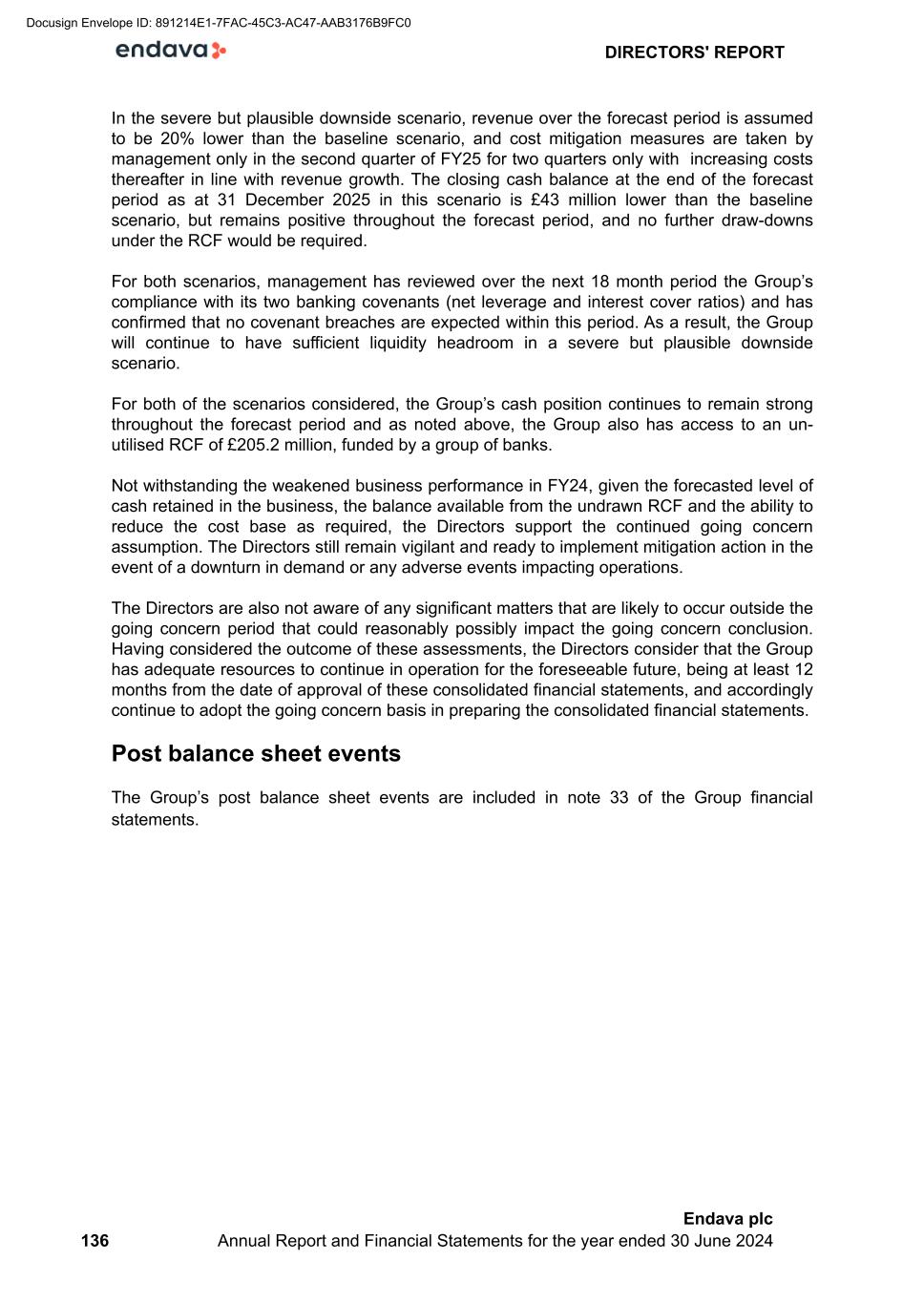
In the severe but plausible downside scenario, revenue over the forecast period is assumed to be 20% lower than the baseline scenario, and cost mitigation measures are taken by management only in the second quarter of FY25 for two quarters only with increasing costs thereafter in line with revenue growth. The closing cash balance at the end of the forecast period as at 31 December 2025 in this scenario is £43 million lower than the baseline scenario, but remains positive throughout the forecast period, and no further draw-downs under the RCF would be required. For both scenarios, management has reviewed over the next 18 month period the Group’s compliance with its two banking covenants (net leverage and interest cover ratios) and has confirmed that no covenant breaches are expected within this period. As a result, the Group will continue to have sufficient liquidity headroom in a severe but plausible downside scenario. For both of the scenarios considered, the Group’s cash position continues to remain strong throughout the forecast period and as noted above, the Group also has access to an un- utilised RCF of £205.2 million, funded by a group of banks. Not withstanding the weakened business performance in FY24, given the forecasted level of cash retained in the business, the balance available from the undrawn RCF and the ability to reduce the cost base as required, the Directors support the continued going concern assumption. The Directors still remain vigilant and ready to implement mitigation action in the event of a downturn in demand or any adverse events impacting operations. The Directors are also not aware of any significant matters that are likely to occur outside the going concern period that could reasonably possibly impact the going concern conclusion. Having considered the outcome of these assessments, the Directors consider that the Group has adequate resources to continue in operation for the foreseeable future, being at least 12 months from the date of approval of these consolidated financial statements, and accordingly continue to adopt the going concern basis in preparing the consolidated financial statements. Post balance sheet events The Group’s post balance sheet events are included in note 33 of the Group financial statements. DIRECTORS' REPORT 136 Endava plc Annual Report and Financial Statements for the year ended 30 June 2024 Docusign Envelope ID: 891214E1-7FAC-45C3-AC47-AAB3176B9FC0
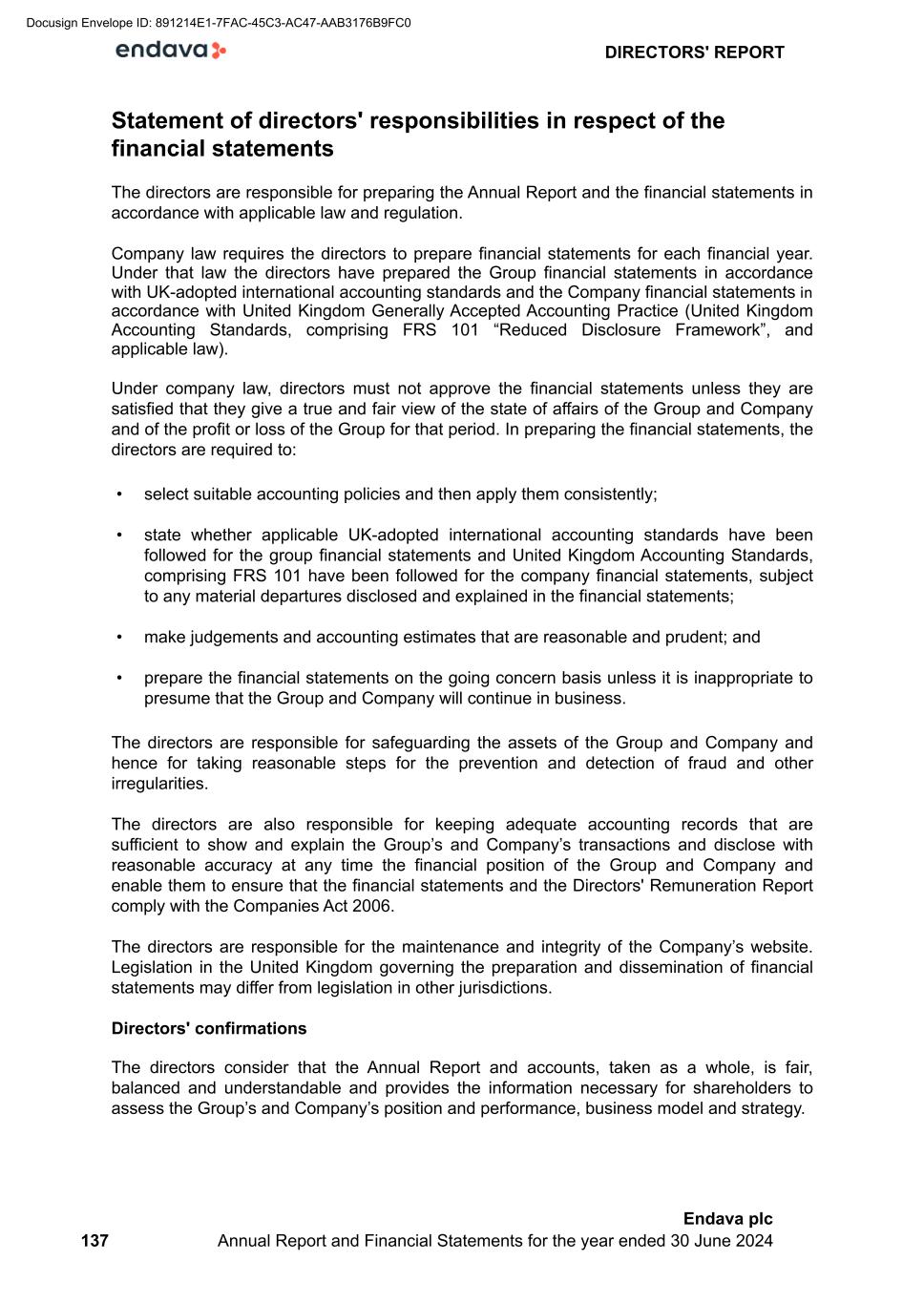
Statement of directors' responsibilities in respect of the financial statements The directors are responsible for preparing the Annual Report and the financial statements in accordance with applicable law and regulation. Company law requires the directors to prepare financial statements for each financial year. Under that law the directors have prepared the Group financial statements in accordance with UK-adopted international accounting standards and the Company financial statements in accordance with United Kingdom Generally Accepted Accounting Practice (United Kingdom Accounting Standards, comprising FRS 101 “Reduced Disclosure Framework”, and applicable law). Under company law, directors must not approve the financial statements unless they are satisfied that they give a true and fair view of the state of affairs of the Group and Company and of the profit or loss of the Group for that period. In preparing the financial statements, the directors are required to: • select suitable accounting policies and then apply them consistently; • state whether applicable UK-adopted international accounting standards have been followed for the group financial statements and United Kingdom Accounting Standards, comprising FRS 101 have been followed for the company financial statements, subject to any material departures disclosed and explained in the financial statements; • make judgements and accounting estimates that are reasonable and prudent; and • prepare the financial statements on the going concern basis unless it is inappropriate to presume that the Group and Company will continue in business. The directors are responsible for safeguarding the assets of the Group and Company and hence for taking reasonable steps for the prevention and detection of fraud and other irregularities. The directors are also responsible for keeping adequate accounting records that are sufficient to show and explain the Group’s and Company’s transactions and disclose with reasonable accuracy at any time the financial position of the Group and Company and enable them to ensure that the financial statements and the Directors' Remuneration Report comply with the Companies Act 2006. The directors are responsible for the maintenance and integrity of the Company’s website. Legislation in the United Kingdom governing the preparation and dissemination of financial statements may differ from legislation in other jurisdictions. Directors' confirmations The directors consider that the Annual Report and accounts, taken as a whole, is fair, balanced and understandable and provides the information necessary for shareholders to assess the Group’s and Company’s position and performance, business model and strategy. DIRECTORS' REPORT 137 Endava plc Annual Report and Financial Statements for the year ended 30 June 2024 Docusign Envelope ID: 891214E1-7FAC-45C3-AC47-AAB3176B9FC0
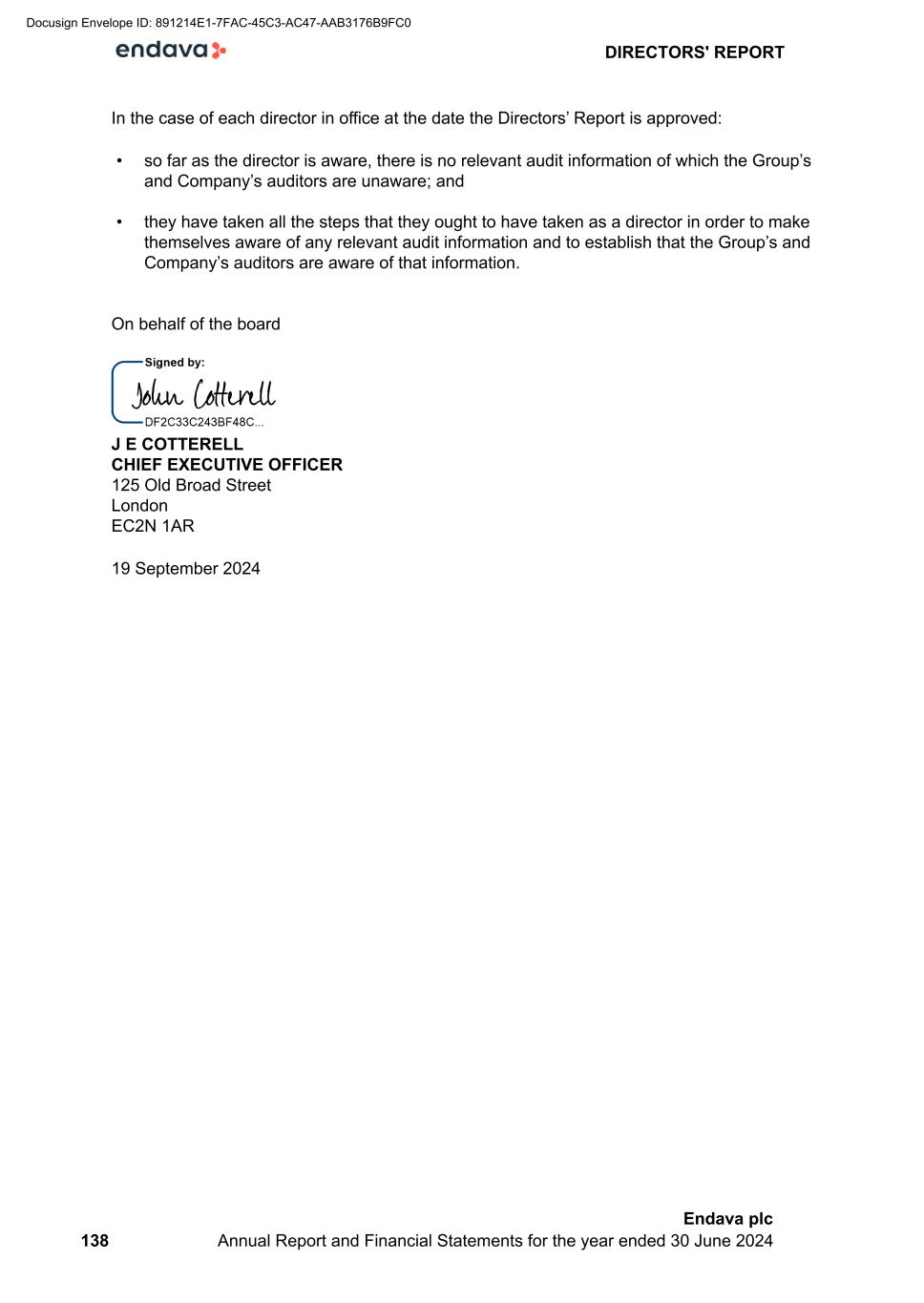
In the case of each director in office at the date the Directors’ Report is approved: • so far as the director is aware, there is no relevant audit information of which the Group’s and Company’s auditors are unaware; and • they have taken all the steps that they ought to have taken as a director in order to make themselves aware of any relevant audit information and to establish that the Group’s and Company’s auditors are aware of that information. On behalf of the board J E COTTERELL CHIEF EXECUTIVE OFFICER 125 Old Broad Street London EC2N 1AR 19 September 2024 DIRECTORS' REPORT 138 Endava plc Annual Report and Financial Statements for the year ended 30 June 2024 Docusign Envelope ID: 891214E1-7FAC-45C3-AC47-AAB3176B9FC0
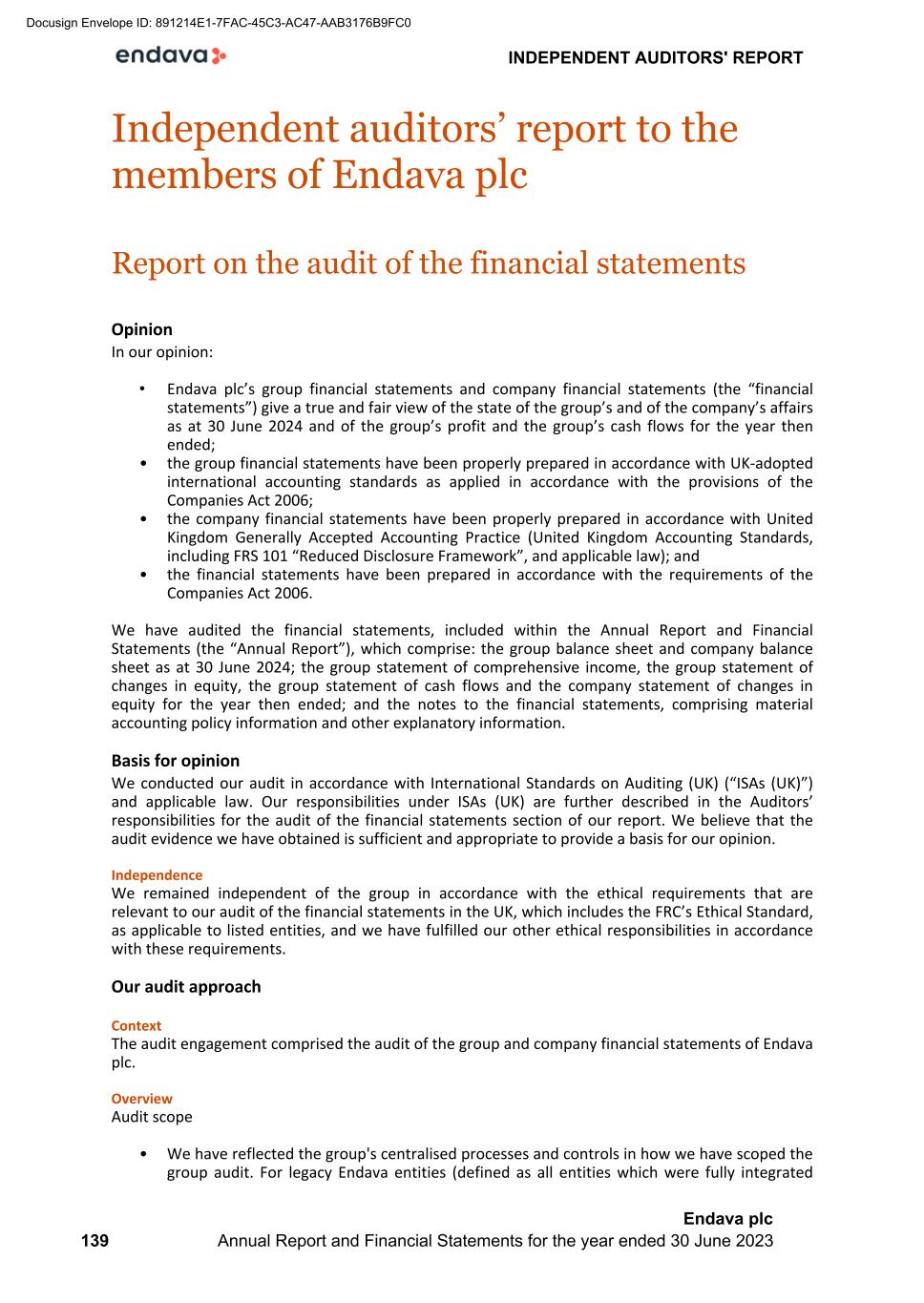
Independent auditors’ report to the members of Endava plc Report on the audit of the financial statements Opinion In our opinion: • Endava plc’s group financial statements and company financial statements (the “financial statements”) give a true and fair view of the state of the group’s and of the company’s affairs as at 30 June 2024 and of the group’s profit and the group’s cash flows for the year then ended; • the group financial statements have been properly prepared in accordance with UK-adopted international accounting standards as applied in accordance with the provisions of the Companies Act 2006; • the company financial statements have been properly prepared in accordance with United Kingdom Generally Accepted Accounting Practice (United Kingdom Accounting Standards, including FRS 101 “Reduced Disclosure Framework”, and applicable law); and • the financial statements have been prepared in accordance with the requirements of the Companies Act 2006. We have audited the financial statements, included within the Annual Report and Financial Statements (the “Annual Report”), which comprise: the group balance sheet and company balance sheet as at 30 June 2024; the group statement of comprehensive income, the group statement of changes in equity, the group statement of cash flows and the company statement of changes in equity for the year then ended; and the notes to the financial statements, comprising material accounting policy information and other explanatory information. Basis for opinion We conducted our audit in accordance with International Standards on Auditing (UK) (“ISAs (UK)”) and applicable law. Our responsibilities under ISAs (UK) are further described in the Auditors’ responsibilities for the audit of the financial statements section of our report. We believe that the audit evidence we have obtained is sufficient and appropriate to provide a basis for our opinion. Independence We remained independent of the group in accordance with the ethical requirements that are relevant to our audit of the financial statements in the UK, which includes the FRC’s Ethical Standard, as applicable to listed entities, and we have fulfilled our other ethical responsibilities in accordance with these requirements. Our audit approach Context The audit engagement comprised the audit of the group and company financial statements of Endava plc. Overview Audit scope • We have reflected the group's centralised processes and controls in how we have scoped the group audit. For legacy Endava entities (defined as all entities which were fully integrated INDEPENDENT AUDITORS' REPORT 139 Endava plc Annual Report and Financial Statements for the year ended 30 June 2023 Docusign Envelope ID: 891214E1-7FAC-45C3-AC47-AAB3176B9FC0
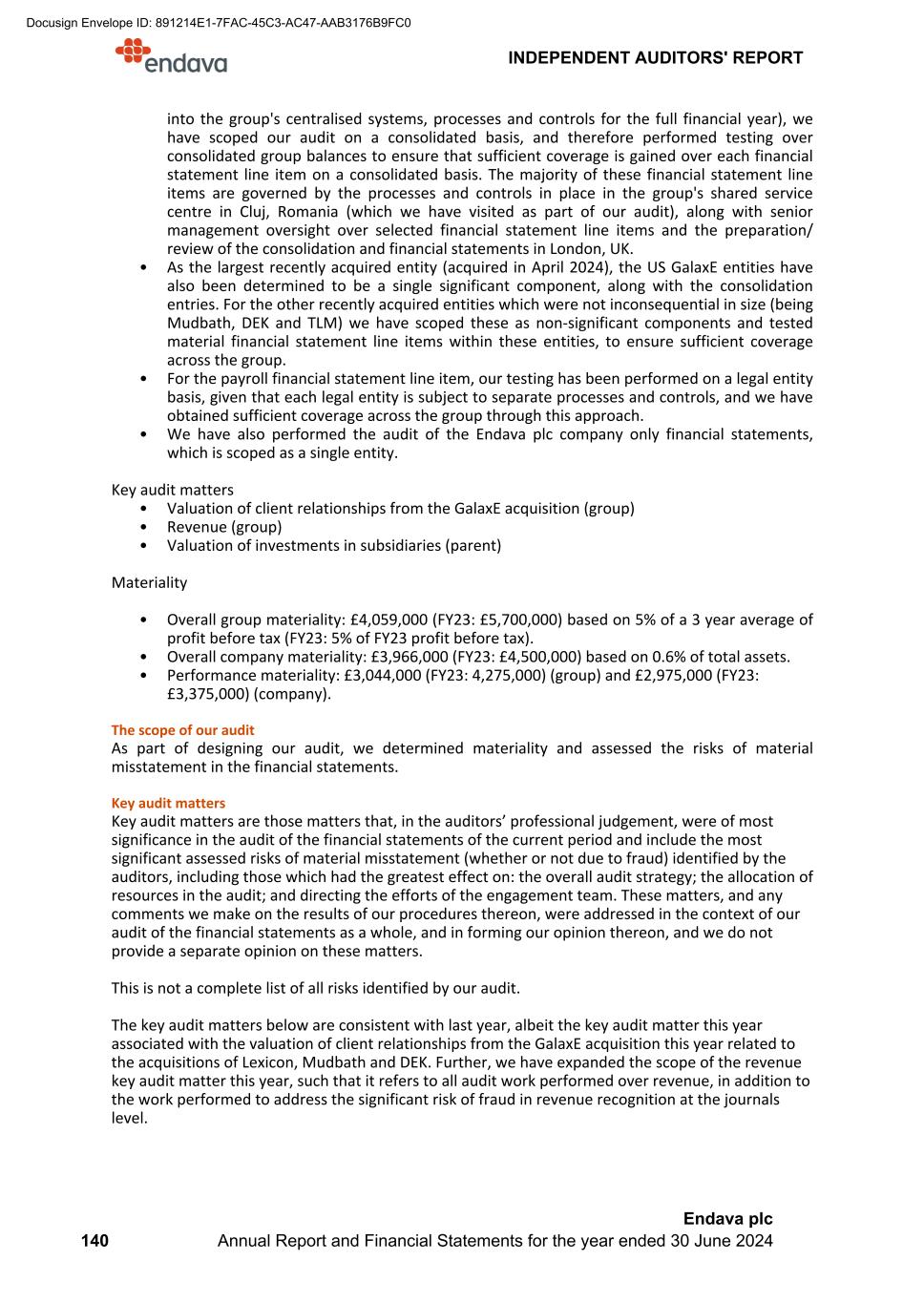
into the group's centralised systems, processes and controls for the full financial year), we have scoped our audit on a consolidated basis, and therefore performed testing over consolidated group balances to ensure that sufficient coverage is gained over each financial statement line item on a consolidated basis. The majority of these financial statement line items are governed by the processes and controls in place in the group's shared service centre in Cluj, Romania (which we have visited as part of our audit), along with senior management oversight over selected financial statement line items and the preparation/ review of the consolidation and financial statements in London, UK. • As the largest recently acquired entity (acquired in April 2024), the US GalaxE entities have also been determined to be a single significant component, along with the consolidation entries. For the other recently acquired entities which were not inconsequential in size (being Mudbath, DEK and TLM) we have scoped these as non-significant components and tested material financial statement line items within these entities, to ensure sufficient coverage across the group. • For the payroll financial statement line item, our testing has been performed on a legal entity basis, given that each legal entity is subject to separate processes and controls, and we have obtained sufficient coverage across the group through this approach. • We have also performed the audit of the Endava plc company only financial statements, which is scoped as a single entity. Key audit matters • Valuation of client relationships from the GalaxE acquisition (group) • Revenue (group) • Valuation of investments in subsidiaries (parent) Materiality • Overall group materiality: £4,059,000 (FY23: £5,700,000) based on 5% of a 3 year average of profit before tax (FY23: 5% of FY23 profit before tax). • Overall company materiality: £3,966,000 (FY23: £4,500,000) based on 0.6% of total assets. • Performance materiality: £3,044,000 (FY23: 4,275,000) (group) and £2,975,000 (FY23: £3,375,000) (company). The scope of our audit As part of designing our audit, we determined materiality and assessed the risks of material misstatement in the financial statements. Key audit matters Key audit matters are those matters that, in the auditors’ professional judgement, were of most significance in the audit of the financial statements of the current period and include the most significant assessed risks of material misstatement (whether or not due to fraud) identified by the auditors, including those which had the greatest effect on: the overall audit strategy; the allocation of resources in the audit; and directing the efforts of the engagement team. These matters, and any comments we make on the results of our procedures thereon, were addressed in the context of our audit of the financial statements as a whole, and in forming our opinion thereon, and we do not provide a separate opinion on these matters. This is not a complete list of all risks identified by our audit. The key audit matters below are consistent with last year, albeit the key audit matter this year associated with the valuation of client relationships from the GalaxE acquisition this year related to the acquisitions of Lexicon, Mudbath and DEK. Further, we have expanded the scope of the revenue key audit matter this year, such that it refers to all audit work performed over revenue, in addition to the work performed to address the significant risk of fraud in revenue recognition at the journals level. INDEPENDENT AUDITORS' REPORT 140 Endava plc Annual Report and Financial Statements for the year ended 30 June 2024 Docusign Envelope ID: 891214E1-7FAC-45C3-AC47-AAB3176B9FC0
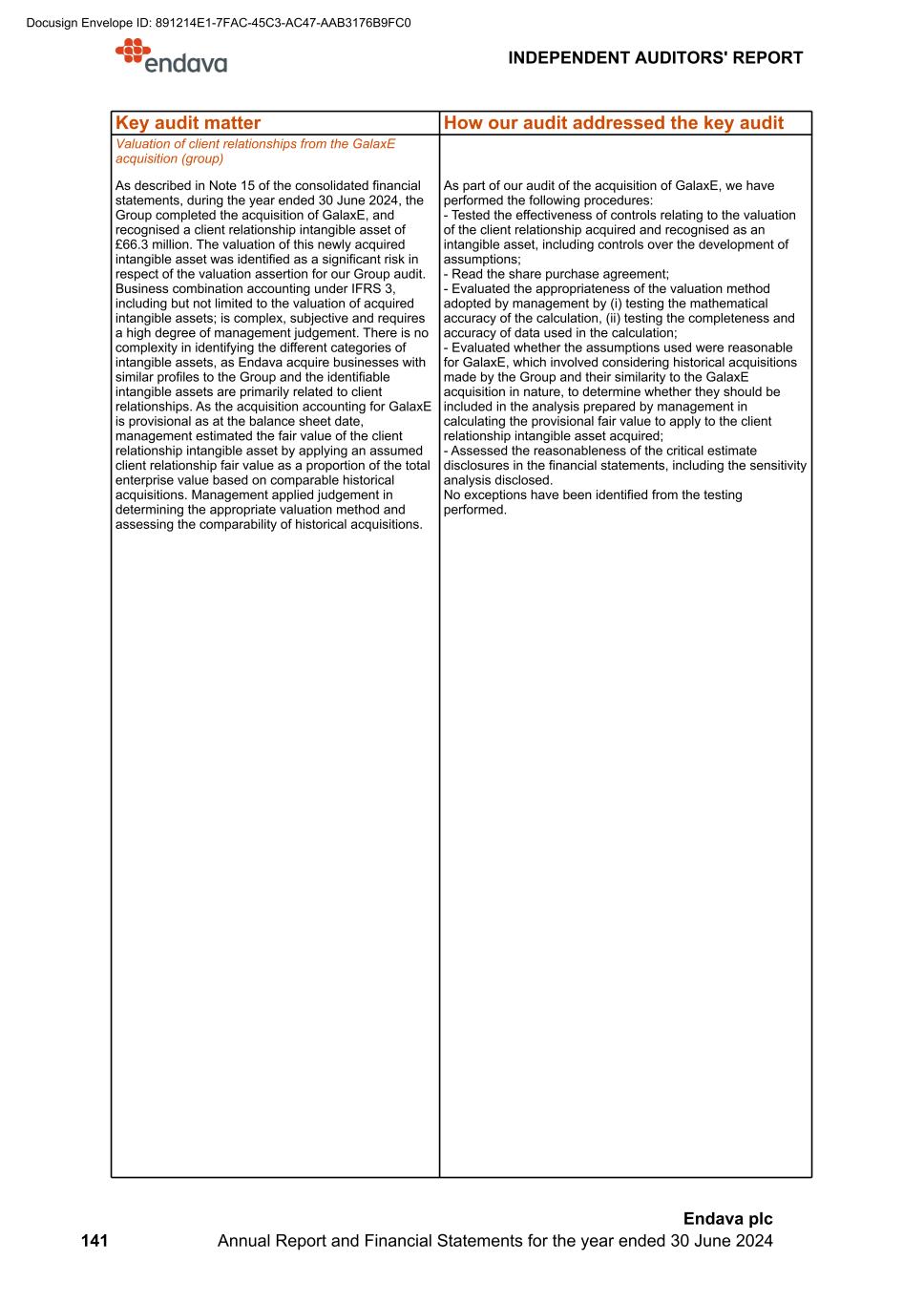
Key audit matter How our audit addressed the key audit Valuation of client relationships from the GalaxE acquisition (group) As described in Note 15 of the consolidated financial statements, during the year ended 30 June 2024, the Group completed the acquisition of GalaxE, and recognised a client relationship intangible asset of £66.3 million. The valuation of this newly acquired intangible asset was identified as a significant risk in respect of the valuation assertion for our Group audit. Business combination accounting under IFRS 3, including but not limited to the valuation of acquired intangible assets; is complex, subjective and requires a high degree of management judgement. There is no complexity in identifying the different categories of intangible assets, as Endava acquire businesses with similar profiles to the Group and the identifiable intangible assets are primarily related to client relationships. As the acquisition accounting for GalaxE is provisional as at the balance sheet date, management estimated the fair value of the client relationship intangible asset by applying an assumed client relationship fair value as a proportion of the total enterprise value based on comparable historical acquisitions. Management applied judgement in determining the appropriate valuation method and assessing the comparability of historical acquisitions. As part of our audit of the acquisition of GalaxE, we have performed the following procedures: - Tested the effectiveness of controls relating to the valuation of the client relationship acquired and recognised as an intangible asset, including controls over the development of assumptions; - Read the share purchase agreement; - Evaluated the appropriateness of the valuation method adopted by management by (i) testing the mathematical accuracy of the calculation, (ii) testing the completeness and accuracy of data used in the calculation; - Evaluated whether the assumptions used were reasonable for GalaxE, which involved considering historical acquisitions made by the Group and their similarity to the GalaxE acquisition in nature, to determine whether they should be included in the analysis prepared by management in calculating the provisional fair value to apply to the client relationship intangible asset acquired; - Assessed the reasonableness of the critical estimate disclosures in the financial statements, including the sensitivity analysis disclosed. No exceptions have been identified from the testing performed. INDEPENDENT AUDITORS' REPORT 141 Endava plc Annual Report and Financial Statements for the year ended 30 June 2024 Docusign Envelope ID: 891214E1-7FAC-45C3-AC47-AAB3176B9FC0
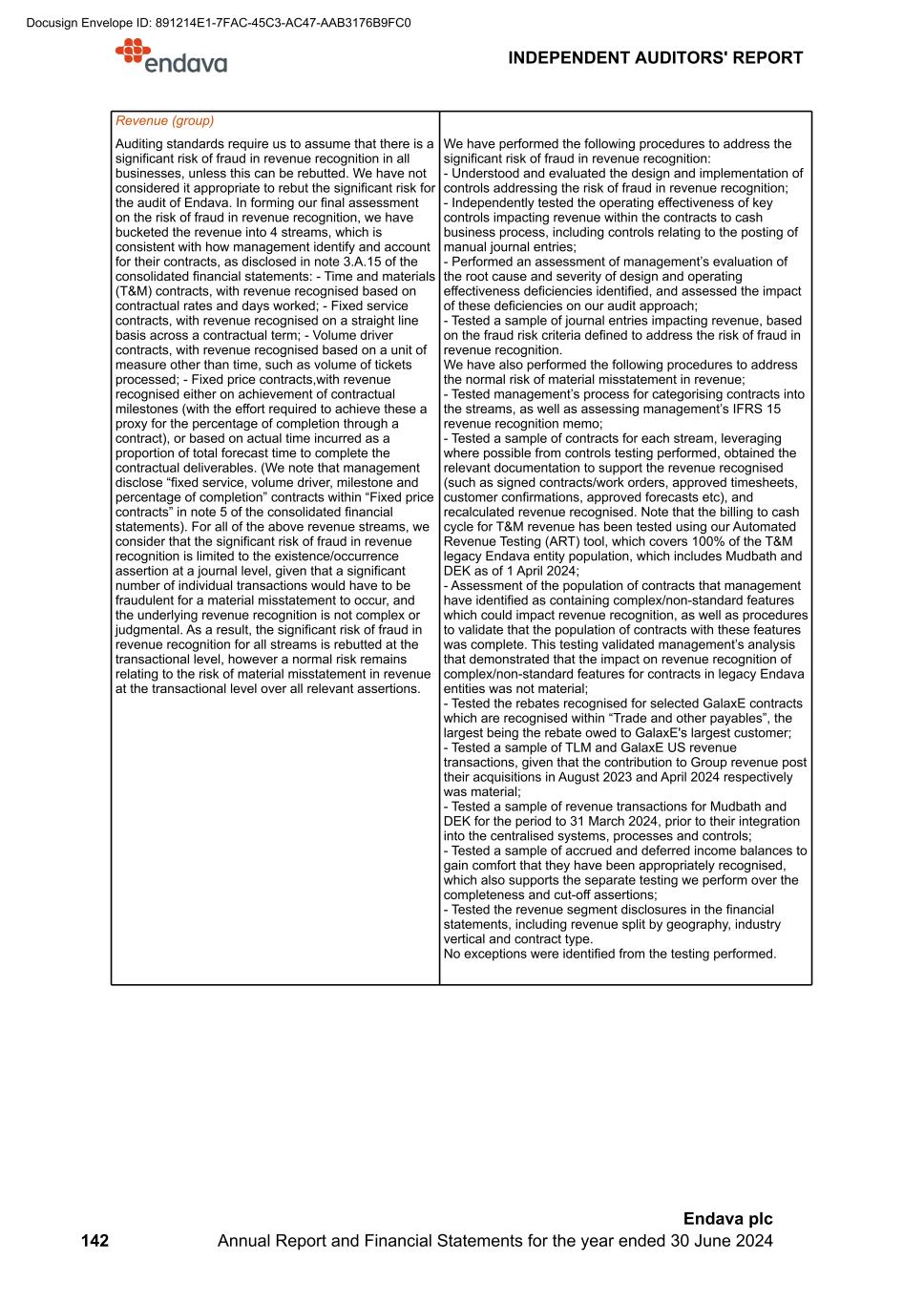
Revenue (group) Auditing standards require us to assume that there is a significant risk of fraud in revenue recognition in all businesses, unless this can be rebutted. We have not considered it appropriate to rebut the significant risk for the audit of Endava. In forming our final assessment on the risk of fraud in revenue recognition, we have bucketed the revenue into 4 streams, which is consistent with how management identify and account for their contracts, as disclosed in note 3.A.15 of the consolidated financial statements: - Time and materials (T&M) contracts, with revenue recognised based on contractual rates and days worked; - Fixed service contracts, with revenue recognised on a straight line basis across a contractual term; - Volume driver contracts, with revenue recognised based on a unit of measure other than time, such as volume of tickets processed; - Fixed price contracts,with revenue recognised either on achievement of contractual milestones (with the effort required to achieve these a proxy for the percentage of completion through a contract), or based on actual time incurred as a proportion of total forecast time to complete the contractual deliverables. (We note that management disclose “fixed service, volume driver, milestone and percentage of completion” contracts within “Fixed price contracts” in note 5 of the consolidated financial statements). For all of the above revenue streams, we consider that the significant risk of fraud in revenue recognition is limited to the existence/occurrence assertion at a journal level, given that a significant number of individual transactions would have to be fraudulent for a material misstatement to occur, and the underlying revenue recognition is not complex or judgmental. As a result, the significant risk of fraud in revenue recognition for all streams is rebutted at the transactional level, however a normal risk remains relating to the risk of material misstatement in revenue at the transactional level over all relevant assertions. We have performed the following procedures to address the significant risk of fraud in revenue recognition: - Understood and evaluated the design and implementation of controls addressing the risk of fraud in revenue recognition; - Independently tested the operating effectiveness of key controls impacting revenue within the contracts to cash business process, including controls relating to the posting of manual journal entries; - Performed an assessment of management’s evaluation of the root cause and severity of design and operating effectiveness deficiencies identified, and assessed the impact of these deficiencies on our audit approach; - Tested a sample of journal entries impacting revenue, based on the fraud risk criteria defined to address the risk of fraud in revenue recognition. We have also performed the following procedures to address the normal risk of material misstatement in revenue; - Tested management’s process for categorising contracts into the streams, as well as assessing management’s IFRS 15 revenue recognition memo; - Tested a sample of contracts for each stream, leveraging where possible from controls testing performed, obtained the relevant documentation to support the revenue recognised (such as signed contracts/work orders, approved timesheets, customer confirmations, approved forecasts etc), and recalculated revenue recognised. Note that the billing to cash cycle for T&M revenue has been tested using our Automated Revenue Testing (ART) tool, which covers 100% of the T&M legacy Endava entity population, which includes Mudbath and DEK as of 1 April 2024; - Assessment of the population of contracts that management have identified as containing complex/non-standard features which could impact revenue recognition, as well as procedures to validate that the population of contracts with these features was complete. This testing validated management’s analysis that demonstrated that the impact on revenue recognition of complex/non-standard features for contracts in legacy Endava entities was not material; - Tested the rebates recognised for selected GalaxE contracts which are recognised within “Trade and other payables”, the largest being the rebate owed to GalaxE's largest customer; - Tested a sample of TLM and GalaxE US revenue transactions, given that the contribution to Group revenue post their acquisitions in August 2023 and April 2024 respectively was material; - Tested a sample of revenue transactions for Mudbath and DEK for the period to 31 March 2024, prior to their integration into the centralised systems, processes and controls; - Tested a sample of accrued and deferred income balances to gain comfort that they have been appropriately recognised, which also supports the separate testing we perform over the completeness and cut-off assertions; - Tested the revenue segment disclosures in the financial statements, including revenue split by geography, industry vertical and contract type. No exceptions were identified from the testing performed. INDEPENDENT AUDITORS' REPORT 142 Endava plc Annual Report and Financial Statements for the year ended 30 June 2024 Docusign Envelope ID: 891214E1-7FAC-45C3-AC47-AAB3176B9FC0
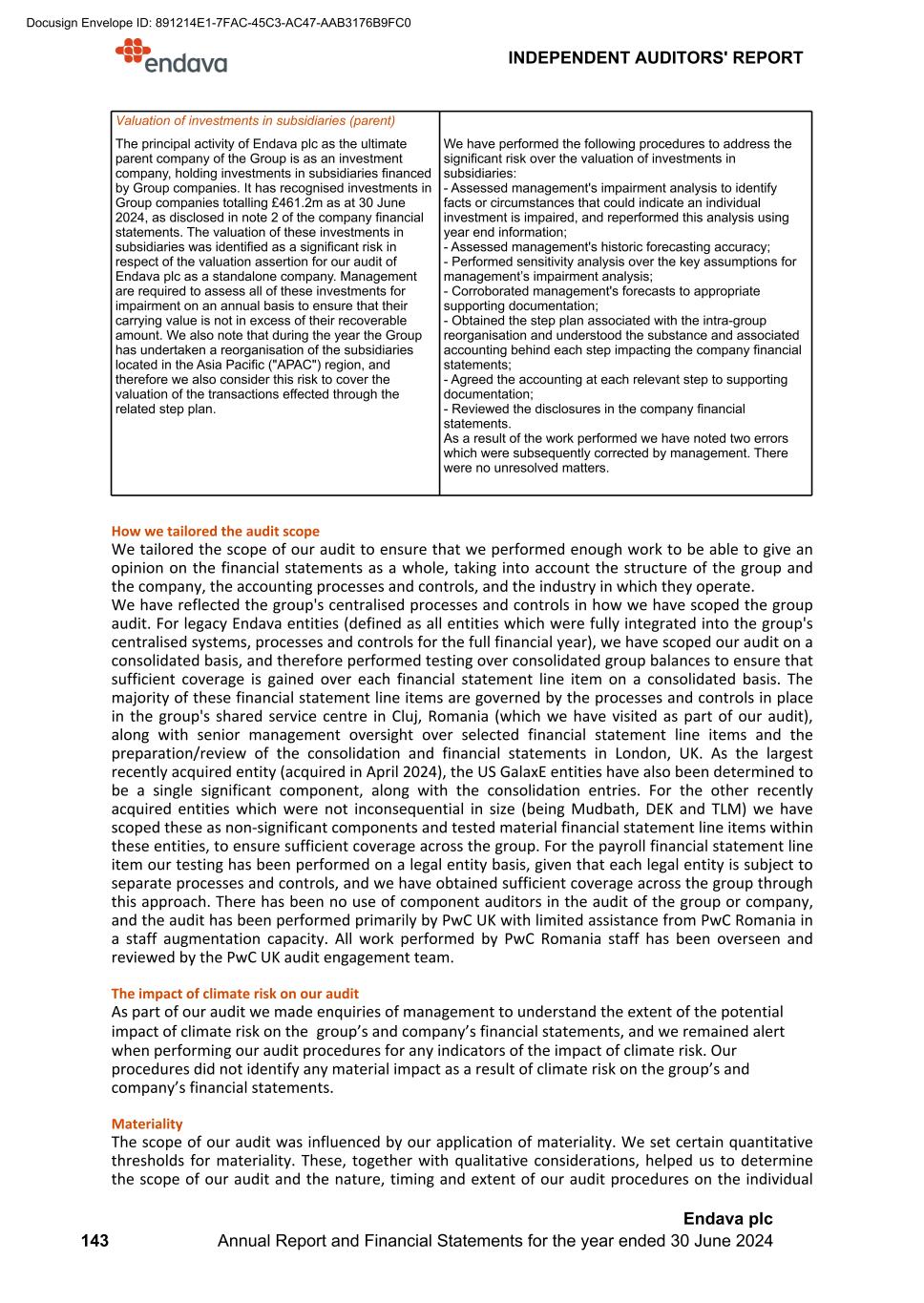
Valuation of investments in subsidiaries (parent) The principal activity of Endava plc as the ultimate parent company of the Group is as an investment company, holding investments in subsidiaries financed by Group companies. It has recognised investments in Group companies totalling £461.2m as at 30 June 2024, as disclosed in note 2 of the company financial statements. The valuation of these investments in subsidiaries was identified as a significant risk in respect of the valuation assertion for our audit of Endava plc as a standalone company. Management are required to assess all of these investments for impairment on an annual basis to ensure that their carrying value is not in excess of their recoverable amount. We also note that during the year the Group has undertaken a reorganisation of the subsidiaries located in the Asia Pacific ("APAC") region, and therefore we also consider this risk to cover the valuation of the transactions effected through the related step plan. We have performed the following procedures to address the significant risk over the valuation of investments in subsidiaries: - Assessed management's impairment analysis to identify facts or circumstances that could indicate an individual investment is impaired, and reperformed this analysis using year end information; - Assessed management's historic forecasting accuracy; - Performed sensitivity analysis over the key assumptions for management’s impairment analysis; - Corroborated management's forecasts to appropriate supporting documentation; - Obtained the step plan associated with the intra-group reorganisation and understood the substance and associated accounting behind each step impacting the company financial statements; - Agreed the accounting at each relevant step to supporting documentation; - Reviewed the disclosures in the company financial statements. As a result of the work performed we have noted two errors which were subsequently corrected by management. There were no unresolved matters. How we tailored the audit scope We tailored the scope of our audit to ensure that we performed enough work to be able to give an opinion on the financial statements as a whole, taking into account the structure of the group and the company, the accounting processes and controls, and the industry in which they operate. We have reflected the group's centralised processes and controls in how we have scoped the group audit. For legacy Endava entities (defined as all entities which were fully integrated into the group's centralised systems, processes and controls for the full financial year), we have scoped our audit on a consolidated basis, and therefore performed testing over consolidated group balances to ensure that sufficient coverage is gained over each financial statement line item on a consolidated basis. The majority of these financial statement line items are governed by the processes and controls in place in the group's shared service centre in Cluj, Romania (which we have visited as part of our audit), along with senior management oversight over selected financial statement line items and the preparation/review of the consolidation and financial statements in London, UK. As the largest recently acquired entity (acquired in April 2024), the US GalaxE entities have also been determined to be a single significant component, along with the consolidation entries. For the other recently acquired entities which were not inconsequential in size (being Mudbath, DEK and TLM) we have scoped these as non-significant components and tested material financial statement line items within these entities, to ensure sufficient coverage across the group. For the payroll financial statement line item our testing has been performed on a legal entity basis, given that each legal entity is subject to separate processes and controls, and we have obtained sufficient coverage across the group through this approach. There has been no use of component auditors in the audit of the group or company, and the audit has been performed primarily by PwC UK with limited assistance from PwC Romania in a staff augmentation capacity. All work performed by PwC Romania staff has been overseen and reviewed by the PwC UK audit engagement team. The impact of climate risk on our audit As part of our audit we made enquiries of management to understand the extent of the potential impact of climate risk on the group’s and company’s financial statements, and we remained alert when performing our audit procedures for any indicators of the impact of climate risk. Our procedures did not identify any material impact as a result of climate risk on the group’s and company’s financial statements. Materiality The scope of our audit was influenced by our application of materiality. We set certain quantitative thresholds for materiality. These, together with qualitative considerations, helped us to determine the scope of our audit and the nature, timing and extent of our audit procedures on the individual INDEPENDENT AUDITORS' REPORT 143 Endava plc Annual Report and Financial Statements for the year ended 30 June 2024 Docusign Envelope ID: 891214E1-7FAC-45C3-AC47-AAB3176B9FC0

financial statement line items and disclosures and in evaluating the effect of misstatements, both individually and in aggregate on the financial statements as a whole. Based on our professional judgement, we determined materiality for the financial statements as a whole as follows: Financial statements - group Financial statements - company Overall materiality £4,059,000 (FY23: £5,700,000). £3,966,000 (FY23: £4,500,000). How we determined it 5% of a 3 year average of profit before tax (FY23: 5% of FY23 profit before tax) 0.6% of total assets Rationale for benchmark applied We believe that profit before tax (PBT) is the primary measure used by the shareholders in assessing the performance of the group, as this is a key performance indicator of the group, and the group operates with the aim of being profitable, which it has been for several years (albeit with a reduction in the current year). We have used a three year average of profit before tax to calculate our materiality for the current year, on the basis that using a materiality calculated on profit before tax for the year ended 30 June 2024 would not be reflective of the size of the group in previous years or forecast future performance. We consider the trading of the business over the past 3 years to be representative of the expected trajectory of the ongoing business, and therefore applying a three-year average to the PBT benchmark is considered to be the most appropriate basis on which to calculate materiality. We also note that this provides a materiality which has reduced from the prior year, in line with the group's overall performance. We believe that total assets is the primary measure used by the shareholders in assessing the performance and position of the company, and reflects the company's principal activity as an investment company for the group, holding investments in subsidiaries financed by group companies. For each component in the scope of our group audit, we allocated a materiality that is less than our overall group materiality. The range of materiality allocated across components was £846,000 to £3,966,000. We use performance materiality to reduce to an appropriately low level the probability that the aggregate of uncorrected and undetected misstatements exceeds overall materiality. Specifically, we use performance materiality in determining the scope of our audit and the nature and extent of our testing of account balances, classes of transactions and disclosures, for example in determining sample sizes. Our performance materiality was 75% (FY23: 75%) of overall materiality, amounting to £3,044,000 (FY23: 4,275,000) for the group financial statements and £2,975,000 (FY23: £3,375,000) for the company financial statements. INDEPENDENT AUDITORS' REPORT 144 Endava plc Annual Report and Financial Statements for the year ended 30 June 2024 Docusign Envelope ID: 891214E1-7FAC-45C3-AC47-AAB3176B9FC0
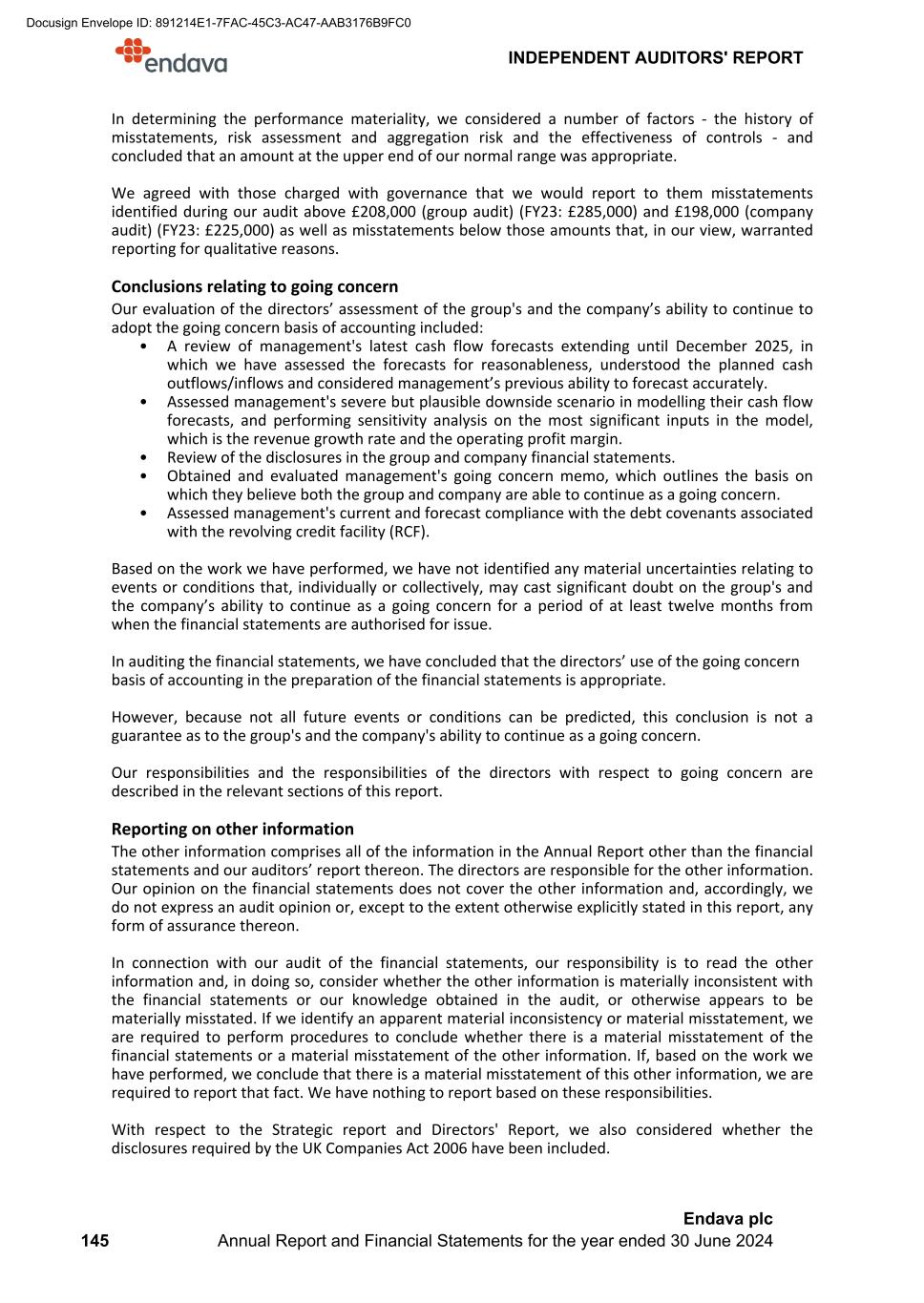
In determining the performance materiality, we considered a number of factors - the history of misstatements, risk assessment and aggregation risk and the effectiveness of controls - and concluded that an amount at the upper end of our normal range was appropriate. We agreed with those charged with governance that we would report to them misstatements identified during our audit above £208,000 (group audit) (FY23: £285,000) and £198,000 (company audit) (FY23: £225,000) as well as misstatements below those amounts that, in our view, warranted reporting for qualitative reasons. Conclusions relating to going concern Our evaluation of the directors’ assessment of the group's and the company’s ability to continue to adopt the going concern basis of accounting included: • A review of management's latest cash flow forecasts extending until December 2025, in which we have assessed the forecasts for reasonableness, understood the planned cash outflows/inflows and considered management’s previous ability to forecast accurately. • Assessed management's severe but plausible downside scenario in modelling their cash flow forecasts, and performing sensitivity analysis on the most significant inputs in the model, which is the revenue growth rate and the operating profit margin. • Review of the disclosures in the group and company financial statements. • Obtained and evaluated management's going concern memo, which outlines the basis on which they believe both the group and company are able to continue as a going concern. • Assessed management's current and forecast compliance with the debt covenants associated with the revolving credit facility (RCF). Based on the work we have performed, we have not identified any material uncertainties relating to events or conditions that, individually or collectively, may cast significant doubt on the group's and the company’s ability to continue as a going concern for a period of at least twelve months from when the financial statements are authorised for issue. In auditing the financial statements, we have concluded that the directors’ use of the going concern basis of accounting in the preparation of the financial statements is appropriate. However, because not all future events or conditions can be predicted, this conclusion is not a guarantee as to the group's and the company's ability to continue as a going concern. Our responsibilities and the responsibilities of the directors with respect to going concern are described in the relevant sections of this report. Reporting on other information The other information comprises all of the information in the Annual Report other than the financial statements and our auditors’ report thereon. The directors are responsible for the other information. Our opinion on the financial statements does not cover the other information and, accordingly, we do not express an audit opinion or, except to the extent otherwise explicitly stated in this report, any form of assurance thereon. In connection with our audit of the financial statements, our responsibility is to read the other information and, in doing so, consider whether the other information is materially inconsistent with the financial statements or our knowledge obtained in the audit, or otherwise appears to be materially misstated. If we identify an apparent material inconsistency or material misstatement, we are required to perform procedures to conclude whether there is a material misstatement of the financial statements or a material misstatement of the other information. If, based on the work we have performed, we conclude that there is a material misstatement of this other information, we are required to report that fact. We have nothing to report based on these responsibilities. With respect to the Strategic report and Directors' Report, we also considered whether the disclosures required by the UK Companies Act 2006 have been included. INDEPENDENT AUDITORS' REPORT 145 Endava plc Annual Report and Financial Statements for the year ended 30 June 2024 Docusign Envelope ID: 891214E1-7FAC-45C3-AC47-AAB3176B9FC0
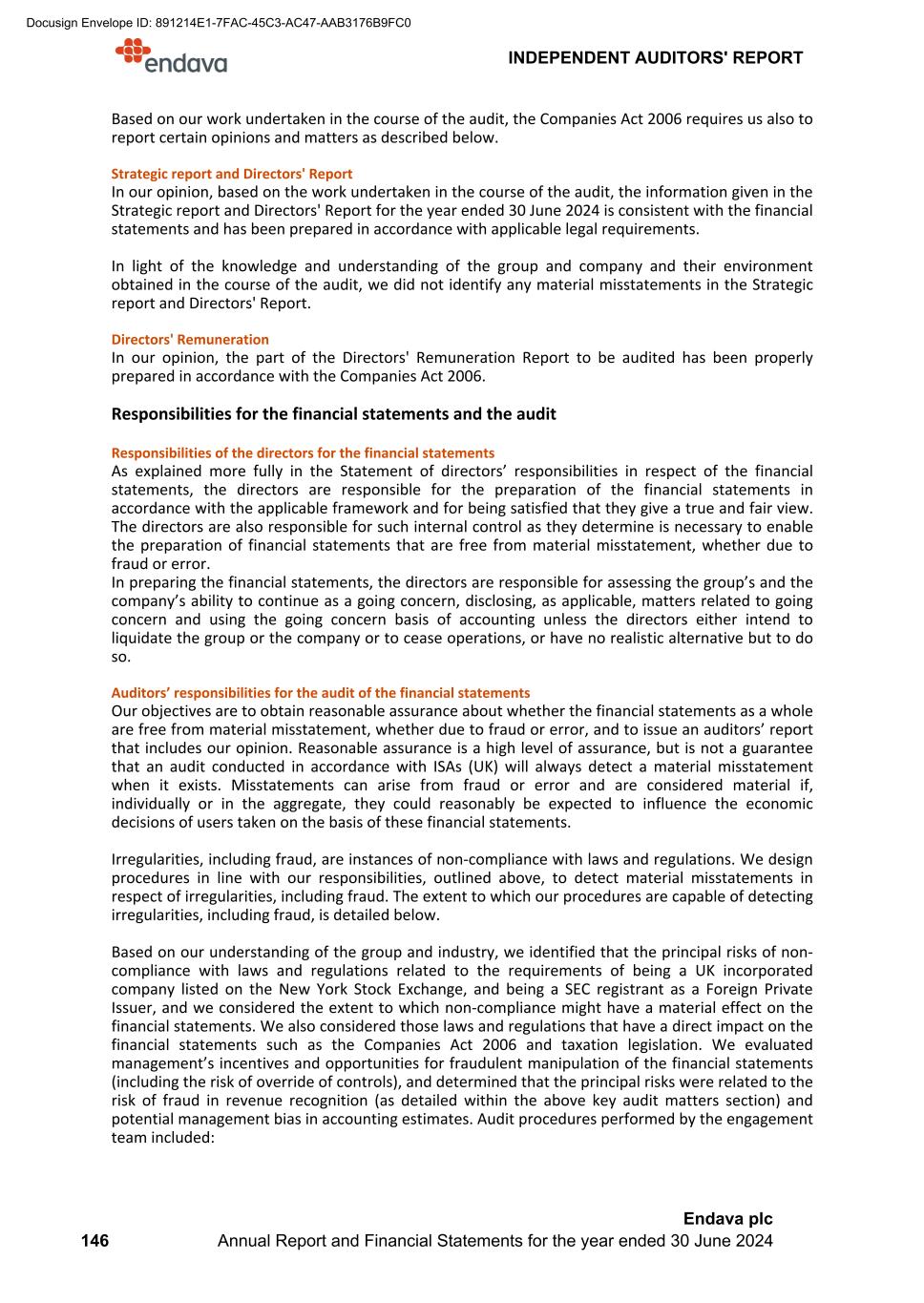
Based on our work undertaken in the course of the audit, the Companies Act 2006 requires us also to report certain opinions and matters as described below. Strategic report and Directors' Report In our opinion, based on the work undertaken in the course of the audit, the information given in the Strategic report and Directors' Report for the year ended 30 June 2024 is consistent with the financial statements and has been prepared in accordance with applicable legal requirements. In light of the knowledge and understanding of the group and company and their environment obtained in the course of the audit, we did not identify any material misstatements in the Strategic report and Directors' Report. Directors' Remuneration In our opinion, the part of the Directors' Remuneration Report to be audited has been properly prepared in accordance with the Companies Act 2006. Responsibilities for the financial statements and the audit Responsibilities of the directors for the financial statements As explained more fully in the Statement of directors’ responsibilities in respect of the financial statements, the directors are responsible for the preparation of the financial statements in accordance with the applicable framework and for being satisfied that they give a true and fair view. The directors are also responsible for such internal control as they determine is necessary to enable the preparation of financial statements that are free from material misstatement, whether due to fraud or error. In preparing the financial statements, the directors are responsible for assessing the group’s and the company’s ability to continue as a going concern, disclosing, as applicable, matters related to going concern and using the going concern basis of accounting unless the directors either intend to liquidate the group or the company or to cease operations, or have no realistic alternative but to do so. Auditors’ responsibilities for the audit of the financial statements Our objectives are to obtain reasonable assurance about whether the financial statements as a whole are free from material misstatement, whether due to fraud or error, and to issue an auditors’ report that includes our opinion. Reasonable assurance is a high level of assurance, but is not a guarantee that an audit conducted in accordance with ISAs (UK) will always detect a material misstatement when it exists. Misstatements can arise from fraud or error and are considered material if, individually or in the aggregate, they could reasonably be expected to influence the economic decisions of users taken on the basis of these financial statements. Irregularities, including fraud, are instances of non-compliance with laws and regulations. We design procedures in line with our responsibilities, outlined above, to detect material misstatements in respect of irregularities, including fraud. The extent to which our procedures are capable of detecting irregularities, including fraud, is detailed below. Based on our understanding of the group and industry, we identified that the principal risks of non- compliance with laws and regulations related to the requirements of being a UK incorporated company listed on the New York Stock Exchange, and being a SEC registrant as a Foreign Private Issuer, and we considered the extent to which non-compliance might have a material effect on the financial statements. We also considered those laws and regulations that have a direct impact on the financial statements such as the Companies Act 2006 and taxation legislation. We evaluated management’s incentives and opportunities for fraudulent manipulation of the financial statements (including the risk of override of controls), and determined that the principal risks were related to the risk of fraud in revenue recognition (as detailed within the above key audit matters section) and potential management bias in accounting estimates. Audit procedures performed by the engagement team included: INDEPENDENT AUDITORS' REPORT 146 Endava plc Annual Report and Financial Statements for the year ended 30 June 2024 Docusign Envelope ID: 891214E1-7FAC-45C3-AC47-AAB3176B9FC0
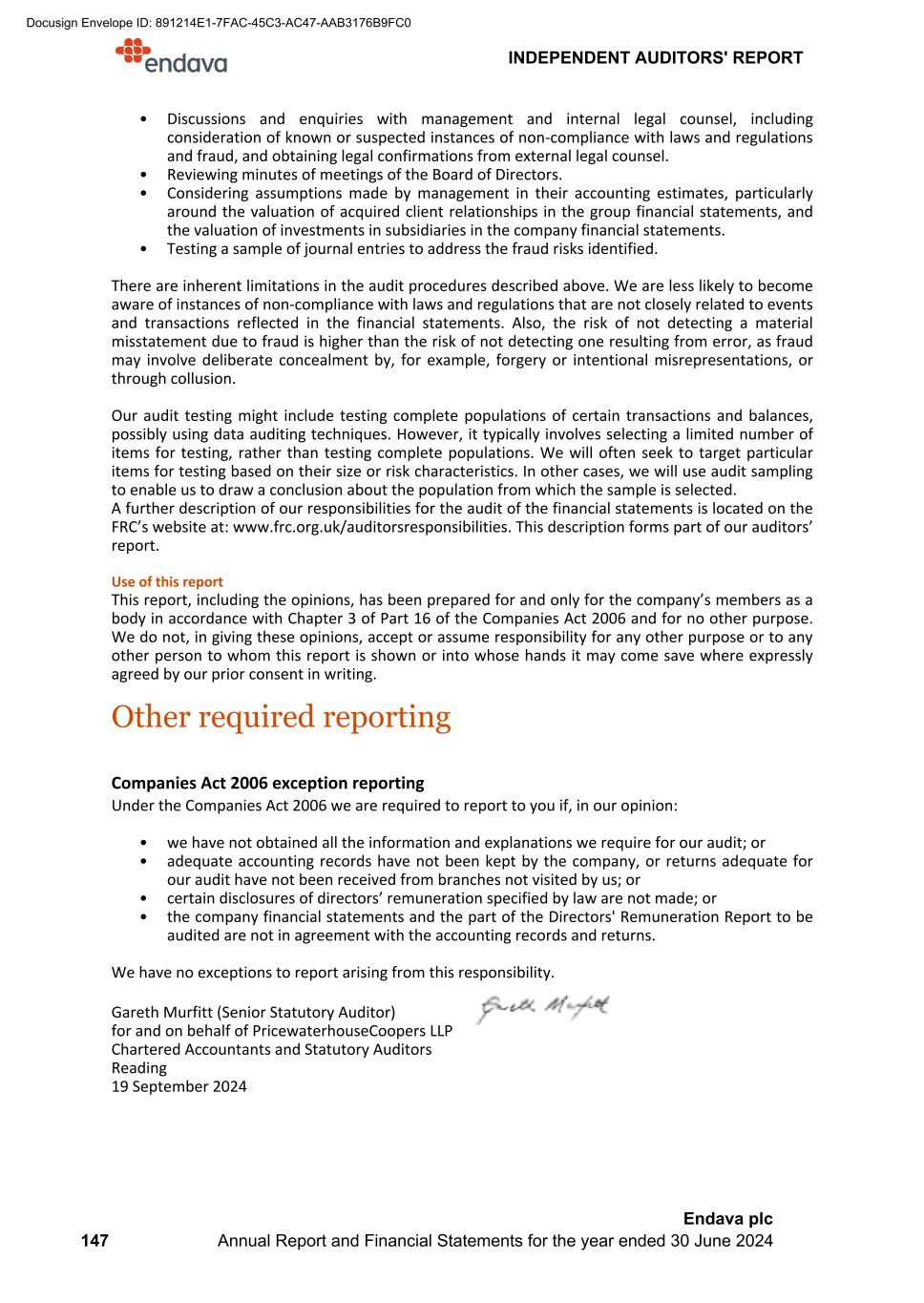
• Discussions and enquiries with management and internal legal counsel, including consideration of known or suspected instances of non-compliance with laws and regulations and fraud, and obtaining legal confirmations from external legal counsel. • Reviewing minutes of meetings of the Board of Directors. • Considering assumptions made by management in their accounting estimates, particularly around the valuation of acquired client relationships in the group financial statements, and the valuation of investments in subsidiaries in the company financial statements. • Testing a sample of journal entries to address the fraud risks identified. There are inherent limitations in the audit procedures described above. We are less likely to become aware of instances of non-compliance with laws and regulations that are not closely related to events and transactions reflected in the financial statements. Also, the risk of not detecting a material misstatement due to fraud is higher than the risk of not detecting one resulting from error, as fraud may involve deliberate concealment by, for example, forgery or intentional misrepresentations, or through collusion. Our audit testing might include testing complete populations of certain transactions and balances, possibly using data auditing techniques. However, it typically involves selecting a limited number of items for testing, rather than testing complete populations. We will often seek to target particular items for testing based on their size or risk characteristics. In other cases, we will use audit sampling to enable us to draw a conclusion about the population from which the sample is selected. A further description of our responsibilities for the audit of the financial statements is located on the FRC’s website at: www.frc.org.uk/auditorsresponsibilities. This description forms part of our auditors’ report. Use of this report This report, including the opinions, has been prepared for and only for the company’s members as a body in accordance with Chapter 3 of Part 16 of the Companies Act 2006 and for no other purpose. We do not, in giving these opinions, accept or assume responsibility for any other purpose or to any other person to whom this report is shown or into whose hands it may come save where expressly agreed by our prior consent in writing. Other required reporting Companies Act 2006 exception reporting Under the Companies Act 2006 we are required to report to you if, in our opinion: • we have not obtained all the information and explanations we require for our audit; or • adequate accounting records have not been kept by the company, or returns adequate for our audit have not been received from branches not visited by us; or • certain disclosures of directors’ remuneration specified by law are not made; or • the company financial statements and the part of the Directors' Remuneration Report to be audited are not in agreement with the accounting records and returns. We have no exceptions to report arising from this responsibility. Gareth Murfitt (Senior Statutory Auditor) for and on behalf of PricewaterhouseCoopers LLP Chartered Accountants and Statutory Auditors Reading 19 September 2024 INDEPENDENT AUDITORS' REPORT 147 Endava plc Annual Report and Financial Statements for the year ended 30 June 2024 Docusign Envelope ID: 891214E1-7FAC-45C3-AC47-AAB3176B9FC0
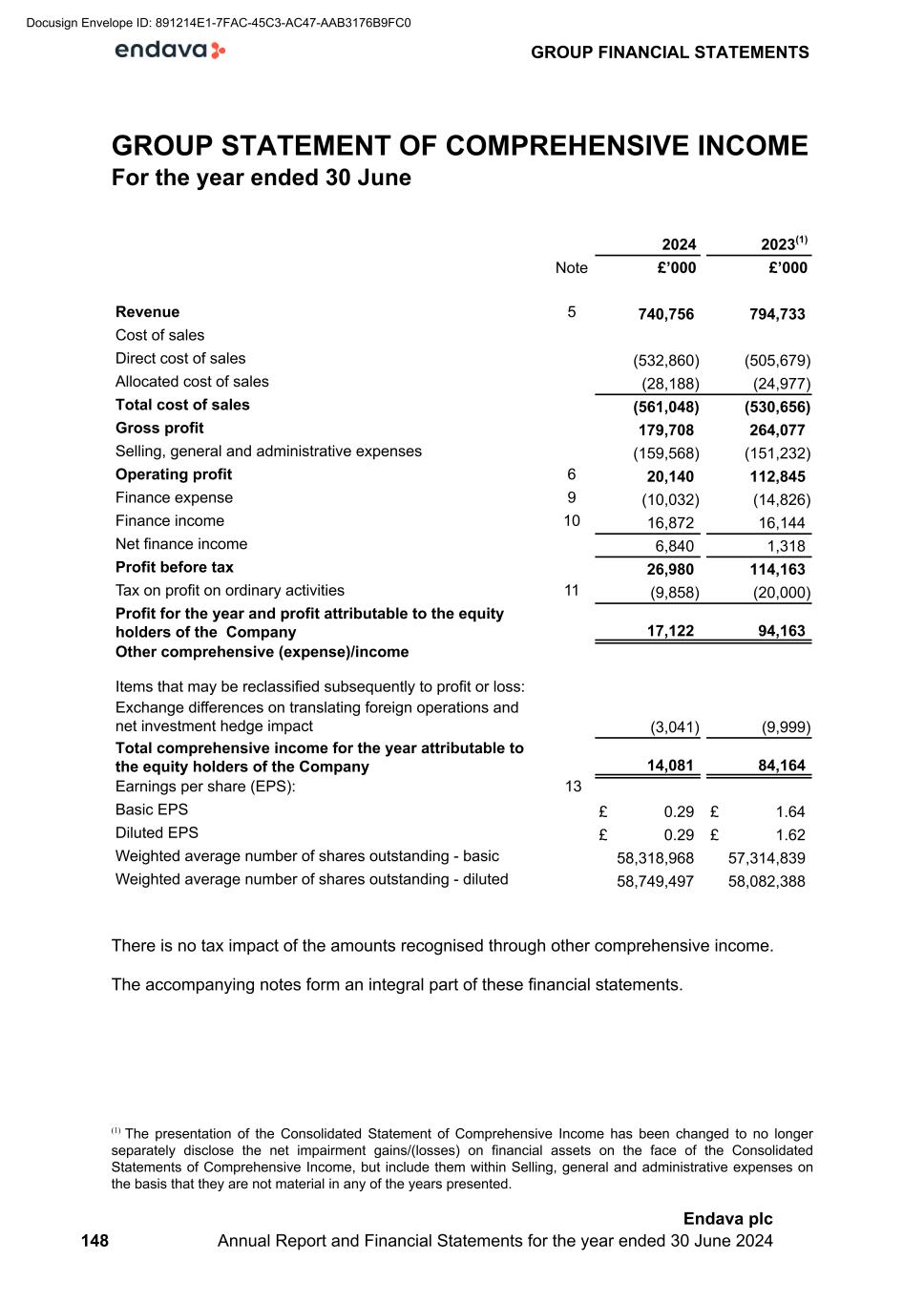
GROUP STATEMENT OF COMPREHENSIVE INCOME For the year ended 30 June Note 2024 2023(1) £’000 £’000 Revenue 5 740,756 794,733 Cost of sales Direct cost of sales (532,860) (505,679) Allocated cost of sales (28,188) (24,977) Total cost of sales (561,048) (530,656) Gross profit 179,708 264,077 Selling, general and administrative expenses (159,568) (151,232) Operating profit 6 20,140 112,845 Finance expense 9 (10,032) (14,826) Finance income 10 16,872 16,144 Net finance income 6,840 1,318 Profit before tax 26,980 114,163 Tax on profit on ordinary activities 11 (9,858) (20,000) Profit for the year and profit attributable to the equity holders of the Company 17,122 94,163 Other comprehensive (expense)/income Items that may be reclassified subsequently to profit or loss: Exchange differences on translating foreign operations and net investment hedge impact (3,041) (9,999) Total comprehensive income for the year attributable to the equity holders of the Company 14,081 84,164 Earnings per share (EPS): 13 Basic EPS £ 0.29 £ 1.64 Diluted EPS £ 0.29 £ 1.62 Weighted average number of shares outstanding - basic 58,318,968 57,314,839 Weighted average number of shares outstanding - diluted 58,749,497 58,082,388 There is no tax impact of the amounts recognised through other comprehensive income. The accompanying notes form an integral part of these financial statements. (1) The presentation of the Consolidated Statement of Comprehensive Income has been changed to no longer separately disclose the net impairment gains/(losses) on financial assets on the face of the Consolidated Statements of Comprehensive Income, but include them within Selling, general and administrative expenses on the basis that they are not material in any of the years presented. GROUP FINANCIAL STATEMENTS 148 Endava plc Annual Report and Financial Statements for the year ended 30 June 2024 Docusign Envelope ID: 891214E1-7FAC-45C3-AC47-AAB3176B9FC0
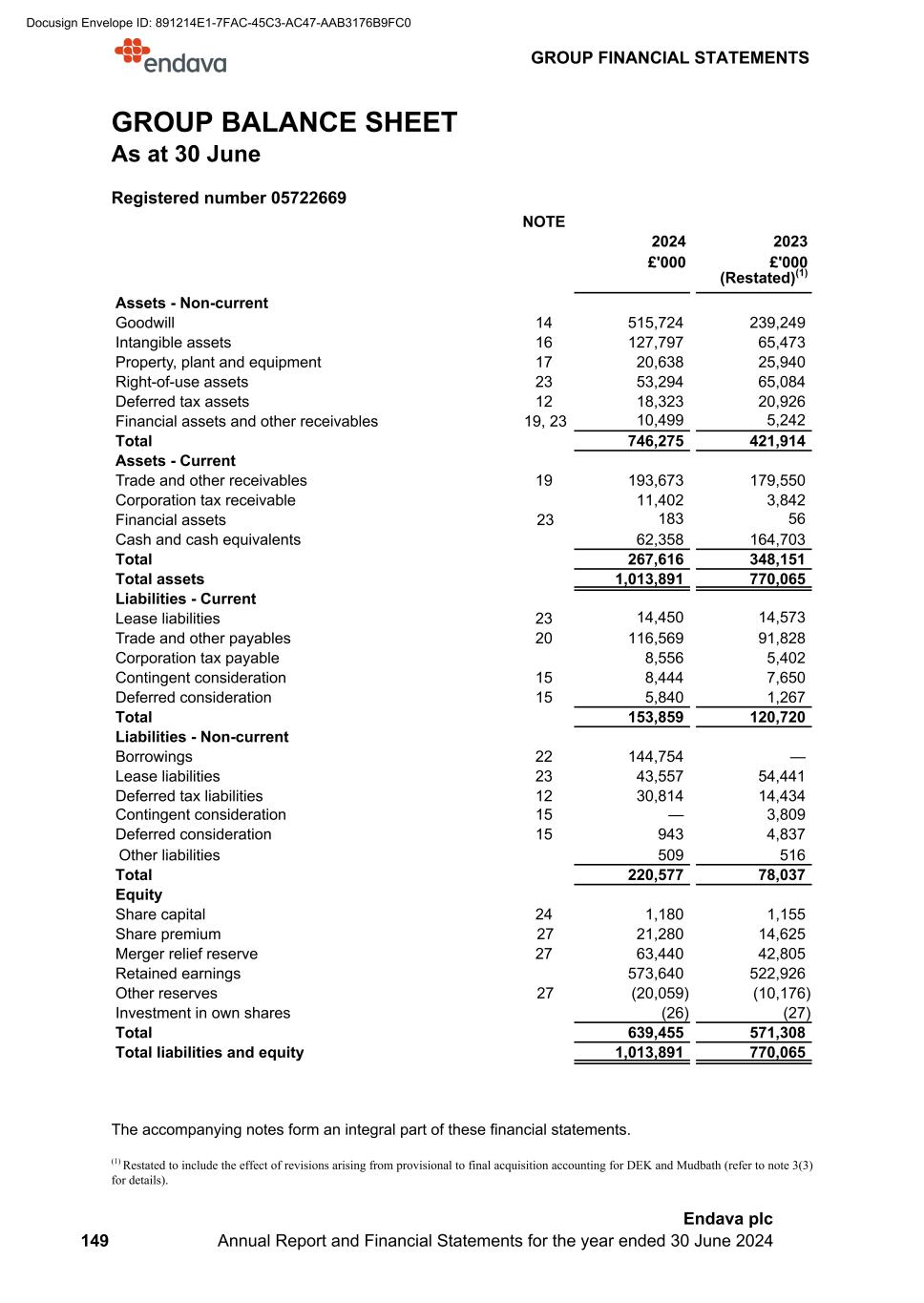
GROUP BALANCE SHEET As at 30 June Registered number 05722669 NOTE 2024 2023 £'000 £'000 (Restated)(1) Assets - Non-current Goodwill 14 515,724 239,249 Intangible assets 16 127,797 65,473 Property, plant and equipment 17 20,638 25,940 Right-of-use assets 23 53,294 65,084 Deferred tax assets 12 18,323 20,926 Financial assets and other receivables 19, 23 10,499 5,242 Total 746,275 421,914 Assets - Current Trade and other receivables 19 193,673 179,550 Corporation tax receivable 11,402 3,842 Financial assets 23 183 56 Cash and cash equivalents 62,358 164,703 Total 267,616 348,151 Total assets 1,013,891 770,065 Liabilities - Current Lease liabilities 23 14,450 14,573 Trade and other payables 20 116,569 91,828 Corporation tax payable 8,556 5,402 Contingent consideration 15 8,444 7,650 Deferred consideration 15 5,840 1,267 Total 153,859 120,720 Liabilities - Non-current Borrowings 22 144,754 — Lease liabilities 23 43,557 54,441 Deferred tax liabilities 12 30,814 14,434 Contingent consideration 15 — 3,809 Deferred consideration 15 943 4,837 Other liabilities 509 516 Total 220,577 78,037 Equity Share capital 24 1,180 1,155 Share premium 27 21,280 14,625 Merger relief reserve 27 63,440 42,805 Retained earnings 573,640 522,926 Other reserves 27 (20,059) (10,176) Investment in own shares (26) (27) Total 639,455 571,308 Total liabilities and equity 1,013,891 770,065 The accompanying notes form an integral part of these financial statements. (1) Restated to include the effect of revisions arising from provisional to final acquisition accounting for DEK and Mudbath (refer to note 3(3) for details). GROUP FINANCIAL STATEMENTS 149 Endava plc Annual Report and Financial Statements for the year ended 30 June 2024 Docusign Envelope ID: 891214E1-7FAC-45C3-AC47-AAB3176B9FC0
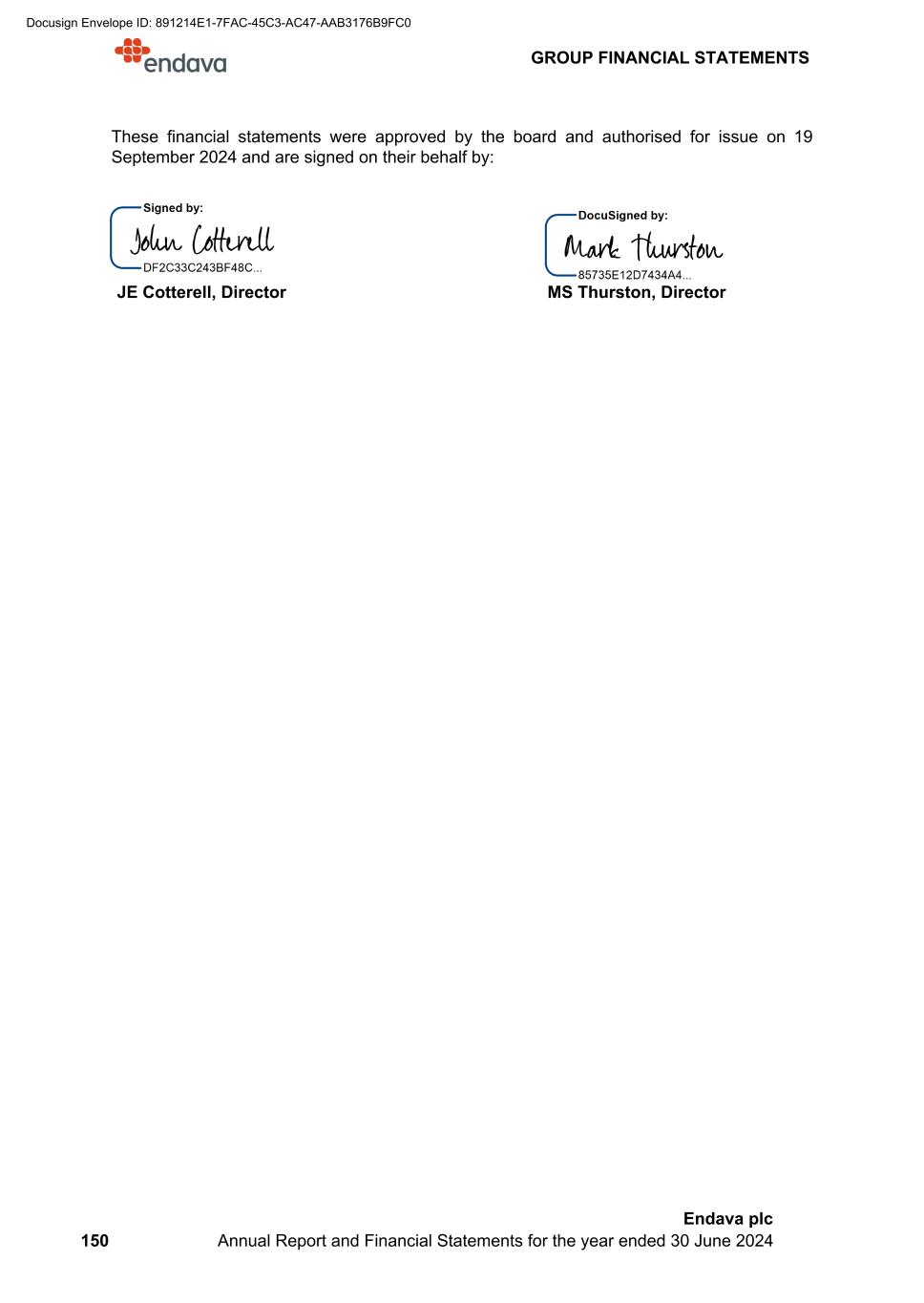
These financial statements were approved by the board and authorised for issue on 19 September 2024 and are signed on their behalf by: JE Cotterell, Director MS Thurston, Director GROUP FINANCIAL STATEMENTS 150 Endava plc Annual Report and Financial Statements for the year ended 30 June 2024 Docusign Envelope ID: 891214E1-7FAC-45C3-AC47-AAB3176B9FC0
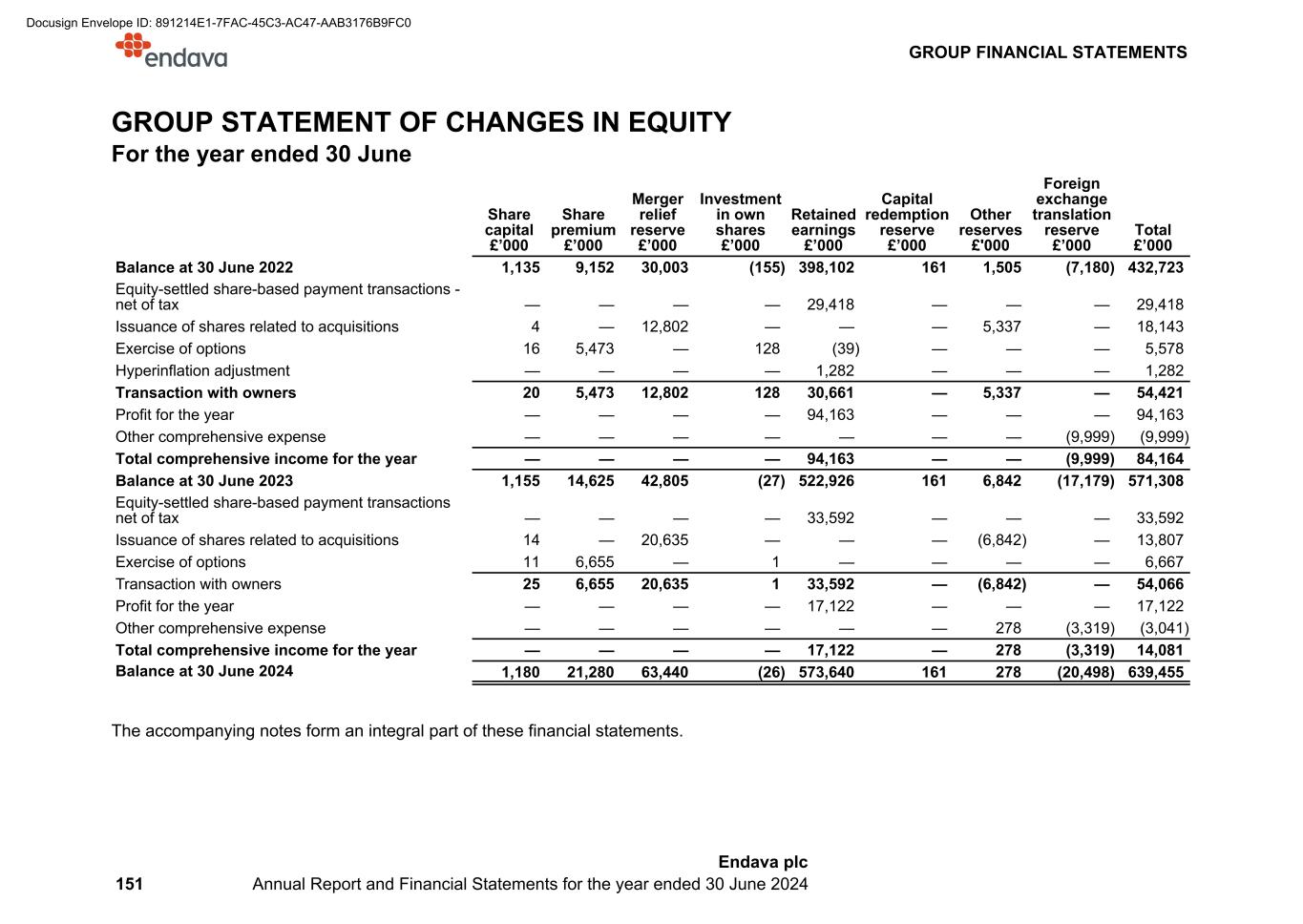
GROUP STATEMENT OF CHANGES IN EQUITY For the year ended 30 June Share capital £’000 Share premium £’000 Merger relief reserve £’000 Investment in own shares £’000 Retained earnings £’000 Capital redemption reserve £’000 Other reserves £'000 Foreign exchange translation reserve £’000 Total £’000 Balance at 30 June 2022 1,135 9,152 30,003 (155) 398,102 161 1,505 (7,180) 432,723 Equity-settled share-based payment transactions - net of tax — — — — 29,418 — — — 29,418 Issuance of shares related to acquisitions 4 — 12,802 — — — 5,337 — 18,143 Exercise of options 16 5,473 — 128 (39) — — — 5,578 Hyperinflation adjustment — — — — 1,282 — — — 1,282 Transaction with owners 20 5,473 12,802 128 30,661 — 5,337 — 54,421 Profit for the year — — — — 94,163 — — — 94,163 Other comprehensive expense — — — — — — — (9,999) (9,999) Total comprehensive income for the year — — — — 94,163 — — (9,999) 84,164 Balance at 30 June 2023 1,155 14,625 42,805 (27) 522,926 161 6,842 (17,179) 571,308 Equity-settled share-based payment transactions net of tax — — — — 33,592 — — — 33,592 Issuance of shares related to acquisitions 14 — 20,635 — — — (6,842) — 13,807 Exercise of options 11 6,655 — 1 — — — — 6,667 Transaction with owners 25 6,655 20,635 1 33,592 — (6,842) — 54,066 Profit for the year — — — — 17,122 — — — 17,122 Other comprehensive expense — — — — — — 278 (3,319) (3,041) Total comprehensive income for the year — — — — 17,122 — 278 (3,319) 14,081 Balance at 30 June 2024 1,180 21,280 63,440 (26) 573,640 161 278 (20,498) 639,455 The accompanying notes form an integral part of these financial statements. GROUP FINANCIAL STATEMENTS 151 Endava plc Annual Report and Financial Statements for the year ended 30 June 2024 Docusign Envelope ID: 891214E1-7FAC-45C3-AC47-AAB3176B9FC0

GROUP STATEMENT OF CASH FLOWS For the year ended 30 June 2024 2023(1) £’000 £’000 Operating activities Profit for the year 17,122 94,163 Income tax charge (note 11) 9,858 20,000 Non-cash adjustments (note 28) 57,768 49,165 Tax paid (14,254) (22,737) Research and development credit received 478 — Net changes in working capital (note 28) (16,580) (16,073) Net cash from operating activities 54,392 124,518 Investing activities Purchase of non-current assets (tangibles and intangibles) (5,486) (13,674) Proceeds from disposal of non-current assets 346 187 Payment for acquisition of subsidiary, net of cash acquired(note 15) (236,110) (79,691) Other acquisition related settlements (note 28) (55,246) (21,179) Interest received 6,171 3,506 Net cash used in investing activities (290,325) (110,851) Financing activities Net proceeds from bank loan (note 28) 153,814 — Repayment of borrowings (note 28) (8,056) — Proceeds from sublease 94 439 Repayment of lease liabilities (12,629) (11,812) Repayment of lease interest (2,147) (1,676) Grant received 707 494 Interest and debt financing costs paid (3,389) (4,011) Proceeds from exercise of options 6,667 5,568 Net cash generated from/ (used in) financing activities 135,061 (10,998) Net change in cash and cash equivalents (100,872) 2,669 Cash and cash equivalents at the beginning of the year 164,703 162,806 Net foreign exchange differences (1,473) (772) Cash and cash equivalents at the end of the year 62,358 164,703 The accompanying notes form an integral part of these financial statements. (1)The presentation of Consolidated Statement of Cash Flows has been changed to separately present the repayment of lease interest from the total repayments of lease liabilities. GROUP FINANCIAL STATEMENTS 152 Endava plc Annual Report and Financial Statements for the year ended 30 June 2024 Docusign Envelope ID: 891214E1-7FAC-45C3-AC47-AAB3176B9FC0
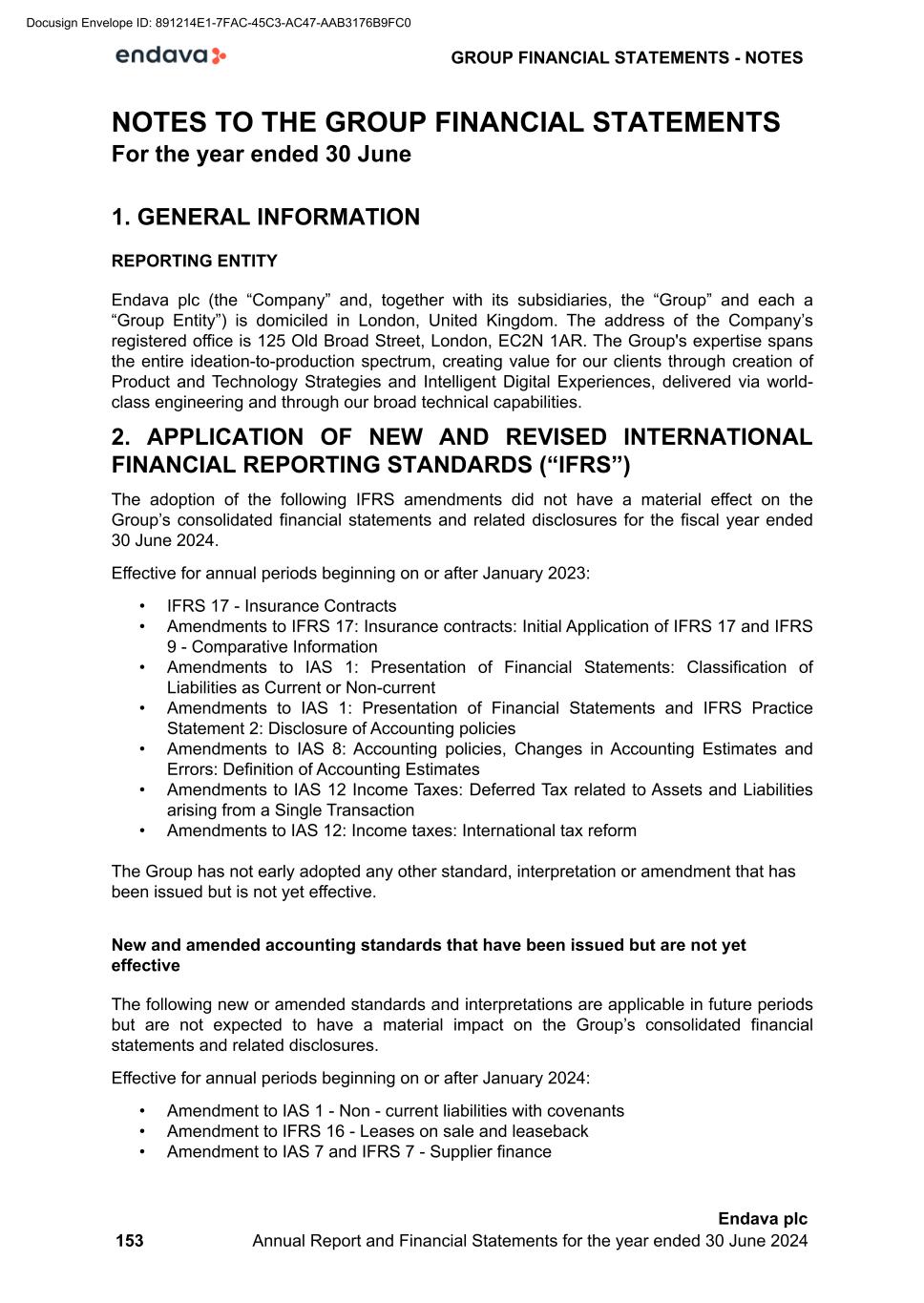
NOTES TO THE GROUP FINANCIAL STATEMENTS For the year ended 30 June 1. GENERAL INFORMATION REPORTING ENTITY Endava plc (the “Company” and, together with its subsidiaries, the “Group” and each a “Group Entity”) is domiciled in London, United Kingdom. The address of the Company’s registered office is 125 Old Broad Street, London, EC2N 1AR. The Group's expertise spans the entire ideation-to-production spectrum, creating value for our clients through creation of Product and Technology Strategies and Intelligent Digital Experiences, delivered via world- class engineering and through our broad technical capabilities. 2. APPLICATION OF NEW AND REVISED INTERNATIONAL FINANCIAL REPORTING STANDARDS (“IFRS”) The adoption of the following IFRS amendments did not have a material effect on the Group’s consolidated financial statements and related disclosures for the fiscal year ended 30 June 2024. Effective for annual periods beginning on or after January 2023: • IFRS 17 - Insurance Contracts • Amendments to IFRS 17: Insurance contracts: Initial Application of IFRS 17 and IFRS 9 - Comparative Information • Amendments to IAS 1: Presentation of Financial Statements: Classification of Liabilities as Current or Non-current • Amendments to IAS 1: Presentation of Financial Statements and IFRS Practice Statement 2: Disclosure of Accounting policies • Amendments to IAS 8: Accounting policies, Changes in Accounting Estimates and Errors: Definition of Accounting Estimates • Amendments to IAS 12 Income Taxes: Deferred Tax related to Assets and Liabilities arising from a Single Transaction • Amendments to IAS 12: Income taxes: International tax reform The Group has not early adopted any other standard, interpretation or amendment that has been issued but is not yet effective. New and amended accounting standards that have been issued but are not yet effective The following new or amended standards and interpretations are applicable in future periods but are not expected to have a material impact on the Group’s consolidated financial statements and related disclosures. Effective for annual periods beginning on or after January 2024: • Amendment to IAS 1 - Non - current liabilities with covenants • Amendment to IFRS 16 - Leases on sale and leaseback • Amendment to IAS 7 and IFRS 7 - Supplier finance GROUP FINANCIAL STATEMENTS - NOTES 153 Endava plc Annual Report and Financial Statements for the year ended 30 June 2024 Docusign Envelope ID: 891214E1-7FAC-45C3-AC47-AAB3176B9FC0
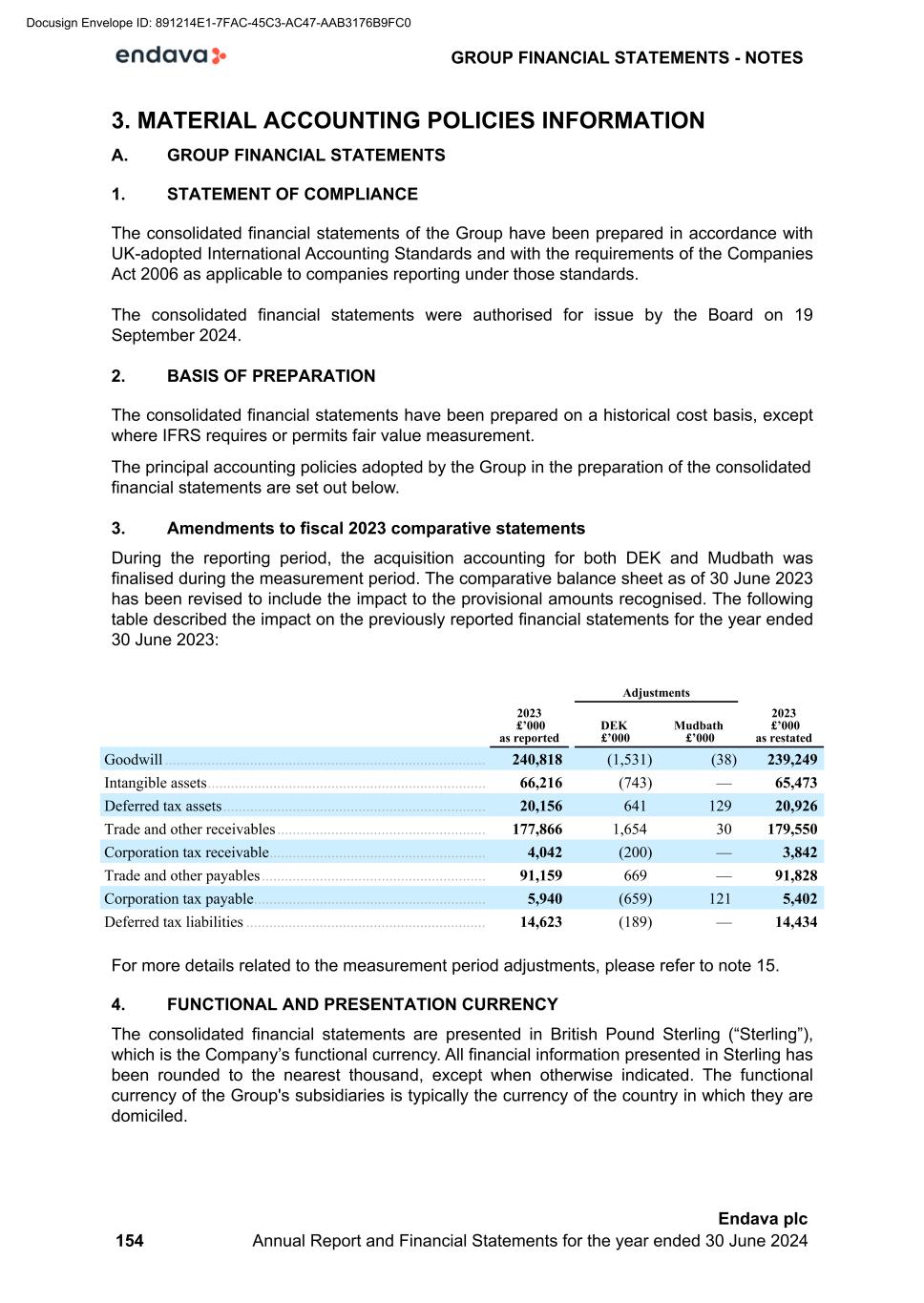
3. MATERIAL ACCOUNTING POLICIES INFORMATION A. GROUP FINANCIAL STATEMENTS 1. STATEMENT OF COMPLIANCE The consolidated financial statements of the Group have been prepared in accordance with UK-adopted International Accounting Standards and with the requirements of the Companies Act 2006 as applicable to companies reporting under those standards. The consolidated financial statements were authorised for issue by the Board on 19 September 2024. 2. BASIS OF PREPARATION The consolidated financial statements have been prepared on a historical cost basis, except where IFRS requires or permits fair value measurement. The principal accounting policies adopted by the Group in the preparation of the consolidated financial statements are set out below. 3. Amendments to fiscal 2023 comparative statements During the reporting period, the acquisition accounting for both DEK and Mudbath was finalised during the measurement period. The comparative balance sheet as of 30 June 2023 has been revised to include the impact to the provisional amounts recognised. The following table described the impact on the previously reported financial statements for the year ended 30 June 2023: Adjustments 2023 £’000 as reported DEK £’000 Mudbath £’000 2023 £’000 as restated Goodwill ................................................................................... 240,818 (1,531) (38) 239,249 Intangible assets ........................................................................ 66,216 (743) — 65,473 Deferred tax assets .................................................................... 20,156 641 129 20,926 Trade and other receivables ...................................................... 177,866 1,654 30 179,550 Corporation tax receivable ........................................................ 4,042 (200) — 3,842 Trade and other payables .......................................................... 91,159 669 — 91,828 Corporation tax payable ............................................................ 5,940 (659) 121 5,402 Deferred tax liabilities .............................................................. 14,623 (189) — 14,434 For more details related to the measurement period adjustments, please refer to note 15. 4. FUNCTIONAL AND PRESENTATION CURRENCY The consolidated financial statements are presented in British Pound Sterling (“Sterling”), which is the Company’s functional currency. All financial information presented in Sterling has been rounded to the nearest thousand, except when otherwise indicated. The functional currency of the Group's subsidiaries is typically the currency of the country in which they are domiciled. GROUP FINANCIAL STATEMENTS - NOTES 154 Endava plc Annual Report and Financial Statements for the year ended 30 June 2024 Docusign Envelope ID: 891214E1-7FAC-45C3-AC47-AAB3176B9FC0
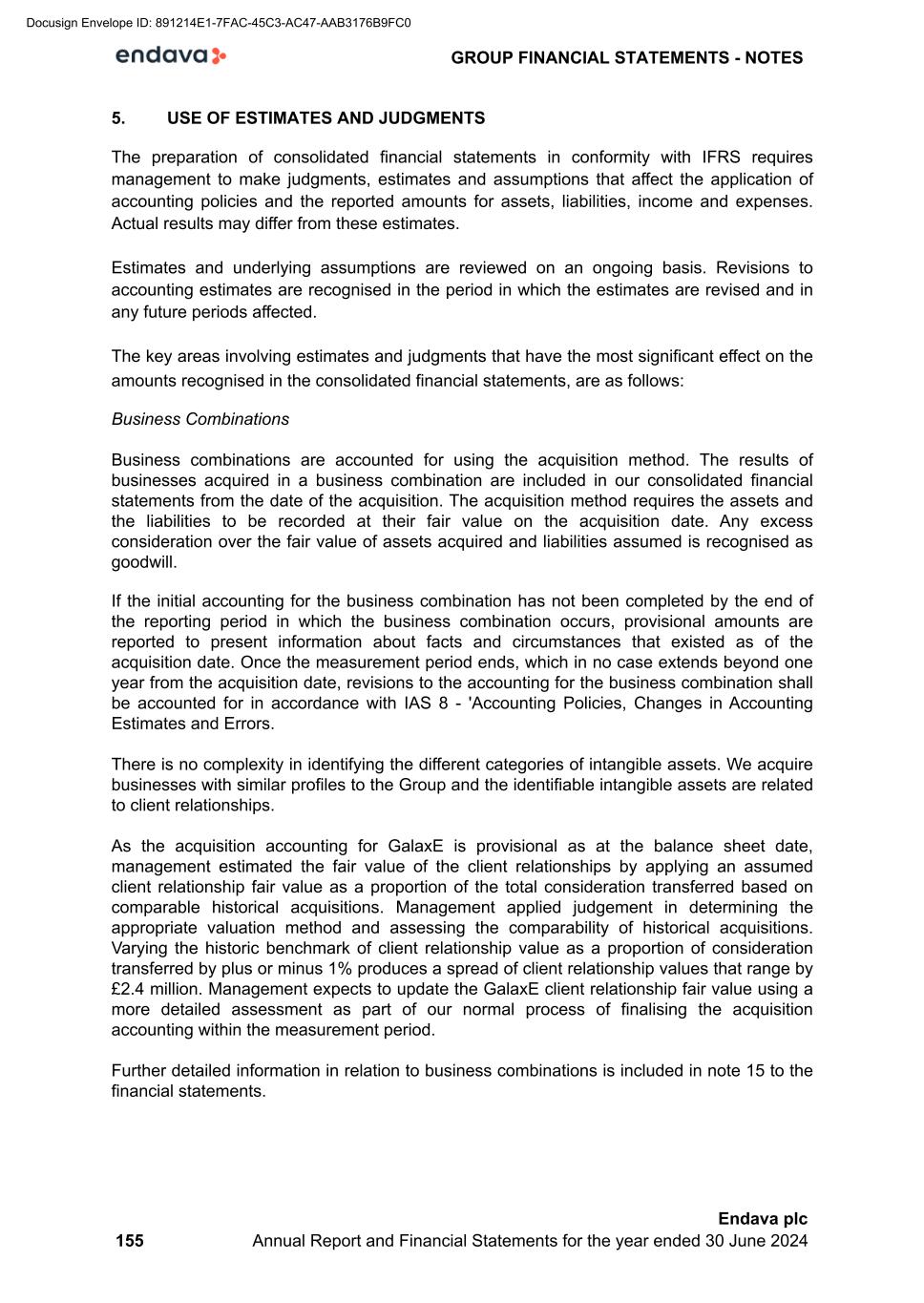
5. USE OF ESTIMATES AND JUDGMENTS The preparation of consolidated financial statements in conformity with IFRS requires management to make judgments, estimates and assumptions that affect the application of accounting policies and the reported amounts for assets, liabilities, income and expenses. Actual results may differ from these estimates. Estimates and underlying assumptions are reviewed on an ongoing basis. Revisions to accounting estimates are recognised in the period in which the estimates are revised and in any future periods affected. The key areas involving estimates and judgments that have the most significant effect on the amounts recognised in the consolidated financial statements, are as follows: Business Combinations Business combinations are accounted for using the acquisition method. The results of businesses acquired in a business combination are included in our consolidated financial statements from the date of the acquisition. The acquisition method requires the assets and the liabilities to be recorded at their fair value on the acquisition date. Any excess consideration over the fair value of assets acquired and liabilities assumed is recognised as goodwill. If the initial accounting for the business combination has not been completed by the end of the reporting period in which the business combination occurs, provisional amounts are reported to present information about facts and circumstances that existed as of the acquisition date. Once the measurement period ends, which in no case extends beyond one year from the acquisition date, revisions to the accounting for the business combination shall be accounted for in accordance with IAS 8 - 'Accounting Policies, Changes in Accounting Estimates and Errors. There is no complexity in identifying the different categories of intangible assets. We acquire businesses with similar profiles to the Group and the identifiable intangible assets are related to client relationships. As the acquisition accounting for GalaxE is provisional as at the balance sheet date, management estimated the fair value of the client relationships by applying an assumed client relationship fair value as a proportion of the total consideration transferred based on comparable historical acquisitions. Management applied judgement in determining the appropriate valuation method and assessing the comparability of historical acquisitions. Varying the historic benchmark of client relationship value as a proportion of consideration transferred by plus or minus 1% produces a spread of client relationship values that range by £2.4 million. Management expects to update the GalaxE client relationship fair value using a more detailed assessment as part of our normal process of finalising the acquisition accounting within the measurement period. Further detailed information in relation to business combinations is included in note 15 to the financial statements. GROUP FINANCIAL STATEMENTS - NOTES 155 Endava plc Annual Report and Financial Statements for the year ended 30 June 2024 Docusign Envelope ID: 891214E1-7FAC-45C3-AC47-AAB3176B9FC0
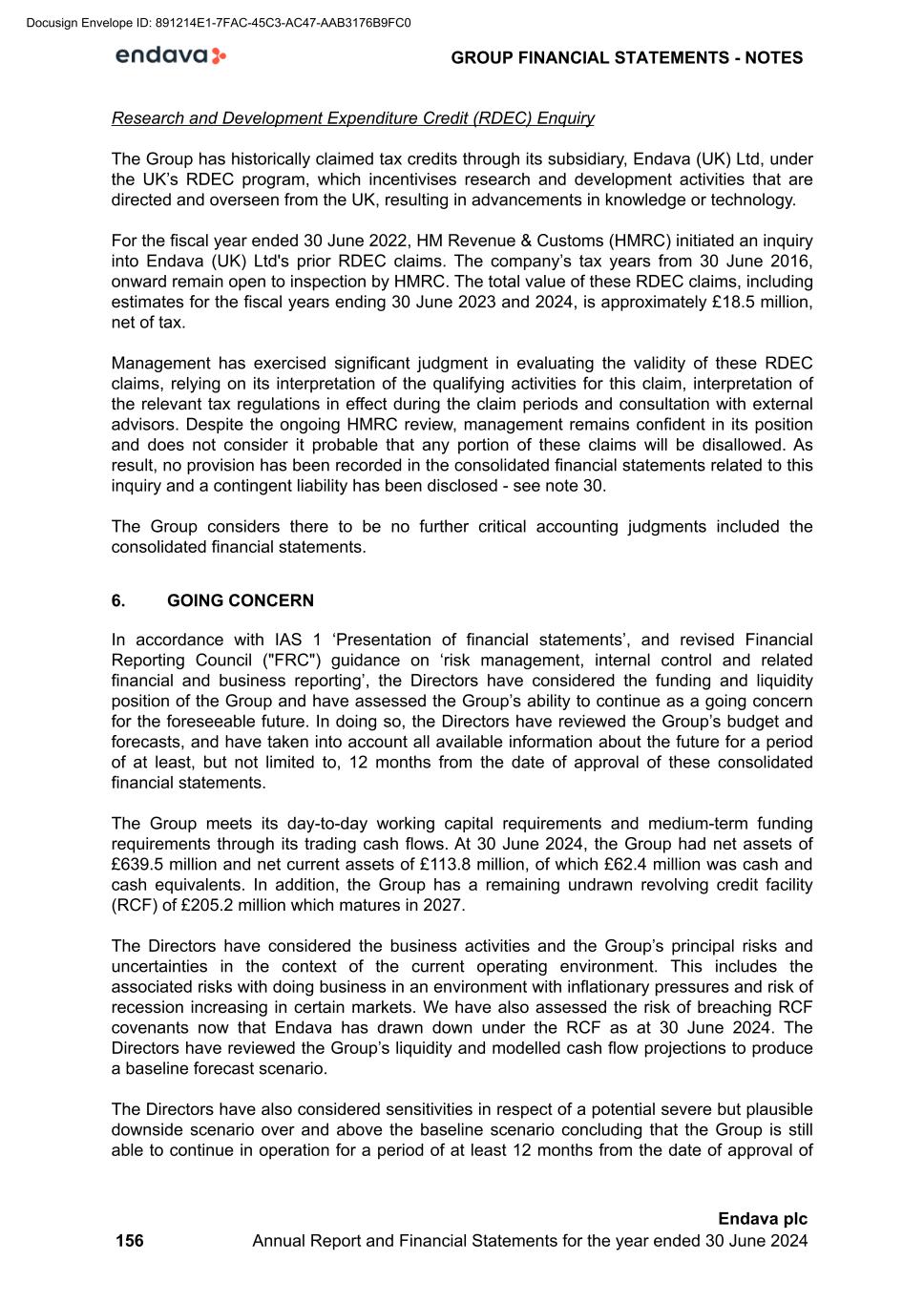
Research and Development Expenditure Credit (RDEC) Enquiry The Group has historically claimed tax credits through its subsidiary, Endava (UK) Ltd, under the UK’s RDEC program, which incentivises research and development activities that are directed and overseen from the UK, resulting in advancements in knowledge or technology. For the fiscal year ended 30 June 2022, HM Revenue & Customs (HMRC) initiated an inquiry into Endava (UK) Ltd's prior RDEC claims. The company’s tax years from 30 June 2016, onward remain open to inspection by HMRC. The total value of these RDEC claims, including estimates for the fiscal years ending 30 June 2023 and 2024, is approximately £18.5 million, net of tax. Management has exercised significant judgment in evaluating the validity of these RDEC claims, relying on its interpretation of the qualifying activities for this claim, interpretation of the relevant tax regulations in effect during the claim periods and consultation with external advisors. Despite the ongoing HMRC review, management remains confident in its position and does not consider it probable that any portion of these claims will be disallowed. As result, no provision has been recorded in the consolidated financial statements related to this inquiry and a contingent liability has been disclosed - see note 30. The Group considers there to be no further critical accounting judgments included the consolidated financial statements. 6. GOING CONCERN In accordance with IAS 1 ‘Presentation of financial statements’, and revised Financial Reporting Council ("FRC") guidance on ‘risk management, internal control and related financial and business reporting’, the Directors have considered the funding and liquidity position of the Group and have assessed the Group’s ability to continue as a going concern for the foreseeable future. In doing so, the Directors have reviewed the Group’s budget and forecasts, and have taken into account all available information about the future for a period of at least, but not limited to, 12 months from the date of approval of these consolidated financial statements. The Group meets its day-to-day working capital requirements and medium-term funding requirements through its trading cash flows. At 30 June 2024, the Group had net assets of £639.5 million and net current assets of £113.8 million, of which £62.4 million was cash and cash equivalents. In addition, the Group has a remaining undrawn revolving credit facility (RCF) of £205.2 million which matures in 2027. The Directors have considered the business activities and the Group’s principal risks and uncertainties in the context of the current operating environment. This includes the associated risks with doing business in an environment with inflationary pressures and risk of recession increasing in certain markets. We have also assessed the risk of breaching RCF covenants now that Endava has drawn down under the RCF as at 30 June 2024. The Directors have reviewed the Group’s liquidity and modelled cash flow projections to produce a baseline forecast scenario. The Directors have also considered sensitivities in respect of a potential severe but plausible downside scenario over and above the baseline scenario concluding that the Group is still able to continue in operation for a period of at least 12 months from the date of approval of GROUP FINANCIAL STATEMENTS - NOTES 156 Endava plc Annual Report and Financial Statements for the year ended 30 June 2024 Docusign Envelope ID: 891214E1-7FAC-45C3-AC47-AAB3176B9FC0
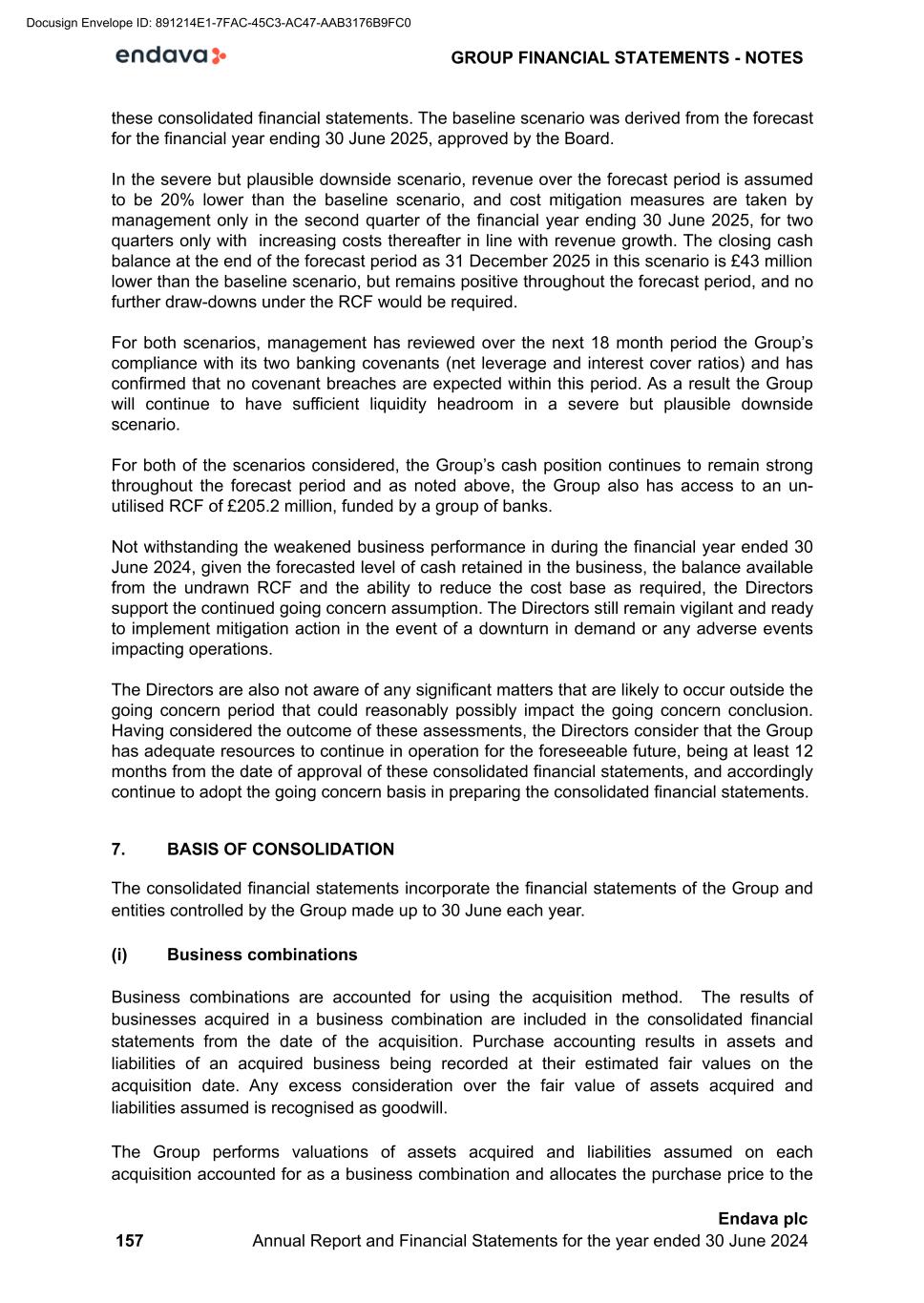
these consolidated financial statements. The baseline scenario was derived from the forecast for the financial year ending 30 June 2025, approved by the Board. In the severe but plausible downside scenario, revenue over the forecast period is assumed to be 20% lower than the baseline scenario, and cost mitigation measures are taken by management only in the second quarter of the financial year ending 30 June 2025, for two quarters only with increasing costs thereafter in line with revenue growth. The closing cash balance at the end of the forecast period as 31 December 2025 in this scenario is £43 million lower than the baseline scenario, but remains positive throughout the forecast period, and no further draw-downs under the RCF would be required. For both scenarios, management has reviewed over the next 18 month period the Group’s compliance with its two banking covenants (net leverage and interest cover ratios) and has confirmed that no covenant breaches are expected within this period. As a result the Group will continue to have sufficient liquidity headroom in a severe but plausible downside scenario. For both of the scenarios considered, the Group’s cash position continues to remain strong throughout the forecast period and as noted above, the Group also has access to an un- utilised RCF of £205.2 million, funded by a group of banks. Not withstanding the weakened business performance in during the financial year ended 30 June 2024, given the forecasted level of cash retained in the business, the balance available from the undrawn RCF and the ability to reduce the cost base as required, the Directors support the continued going concern assumption. The Directors still remain vigilant and ready to implement mitigation action in the event of a downturn in demand or any adverse events impacting operations. The Directors are also not aware of any significant matters that are likely to occur outside the going concern period that could reasonably possibly impact the going concern conclusion. Having considered the outcome of these assessments, the Directors consider that the Group has adequate resources to continue in operation for the foreseeable future, being at least 12 months from the date of approval of these consolidated financial statements, and accordingly continue to adopt the going concern basis in preparing the consolidated financial statements. 7. BASIS OF CONSOLIDATION The consolidated financial statements incorporate the financial statements of the Group and entities controlled by the Group made up to 30 June each year. (i) Business combinations Business combinations are accounted for using the acquisition method. The results of businesses acquired in a business combination are included in the consolidated financial statements from the date of the acquisition. Purchase accounting results in assets and liabilities of an acquired business being recorded at their estimated fair values on the acquisition date. Any excess consideration over the fair value of assets acquired and liabilities assumed is recognised as goodwill. The Group performs valuations of assets acquired and liabilities assumed on each acquisition accounted for as a business combination and allocates the purchase price to the GROUP FINANCIAL STATEMENTS - NOTES 157 Endava plc Annual Report and Financial Statements for the year ended 30 June 2024 Docusign Envelope ID: 891214E1-7FAC-45C3-AC47-AAB3176B9FC0
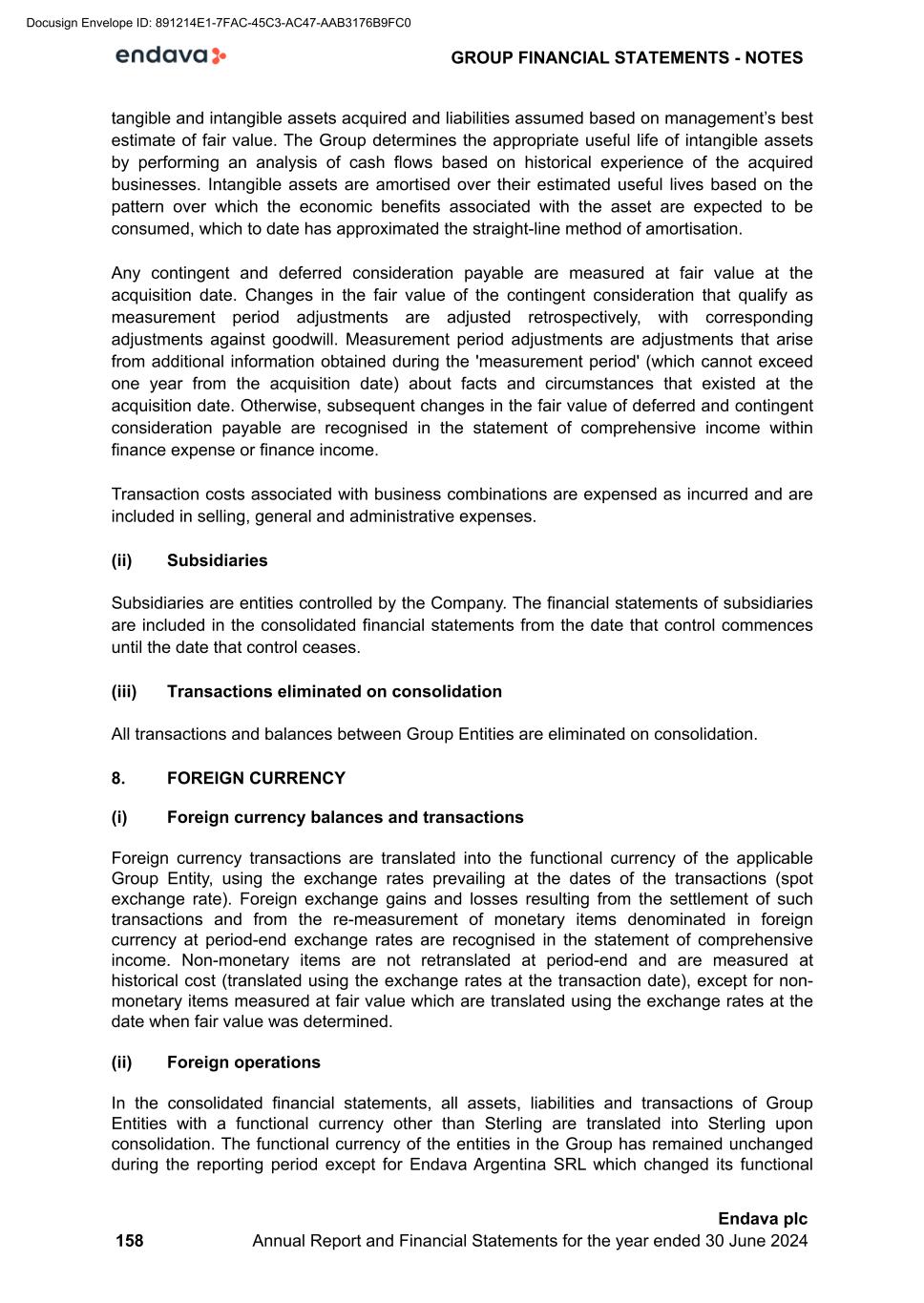
tangible and intangible assets acquired and liabilities assumed based on management’s best estimate of fair value. The Group determines the appropriate useful life of intangible assets by performing an analysis of cash flows based on historical experience of the acquired businesses. Intangible assets are amortised over their estimated useful lives based on the pattern over which the economic benefits associated with the asset are expected to be consumed, which to date has approximated the straight-line method of amortisation. Any contingent and deferred consideration payable are measured at fair value at the acquisition date. Changes in the fair value of the contingent consideration that qualify as measurement period adjustments are adjusted retrospectively, with corresponding adjustments against goodwill. Measurement period adjustments are adjustments that arise from additional information obtained during the 'measurement period' (which cannot exceed one year from the acquisition date) about facts and circumstances that existed at the acquisition date. Otherwise, subsequent changes in the fair value of deferred and contingent consideration payable are recognised in the statement of comprehensive income within finance expense or finance income. Transaction costs associated with business combinations are expensed as incurred and are included in selling, general and administrative expenses. (ii) Subsidiaries Subsidiaries are entities controlled by the Company. The financial statements of subsidiaries are included in the consolidated financial statements from the date that control commences until the date that control ceases. (iii) Transactions eliminated on consolidation All transactions and balances between Group Entities are eliminated on consolidation. 8. FOREIGN CURRENCY (i) Foreign currency balances and transactions Foreign currency transactions are translated into the functional currency of the applicable Group Entity, using the exchange rates prevailing at the dates of the transactions (spot exchange rate). Foreign exchange gains and losses resulting from the settlement of such transactions and from the re-measurement of monetary items denominated in foreign currency at period-end exchange rates are recognised in the statement of comprehensive income. Non-monetary items are not retranslated at period-end and are measured at historical cost (translated using the exchange rates at the transaction date), except for non- monetary items measured at fair value which are translated using the exchange rates at the date when fair value was determined. (ii) Foreign operations In the consolidated financial statements, all assets, liabilities and transactions of Group Entities with a functional currency other than Sterling are translated into Sterling upon consolidation. The functional currency of the entities in the Group has remained unchanged during the reporting period except for Endava Argentina SRL which changed its functional GROUP FINANCIAL STATEMENTS - NOTES 158 Endava plc Annual Report and Financial Statements for the year ended 30 June 2024 Docusign Envelope ID: 891214E1-7FAC-45C3-AC47-AAB3176B9FC0
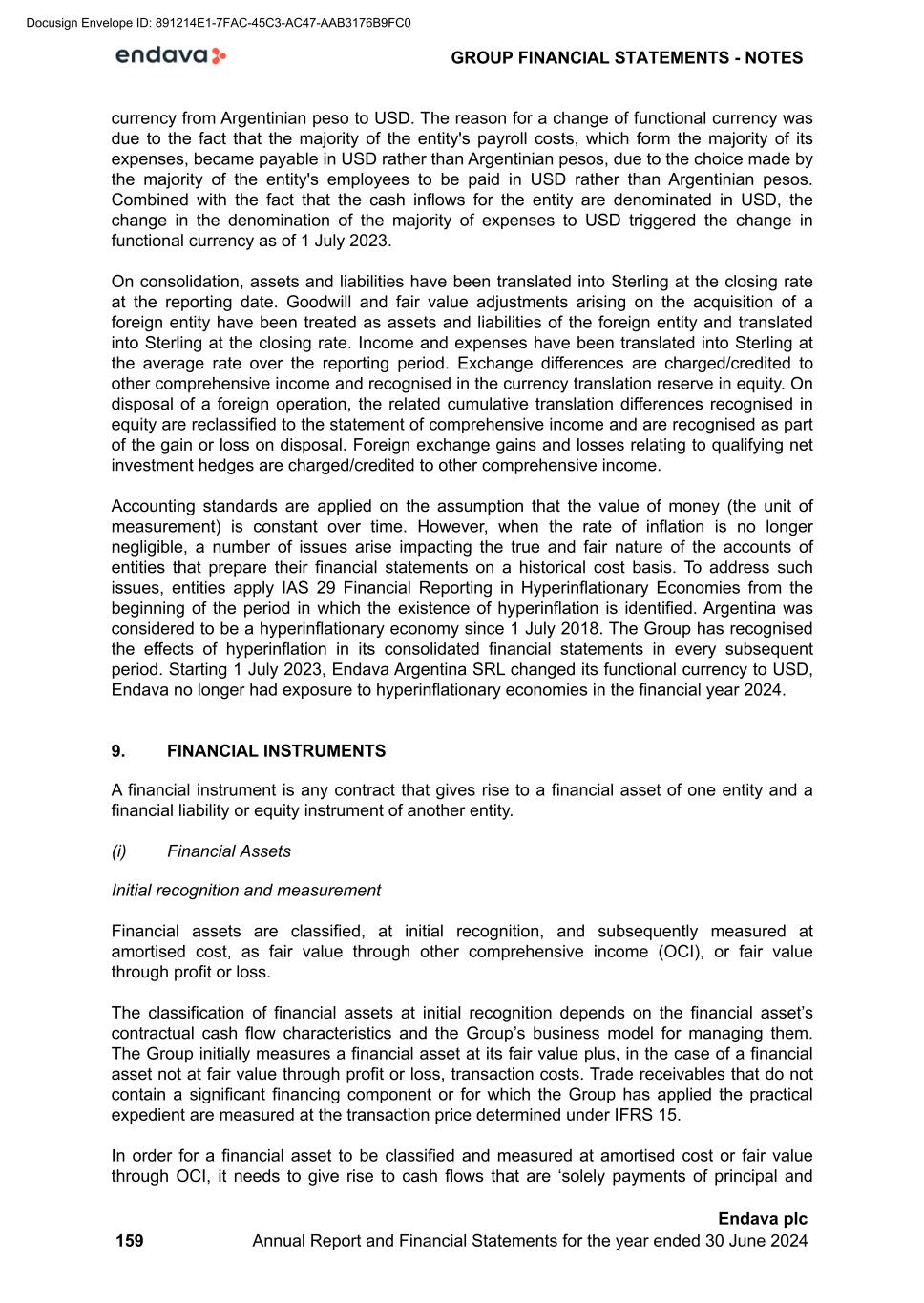
currency from Argentinian peso to USD. The reason for a change of functional currency was due to the fact that the majority of the entity's payroll costs, which form the majority of its expenses, became payable in USD rather than Argentinian pesos, due to the choice made by the majority of the entity's employees to be paid in USD rather than Argentinian pesos. Combined with the fact that the cash inflows for the entity are denominated in USD, the change in the denomination of the majority of expenses to USD triggered the change in functional currency as of 1 July 2023. On consolidation, assets and liabilities have been translated into Sterling at the closing rate at the reporting date. Goodwill and fair value adjustments arising on the acquisition of a foreign entity have been treated as assets and liabilities of the foreign entity and translated into Sterling at the closing rate. Income and expenses have been translated into Sterling at the average rate over the reporting period. Exchange differences are charged/credited to other comprehensive income and recognised in the currency translation reserve in equity. On disposal of a foreign operation, the related cumulative translation differences recognised in equity are reclassified to the statement of comprehensive income and are recognised as part of the gain or loss on disposal. Foreign exchange gains and losses relating to qualifying net investment hedges are charged/credited to other comprehensive income. Accounting standards are applied on the assumption that the value of money (the unit of measurement) is constant over time. However, when the rate of inflation is no longer negligible, a number of issues arise impacting the true and fair nature of the accounts of entities that prepare their financial statements on a historical cost basis. To address such issues, entities apply IAS 29 Financial Reporting in Hyperinflationary Economies from the beginning of the period in which the existence of hyperinflation is identified. Argentina was considered to be a hyperinflationary economy since 1 July 2018. The Group has recognised the effects of hyperinflation in its consolidated financial statements in every subsequent period. Starting 1 July 2023, Endava Argentina SRL changed its functional currency to USD, Endava no longer had exposure to hyperinflationary economies in the financial year 2024. 9. FINANCIAL INSTRUMENTS A financial instrument is any contract that gives rise to a financial asset of one entity and a financial liability or equity instrument of another entity. (i) Financial Assets Initial recognition and measurement Financial assets are classified, at initial recognition, and subsequently measured at amortised cost, as fair value through other comprehensive income (OCI), or fair value through profit or loss. The classification of financial assets at initial recognition depends on the financial asset’s contractual cash flow characteristics and the Group’s business model for managing them. The Group initially measures a financial asset at its fair value plus, in the case of a financial asset not at fair value through profit or loss, transaction costs. Trade receivables that do not contain a significant financing component or for which the Group has applied the practical expedient are measured at the transaction price determined under IFRS 15. In order for a financial asset to be classified and measured at amortised cost or fair value through OCI, it needs to give rise to cash flows that are ‘solely payments of principal and GROUP FINANCIAL STATEMENTS - NOTES 159 Endava plc Annual Report and Financial Statements for the year ended 30 June 2024 Docusign Envelope ID: 891214E1-7FAC-45C3-AC47-AAB3176B9FC0

interest (SPPI)’ on the principal amount outstanding. This assessment is referred to as the SPPI test and is performed at an instrument level. Financial assets that are not SPPI are classified and measured at fair value through profit or loss, irrespective of the business model. Subsequent measurement For purposes of subsequent measurement, financial assets are classified in four categories: • Financial assets at amortised cost (debt instruments) • Financial assets at fair value through OCI with recycling of cumulative gains and losses (debt instruments) • Financial assets designated at fair value through OCI with no recycling of cumulative gains and losses upon derecognition (equity instruments) • Financial assets at fair value through profit or loss Financial assets at amortised cost The Group measures financial assets at amortised cost if both of the following conditions are met: • The financial asset is held within a business model with the objective to hold financial assets in order to collect contractual cash flows; and • The contractual terms of the financial asset give rise on specified dates to cash flows that are solely payments of principal and interest on the principal amount outstanding Financial assets at amortised cost are subsequently measured using the effective interest rate (EIR) method and are subject to impairment. Gains and losses are recognised in profit or loss when the asset is derecognised, modified or impaired. The Group’s financial assets at amortised cost includes cash and cash equivalents, trade and other receivables (excluding prepayments, R&D tax credit, grant receivables and other debtors), accrued income and finance lease receivables. Financial assets at fair value through profit or loss Financial assets at fair value through profit or loss are carried in the balance sheet at fair value with net changes in fair value recognised in the statement of comprehensive income. Derecognition A financial asset is primarily derecognised when: • The rights to receive cash flows from the asset have expired; or • The Group has transferred its rights to receive cash flows from the asset and either (a) the Group has transferred substantially all the risks and rewards of the asset, or (b) the Group has neither transferred nor retained substantially all the risks and rewards of the asset, but has transferred control of the asset. GROUP FINANCIAL STATEMENTS - NOTES 160 Endava plc Annual Report and Financial Statements for the year ended 30 June 2024 Docusign Envelope ID: 891214E1-7FAC-45C3-AC47-AAB3176B9FC0
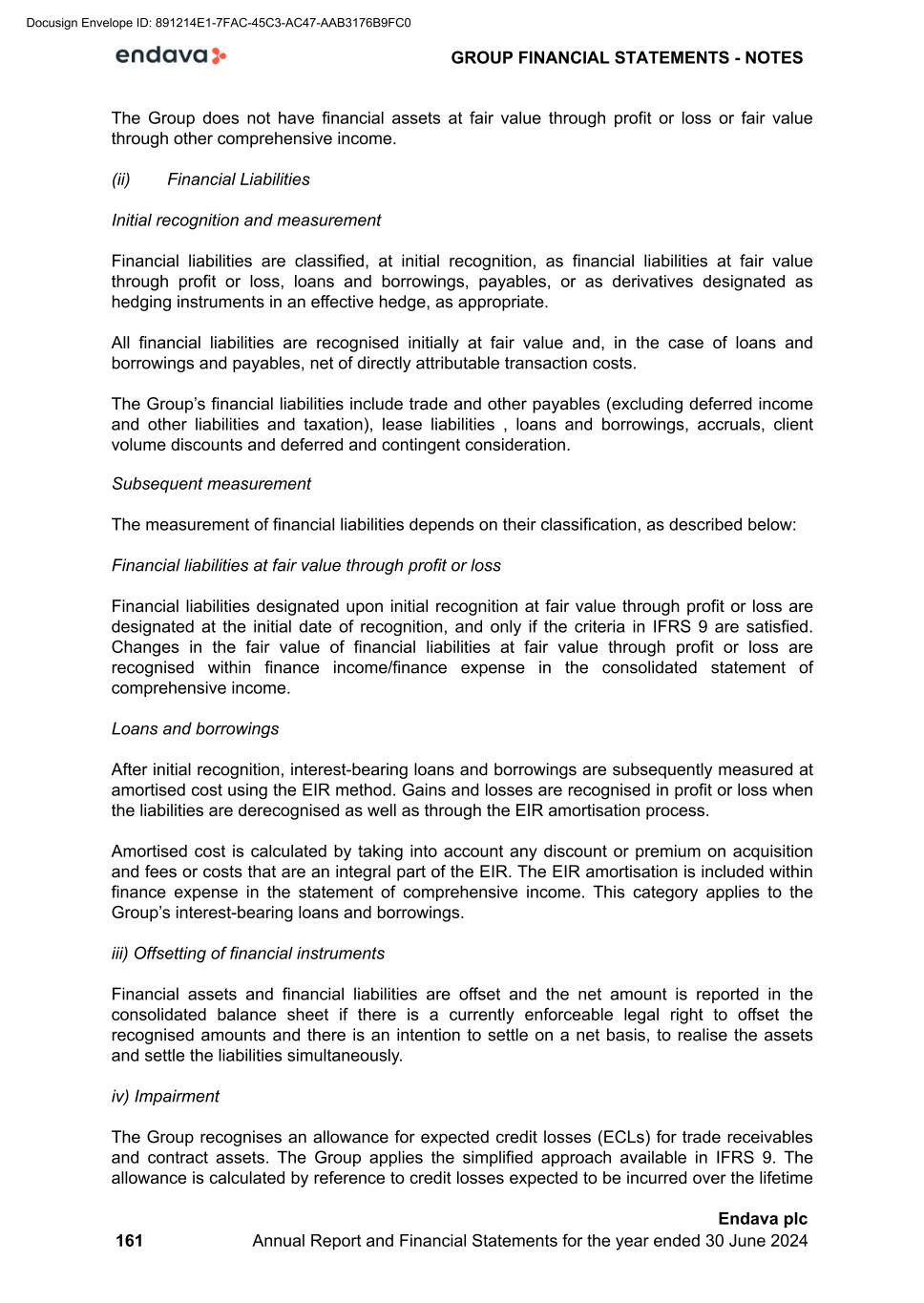
The Group does not have financial assets at fair value through profit or loss or fair value through other comprehensive income. (ii) Financial Liabilities Initial recognition and measurement Financial liabilities are classified, at initial recognition, as financial liabilities at fair value through profit or loss, loans and borrowings, payables, or as derivatives designated as hedging instruments in an effective hedge, as appropriate. All financial liabilities are recognised initially at fair value and, in the case of loans and borrowings and payables, net of directly attributable transaction costs. The Group’s financial liabilities include trade and other payables (excluding deferred income and other liabilities and taxation), lease liabilities , loans and borrowings, accruals, client volume discounts and deferred and contingent consideration. Subsequent measurement The measurement of financial liabilities depends on their classification, as described below: Financial liabilities at fair value through profit or loss Financial liabilities designated upon initial recognition at fair value through profit or loss are designated at the initial date of recognition, and only if the criteria in IFRS 9 are satisfied. Changes in the fair value of financial liabilities at fair value through profit or loss are recognised within finance income/finance expense in the consolidated statement of comprehensive income. Loans and borrowings After initial recognition, interest-bearing loans and borrowings are subsequently measured at amortised cost using the EIR method. Gains and losses are recognised in profit or loss when the liabilities are derecognised as well as through the EIR amortisation process. Amortised cost is calculated by taking into account any discount or premium on acquisition and fees or costs that are an integral part of the EIR. The EIR amortisation is included within finance expense in the statement of comprehensive income. This category applies to the Group’s interest-bearing loans and borrowings. iii) Offsetting of financial instruments Financial assets and financial liabilities are offset and the net amount is reported in the consolidated balance sheet if there is a currently enforceable legal right to offset the recognised amounts and there is an intention to settle on a net basis, to realise the assets and settle the liabilities simultaneously. iv) Impairment The Group recognises an allowance for expected credit losses (ECLs) for trade receivables and contract assets. The Group applies the simplified approach available in IFRS 9. The allowance is calculated by reference to credit losses expected to be incurred over the lifetime GROUP FINANCIAL STATEMENTS - NOTES 161 Endava plc Annual Report and Financial Statements for the year ended 30 June 2024 Docusign Envelope ID: 891214E1-7FAC-45C3-AC47-AAB3176B9FC0
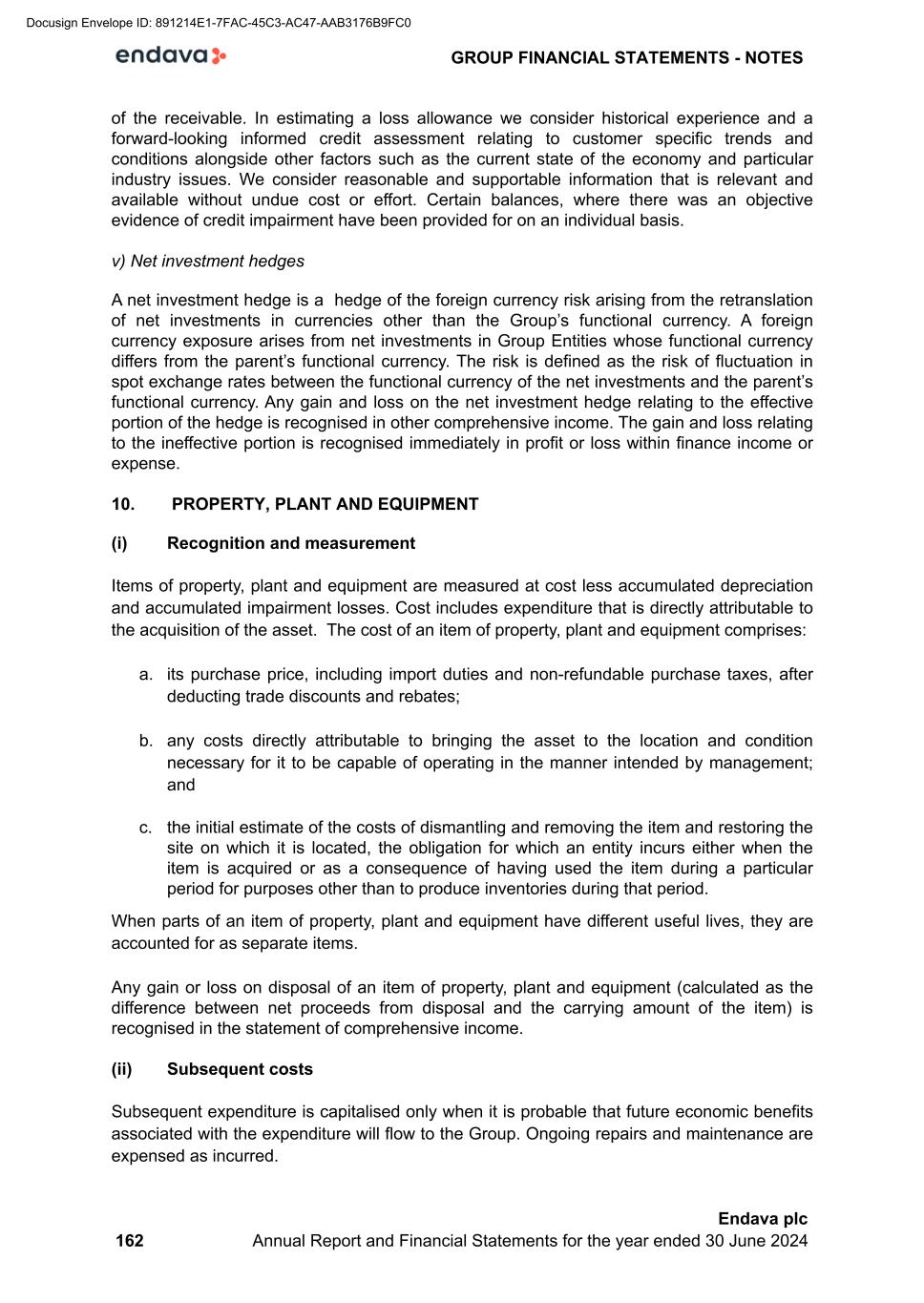
of the receivable. In estimating a loss allowance we consider historical experience and a forward-looking informed credit assessment relating to customer specific trends and conditions alongside other factors such as the current state of the economy and particular industry issues. We consider reasonable and supportable information that is relevant and available without undue cost or effort. Certain balances, where there was an objective evidence of credit impairment have been provided for on an individual basis. v) Net investment hedges A net investment hedge is a hedge of the foreign currency risk arising from the retranslation of net investments in currencies other than the Group’s functional currency. A foreign currency exposure arises from net investments in Group Entities whose functional currency differs from the parent’s functional currency. The risk is defined as the risk of fluctuation in spot exchange rates between the functional currency of the net investments and the parent’s functional currency. Any gain and loss on the net investment hedge relating to the effective portion of the hedge is recognised in other comprehensive income. The gain and loss relating to the ineffective portion is recognised immediately in profit or loss within finance income or expense. 10. PROPERTY, PLANT AND EQUIPMENT (i) Recognition and measurement Items of property, plant and equipment are measured at cost less accumulated depreciation and accumulated impairment losses. Cost includes expenditure that is directly attributable to the acquisition of the asset. The cost of an item of property, plant and equipment comprises: a. its purchase price, including import duties and non-refundable purchase taxes, after deducting trade discounts and rebates; b. any costs directly attributable to bringing the asset to the location and condition necessary for it to be capable of operating in the manner intended by management; and c. the initial estimate of the costs of dismantling and removing the item and restoring the site on which it is located, the obligation for which an entity incurs either when the item is acquired or as a consequence of having used the item during a particular period for purposes other than to produce inventories during that period. When parts of an item of property, plant and equipment have different useful lives, they are accounted for as separate items. Any gain or loss on disposal of an item of property, plant and equipment (calculated as the difference between net proceeds from disposal and the carrying amount of the item) is recognised in the statement of comprehensive income. (ii) Subsequent costs Subsequent expenditure is capitalised only when it is probable that future economic benefits associated with the expenditure will flow to the Group. Ongoing repairs and maintenance are expensed as incurred. GROUP FINANCIAL STATEMENTS - NOTES 162 Endava plc Annual Report and Financial Statements for the year ended 30 June 2024 Docusign Envelope ID: 891214E1-7FAC-45C3-AC47-AAB3176B9FC0
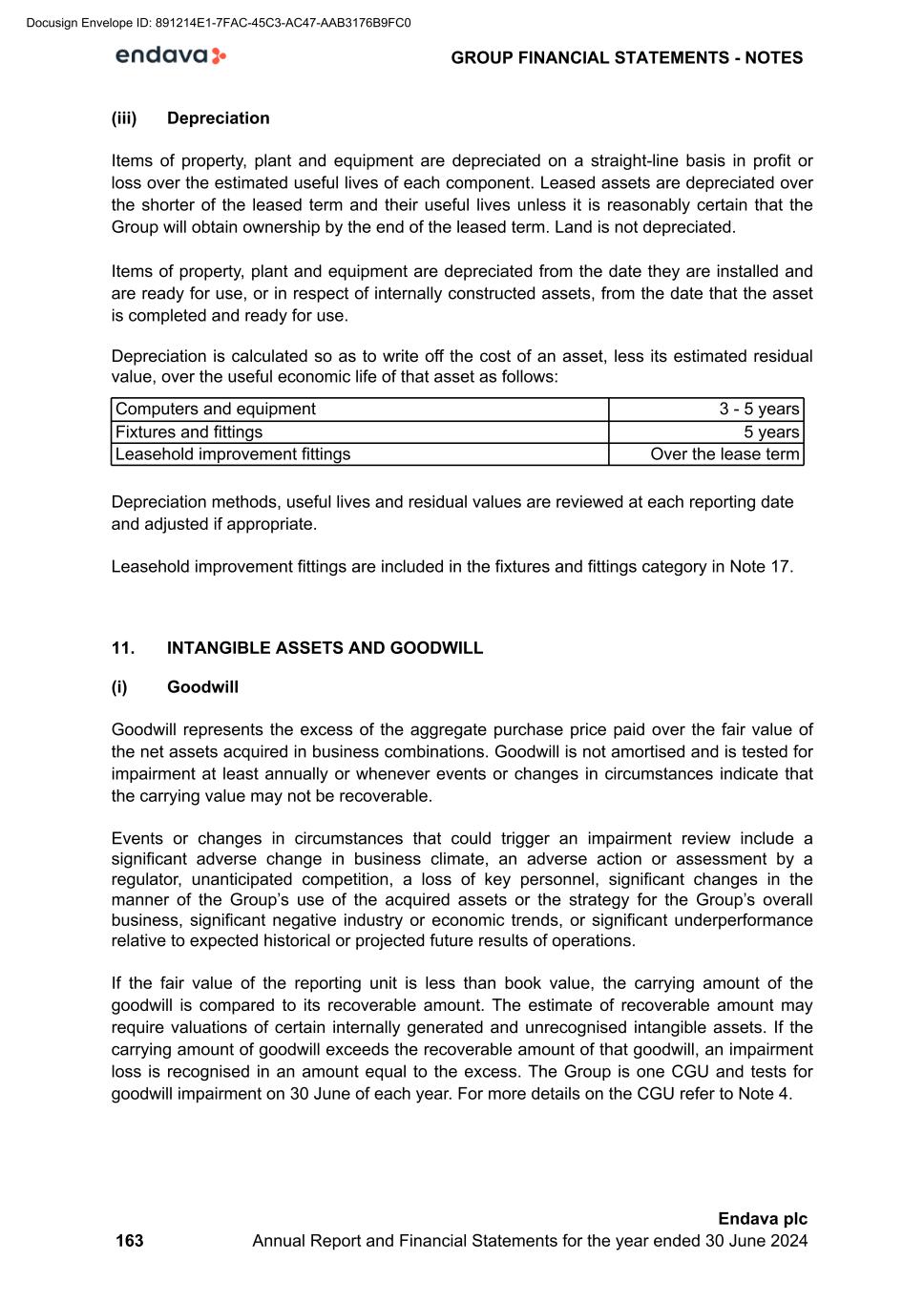
(iii) Depreciation Items of property, plant and equipment are depreciated on a straight-line basis in profit or loss over the estimated useful lives of each component. Leased assets are depreciated over the shorter of the leased term and their useful lives unless it is reasonably certain that the Group will obtain ownership by the end of the leased term. Land is not depreciated. Items of property, plant and equipment are depreciated from the date they are installed and are ready for use, or in respect of internally constructed assets, from the date that the asset is completed and ready for use. Depreciation is calculated so as to write off the cost of an asset, less its estimated residual value, over the useful economic life of that asset as follows: Computers and equipment 3 - 5 years Fixtures and fittings 5 years Leasehold improvement fittings Over the lease term Depreciation methods, useful lives and residual values are reviewed at each reporting date and adjusted if appropriate. Leasehold improvement fittings are included in the fixtures and fittings category in Note 17. 11. INTANGIBLE ASSETS AND GOODWILL (i) Goodwill Goodwill represents the excess of the aggregate purchase price paid over the fair value of the net assets acquired in business combinations. Goodwill is not amortised and is tested for impairment at least annually or whenever events or changes in circumstances indicate that the carrying value may not be recoverable. Events or changes in circumstances that could trigger an impairment review include a significant adverse change in business climate, an adverse action or assessment by a regulator, unanticipated competition, a loss of key personnel, significant changes in the manner of the Group’s use of the acquired assets or the strategy for the Group’s overall business, significant negative industry or economic trends, or significant underperformance relative to expected historical or projected future results of operations. If the fair value of the reporting unit is less than book value, the carrying amount of the goodwill is compared to its recoverable amount. The estimate of recoverable amount may require valuations of certain internally generated and unrecognised intangible assets. If the carrying amount of goodwill exceeds the recoverable amount of that goodwill, an impairment loss is recognised in an amount equal to the excess. The Group is one CGU and tests for goodwill impairment on 30 June of each year. For more details on the CGU refer to Note 4. GROUP FINANCIAL STATEMENTS - NOTES 163 Endava plc Annual Report and Financial Statements for the year ended 30 June 2024 Docusign Envelope ID: 891214E1-7FAC-45C3-AC47-AAB3176B9FC0
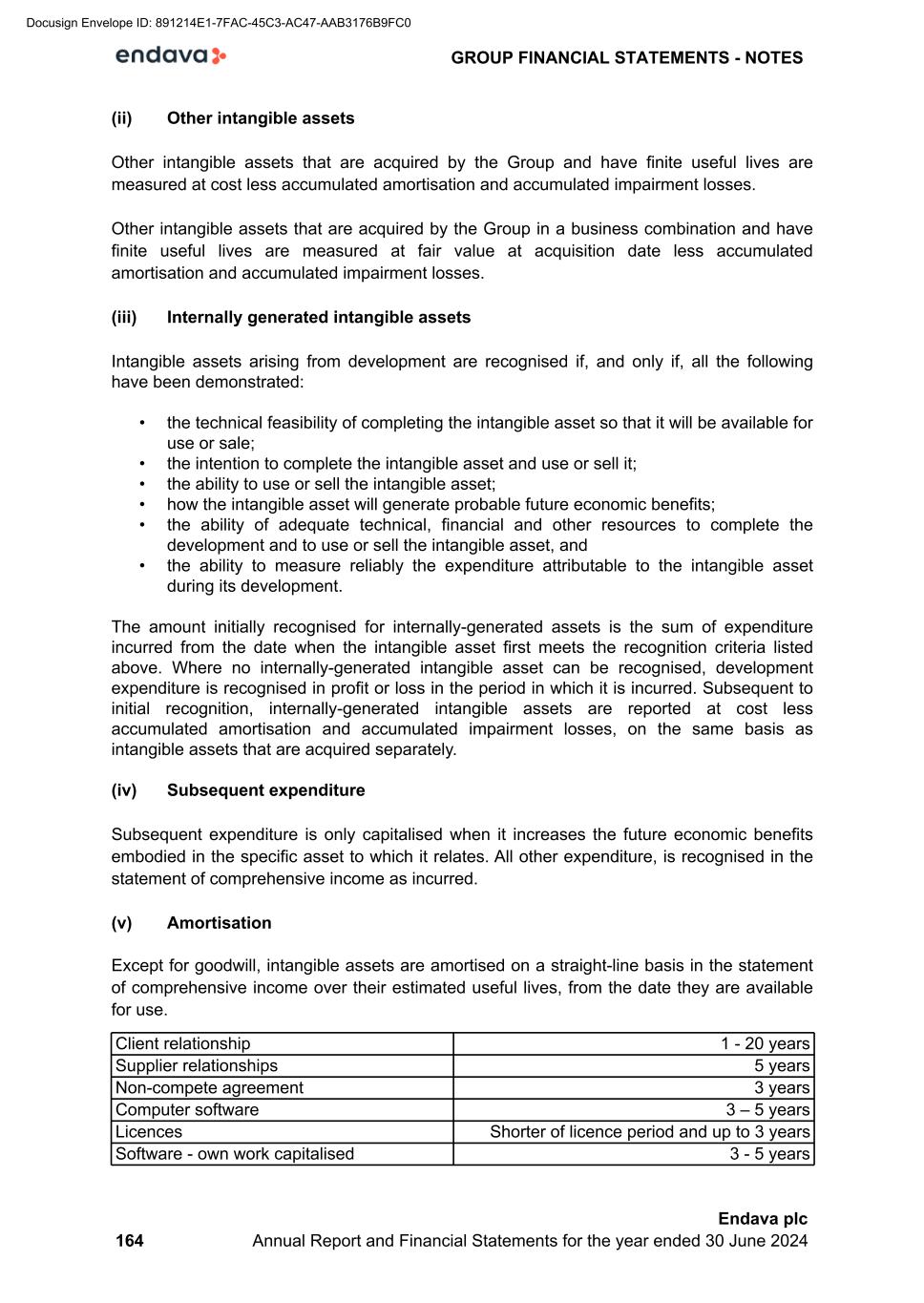
(ii) Other intangible assets Other intangible assets that are acquired by the Group and have finite useful lives are measured at cost less accumulated amortisation and accumulated impairment losses. Other intangible assets that are acquired by the Group in a business combination and have finite useful lives are measured at fair value at acquisition date less accumulated amortisation and accumulated impairment losses. (iii) Internally generated intangible assets Intangible assets arising from development are recognised if, and only if, all the following have been demonstrated: • the technical feasibility of completing the intangible asset so that it will be available for use or sale; • the intention to complete the intangible asset and use or sell it; • the ability to use or sell the intangible asset; • how the intangible asset will generate probable future economic benefits; • the ability of adequate technical, financial and other resources to complete the development and to use or sell the intangible asset, and • the ability to measure reliably the expenditure attributable to the intangible asset during its development. The amount initially recognised for internally-generated assets is the sum of expenditure incurred from the date when the intangible asset first meets the recognition criteria listed above. Where no internally-generated intangible asset can be recognised, development expenditure is recognised in profit or loss in the period in which it is incurred. Subsequent to initial recognition, internally-generated intangible assets are reported at cost less accumulated amortisation and accumulated impairment losses, on the same basis as intangible assets that are acquired separately. (iv) Subsequent expenditure Subsequent expenditure is only capitalised when it increases the future economic benefits embodied in the specific asset to which it relates. All other expenditure, is recognised in the statement of comprehensive income as incurred. (v) Amortisation Except for goodwill, intangible assets are amortised on a straight-line basis in the statement of comprehensive income over their estimated useful lives, from the date they are available for use. Client relationship 1 - 20 years Supplier relationships 5 years Non-compete agreement 3 years Computer software 3 – 5 years Licences Shorter of licence period and up to 3 years Software - own work capitalised 3 - 5 years GROUP FINANCIAL STATEMENTS - NOTES 164 Endava plc Annual Report and Financial Statements for the year ended 30 June 2024 Docusign Envelope ID: 891214E1-7FAC-45C3-AC47-AAB3176B9FC0

12. LEASE AGREEMENTS The Group assesses whether a contract is, or contains, a lease at the inception of a contract. A contract is, or contains, a lease if the contract conveys the right to control the use of an identified asset for a period of time in exchange for consideration. To assess whether a contract conveys the right to control the use of an identified asset, the Group uses the definition of a lease in IFRS 16. The Group as a lessee The Group recognises a right-of-use asset and a lease liability at the lease commencement date with respect to all lease arrangements except for short-term leases (leases with a lease term of 12 months or less) and leases of low value assets. For these leases, the lease payments are recognised within selling, general and administrative expenses on a straight- line basis over the term of the lease. As the majority of the Group’s lease portfolio relates to property leases of offices and delivery centres, the Group has elected not to separate non-lease components and therefore accounts for the lease and non-lease component as a single lease component. Right-of-use assets are initially measured at cost, comprising the initial amount of the corresponding lease liability, adjusted for any lease payments made at or before the commencement date, plus any initial direct costs incurred, and an estimate of costs to dismantle and remove the underlying asset or to restore the underlying asset or the site on which it is located, less any lease incentives received. Right-of-use assets are subsequently depreciated using the straight-line method from the commencement date to the end of the lease term, unless the lease transfers ownership of the underlying asset to the Group by the end of the lease term or the cost of the right-of-use asset reflects that the Group will exercise a purchase option. In that case, the right-of-use asset will be depreciated over the useful life of the underlying asset, which is determined on the same basis as those of property, plant and equipment. In addition, right-of-use assets are adjusted for any remeasurement of lease liabilities. Right-of-use assets are reviewed for impairment when events or changes in circumstances indicate the carrying value may not be fully recoverable. Lease liabilities are initially measured at the present value of the lease payments that are due over the lease term, which have not been paid at the commencement date, discounted using the interest rate implicit in the lease or, if that rate cannot be readily determined, the incremental borrowing rate applicable to each lease. This is the rate that the Group would have to pay for a loan of a similar term, and with a similar security, to obtain an asset of a similar value. The Group calculates the incremental borrowing rate applicable to each lease by obtaining information from various external sources in relation to interest rates and credit risk and makes certain adjustments to reflect the terms of the lease, the type of asset leased, the country and currency of the lease. Lease payments included in the measurement of the lease liability comprise the following: • fixed payments, including in-substance fixed payments, less any lease incentives receivable; GROUP FINANCIAL STATEMENTS - NOTES 165 Endava plc Annual Report and Financial Statements for the year ended 30 June 2024 Docusign Envelope ID: 891214E1-7FAC-45C3-AC47-AAB3176B9FC0

• variable lease payments that depend on an index or a rate, initially measured using the index or rate as at the commencement date; • amounts expected to be paid under residual value guarantees; • the exercise price of any purchase options that are reasonably certain to be exercised; • payments due over optional renewal periods that are reasonably certain to be exercised; and • penalties for early termination of a lease where we are reasonably certain to terminate early. Any variable lease payments that do not depend on an index or a rate are recognised as an expense in the period in which the event or condition that triggers the payment occurs. Lease liabilities are subsequently measured at amortised cost using the effective interest method. Lease liabilities are remeasured if there is a modification, a change in future lease payments due to a renegotiation or market rent review or a change of an index or rate, or the amount expected to be payable under a residual guarantee, or if we change our assessment of whether we will exercise a purchase, renewal or termination option. When a lease liability is remeasured, a corresponding adjustment is made to the related right-of-use asset. The Group determines the lease term as the non-cancellable term of the lease, together with any periods covered by an option to extend the lease if it is reasonably certain to be exercised, or any periods covered by an option to terminate the lease, if it is reasonably certain not to be exercised. The Group presents right-of-use assets and lease liabilities as separate line items on the face of the consolidated balance sheet. The Group as a lessor When the Group acts as a lessor, it determines at lease inception whether each lease is a finance lease or an operating lease. To classify each lease, the Group makes an overall assessment of whether the lease transfers substantially all of the risks and rewards incidental to ownership of the underlying asset. If this is the case, then the lease is a finance lease; if not then it is an operating lease. As part of this assessment, the Group considers certain indicators such as whether the lease is for the major part of the economic life of the asset. When the Group is an intermediate lessor, the head-lease and sub-lease are accounted for as two separate contracts. The head lease is accounted for as per the lessee policy above. The sub-lease is classified as a finance lease or operating lease by reference to the right-of- use asset arising from the head lease. Where the lease transfers substantially all the risks and rewards of ownership to the lessee the contract is classified as a finance lease; all other leases are classified as operating leases. If an arrangement contains lease and non-lease components, the Group applies IFRS 15 to allocate the consideration in the contract. Rental income from operating leases is recognised on a straight-line basis over the term of the relevant lease. Amounts due from lessees under finance sub-leases are recognised as receivables at the amount of the Group’s net investment in the leases, discounted using the interest rate implicit in the lease or, if that rate cannot be readily determined, the discount rate used in the head lease. GROUP FINANCIAL STATEMENTS - NOTES 166 Endava plc Annual Report and Financial Statements for the year ended 30 June 2024 Docusign Envelope ID: 891214E1-7FAC-45C3-AC47-AAB3176B9FC0
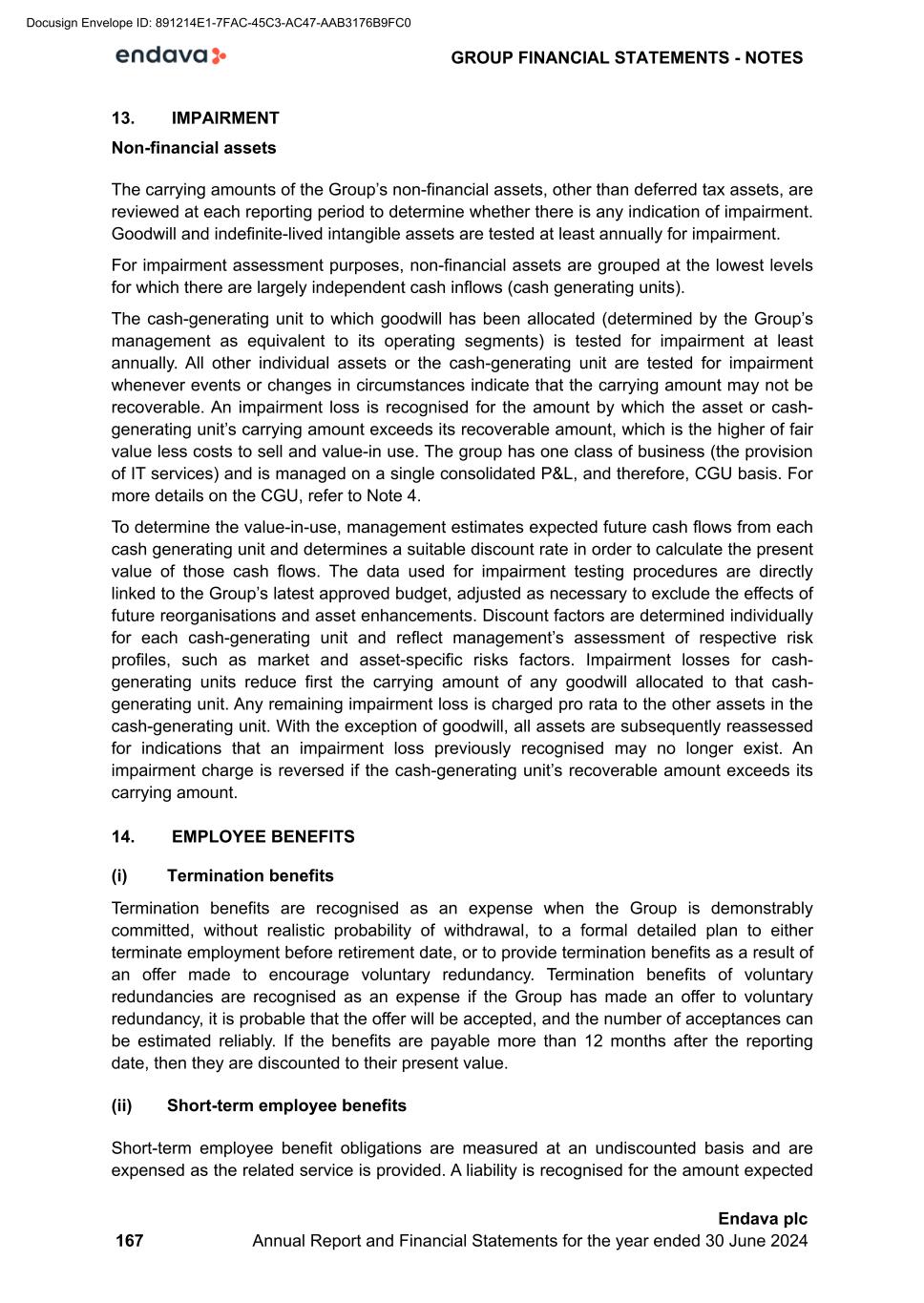
13. IMPAIRMENT Non-financial assets The carrying amounts of the Group’s non-financial assets, other than deferred tax assets, are reviewed at each reporting period to determine whether there is any indication of impairment. Goodwill and indefinite-lived intangible assets are tested at least annually for impairment. For impairment assessment purposes, non-financial assets are grouped at the lowest levels for which there are largely independent cash inflows (cash generating units). The cash-generating unit to which goodwill has been allocated (determined by the Group’s management as equivalent to its operating segments) is tested for impairment at least annually. All other individual assets or the cash-generating unit are tested for impairment whenever events or changes in circumstances indicate that the carrying amount may not be recoverable. An impairment loss is recognised for the amount by which the asset or cash- generating unit’s carrying amount exceeds its recoverable amount, which is the higher of fair value less costs to sell and value-in use. The group has one class of business (the provision of IT services) and is managed on a single consolidated P&L, and therefore, CGU basis. For more details on the CGU, refer to Note 4. To determine the value-in-use, management estimates expected future cash flows from each cash generating unit and determines a suitable discount rate in order to calculate the present value of those cash flows. The data used for impairment testing procedures are directly linked to the Group’s latest approved budget, adjusted as necessary to exclude the effects of future reorganisations and asset enhancements. Discount factors are determined individually for each cash-generating unit and reflect management’s assessment of respective risk profiles, such as market and asset-specific risks factors. Impairment losses for cash- generating units reduce first the carrying amount of any goodwill allocated to that cash- generating unit. Any remaining impairment loss is charged pro rata to the other assets in the cash-generating unit. With the exception of goodwill, all assets are subsequently reassessed for indications that an impairment loss previously recognised may no longer exist. An impairment charge is reversed if the cash-generating unit’s recoverable amount exceeds its carrying amount. 14. EMPLOYEE BENEFITS (i) Termination benefits Termination benefits are recognised as an expense when the Group is demonstrably committed, without realistic probability of withdrawal, to a formal detailed plan to either terminate employment before retirement date, or to provide termination benefits as a result of an offer made to encourage voluntary redundancy. Termination benefits of voluntary redundancies are recognised as an expense if the Group has made an offer to voluntary redundancy, it is probable that the offer will be accepted, and the number of acceptances can be estimated reliably. If the benefits are payable more than 12 months after the reporting date, then they are discounted to their present value. (ii) Short-term employee benefits Short-term employee benefit obligations are measured at an undiscounted basis and are expensed as the related service is provided. A liability is recognised for the amount expected GROUP FINANCIAL STATEMENTS - NOTES 167 Endava plc Annual Report and Financial Statements for the year ended 30 June 2024 Docusign Envelope ID: 891214E1-7FAC-45C3-AC47-AAB3176B9FC0
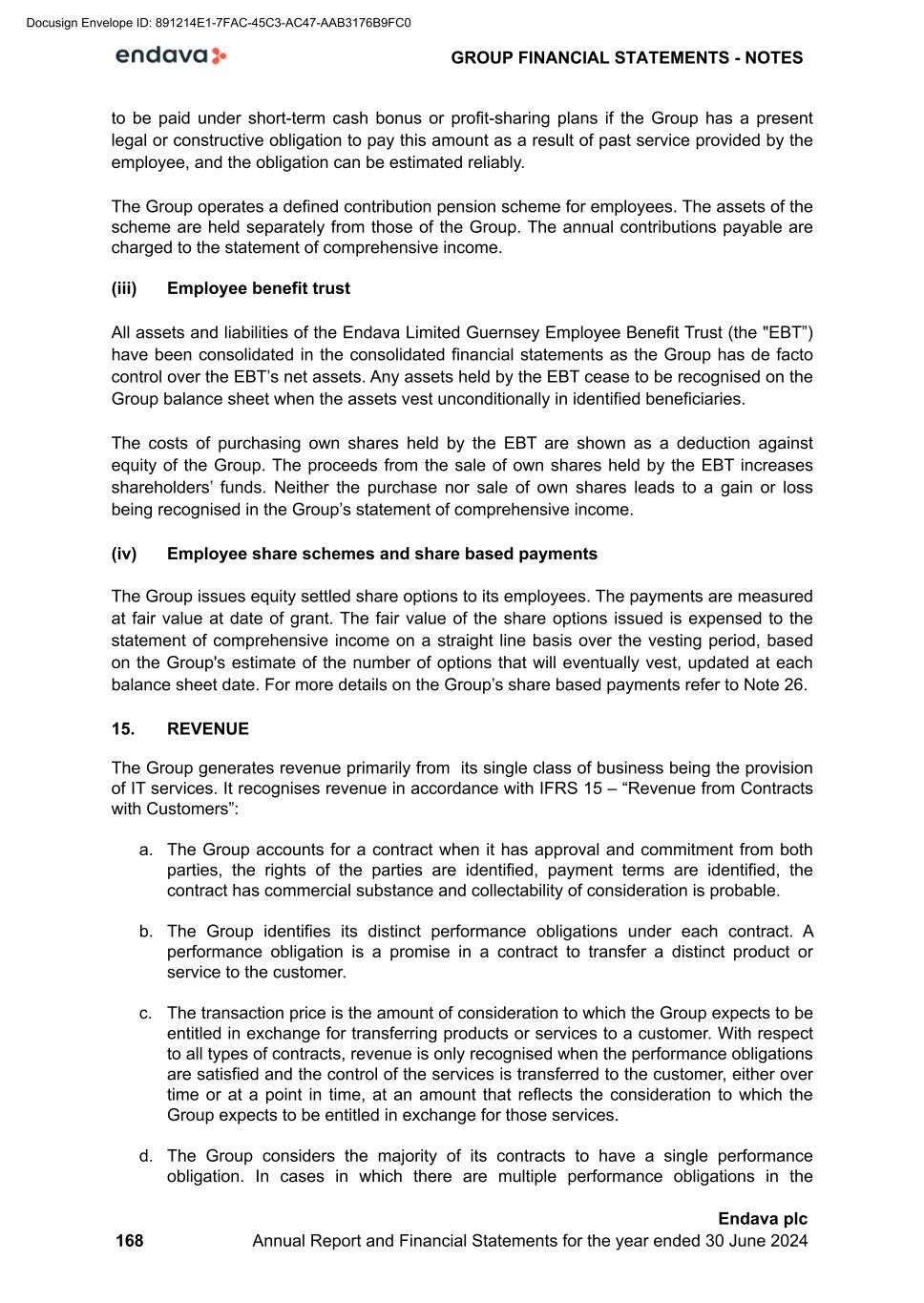
to be paid under short-term cash bonus or profit-sharing plans if the Group has a present legal or constructive obligation to pay this amount as a result of past service provided by the employee, and the obligation can be estimated reliably. The Group operates a defined contribution pension scheme for employees. The assets of the scheme are held separately from those of the Group. The annual contributions payable are charged to the statement of comprehensive income. (iii) Employee benefit trust All assets and liabilities of the Endava Limited Guernsey Employee Benefit Trust (the "EBT”) have been consolidated in the consolidated financial statements as the Group has de facto control over the EBT’s net assets. Any assets held by the EBT cease to be recognised on the Group balance sheet when the assets vest unconditionally in identified beneficiaries. The costs of purchasing own shares held by the EBT are shown as a deduction against equity of the Group. The proceeds from the sale of own shares held by the EBT increases shareholders’ funds. Neither the purchase nor sale of own shares leads to a gain or loss being recognised in the Group’s statement of comprehensive income. (iv) Employee share schemes and share based payments The Group issues equity settled share options to its employees. The payments are measured at fair value at date of grant. The fair value of the share options issued is expensed to the statement of comprehensive income on a straight line basis over the vesting period, based on the Group's estimate of the number of options that will eventually vest, updated at each balance sheet date. For more details on the Group’s share based payments refer to Note 26. 15. REVENUE The Group generates revenue primarily from its single class of business being the provision of IT services. It recognises revenue in accordance with IFRS 15 – “Revenue from Contracts with Customers”: a. The Group accounts for a contract when it has approval and commitment from both parties, the rights of the parties are identified, payment terms are identified, the contract has commercial substance and collectability of consideration is probable. b. The Group identifies its distinct performance obligations under each contract. A performance obligation is a promise in a contract to transfer a distinct product or service to the customer. c. The transaction price is the amount of consideration to which the Group expects to be entitled in exchange for transferring products or services to a customer. With respect to all types of contracts, revenue is only recognised when the performance obligations are satisfied and the control of the services is transferred to the customer, either over time or at a point in time, at an amount that reflects the consideration to which the Group expects to be entitled in exchange for those services. d. The Group considers the majority of its contracts to have a single performance obligation. In cases in which there are multiple performance obligations in the GROUP FINANCIAL STATEMENTS - NOTES 168 Endava plc Annual Report and Financial Statements for the year ended 30 June 2024 Docusign Envelope ID: 891214E1-7FAC-45C3-AC47-AAB3176B9FC0
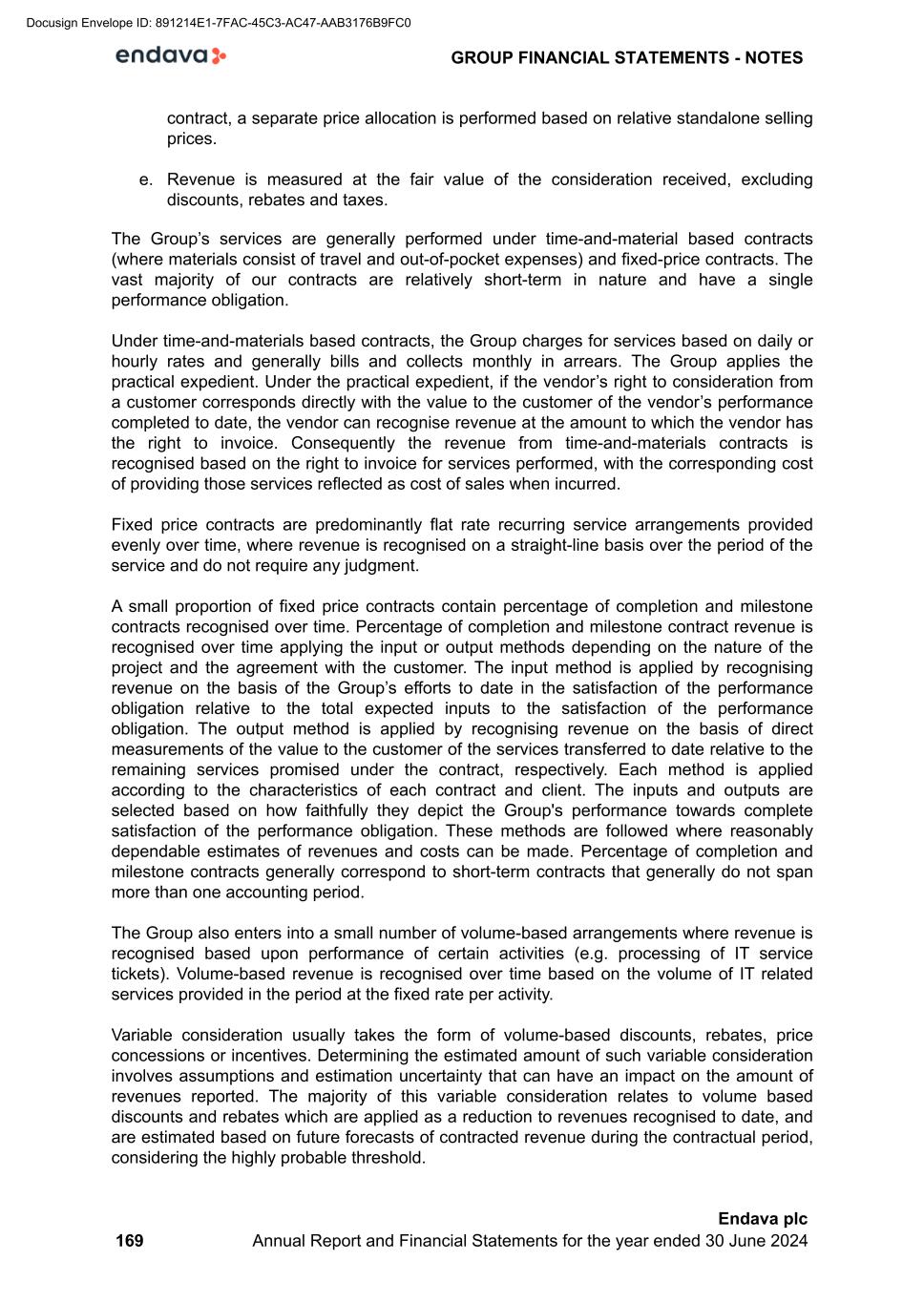
contract, a separate price allocation is performed based on relative standalone selling prices. e. Revenue is measured at the fair value of the consideration received, excluding discounts, rebates and taxes. The Group’s services are generally performed under time-and-material based contracts (where materials consist of travel and out-of-pocket expenses) and fixed-price contracts. The vast majority of our contracts are relatively short-term in nature and have a single performance obligation. Under time-and-materials based contracts, the Group charges for services based on daily or hourly rates and generally bills and collects monthly in arrears. The Group applies the practical expedient. Under the practical expedient, if the vendor’s right to consideration from a customer corresponds directly with the value to the customer of the vendor’s performance completed to date, the vendor can recognise revenue at the amount to which the vendor has the right to invoice. Consequently the revenue from time-and-materials contracts is recognised based on the right to invoice for services performed, with the corresponding cost of providing those services reflected as cost of sales when incurred. Fixed price contracts are predominantly flat rate recurring service arrangements provided evenly over time, where revenue is recognised on a straight-line basis over the period of the service and do not require any judgment. A small proportion of fixed price contracts contain percentage of completion and milestone contracts recognised over time. Percentage of completion and milestone contract revenue is recognised over time applying the input or output methods depending on the nature of the project and the agreement with the customer. The input method is applied by recognising revenue on the basis of the Group’s efforts to date in the satisfaction of the performance obligation relative to the total expected inputs to the satisfaction of the performance obligation. The output method is applied by recognising revenue on the basis of direct measurements of the value to the customer of the services transferred to date relative to the remaining services promised under the contract, respectively. Each method is applied according to the characteristics of each contract and client. The inputs and outputs are selected based on how faithfully they depict the Group's performance towards complete satisfaction of the performance obligation. These methods are followed where reasonably dependable estimates of revenues and costs can be made. Percentage of completion and milestone contracts generally correspond to short-term contracts that generally do not span more than one accounting period. The Group also enters into a small number of volume-based arrangements where revenue is recognised based upon performance of certain activities (e.g. processing of IT service tickets). Volume-based revenue is recognised over time based on the volume of IT related services provided in the period at the fixed rate per activity. Variable consideration usually takes the form of volume-based discounts, rebates, price concessions or incentives. Determining the estimated amount of such variable consideration involves assumptions and estimation uncertainty that can have an impact on the amount of revenues reported. The majority of this variable consideration relates to volume based discounts and rebates which are applied as a reduction to revenues recognised to date, and are estimated based on future forecasts of contracted revenue during the contractual period, considering the highly probable threshold. GROUP FINANCIAL STATEMENTS - NOTES 169 Endava plc Annual Report and Financial Statements for the year ended 30 June 2024 Docusign Envelope ID: 891214E1-7FAC-45C3-AC47-AAB3176B9FC0

From time to time, the Group may enter into arrangements with third-party suppliers to sell services. In such cases, the Group evaluates whether it is the principal (i.e., reports revenues on a gross basis) or the agent (i.e., reports revenues on a net basis). In doing so, the Group first evaluates whether it has control of the service before it is transferred to the customer. If the Group controls the service before it is transferred to the customer, the Group is the principal; if not, the Group is the agent. Determining whether the Group controls the service before it is transferred to the customer may require judgment. A contract asset is a right to consideration that is conditional upon factors other than the passage of time. Services performed on or prior to the balance sheet date, but invoiced thereafter, are reflected in accrued income. Contract liabilities, or deferred income, consist of advance payments from clients and billings in excess of revenues recognised. The Group classifies deferred income as current on the consolidated balance sheet and it is recognised as revenue when the services are provided under a contract. These balances are generally short-term in nature and are generally recognised as revenue within one year. 16. COST OF SALES The Group divides cost of sales into two categories: direct cost of sales and allocated cost of sales. Direct cost of sales consists primarily of personnel costs, including salary, bonuses, share-based compensation, benefits and travel expenses for the Group’s employees directly involved in delivery of the Group’s services, as well as software licenses and other costs that relate directly to the delivery of services. Allocated cost of sales consists of the portion of depreciation, amortisation and property costs related to delivery of the Group's services. The allocation is calculated based on headcount. 17. GOVERNMENT GRANTS Government grants are assistance by government in the form of transfers of resources to the Group in return for past or future compliance with certain conditions relating to the operating activities of the Group. They exclude those forms of government assistance that cannot reasonably have a value placed upon them and transactions with government that cannot be distinguished from the normal trading transactions of the entity. Government grants are accounted for using the income approach under which they are recognised in the statement of comprehensive income on a systematic basis over the periods in which the Group recognises as expenses the related costs for which the grants are intended to compensate. The Group has been granted government grants mainly for job creation and training in some European countries where delivery units are located. The grants received are not under complex fulfilment conditions and involve job creation and retention and provision of training services as per the agreements. During the reporting period, the Group received £0.7 million (2023: £0.5 million) from contracted government grants and there were no amounts repaid due to unfulfillment of conditions. The Group considers the risk of any material derecognition of grant income due to unfulfillment of conditions to be remote. Amounts receivable in respect of research and development expenditure credits are recognised within trade and other receivables in the financial statements in the year in which the related expenditure was incurred, provided there is sufficient evidence that these amounts are recoverable. If the research and development expenditure credits are to be received in a period of over one year from the balance sheet date, they are presented under financial assets and other receivables under non-current assets. These credits, which are credited as an offset to cost of sales, are based on a fixed percentage of the cost of work that GROUP FINANCIAL STATEMENTS - NOTES 170 Endava plc Annual Report and Financial Statements for the year ended 30 June 2024 Docusign Envelope ID: 891214E1-7FAC-45C3-AC47-AAB3176B9FC0
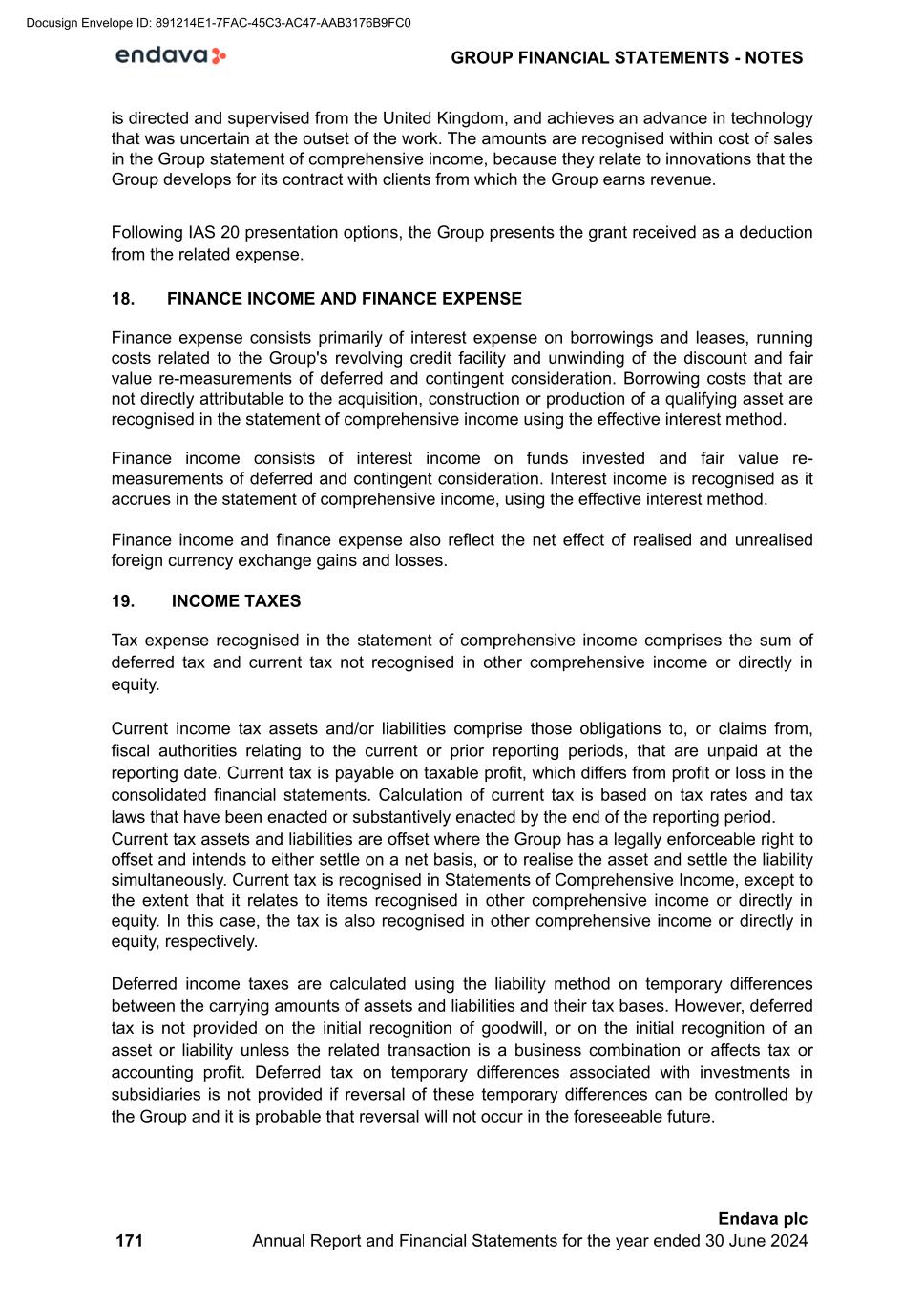
is directed and supervised from the United Kingdom, and achieves an advance in technology that was uncertain at the outset of the work. The amounts are recognised within cost of sales in the Group statement of comprehensive income, because they relate to innovations that the Group develops for its contract with clients from which the Group earns revenue. Following IAS 20 presentation options, the Group presents the grant received as a deduction from the related expense. 18. FINANCE INCOME AND FINANCE EXPENSE Finance expense consists primarily of interest expense on borrowings and leases, running costs related to the Group's revolving credit facility and unwinding of the discount and fair value re-measurements of deferred and contingent consideration. Borrowing costs that are not directly attributable to the acquisition, construction or production of a qualifying asset are recognised in the statement of comprehensive income using the effective interest method. Finance income consists of interest income on funds invested and fair value re- measurements of deferred and contingent consideration. Interest income is recognised as it accrues in the statement of comprehensive income, using the effective interest method. Finance income and finance expense also reflect the net effect of realised and unrealised foreign currency exchange gains and losses. 19. INCOME TAXES Tax expense recognised in the statement of comprehensive income comprises the sum of deferred tax and current tax not recognised in other comprehensive income or directly in equity. Current income tax assets and/or liabilities comprise those obligations to, or claims from, fiscal authorities relating to the current or prior reporting periods, that are unpaid at the reporting date. Current tax is payable on taxable profit, which differs from profit or loss in the consolidated financial statements. Calculation of current tax is based on tax rates and tax laws that have been enacted or substantively enacted by the end of the reporting period. Current tax assets and liabilities are offset where the Group has a legally enforceable right to offset and intends to either settle on a net basis, or to realise the asset and settle the liability simultaneously. Current tax is recognised in Statements of Comprehensive Income, except to the extent that it relates to items recognised in other comprehensive income or directly in equity. In this case, the tax is also recognised in other comprehensive income or directly in equity, respectively. Deferred income taxes are calculated using the liability method on temporary differences between the carrying amounts of assets and liabilities and their tax bases. However, deferred tax is not provided on the initial recognition of goodwill, or on the initial recognition of an asset or liability unless the related transaction is a business combination or affects tax or accounting profit. Deferred tax on temporary differences associated with investments in subsidiaries is not provided if reversal of these temporary differences can be controlled by the Group and it is probable that reversal will not occur in the foreseeable future. GROUP FINANCIAL STATEMENTS - NOTES 171 Endava plc Annual Report and Financial Statements for the year ended 30 June 2024 Docusign Envelope ID: 891214E1-7FAC-45C3-AC47-AAB3176B9FC0
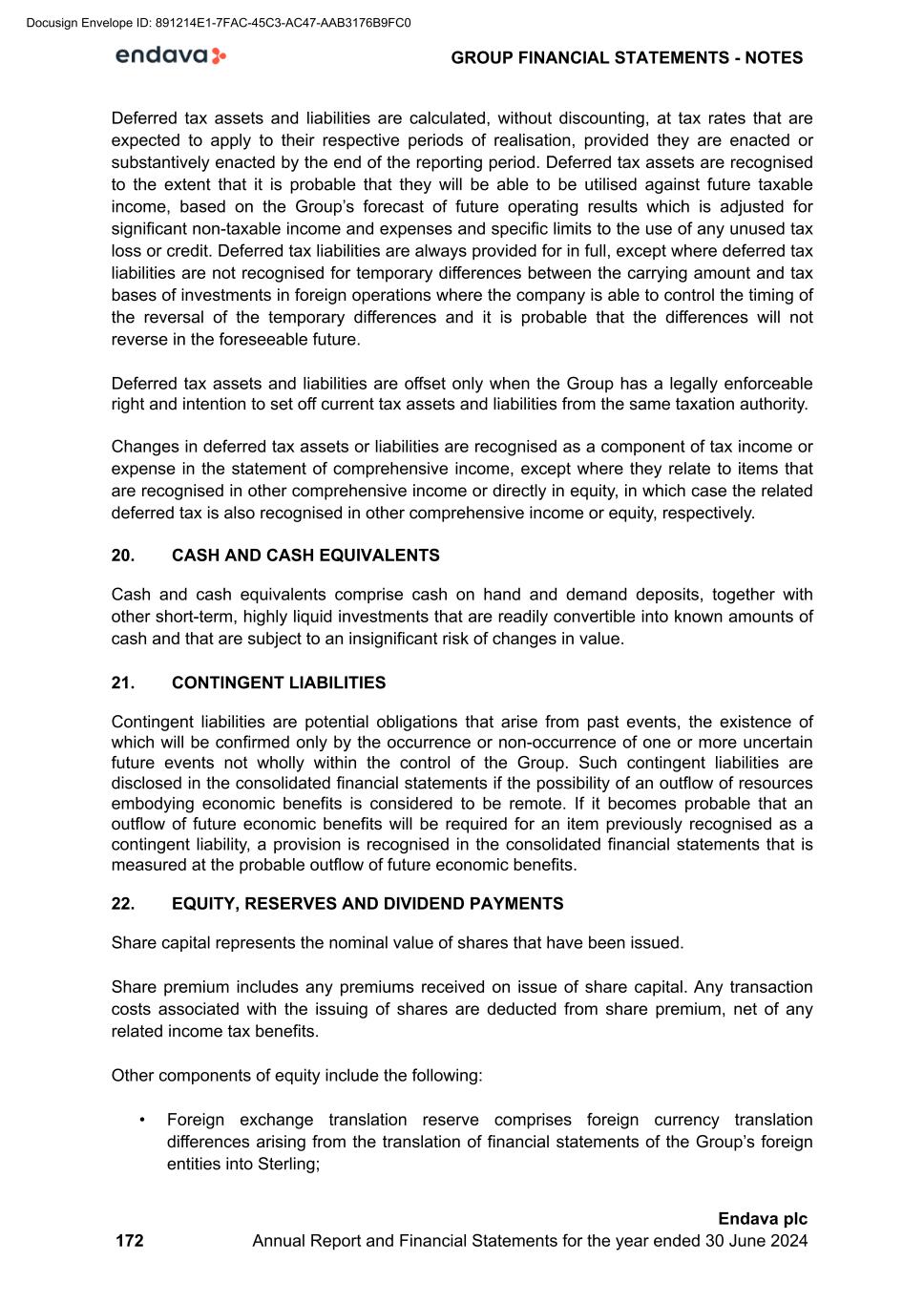
Deferred tax assets and liabilities are calculated, without discounting, at tax rates that are expected to apply to their respective periods of realisation, provided they are enacted or substantively enacted by the end of the reporting period. Deferred tax assets are recognised to the extent that it is probable that they will be able to be utilised against future taxable income, based on the Group’s forecast of future operating results which is adjusted for significant non-taxable income and expenses and specific limits to the use of any unused tax loss or credit. Deferred tax liabilities are always provided for in full, except where deferred tax liabilities are not recognised for temporary differences between the carrying amount and tax bases of investments in foreign operations where the company is able to control the timing of the reversal of the temporary differences and it is probable that the differences will not reverse in the foreseeable future. Deferred tax assets and liabilities are offset only when the Group has a legally enforceable right and intention to set off current tax assets and liabilities from the same taxation authority. Changes in deferred tax assets or liabilities are recognised as a component of tax income or expense in the statement of comprehensive income, except where they relate to items that are recognised in other comprehensive income or directly in equity, in which case the related deferred tax is also recognised in other comprehensive income or equity, respectively. 20. CASH AND CASH EQUIVALENTS Cash and cash equivalents comprise cash on hand and demand deposits, together with other short-term, highly liquid investments that are readily convertible into known amounts of cash and that are subject to an insignificant risk of changes in value. 21. CONTINGENT LIABILITIES Contingent liabilities are potential obligations that arise from past events, the existence of which will be confirmed only by the occurrence or non-occurrence of one or more uncertain future events not wholly within the control of the Group. Such contingent liabilities are disclosed in the consolidated financial statements if the possibility of an outflow of resources embodying economic benefits is considered to be remote. If it becomes probable that an outflow of future economic benefits will be required for an item previously recognised as a contingent liability, a provision is recognised in the consolidated financial statements that is measured at the probable outflow of future economic benefits. 22. EQUITY, RESERVES AND DIVIDEND PAYMENTS Share capital represents the nominal value of shares that have been issued. Share premium includes any premiums received on issue of share capital. Any transaction costs associated with the issuing of shares are deducted from share premium, net of any related income tax benefits. Other components of equity include the following: • Foreign exchange translation reserve comprises foreign currency translation differences arising from the translation of financial statements of the Group’s foreign entities into Sterling; GROUP FINANCIAL STATEMENTS - NOTES 172 Endava plc Annual Report and Financial Statements for the year ended 30 June 2024 Docusign Envelope ID: 891214E1-7FAC-45C3-AC47-AAB3176B9FC0
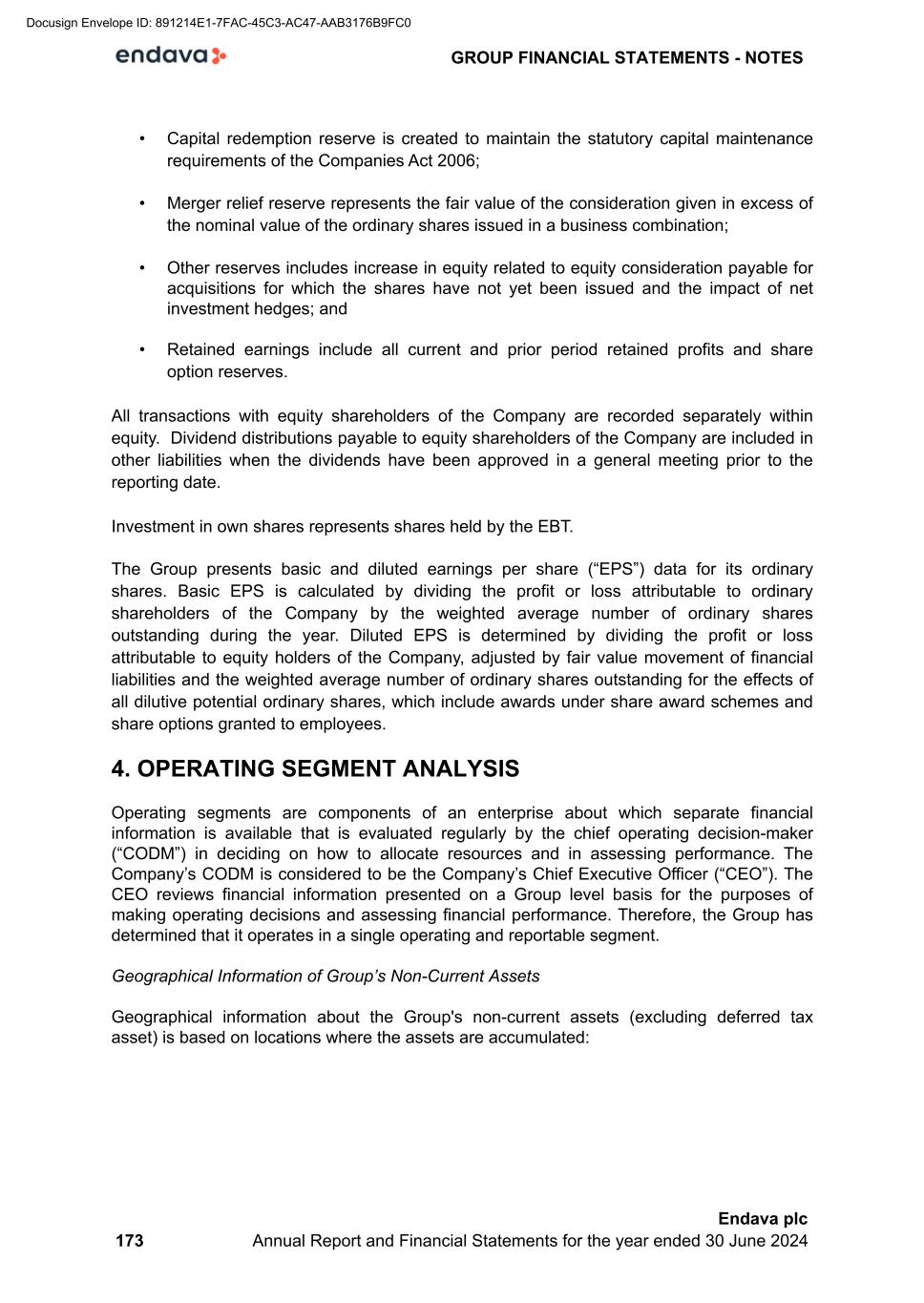
• Capital redemption reserve is created to maintain the statutory capital maintenance requirements of the Companies Act 2006; • Merger relief reserve represents the fair value of the consideration given in excess of the nominal value of the ordinary shares issued in a business combination; • Other reserves includes increase in equity related to equity consideration payable for acquisitions for which the shares have not yet been issued and the impact of net investment hedges; and • Retained earnings include all current and prior period retained profits and share option reserves. All transactions with equity shareholders of the Company are recorded separately within equity. Dividend distributions payable to equity shareholders of the Company are included in other liabilities when the dividends have been approved in a general meeting prior to the reporting date. Investment in own shares represents shares held by the EBT. The Group presents basic and diluted earnings per share (“EPS”) data for its ordinary shares. Basic EPS is calculated by dividing the profit or loss attributable to ordinary shareholders of the Company by the weighted average number of ordinary shares outstanding during the year. Diluted EPS is determined by dividing the profit or loss attributable to equity holders of the Company, adjusted by fair value movement of financial liabilities and the weighted average number of ordinary shares outstanding for the effects of all dilutive potential ordinary shares, which include awards under share award schemes and share options granted to employees. 4. OPERATING SEGMENT ANALYSIS Operating segments are components of an enterprise about which separate financial information is available that is evaluated regularly by the chief operating decision-maker (“CODM”) in deciding on how to allocate resources and in assessing performance. The Company’s CODM is considered to be the Company’s Chief Executive Officer (“CEO”). The CEO reviews financial information presented on a Group level basis for the purposes of making operating decisions and assessing financial performance. Therefore, the Group has determined that it operates in a single operating and reportable segment. Geographical Information of Group’s Non-Current Assets Geographical information about the Group's non-current assets (excluding deferred tax asset) is based on locations where the assets are accumulated: GROUP FINANCIAL STATEMENTS - NOTES 173 Endava plc Annual Report and Financial Statements for the year ended 30 June 2024 Docusign Envelope ID: 891214E1-7FAC-45C3-AC47-AAB3176B9FC0

2024 2023(2) £’000 £’000 United Kingdom 35,214 33,412 North America 231,911 66,621 Europe 162,933 169,126 RoW1 297,894 131,829 Total 727,952 400,988 1. Rest of World (RoW) 2. Restated to include the effect of revisions arising from provisional to final acquisition accounting for DEK and Mudbath (refer to note 3(3) for details). 5. REVENUE Set out below is the disaggregation of the Group’s revenue from contracts with customers by geographical market, based on where the services are delivered to clients: 2024 2023 £’000 £’000 United Kingdom 247,598 309,365 North America 241,652 258,112 Europe 191,206 182,551 RoW 60,300 44,705 Total 740,756 794,733 As at 30 June 2024 revenues generated from clients in the United States of America were £241.1 million (30 June 2023: £257.3 million) and they are included in the North American market. The Group's revenue by industry sector is as follows: 2024 2023 (1) £’000 £’000 Payments and Financial services 351,956 416,007 TMT 169,227 173,927 Other 219,573 204,799 Total 740,756 794,733 The Group's revenue by contract type is as follows: 2024 2023 £’000 £’000 Time and materials contracts 613,331 646,237 Fixed price contracts 127,425 148,496 Total 740,756 794,733 As at 30 June 2024, the undiscounted aggregate transaction value of revenue that has not been recognised relating to unsatisfied performance obligations was £149.2 million (2023: GROUP FINANCIAL STATEMENTS - NOTES 174 Endava plc Annual Report and Financial Statements for the year ended 30 June 2024 Docusign Envelope ID: 891214E1-7FAC-45C3-AC47-AAB3176B9FC0
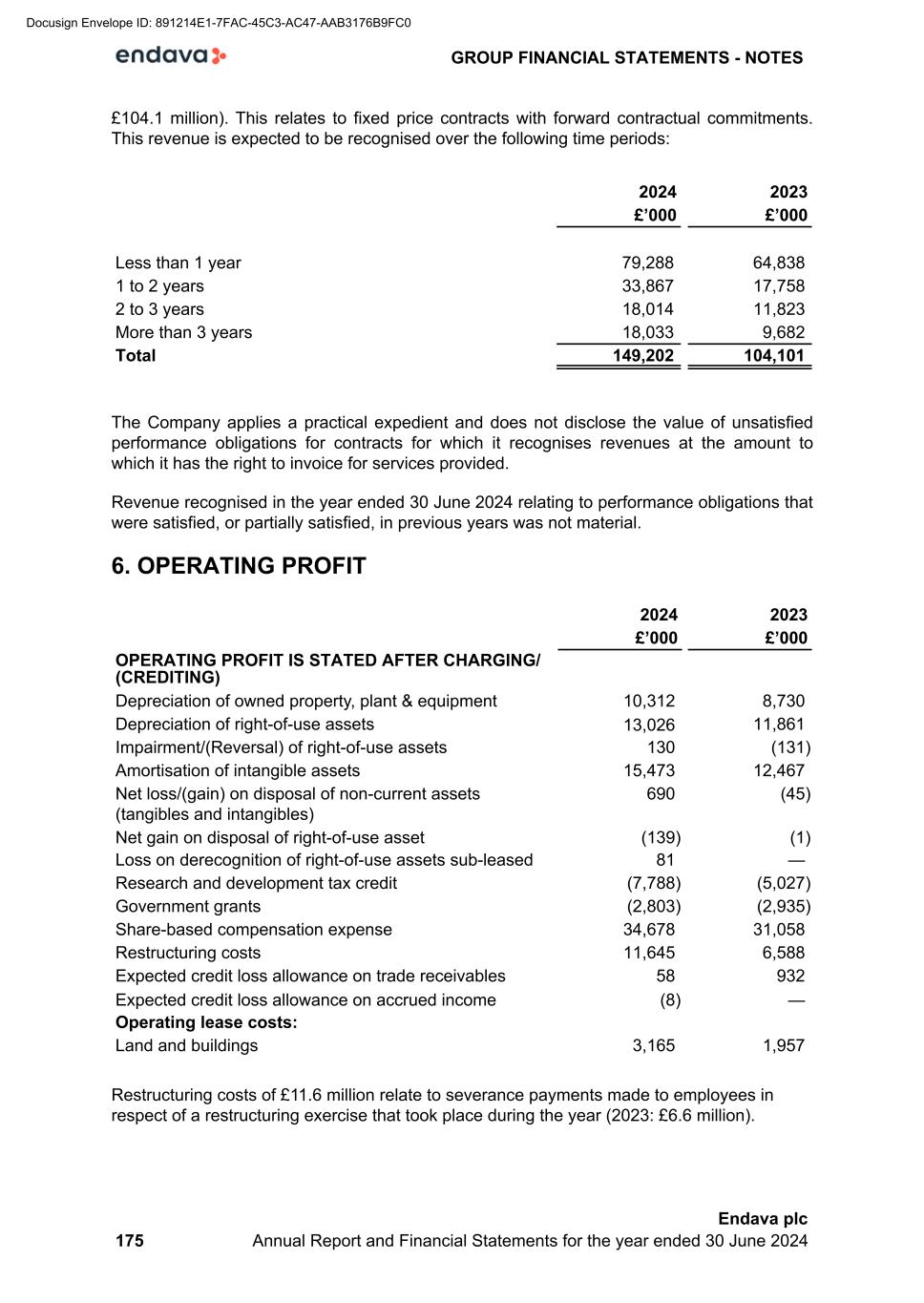
£104.1 million). This relates to fixed price contracts with forward contractual commitments. This revenue is expected to be recognised over the following time periods: 2024 2023 £’000 £’000 Less than 1 year 79,288 64,838 1 to 2 years 33,867 17,758 2 to 3 years 18,014 11,823 More than 3 years 18,033 9,682 Total 149,202 104,101 The Company applies a practical expedient and does not disclose the value of unsatisfied performance obligations for contracts for which it recognises revenues at the amount to which it has the right to invoice for services provided. Revenue recognised in the year ended 30 June 2024 relating to performance obligations that were satisfied, or partially satisfied, in previous years was not material. 6. OPERATING PROFIT 2024 2023 £’000 £’000 OPERATING PROFIT IS STATED AFTER CHARGING/ (CREDITING) Depreciation of owned property, plant & equipment 10,312 8,730 Depreciation of right-of-use assets 13,026 11,861 Impairment/(Reversal) of right-of-use assets 130 (131) Amortisation of intangible assets 15,473 12,467 Net loss/(gain) on disposal of non-current assets (tangibles and intangibles) 690 (45) Net gain on disposal of right-of-use asset (139) (1) Loss on derecognition of right-of-use assets sub-leased 81 — Research and development tax credit (7,788) (5,027) Government grants (2,803) (2,935) Share-based compensation expense 34,678 31,058 Restructuring costs 11,645 6,588 Expected credit loss allowance on trade receivables 58 932 Expected credit loss allowance on accrued income (8) — Operating lease costs: Land and buildings 3,165 1,957 Restructuring costs of £11.6 million relate to severance payments made to employees in respect of a restructuring exercise that took place during the year (2023: £6.6 million). GROUP FINANCIAL STATEMENTS - NOTES 175 Endava plc Annual Report and Financial Statements for the year ended 30 June 2024 Docusign Envelope ID: 891214E1-7FAC-45C3-AC47-AAB3176B9FC0
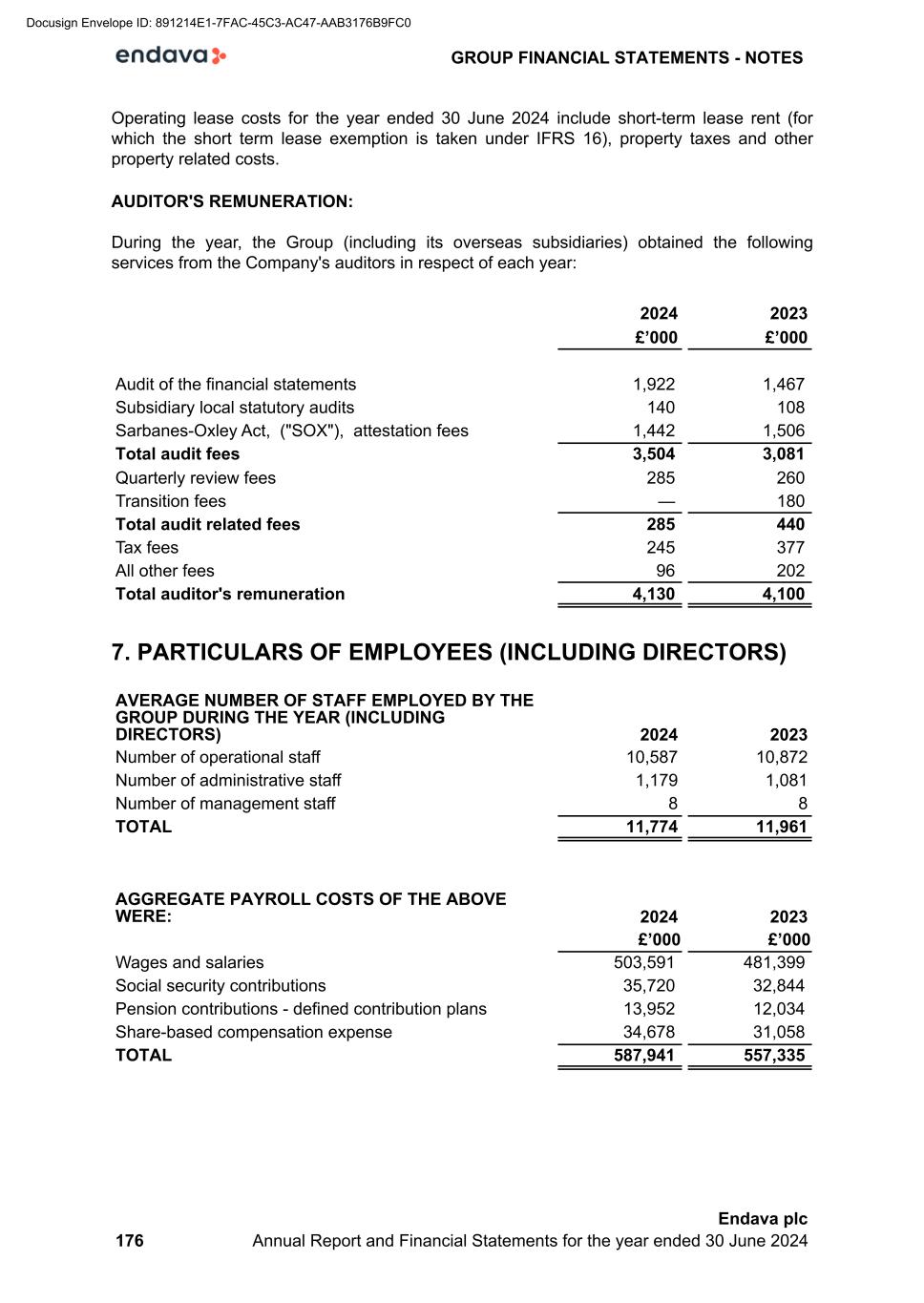
Operating lease costs for the year ended 30 June 2024 include short-term lease rent (for which the short term lease exemption is taken under IFRS 16), property taxes and other property related costs. AUDITOR'S REMUNERATION: During the year, the Group (including its overseas subsidiaries) obtained the following services from the Company's auditors in respect of each year: 2024 2023 £’000 £’000 Audit of the financial statements 1,922 1,467 Subsidiary local statutory audits 140 108 Sarbanes-Oxley Act, ("SOX"), attestation fees 1,442 1,506 Total audit fees 3,504 3,081 Quarterly review fees 285 260 Transition fees — 180 Total audit related fees 285 440 Tax fees 245 377 All other fees 96 202 Total auditor's remuneration 4,130 4,100 7. PARTICULARS OF EMPLOYEES (INCLUDING DIRECTORS) AVERAGE NUMBER OF STAFF EMPLOYED BY THE GROUP DURING THE YEAR (INCLUDING DIRECTORS) 2024 2023 Number of operational staff 10,587 10,872 Number of administrative staff 1,179 1,081 Number of management staff 8 8 TOTAL 11,774 11,961 AGGREGATE PAYROLL COSTS OF THE ABOVE WERE: 2024 2023 £’000 £’000 Wages and salaries 503,591 481,399 Social security contributions 35,720 32,844 Pension contributions - defined contribution plans 13,952 12,034 Share-based compensation expense 34,678 31,058 TOTAL 587,941 557,335 GROUP FINANCIAL STATEMENTS - NOTES 176 Endava plc Annual Report and Financial Statements for the year ended 30 June 2024 Docusign Envelope ID: 891214E1-7FAC-45C3-AC47-AAB3176B9FC0
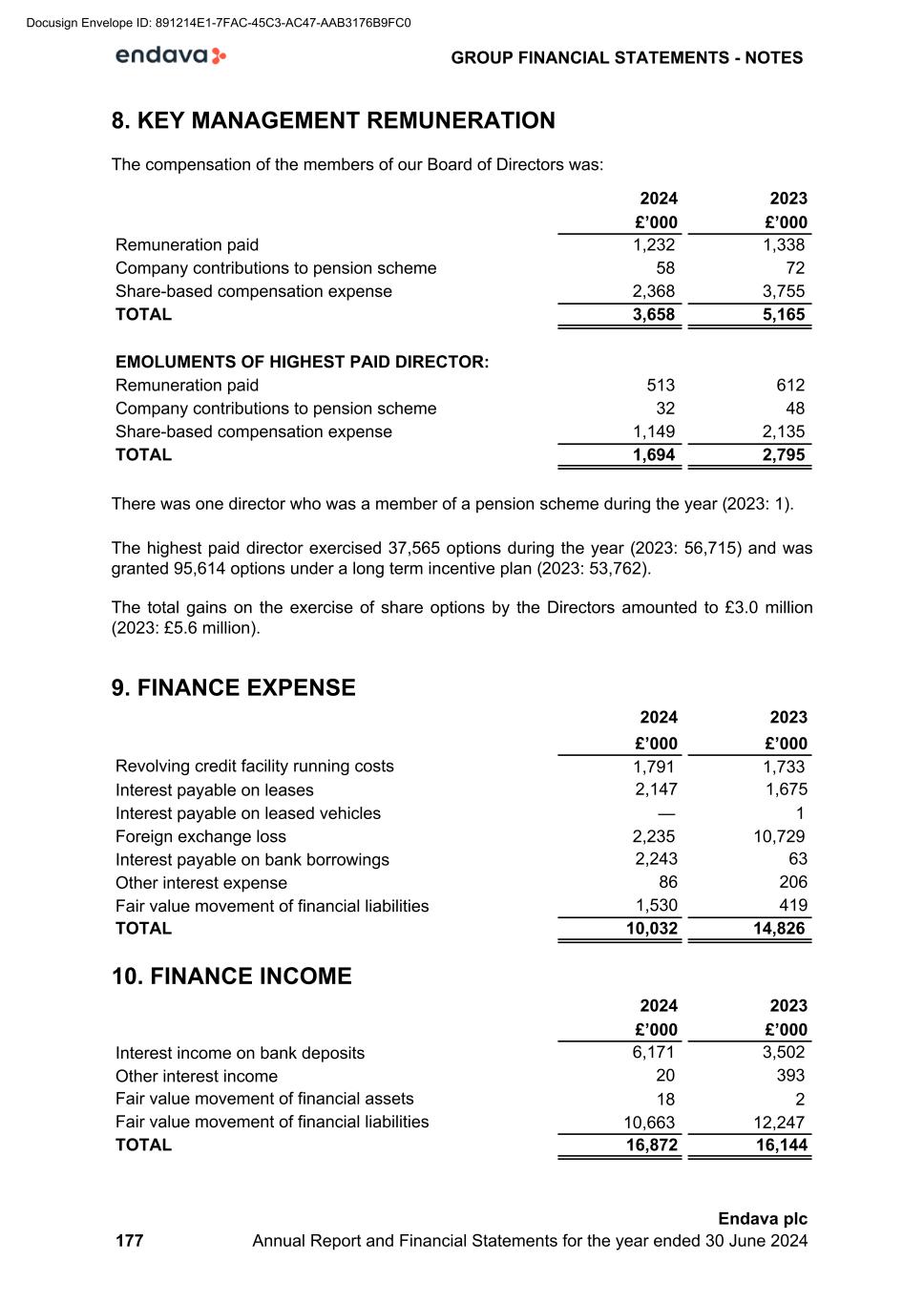
8. KEY MANAGEMENT REMUNERATION The compensation of the members of our Board of Directors was: 2024 2023 £’000 £’000 Remuneration paid 1,232 1,338 Company contributions to pension scheme 58 72 Share-based compensation expense 2,368 3,755 TOTAL 3,658 5,165 EMOLUMENTS OF HIGHEST PAID DIRECTOR: Remuneration paid 513 612 Company contributions to pension scheme 32 48 Share-based compensation expense 1,149 2,135 TOTAL 1,694 2,795 There was one director who was a member of a pension scheme during the year (2023: 1). The highest paid director exercised 37,565 options during the year (2023: 56,715) and was granted 95,614 options under a long term incentive plan (2023: 53,762). The total gains on the exercise of share options by the Directors amounted to £3.0 million (2023: £5.6 million). 9. FINANCE EXPENSE 2024 2023 £’000 £’000 Revolving credit facility running costs 1,791 1,733 Interest payable on leases 2,147 1,675 Interest payable on leased vehicles — 1 Foreign exchange loss 2,235 10,729 Interest payable on bank borrowings 2,243 63 Other interest expense 86 206 Fair value movement of financial liabilities 1,530 419 TOTAL 10,032 14,826 10. FINANCE INCOME 2024 2023 £’000 £’000 Interest income on bank deposits 6,171 3,502 Other interest income 20 393 Fair value movement of financial assets 18 2 Fair value movement of financial liabilities 10,663 12,247 TOTAL 16,872 16,144 GROUP FINANCIAL STATEMENTS - NOTES 177 Endava plc Annual Report and Financial Statements for the year ended 30 June 2024 Docusign Envelope ID: 891214E1-7FAC-45C3-AC47-AAB3176B9FC0
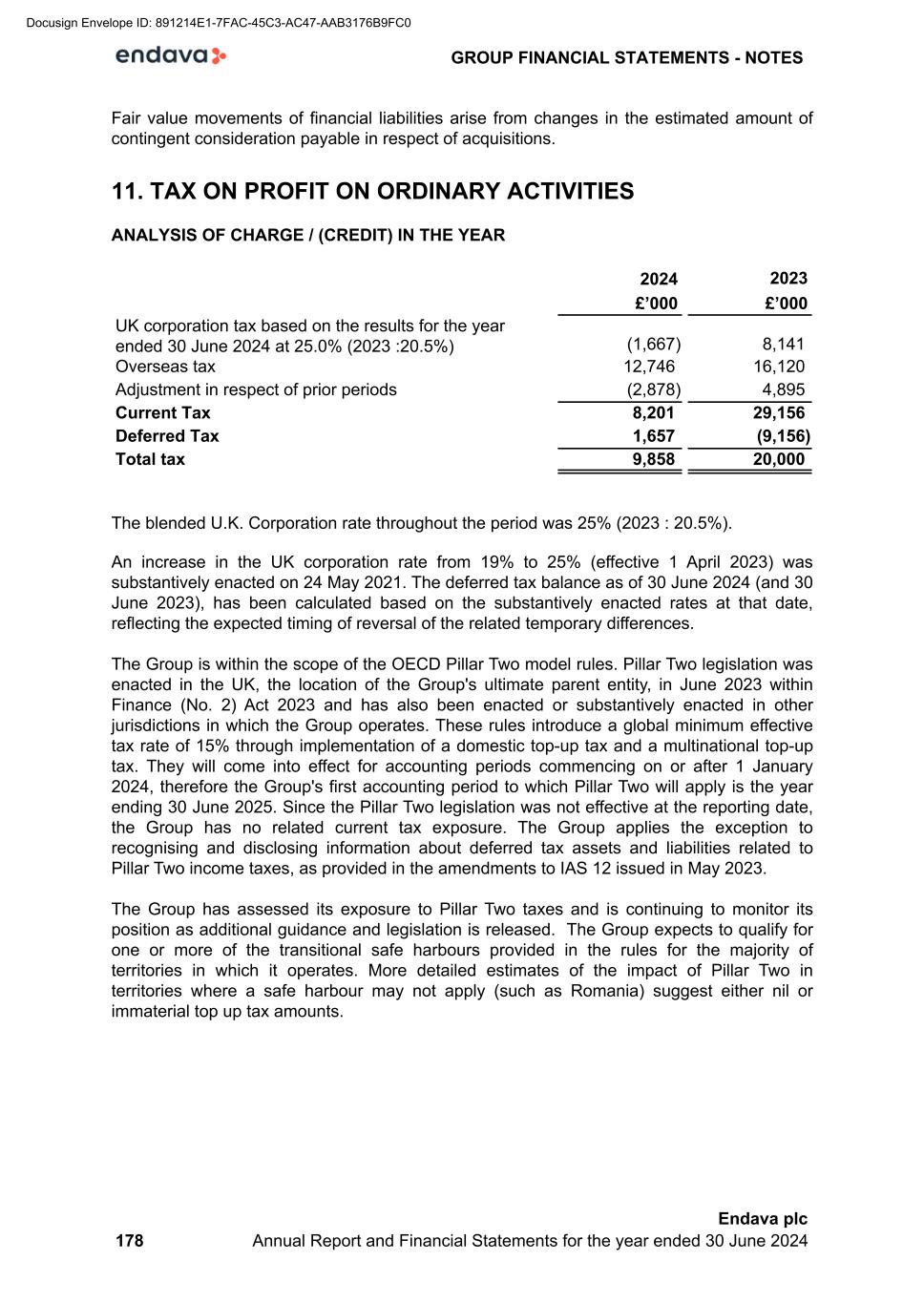
Fair value movements of financial liabilities arise from changes in the estimated amount of contingent consideration payable in respect of acquisitions. 11. TAX ON PROFIT ON ORDINARY ACTIVITIES ANALYSIS OF CHARGE / (CREDIT) IN THE YEAR 2024 2023 £’000 £’000 UK corporation tax based on the results for the year ended 30 June 2024 at 25.0% (2023 :20.5%) (1,667) 8,141 Overseas tax 12,746 16,120 Adjustment in respect of prior periods (2,878) 4,895 Current Tax 8,201 29,156 Deferred Tax 1,657 (9,156) Total tax 9,858 20,000 The blended U.K. Corporation rate throughout the period was 25% (2023 : 20.5%). An increase in the UK corporation rate from 19% to 25% (effective 1 April 2023) was substantively enacted on 24 May 2021. The deferred tax balance as of 30 June 2024 (and 30 June 2023), has been calculated based on the substantively enacted rates at that date, reflecting the expected timing of reversal of the related temporary differences. The Group is within the scope of the OECD Pillar Two model rules. Pillar Two legislation was enacted in the UK, the location of the Group's ultimate parent entity, in June 2023 within Finance (No. 2) Act 2023 and has also been enacted or substantively enacted in other jurisdictions in which the Group operates. These rules introduce a global minimum effective tax rate of 15% through implementation of a domestic top-up tax and a multinational top-up tax. They will come into effect for accounting periods commencing on or after 1 January 2024, therefore the Group's first accounting period to which Pillar Two will apply is the year ending 30 June 2025. Since the Pillar Two legislation was not effective at the reporting date, the Group has no related current tax exposure. The Group applies the exception to recognising and disclosing information about deferred tax assets and liabilities related to Pillar Two income taxes, as provided in the amendments to IAS 12 issued in May 2023. The Group has assessed its exposure to Pillar Two taxes and is continuing to monitor its position as additional guidance and legislation is released. The Group expects to qualify for one or more of the transitional safe harbours provided in the rules for the majority of territories in which it operates. More detailed estimates of the impact of Pillar Two in territories where a safe harbour may not apply (such as Romania) suggest either nil or immaterial top up tax amounts. GROUP FINANCIAL STATEMENTS - NOTES 178 Endava plc Annual Report and Financial Statements for the year ended 30 June 2024 Docusign Envelope ID: 891214E1-7FAC-45C3-AC47-AAB3176B9FC0

RECONCILIATION OF THE TAX RATE ON GROUP PROFITS 2024 2023 £’000 % £’000 % Profit on ordinary activities before taxation 26,980 114,163 Profit on ordinary activities at UK statutory rate 6,745 25.0 % 23,403 20.5 % Differences in overseas tax rates (5,094) (18.9) % (267) (0.2) % Impact of share-based compensation 4,182 15.5 % 1,390 1.2 % Non taxable fair value movement on financial (2,338) (8.7) % (2,430) (2.1) % Tax incentives and non deductible items (663) (2.5) % (867) (0.8) % Adjustments related to prior periods 2,760 10.2 % (354) (0.3) % Tax on unremitted earnings/Withholding tax on dividends 2,373 8.8 % 1,209 1.1 % Impact of rate change on deferred tax 1,893 7.0 % (2,084) (1.8) % Total 9,858 36.5 % 20,000 17.5 % The tax incentives and non deductible items of £0.7 million as at 30 June 2024 (30 June 2023: £0.9 million) are mainly related to tax credits and incentives net of certain expenses that are not expected to be tax deductible in any jurisdiction. During the current year, management made a decision to utilise brought forward UK tax losses in earlier periods. This increases the tax charge by £1.9 million as at 30 June 2024 (30 June 2023: decreases the charge by £2.1 million) due to the impact of the different corporation tax rates between years, and results in offsetting prior year adjustments to current and deferred tax (reflecting the utilisation of a deferred tax asset and a reduction of prior year current tax liabilities). The net prior year adjustment expense of £2.8 million as at 30 June 2024 (30 June 2023: £0.4 million credit) shown above relates to separate true-up adjustments on finalisation of the tax return for the year ended 30 June 2023 during the year. TAX ON ITEMS CHARGED TO EQUITY 2024 2023 £’000 £’000 Deferred tax - share-based compensation 368 3,919 Current tax - share-based compensation (311) (2,318) Total charge/(credit) to equity 57 1,601 UNREMITTED EARNINGS The aggregate amount of unremitted profits at 30 June 2024 was approximately £341.0 million (2023 - £158.0 million). The movement during the year reflects profits made in various territories outside of the United Kingdom, unremitted profits of acquired companies and repatriation of such profits through various dividend payments to the UK. UK legislation relating to company distributions provides for exemption from tax for most repatriated profits. Deferred taxation of £9.4 million has been provided on these profits as at 30 June 2024 (2023 - £4.0 million). No deferred tax liability has been provided on £8.2 million of these profits at 30 June 2024 (2023 - £10.1 million) as the group is able to control the timing of distributions from these subsidiaries and is not expected to distribute these profits in the foreseeable future. GROUP FINANCIAL STATEMENTS - NOTES 179 Endava plc Annual Report and Financial Statements for the year ended 30 June 2024 Docusign Envelope ID: 891214E1-7FAC-45C3-AC47-AAB3176B9FC0
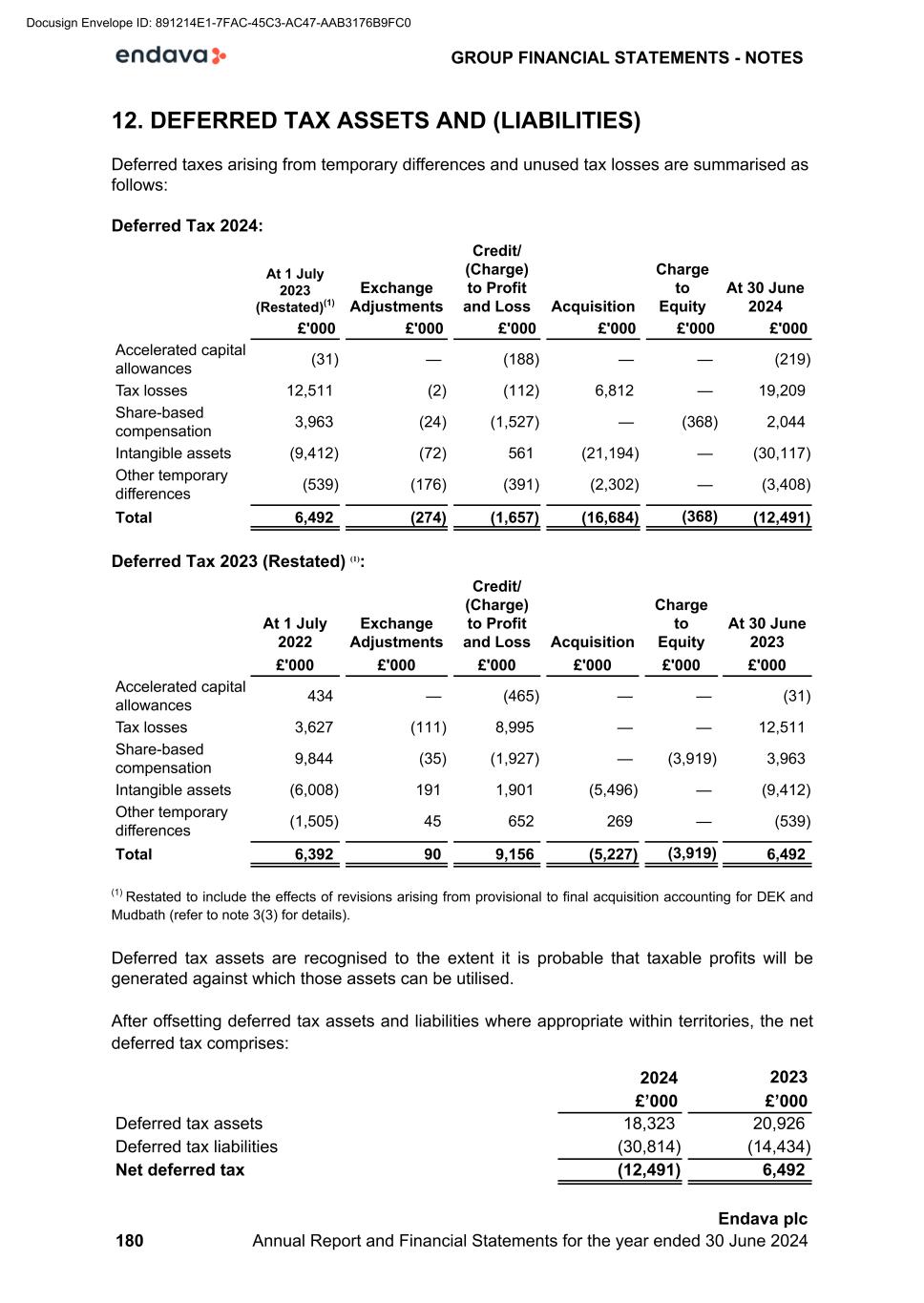
12. DEFERRED TAX ASSETS AND (LIABILITIES) Deferred taxes arising from temporary differences and unused tax losses are summarised as follows: Deferred Tax 2024: At 1 July 2023 (Restated)(1) Exchange Adjustments Credit/ (Charge) to Profit and Loss Acquisition Charge to Equity At 30 June 2024 £'000 £'000 £'000 £'000 £'000 £'000 Accelerated capital allowances (31) — (188) — — (219) Tax losses 12,511 (2) (112) 6,812 — 19,209 Share-based compensation 3,963 (24) (1,527) — (368) 2,044 Intangible assets (9,412) (72) 561 (21,194) — (30,117) Other temporary differences (539) (176) (391) (2,302) — (3,408) Total 6,492 (274) (1,657) (16,684) (368) (12,491) Deferred Tax 2023 (Restated) (1): At 1 July 2022 Exchange Adjustments Credit/ (Charge) to Profit and Loss Acquisition Charge to Equity At 30 June 2023 £'000 £'000 £'000 £'000 £'000 £'000 Accelerated capital allowances 434 — (465) — — (31) Tax losses 3,627 (111) 8,995 — — 12,511 Share-based compensation 9,844 (35) (1,927) — (3,919) 3,963 Intangible assets (6,008) 191 1,901 (5,496) — (9,412) Other temporary differences (1,505) 45 652 269 — (539) Total 6,392 90 9,156 (5,227) (3,919) 6,492 (1) Restated to include the effects of revisions arising from provisional to final acquisition accounting for DEK and Mudbath (refer to note 3(3) for details). Deferred tax assets are recognised to the extent it is probable that taxable profits will be generated against which those assets can be utilised. After offsetting deferred tax assets and liabilities where appropriate within territories, the net deferred tax comprises: 2024 2023 £’000 £’000 Deferred tax assets 18,323 20,926 Deferred tax liabilities (30,814) (14,434) Net deferred tax (12,491) 6,492 GROUP FINANCIAL STATEMENTS - NOTES 180 Endava plc Annual Report and Financial Statements for the year ended 30 June 2024 Docusign Envelope ID: 891214E1-7FAC-45C3-AC47-AAB3176B9FC0
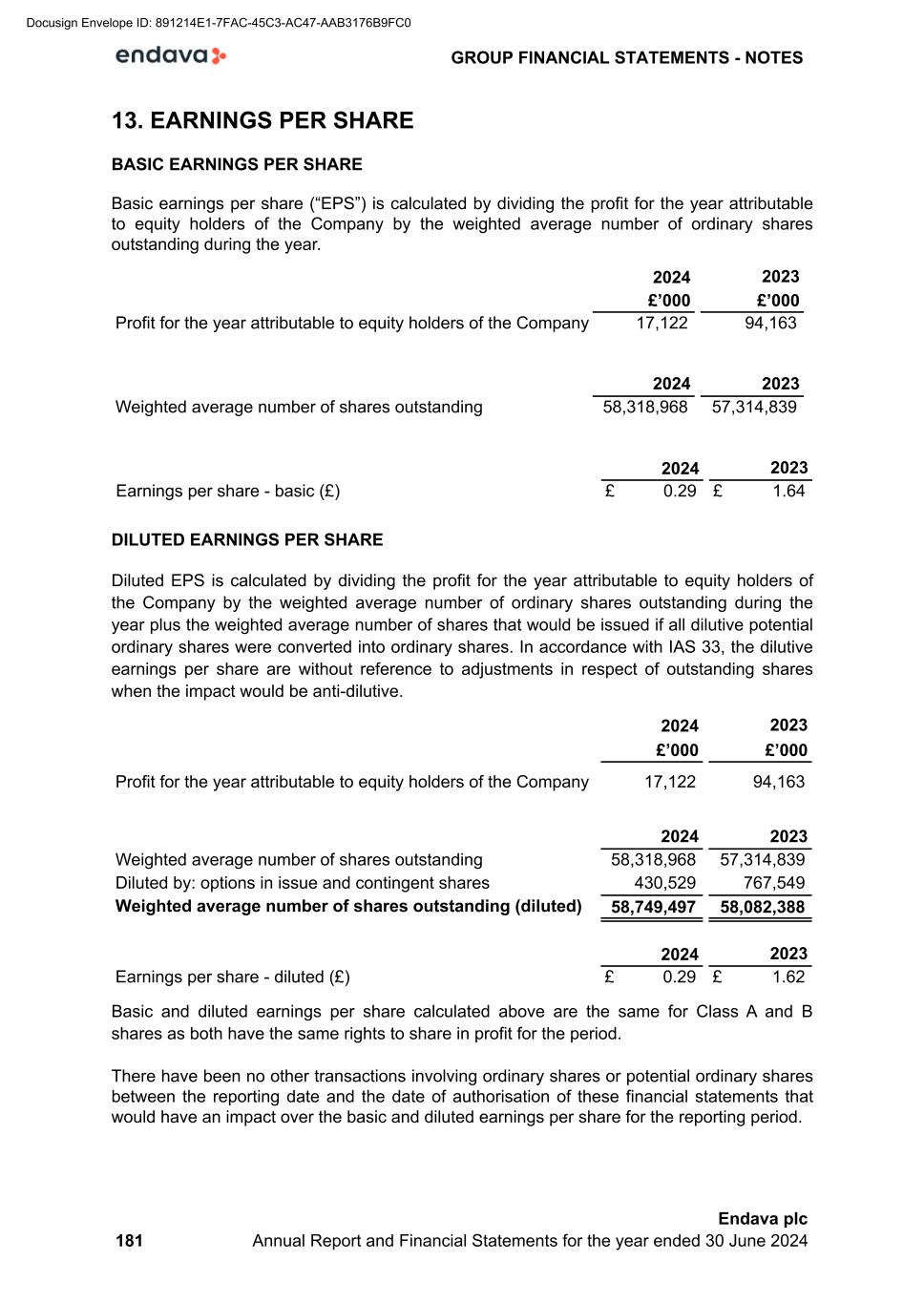
13. EARNINGS PER SHARE BASIC EARNINGS PER SHARE Basic earnings per share (“EPS”) is calculated by dividing the profit for the year attributable to equity holders of the Company by the weighted average number of ordinary shares outstanding during the year. 2024 2023 £’000 £’000 Profit for the year attributable to equity holders of the Company 17,122 94,163 2024 2023 Weighted average number of shares outstanding 58,318,968 57,314,839 2024 2023 Earnings per share - basic (£) £ 0.29 £ 1.64 DILUTED EARNINGS PER SHARE Diluted EPS is calculated by dividing the profit for the year attributable to equity holders of the Company by the weighted average number of ordinary shares outstanding during the year plus the weighted average number of shares that would be issued if all dilutive potential ordinary shares were converted into ordinary shares. In accordance with IAS 33, the dilutive earnings per share are without reference to adjustments in respect of outstanding shares when the impact would be anti-dilutive. 2024 2023 £’000 £’000 Profit for the year attributable to equity holders of the Company 17,122 94,163 2024 2023 Weighted average number of shares outstanding 58,318,968 57,314,839 Diluted by: options in issue and contingent shares 430,529 767,549 Weighted average number of shares outstanding (diluted) 58,749,497 58,082,388 2024 2023 Earnings per share - diluted (£) £ 0.29 £ 1.62 Basic and diluted earnings per share calculated above are the same for Class A and B shares as both have the same rights to share in profit for the period. There have been no other transactions involving ordinary shares or potential ordinary shares between the reporting date and the date of authorisation of these financial statements that would have an impact over the basic and diluted earnings per share for the reporting period. GROUP FINANCIAL STATEMENTS - NOTES 181 Endava plc Annual Report and Financial Statements for the year ended 30 June 2024 Docusign Envelope ID: 891214E1-7FAC-45C3-AC47-AAB3176B9FC0
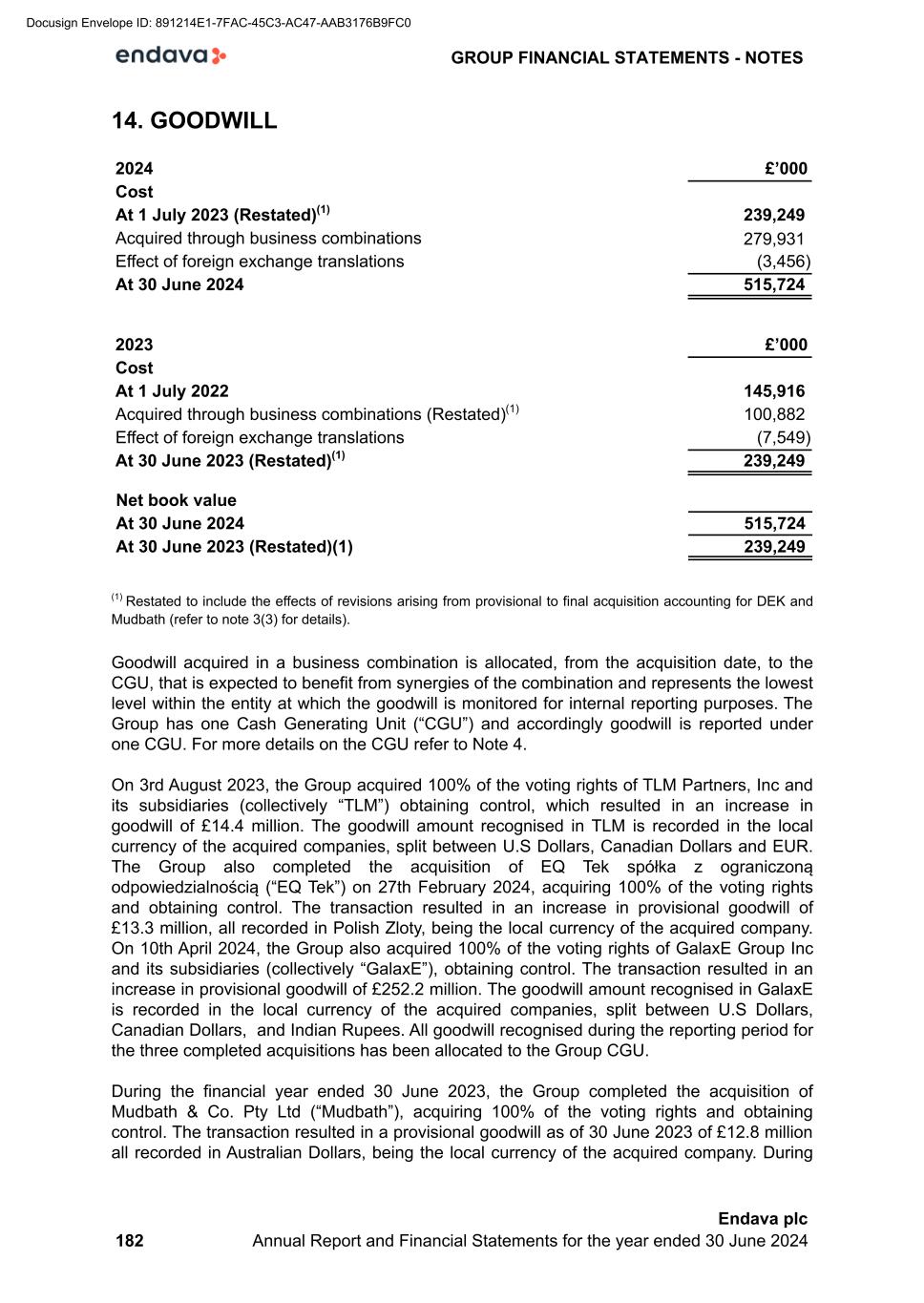
14. GOODWILL 2024 £’000 Cost At 1 July 2023 (Restated)(1) 239,249 Acquired through business combinations 279,931 Effect of foreign exchange translations (3,456) At 30 June 2024 515,724 2023 £’000 Cost At 1 July 2022 145,916 Acquired through business combinations (Restated)(1) 100,882 Effect of foreign exchange translations (7,549) At 30 June 2023 (Restated)(1) 239,249 Net book value At 30 June 2024 515,724 At 30 June 2023 (Restated)(1) 239,249 (1) Restated to include the effects of revisions arising from provisional to final acquisition accounting for DEK and Mudbath (refer to note 3(3) for details). Goodwill acquired in a business combination is allocated, from the acquisition date, to the CGU, that is expected to benefit from synergies of the combination and represents the lowest level within the entity at which the goodwill is monitored for internal reporting purposes. The Group has one Cash Generating Unit (“CGU”) and accordingly goodwill is reported under one CGU. For more details on the CGU refer to Note 4. On 3rd August 2023, the Group acquired 100% of the voting rights of TLM Partners, Inc and its subsidiaries (collectively “TLM”) obtaining control, which resulted in an increase in goodwill of £14.4 million. The goodwill amount recognised in TLM is recorded in the local currency of the acquired companies, split between U.S Dollars, Canadian Dollars and EUR. The Group also completed the acquisition of EQ Tek spółka z ograniczoną odpowiedzialnością (“EQ Tek”) on 27th February 2024, acquiring 100% of the voting rights and obtaining control. The transaction resulted in an increase in provisional goodwill of £13.3 million, all recorded in Polish Zloty, being the local currency of the acquired company. On 10th April 2024, the Group also acquired 100% of the voting rights of GalaxE Group Inc and its subsidiaries (collectively “GalaxE”), obtaining control. The transaction resulted in an increase in provisional goodwill of £252.2 million. The goodwill amount recognised in GalaxE is recorded in the local currency of the acquired companies, split between U.S Dollars, Canadian Dollars, and Indian Rupees. All goodwill recognised during the reporting period for the three completed acquisitions has been allocated to the Group CGU. During the financial year ended 30 June 2023, the Group completed the acquisition of Mudbath & Co. Pty Ltd (“Mudbath”), acquiring 100% of the voting rights and obtaining control. The transaction resulted in a provisional goodwill as of 30 June 2023 of £12.8 million all recorded in Australian Dollars, being the local currency of the acquired company. During GROUP FINANCIAL STATEMENTS - NOTES 182 Endava plc Annual Report and Financial Statements for the year ended 30 June 2024 Docusign Envelope ID: 891214E1-7FAC-45C3-AC47-AAB3176B9FC0
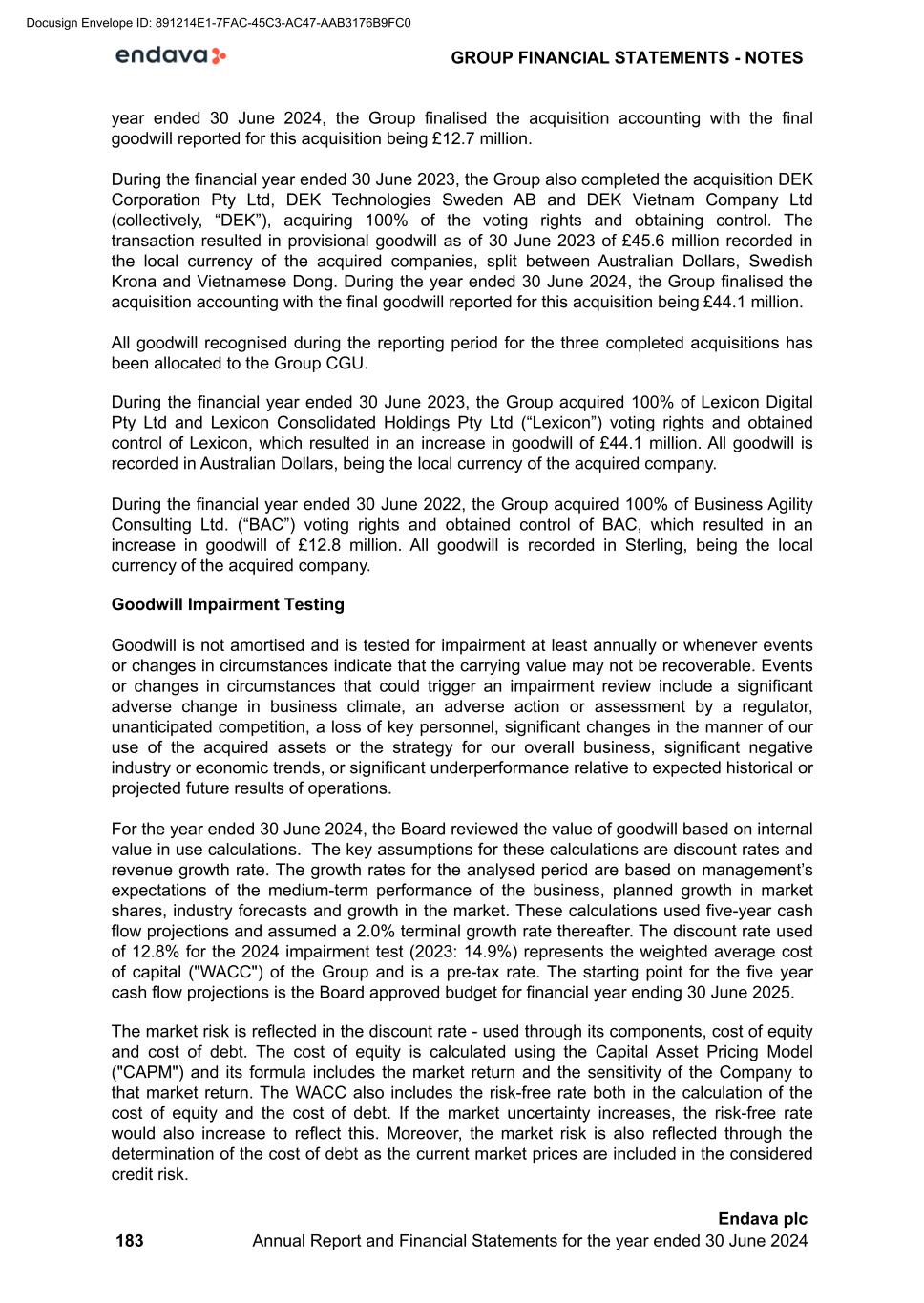
year ended 30 June 2024, the Group finalised the acquisition accounting with the final goodwill reported for this acquisition being £12.7 million. During the financial year ended 30 June 2023, the Group also completed the acquisition DEK Corporation Pty Ltd, DEK Technologies Sweden AB and DEK Vietnam Company Ltd (collectively, “DEK”), acquiring 100% of the voting rights and obtaining control. The transaction resulted in provisional goodwill as of 30 June 2023 of £45.6 million recorded in the local currency of the acquired companies, split between Australian Dollars, Swedish Krona and Vietnamese Dong. During the year ended 30 June 2024, the Group finalised the acquisition accounting with the final goodwill reported for this acquisition being £44.1 million. All goodwill recognised during the reporting period for the three completed acquisitions has been allocated to the Group CGU. During the financial year ended 30 June 2023, the Group acquired 100% of Lexicon Digital Pty Ltd and Lexicon Consolidated Holdings Pty Ltd (“Lexicon”) voting rights and obtained control of Lexicon, which resulted in an increase in goodwill of £44.1 million. All goodwill is recorded in Australian Dollars, being the local currency of the acquired company. During the financial year ended 30 June 2022, the Group acquired 100% of Business Agility Consulting Ltd. (“BAC”) voting rights and obtained control of BAC, which resulted in an increase in goodwill of £12.8 million. All goodwill is recorded in Sterling, being the local currency of the acquired company. Goodwill Impairment Testing Goodwill is not amortised and is tested for impairment at least annually or whenever events or changes in circumstances indicate that the carrying value may not be recoverable. Events or changes in circumstances that could trigger an impairment review include a significant adverse change in business climate, an adverse action or assessment by a regulator, unanticipated competition, a loss of key personnel, significant changes in the manner of our use of the acquired assets or the strategy for our overall business, significant negative industry or economic trends, or significant underperformance relative to expected historical or projected future results of operations. For the year ended 30 June 2024, the Board reviewed the value of goodwill based on internal value in use calculations. The key assumptions for these calculations are discount rates and revenue growth rate. The growth rates for the analysed period are based on management’s expectations of the medium-term performance of the business, planned growth in market shares, industry forecasts and growth in the market. These calculations used five-year cash flow projections and assumed a 2.0% terminal growth rate thereafter. The discount rate used of 12.8% for the 2024 impairment test (2023: 14.9%) represents the weighted average cost of capital ("WACC") of the Group and is a pre-tax rate. The starting point for the five year cash flow projections is the Board approved budget for financial year ending 30 June 2025. The market risk is reflected in the discount rate - used through its components, cost of equity and cost of debt. The cost of equity is calculated using the Capital Asset Pricing Model ("CAPM") and its formula includes the market return and the sensitivity of the Company to that market return. The WACC also includes the risk-free rate both in the calculation of the cost of equity and the cost of debt. If the market uncertainty increases, the risk-free rate would also increase to reflect this. Moreover, the market risk is also reflected through the determination of the cost of debt as the current market prices are included in the considered credit risk. GROUP FINANCIAL STATEMENTS - NOTES 183 Endava plc Annual Report and Financial Statements for the year ended 30 June 2024 Docusign Envelope ID: 891214E1-7FAC-45C3-AC47-AAB3176B9FC0
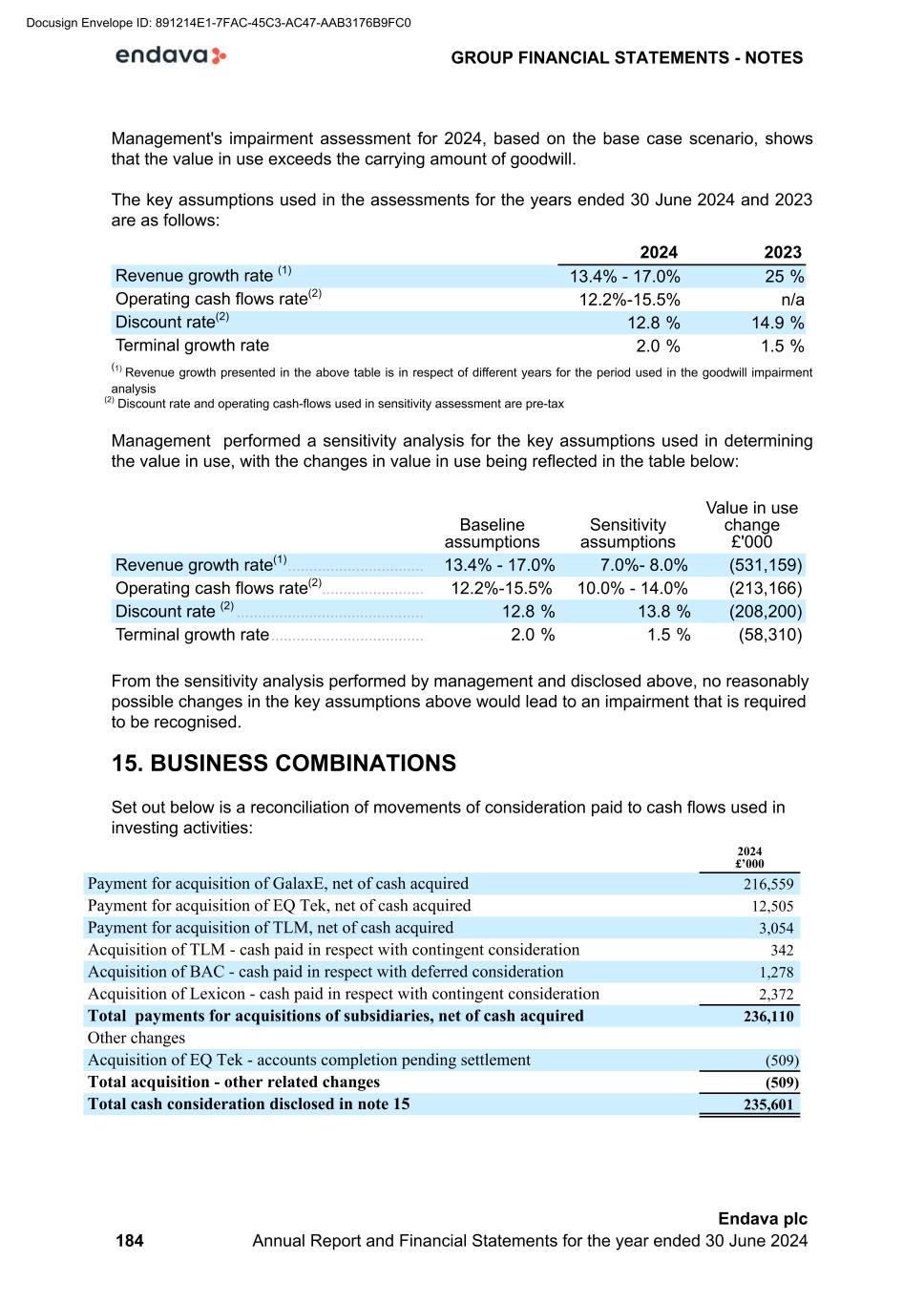
Management's impairment assessment for 2024, based on the base case scenario, shows that the value in use exceeds the carrying amount of goodwill. The key assumptions used in the assessments for the years ended 30 June 2024 and 2023 are as follows: 2024 2023 Revenue growth rate (1) 13.4% - 17.0% 25 % Operating cash flows rate(2) 12.2%-15.5% n/a Discount rate(2) 12.8 % 14.9 % Terminal growth rate 2.0 % 1.5 % (1) Revenue growth presented in the above table is in respect of different years for the period used in the goodwill impairment analysis (2) Discount rate and operating cash-flows used in sensitivity assessment are pre-tax Management performed a sensitivity analysis for the key assumptions used in determining the value in use, with the changes in value in use being reflected in the table below: Baseline assumptions Sensitivity assumptions Value in use change £'000 Revenue growth rate(1) ................................ 13.4% - 17.0% 7.0%- 8.0% (531,159) Operating cash flows rate(2) ........................ 12.2%-15.5% 10.0% - 14.0% (213,166) Discount rate (2) ............................................ 12.8 % 13.8 % (208,200) Terminal growth rate .................................... 2.0 % 1.5 % (58,310) From the sensitivity analysis performed by management and disclosed above, no reasonably possible changes in the key assumptions above would lead to an impairment that is required to be recognised. 15. BUSINESS COMBINATIONS Set out below is a reconciliation of movements of consideration paid to cash flows used in investing activities: 2024 £’000 Payment for acquisition of GalaxE, net of cash acquired 216,559 Payment for acquisition of EQ Tek, net of cash acquired 12,505 Payment for acquisition of TLM, net of cash acquired 3,054 Acquisition of TLM - cash paid in respect with contingent consideration 342 Acquisition of BAC - cash paid in respect with deferred consideration 1,278 Acquisition of Lexicon - cash paid in respect with contingent consideration 2,372 Total payments for acquisitions of subsidiaries, net of cash acquired 236,110 Other changes Acquisition of EQ Tek - accounts completion pending settlement (509) Total acquisition - other related changes (509) Total cash consideration disclosed in note 15 235,601 GROUP FINANCIAL STATEMENTS - NOTES 184 Endava plc Annual Report and Financial Statements for the year ended 30 June 2024 Docusign Envelope ID: 891214E1-7FAC-45C3-AC47-AAB3176B9FC0
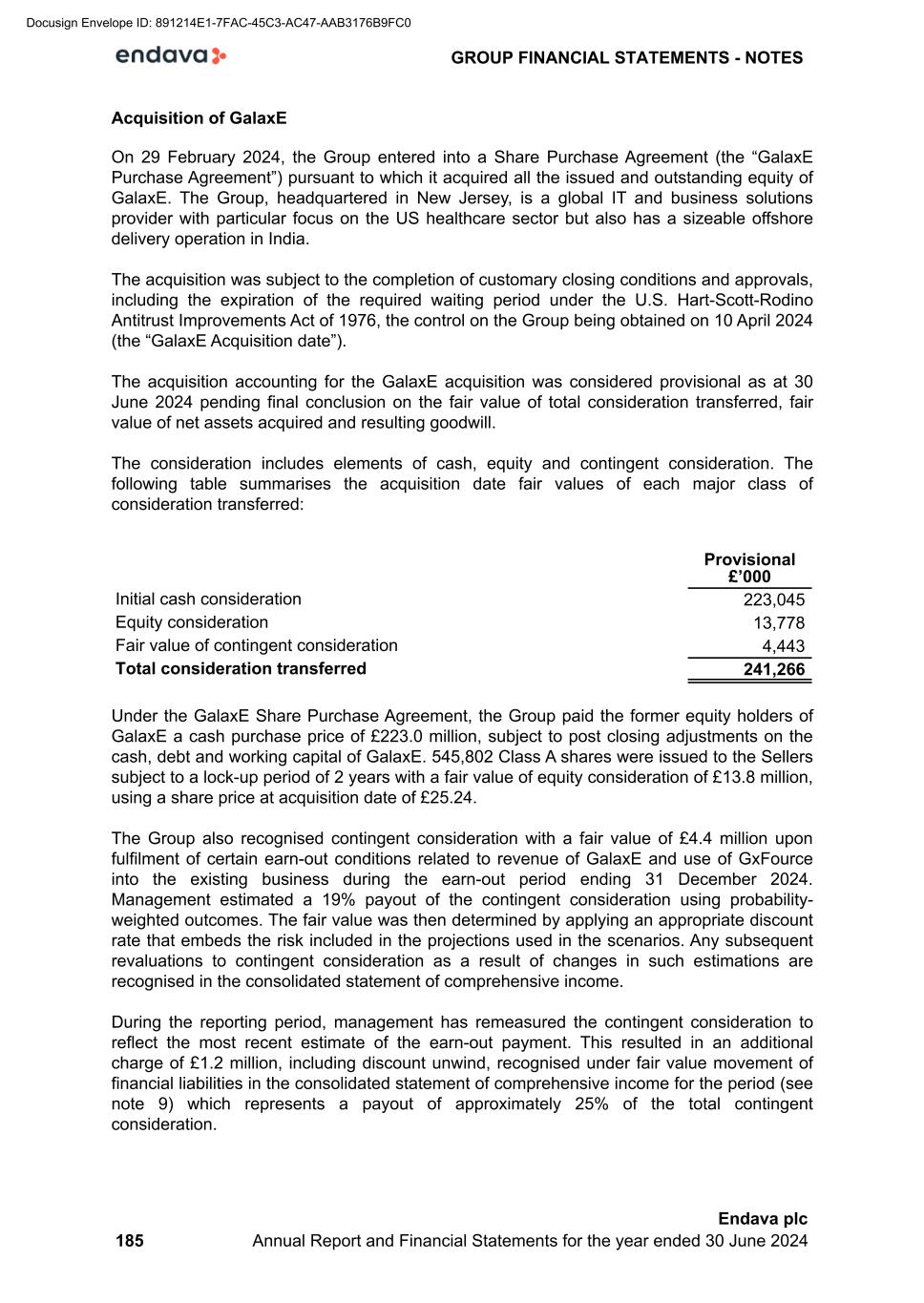
Acquisition of GalaxE On 29 February 2024, the Group entered into a Share Purchase Agreement (the “GalaxE Purchase Agreement”) pursuant to which it acquired all the issued and outstanding equity of GalaxE. The Group, headquartered in New Jersey, is a global IT and business solutions provider with particular focus on the US healthcare sector but also has a sizeable offshore delivery operation in India. The acquisition was subject to the completion of customary closing conditions and approvals, including the expiration of the required waiting period under the U.S. Hart-Scott-Rodino Antitrust Improvements Act of 1976, the control on the Group being obtained on 10 April 2024 (the “GalaxE Acquisition date”). The acquisition accounting for the GalaxE acquisition was considered provisional as at 30 June 2024 pending final conclusion on the fair value of total consideration transferred, fair value of net assets acquired and resulting goodwill. The consideration includes elements of cash, equity and contingent consideration. The following table summarises the acquisition date fair values of each major class of consideration transferred: Provisional £’000 Initial cash consideration 223,045 Equity consideration 13,778 Fair value of contingent consideration 4,443 Total consideration transferred 241,266 Under the GalaxE Share Purchase Agreement, the Group paid the former equity holders of GalaxE a cash purchase price of £223.0 million, subject to post closing adjustments on the cash, debt and working capital of GalaxE. 545,802 Class A shares were issued to the Sellers subject to a lock-up period of 2 years with a fair value of equity consideration of £13.8 million, using a share price at acquisition date of £25.24. The Group also recognised contingent consideration with a fair value of £4.4 million upon fulfilment of certain earn-out conditions related to revenue of GalaxE and use of GxFource into the existing business during the earn-out period ending 31 December 2024. Management estimated a 19% payout of the contingent consideration using probability- weighted outcomes. The fair value was then determined by applying an appropriate discount rate that embeds the risk included in the projections used in the scenarios. Any subsequent revaluations to contingent consideration as a result of changes in such estimations are recognised in the consolidated statement of comprehensive income. During the reporting period, management has remeasured the contingent consideration to reflect the most recent estimate of the earn-out payment. This resulted in an additional charge of £1.2 million, including discount unwind, recognised under fair value movement of financial liabilities in the consolidated statement of comprehensive income for the period (see note 9) which represents a payout of approximately 25% of the total contingent consideration. GROUP FINANCIAL STATEMENTS - NOTES 185 Endava plc Annual Report and Financial Statements for the year ended 30 June 2024 Docusign Envelope ID: 891214E1-7FAC-45C3-AC47-AAB3176B9FC0
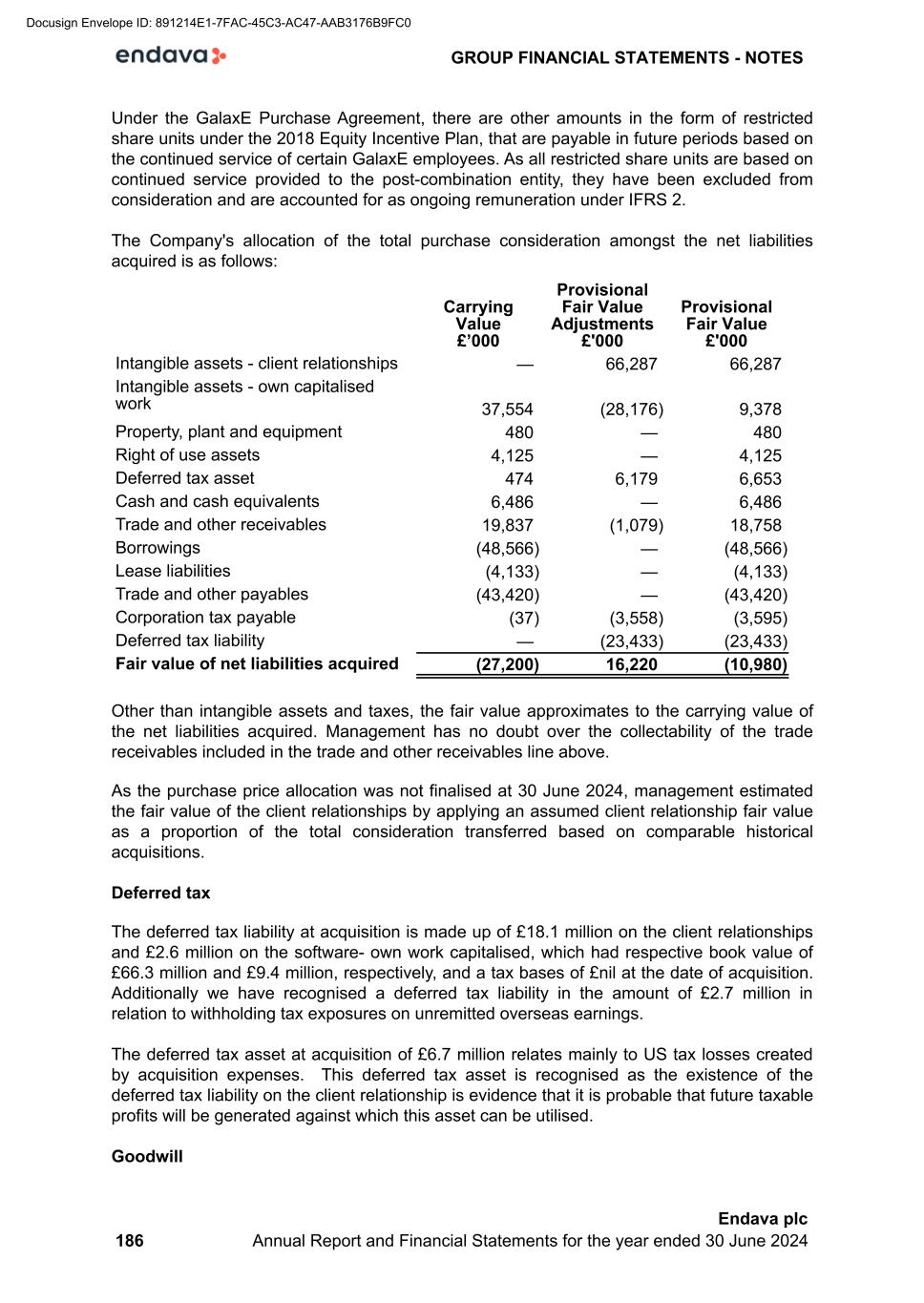
Under the GalaxE Purchase Agreement, there are other amounts in the form of restricted share units under the 2018 Equity Incentive Plan, that are payable in future periods based on the continued service of certain GalaxE employees. As all restricted share units are based on continued service provided to the post-combination entity, they have been excluded from consideration and are accounted for as ongoing remuneration under IFRS 2. The Company's allocation of the total purchase consideration amongst the net liabilities acquired is as follows: Carrying Value £’000 Provisional Fair Value Adjustments £'000 Provisional Fair Value £'000 Intangible assets - client relationships — 66,287 66,287 Intangible assets - own capitalised work 37,554 (28,176) 9,378 Property, plant and equipment 480 — 480 Right of use assets 4,125 — 4,125 Deferred tax asset 474 6,179 6,653 Cash and cash equivalents 6,486 — 6,486 Trade and other receivables 19,837 (1,079) 18,758 Borrowings (48,566) — (48,566) Lease liabilities (4,133) — (4,133) Trade and other payables (43,420) — (43,420) Corporation tax payable (37) (3,558) (3,595) Deferred tax liability — (23,433) (23,433) Fair value of net liabilities acquired (27,200) 16,220 (10,980) Other than intangible assets and taxes, the fair value approximates to the carrying value of the net liabilities acquired. Management has no doubt over the collectability of the trade receivables included in the trade and other receivables line above. As the purchase price allocation was not finalised at 30 June 2024, management estimated the fair value of the client relationships by applying an assumed client relationship fair value as a proportion of the total consideration transferred based on comparable historical acquisitions. Deferred tax The deferred tax liability at acquisition is made up of £18.1 million on the client relationships and £2.6 million on the software- own work capitalised, which had respective book value of £66.3 million and £9.4 million, respectively, and a tax bases of £nil at the date of acquisition. Additionally we have recognised a deferred tax liability in the amount of £2.7 million in relation to withholding tax exposures on unremitted overseas earnings. The deferred tax asset at acquisition of £6.7 million relates mainly to US tax losses created by acquisition expenses. This deferred tax asset is recognised as the existence of the deferred tax liability on the client relationship is evidence that it is probable that future taxable profits will be generated against which this asset can be utilised. Goodwill GROUP FINANCIAL STATEMENTS - NOTES 186 Endava plc Annual Report and Financial Statements for the year ended 30 June 2024 Docusign Envelope ID: 891214E1-7FAC-45C3-AC47-AAB3176B9FC0
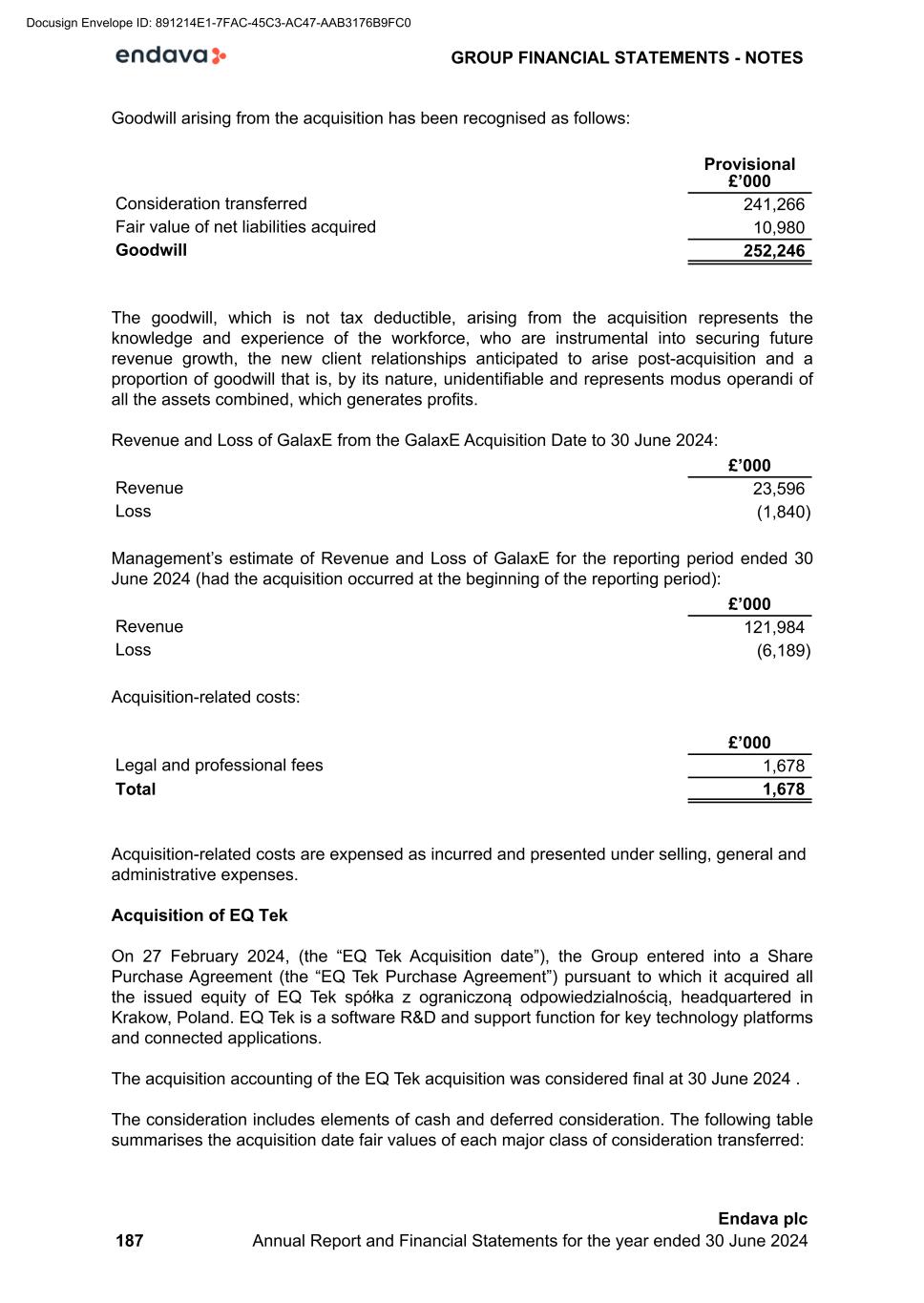
Goodwill arising from the acquisition has been recognised as follows: Provisional £’000 Consideration transferred 241,266 Fair value of net liabilities acquired 10,980 Goodwill 252,246 The goodwill, which is not tax deductible, arising from the acquisition represents the knowledge and experience of the workforce, who are instrumental into securing future revenue growth, the new client relationships anticipated to arise post-acquisition and a proportion of goodwill that is, by its nature, unidentifiable and represents modus operandi of all the assets combined, which generates profits. Revenue and Loss of GalaxE from the GalaxE Acquisition Date to 30 June 2024: £’000 Revenue 23,596 Loss (1,840) Management’s estimate of Revenue and Loss of GalaxE for the reporting period ended 30 June 2024 (had the acquisition occurred at the beginning of the reporting period): £’000 Revenue 121,984 Loss (6,189) Acquisition-related costs: £’000 Legal and professional fees 1,678 Total 1,678 Acquisition-related costs are expensed as incurred and presented under selling, general and administrative expenses. Acquisition of EQ Tek On 27 February 2024, (the “EQ Tek Acquisition date”), the Group entered into a Share Purchase Agreement (the “EQ Tek Purchase Agreement”) pursuant to which it acquired all the issued equity of EQ Tek spółka z ograniczoną odpowiedzialnością, headquartered in Krakow, Poland. EQ Tek is a software R&D and support function for key technology platforms and connected applications. The acquisition accounting of the EQ Tek acquisition was considered final at 30 June 2024 . The consideration includes elements of cash and deferred consideration. The following table summarises the acquisition date fair values of each major class of consideration transferred: GROUP FINANCIAL STATEMENTS - NOTES 187 Endava plc Annual Report and Financial Statements for the year ended 30 June 2024 Docusign Envelope ID: 891214E1-7FAC-45C3-AC47-AAB3176B9FC0
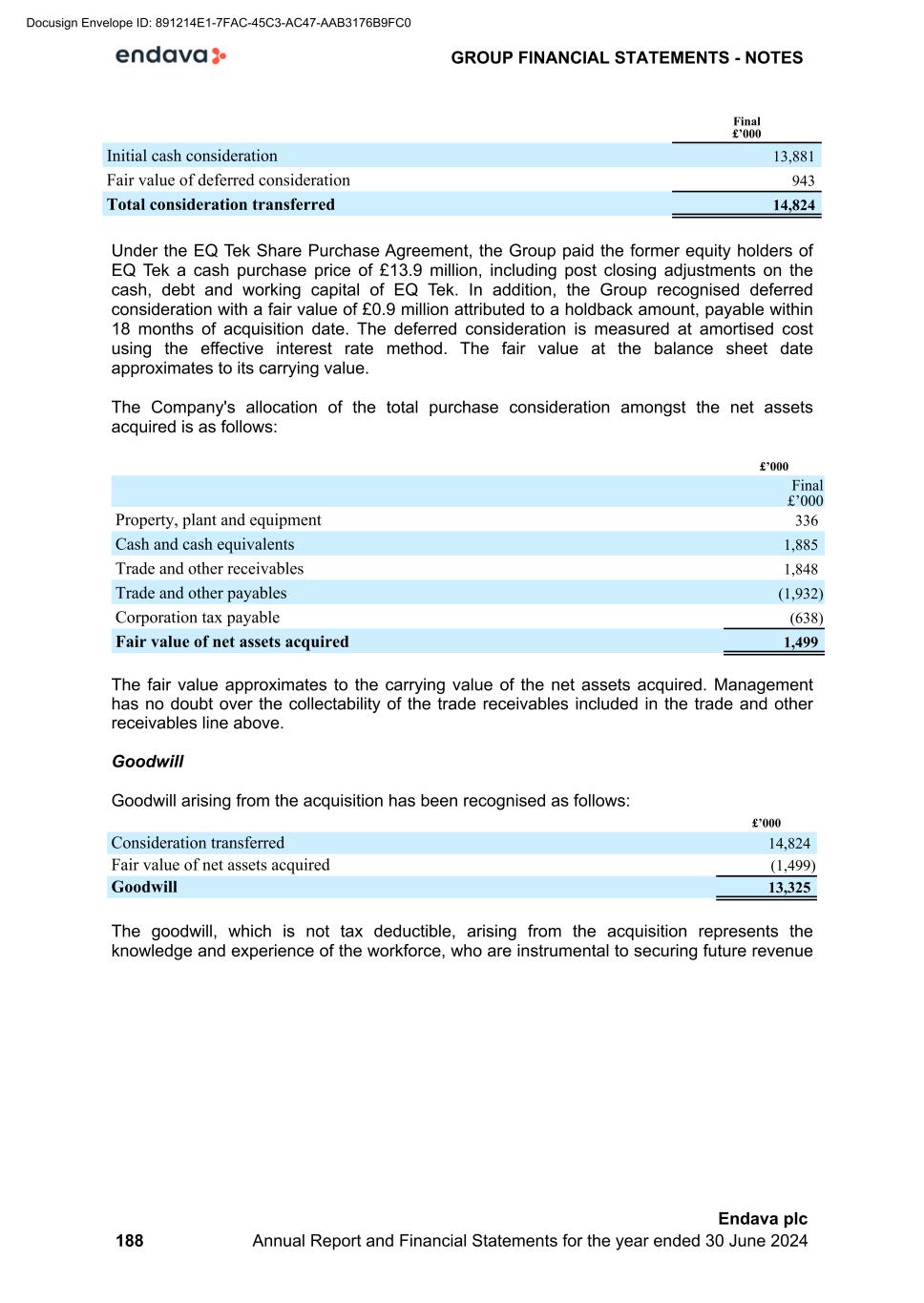
Final £’000 Initial cash consideration 13,881 Fair value of deferred consideration 943 Total consideration transferred 14,824 Under the EQ Tek Share Purchase Agreement, the Group paid the former equity holders of EQ Tek a cash purchase price of £13.9 million, including post closing adjustments on the cash, debt and working capital of EQ Tek. In addition, the Group recognised deferred consideration with a fair value of £0.9 million attributed to a holdback amount, payable within 18 months of acquisition date. The deferred consideration is measured at amortised cost using the effective interest rate method. The fair value at the balance sheet date approximates to its carrying value. The Company's allocation of the total purchase consideration amongst the net assets acquired is as follows: £’000 Final £’000 Property, plant and equipment 336 Cash and cash equivalents 1,885 Trade and other receivables 1,848 Trade and other payables (1,932) Corporation tax payable (638) Fair value of net assets acquired 1,499 The fair value approximates to the carrying value of the net assets acquired. Management has no doubt over the collectability of the trade receivables included in the trade and other receivables line above. Goodwill Goodwill arising from the acquisition has been recognised as follows: £’000 Consideration transferred 14,824 Fair value of net assets acquired (1,499) Goodwill 13,325 The goodwill, which is not tax deductible, arising from the acquisition represents the knowledge and experience of the workforce, who are instrumental to securing future revenue GROUP FINANCIAL STATEMENTS - NOTES 188 Endava plc Annual Report and Financial Statements for the year ended 30 June 2024 Docusign Envelope ID: 891214E1-7FAC-45C3-AC47-AAB3176B9FC0
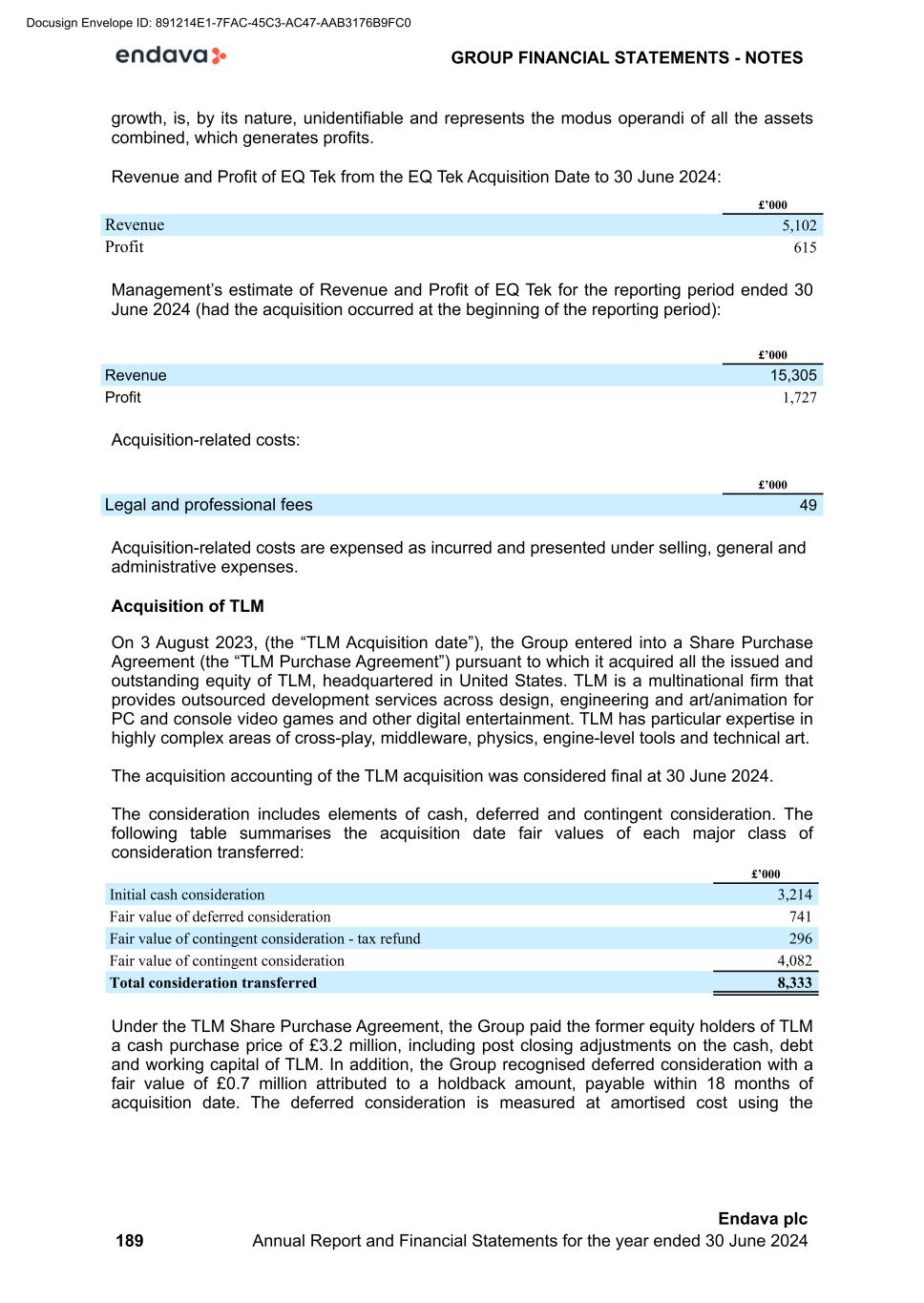
growth, is, by its nature, unidentifiable and represents the modus operandi of all the assets combined, which generates profits. Revenue and Profit of EQ Tek from the EQ Tek Acquisition Date to 30 June 2024: £’000 Revenue 5,102 Profit 615 Management’s estimate of Revenue and Profit of EQ Tek for the reporting period ended 30 June 2024 (had the acquisition occurred at the beginning of the reporting period): £’000 Revenue 15,305 Profit 1,727 Acquisition-related costs: £’000 Legal and professional fees 49 Acquisition-related costs are expensed as incurred and presented under selling, general and administrative expenses. Acquisition of TLM On 3 August 2023, (the “TLM Acquisition date”), the Group entered into a Share Purchase Agreement (the “TLM Purchase Agreement”) pursuant to which it acquired all the issued and outstanding equity of TLM, headquartered in United States. TLM is a multinational firm that provides outsourced development services across design, engineering and art/animation for PC and console video games and other digital entertainment. TLM has particular expertise in highly complex areas of cross-play, middleware, physics, engine-level tools and technical art. The acquisition accounting of the TLM acquisition was considered final at 30 June 2024. The consideration includes elements of cash, deferred and contingent consideration. The following table summarises the acquisition date fair values of each major class of consideration transferred: £’000 Initial cash consideration 3,214 Fair value of deferred consideration 741 Fair value of contingent consideration - tax refund 296 Fair value of contingent consideration 4,082 Total consideration transferred 8,333 Under the TLM Share Purchase Agreement, the Group paid the former equity holders of TLM a cash purchase price of £3.2 million, including post closing adjustments on the cash, debt and working capital of TLM. In addition, the Group recognised deferred consideration with a fair value of £0.7 million attributed to a holdback amount, payable within 18 months of acquisition date. The deferred consideration is measured at amortised cost using the GROUP FINANCIAL STATEMENTS - NOTES 189 Endava plc Annual Report and Financial Statements for the year ended 30 June 2024 Docusign Envelope ID: 891214E1-7FAC-45C3-AC47-AAB3176B9FC0
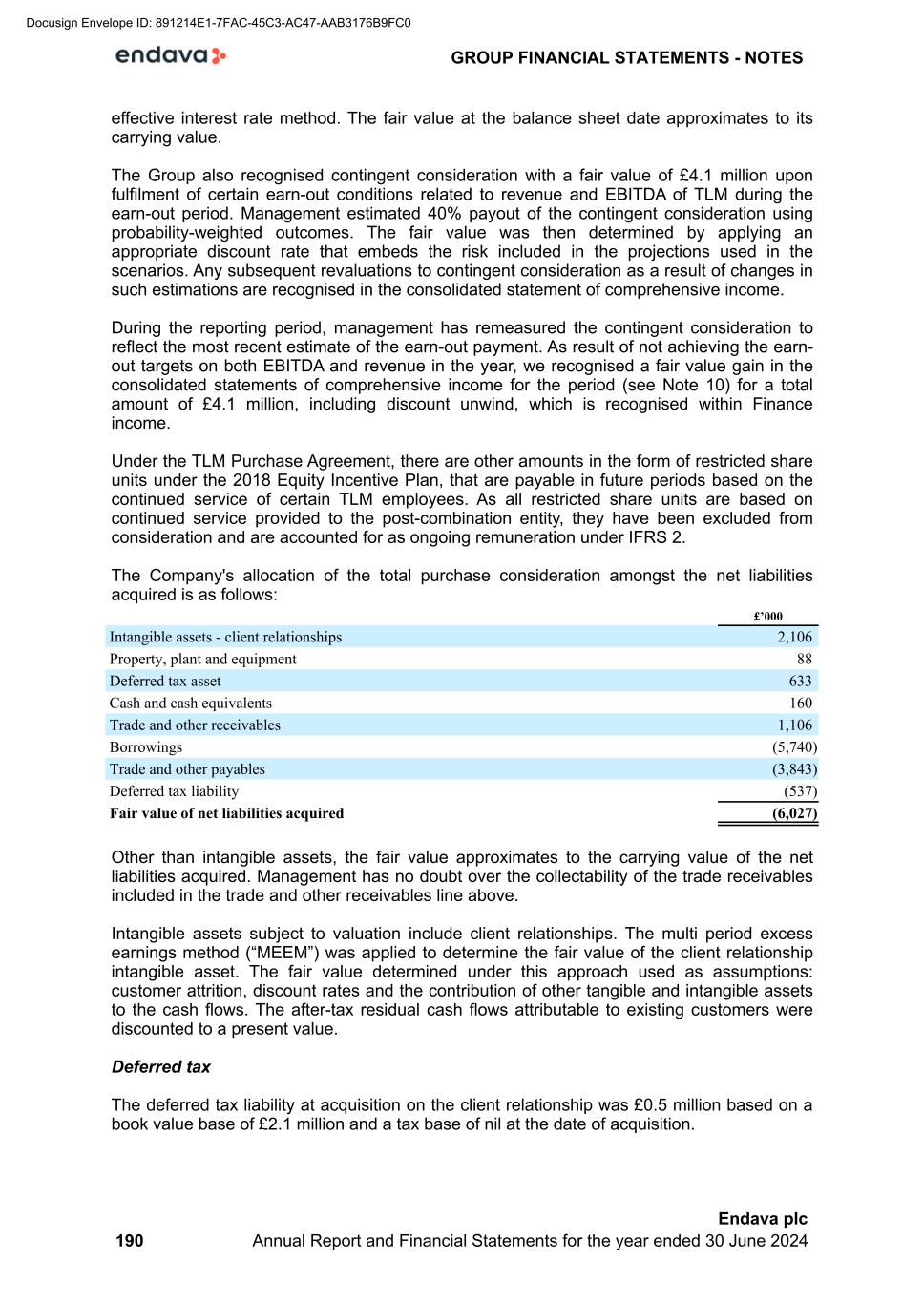
effective interest rate method. The fair value at the balance sheet date approximates to its carrying value. The Group also recognised contingent consideration with a fair value of £4.1 million upon fulfilment of certain earn-out conditions related to revenue and EBITDA of TLM during the earn-out period. Management estimated 40% payout of the contingent consideration using probability-weighted outcomes. The fair value was then determined by applying an appropriate discount rate that embeds the risk included in the projections used in the scenarios. Any subsequent revaluations to contingent consideration as a result of changes in such estimations are recognised in the consolidated statement of comprehensive income. During the reporting period, management has remeasured the contingent consideration to reflect the most recent estimate of the earn-out payment. As result of not achieving the earn- out targets on both EBITDA and revenue in the year, we recognised a fair value gain in the consolidated statements of comprehensive income for the period (see Note 10) for a total amount of £4.1 million, including discount unwind, which is recognised within Finance income. Under the TLM Purchase Agreement, there are other amounts in the form of restricted share units under the 2018 Equity Incentive Plan, that are payable in future periods based on the continued service of certain TLM employees. As all restricted share units are based on continued service provided to the post-combination entity, they have been excluded from consideration and are accounted for as ongoing remuneration under IFRS 2. The Company's allocation of the total purchase consideration amongst the net liabilities acquired is as follows: £’000 Intangible assets - client relationships 2,106 Property, plant and equipment 88 Deferred tax asset 633 Cash and cash equivalents 160 Trade and other receivables 1,106 Borrowings (5,740) Trade and other payables (3,843) Deferred tax liability (537) Fair value of net liabilities acquired (6,027) Other than intangible assets, the fair value approximates to the carrying value of the net liabilities acquired. Management has no doubt over the collectability of the trade receivables included in the trade and other receivables line above. Intangible assets subject to valuation include client relationships. The multi period excess earnings method (“MEEM”) was applied to determine the fair value of the client relationship intangible asset. The fair value determined under this approach used as assumptions: customer attrition, discount rates and the contribution of other tangible and intangible assets to the cash flows. The after-tax residual cash flows attributable to existing customers were discounted to a present value. Deferred tax The deferred tax liability at acquisition on the client relationship was £0.5 million based on a book value base of £2.1 million and a tax base of nil at the date of acquisition. GROUP FINANCIAL STATEMENTS - NOTES 190 Endava plc Annual Report and Financial Statements for the year ended 30 June 2024 Docusign Envelope ID: 891214E1-7FAC-45C3-AC47-AAB3176B9FC0

Goodwill Goodwill arising from the acquisition has been recognised as follows: £’000 Consideration transferred 8,333 Fair value of net liabilities acquired 6,027 Goodwill 14,360 The goodwill, which is not tax deductible, arising from the acquisition represents the knowledge and experience of the workforce, who are instrumental to securing future revenue growth, the new client relationships anticipated to arise post-acquisition and a proportion of goodwill that is, by its nature, unidentifiable and represents the modus operandi of all the assets combined, which generates profits. Revenue and Loss of TLM from the TLM Acquisition Date to 30 June 2024: £’000 Revenue 5,262 Loss (7,803) Management’s estimate of Revenue and Loss of TLM for the reporting period ended 30 June 2024 (had the acquisition occurred at the beginning of the reporting period): £’000 Revenue 5,742 Loss (8,152) Acquisition- related costs: £’000 Legal and professional fees 769 Acquisition-related costs are expensed as incurred and presented under selling, general and administrative expenses. Acquisition of DEK On 9 June 2023, (the “DEK Acquisition date”), the Group entered into a Share Purchase Agreement (the “DEK Purchase Agreement”) pursuant to which it acquired all the issued and outstanding equity of DEK, headquartered in Melbourne, Australia with additional offices in Ho Chi Minh, Vietnam and Stockholm, Sweden. DEK is a multinational firm that develops cutting-edge software solutions across a range of applications, including embedded systems, real-time solutions, telecoms and data communications. DEK’s expertise spans several industry sectors with the most prominent being telecommunications. One of its long-standing clients is one of the world’s largest networking and telecommunication equipment and GROUP FINANCIAL STATEMENTS - NOTES 191 Endava plc Annual Report and Financial Statements for the year ended 30 June 2024 Docusign Envelope ID: 891214E1-7FAC-45C3-AC47-AAB3176B9FC0
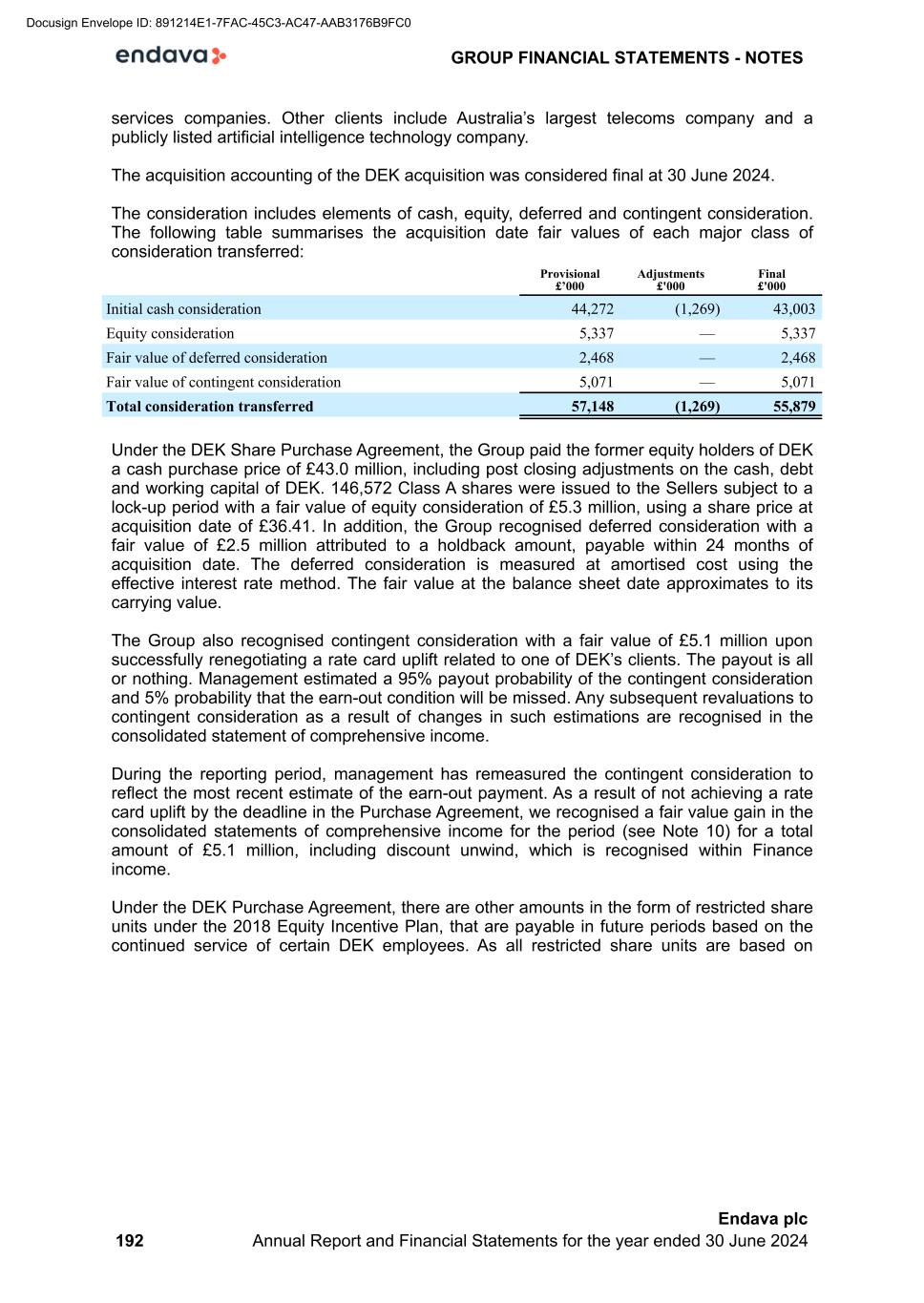
services companies. Other clients include Australia’s largest telecoms company and a publicly listed artificial intelligence technology company. The acquisition accounting of the DEK acquisition was considered final at 30 June 2024. The consideration includes elements of cash, equity, deferred and contingent consideration. The following table summarises the acquisition date fair values of each major class of consideration transferred: Provisional £’000 Adjustments £'000 Final £'000 Initial cash consideration 44,272 (1,269) 43,003 Equity consideration 5,337 — 5,337 Fair value of deferred consideration 2,468 — 2,468 Fair value of contingent consideration 5,071 — 5,071 Total consideration transferred 57,148 (1,269) 55,879 Under the DEK Share Purchase Agreement, the Group paid the former equity holders of DEK a cash purchase price of £43.0 million, including post closing adjustments on the cash, debt and working capital of DEK. 146,572 Class A shares were issued to the Sellers subject to a lock-up period with a fair value of equity consideration of £5.3 million, using a share price at acquisition date of £36.41. In addition, the Group recognised deferred consideration with a fair value of £2.5 million attributed to a holdback amount, payable within 24 months of acquisition date. The deferred consideration is measured at amortised cost using the effective interest rate method. The fair value at the balance sheet date approximates to its carrying value. The Group also recognised contingent consideration with a fair value of £5.1 million upon successfully renegotiating a rate card uplift related to one of DEK’s clients. The payout is all or nothing. Management estimated a 95% payout probability of the contingent consideration and 5% probability that the earn-out condition will be missed. Any subsequent revaluations to contingent consideration as a result of changes in such estimations are recognised in the consolidated statement of comprehensive income. During the reporting period, management has remeasured the contingent consideration to reflect the most recent estimate of the earn-out payment. As a result of not achieving a rate card uplift by the deadline in the Purchase Agreement, we recognised a fair value gain in the consolidated statements of comprehensive income for the period (see Note 10) for a total amount of £5.1 million, including discount unwind, which is recognised within Finance income. Under the DEK Purchase Agreement, there are other amounts in the form of restricted share units under the 2018 Equity Incentive Plan, that are payable in future periods based on the continued service of certain DEK employees. As all restricted share units are based on GROUP FINANCIAL STATEMENTS - NOTES 192 Endava plc Annual Report and Financial Statements for the year ended 30 June 2024 Docusign Envelope ID: 891214E1-7FAC-45C3-AC47-AAB3176B9FC0

continued service provided to the post-combination entity, they have been excluded from consideration and are accounted for as ongoing remuneration under IFRS 2. The Company's allocation of the total purchase consideration amongst the net assets acquired is as follows: Provisional £’000 Adjustments £'000 Final £'000 Intangible assets - client relationships 16,459 (743) 15,716 Property, plant and equipment 354 — 354 Right of use assets 4,667 — 4,667 Deferred tax asset — 641 641 Cash and cash equivalents 10,817 — 10,817 Trade and other receivables 13,006 385 13,391 Corporation tax receivable 368 (200) 168 Lease liabilities (4,752) — (4,752) Trade and other payables (24,550) (669) (25,219) Corporation tax payable (659) 659 — Deferred tax liability (4,197) 189 (4,008) Fair value of net assets acquired 11,513 262 11,775 Other than intangible assets, the fair value approximates to the carrying value of the net assets acquired. Management has no doubt over the collectability of the trade receivables included in the trade and other receivables line above. Intangible assets subject to valuation include client relationships. The MEEM was applied to determine the fair value of the client relationship intangible asset. The fair value determined under this approach used as assumptions: customer attrition, discount rates and the contribution of other tangible and intangible assets to the cash flows. The after-tax residual cash flows attributable to existing customers were discounted to a present value. Deferred tax The deferred tax liability at acquisition on the client relationship was £4.2 million based on a book value base of £16.5 million and a tax base of nil at the date of acquisition. Goodwill Goodwill arising from the acquisition has been recognised as follows: Provisional £’000 Adjustments £'000 Final £'000 Consideration transferred 57,148 (1,269) 55,879 Fair value of net assets acquired (11,513) (262) (11,775) Goodwill 45,635 (1,531) 44,104 The goodwill, which is not tax deductible, arising from the acquisition represents the knowledge and experience of the workforce, who are instrumental to securing future revenue growth, the new client relationships anticipated to arise post-acquisition and a proportion of GROUP FINANCIAL STATEMENTS - NOTES 193 Endava plc Annual Report and Financial Statements for the year ended 30 June 2024 Docusign Envelope ID: 891214E1-7FAC-45C3-AC47-AAB3176B9FC0
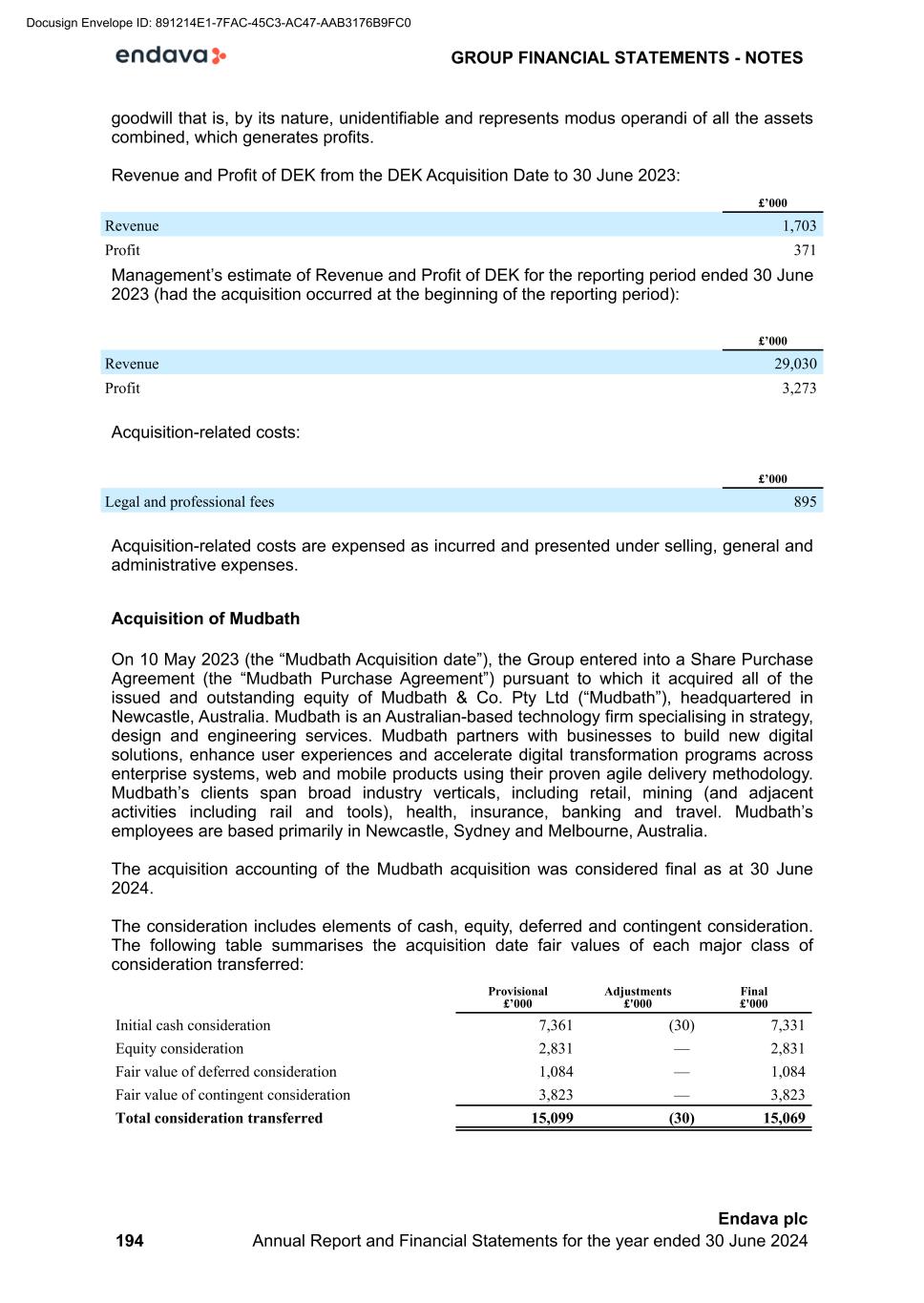
goodwill that is, by its nature, unidentifiable and represents modus operandi of all the assets combined, which generates profits. Revenue and Profit of DEK from the DEK Acquisition Date to 30 June 2023: £’000 Revenue 1,703 Profit 371 Management’s estimate of Revenue and Profit of DEK for the reporting period ended 30 June 2023 (had the acquisition occurred at the beginning of the reporting period): £’000 Revenue 29,030 Profit 3,273 Acquisition-related costs: £’000 Legal and professional fees 895 Acquisition-related costs are expensed as incurred and presented under selling, general and administrative expenses. Acquisition of Mudbath On 10 May 2023 (the “Mudbath Acquisition date”), the Group entered into a Share Purchase Agreement (the “Mudbath Purchase Agreement”) pursuant to which it acquired all of the issued and outstanding equity of Mudbath & Co. Pty Ltd (“Mudbath”), headquartered in Newcastle, Australia. Mudbath is an Australian-based technology firm specialising in strategy, design and engineering services. Mudbath partners with businesses to build new digital solutions, enhance user experiences and accelerate digital transformation programs across enterprise systems, web and mobile products using their proven agile delivery methodology. Mudbath’s clients span broad industry verticals, including retail, mining (and adjacent activities including rail and tools), health, insurance, banking and travel. Mudbath’s employees are based primarily in Newcastle, Sydney and Melbourne, Australia. The acquisition accounting of the Mudbath acquisition was considered final as at 30 June 2024. The consideration includes elements of cash, equity, deferred and contingent consideration. The following table summarises the acquisition date fair values of each major class of consideration transferred: Provisional £’000 Adjustments £'000 Final £'000 Initial cash consideration 7,361 (30) 7,331 Equity consideration 2,831 — 2,831 Fair value of deferred consideration 1,084 — 1,084 Fair value of contingent consideration 3,823 — 3,823 Total consideration transferred 15,099 (30) 15,069 GROUP FINANCIAL STATEMENTS - NOTES 194 Endava plc Annual Report and Financial Statements for the year ended 30 June 2024 Docusign Envelope ID: 891214E1-7FAC-45C3-AC47-AAB3176B9FC0
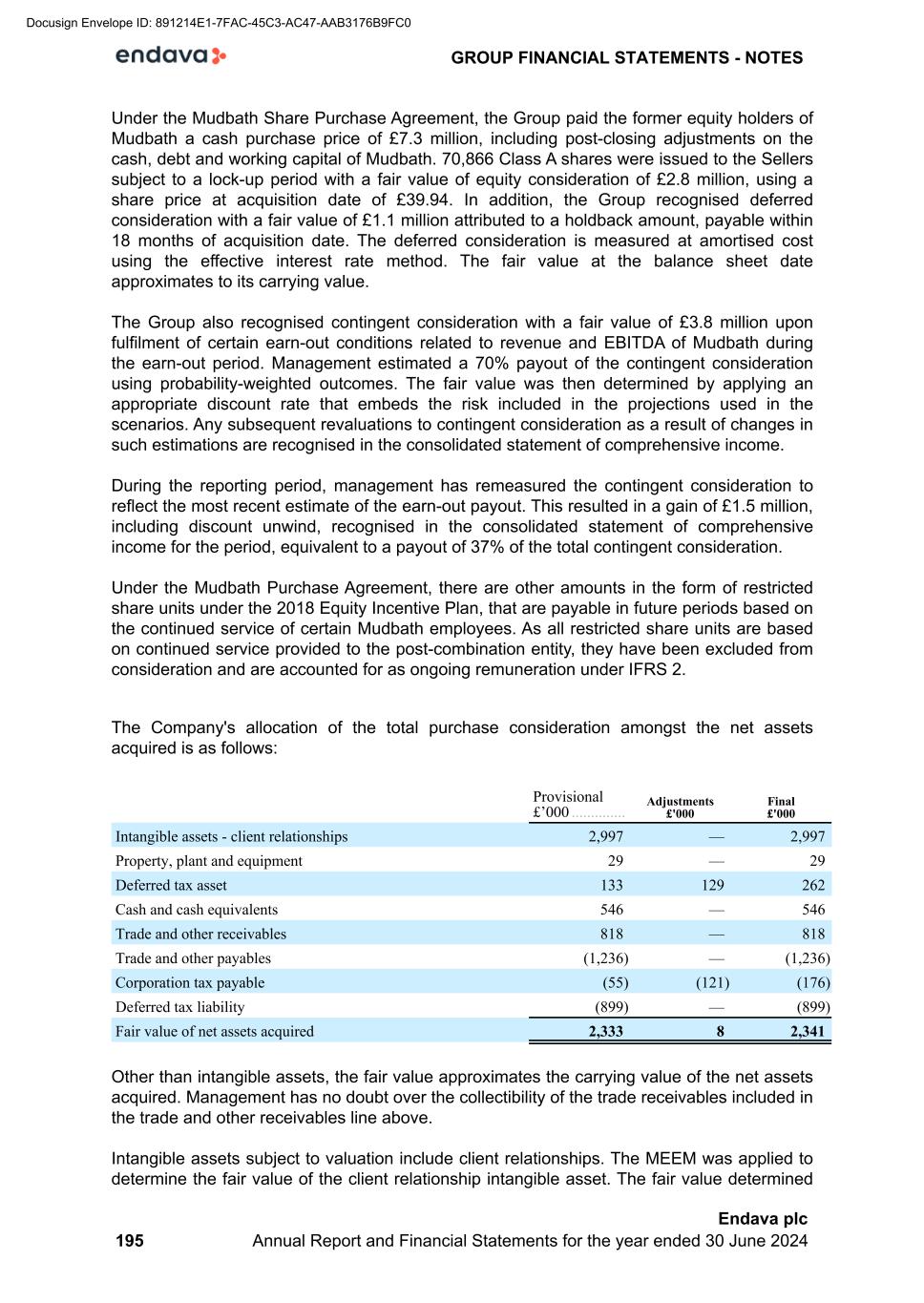
Under the Mudbath Share Purchase Agreement, the Group paid the former equity holders of Mudbath a cash purchase price of £7.3 million, including post-closing adjustments on the cash, debt and working capital of Mudbath. 70,866 Class A shares were issued to the Sellers subject to a lock-up period with a fair value of equity consideration of £2.8 million, using a share price at acquisition date of £39.94. In addition, the Group recognised deferred consideration with a fair value of £1.1 million attributed to a holdback amount, payable within 18 months of acquisition date. The deferred consideration is measured at amortised cost using the effective interest rate method. The fair value at the balance sheet date approximates to its carrying value. The Group also recognised contingent consideration with a fair value of £3.8 million upon fulfilment of certain earn-out conditions related to revenue and EBITDA of Mudbath during the earn-out period. Management estimated a 70% payout of the contingent consideration using probability-weighted outcomes. The fair value was then determined by applying an appropriate discount rate that embeds the risk included in the projections used in the scenarios. Any subsequent revaluations to contingent consideration as a result of changes in such estimations are recognised in the consolidated statement of comprehensive income. During the reporting period, management has remeasured the contingent consideration to reflect the most recent estimate of the earn-out payout. This resulted in a gain of £1.5 million, including discount unwind, recognised in the consolidated statement of comprehensive income for the period, equivalent to a payout of 37% of the total contingent consideration. Under the Mudbath Purchase Agreement, there are other amounts in the form of restricted share units under the 2018 Equity Incentive Plan, that are payable in future periods based on the continued service of certain Mudbath employees. As all restricted share units are based on continued service provided to the post-combination entity, they have been excluded from consideration and are accounted for as ongoing remuneration under IFRS 2. The Company's allocation of the total purchase consideration amongst the net assets acquired is as follows: Provisional £’000 .............. Adjustments £'000 Final £'000 Intangible assets - client relationships 2,997 — 2,997 Property, plant and equipment 29 — 29 Deferred tax asset 133 129 262 Cash and cash equivalents 546 — 546 Trade and other receivables 818 — 818 Trade and other payables (1,236) — (1,236) Corporation tax payable (55) (121) (176) Deferred tax liability (899) — (899) Fair value of net assets acquired 2,333 8 2,341 Other than intangible assets, the fair value approximates the carrying value of the net assets acquired. Management has no doubt over the collectibility of the trade receivables included in the trade and other receivables line above. Intangible assets subject to valuation include client relationships. The MEEM was applied to determine the fair value of the client relationship intangible asset. The fair value determined GROUP FINANCIAL STATEMENTS - NOTES 195 Endava plc Annual Report and Financial Statements for the year ended 30 June 2024 Docusign Envelope ID: 891214E1-7FAC-45C3-AC47-AAB3176B9FC0
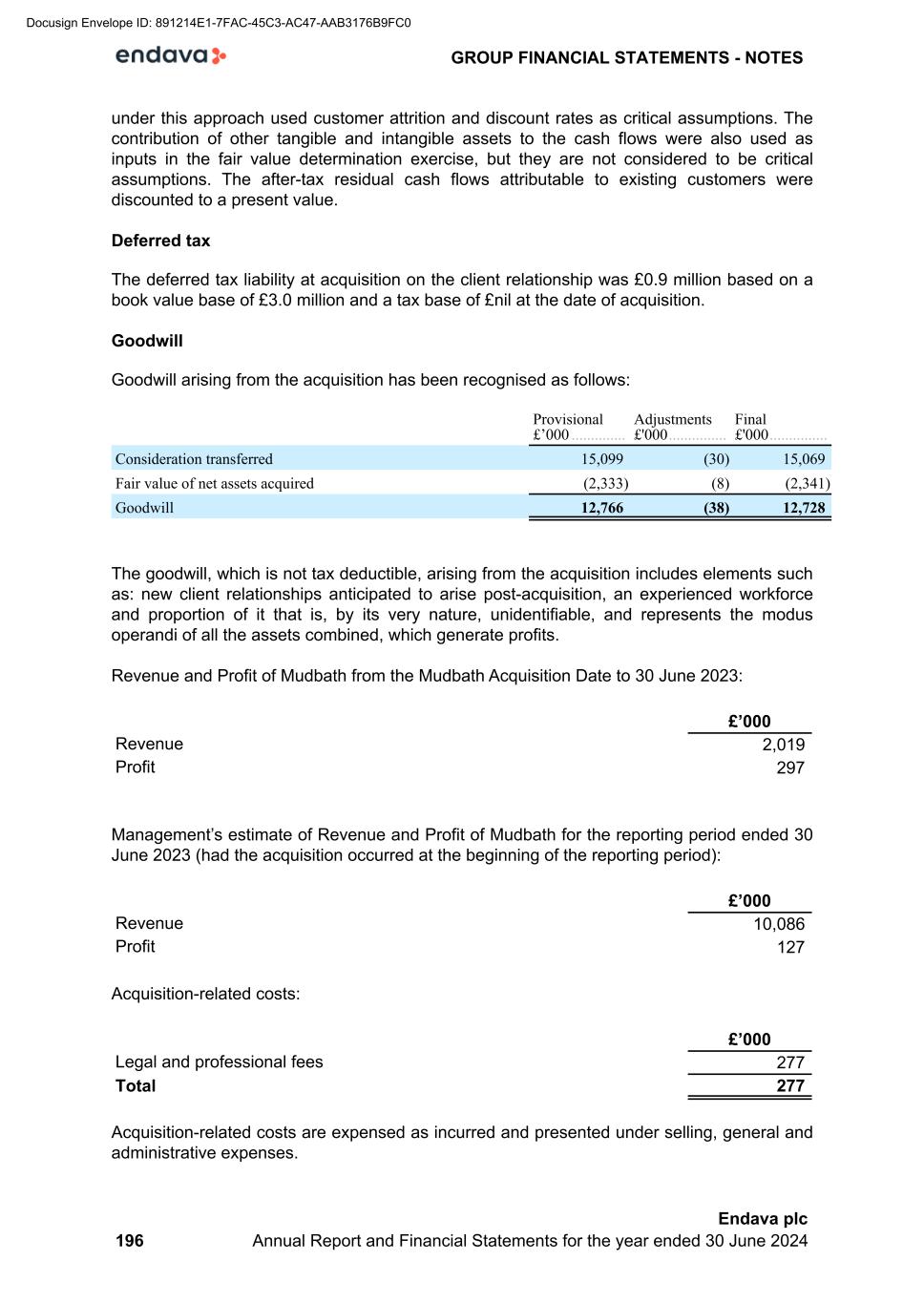
under this approach used customer attrition and discount rates as critical assumptions. The contribution of other tangible and intangible assets to the cash flows were also used as inputs in the fair value determination exercise, but they are not considered to be critical assumptions. The after-tax residual cash flows attributable to existing customers were discounted to a present value. Deferred tax The deferred tax liability at acquisition on the client relationship was £0.9 million based on a book value base of £3.0 million and a tax base of £nil at the date of acquisition. Goodwill Goodwill arising from the acquisition has been recognised as follows: Provisional £’000 .............. Adjustments £'000 ............... Final £'000 ............... Consideration transferred 15,099 (30) 15,069 Fair value of net assets acquired (2,333) (8) (2,341) Goodwill 12,766 (38) 12,728 The goodwill, which is not tax deductible, arising from the acquisition includes elements such as: new client relationships anticipated to arise post-acquisition, an experienced workforce and proportion of it that is, by its very nature, unidentifiable, and represents the modus operandi of all the assets combined, which generate profits. Revenue and Profit of Mudbath from the Mudbath Acquisition Date to 30 June 2023: £’000 Revenue 2,019 Profit 297 Management’s estimate of Revenue and Profit of Mudbath for the reporting period ended 30 June 2023 (had the acquisition occurred at the beginning of the reporting period): £’000 Revenue 10,086 Profit 127 Acquisition-related costs: £’000 Legal and professional fees 277 Total 277 Acquisition-related costs are expensed as incurred and presented under selling, general and administrative expenses. GROUP FINANCIAL STATEMENTS - NOTES 196 Endava plc Annual Report and Financial Statements for the year ended 30 June 2024 Docusign Envelope ID: 891214E1-7FAC-45C3-AC47-AAB3176B9FC0
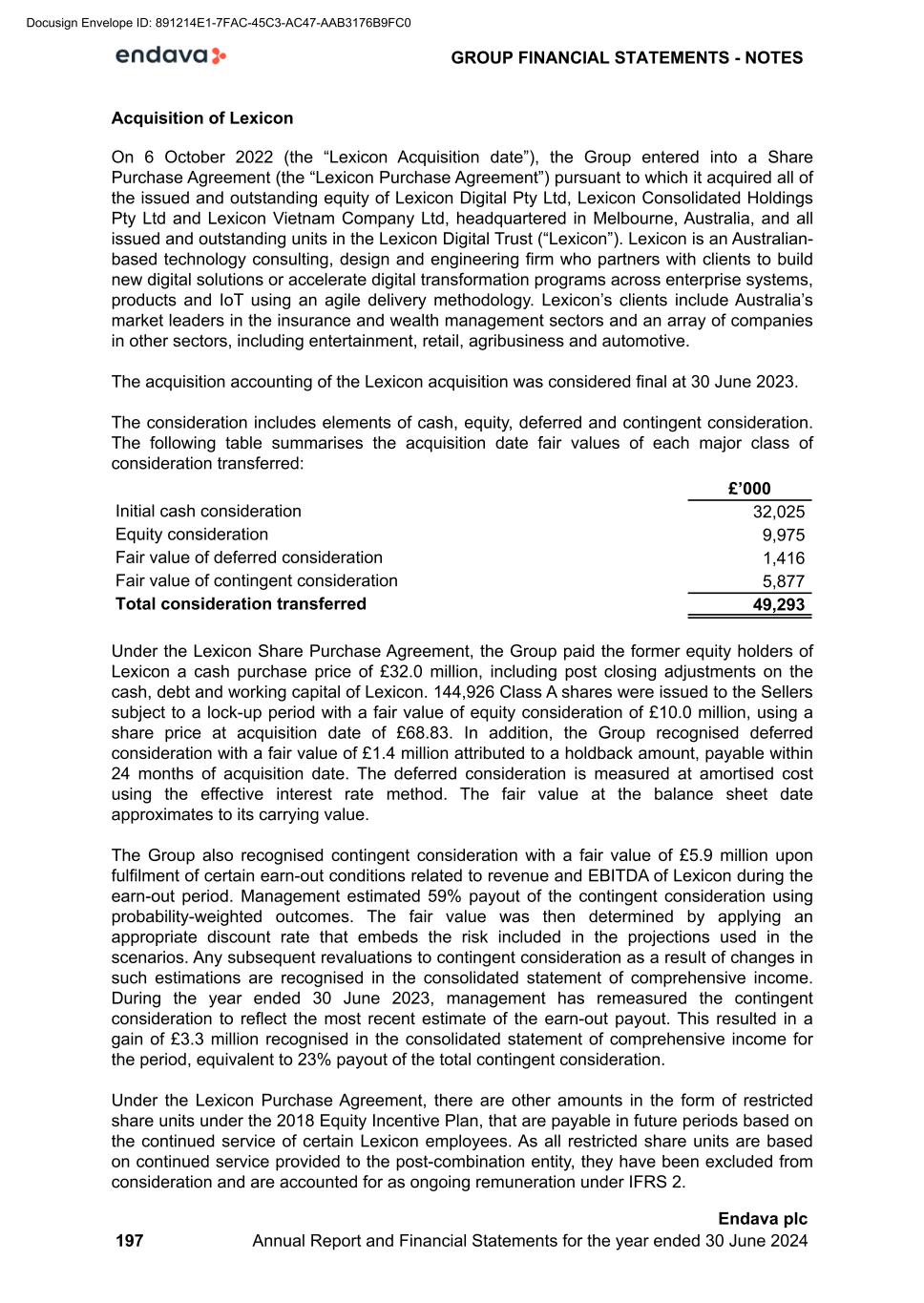
Acquisition of Lexicon On 6 October 2022 (the “Lexicon Acquisition date”), the Group entered into a Share Purchase Agreement (the “Lexicon Purchase Agreement”) pursuant to which it acquired all of the issued and outstanding equity of Lexicon Digital Pty Ltd, Lexicon Consolidated Holdings Pty Ltd and Lexicon Vietnam Company Ltd, headquartered in Melbourne, Australia, and all issued and outstanding units in the Lexicon Digital Trust (“Lexicon”). Lexicon is an Australian- based technology consulting, design and engineering firm who partners with clients to build new digital solutions or accelerate digital transformation programs across enterprise systems, products and IoT using an agile delivery methodology. Lexicon’s clients include Australia’s market leaders in the insurance and wealth management sectors and an array of companies in other sectors, including entertainment, retail, agribusiness and automotive. The acquisition accounting of the Lexicon acquisition was considered final at 30 June 2023. The consideration includes elements of cash, equity, deferred and contingent consideration. The following table summarises the acquisition date fair values of each major class of consideration transferred: £’000 Initial cash consideration 32,025 Equity consideration 9,975 Fair value of deferred consideration 1,416 Fair value of contingent consideration 5,877 Total consideration transferred 49,293 Under the Lexicon Share Purchase Agreement, the Group paid the former equity holders of Lexicon a cash purchase price of £32.0 million, including post closing adjustments on the cash, debt and working capital of Lexicon. 144,926 Class A shares were issued to the Sellers subject to a lock-up period with a fair value of equity consideration of £10.0 million, using a share price at acquisition date of £68.83. In addition, the Group recognised deferred consideration with a fair value of £1.4 million attributed to a holdback amount, payable within 24 months of acquisition date. The deferred consideration is measured at amortised cost using the effective interest rate method. The fair value at the balance sheet date approximates to its carrying value. The Group also recognised contingent consideration with a fair value of £5.9 million upon fulfilment of certain earn-out conditions related to revenue and EBITDA of Lexicon during the earn-out period. Management estimated 59% payout of the contingent consideration using probability-weighted outcomes. The fair value was then determined by applying an appropriate discount rate that embeds the risk included in the projections used in the scenarios. Any subsequent revaluations to contingent consideration as a result of changes in such estimations are recognised in the consolidated statement of comprehensive income. During the year ended 30 June 2023, management has remeasured the contingent consideration to reflect the most recent estimate of the earn-out payout. This resulted in a gain of £3.3 million recognised in the consolidated statement of comprehensive income for the period, equivalent to 23% payout of the total contingent consideration. Under the Lexicon Purchase Agreement, there are other amounts in the form of restricted share units under the 2018 Equity Incentive Plan, that are payable in future periods based on the continued service of certain Lexicon employees. As all restricted share units are based on continued service provided to the post-combination entity, they have been excluded from consideration and are accounted for as ongoing remuneration under IFRS 2. GROUP FINANCIAL STATEMENTS - NOTES 197 Endava plc Annual Report and Financial Statements for the year ended 30 June 2024 Docusign Envelope ID: 891214E1-7FAC-45C3-AC47-AAB3176B9FC0

The Company's allocation of the total purchase consideration amongst the net assets acquired is as follows: £’000 Intangible assets - client relationships 4,530 Property, plant and equipment 51 Right of use assets 299 Deferred tax asset 136 Cash and cash equivalents 1,824 Trade and other receivables 2,098 Lease liabilities (319) Trade and other payables (1,192) Corporation tax payable (825) Deferred tax liability (1,359) Fair value of net assets acquired 5,243 Other than intangible assets, the fair value approximates to the carrying value of the net assets acquired. Management has no doubt over the collectibility of the trade receivables included in the trade and other receivables line above. Intangible assets subject to valuation include client relationships. The MEEM was applied to determine the fair value of the client relationship intangible asset. The fair value determined under this approach used customer attrition and discount rates as critical assumptions. The contribution of other tangible and intangible assets to the cash flows were also used as inputs in the fair value determination exercise, but they are not considered to be critical assumptions. The after-tax residual cash flows attributable to existing customers were discounted to a present value. Deferred tax The deferred tax liability at acquisition on the client relationship was £1.4 million based on a book value base of £4.5 million and a tax base of £nil at the date of acquisition. Goodwill Goodwill arising from the acquisition has been recognised as follows: £’000 Consideration transferred 49,293 Fair value of net assets acquired (5,243) Goodwill 44,050 The goodwill, which is not tax deductible, arising from the acquisition represents the knowledge and experience of the workforce, who are instrumental to securing future revenue growth, the new client relationships anticipated to arise post-acquisition and a proportion of goodwill that is, by its nature, unidentifiable and represents the modus operandi of all the assets combined, which generates profits. GROUP FINANCIAL STATEMENTS - NOTES 198 Endava plc Annual Report and Financial Statements for the year ended 30 June 2024 Docusign Envelope ID: 891214E1-7FAC-45C3-AC47-AAB3176B9FC0
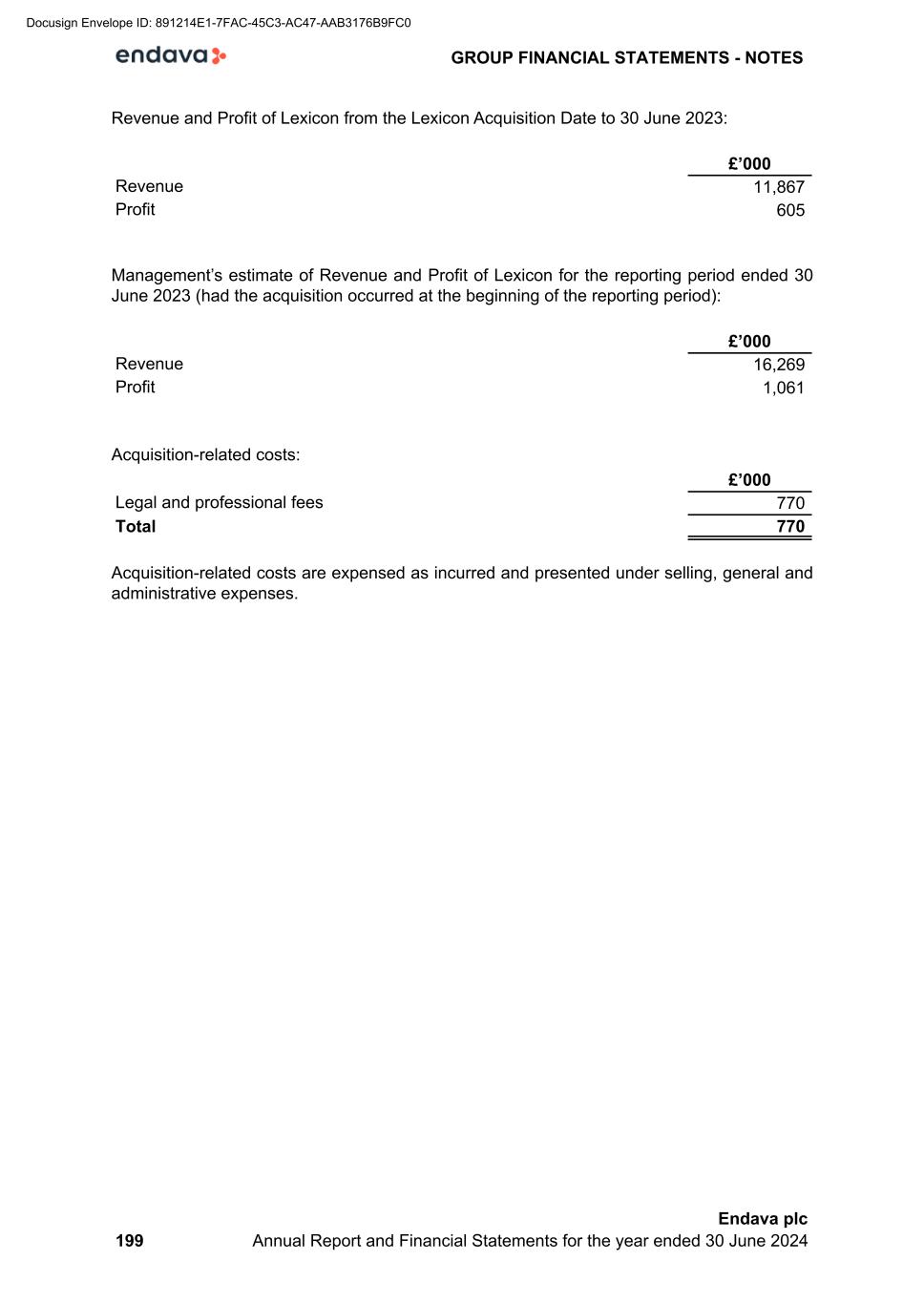
Revenue and Profit of Lexicon from the Lexicon Acquisition Date to 30 June 2023: £’000 Revenue 11,867 Profit 605 Management’s estimate of Revenue and Profit of Lexicon for the reporting period ended 30 June 2023 (had the acquisition occurred at the beginning of the reporting period): £’000 Revenue 16,269 Profit 1,061 Acquisition-related costs: £’000 Legal and professional fees 770 Total 770 Acquisition-related costs are expensed as incurred and presented under selling, general and administrative expenses. GROUP FINANCIAL STATEMENTS - NOTES 199 Endava plc Annual Report and Financial Statements for the year ended 30 June 2024 Docusign Envelope ID: 891214E1-7FAC-45C3-AC47-AAB3176B9FC0
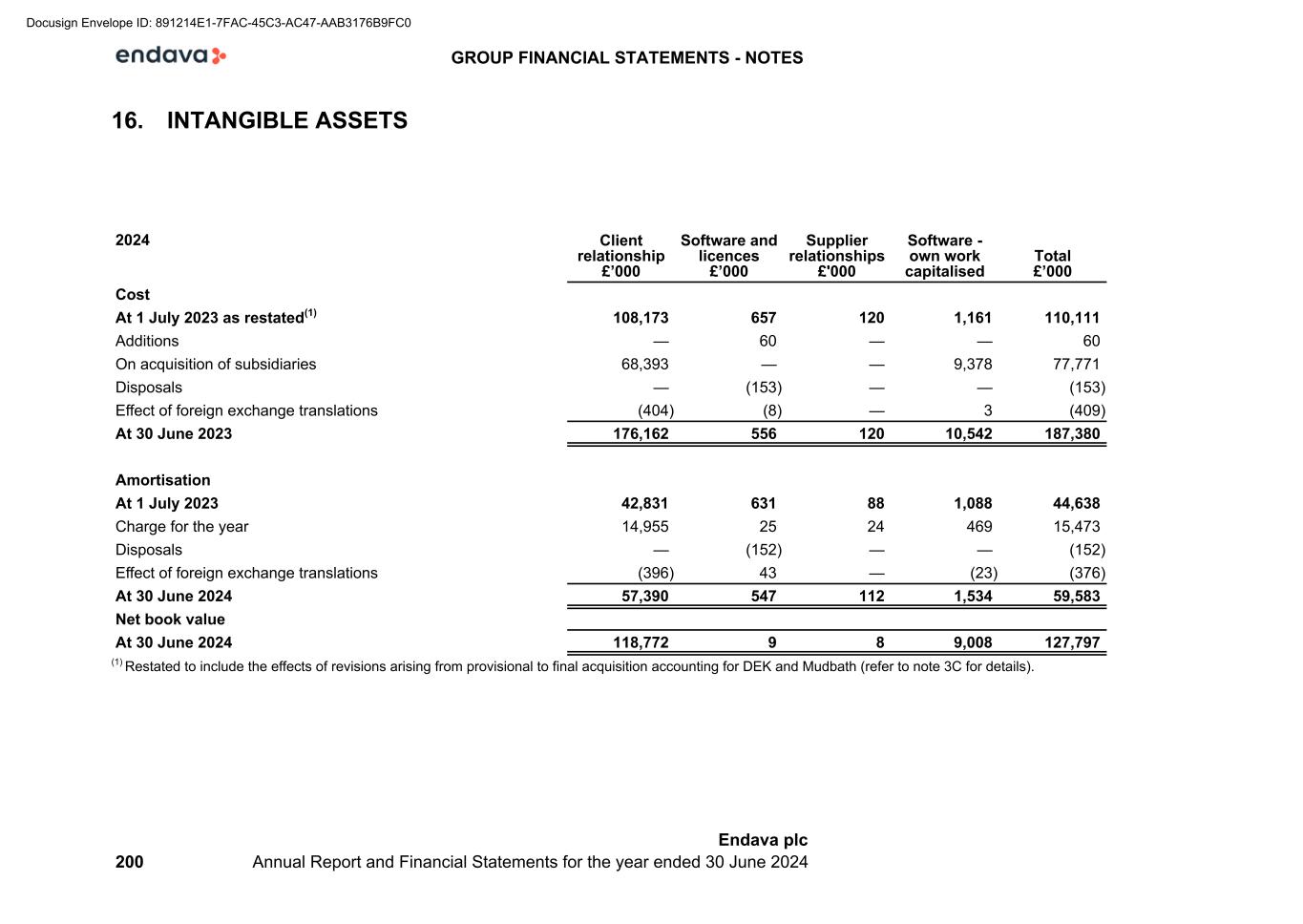
16. INTANGIBLE ASSETS 2024 Client relationship £’000 Software and licences £’000 Supplier relationships £'000 Software - own work capitalised Total £’000 Cost At 1 July 2023 as restated(1) 108,173 657 120 1,161 110,111 Additions — 60 — — 60 On acquisition of subsidiaries 68,393 — — 9,378 77,771 Disposals — (153) — — (153) Effect of foreign exchange translations (404) (8) — 3 (409) At 30 June 2023 176,162 556 120 10,542 187,380 Amortisation At 1 July 2023 42,831 631 88 1,088 44,638 Charge for the year 14,955 25 24 469 15,473 Disposals — (152) — — (152) Effect of foreign exchange translations (396) 43 — (23) (376) At 30 June 2024 57,390 547 112 1,534 59,583 Net book value At 30 June 2024 118,772 9 8 9,008 127,797 (1) Restated to include the effects of revisions arising from provisional to final acquisition accounting for DEK and Mudbath (refer to note 3C for details). GROUP FINANCIAL STATEMENTS - NOTES 200 Endava plc Annual Report and Financial Statements for the year ended 30 June 2024 Docusign Envelope ID: 891214E1-7FAC-45C3-AC47-AAB3176B9FC0
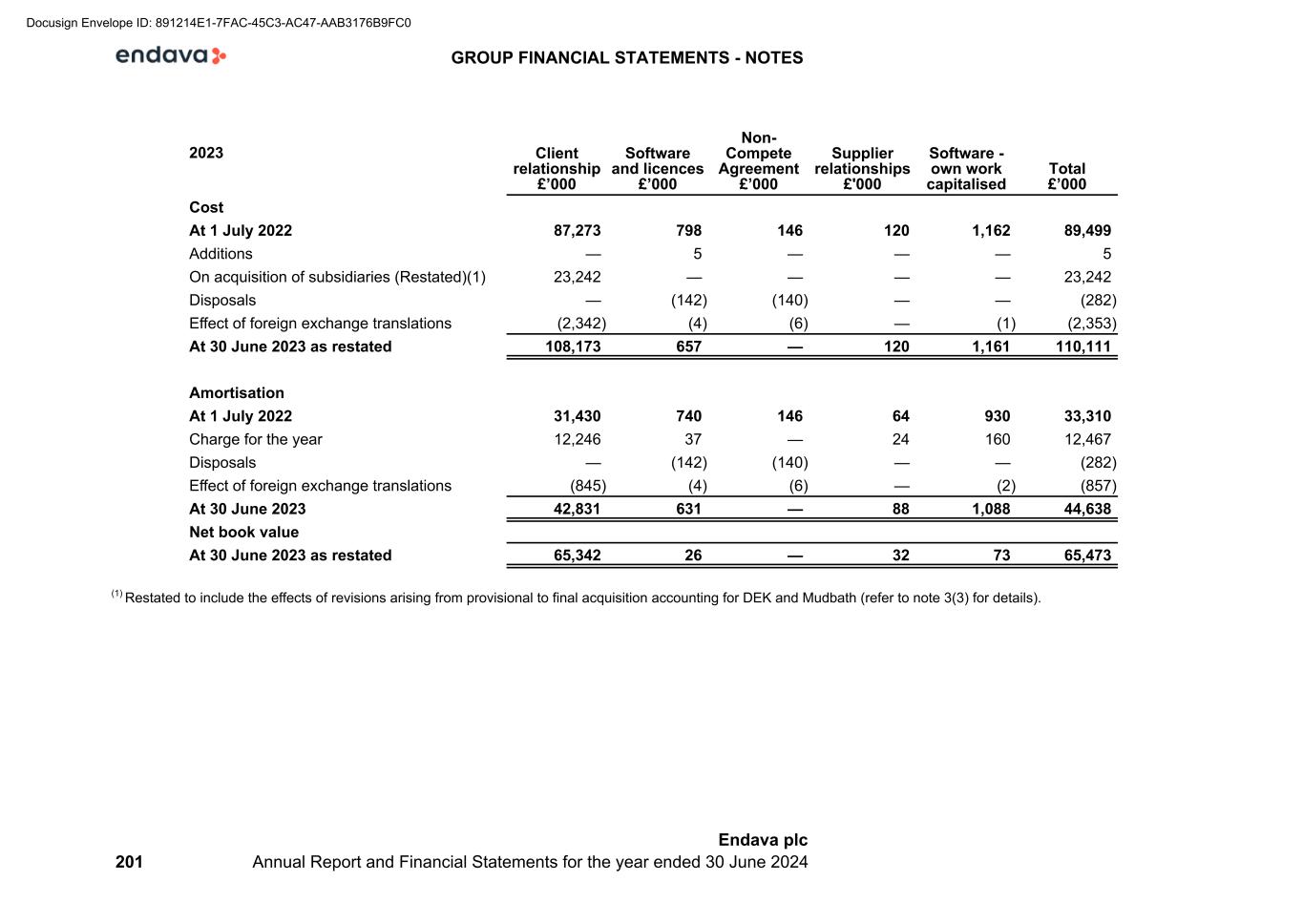
2023 Client relationship £’000 Software and licences £’000 Non- Compete Agreement £’000 Supplier relationships £'000 Software - own work capitalised Total £’000 Cost At 1 July 2022 87,273 798 146 120 1,162 89,499 Additions — 5 — — — 5 On acquisition of subsidiaries (Restated)(1) 23,242 — — — — 23,242 Disposals — (142) (140) — — (282) Effect of foreign exchange translations (2,342) (4) (6) — (1) (2,353) At 30 June 2023 as restated 108,173 657 — 120 1,161 110,111 Amortisation At 1 July 2022 31,430 740 146 64 930 33,310 Charge for the year 12,246 37 — 24 160 12,467 Disposals — (142) (140) — — (282) Effect of foreign exchange translations (845) (4) (6) — (2) (857) At 30 June 2023 42,831 631 — 88 1,088 44,638 Net book value At 30 June 2023 as restated 65,342 26 — 32 73 65,473 (1) Restated to include the effects of revisions arising from provisional to final acquisition accounting for DEK and Mudbath (refer to note 3(3) for details). GROUP FINANCIAL STATEMENTS - NOTES 201 Endava plc Annual Report and Financial Statements for the year ended 30 June 2024 Docusign Envelope ID: 891214E1-7FAC-45C3-AC47-AAB3176B9FC0
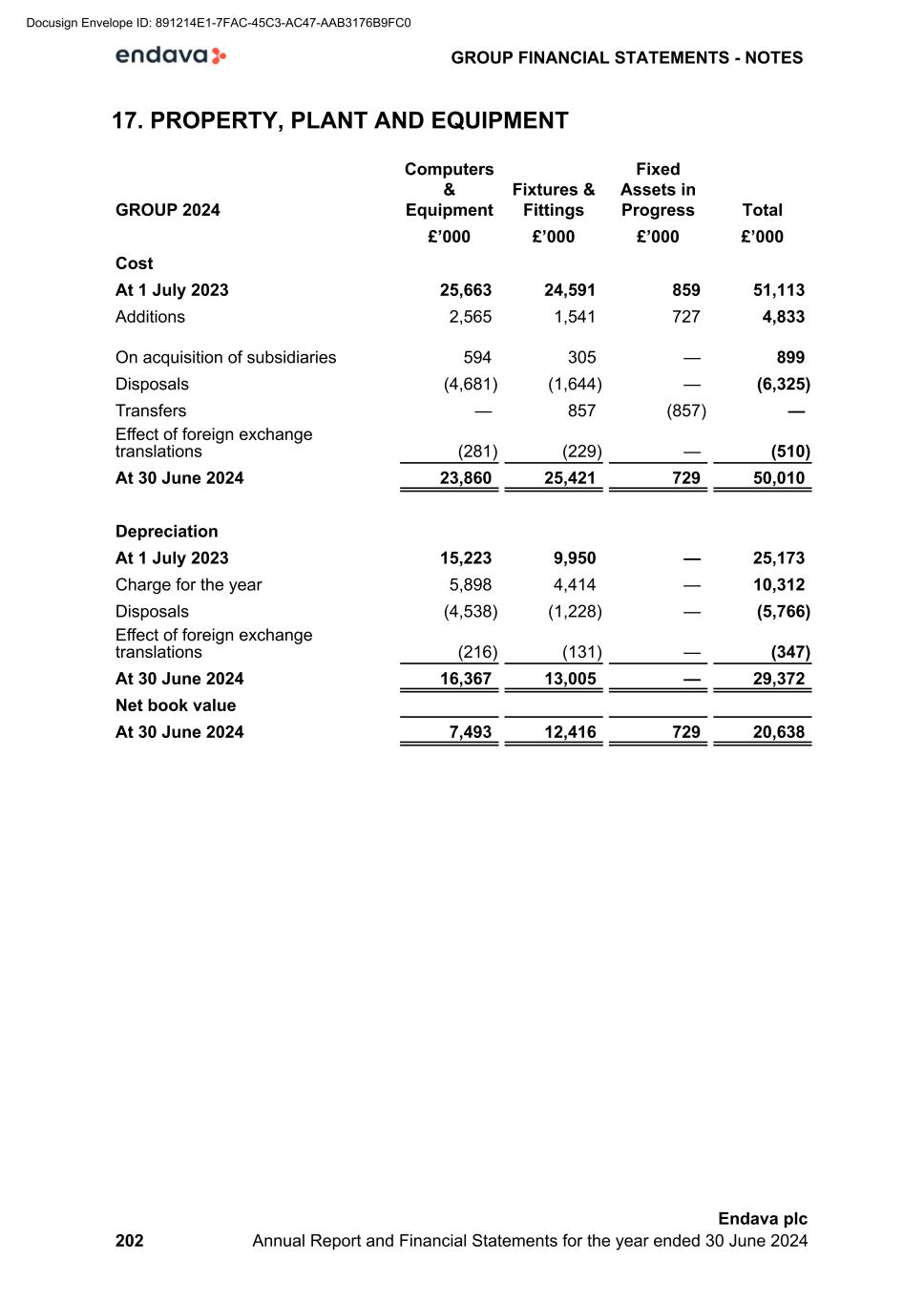
17. PROPERTY, PLANT AND EQUIPMENT GROUP 2024 Computers & Equipment Fixtures & Fittings Fixed Assets in Progress Total £’000 £’000 £’000 £’000 Cost At 1 July 2023 25,663 24,591 859 51,113 Additions 2,565 1,541 727 4,833 On acquisition of subsidiaries 594 305 — 899 Disposals (4,681) (1,644) — (6,325) Transfers — 857 (857) — Effect of foreign exchange translations (281) (229) — (510) At 30 June 2024 23,860 25,421 729 50,010 Depreciation At 1 July 2023 15,223 9,950 — 25,173 Charge for the year 5,898 4,414 — 10,312 Disposals (4,538) (1,228) — (5,766) Effect of foreign exchange translations (216) (131) — (347) At 30 June 2024 16,367 13,005 — 29,372 Net book value At 30 June 2024 7,493 12,416 729 20,638 GROUP FINANCIAL STATEMENTS - NOTES 202 Endava plc Annual Report and Financial Statements for the year ended 30 June 2024 Docusign Envelope ID: 891214E1-7FAC-45C3-AC47-AAB3176B9FC0
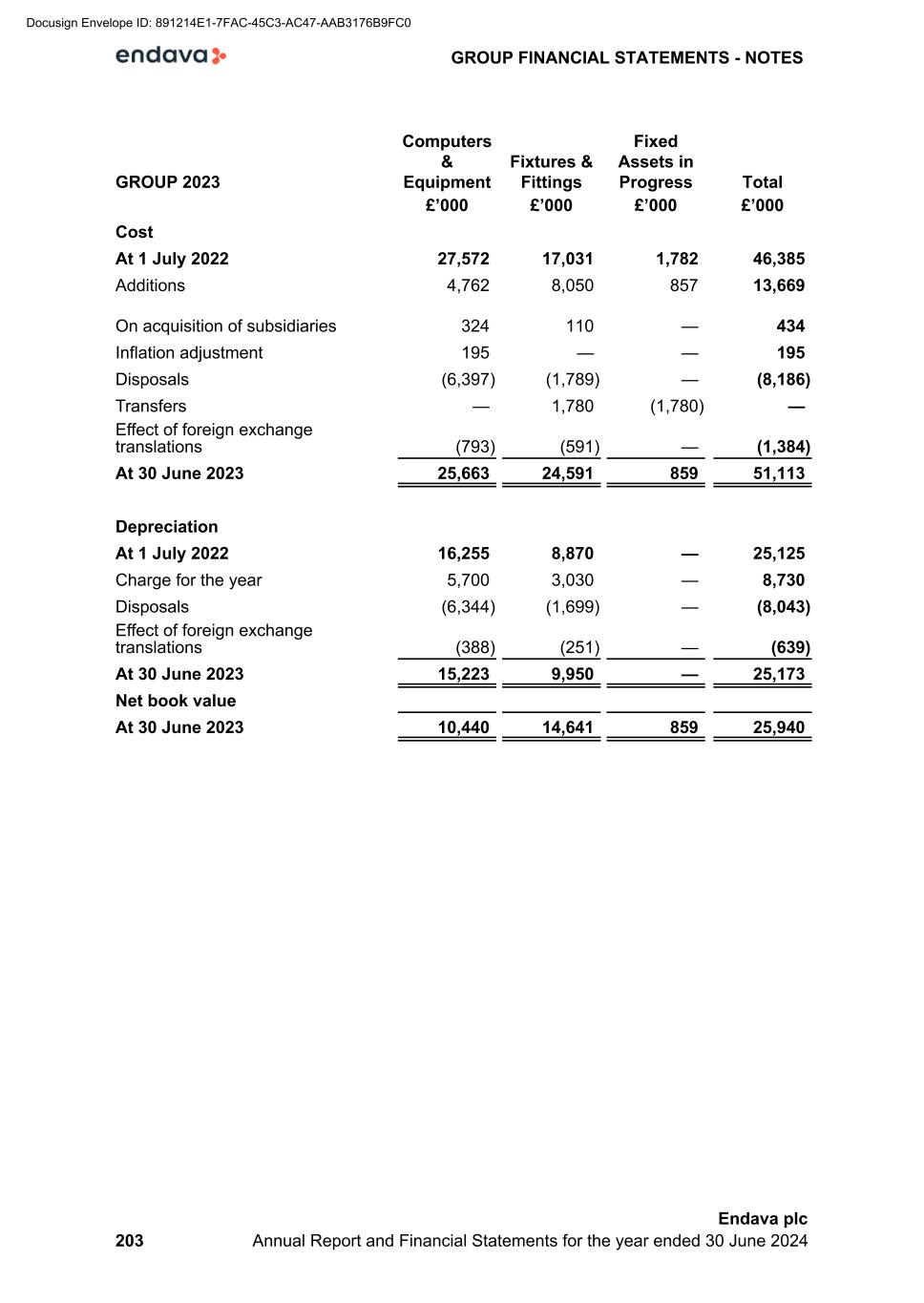
GROUP 2023 Computers & Equipment Fixtures & Fittings Fixed Assets in Progress Total £’000 £’000 £’000 £’000 Cost At 1 July 2022 27,572 17,031 1,782 46,385 Additions 4,762 8,050 857 13,669 On acquisition of subsidiaries 324 110 — 434 Inflation adjustment 195 — — 195 Disposals (6,397) (1,789) — (8,186) Transfers — 1,780 (1,780) — Effect of foreign exchange translations (793) (591) — (1,384) At 30 June 2023 25,663 24,591 859 51,113 Depreciation At 1 July 2022 16,255 8,870 — 25,125 Charge for the year 5,700 3,030 — 8,730 Disposals (6,344) (1,699) — (8,043) Effect of foreign exchange translations (388) (251) — (639) At 30 June 2023 15,223 9,950 — 25,173 Net book value At 30 June 2023 10,440 14,641 859 25,940 GROUP FINANCIAL STATEMENTS - NOTES 203 Endava plc Annual Report and Financial Statements for the year ended 30 June 2024 Docusign Envelope ID: 891214E1-7FAC-45C3-AC47-AAB3176B9FC0
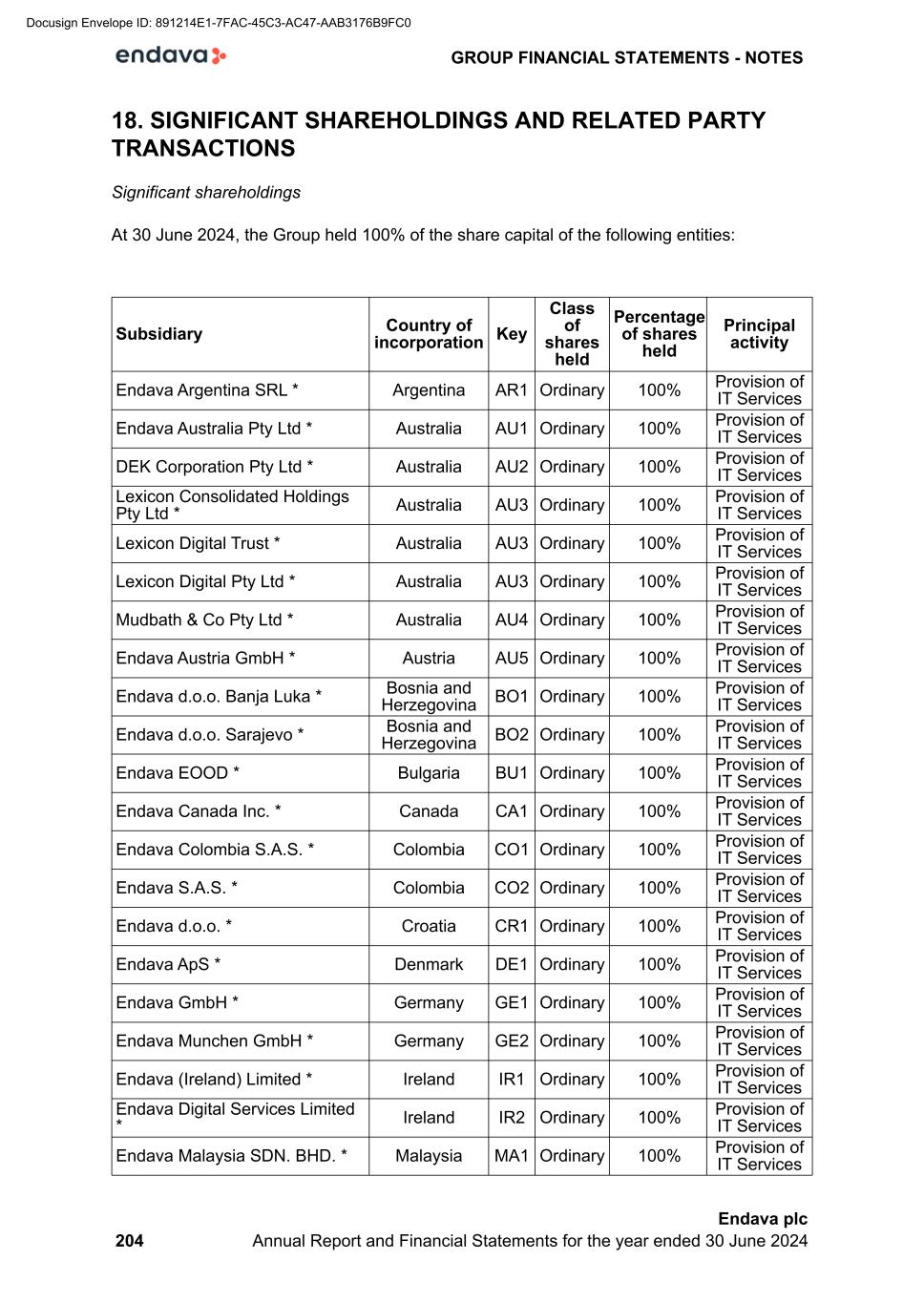
18. SIGNIFICANT SHAREHOLDINGS AND RELATED PARTY TRANSACTIONS Significant shareholdings At 30 June 2024, the Group held 100% of the share capital of the following entities: Subsidiary Country of incorporation Key Class of shares held Percentage of shares held Principal activity Endava Argentina SRL * Argentina AR1 Ordinary 100% Provision of IT Services Endava Australia Pty Ltd * Australia AU1 Ordinary 100% Provision of IT Services DEK Corporation Pty Ltd * Australia AU2 Ordinary 100% Provision of IT Services Lexicon Consolidated Holdings Pty Ltd * Australia AU3 Ordinary 100% Provision of IT Services Lexicon Digital Trust * Australia AU3 Ordinary 100% Provision of IT Services Lexicon Digital Pty Ltd * Australia AU3 Ordinary 100% Provision of IT Services Mudbath & Co Pty Ltd * Australia AU4 Ordinary 100% Provision of IT Services Endava Austria GmbH * Austria AU5 Ordinary 100% Provision of IT Services Endava d.o.o. Banja Luka * Bosnia and Herzegovina BO1 Ordinary 100% Provision of IT Services Endava d.o.o. Sarajevo * Bosnia and Herzegovina BO2 Ordinary 100% Provision of IT Services Endava EOOD * Bulgaria BU1 Ordinary 100% Provision of IT Services Endava Canada Inc. * Canada CA1 Ordinary 100% Provision of IT Services Endava Colombia S.A.S. * Colombia CO1 Ordinary 100% Provision of IT Services Endava S.A.S. * Colombia CO2 Ordinary 100% Provision of IT Services Endava d.o.o. * Croatia CR1 Ordinary 100% Provision of IT Services Endava ApS * Denmark DE1 Ordinary 100% Provision of IT Services Endava GmbH * Germany GE1 Ordinary 100% Provision of IT Services Endava Munchen GmbH * Germany GE2 Ordinary 100% Provision of IT Services Endava (Ireland) Limited * Ireland IR1 Ordinary 100% Provision of IT Services Endava Digital Services Limited * Ireland IR2 Ordinary 100% Provision of IT Services Endava Malaysia SDN. BHD. * Malaysia MA1 Ordinary 100% Provision of IT Services GROUP FINANCIAL STATEMENTS - NOTES 204 Endava plc Annual Report and Financial Statements for the year ended 30 June 2024 Docusign Envelope ID: 891214E1-7FAC-45C3-AC47-AAB3176B9FC0
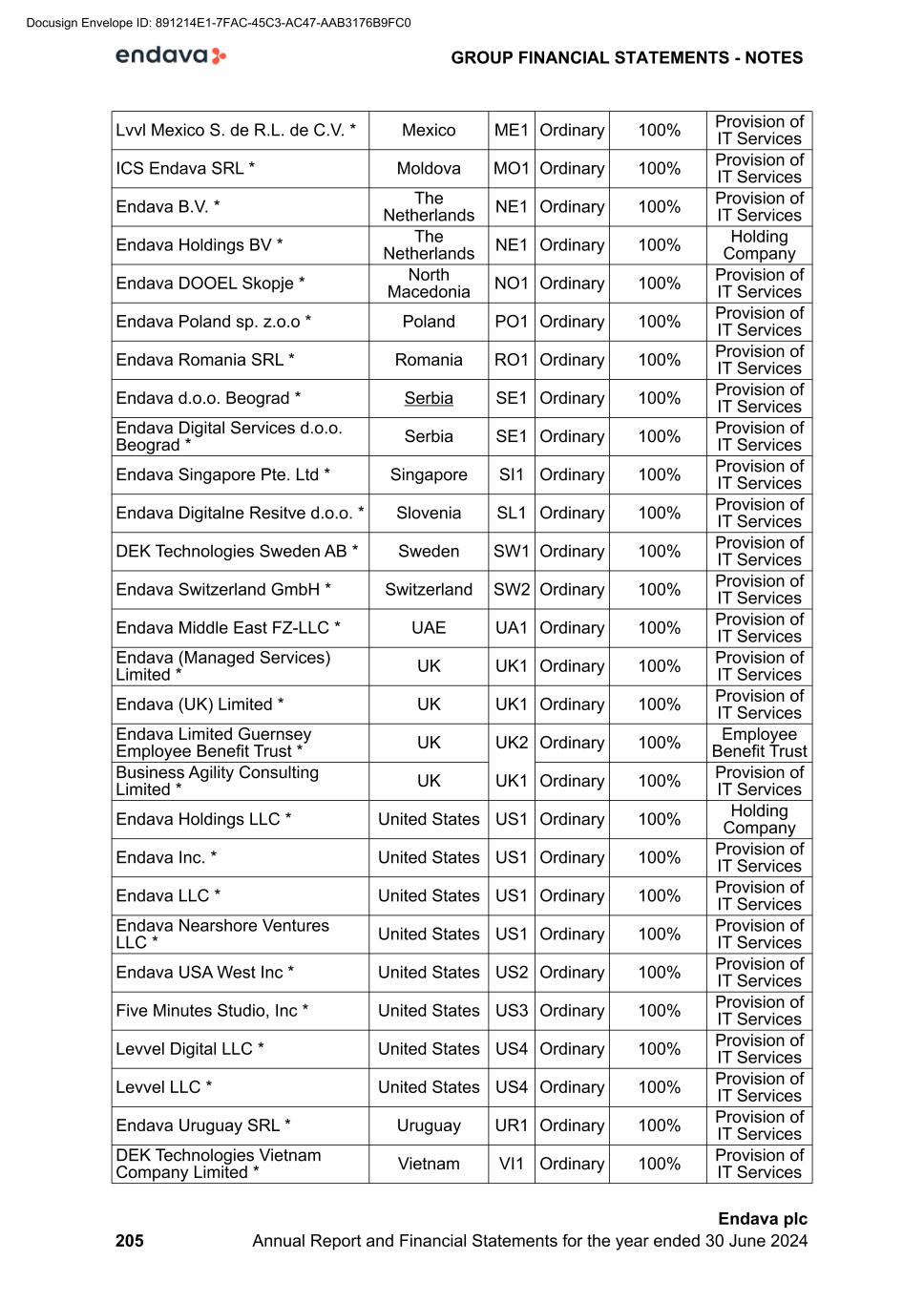
Lvvl Mexico S. de R.L. de C.V. * Mexico ME1 Ordinary 100% Provision of IT Services ICS Endava SRL * Moldova MO1 Ordinary 100% Provision of IT Services Endava B.V. * The Netherlands NE1 Ordinary 100% Provision of IT Services Endava Holdings BV * The Netherlands NE1 Ordinary 100% Holding Company Endava DOOEL Skopje * North Macedonia NO1 Ordinary 100% Provision of IT Services Endava Poland sp. z.o.o * Poland PO1 Ordinary 100% Provision of IT Services Endava Romania SRL * Romania RO1 Ordinary 100% Provision of IT Services Endava d.o.o. Beograd * Serbia SE1 Ordinary 100% Provision of IT Services Endava Digital Services d.o.o. Beograd * Serbia SE1 Ordinary 100% Provision of IT Services Endava Singapore Pte. Ltd * Singapore SI1 Ordinary 100% Provision of IT Services Endava Digitalne Resitve d.o.o. * Slovenia SL1 Ordinary 100% Provision of IT Services DEK Technologies Sweden AB * Sweden SW1 Ordinary 100% Provision of IT Services Endava Switzerland GmbH * Switzerland SW2 Ordinary 100% Provision of IT Services Endava Middle East FZ-LLC * UAE UA1 Ordinary 100% Provision of IT Services Endava (Managed Services) Limited * UK UK1 Ordinary 100% Provision of IT Services Endava (UK) Limited * UK UK1 Ordinary 100% Provision of IT Services Endava Limited Guernsey Employee Benefit Trust * UK UK2 Ordinary 100% Employee Benefit Trust Business Agility Consulting Limited * UK UK1 Ordinary 100% Provision of IT Services Endava Holdings LLC * United States US1 Ordinary 100% Holding Company Endava Inc. * United States US1 Ordinary 100% Provision of IT Services Endava LLC * United States US1 Ordinary 100% Provision of IT Services Endava Nearshore Ventures LLC * United States US1 Ordinary 100% Provision of IT Services Endava USA West Inc * United States US2 Ordinary 100% Provision of IT Services Five Minutes Studio, Inc * United States US3 Ordinary 100% Provision of IT Services Levvel Digital LLC * United States US4 Ordinary 100% Provision of IT Services Levvel LLC * United States US4 Ordinary 100% Provision of IT Services Endava Uruguay SRL * Uruguay UR1 Ordinary 100% Provision of IT Services DEK Technologies Vietnam Company Limited * Vietnam VI1 Ordinary 100% Provision of IT Services GROUP FINANCIAL STATEMENTS - NOTES 205 Endava plc Annual Report and Financial Statements for the year ended 30 June 2024 Docusign Envelope ID: 891214E1-7FAC-45C3-AC47-AAB3176B9FC0

Endava Limited Liability Company * Vietnam VI2 Ordinary 100% Provision of IT Services Endava Delaware Holdings, Inc. ** United States US4 Ordinary 100% Provision of IT Services GalaxE Group, Inc ** United States US4 Ordinary 100% Provision of IT Services GalaxE Healthcare Solutions, LLC ** United States US3 Ordinary 100% Provision of IT Services GalaxE Solutions LLC ** United States US3 Ordinary 100% Provision of IT Services GalaxE. Healthcare Solutions Ireland Limited ** Ireland IR3 Ordinary 100% Provision of IT Services GalaxE.Healthcare Solutions Japan, KK ** Japan JA1 Ordinary 100% Provision of IT Services GalaxE.Healthcare Solutions Singapore Private Ltd ** Singapore SI2 Ordinary 100% Provision of IT Services GalaxE Security Solutions LLC ** United States US3 Ordinary 100% Provision of IT Services GalaxE Solutions (HK) Limited ** Hong Kong HK1 Ordinary 100% Provision of IT Services GalaxE Solutions Information Technology (Shanghai) Co.,Ltd ** China HK2 Ordinary 100% Provision of IT Services GalaxE Solutions India Private Limited ** India IN1 Ordinary 100% Provision of IT Services GalaxE Solutions US Holdings Inc ** United States US3 Ordinary 100% Provision of IT Services GalaxE Solutions Canada, ULC ** Canada CA2 Ordinary 100% Provision of IT Services GalaxE Systems LLC ** United States US3 Ordinary 100% Provision of IT Services TLM Partners, Inc. ** United States US5 Ordinary 100% Provision of IT Services TLM Partenaires Inc. ** Canada US5 Ordinary 100% Provision of IT Services TLM Partners Entertainment EMEA limited ** Ireland IR3 Ordinary 100% Provision of IT Services EQ Tek spółka z ograniczoną odpowiedzialnością ** Poland PO2 Ordinary 100% Provision of IT Services * Existing subsidiary as at 1 July 2023 ** Newly acquired subsidiary in the financial year ended 30 June 2024 Key Registered Office Address AR1 Calle Urquiza 2284, Ciudat de Rosario 9, Provincia Santa Fe, Argentina AU1 Level 10, 455 Bourke Street Melbourne VIC 300, Australia AU2 Corner of Riggall Street and Maldon Street, Broadmeadows VIC 3047, Australia AU3 TOWER TWO, COLLINS SQUARE, LEVEL 36 727, COLLINS STREET DOCKLANDS VIC 3008, Australia AU4 Suite 8, 710 Hunter St, Newcastle NSW 2302, Australia AU5 Millennium Tower 23rd Floor, Handelskai 94-96, 1200 Vienna, Austria BO1 I Krajiškog korpusa no. 39, 78000 Banja Luka, Bosnia and Herzegovina BO2 Zmaja od Bosne 47C, Sarajevo - Novo Sarajevo, Bosnia and Herzegovina BU1 8 Racho Dimchеv Str., Sredetz Region, Sofia, 1000, Bulgaria GROUP FINANCIAL STATEMENTS - NOTES 206 Endava plc Annual Report and Financial Statements for the year ended 30 June 2024 Docusign Envelope ID: 891214E1-7FAC-45C3-AC47-AAB3176B9FC0
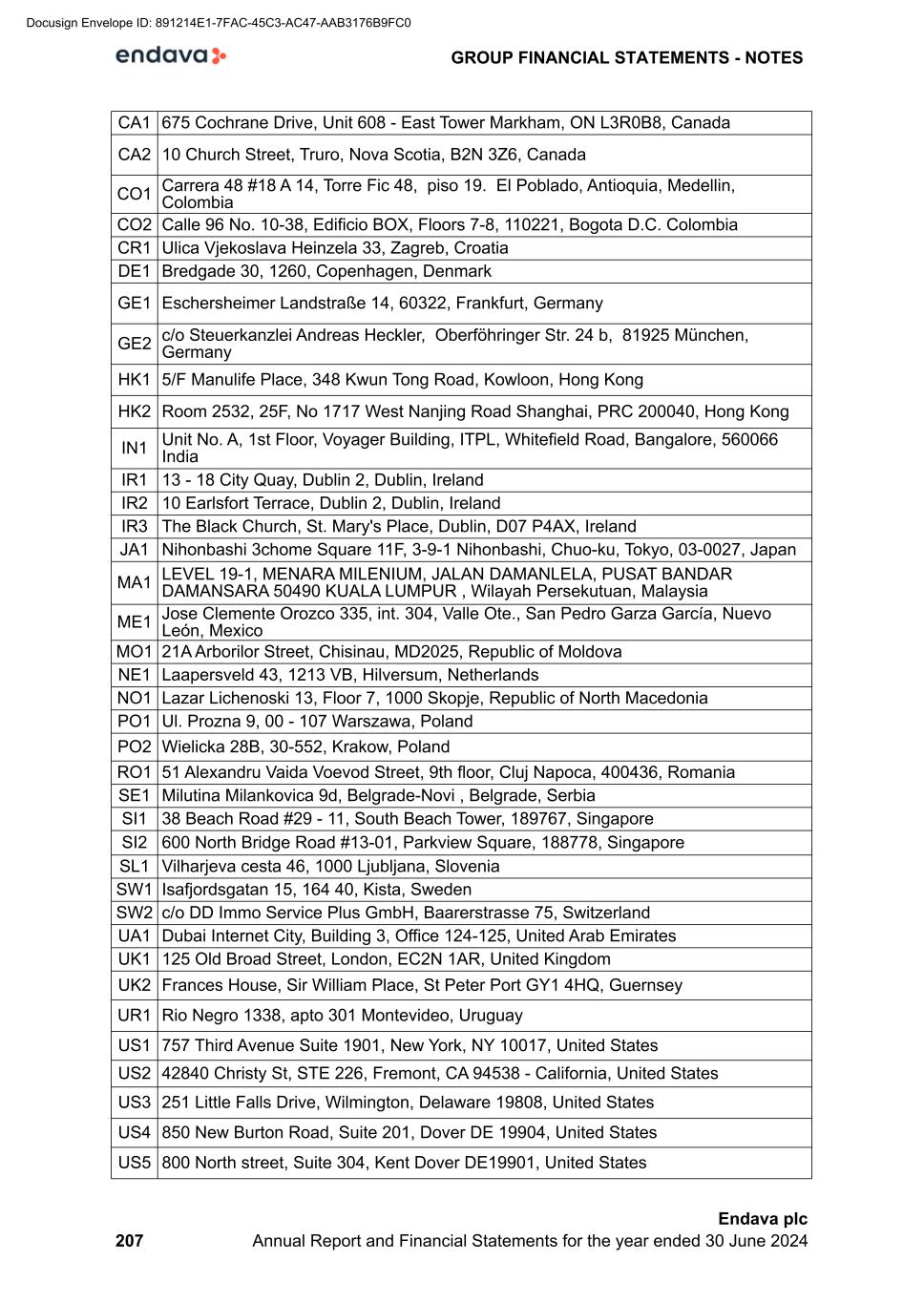
CA1 675 Cochrane Drive, Unit 608 - East Tower Markham, ON L3R0B8, Canada CA2 10 Church Street, Truro, Nova Scotia, B2N 3Z6, Canada CO1 Carrera 48 #18 A 14, Torre Fic 48, piso 19. El Poblado, Antioquia, Medellin, Colombia CO2 Calle 96 No. 10-38, Edificio BOX, Floors 7-8, 110221, Bogota D.C. Colombia CR1 Ulica Vjekoslava Heinzela 33, Zagreb, Croatia DE1 Bredgade 30, 1260, Copenhagen, Denmark GE1 Eschersheimer Landstraße 14, 60322, Frankfurt, Germany GE2 c/o Steuerkanzlei Andreas Heckler, Oberföhringer Str. 24 b, 81925 München, Germany HK1 5/F Manulife Place, 348 Kwun Tong Road, Kowloon, Hong Kong HK2 Room 2532, 25F, No 1717 West Nanjing Road Shanghai, PRC 200040, Hong Kong IN1 Unit No. A, 1st Floor, Voyager Building, ITPL, Whitefield Road, Bangalore, 560066 India IR1 13 - 18 City Quay, Dublin 2, Dublin, Ireland IR2 10 Earlsfort Terrace, Dublin 2, Dublin, Ireland IR3 The Black Church, St. Mary's Place, Dublin, D07 P4AX, Ireland JA1 Nihonbashi 3chome Square 11F, 3-9-1 Nihonbashi, Chuo-ku, Tokyo, 03-0027, Japan MA1 LEVEL 19-1, MENARA MILENIUM, JALAN DAMANLELA, PUSAT BANDAR DAMANSARA 50490 KUALA LUMPUR , Wilayah Persekutuan, Malaysia ME1 Jose Clemente Orozco 335, int. 304, Valle Ote., San Pedro Garza García, Nuevo León, Mexico MO1 21A Arborilor Street, Chisinau, MD2025, Republic of Moldova NE1 Laapersveld 43, 1213 VB, Hilversum, Netherlands NO1 Lazar Lichenoski 13, Floor 7, 1000 Skopje, Republic of North Macedonia PO1 Ul. Prozna 9, 00 - 107 Warszawa, Poland PO2 Wielicka 28B, 30-552, Krakow, Poland RO1 51 Alexandru Vaida Voevod Street, 9th floor, Cluj Napoca, 400436, Romania SE1 Milutina Milankovica 9d, Belgrade-Novi , Belgrade, Serbia SI1 38 Beach Road #29 - 11, South Beach Tower, 189767, Singapore SI2 600 North Bridge Road #13-01, Parkview Square, 188778, Singapore SL1 Vilharjeva cesta 46, 1000 Ljubljana, Slovenia SW1 Isafjordsgatan 15, 164 40, Kista, Sweden SW2 c/o DD Immo Service Plus GmbH, Baarerstrasse 75, Switzerland UA1 Dubai Internet City, Building 3, Office 124-125, United Arab Emirates UK1 125 Old Broad Street, London, EC2N 1AR, United Kingdom UK2 Frances House, Sir William Place, St Peter Port GY1 4HQ, Guernsey UR1 Rio Negro 1338, apto 301 Montevideo, Uruguay US1 757 Third Avenue Suite 1901, New York, NY 10017, United States US2 42840 Christy St, STE 226, Fremont, CA 94538 - California, United States US3 251 Little Falls Drive, Wilmington, Delaware 19808, United States US4 850 New Burton Road, Suite 201, Dover DE 19904, United States US5 800 North street, Suite 304, Kent Dover DE19901, United States GROUP FINANCIAL STATEMENTS - NOTES 207 Endava plc Annual Report and Financial Statements for the year ended 30 June 2024 Docusign Envelope ID: 891214E1-7FAC-45C3-AC47-AAB3176B9FC0
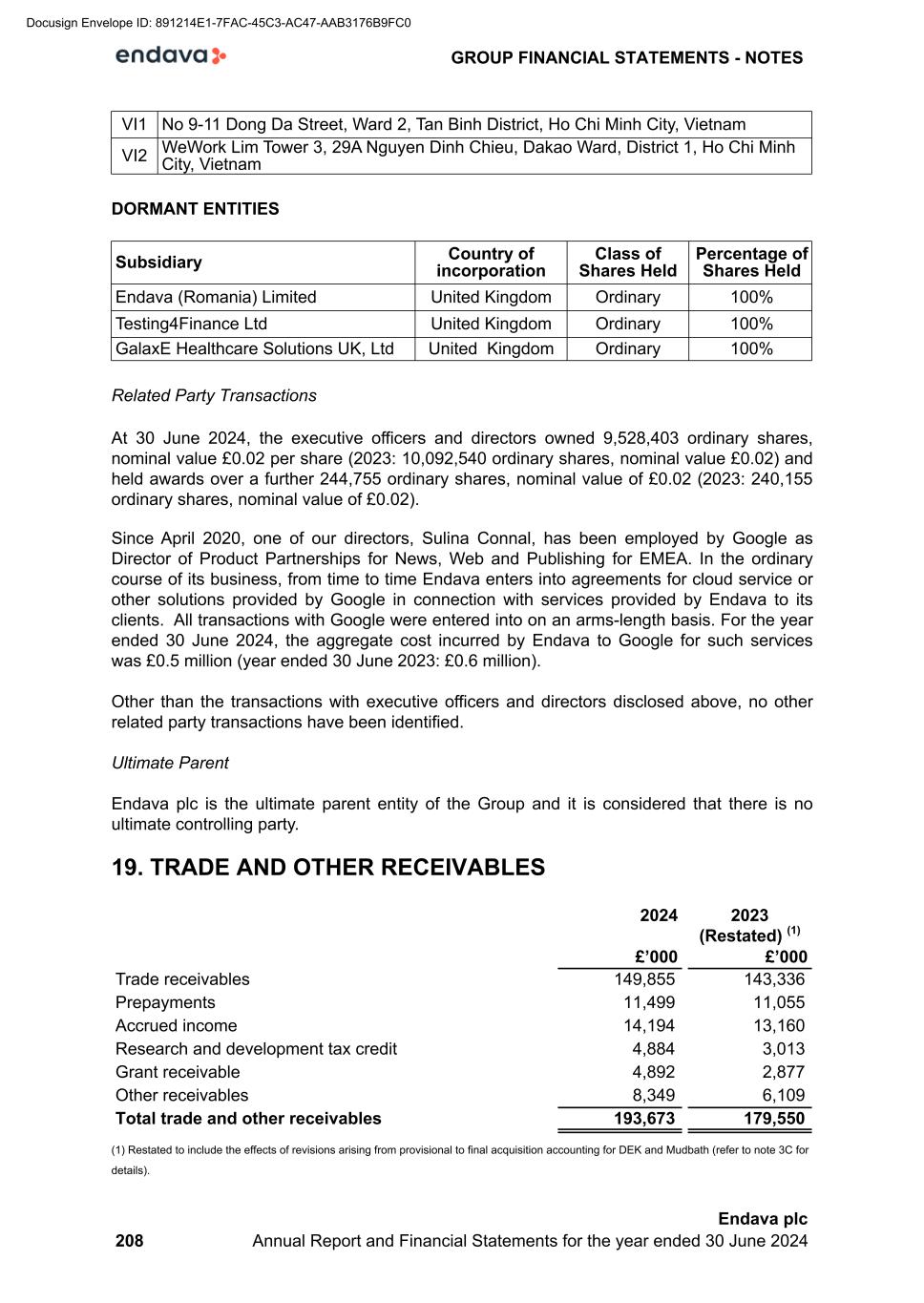
VI1 No 9-11 Dong Da Street, Ward 2, Tan Binh District, Ho Chi Minh City, Vietnam VI2 WeWork Lim Tower 3, 29A Nguyen Dinh Chieu, Dakao Ward, District 1, Ho Chi Minh City, Vietnam DORMANT ENTITIES Subsidiary Country of incorporation Class of Shares Held Percentage of Shares Held Endava (Romania) Limited United Kingdom Ordinary 100% Testing4Finance Ltd United Kingdom Ordinary 100% GalaxE Healthcare Solutions UK, Ltd United Kingdom Ordinary 100% Related Party Transactions At 30 June 2024, the executive officers and directors owned 9,528,403 ordinary shares, nominal value £0.02 per share (2023: 10,092,540 ordinary shares, nominal value £0.02) and held awards over a further 244,755 ordinary shares, nominal value of £0.02 (2023: 240,155 ordinary shares, nominal value of £0.02). Since April 2020, one of our directors, Sulina Connal, has been employed by Google as Director of Product Partnerships for News, Web and Publishing for EMEA. In the ordinary course of its business, from time to time Endava enters into agreements for cloud service or other solutions provided by Google in connection with services provided by Endava to its clients. All transactions with Google were entered into on an arms-length basis. For the year ended 30 June 2024, the aggregate cost incurred by Endava to Google for such services was £0.5 million (year ended 30 June 2023: £0.6 million). Other than the transactions with executive officers and directors disclosed above, no other related party transactions have been identified. Ultimate Parent Endava plc is the ultimate parent entity of the Group and it is considered that there is no ultimate controlling party. 19. TRADE AND OTHER RECEIVABLES 2024 2023 (Restated) (1) £’000 £’000 Trade receivables 149,855 143,336 Prepayments 11,499 11,055 Accrued income 14,194 13,160 Research and development tax credit 4,884 3,013 Grant receivable 4,892 2,877 Other receivables 8,349 6,109 Total trade and other receivables 193,673 179,550 (1) Restated to include the effects of revisions arising from provisional to final acquisition accounting for DEK and Mudbath (refer to note 3C for details). GROUP FINANCIAL STATEMENTS - NOTES 208 Endava plc Annual Report and Financial Statements for the year ended 30 June 2024 Docusign Envelope ID: 891214E1-7FAC-45C3-AC47-AAB3176B9FC0
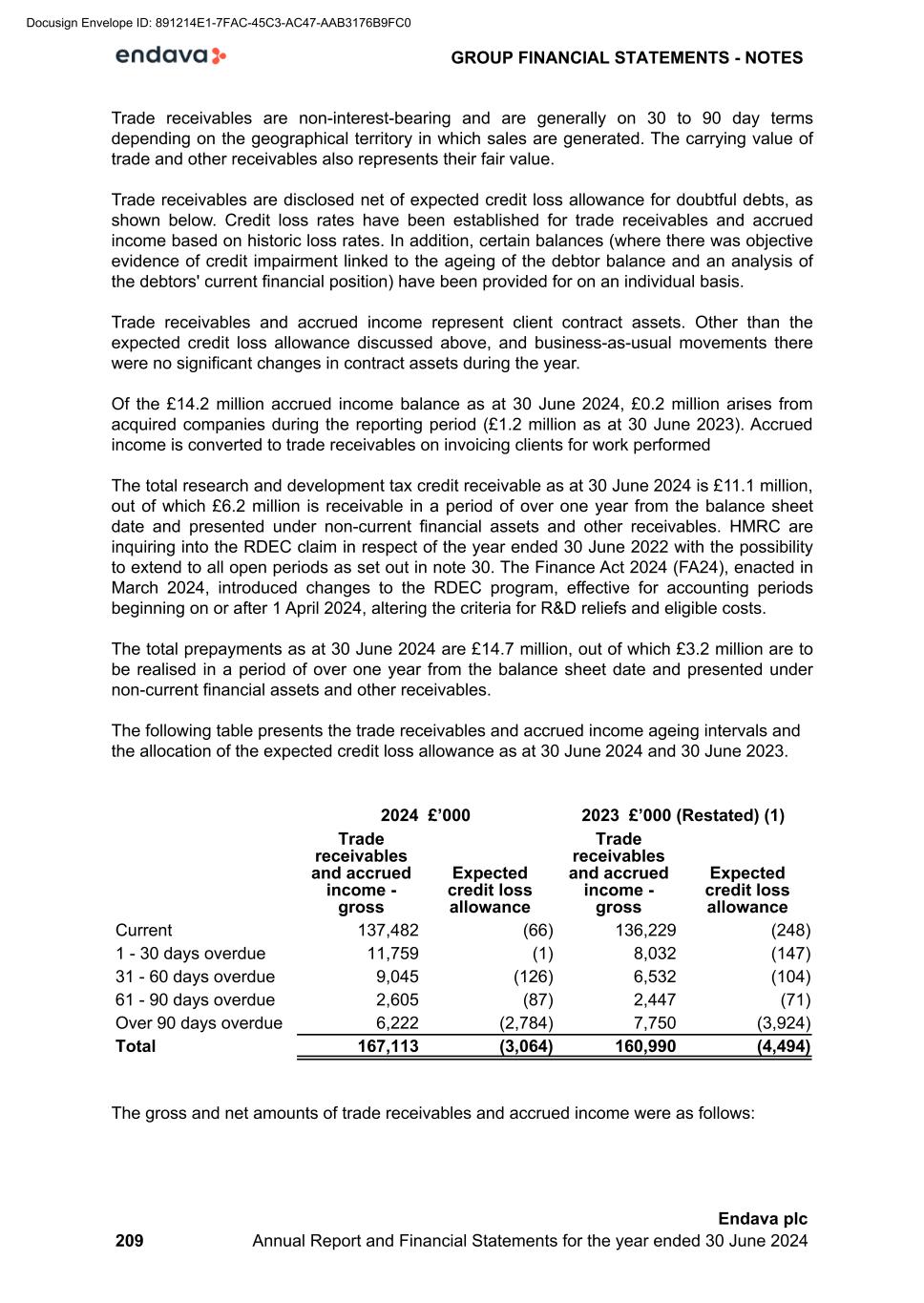
Trade receivables are non-interest-bearing and are generally on 30 to 90 day terms depending on the geographical territory in which sales are generated. The carrying value of trade and other receivables also represents their fair value. Trade receivables are disclosed net of expected credit loss allowance for doubtful debts, as shown below. Credit loss rates have been established for trade receivables and accrued income based on historic loss rates. In addition, certain balances (where there was objective evidence of credit impairment linked to the ageing of the debtor balance and an analysis of the debtors' current financial position) have been provided for on an individual basis. Trade receivables and accrued income represent client contract assets. Other than the expected credit loss allowance discussed above, and business-as-usual movements there were no significant changes in contract assets during the year. Of the £14.2 million accrued income balance as at 30 June 2024, £0.2 million arises from acquired companies during the reporting period (£1.2 million as at 30 June 2023). Accrued income is converted to trade receivables on invoicing clients for work performed The total research and development tax credit receivable as at 30 June 2024 is £11.1 million, out of which £6.2 million is receivable in a period of over one year from the balance sheet date and presented under non-current financial assets and other receivables. HMRC are inquiring into the RDEC claim in respect of the year ended 30 June 2022 with the possibility to extend to all open periods as set out in note 30. The Finance Act 2024 (FA24), enacted in March 2024, introduced changes to the RDEC program, effective for accounting periods beginning on or after 1 April 2024, altering the criteria for R&D reliefs and eligible costs. The total prepayments as at 30 June 2024 are £14.7 million, out of which £3.2 million are to be realised in a period of over one year from the balance sheet date and presented under non-current financial assets and other receivables. The following table presents the trade receivables and accrued income ageing intervals and the allocation of the expected credit loss allowance as at 30 June 2024 and 30 June 2023. 2024 £’000 2023 £’000 (Restated) (1) Trade receivables and accrued income - gross Expected credit loss allowance Trade receivables and accrued income - gross Expected credit loss allowance Current 137,482 (66) 136,229 (248) 1 - 30 days overdue 11,759 (1) 8,032 (147) 31 - 60 days overdue 9,045 (126) 6,532 (104) 61 - 90 days overdue 2,605 (87) 2,447 (71) Over 90 days overdue 6,222 (2,784) 7,750 (3,924) Total 167,113 (3,064) 160,990 (4,494) The gross and net amounts of trade receivables and accrued income were as follows: GROUP FINANCIAL STATEMENTS - NOTES 209 Endava plc Annual Report and Financial Statements for the year ended 30 June 2024 Docusign Envelope ID: 891214E1-7FAC-45C3-AC47-AAB3176B9FC0

2024 2023 (Restated) (1) £’000 £’000 Trade receivables - gross 152,919 147,830 Expected credit loss allowance (3,064) (4,494) Trade receivables - net 149,855 143,336 (1) Restated to include the effects of revisions arising from provisional to final acquisition accounting for DEK and Mudbath (refer to note 3C for details). 2024 2023 £’000 £’000 Accrued income - gross 14,194 13,160 Expected credit loss allowance — — Accrued income - net 14,194 13,160 Movements in the expected credit loss allowance were as follows: 2024 2023 £’000 £’000 As at 1 July 4,494 4,023 Provided in the year 2,570 6,181 Released in the year (2,228) (5,249) Utilised in the year (1,665) (301) Effect of foreign exchange translations (107) (160) As at 30 June 3,064 4,494 20. TRADE AND OTHER PAYABLES 2024 2023 £’000 (Restated) (1) Trade payables 10,976 5,480 Other taxation and social security 18,412 19,290 Client volume discounts/rebates 17,922 1,011 Other liabilities 6,222 5,029 Accruals 56,890 55,195 Deferred income 6,147 5,823 Total trade and other payables 116,569 91,828 (1) Restated to include the effects of revisions arising from provisional to final acquisition accounting for DEK and Mudbath (refer to note 3(3) for details). £1.0 million of client volume discounts/rebates, which were previously disclosed in Other liabilities, have been reclassified from Other liabilities to Client volume discounts/rebates in the 2023 comparative period. Deferred income represents client contract liabilities at year end where cash was received from clients but Endava is yet to perform the work. £4.5 million of the deferred income recognised at 1 July 2023 was recognised as revenue during the year (2023: £3.3 million). Other than business-as-usual movements there were no significant changes in the deferred GROUP FINANCIAL STATEMENTS - NOTES 210 Endava plc Annual Report and Financial Statements for the year ended 30 June 2024 Docusign Envelope ID: 891214E1-7FAC-45C3-AC47-AAB3176B9FC0
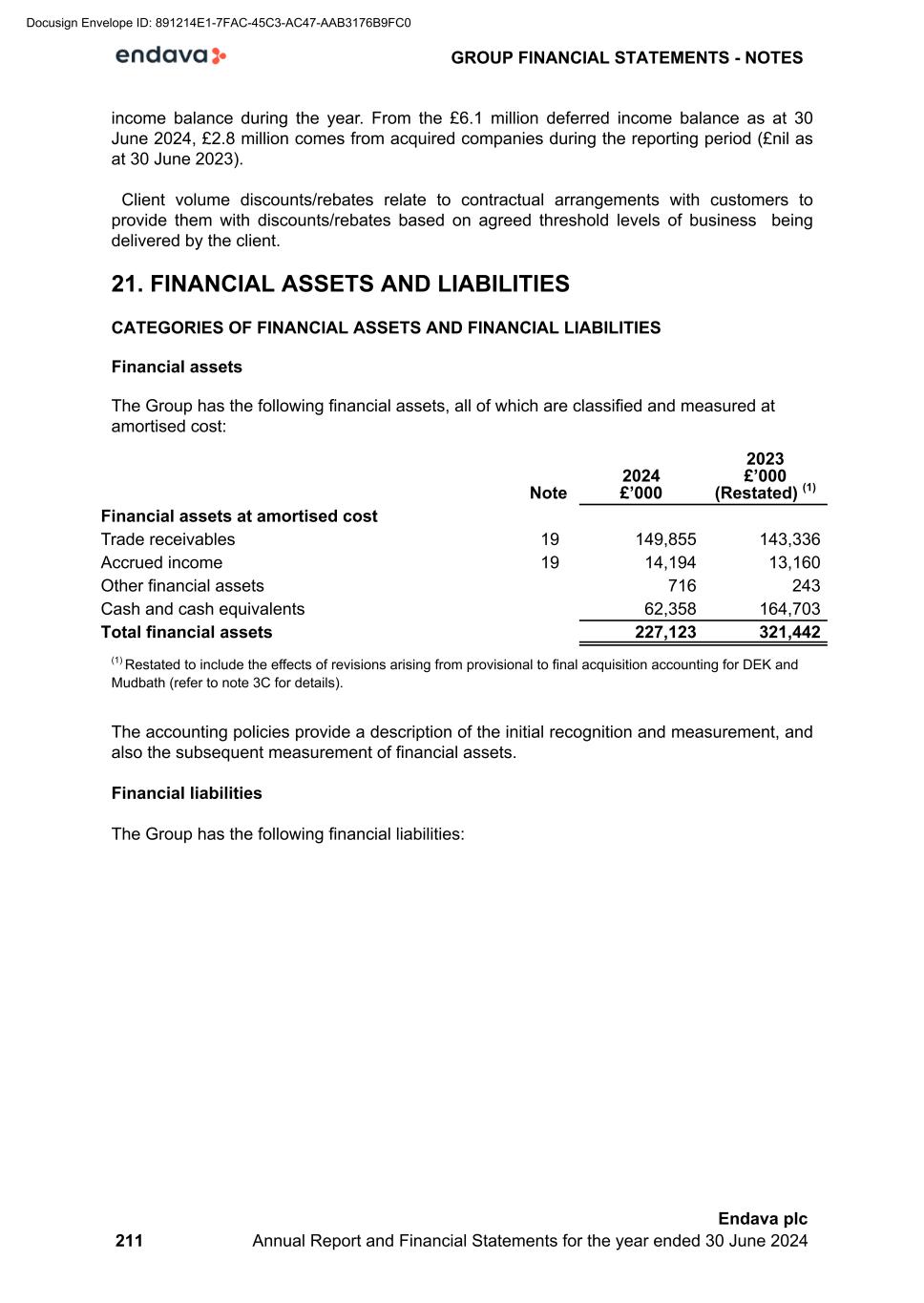
income balance during the year. From the £6.1 million deferred income balance as at 30 June 2024, £2.8 million comes from acquired companies during the reporting period (£nil as at 30 June 2023). Client volume discounts/rebates relate to contractual arrangements with customers to provide them with discounts/rebates based on agreed threshold levels of business being delivered by the client. 21. FINANCIAL ASSETS AND LIABILITIES CATEGORIES OF FINANCIAL ASSETS AND FINANCIAL LIABILITIES Financial assets The Group has the following financial assets, all of which are classified and measured at amortised cost: Note 2024 £’000 2023 £’000 (Restated) (1) Financial assets at amortised cost Trade receivables 19 149,855 143,336 Accrued income 19 14,194 13,160 Other financial assets 716 243 Cash and cash equivalents 62,358 164,703 Total financial assets 227,123 321,442 (1) Restated to include the effects of revisions arising from provisional to final acquisition accounting for DEK and Mudbath (refer to note 3C for details). The accounting policies provide a description of the initial recognition and measurement, and also the subsequent measurement of financial assets. Financial liabilities The Group has the following financial liabilities: GROUP FINANCIAL STATEMENTS - NOTES 211 Endava plc Annual Report and Financial Statements for the year ended 30 June 2024 Docusign Envelope ID: 891214E1-7FAC-45C3-AC47-AAB3176B9FC0
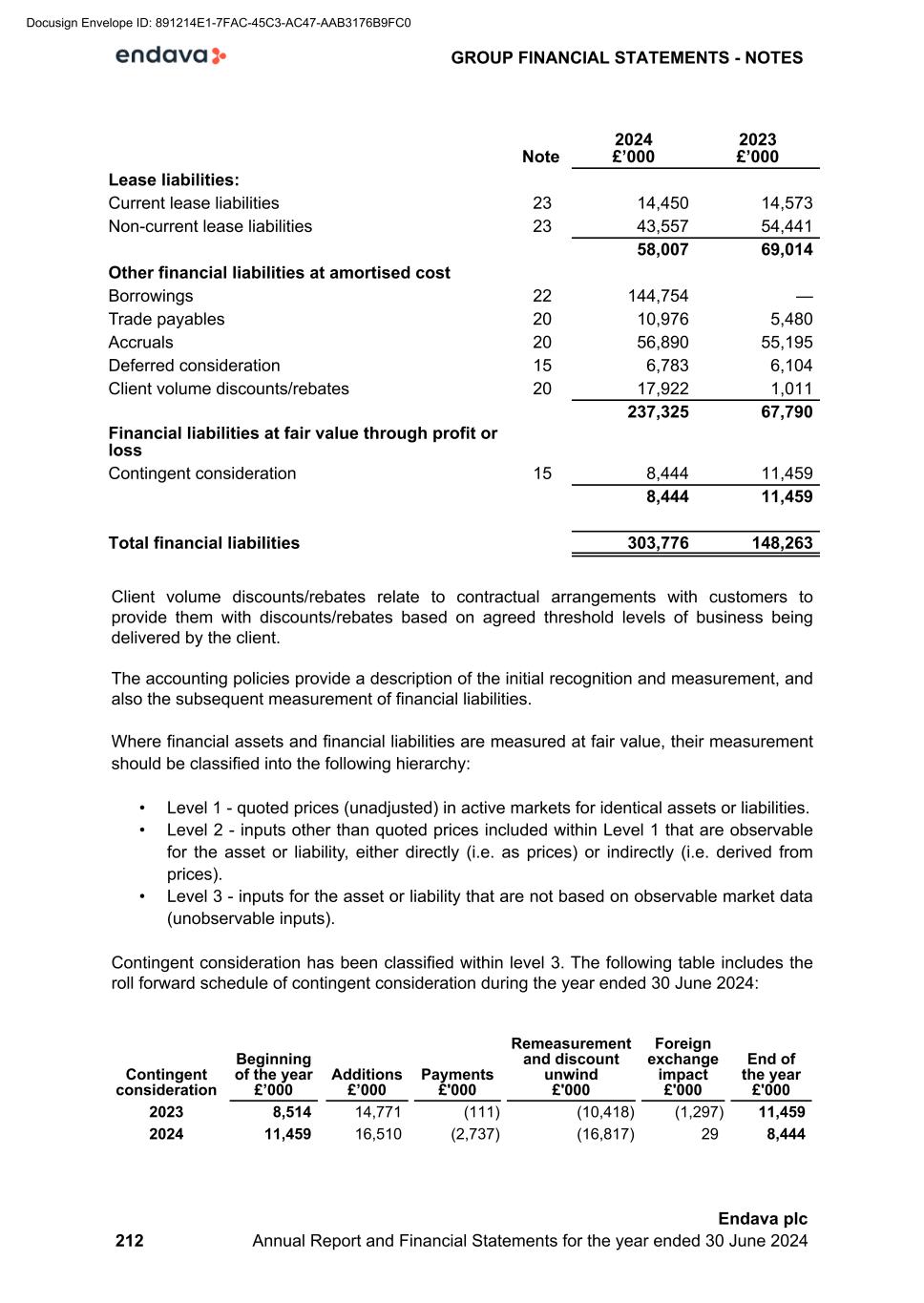
Note 2024 £’000 2023 £’000 Lease liabilities: Current lease liabilities 23 14,450 14,573 Non-current lease liabilities 23 43,557 54,441 58,007 69,014 Other financial liabilities at amortised cost Borrowings 22 144,754 — Trade payables 20 10,976 5,480 Accruals 20 56,890 55,195 Deferred consideration 15 6,783 6,104 Client volume discounts/rebates 20 17,922 1,011 237,325 67,790 Financial liabilities at fair value through profit or loss Contingent consideration 15 8,444 11,459 8,444 11,459 Total financial liabilities 303,776 148,263 Client volume discounts/rebates relate to contractual arrangements with customers to provide them with discounts/rebates based on agreed threshold levels of business being delivered by the client. The accounting policies provide a description of the initial recognition and measurement, and also the subsequent measurement of financial liabilities. Where financial assets and financial liabilities are measured at fair value, their measurement should be classified into the following hierarchy: • Level 1 - quoted prices (unadjusted) in active markets for identical assets or liabilities. • Level 2 - inputs other than quoted prices included within Level 1 that are observable for the asset or liability, either directly (i.e. as prices) or indirectly (i.e. derived from prices). • Level 3 - inputs for the asset or liability that are not based on observable market data (unobservable inputs). Contingent consideration has been classified within level 3. The following table includes the roll forward schedule of contingent consideration during the year ended 30 June 2024: Contingent consideration Beginning of the year £’000 Additions £’000 Payments £'000 Remeasurement and discount unwind £'000 Foreign exchange impact £'000 End of the year £'000 2023 8,514 14,771 (111) (10,418) (1,297) 11,459 2024 11,459 16,510 (2,737) (16,817) 29 8,444 GROUP FINANCIAL STATEMENTS - NOTES 212 Endava plc Annual Report and Financial Statements for the year ended 30 June 2024 Docusign Envelope ID: 891214E1-7FAC-45C3-AC47-AAB3176B9FC0
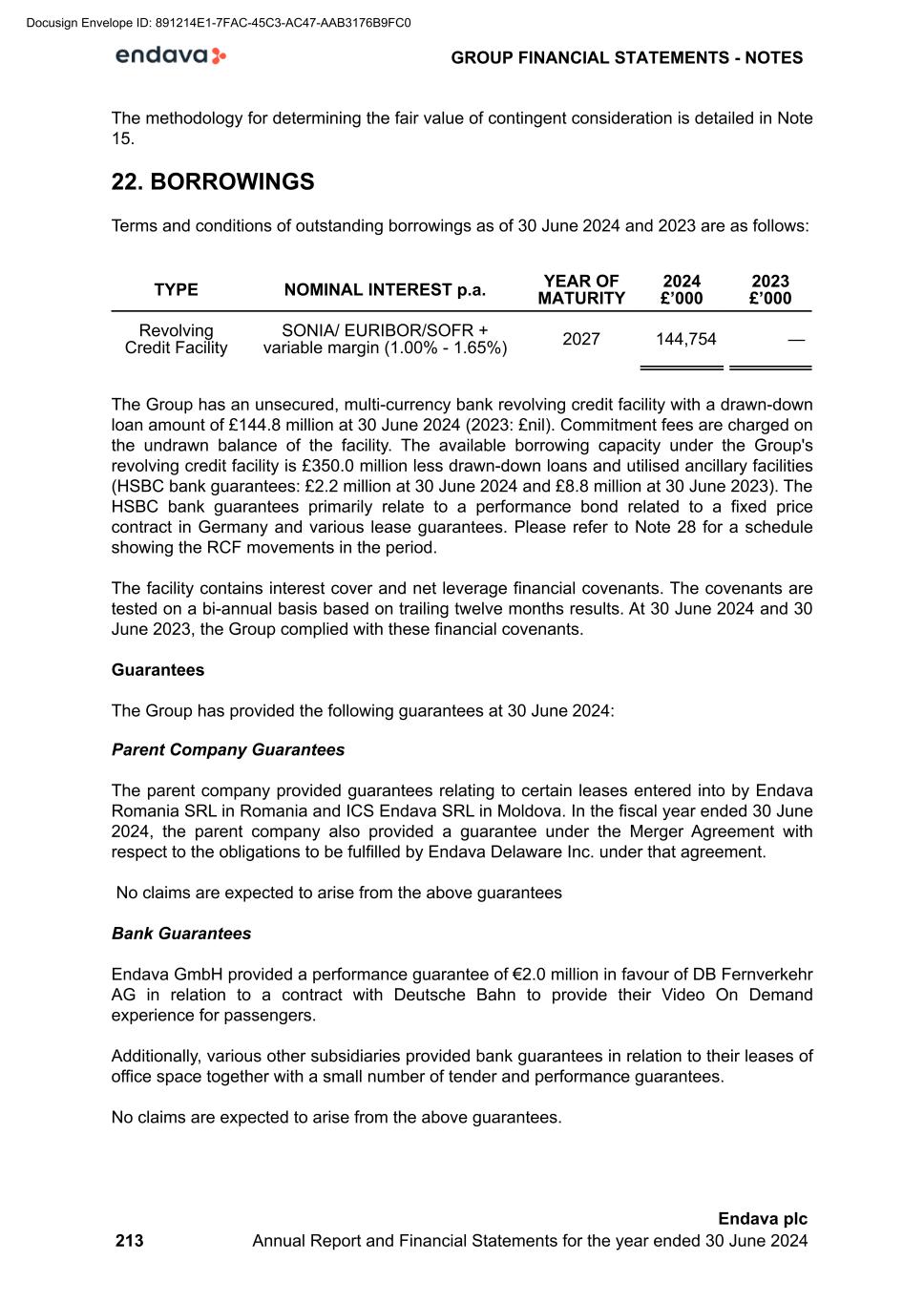
The methodology for determining the fair value of contingent consideration is detailed in Note 15. 22. BORROWINGS Terms and conditions of outstanding borrowings as of 30 June 2024 and 2023 are as follows: TYPE NOMINAL INTEREST p.a. YEAR OF MATURITY 2024 £’000 2023 £’000 Revolving Credit Facility SONIA/ EURIBOR/SOFR + variable margin (1.00% - 1.65%) 2027 144,754 — The Group has an unsecured, multi-currency bank revolving credit facility with a drawn-down loan amount of £144.8 million at 30 June 2024 (2023: £nil). Commitment fees are charged on the undrawn balance of the facility. The available borrowing capacity under the Group's revolving credit facility is £350.0 million less drawn-down loans and utilised ancillary facilities (HSBC bank guarantees: £2.2 million at 30 June 2024 and £8.8 million at 30 June 2023). The HSBC bank guarantees primarily relate to a performance bond related to a fixed price contract in Germany and various lease guarantees. Please refer to Note 28 for a schedule showing the RCF movements in the period. The facility contains interest cover and net leverage financial covenants. The covenants are tested on a bi-annual basis based on trailing twelve months results. At 30 June 2024 and 30 June 2023, the Group complied with these financial covenants. Guarantees The Group has provided the following guarantees at 30 June 2024: Parent Company Guarantees The parent company provided guarantees relating to certain leases entered into by Endava Romania SRL in Romania and ICS Endava SRL in Moldova. In the fiscal year ended 30 June 2024, the parent company also provided a guarantee under the Merger Agreement with respect to the obligations to be fulfilled by Endava Delaware Inc. under that agreement. No claims are expected to arise from the above guarantees Bank Guarantees Endava GmbH provided a performance guarantee of €2.0 million in favour of DB Fernverkehr AG in relation to a contract with Deutsche Bahn to provide their Video On Demand experience for passengers. Additionally, various other subsidiaries provided bank guarantees in relation to their leases of office space together with a small number of tender and performance guarantees. No claims are expected to arise from the above guarantees. GROUP FINANCIAL STATEMENTS - NOTES 213 Endava plc Annual Report and Financial Statements for the year ended 30 June 2024 Docusign Envelope ID: 891214E1-7FAC-45C3-AC47-AAB3176B9FC0
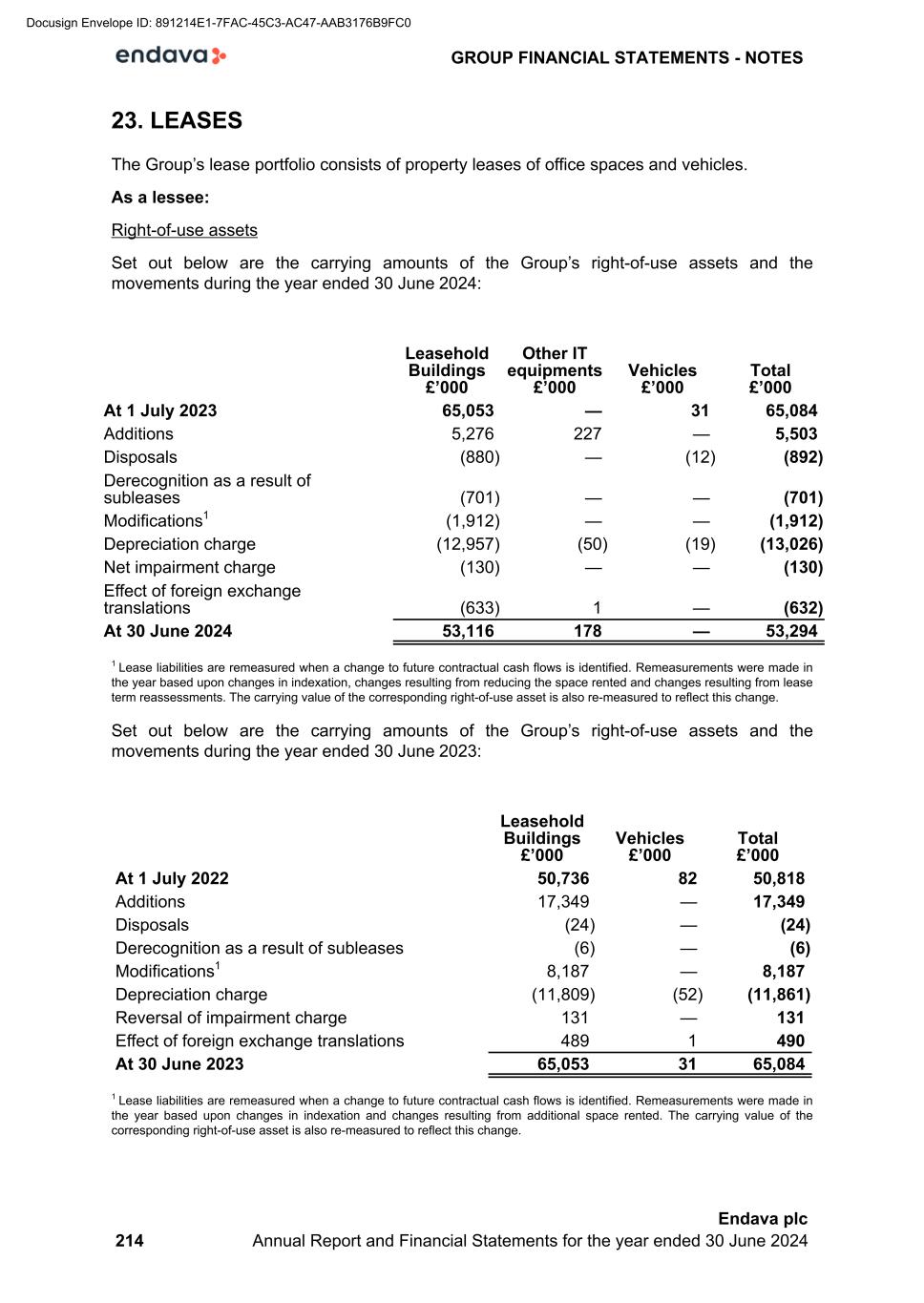
23. LEASES The Group’s lease portfolio consists of property leases of office spaces and vehicles. As a lessee: Right-of-use assets Set out below are the carrying amounts of the Group’s right-of-use assets and the movements during the year ended 30 June 2024: Leasehold Buildings £’000 Other IT equipments £’000 Vehicles £’000 Total £’000 At 1 July 2023 65,053 — 31 65,084 Additions 5,276 227 — 5,503 Disposals (880) — (12) (892) Derecognition as a result of subleases (701) — — (701) Modifications1 (1,912) — — (1,912) Depreciation charge (12,957) (50) (19) (13,026) Net impairment charge (130) — — (130) Effect of foreign exchange translations (633) 1 — (632) At 30 June 2024 53,116 178 — 53,294 1 Lease liabilities are remeasured when a change to future contractual cash flows is identified. Remeasurements were made in the year based upon changes in indexation, changes resulting from reducing the space rented and changes resulting from lease term reassessments. The carrying value of the corresponding right-of-use asset is also re-measured to reflect this change. Set out below are the carrying amounts of the Group’s right-of-use assets and the movements during the year ended 30 June 2023: Leasehold Buildings £’000 Vehicles £’000 Total £’000 At 1 July 2022 50,736 82 50,818 Additions 17,349 — 17,349 Disposals (24) — (24) Derecognition as a result of subleases (6) — (6) Modifications1 8,187 — 8,187 Depreciation charge (11,809) (52) (11,861) Reversal of impairment charge 131 — 131 Effect of foreign exchange translations 489 1 490 At 30 June 2023 65,053 31 65,084 1 Lease liabilities are remeasured when a change to future contractual cash flows is identified. Remeasurements were made in the year based upon changes in indexation and changes resulting from additional space rented. The carrying value of the corresponding right-of-use asset is also re-measured to reflect this change. GROUP FINANCIAL STATEMENTS - NOTES 214 Endava plc Annual Report and Financial Statements for the year ended 30 June 2024 Docusign Envelope ID: 891214E1-7FAC-45C3-AC47-AAB3176B9FC0
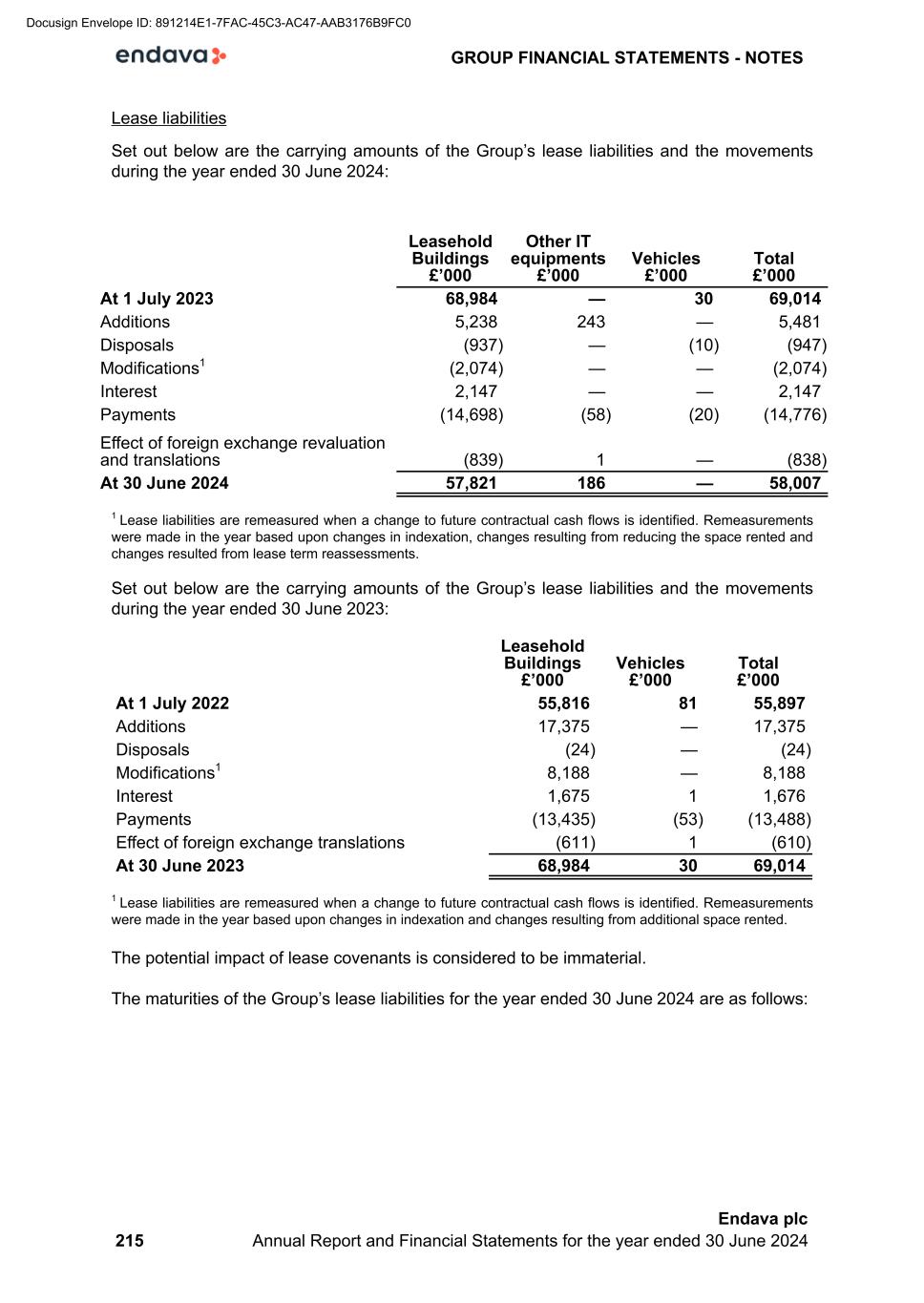
Lease liabilities Set out below are the carrying amounts of the Group’s lease liabilities and the movements during the year ended 30 June 2024: Leasehold Buildings £’000 Other IT equipments £’000 Vehicles £’000 Total £’000 At 1 July 2023 68,984 — 30 69,014 Additions 5,238 243 — 5,481 Disposals (937) — (10) (947) Modifications1 (2,074) — — (2,074) Interest 2,147 — — 2,147 Payments (14,698) (58) (20) (14,776) Effect of foreign exchange revaluation and translations (839) 1 — (838) At 30 June 2024 57,821 186 — 58,007 1 Lease liabilities are remeasured when a change to future contractual cash flows is identified. Remeasurements were made in the year based upon changes in indexation, changes resulting from reducing the space rented and changes resulted from lease term reassessments. Set out below are the carrying amounts of the Group’s lease liabilities and the movements during the year ended 30 June 2023: Leasehold Buildings £’000 Vehicles £’000 Total £’000 At 1 July 2022 55,816 81 55,897 Additions 17,375 — 17,375 Disposals (24) — (24) Modifications1 8,188 — 8,188 Interest 1,675 1 1,676 Payments (13,435) (53) (13,488) Effect of foreign exchange translations (611) 1 (610) At 30 June 2023 68,984 30 69,014 1 Lease liabilities are remeasured when a change to future contractual cash flows is identified. Remeasurements were made in the year based upon changes in indexation and changes resulting from additional space rented. The potential impact of lease covenants is considered to be immaterial. The maturities of the Group’s lease liabilities for the year ended 30 June 2024 are as follows: GROUP FINANCIAL STATEMENTS - NOTES 215 Endava plc Annual Report and Financial Statements for the year ended 30 June 2024 Docusign Envelope ID: 891214E1-7FAC-45C3-AC47-AAB3176B9FC0
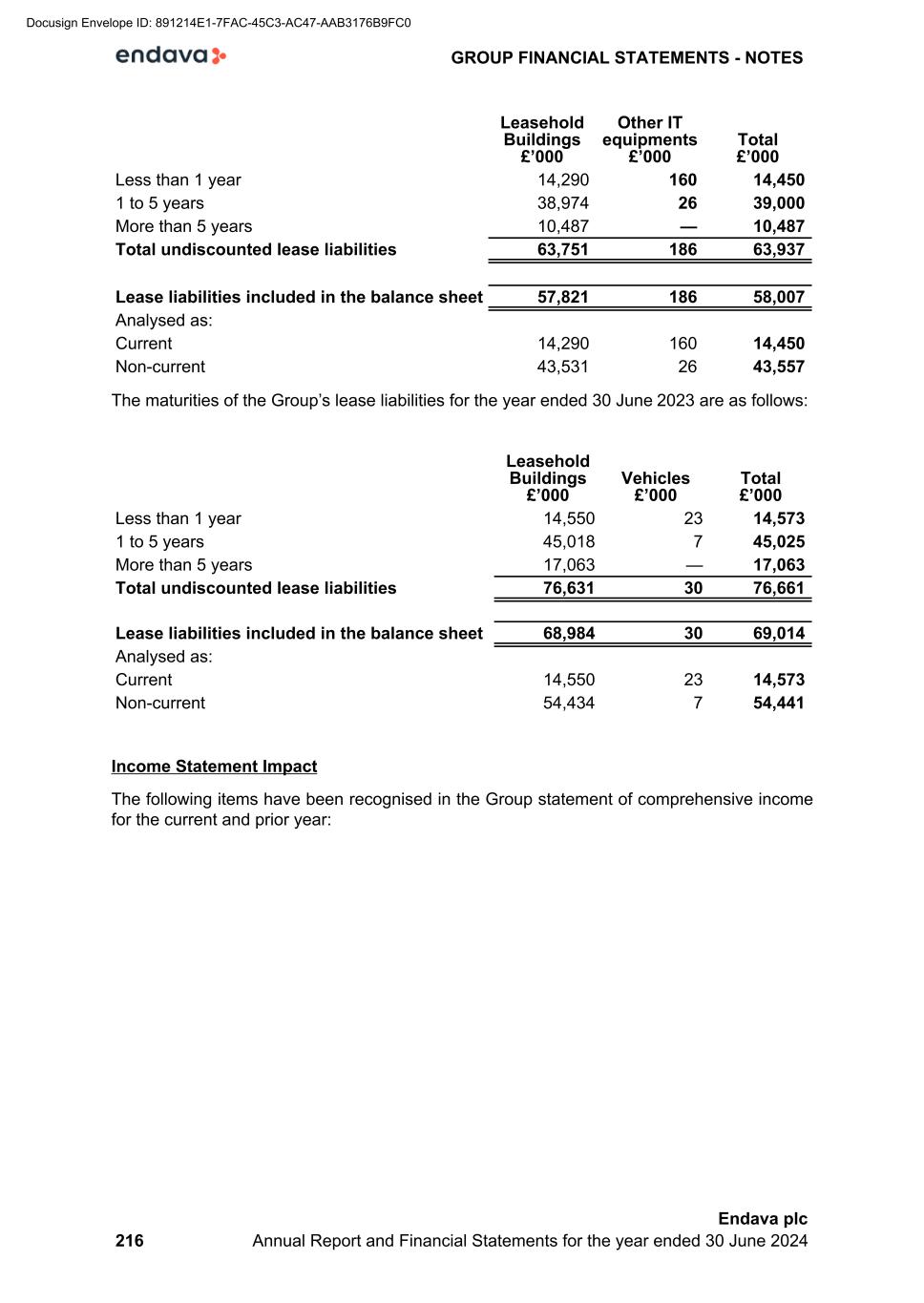
Leasehold Buildings £’000 Other IT equipments £’000 Total £’000 Less than 1 year 14,290 160 14,450 1 to 5 years 38,974 26 39,000 More than 5 years 10,487 — 10,487 Total undiscounted lease liabilities 63,751 186 63,937 Lease liabilities included in the balance sheet 57,821 186 58,007 Analysed as: Current 14,290 160 14,450 Non-current 43,531 26 43,557 The maturities of the Group’s lease liabilities for the year ended 30 June 2023 are as follows: Leasehold Buildings £’000 Vehicles £’000 Total £’000 Less than 1 year 14,550 23 14,573 1 to 5 years 45,018 7 45,025 More than 5 years 17,063 — 17,063 Total undiscounted lease liabilities 76,631 30 76,661 Lease liabilities included in the balance sheet 68,984 30 69,014 Analysed as: Current 14,550 23 14,573 Non-current 54,434 7 54,441 Income Statement Impact The following items have been recognised in the Group statement of comprehensive income for the current and prior year: GROUP FINANCIAL STATEMENTS - NOTES 216 Endava plc Annual Report and Financial Statements for the year ended 30 June 2024 Docusign Envelope ID: 891214E1-7FAC-45C3-AC47-AAB3176B9FC0
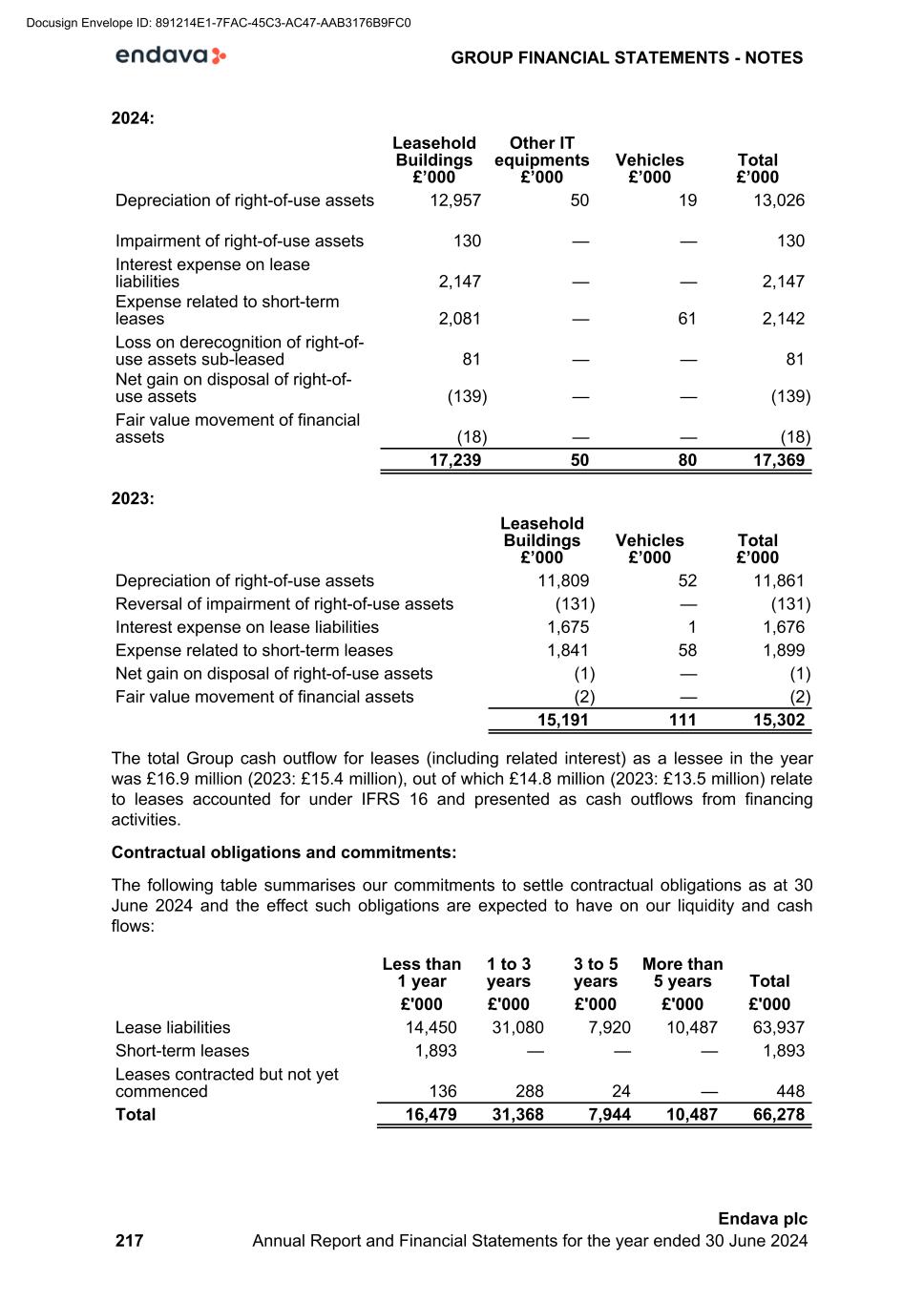
2024: Leasehold Buildings £’000 Other IT equipments £’000 Vehicles £’000 Total £’000 Depreciation of right-of-use assets 12,957 50 19 13,026 Impairment of right-of-use assets 130 — — 130 Interest expense on lease liabilities 2,147 — — 2,147 Expense related to short-term leases 2,081 — 61 2,142 Loss on derecognition of right-of- use assets sub-leased 81 — — 81 Net gain on disposal of right-of- use assets (139) — — (139) Fair value movement of financial assets (18) — — (18) 17,239 50 80 17,369 2023: Leasehold Buildings £’000 Vehicles £’000 Total £’000 Depreciation of right-of-use assets 11,809 52 11,861 Reversal of impairment of right-of-use assets (131) — (131) Interest expense on lease liabilities 1,675 1 1,676 Expense related to short-term leases 1,841 58 1,899 Net gain on disposal of right-of-use assets (1) — (1) Fair value movement of financial assets (2) — (2) 15,191 111 15,302 The total Group cash outflow for leases (including related interest) as a lessee in the year was £16.9 million (2023: £15.4 million), out of which £14.8 million (2023: £13.5 million) relate to leases accounted for under IFRS 16 and presented as cash outflows from financing activities. Contractual obligations and commitments: The following table summarises our commitments to settle contractual obligations as at 30 June 2024 and the effect such obligations are expected to have on our liquidity and cash flows: Less than 1 year 1 to 3 years 3 to 5 years More than 5 years Total £'000 £'000 £'000 £'000 £'000 Lease liabilities 14,450 31,080 7,920 10,487 63,937 Short-term leases 1,893 — — — 1,893 Leases contracted but not yet commenced 136 288 24 — 448 Total 16,479 31,368 7,944 10,487 66,278 GROUP FINANCIAL STATEMENTS - NOTES 217 Endava plc Annual Report and Financial Statements for the year ended 30 June 2024 Docusign Envelope ID: 891214E1-7FAC-45C3-AC47-AAB3176B9FC0
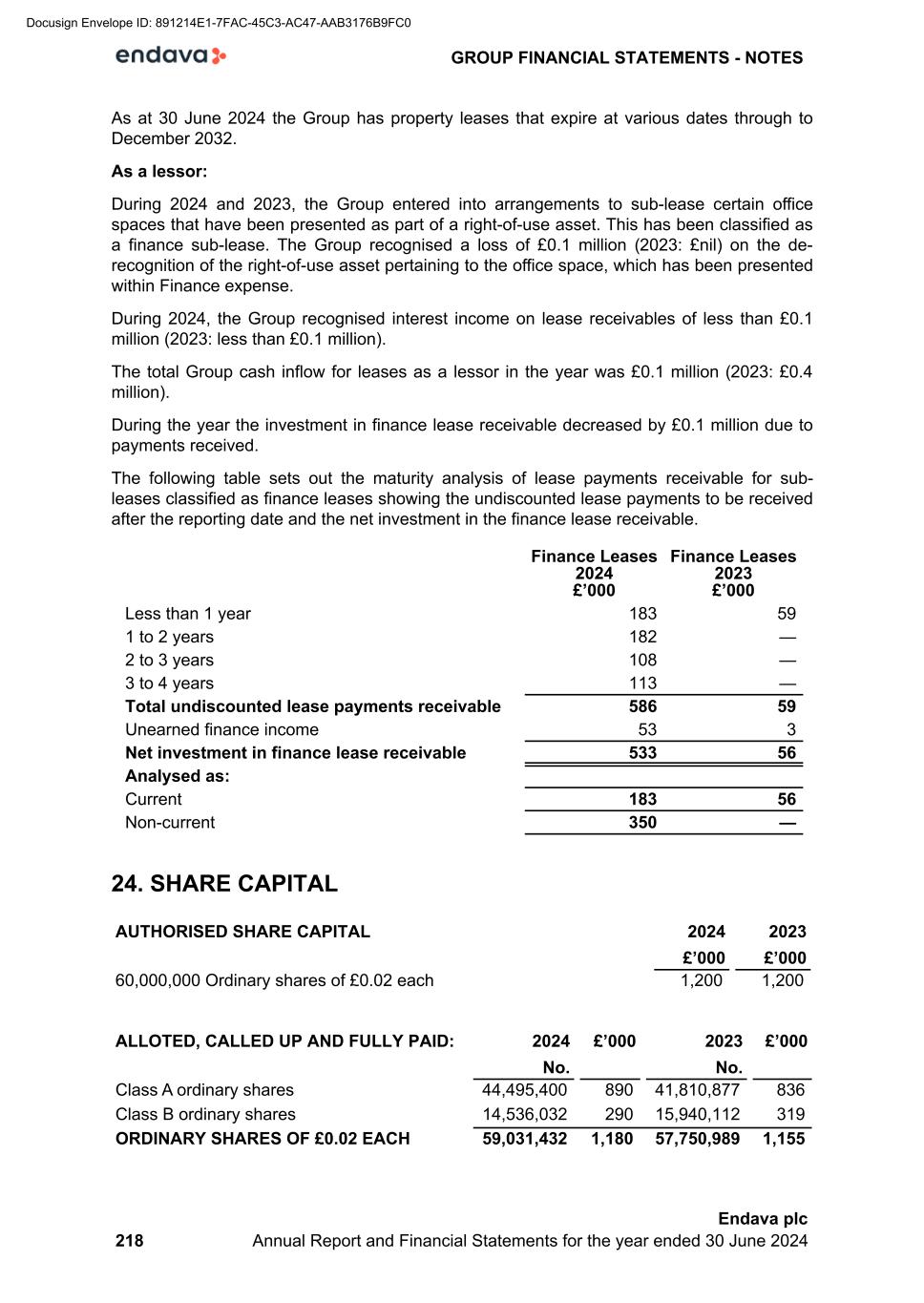
As at 30 June 2024 the Group has property leases that expire at various dates through to December 2032. As a lessor: During 2024 and 2023, the Group entered into arrangements to sub-lease certain office spaces that have been presented as part of a right-of-use asset. This has been classified as a finance sub-lease. The Group recognised a loss of £0.1 million (2023: £nil) on the de- recognition of the right-of-use asset pertaining to the office space, which has been presented within Finance expense. During 2024, the Group recognised interest income on lease receivables of less than £0.1 million (2023: less than £0.1 million). The total Group cash inflow for leases as a lessor in the year was £0.1 million (2023: £0.4 million). During the year the investment in finance lease receivable decreased by £0.1 million due to payments received. The following table sets out the maturity analysis of lease payments receivable for sub- leases classified as finance leases showing the undiscounted lease payments to be received after the reporting date and the net investment in the finance lease receivable. Finance Leases 2024 £’000 Finance Leases 2023 £’000 Less than 1 year 183 59 1 to 2 years 182 — 2 to 3 years 108 — 3 to 4 years 113 — Total undiscounted lease payments receivable 586 59 Unearned finance income 53 3 Net investment in finance lease receivable 533 56 Analysed as: Current 183 56 Non-current 350 — 24. SHARE CAPITAL AUTHORISED SHARE CAPITAL 2024 2023 £’000 £’000 60,000,000 Ordinary shares of £0.02 each 1,200 1,200 ALLOTED, CALLED UP AND FULLY PAID: 2024 £’000 2023 £’000 No. No. Class A ordinary shares 44,495,400 890 41,810,877 836 Class B ordinary shares 14,536,032 290 15,940,112 319 ORDINARY SHARES OF £0.02 EACH 59,031,432 1,180 57,750,989 1,155 GROUP FINANCIAL STATEMENTS - NOTES 218 Endava plc Annual Report and Financial Statements for the year ended 30 June 2024 Docusign Envelope ID: 891214E1-7FAC-45C3-AC47-AAB3176B9FC0
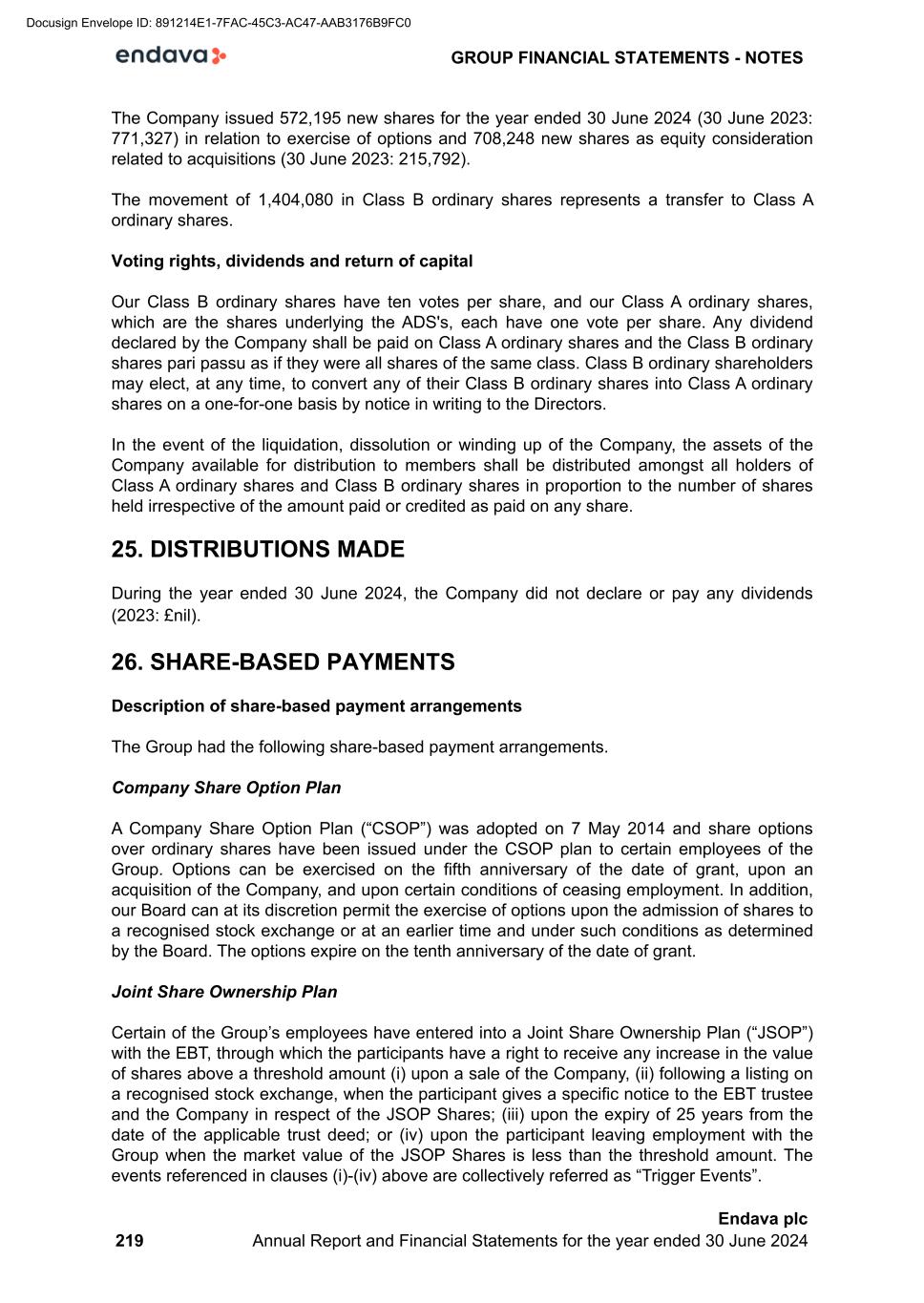
The Company issued 572,195 new shares for the year ended 30 June 2024 (30 June 2023: 771,327) in relation to exercise of options and 708,248 new shares as equity consideration related to acquisitions (30 June 2023: 215,792). The movement of 1,404,080 in Class B ordinary shares represents a transfer to Class A ordinary shares. Voting rights, dividends and return of capital Our Class B ordinary shares have ten votes per share, and our Class A ordinary shares, which are the shares underlying the ADS's, each have one vote per share. Any dividend declared by the Company shall be paid on Class A ordinary shares and the Class B ordinary shares pari passu as if they were all shares of the same class. Class B ordinary shareholders may elect, at any time, to convert any of their Class B ordinary shares into Class A ordinary shares on a one-for-one basis by notice in writing to the Directors. In the event of the liquidation, dissolution or winding up of the Company, the assets of the Company available for distribution to members shall be distributed amongst all holders of Class A ordinary shares and Class B ordinary shares in proportion to the number of shares held irrespective of the amount paid or credited as paid on any share. 25. DISTRIBUTIONS MADE During the year ended 30 June 2024, the Company did not declare or pay any dividends (2023: £nil). 26. SHARE-BASED PAYMENTS Description of share-based payment arrangements The Group had the following share-based payment arrangements. Company Share Option Plan A Company Share Option Plan (“CSOP”) was adopted on 7 May 2014 and share options over ordinary shares have been issued under the CSOP plan to certain employees of the Group. Options can be exercised on the fifth anniversary of the date of grant, upon an acquisition of the Company, and upon certain conditions of ceasing employment. In addition, our Board can at its discretion permit the exercise of options upon the admission of shares to a recognised stock exchange or at an earlier time and under such conditions as determined by the Board. The options expire on the tenth anniversary of the date of grant. Joint Share Ownership Plan Certain of the Group’s employees have entered into a Joint Share Ownership Plan (“JSOP”) with the EBT, through which the participants have a right to receive any increase in the value of shares above a threshold amount (i) upon a sale of the Company, (ii) following a listing on a recognised stock exchange, when the participant gives a specific notice to the EBT trustee and the Company in respect of the JSOP Shares; (iii) upon the expiry of 25 years from the date of the applicable trust deed; or (iv) upon the participant leaving employment with the Group when the market value of the JSOP Shares is less than the threshold amount. The events referenced in clauses (i)-(iv) above are collectively referred as “Trigger Events”. GROUP FINANCIAL STATEMENTS - NOTES 219 Endava plc Annual Report and Financial Statements for the year ended 30 June 2024 Docusign Envelope ID: 891214E1-7FAC-45C3-AC47-AAB3176B9FC0
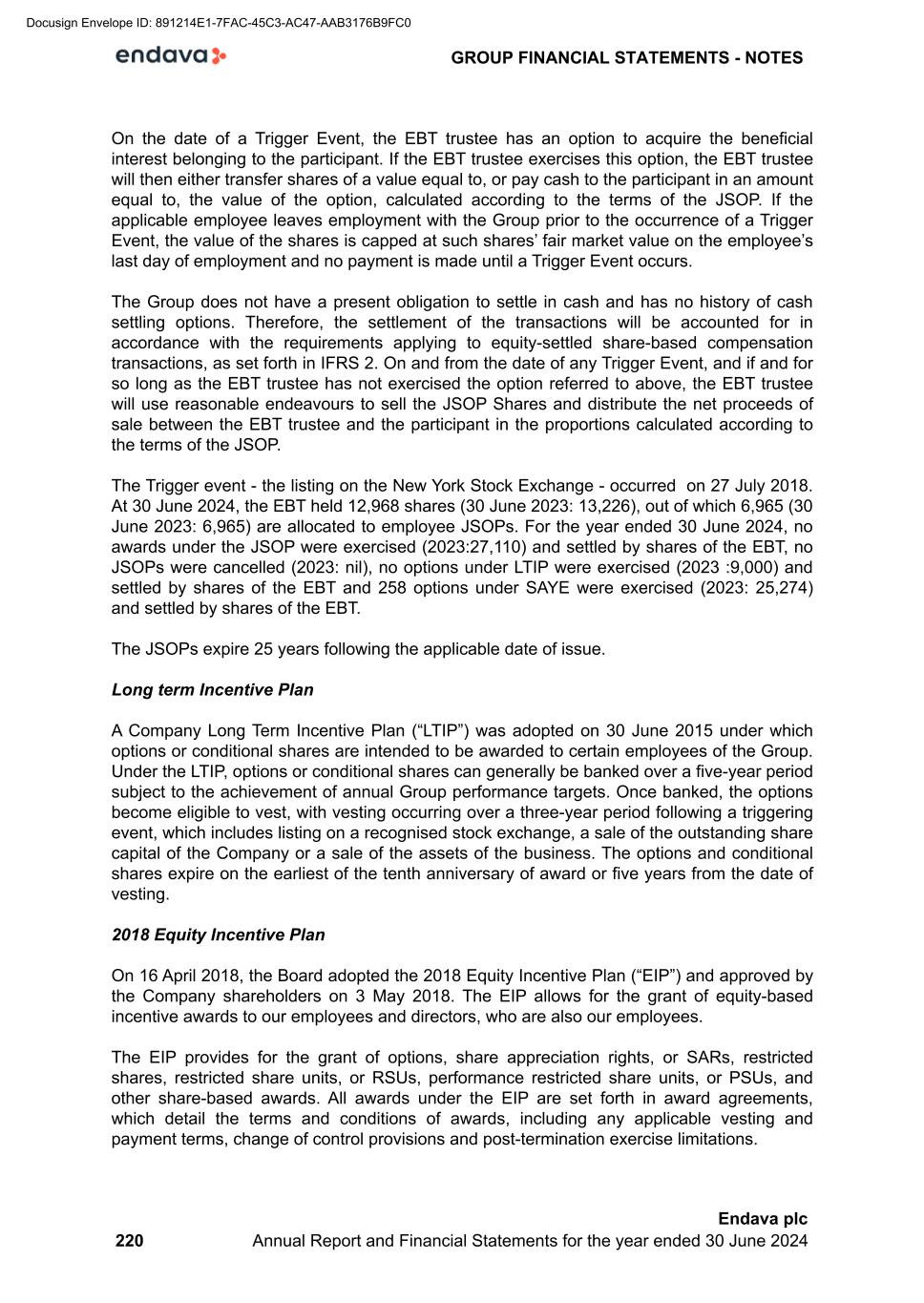
On the date of a Trigger Event, the EBT trustee has an option to acquire the beneficial interest belonging to the participant. If the EBT trustee exercises this option, the EBT trustee will then either transfer shares of a value equal to, or pay cash to the participant in an amount equal to, the value of the option, calculated according to the terms of the JSOP. If the applicable employee leaves employment with the Group prior to the occurrence of a Trigger Event, the value of the shares is capped at such shares’ fair market value on the employee’s last day of employment and no payment is made until a Trigger Event occurs. The Group does not have a present obligation to settle in cash and has no history of cash settling options. Therefore, the settlement of the transactions will be accounted for in accordance with the requirements applying to equity-settled share-based compensation transactions, as set forth in IFRS 2. On and from the date of any Trigger Event, and if and for so long as the EBT trustee has not exercised the option referred to above, the EBT trustee will use reasonable endeavours to sell the JSOP Shares and distribute the net proceeds of sale between the EBT trustee and the participant in the proportions calculated according to the terms of the JSOP. The Trigger event - the listing on the New York Stock Exchange - occurred on 27 July 2018. At 30 June 2024, the EBT held 12,968 shares (30 June 2023: 13,226), out of which 6,965 (30 June 2023: 6,965) are allocated to employee JSOPs. For the year ended 30 June 2024, no awards under the JSOP were exercised (2023:27,110) and settled by shares of the EBT, no JSOPs were cancelled (2023: nil), no options under LTIP were exercised (2023 :9,000) and settled by shares of the EBT and 258 options under SAYE were exercised (2023: 25,274) and settled by shares of the EBT. The JSOPs expire 25 years following the applicable date of issue. Long term Incentive Plan A Company Long Term Incentive Plan (“LTIP”) was adopted on 30 June 2015 under which options or conditional shares are intended to be awarded to certain employees of the Group. Under the LTIP, options or conditional shares can generally be banked over a five-year period subject to the achievement of annual Group performance targets. Once banked, the options become eligible to vest, with vesting occurring over a three-year period following a triggering event, which includes listing on a recognised stock exchange, a sale of the outstanding share capital of the Company or a sale of the assets of the business. The options and conditional shares expire on the earliest of the tenth anniversary of award or five years from the date of vesting. 2018 Equity Incentive Plan On 16 April 2018, the Board adopted the 2018 Equity Incentive Plan (“EIP”) and approved by the Company shareholders on 3 May 2018. The EIP allows for the grant of equity-based incentive awards to our employees and directors, who are also our employees. The EIP provides for the grant of options, share appreciation rights, or SARs, restricted shares, restricted share units, or RSUs, performance restricted share units, or PSUs, and other share-based awards. All awards under the EIP are set forth in award agreements, which detail the terms and conditions of awards, including any applicable vesting and payment terms, change of control provisions and post-termination exercise limitations. GROUP FINANCIAL STATEMENTS - NOTES 220 Endava plc Annual Report and Financial Statements for the year ended 30 June 2024 Docusign Envelope ID: 891214E1-7FAC-45C3-AC47-AAB3176B9FC0
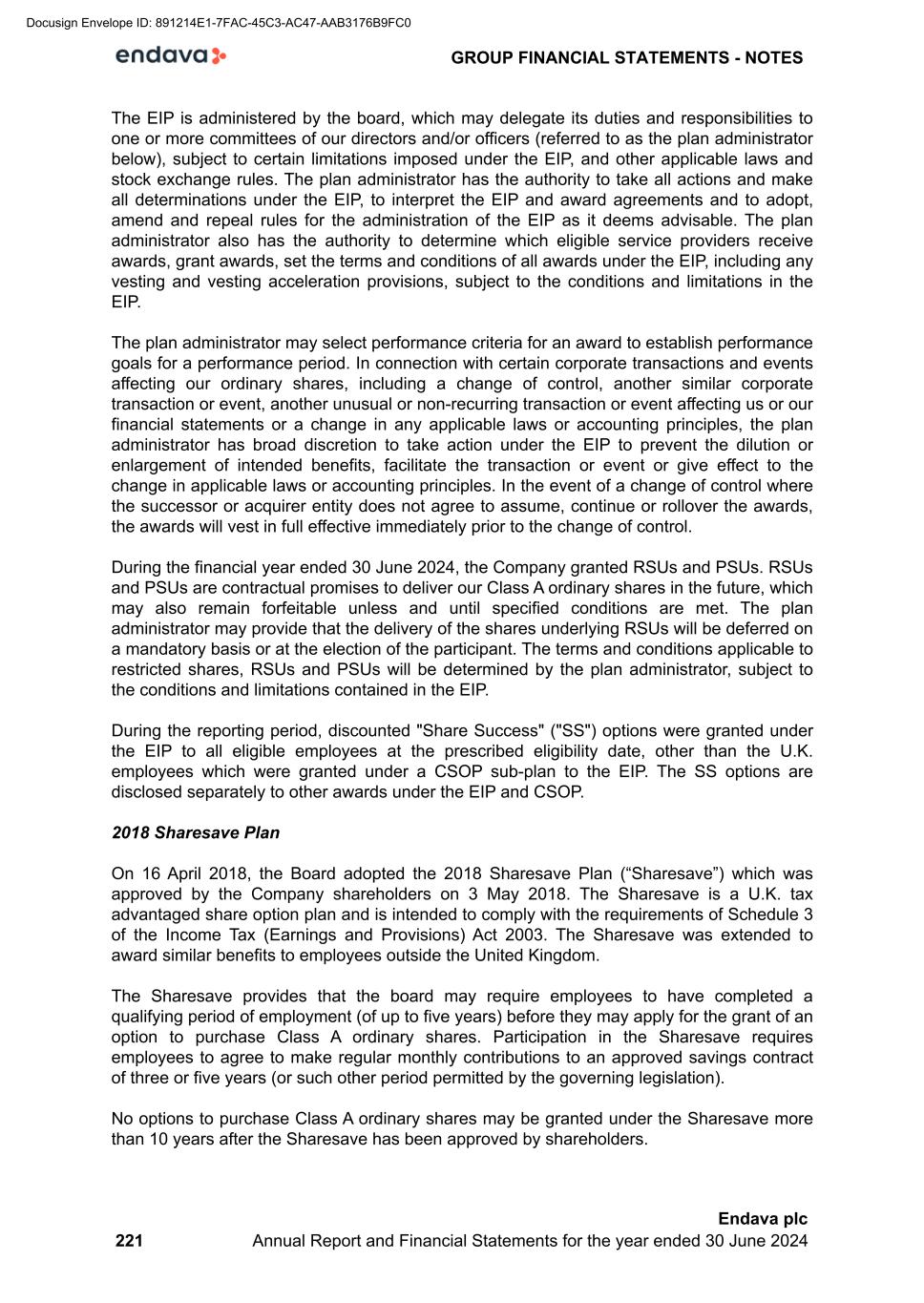
The EIP is administered by the board, which may delegate its duties and responsibilities to one or more committees of our directors and/or officers (referred to as the plan administrator below), subject to certain limitations imposed under the EIP, and other applicable laws and stock exchange rules. The plan administrator has the authority to take all actions and make all determinations under the EIP, to interpret the EIP and award agreements and to adopt, amend and repeal rules for the administration of the EIP as it deems advisable. The plan administrator also has the authority to determine which eligible service providers receive awards, grant awards, set the terms and conditions of all awards under the EIP, including any vesting and vesting acceleration provisions, subject to the conditions and limitations in the EIP. The plan administrator may select performance criteria for an award to establish performance goals for a performance period. In connection with certain corporate transactions and events affecting our ordinary shares, including a change of control, another similar corporate transaction or event, another unusual or non-recurring transaction or event affecting us or our financial statements or a change in any applicable laws or accounting principles, the plan administrator has broad discretion to take action under the EIP to prevent the dilution or enlargement of intended benefits, facilitate the transaction or event or give effect to the change in applicable laws or accounting principles. In the event of a change of control where the successor or acquirer entity does not agree to assume, continue or rollover the awards, the awards will vest in full effective immediately prior to the change of control. During the financial year ended 30 June 2024, the Company granted RSUs and PSUs. RSUs and PSUs are contractual promises to deliver our Class A ordinary shares in the future, which may also remain forfeitable unless and until specified conditions are met. The plan administrator may provide that the delivery of the shares underlying RSUs will be deferred on a mandatory basis or at the election of the participant. The terms and conditions applicable to restricted shares, RSUs and PSUs will be determined by the plan administrator, subject to the conditions and limitations contained in the EIP. During the reporting period, discounted "Share Success" ("SS") options were granted under the EIP to all eligible employees at the prescribed eligibility date, other than the U.K. employees which were granted under a CSOP sub-plan to the EIP. The SS options are disclosed separately to other awards under the EIP and CSOP. 2018 Sharesave Plan On 16 April 2018, the Board adopted the 2018 Sharesave Plan (“Sharesave”) which was approved by the Company shareholders on 3 May 2018. The Sharesave is a U.K. tax advantaged share option plan and is intended to comply with the requirements of Schedule 3 of the Income Tax (Earnings and Provisions) Act 2003. The Sharesave was extended to award similar benefits to employees outside the United Kingdom. The Sharesave provides that the board may require employees to have completed a qualifying period of employment (of up to five years) before they may apply for the grant of an option to purchase Class A ordinary shares. Participation in the Sharesave requires employees to agree to make regular monthly contributions to an approved savings contract of three or five years (or such other period permitted by the governing legislation). No options to purchase Class A ordinary shares may be granted under the Sharesave more than 10 years after the Sharesave has been approved by shareholders. GROUP FINANCIAL STATEMENTS - NOTES 221 Endava plc Annual Report and Financial Statements for the year ended 30 June 2024 Docusign Envelope ID: 891214E1-7FAC-45C3-AC47-AAB3176B9FC0
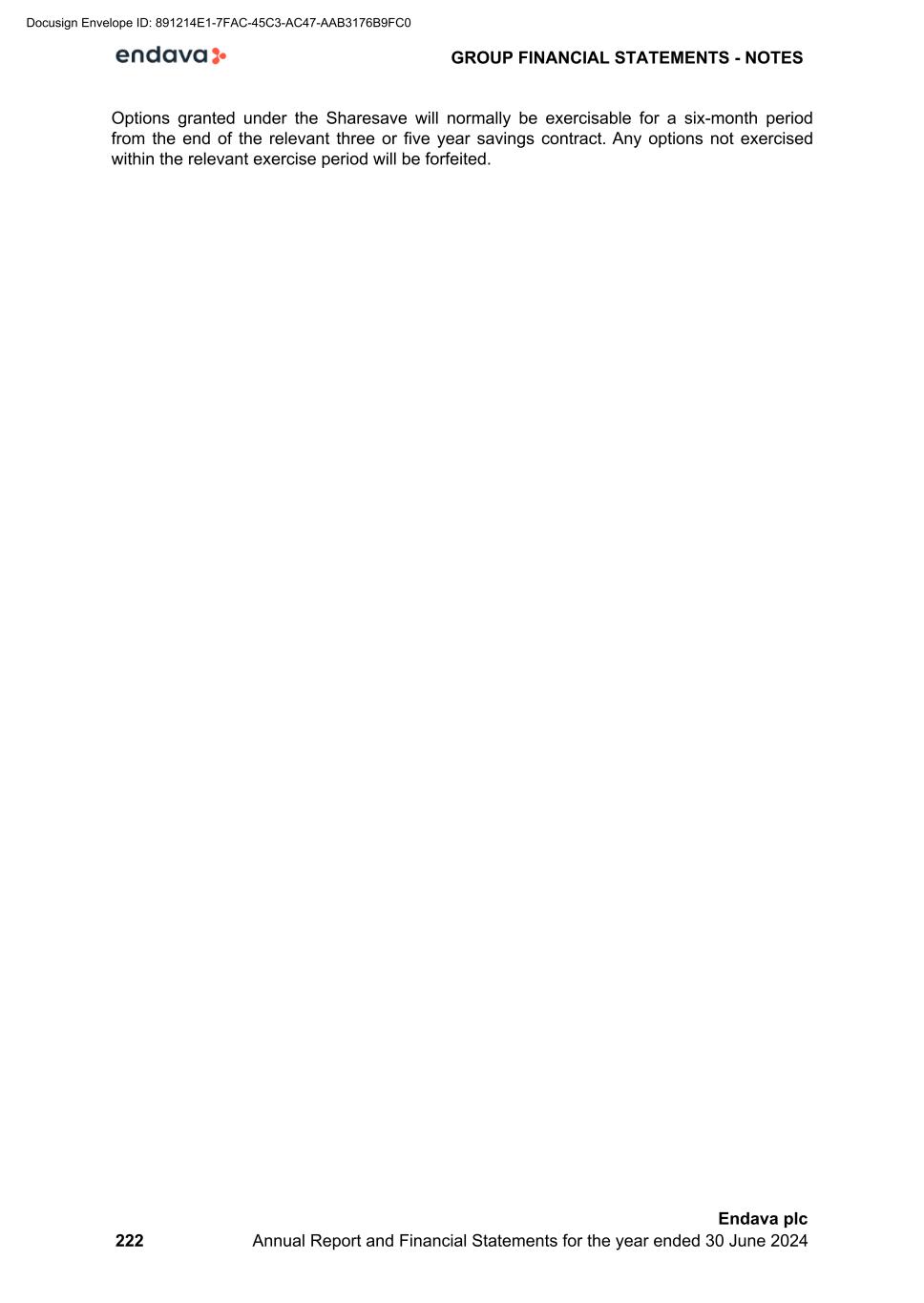
Options granted under the Sharesave will normally be exercisable for a six-month period from the end of the relevant three or five year savings contract. Any options not exercised within the relevant exercise period will be forfeited. GROUP FINANCIAL STATEMENTS - NOTES 222 Endava plc Annual Report and Financial Statements for the year ended 30 June 2024 Docusign Envelope ID: 891214E1-7FAC-45C3-AC47-AAB3176B9FC0
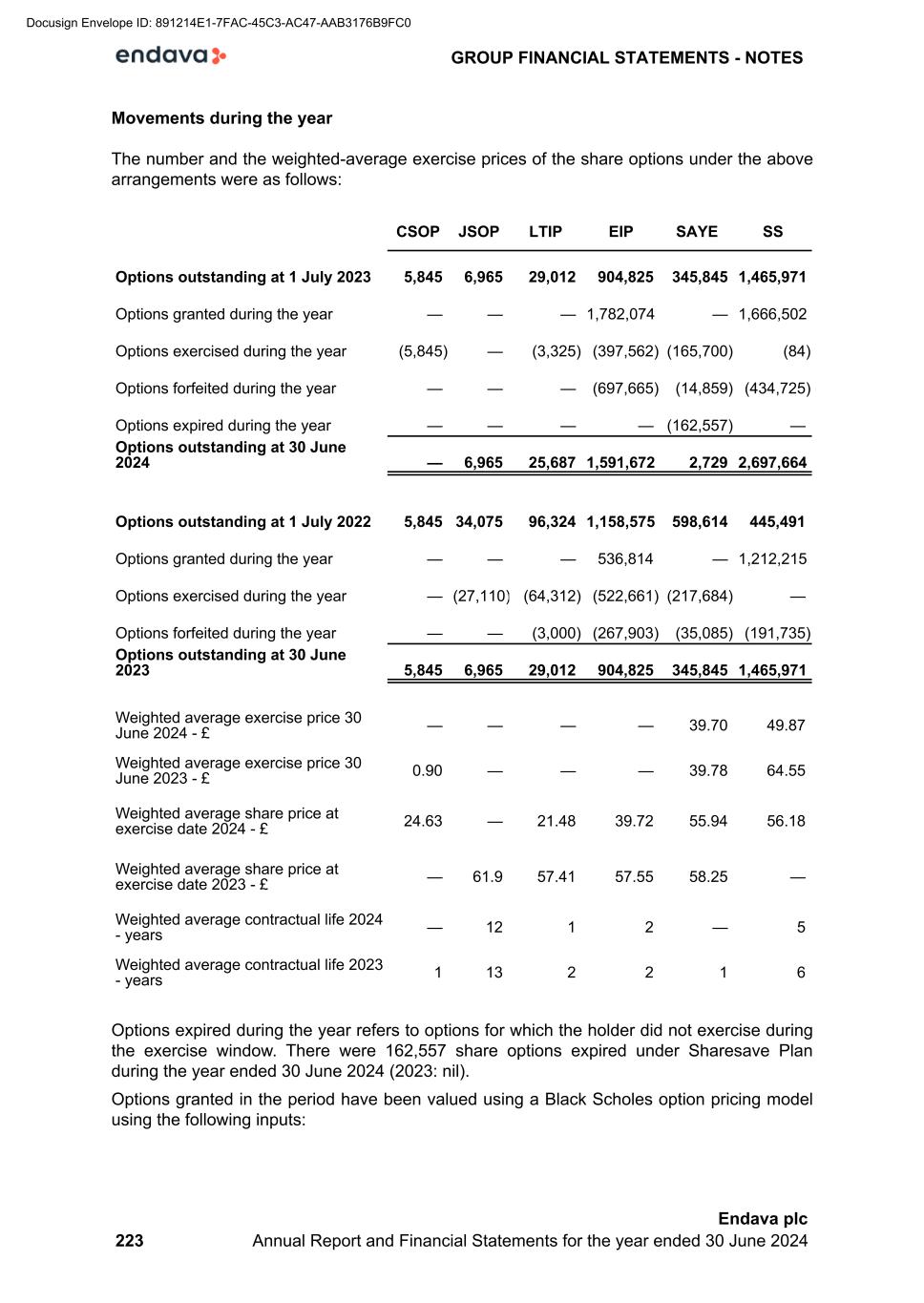
Movements during the year The number and the weighted-average exercise prices of the share options under the above arrangements were as follows: CSOP JSOP LTIP EIP SAYE SS Options outstanding at 1 July 2023 5,845 6,965 29,012 904,825 345,845 1,465,971 Options granted during the year — — — 1,782,074 — 1,666,502 Options exercised during the year (5,845) — (3,325) (397,562) (165,700) (84) Options forfeited during the year — — — (697,665) (14,859) (434,725) Options expired during the year — — — — (162,557) — Options outstanding at 30 June 2024 — 6,965 25,687 1,591,672 2,729 2,697,664 Options outstanding at 1 July 2022 5,845 34,075 96,324 1,158,575 598,614 445,491 Options granted during the year — — — 536,814 — 1,212,215 Options exercised during the year — (27,110) (64,312) (522,661) (217,684) — Options forfeited during the year — — (3,000) (267,903) (35,085) (191,735) Options outstanding at 30 June 2023 5,845 6,965 29,012 904,825 345,845 1,465,971 Weighted average exercise price 30 June 2024 - £ — — — — 39.70 49.87 Weighted average exercise price 30 June 2023 - £ 0.90 — — — 39.78 64.55 Weighted average share price at exercise date 2024 - £ 24.63 — 21.48 39.72 55.94 56.18 Weighted average share price at exercise date 2023 - £ — 61.9 57.41 57.55 58.25 — Weighted average contractual life 2024 - years — 12 1 2 — 5 Weighted average contractual life 2023 - years 1 13 2 2 1 6 Options expired during the year refers to options for which the holder did not exercise during the exercise window. There were 162,557 share options expired under Sharesave Plan during the year ended 30 June 2024 (2023: nil). Options granted in the period have been valued using a Black Scholes option pricing model using the following inputs: GROUP FINANCIAL STATEMENTS - NOTES 223 Endava plc Annual Report and Financial Statements for the year ended 30 June 2024 Docusign Envelope ID: 891214E1-7FAC-45C3-AC47-AAB3176B9FC0
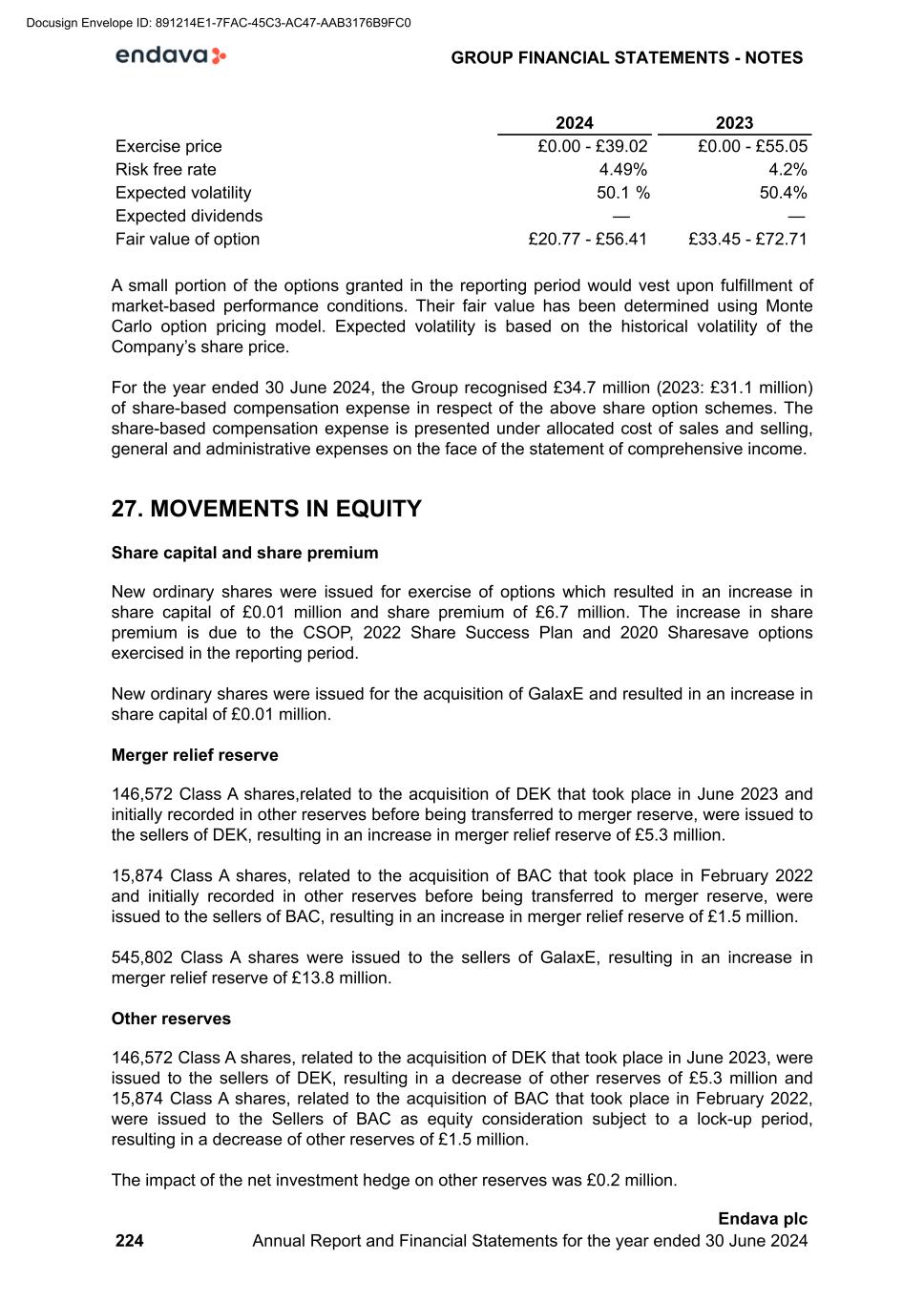
2024 2023 Exercise price £0.00 - £39.02 £0.00 - £55.05 Risk free rate 4.49% 4.2% Expected volatility 50.1 % 50.4% Expected dividends — — Fair value of option £20.77 - £56.41 £33.45 - £72.71 A small portion of the options granted in the reporting period would vest upon fulfillment of market-based performance conditions. Their fair value has been determined using Monte Carlo option pricing model. Expected volatility is based on the historical volatility of the Company’s share price. For the year ended 30 June 2024, the Group recognised £34.7 million (2023: £31.1 million) of share-based compensation expense in respect of the above share option schemes. The share-based compensation expense is presented under allocated cost of sales and selling, general and administrative expenses on the face of the statement of comprehensive income. 27. MOVEMENTS IN EQUITY Share capital and share premium New ordinary shares were issued for exercise of options which resulted in an increase in share capital of £0.01 million and share premium of £6.7 million. The increase in share premium is due to the CSOP, 2022 Share Success Plan and 2020 Sharesave options exercised in the reporting period. New ordinary shares were issued for the acquisition of GalaxE and resulted in an increase in share capital of £0.01 million. Merger relief reserve 146,572 Class A shares,related to the acquisition of DEK that took place in June 2023 and initially recorded in other reserves before being transferred to merger reserve, were issued to the sellers of DEK, resulting in an increase in merger relief reserve of £5.3 million. 15,874 Class A shares, related to the acquisition of BAC that took place in February 2022 and initially recorded in other reserves before being transferred to merger reserve, were issued to the sellers of BAC, resulting in an increase in merger relief reserve of £1.5 million. 545,802 Class A shares were issued to the sellers of GalaxE, resulting in an increase in merger relief reserve of £13.8 million. Other reserves 146,572 Class A shares, related to the acquisition of DEK that took place in June 2023, were issued to the sellers of DEK, resulting in a decrease of other reserves of £5.3 million and 15,874 Class A shares, related to the acquisition of BAC that took place in February 2022, were issued to the Sellers of BAC as equity consideration subject to a lock-up period, resulting in a decrease of other reserves of £1.5 million. The impact of the net investment hedge on other reserves was £0.2 million. GROUP FINANCIAL STATEMENTS - NOTES 224 Endava plc Annual Report and Financial Statements for the year ended 30 June 2024 Docusign Envelope ID: 891214E1-7FAC-45C3-AC47-AAB3176B9FC0

£3.3 million was recognised as exchange differences losses from translating foreign operations during the reporting period. 28. CASH FLOW Operating Activities ADJUSTMENTS 2024 2023 £’000 £’000 Depreciation, amortisation and impairment of non- financial assets 38,941 32,927 Unrealised foreign exchange loss 3,249 5,441 Interest income (6,171) (3,506) Fair value movement of financial liabilities (9,133) (11,828) Interest expense 6,181 3,469 Net gain/(loss) on disposal of non-current assets (tangibles and intangibles) 690 (45) Share-based compensation expense 34,678 31,058 Hyperinflation effect (gain)/loss — (386) Research and development tax credit (7,788) (5,027) Loss on derecognition of right-of-use assets sub-leased 81 — Net gain on disposal of right-of-use assets (139) (1) Fair value movement of financial assets (18) (2) Grant income (2,803) (2,935) Total adjustments 57,768 49,165 NET CHANGES IN WORKING CAPITAL 2024 2023 £’000 £’000 Decrease/(Increase) in trade and other receivables 5,532 (3,937) Decrease in trade and other payables (22,112) (12,136) Net changes in working capital (16,580) (16,073) Financing Activities NON-CASH CHANGES ARISING FROM FINANCING ACTIVITIES GRANT RECEIVED BEGINNING OF THE YEAR CASH RECEIVED GRANT INCOME NON-CASH FOREIGN EXCHANGE END OF THE YEAR £’000 £’000 £’000 £’000 £’000 2023 (437) 494 (2,935) 1 (2,877) 2024 (2,877) 707 (2,803) 81 (4,892) The grants receivable in 2023 and 2024 are presented in trade and other receivables. GROUP FINANCIAL STATEMENTS - NOTES 225 Endava plc Annual Report and Financial Statements for the year ended 30 June 2024 Docusign Envelope ID: 891214E1-7FAC-45C3-AC47-AAB3176B9FC0

Borrowings Beginning of the year £’000 Proceeds from borrowings £’000 Repayment of borrowings £’000 Non-cash foreign exchange £’000 Non-cash Other £'000 End of the year £'000 2024 — (153,814) 8,056 795 209 (144,754) The movement in lease liabilities for the current and prior financial years are disclosed in Note 23. Investing Activities £48.5 million presented as other acquisition related settlements for the fiscal year 2024 represents the repayment of external loans acquired with GalaxE. In addition, the repayment of external loans acquired with TLM of £6.7 million are included in other acquisition related settlements for the financial year 2024. £21.2 million presented as other acquisition related settlements for the fiscal year 2023 represents the payment of a promissory note acquired with DEK, settled in the post- acquisition period. 29. CAPITAL COMMITMENTS Amounts contracted but not provided for in the financial statements amounted to £nil in the year ended 30 June 2024 (2023 - £nil). 30. CONTINGENT LIABILITIES The Group has historically claimed tax credits through its subsidiary, Endava (UK) Ltd, under the UK’s RDEC program, which incentivises research and development activities that are directed and overseen from the UK, resulting in advancements in knowledge or technology. For the financial year ended 30 June 2022, HM Revenue & Customs (HMRC) initiated an inquiry into Endava (UK) Ltd's RDEC claim. The company’s tax years from 30 June 2016 onward remain open to inspection by HMRC. The total value of these RDEC claims, including estimates for the financial years ending 30 June 2023 and 2024, is approximately £18.5 million, net of tax. Management has exercised significant judgment in evaluating the validity of these RDEC claims, relying on its interpretation of the qualifying activities for this claim, interpretation of the relevant tax regulations in effect during the claim periods and consultation with external advisors. Despite the ongoing HMRC review, management remains confident in its position and does not consider it probable that any portion of these claims will be disallowed. As result, no provision has been recorded in the consolidated financial statements related to this inquiry. The Group had no contingent liabilities at 30 June 2023. GROUP FINANCIAL STATEMENTS - NOTES 226 Endava plc Annual Report and Financial Statements for the year ended 30 June 2024 Docusign Envelope ID: 891214E1-7FAC-45C3-AC47-AAB3176B9FC0
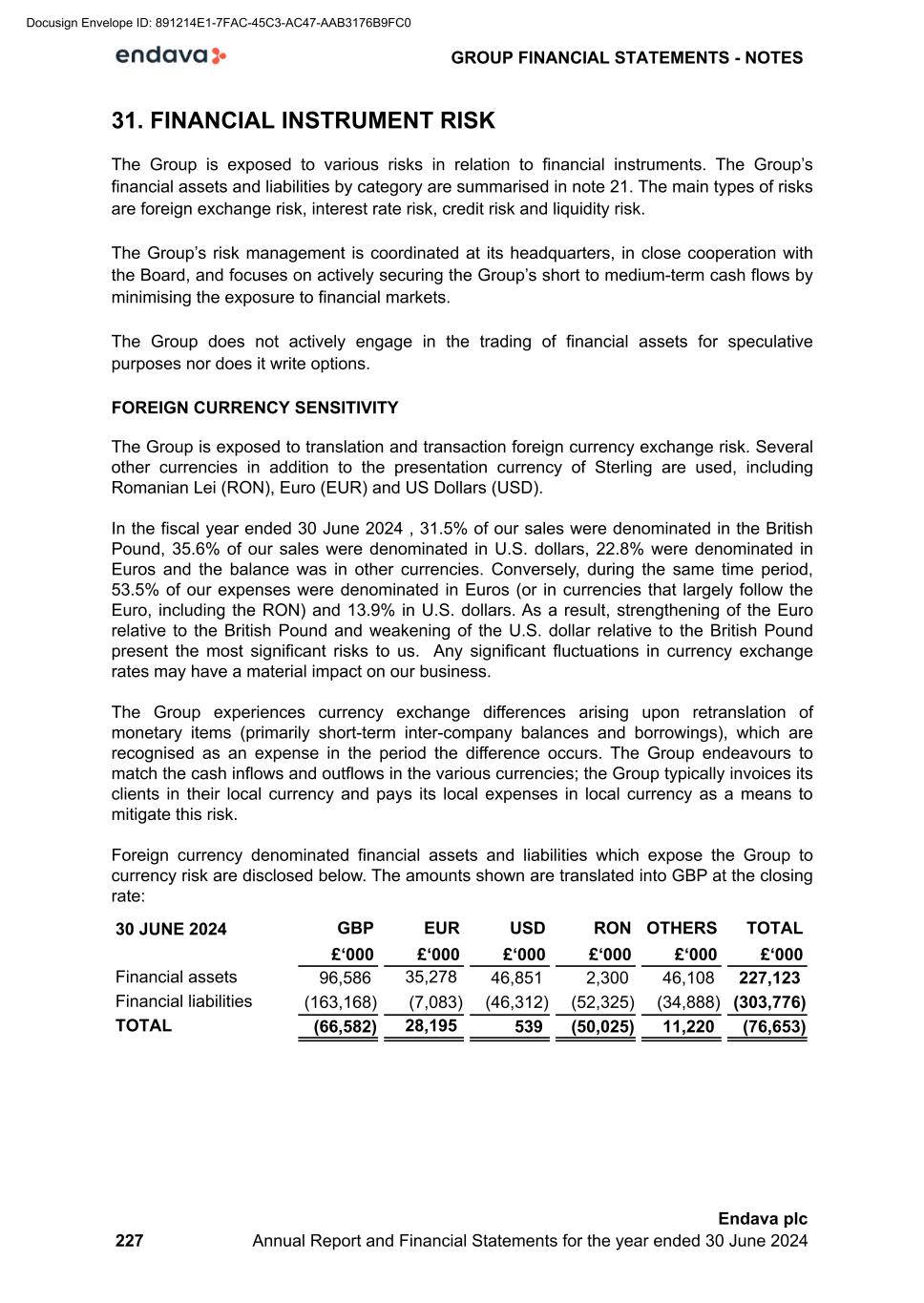
31. FINANCIAL INSTRUMENT RISK The Group is exposed to various risks in relation to financial instruments. The Group’s financial assets and liabilities by category are summarised in note 21. The main types of risks are foreign exchange risk, interest rate risk, credit risk and liquidity risk. The Group’s risk management is coordinated at its headquarters, in close cooperation with the Board, and focuses on actively securing the Group’s short to medium-term cash flows by minimising the exposure to financial markets. The Group does not actively engage in the trading of financial assets for speculative purposes nor does it write options. FOREIGN CURRENCY SENSITIVITY The Group is exposed to translation and transaction foreign currency exchange risk. Several other currencies in addition to the presentation currency of Sterling are used, including Romanian Lei (RON), Euro (EUR) and US Dollars (USD). In the fiscal year ended 30 June 2024 , 31.5% of our sales were denominated in the British Pound, 35.6% of our sales were denominated in U.S. dollars, 22.8% were denominated in Euros and the balance was in other currencies. Conversely, during the same time period, 53.5% of our expenses were denominated in Euros (or in currencies that largely follow the Euro, including the RON) and 13.9% in U.S. dollars. As a result, strengthening of the Euro relative to the British Pound and weakening of the U.S. dollar relative to the British Pound present the most significant risks to us. Any significant fluctuations in currency exchange rates may have a material impact on our business. The Group experiences currency exchange differences arising upon retranslation of monetary items (primarily short-term inter-company balances and borrowings), which are recognised as an expense in the period the difference occurs. The Group endeavours to match the cash inflows and outflows in the various currencies; the Group typically invoices its clients in their local currency and pays its local expenses in local currency as a means to mitigate this risk. Foreign currency denominated financial assets and liabilities which expose the Group to currency risk are disclosed below. The amounts shown are translated into GBP at the closing rate: 30 JUNE 2024 GBP EUR USD RON OTHERS TOTAL £‘000 £‘000 £‘000 £‘000 £‘000 £‘000 Financial assets 96,586 35,278 46,851 2,300 46,108 227,123 Financial liabilities (163,168) (7,083) (46,312) (52,325) (34,888) (303,776) TOTAL (66,582) 28,195 539 (50,025) 11,220 (76,653) GROUP FINANCIAL STATEMENTS - NOTES 227 Endava plc Annual Report and Financial Statements for the year ended 30 June 2024 Docusign Envelope ID: 891214E1-7FAC-45C3-AC47-AAB3176B9FC0
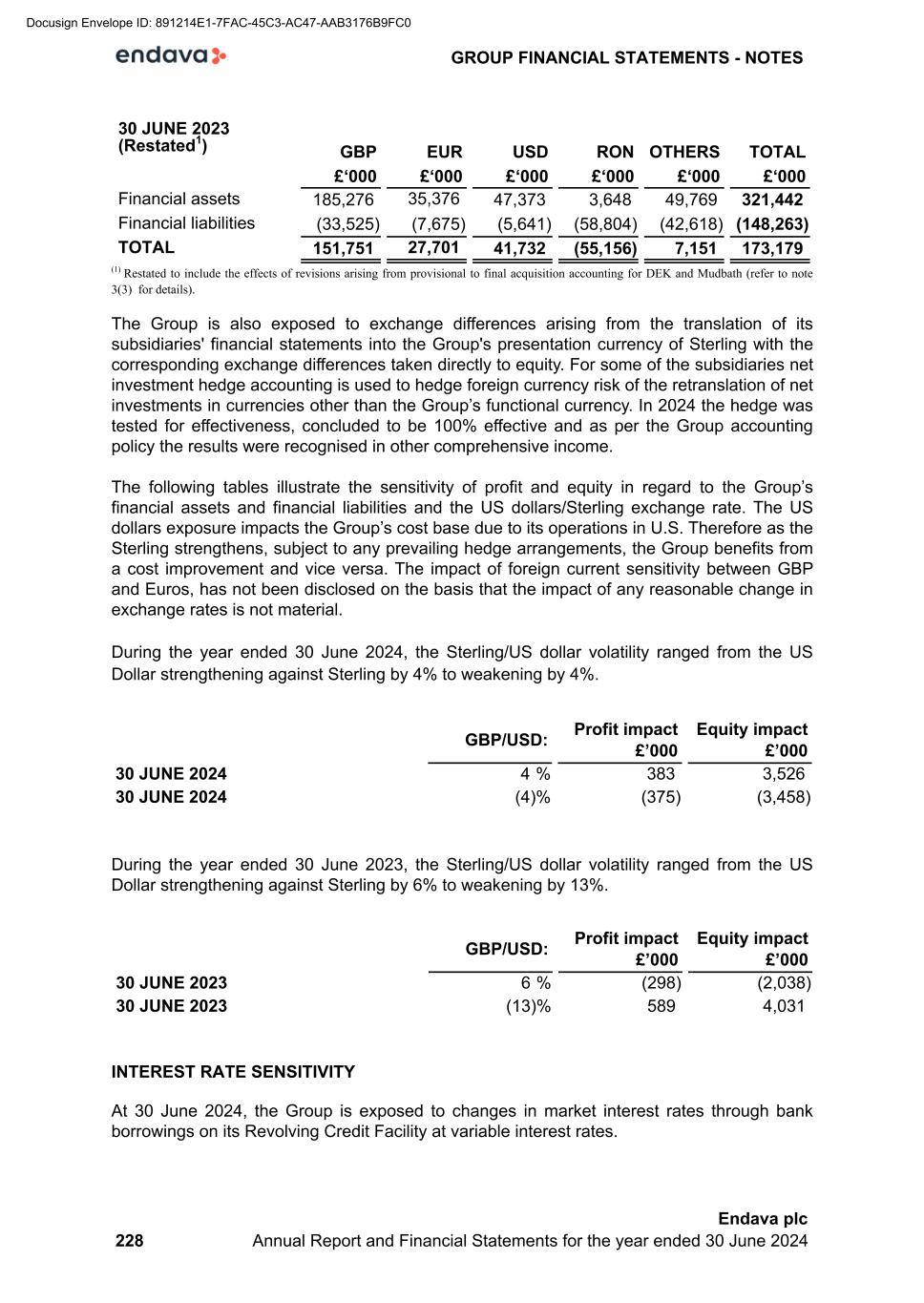
30 JUNE 2023 (Restated1) GBP EUR USD RON OTHERS TOTAL £‘000 £‘000 £‘000 £‘000 £‘000 £‘000 Financial assets 185,276 35,376 47,373 3,648 49,769 321,442 Financial liabilities (33,525) (7,675) (5,641) (58,804) (42,618) (148,263) TOTAL 151,751 27,701 41,732 (55,156) 7,151 173,179 (1) Restated to include the effects of revisions arising from provisional to final acquisition accounting for DEK and Mudbath (refer to note 3(3) for details). The Group is also exposed to exchange differences arising from the translation of its subsidiaries' financial statements into the Group's presentation currency of Sterling with the corresponding exchange differences taken directly to equity. For some of the subsidiaries net investment hedge accounting is used to hedge foreign currency risk of the retranslation of net investments in currencies other than the Group’s functional currency. In 2024 the hedge was tested for effectiveness, concluded to be 100% effective and as per the Group accounting policy the results were recognised in other comprehensive income. The following tables illustrate the sensitivity of profit and equity in regard to the Group’s financial assets and financial liabilities and the US dollars/Sterling exchange rate. The US dollars exposure impacts the Group’s cost base due to its operations in U.S. Therefore as the Sterling strengthens, subject to any prevailing hedge arrangements, the Group benefits from a cost improvement and vice versa. The impact of foreign current sensitivity between GBP and Euros, has not been disclosed on the basis that the impact of any reasonable change in exchange rates is not material. During the year ended 30 June 2024, the Sterling/US dollar volatility ranged from the US Dollar strengthening against Sterling by 4% to weakening by 4%. GBP/USD: Profit impact £’000 Equity impact £’000 30 JUNE 2024 4 % 383 3,526 30 JUNE 2024 (4) % (375) (3,458) During the year ended 30 June 2023, the Sterling/US dollar volatility ranged from the US Dollar strengthening against Sterling by 6% to weakening by 13%. GBP/USD: Profit impact £’000 Equity impact £’000 30 JUNE 2023 6 % (298) (2,038) 30 JUNE 2023 (13) % 589 4,031 INTEREST RATE SENSITIVITY At 30 June 2024, the Group is exposed to changes in market interest rates through bank borrowings on its Revolving Credit Facility at variable interest rates. GROUP FINANCIAL STATEMENTS - NOTES 228 Endava plc Annual Report and Financial Statements for the year ended 30 June 2024 Docusign Envelope ID: 891214E1-7FAC-45C3-AC47-AAB3176B9FC0
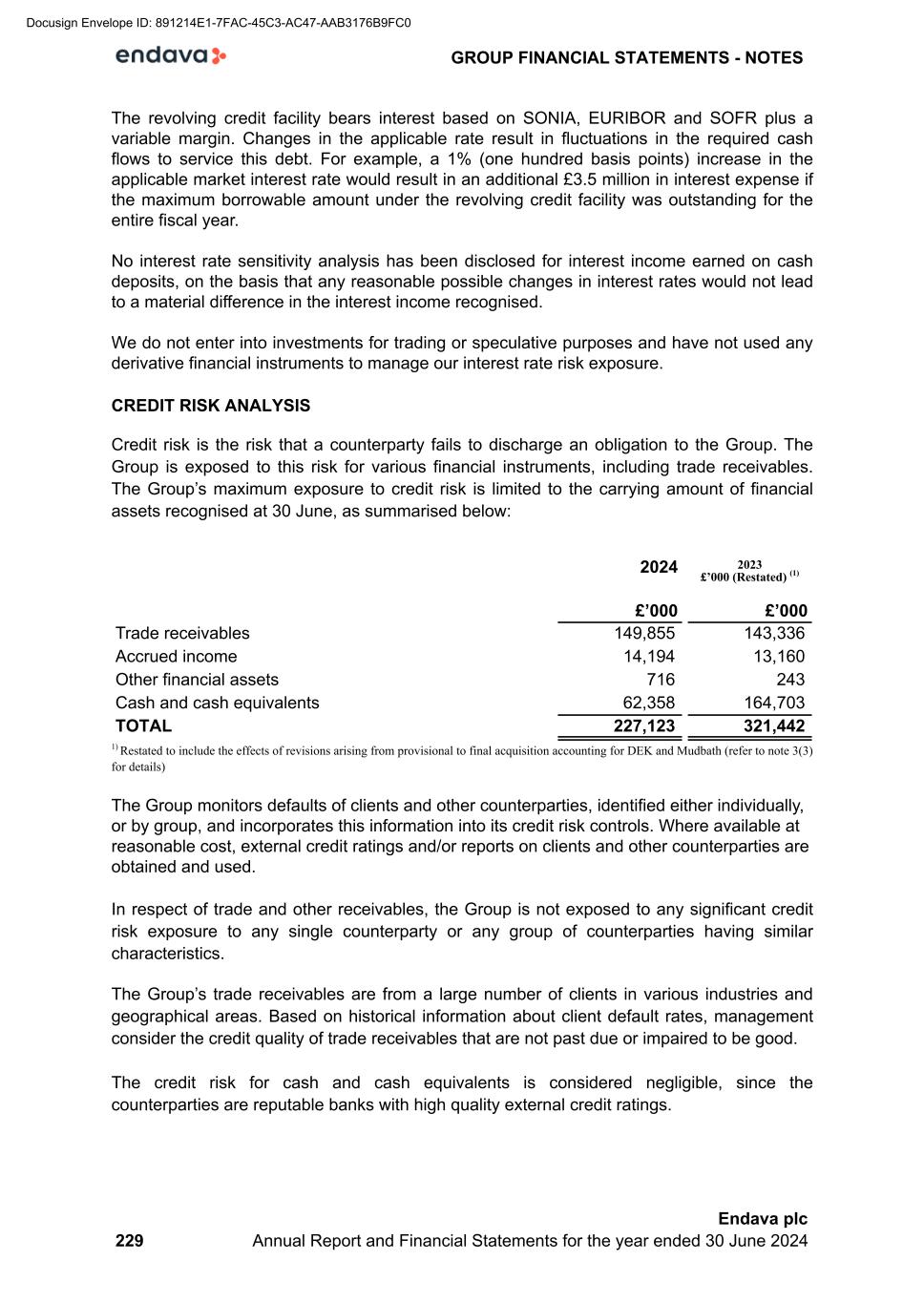
The revolving credit facility bears interest based on SONIA, EURIBOR and SOFR plus a variable margin. Changes in the applicable rate result in fluctuations in the required cash flows to service this debt. For example, a 1% (one hundred basis points) increase in the applicable market interest rate would result in an additional £3.5 million in interest expense if the maximum borrowable amount under the revolving credit facility was outstanding for the entire fiscal year. No interest rate sensitivity analysis has been disclosed for interest income earned on cash deposits, on the basis that any reasonable possible changes in interest rates would not lead to a material difference in the interest income recognised. We do not enter into investments for trading or speculative purposes and have not used any derivative financial instruments to manage our interest rate risk exposure. CREDIT RISK ANALYSIS Credit risk is the risk that a counterparty fails to discharge an obligation to the Group. The Group is exposed to this risk for various financial instruments, including trade receivables. The Group’s maximum exposure to credit risk is limited to the carrying amount of financial assets recognised at 30 June, as summarised below: 2024 2023 £’000 (Restated) (1) £’000 £’000 Trade receivables 149,855 143,336 Accrued income 14,194 13,160 Other financial assets 716 243 Cash and cash equivalents 62,358 164,703 TOTAL 227,123 321,442 1) Restated to include the effects of revisions arising from provisional to final acquisition accounting for DEK and Mudbath (refer to note 3(3) for details) The Group monitors defaults of clients and other counterparties, identified either individually, or by group, and incorporates this information into its credit risk controls. Where available at reasonable cost, external credit ratings and/or reports on clients and other counterparties are obtained and used. In respect of trade and other receivables, the Group is not exposed to any significant credit risk exposure to any single counterparty or any group of counterparties having similar characteristics. The Group’s trade receivables are from a large number of clients in various industries and geographical areas. Based on historical information about client default rates, management consider the credit quality of trade receivables that are not past due or impaired to be good. The credit risk for cash and cash equivalents is considered negligible, since the counterparties are reputable banks with high quality external credit ratings. GROUP FINANCIAL STATEMENTS - NOTES 229 Endava plc Annual Report and Financial Statements for the year ended 30 June 2024 Docusign Envelope ID: 891214E1-7FAC-45C3-AC47-AAB3176B9FC0
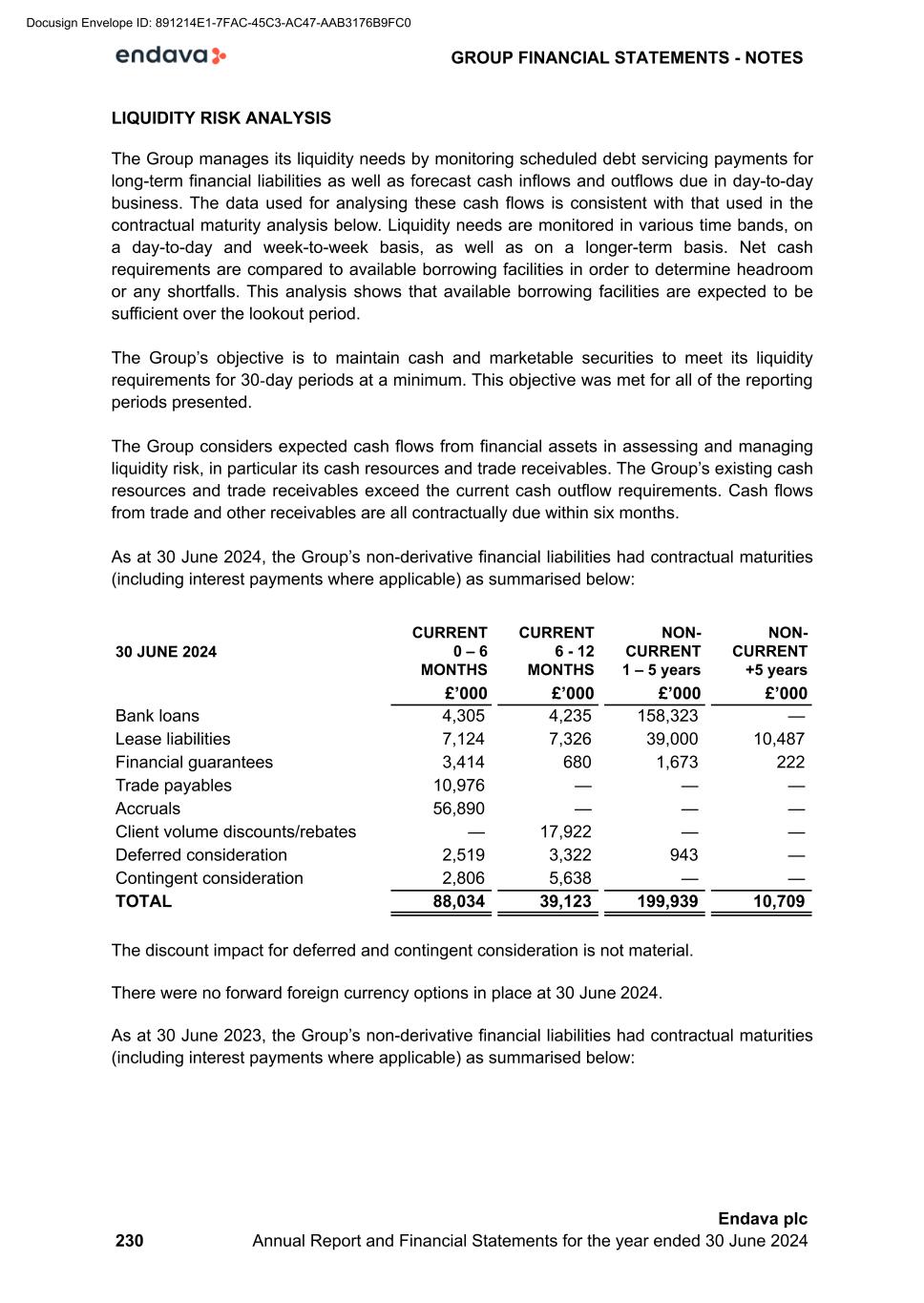
LIQUIDITY RISK ANALYSIS The Group manages its liquidity needs by monitoring scheduled debt servicing payments for long-term financial liabilities as well as forecast cash inflows and outflows due in day-to-day business. The data used for analysing these cash flows is consistent with that used in the contractual maturity analysis below. Liquidity needs are monitored in various time bands, on a day-to-day and week-to-week basis, as well as on a longer-term basis. Net cash requirements are compared to available borrowing facilities in order to determine headroom or any shortfalls. This analysis shows that available borrowing facilities are expected to be sufficient over the lookout period. The Group’s objective is to maintain cash and marketable securities to meet its liquidity requirements for 30-day periods at a minimum. This objective was met for all of the reporting periods presented. The Group considers expected cash flows from financial assets in assessing and managing liquidity risk, in particular its cash resources and trade receivables. The Group’s existing cash resources and trade receivables exceed the current cash outflow requirements. Cash flows from trade and other receivables are all contractually due within six months. As at 30 June 2024, the Group’s non-derivative financial liabilities had contractual maturities (including interest payments where applicable) as summarised below: 30 JUNE 2024 CURRENT 0 – 6 MONTHS CURRENT 6 - 12 MONTHS NON- CURRENT 1 – 5 years NON- CURRENT +5 years £’000 £’000 £’000 £’000 Bank loans 4,305 4,235 158,323 — Lease liabilities 7,124 7,326 39,000 10,487 Financial guarantees 3,414 680 1,673 222 Trade payables 10,976 — — — Accruals 56,890 — — — Client volume discounts/rebates — 17,922 — — Deferred consideration 2,519 3,322 943 — Contingent consideration 2,806 5,638 — — TOTAL 88,034 39,123 199,939 10,709 The discount impact for deferred and contingent consideration is not material. There were no forward foreign currency options in place at 30 June 2024. As at 30 June 2023, the Group’s non-derivative financial liabilities had contractual maturities (including interest payments where applicable) as summarised below: GROUP FINANCIAL STATEMENTS - NOTES 230 Endava plc Annual Report and Financial Statements for the year ended 30 June 2024 Docusign Envelope ID: 891214E1-7FAC-45C3-AC47-AAB3176B9FC0
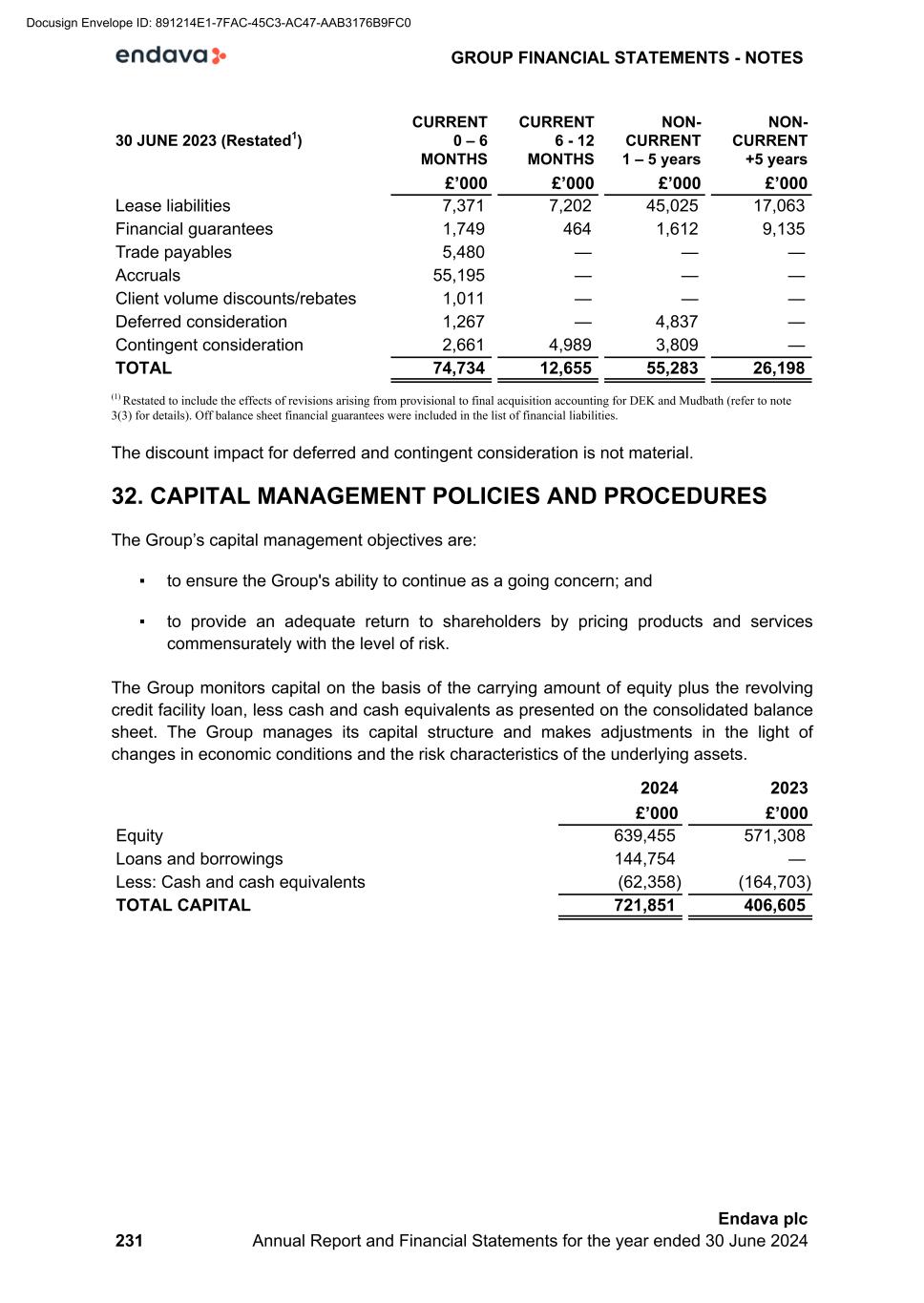
30 JUNE 2023 (Restated1) CURRENT 0 – 6 MONTHS CURRENT 6 - 12 MONTHS NON- CURRENT 1 – 5 years NON- CURRENT +5 years £’000 £’000 £’000 £’000 Lease liabilities 7,371 7,202 45,025 17,063 Financial guarantees 1,749 464 1,612 9,135 Trade payables 5,480 — — — Accruals 55,195 — — — Client volume discounts/rebates 1,011 — — — Deferred consideration 1,267 — 4,837 — Contingent consideration 2,661 4,989 3,809 — TOTAL 74,734 12,655 55,283 26,198 (1) Restated to include the effects of revisions arising from provisional to final acquisition accounting for DEK and Mudbath (refer to note 3(3) for details). Off balance sheet financial guarantees were included in the list of financial liabilities. The discount impact for deferred and contingent consideration is not material. 32. CAPITAL MANAGEMENT POLICIES AND PROCEDURES The Group’s capital management objectives are: ▪ to ensure the Group's ability to continue as a going concern; and ▪ to provide an adequate return to shareholders by pricing products and services commensurately with the level of risk. The Group monitors capital on the basis of the carrying amount of equity plus the revolving credit facility loan, less cash and cash equivalents as presented on the consolidated balance sheet. The Group manages its capital structure and makes adjustments in the light of changes in economic conditions and the risk characteristics of the underlying assets. 2024 2023 £’000 £’000 Equity 639,455 571,308 Loans and borrowings 144,754 — Less: Cash and cash equivalents (62,358) (164,703) TOTAL CAPITAL 721,851 406,605 GROUP FINANCIAL STATEMENTS - NOTES 231 Endava plc Annual Report and Financial Statements for the year ended 30 June 2024 Docusign Envelope ID: 891214E1-7FAC-45C3-AC47-AAB3176B9FC0
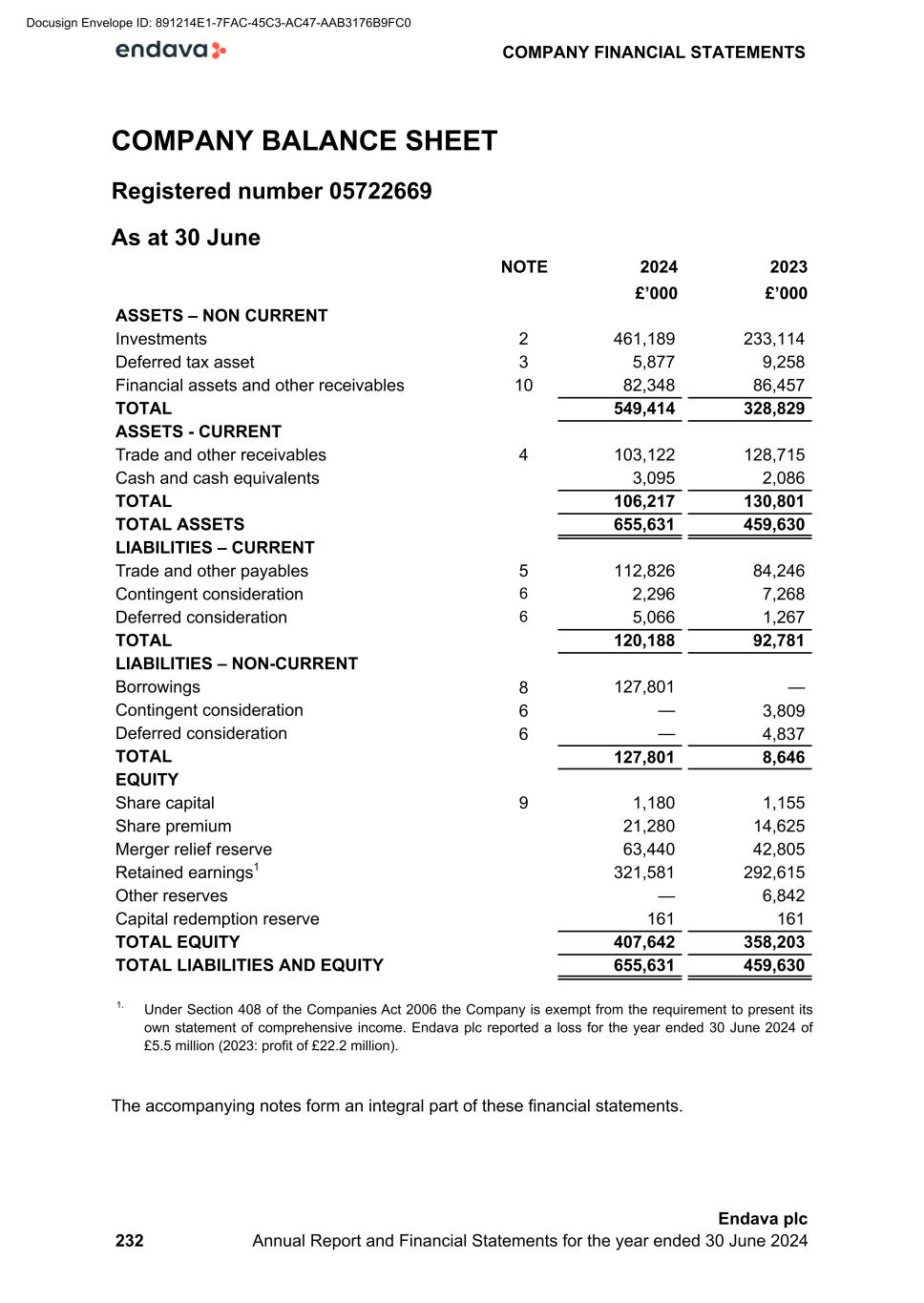
COMPANY BALANCE SHEET Registered number 05722669 As at 30 June NOTE 2024 2023 £’000 £’000 ASSETS – NON CURRENT Investments 2 461,189 233,114 Deferred tax asset 3 5,877 9,258 Financial assets and other receivables 10 82,348 86,457 TOTAL 549,414 328,829 ASSETS - CURRENT Trade and other receivables 4 103,122 128,715 Cash and cash equivalents 3,095 2,086 TOTAL 106,217 130,801 TOTAL ASSETS 655,631 459,630 LIABILITIES – CURRENT Trade and other payables 5 112,826 84,246 Contingent consideration 6 2,296 7,268 Deferred consideration 6 5,066 1,267 TOTAL 120,188 92,781 LIABILITIES – NON-CURRENT Borrowings 8 127,801 — Contingent consideration 6 — 3,809 Deferred consideration 6 — 4,837 TOTAL 127,801 8,646 EQUITY Share capital 9 1,180 1,155 Share premium 21,280 14,625 Merger relief reserve 63,440 42,805 Retained earnings1 321,581 292,615 Other reserves — 6,842 Capital redemption reserve 161 161 TOTAL EQUITY 407,642 358,203 TOTAL LIABILITIES AND EQUITY 655,631 459,630 1. Under Section 408 of the Companies Act 2006 the Company is exempt from the requirement to present its own statement of comprehensive income. Endava plc reported a loss for the year ended 30 June 2024 of £5.5 million (2023: profit of £22.2 million). The accompanying notes form an integral part of these financial statements. COMPANY FINANCIAL STATEMENTS 232 Endava plc Annual Report and Financial Statements for the year ended 30 June 2024 Docusign Envelope ID: 891214E1-7FAC-45C3-AC47-AAB3176B9FC0
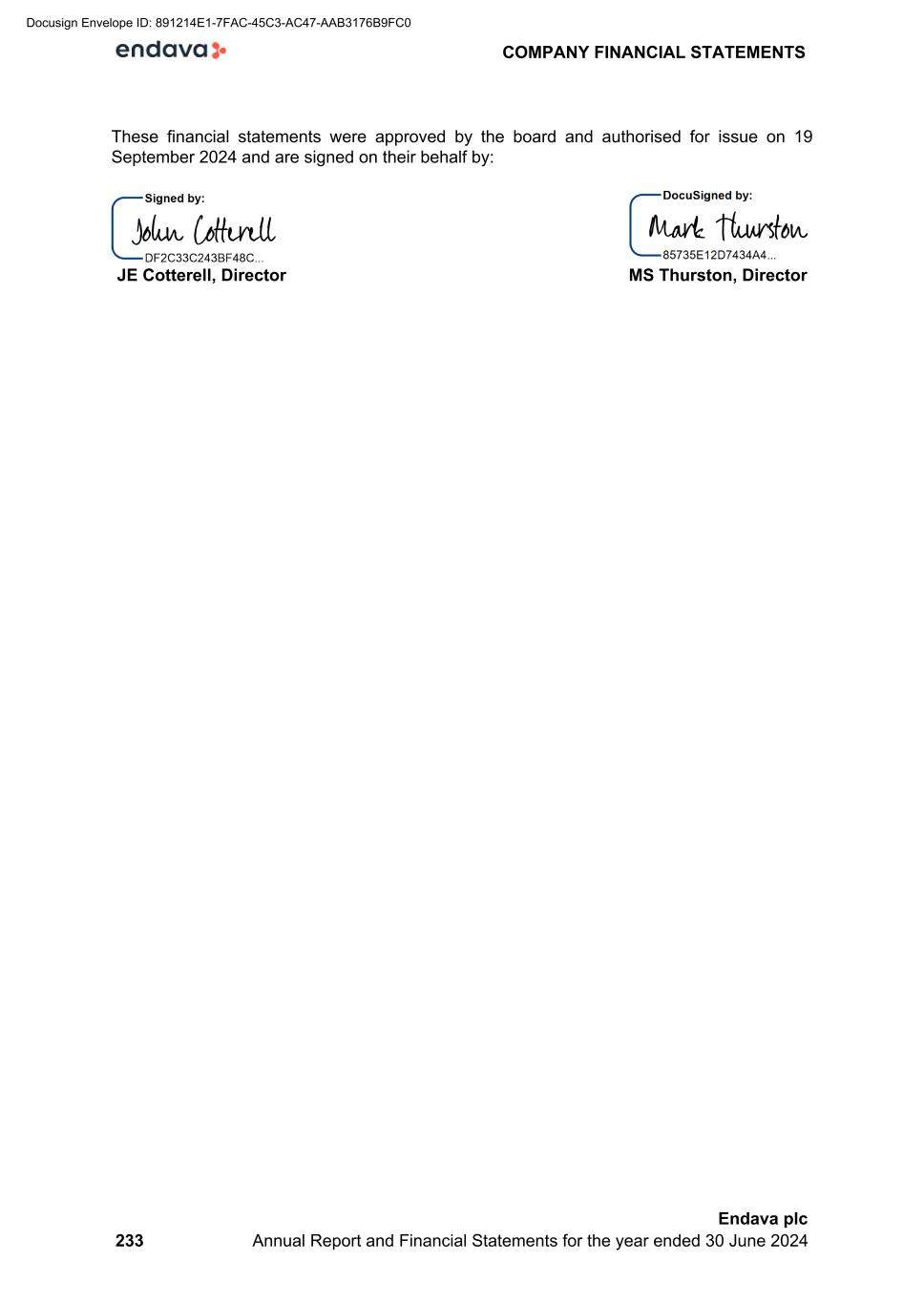
These financial statements were approved by the board and authorised for issue on 19 September 2024 and are signed on their behalf by: JE Cotterell, Director MS Thurston, Director COMPANY FINANCIAL STATEMENTS 233 Endava plc Annual Report and Financial Statements for the year ended 30 June 2024 Docusign Envelope ID: 891214E1-7FAC-45C3-AC47-AAB3176B9FC0
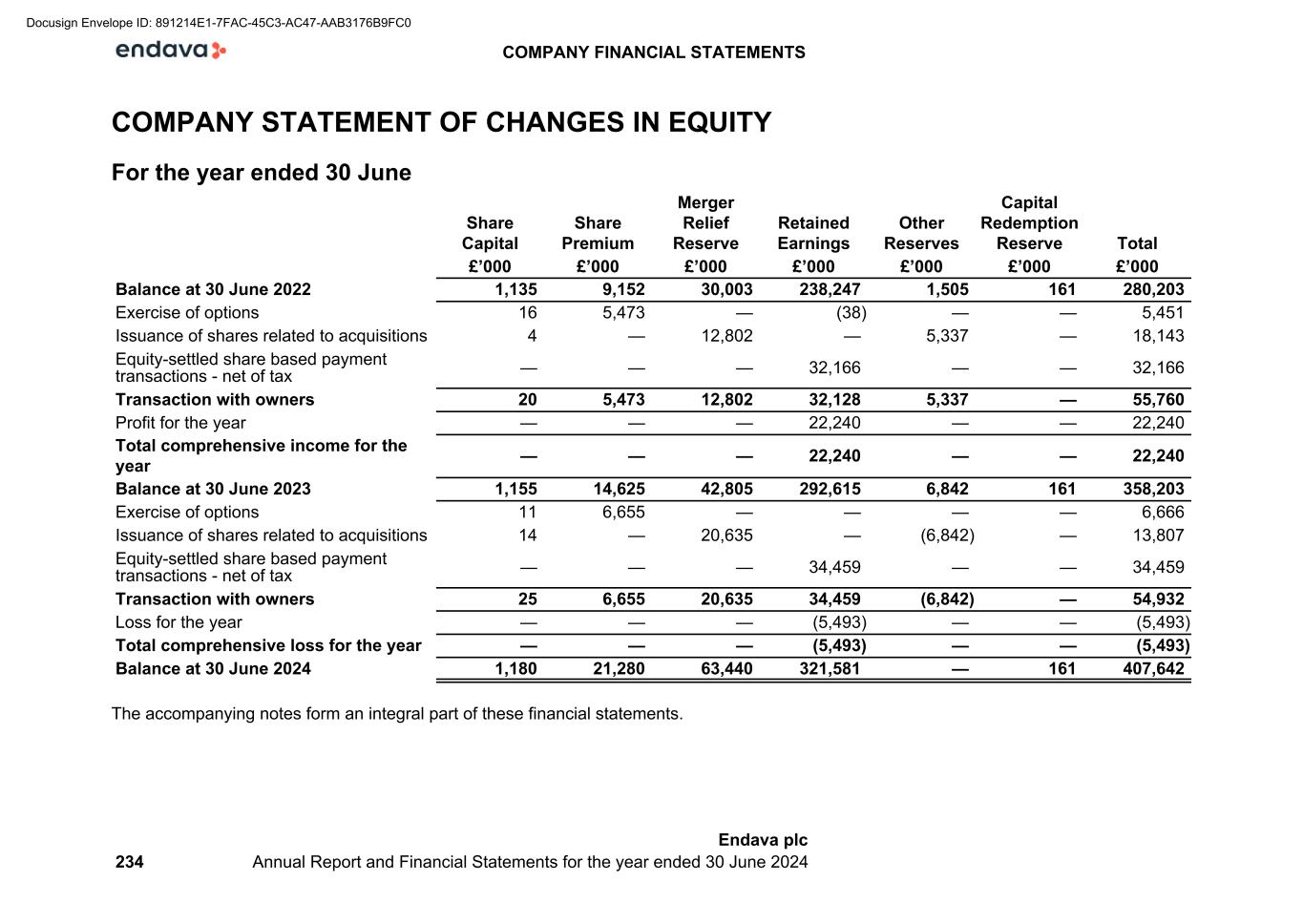
COMPANY STATEMENT OF CHANGES IN EQUITY For the year ended 30 June Share Capital Share Premium Merger Relief Reserve Retained Earnings Other Reserves Capital Redemption Reserve Total £’000 £’000 £’000 £’000 £’000 £’000 £’000 Balance at 30 June 2022 1,135 9,152 30,003 238,247 1,505 161 280,203 Exercise of options 16 5,473 — (38) — — 5,451 Issuance of shares related to acquisitions 4 — 12,802 — 5,337 — 18,143 Equity-settled share based payment transactions - net of tax — — — 32,166 — — 32,166 Transaction with owners 20 5,473 12,802 32,128 5,337 — 55,760 Profit for the year — — — 22,240 — — 22,240 Total comprehensive income for the year — — — 22,240 — — 22,240 Balance at 30 June 2023 1,155 14,625 42,805 292,615 6,842 161 358,203 Exercise of options 11 6,655 — — — — 6,666 Issuance of shares related to acquisitions 14 — 20,635 — (6,842) — 13,807 Equity-settled share based payment transactions - net of tax — — — 34,459 — — 34,459 Transaction with owners 25 6,655 20,635 34,459 (6,842) — 54,932 Loss for the year — — — (5,493) — — (5,493) Total comprehensive loss for the year — — — (5,493) — — (5,493) Balance at 30 June 2024 1,180 21,280 63,440 321,581 — 161 407,642 The accompanying notes form an integral part of these financial statements. COMPANY FINANCIAL STATEMENTS 234 Endava plc Annual Report and Financial Statements for the year ended 30 June 2024 Docusign Envelope ID: 891214E1-7FAC-45C3-AC47-AAB3176B9FC0

NOTES TO THE COMPANY FINANCIAL STATEMENTS For the year ended 30 June 1. MATERIAL ACCOUNTING POLICIES BASIS OF PREPARATION The company financial statements have been prepared in accordance with Financial Reporting Standard 101, “Reduced Disclosure Framework” (“FRS 101”) and with the requirements of the Companies Act 2006 as applicable to companies reporting under those standards. During the reporting period, the Company transitioned from UK-adopted International Accounting Standards (“UK IFRS”) to FRS 101 and there has been no material effect on the comparative financial statements as a result of this change. The Company financial statements are presented in British Pound Sterling (“Sterling”), which is the Company’s functional currency. The material accounting policies set out below have, unless otherwise stated, been applied consistently to all periods presented in these financial statements. There have been no new or amended accounting standards or interpretations adopted during the year that have a material impact on the Company financial statements. The following exemptions from the requirements of IFRS have been applied in the preparation of these financial statements, in accordance with FRS 101: • Paragraphs 45(b) and 46 to 52 of IFRS 2, ‘Share-based payment’ (details of the number and weighted average exercise prices of share options, and how the fair value of goods or services received was determined). • IFRS 7, ‘Financial instruments: Disclosures’. • Paragraphs 91 to 99 of IFRS 13, ‘Fair value measurement’ (disclosure of valuation techniques and inputs used for fair value measurement of assets and liabilities). • Paragraph 38 of IAS 1, 'Presentation of financial statements' – comparative information requirements in respect of: – paragraph 79(a)(iv) of IAS 1; – paragraph 73(e) of IAS 16, 'Property, plant and equipment'; and – paragraph 118(e) of IAS 38, 'Intangible assets' (reconciliations between the carrying amount at the beginning and end of the period). • The following paragraphs of IAS 1, ‘Presentation of financial statements’: – 10(d) (statement of cash flows); – 16 (statement of compliance with all IFRS); – 38A (requirement for minimum of two primary statements, including cash flow statements); – 38B-D (additional comparative information); – 111 (statement of cash flows information); and – 134-136 (capital management disclosures). • IAS 7, ‘Statement of cash flows’. COMPANY FINANCIAL STATEMENTS - NOTES 235 Endava plc Annual Report and Financial Statements for the year ended 30 June 2024 Docusign Envelope ID: 891214E1-7FAC-45C3-AC47-AAB3176B9FC0
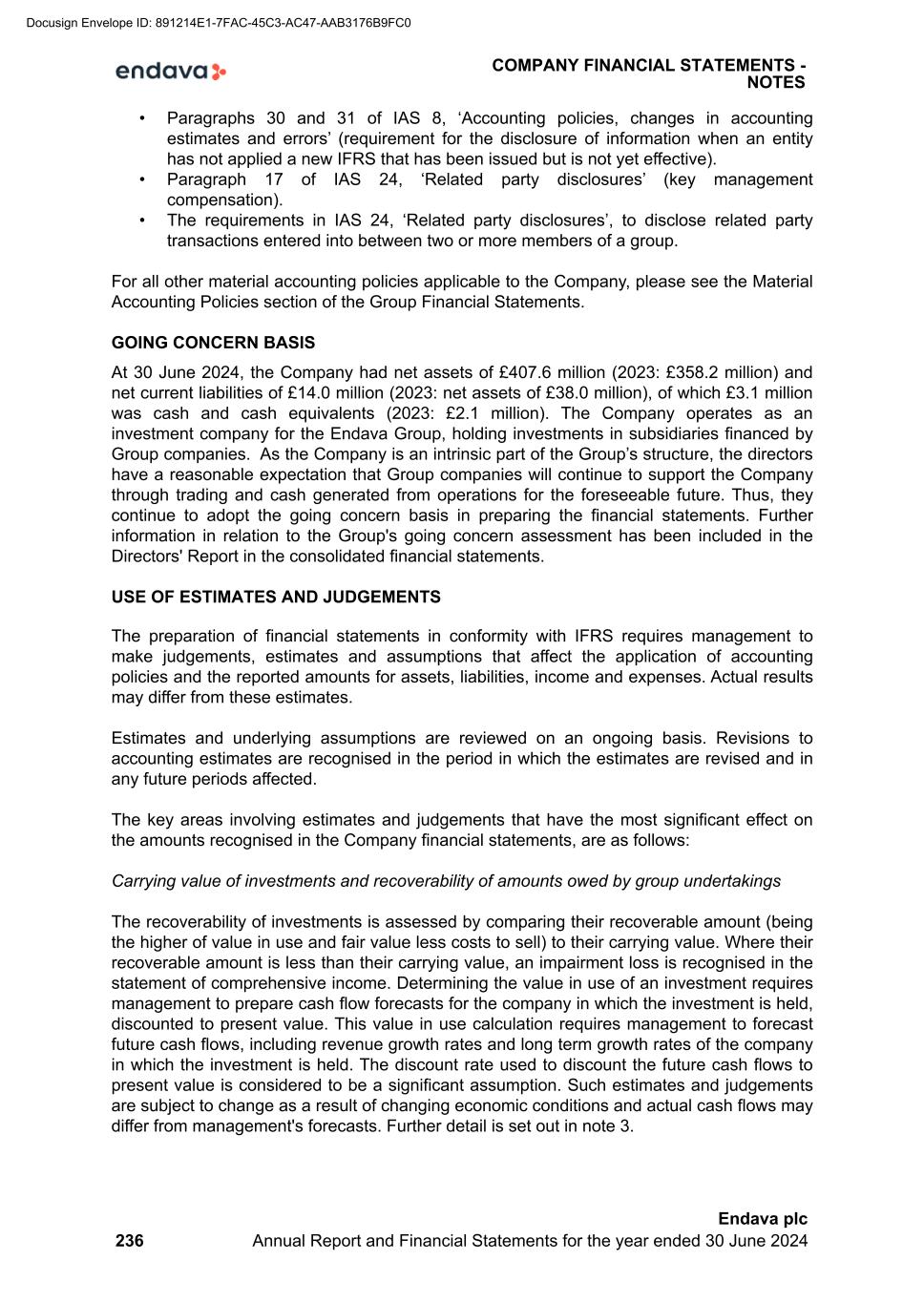
• Paragraphs 30 and 31 of IAS 8, ‘Accounting policies, changes in accounting estimates and errors’ (requirement for the disclosure of information when an entity has not applied a new IFRS that has been issued but is not yet effective). • Paragraph 17 of IAS 24, ‘Related party disclosures’ (key management compensation). • The requirements in IAS 24, ‘Related party disclosures’, to disclose related party transactions entered into between two or more members of a group. For all other material accounting policies applicable to the Company, please see the Material Accounting Policies section of the Group Financial Statements. GOING CONCERN BASIS At 30 June 2024, the Company had net assets of £407.6 million (2023: £358.2 million) and net current liabilities of £14.0 million (2023: net assets of £38.0 million), of which £3.1 million was cash and cash equivalents (2023: £2.1 million). The Company operates as an investment company for the Endava Group, holding investments in subsidiaries financed by Group companies. As the Company is an intrinsic part of the Group’s structure, the directors have a reasonable expectation that Group companies will continue to support the Company through trading and cash generated from operations for the foreseeable future. Thus, they continue to adopt the going concern basis in preparing the financial statements. Further information in relation to the Group's going concern assessment has been included in the Directors' Report in the consolidated financial statements. USE OF ESTIMATES AND JUDGEMENTS The preparation of financial statements in conformity with IFRS requires management to make judgements, estimates and assumptions that affect the application of accounting policies and the reported amounts for assets, liabilities, income and expenses. Actual results may differ from these estimates. Estimates and underlying assumptions are reviewed on an ongoing basis. Revisions to accounting estimates are recognised in the period in which the estimates are revised and in any future periods affected. The key areas involving estimates and judgements that have the most significant effect on the amounts recognised in the Company financial statements, are as follows: Carrying value of investments and recoverability of amounts owed by group undertakings The recoverability of investments is assessed by comparing their recoverable amount (being the higher of value in use and fair value less costs to sell) to their carrying value. Where their recoverable amount is less than their carrying value, an impairment loss is recognised in the statement of comprehensive income. Determining the value in use of an investment requires management to prepare cash flow forecasts for the company in which the investment is held, discounted to present value. This value in use calculation requires management to forecast future cash flows, including revenue growth rates and long term growth rates of the company in which the investment is held. The discount rate used to discount the future cash flows to present value is considered to be a significant assumption. Such estimates and judgements are subject to change as a result of changing economic conditions and actual cash flows may differ from management's forecasts. Further detail is set out in note 3. COMPANY FINANCIAL STATEMENTS - NOTES 236 Endava plc Annual Report and Financial Statements for the year ended 30 June 2024 Docusign Envelope ID: 891214E1-7FAC-45C3-AC47-AAB3176B9FC0

INVESTMENTS Investments in subsidiary undertakings are stated at historical cost, less any provision for impairment. The carrying amounts of the Company's investments are reviewed at each reporting date to determine whether there is an indication of impairment. If such an indication exists, then the asset's recoverable amount is estimated. Losses are recognised in the statement of comprehensive income and reflected in an allowance against the carrying value. Where an event results in the asset's recoverable amount being higher than the previously impaired carrying value, the original impairment may be reversed through the statement of comprehensive income in subsequent periods. EMPLOYEE BENEFIT TRUST ("EBT") On June 28, 2011, the Company established the Employee Benefit Trust to operate in conjunction with our JSOP and other incentive arrangements. The beneficiaries of the Employee Benefit Trust are our employees, including former employees, and directors. The Trustee is an independent trustee. The EBT is accounted for as a legal entity separate from the Company but as a subsidiary of the entity. Any loan from the reporting entity to the trust is accounted for as a loan in accordance with its terms. If the EBT is funded by the Company making an investment in the EBT, then the Company recognises the investment in the subsidiary as an asset. EXPECTED CREDIT LOSS The expected credit losses for amounts owed from group undertakings are based on management assumptions about the risk of default and expected loss rates. Probability of default constitutes the key input in measuring expected credit losses and is provided by an external credit rating agency, and our assumptions are based on history, external conditions and forward looking scenarios. Management does not apply significant judgement in this area. The expected credit losses for non-current intercompany loans is based on the assumption that they represent low credit risk loans based on external ratings agency data that is available for the Endava Group. The company therefore uses a 12-month expected credit loss approach. Our assumptions are based on history, external conditions and forward looking scenarios. Management does not apply significant judgement in this area. 2. INVESTMENTS COST AND NET BOOK VALUE £’000 At 1 July 2023 233,114 Additions 326,920 Transfers (98,845) At 30 June 2024 461,189 COMPANY FINANCIAL STATEMENTS - NOTES 237 Endava plc Annual Report and Financial Statements for the year ended 30 June 2024 Docusign Envelope ID: 891214E1-7FAC-45C3-AC47-AAB3176B9FC0
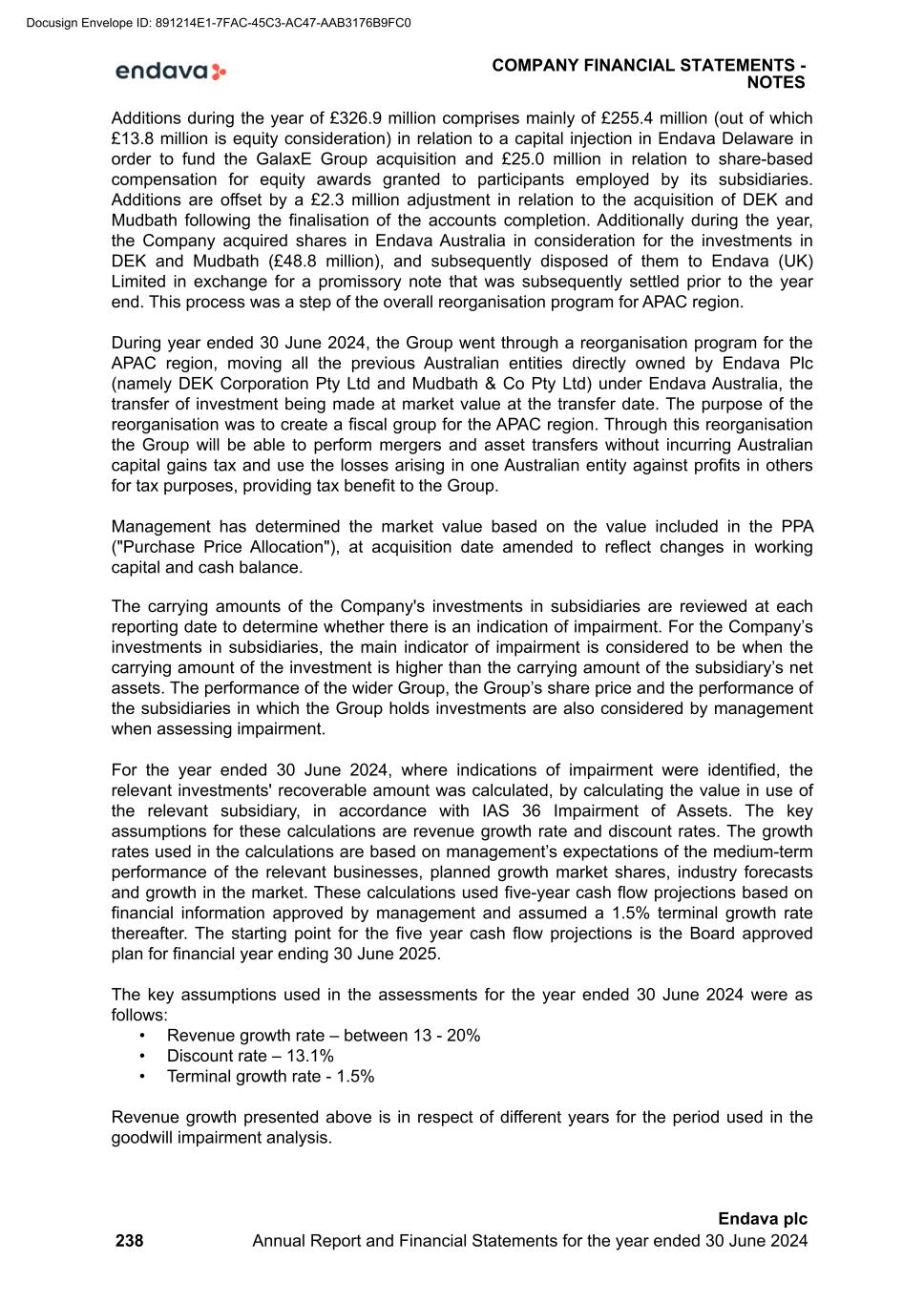
Additions during the year of £326.9 million comprises mainly of £255.4 million (out of which £13.8 million is equity consideration) in relation to a capital injection in Endava Delaware in order to fund the GalaxE Group acquisition and £25.0 million in relation to share-based compensation for equity awards granted to participants employed by its subsidiaries. Additions are offset by a £2.3 million adjustment in relation to the acquisition of DEK and Mudbath following the finalisation of the accounts completion. Additionally during the year, the Company acquired shares in Endava Australia in consideration for the investments in DEK and Mudbath (£48.8 million), and subsequently disposed of them to Endava (UK) Limited in exchange for a promissory note that was subsequently settled prior to the year end. This process was a step of the overall reorganisation program for APAC region. During year ended 30 June 2024, the Group went through a reorganisation program for the APAC region, moving all the previous Australian entities directly owned by Endava Plc (namely DEK Corporation Pty Ltd and Mudbath & Co Pty Ltd) under Endava Australia, the transfer of investment being made at market value at the transfer date. The purpose of the reorganisation was to create a fiscal group for the APAC region. Through this reorganisation the Group will be able to perform mergers and asset transfers without incurring Australian capital gains tax and use the losses arising in one Australian entity against profits in others for tax purposes, providing tax benefit to the Group. Management has determined the market value based on the value included in the PPA ("Purchase Price Allocation"), at acquisition date amended to reflect changes in working capital and cash balance. The carrying amounts of the Company's investments in subsidiaries are reviewed at each reporting date to determine whether there is an indication of impairment. For the Company’s investments in subsidiaries, the main indicator of impairment is considered to be when the carrying amount of the investment is higher than the carrying amount of the subsidiary’s net assets. The performance of the wider Group, the Group’s share price and the performance of the subsidiaries in which the Group holds investments are also considered by management when assessing impairment. For the year ended 30 June 2024, where indications of impairment were identified, the relevant investments' recoverable amount was calculated, by calculating the value in use of the relevant subsidiary, in accordance with IAS 36 Impairment of Assets. The key assumptions for these calculations are revenue growth rate and discount rates. The growth rates used in the calculations are based on management’s expectations of the medium-term performance of the relevant businesses, planned growth market shares, industry forecasts and growth in the market. These calculations used five-year cash flow projections based on financial information approved by management and assumed a 1.5% terminal growth rate thereafter. The starting point for the five year cash flow projections is the Board approved plan for financial year ending 30 June 2025. The key assumptions used in the assessments for the year ended 30 June 2024 were as follows: • Revenue growth rate – between 13 - 20% • Discount rate – 13.1% • Terminal growth rate - 1.5% Revenue growth presented above is in respect of different years for the period used in the goodwill impairment analysis. COMPANY FINANCIAL STATEMENTS - NOTES 238 Endava plc Annual Report and Financial Statements for the year ended 30 June 2024 Docusign Envelope ID: 891214E1-7FAC-45C3-AC47-AAB3176B9FC0
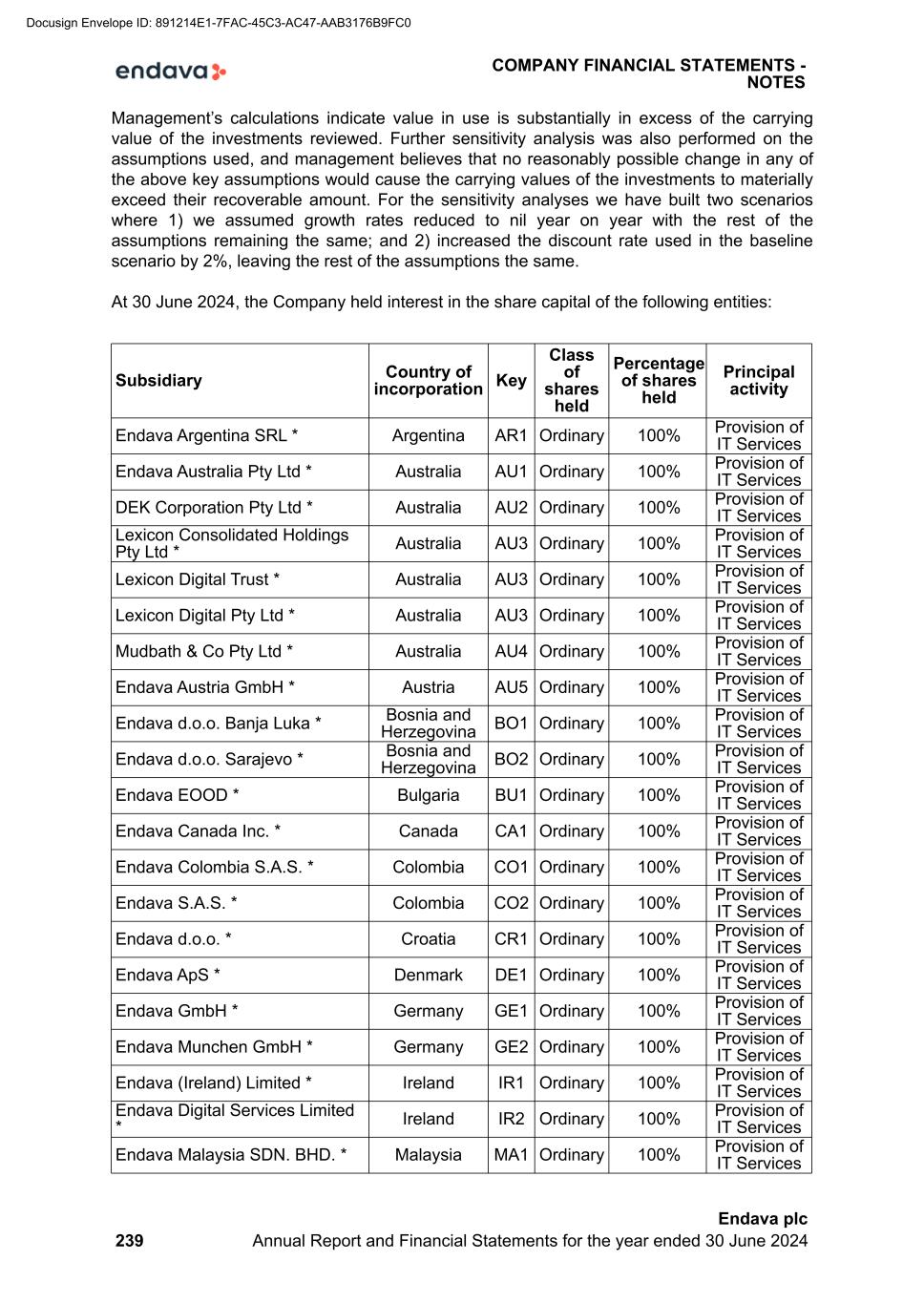
Management’s calculations indicate value in use is substantially in excess of the carrying value of the investments reviewed. Further sensitivity analysis was also performed on the assumptions used, and management believes that no reasonably possible change in any of the above key assumptions would cause the carrying values of the investments to materially exceed their recoverable amount. For the sensitivity analyses we have built two scenarios where 1) we assumed growth rates reduced to nil year on year with the rest of the assumptions remaining the same; and 2) increased the discount rate used in the baseline scenario by 2%, leaving the rest of the assumptions the same. At 30 June 2024, the Company held interest in the share capital of the following entities: Subsidiary Country of incorporation Key Class of shares held Percentage of shares held Principal activity Endava Argentina SRL * Argentina AR1 Ordinary 100% Provision of IT Services Endava Australia Pty Ltd * Australia AU1 Ordinary 100% Provision of IT Services DEK Corporation Pty Ltd * Australia AU2 Ordinary 100% Provision of IT Services Lexicon Consolidated Holdings Pty Ltd * Australia AU3 Ordinary 100% Provision of IT Services Lexicon Digital Trust * Australia AU3 Ordinary 100% Provision of IT Services Lexicon Digital Pty Ltd * Australia AU3 Ordinary 100% Provision of IT Services Mudbath & Co Pty Ltd * Australia AU4 Ordinary 100% Provision of IT Services Endava Austria GmbH * Austria AU5 Ordinary 100% Provision of IT Services Endava d.o.o. Banja Luka * Bosnia and Herzegovina BO1 Ordinary 100% Provision of IT Services Endava d.o.o. Sarajevo * Bosnia and Herzegovina BO2 Ordinary 100% Provision of IT Services Endava EOOD * Bulgaria BU1 Ordinary 100% Provision of IT Services Endava Canada Inc. * Canada CA1 Ordinary 100% Provision of IT Services Endava Colombia S.A.S. * Colombia CO1 Ordinary 100% Provision of IT Services Endava S.A.S. * Colombia CO2 Ordinary 100% Provision of IT Services Endava d.o.o. * Croatia CR1 Ordinary 100% Provision of IT Services Endava ApS * Denmark DE1 Ordinary 100% Provision of IT Services Endava GmbH * Germany GE1 Ordinary 100% Provision of IT Services Endava Munchen GmbH * Germany GE2 Ordinary 100% Provision of IT Services Endava (Ireland) Limited * Ireland IR1 Ordinary 100% Provision of IT Services Endava Digital Services Limited * Ireland IR2 Ordinary 100% Provision of IT Services Endava Malaysia SDN. BHD. * Malaysia MA1 Ordinary 100% Provision of IT Services COMPANY FINANCIAL STATEMENTS - NOTES 239 Endava plc Annual Report and Financial Statements for the year ended 30 June 2024 Docusign Envelope ID: 891214E1-7FAC-45C3-AC47-AAB3176B9FC0
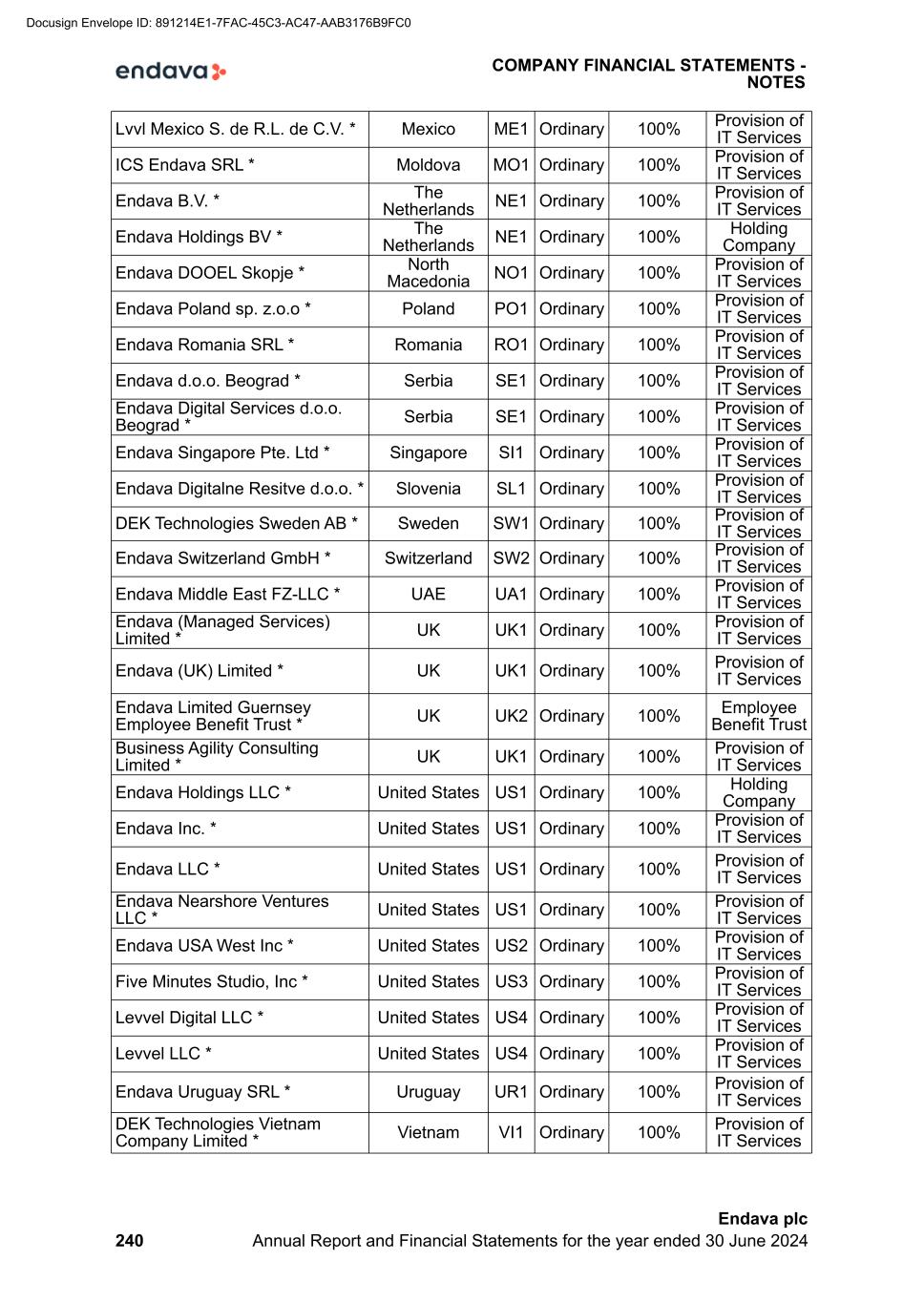
Lvvl Mexico S. de R.L. de C.V. * Mexico ME1 Ordinary 100% Provision of IT Services ICS Endava SRL * Moldova MO1 Ordinary 100% Provision of IT Services Endava B.V. * The Netherlands NE1 Ordinary 100% Provision of IT Services Endava Holdings BV * The Netherlands NE1 Ordinary 100% Holding Company Endava DOOEL Skopje * North Macedonia NO1 Ordinary 100% Provision of IT Services Endava Poland sp. z.o.o * Poland PO1 Ordinary 100% Provision of IT Services Endava Romania SRL * Romania RO1 Ordinary 100% Provision of IT Services Endava d.o.o. Beograd * Serbia SE1 Ordinary 100% Provision of IT Services Endava Digital Services d.o.o. Beograd * Serbia SE1 Ordinary 100% Provision of IT Services Endava Singapore Pte. Ltd * Singapore SI1 Ordinary 100% Provision of IT Services Endava Digitalne Resitve d.o.o. * Slovenia SL1 Ordinary 100% Provision of IT Services DEK Technologies Sweden AB * Sweden SW1 Ordinary 100% Provision of IT Services Endava Switzerland GmbH * Switzerland SW2 Ordinary 100% Provision of IT Services Endava Middle East FZ-LLC * UAE UA1 Ordinary 100% Provision of IT Services Endava (Managed Services) Limited * UK UK1 Ordinary 100% Provision of IT Services Endava (UK) Limited * UK UK1 Ordinary 100% Provision of IT Services Endava Limited Guernsey Employee Benefit Trust * UK UK2 Ordinary 100% Employee Benefit Trust Business Agility Consulting Limited * UK UK1 Ordinary 100% Provision of IT Services Endava Holdings LLC * United States US1 Ordinary 100% Holding Company Endava Inc. * United States US1 Ordinary 100% Provision of IT Services Endava LLC * United States US1 Ordinary 100% Provision of IT Services Endava Nearshore Ventures LLC * United States US1 Ordinary 100% Provision of IT Services Endava USA West Inc * United States US2 Ordinary 100% Provision of IT Services Five Minutes Studio, Inc * United States US3 Ordinary 100% Provision of IT Services Levvel Digital LLC * United States US4 Ordinary 100% Provision of IT Services Levvel LLC * United States US4 Ordinary 100% Provision of IT Services Endava Uruguay SRL * Uruguay UR1 Ordinary 100% Provision of IT Services DEK Technologies Vietnam Company Limited * Vietnam VI1 Ordinary 100% Provision of IT Services COMPANY FINANCIAL STATEMENTS - NOTES 240 Endava plc Annual Report and Financial Statements for the year ended 30 June 2024 Docusign Envelope ID: 891214E1-7FAC-45C3-AC47-AAB3176B9FC0
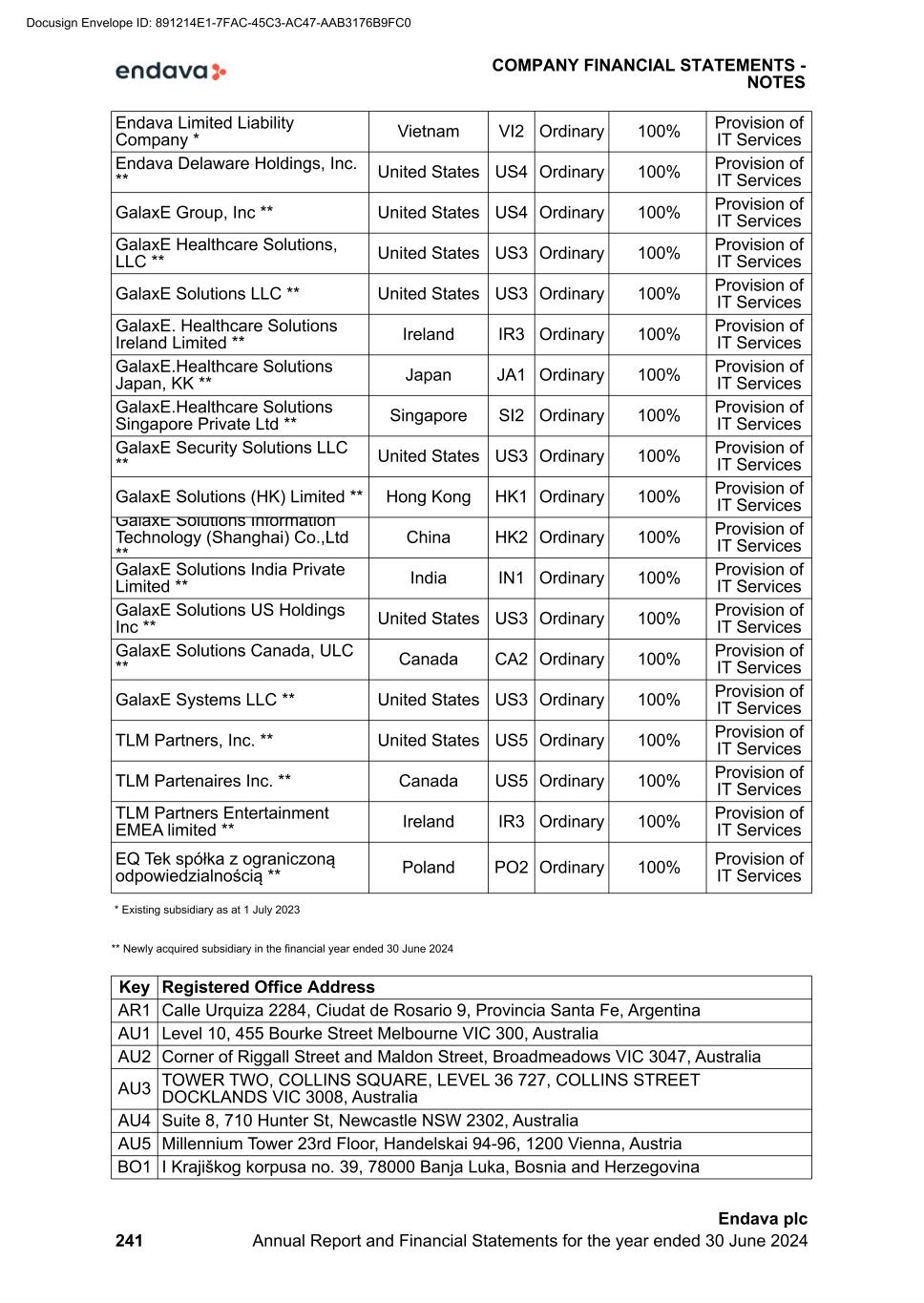
Endava Limited Liability Company * Vietnam VI2 Ordinary 100% Provision of IT Services Endava Delaware Holdings, Inc. ** United States US4 Ordinary 100% Provision of IT Services GalaxE Group, Inc ** United States US4 Ordinary 100% Provision of IT Services GalaxE Healthcare Solutions, LLC ** United States US3 Ordinary 100% Provision of IT Services GalaxE Solutions LLC ** United States US3 Ordinary 100% Provision of IT Services GalaxE. Healthcare Solutions Ireland Limited ** Ireland IR3 Ordinary 100% Provision of IT Services GalaxE.Healthcare Solutions Japan, KK ** Japan JA1 Ordinary 100% Provision of IT Services GalaxE.Healthcare Solutions Singapore Private Ltd ** Singapore SI2 Ordinary 100% Provision of IT Services GalaxE Security Solutions LLC ** United States US3 Ordinary 100% Provision of IT Services GalaxE Solutions (HK) Limited ** Hong Kong HK1 Ordinary 100% Provision of IT Services GalaxE Solutions Information Technology (Shanghai) Co.,Ltd ** China HK2 Ordinary 100% Provision of IT Services GalaxE Solutions India Private Limited ** India IN1 Ordinary 100% Provision of IT Services GalaxE Solutions US Holdings Inc ** United States US3 Ordinary 100% Provision of IT Services GalaxE Solutions Canada, ULC ** Canada CA2 Ordinary 100% Provision of IT Services GalaxE Systems LLC ** United States US3 Ordinary 100% Provision of IT Services TLM Partners, Inc. ** United States US5 Ordinary 100% Provision of IT Services TLM Partenaires Inc. ** Canada US5 Ordinary 100% Provision of IT Services TLM Partners Entertainment EMEA limited ** Ireland IR3 Ordinary 100% Provision of IT Services EQ Tek spółka z ograniczoną odpowiedzialnością ** Poland PO2 Ordinary 100% Provision of IT Services * Existing subsidiary as at 1 July 2023 ** Newly acquired subsidiary in the financial year ended 30 June 2024 Key Registered Office Address AR1 Calle Urquiza 2284, Ciudat de Rosario 9, Provincia Santa Fe, Argentina AU1 Level 10, 455 Bourke Street Melbourne VIC 300, Australia AU2 Corner of Riggall Street and Maldon Street, Broadmeadows VIC 3047, Australia AU3 TOWER TWO, COLLINS SQUARE, LEVEL 36 727, COLLINS STREET DOCKLANDS VIC 3008, Australia AU4 Suite 8, 710 Hunter St, Newcastle NSW 2302, Australia AU5 Millennium Tower 23rd Floor, Handelskai 94-96, 1200 Vienna, Austria BO1 I Krajiškog korpusa no. 39, 78000 Banja Luka, Bosnia and Herzegovina COMPANY FINANCIAL STATEMENTS - NOTES 241 Endava plc Annual Report and Financial Statements for the year ended 30 June 2024 Docusign Envelope ID: 891214E1-7FAC-45C3-AC47-AAB3176B9FC0
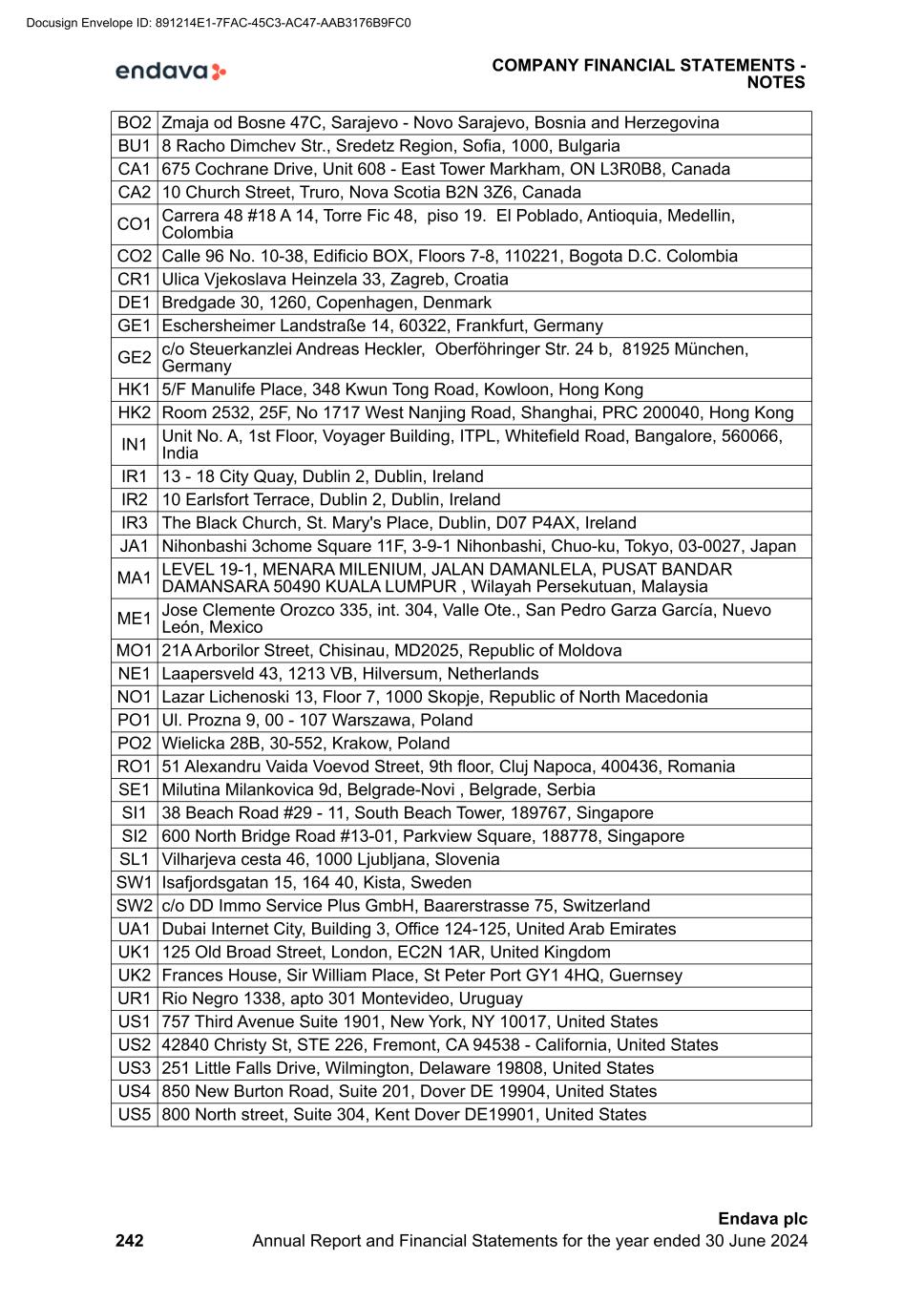
BO2 Zmaja od Bosne 47C, Sarajevo - Novo Sarajevo, Bosnia and Herzegovina BU1 8 Racho Dimchеv Str., Sredetz Region, Sofia, 1000, Bulgaria CA1 675 Cochrane Drive, Unit 608 - East Tower Markham, ON L3R0B8, Canada CA2 10 Church Street, Truro, Nova Scotia B2N 3Z6, Canada CO1 Carrera 48 #18 A 14, Torre Fic 48, piso 19. El Poblado, Antioquia, Medellin, Colombia CO2 Calle 96 No. 10-38, Edificio BOX, Floors 7-8, 110221, Bogota D.C. Colombia CR1 Ulica Vjekoslava Heinzela 33, Zagreb, Croatia DE1 Bredgade 30, 1260, Copenhagen, Denmark GE1 Eschersheimer Landstraße 14, 60322, Frankfurt, Germany GE2 c/o Steuerkanzlei Andreas Heckler, Oberföhringer Str. 24 b, 81925 München, Germany HK1 5/F Manulife Place, 348 Kwun Tong Road, Kowloon, Hong Kong HK2 Room 2532, 25F, No 1717 West Nanjing Road, Shanghai, PRC 200040, Hong Kong IN1 Unit No. A, 1st Floor, Voyager Building, ITPL, Whitefield Road, Bangalore, 560066, India IR1 13 - 18 City Quay, Dublin 2, Dublin, Ireland IR2 10 Earlsfort Terrace, Dublin 2, Dublin, Ireland IR3 The Black Church, St. Mary's Place, Dublin, D07 P4AX, Ireland JA1 Nihonbashi 3chome Square 11F, 3-9-1 Nihonbashi, Chuo-ku, Tokyo, 03-0027, Japan MA1 LEVEL 19-1, MENARA MILENIUM, JALAN DAMANLELA, PUSAT BANDAR DAMANSARA 50490 KUALA LUMPUR , Wilayah Persekutuan, Malaysia ME1 Jose Clemente Orozco 335, int. 304, Valle Ote., San Pedro Garza García, Nuevo León, Mexico MO1 21A Arborilor Street, Chisinau, MD2025, Republic of Moldova NE1 Laapersveld 43, 1213 VB, Hilversum, Netherlands NO1 Lazar Lichenoski 13, Floor 7, 1000 Skopje, Republic of North Macedonia PO1 Ul. Prozna 9, 00 - 107 Warszawa, Poland PO2 Wielicka 28B, 30-552, Krakow, Poland RO1 51 Alexandru Vaida Voevod Street, 9th floor, Cluj Napoca, 400436, Romania SE1 Milutina Milankovica 9d, Belgrade-Novi , Belgrade, Serbia SI1 38 Beach Road #29 - 11, South Beach Tower, 189767, Singapore SI2 600 North Bridge Road #13-01, Parkview Square, 188778, Singapore SL1 Vilharjeva cesta 46, 1000 Ljubljana, Slovenia SW1 Isafjordsgatan 15, 164 40, Kista, Sweden SW2 c/o DD Immo Service Plus GmbH, Baarerstrasse 75, Switzerland UA1 Dubai Internet City, Building 3, Office 124-125, United Arab Emirates UK1 125 Old Broad Street, London, EC2N 1AR, United Kingdom UK2 Frances House, Sir William Place, St Peter Port GY1 4HQ, Guernsey UR1 Rio Negro 1338, apto 301 Montevideo, Uruguay US1 757 Third Avenue Suite 1901, New York, NY 10017, United States US2 42840 Christy St, STE 226, Fremont, CA 94538 - California, United States US3 251 Little Falls Drive, Wilmington, Delaware 19808, United States US4 850 New Burton Road, Suite 201, Dover DE 19904, United States US5 800 North street, Suite 304, Kent Dover DE19901, United States COMPANY FINANCIAL STATEMENTS - NOTES 242 Endava plc Annual Report and Financial Statements for the year ended 30 June 2024 Docusign Envelope ID: 891214E1-7FAC-45C3-AC47-AAB3176B9FC0
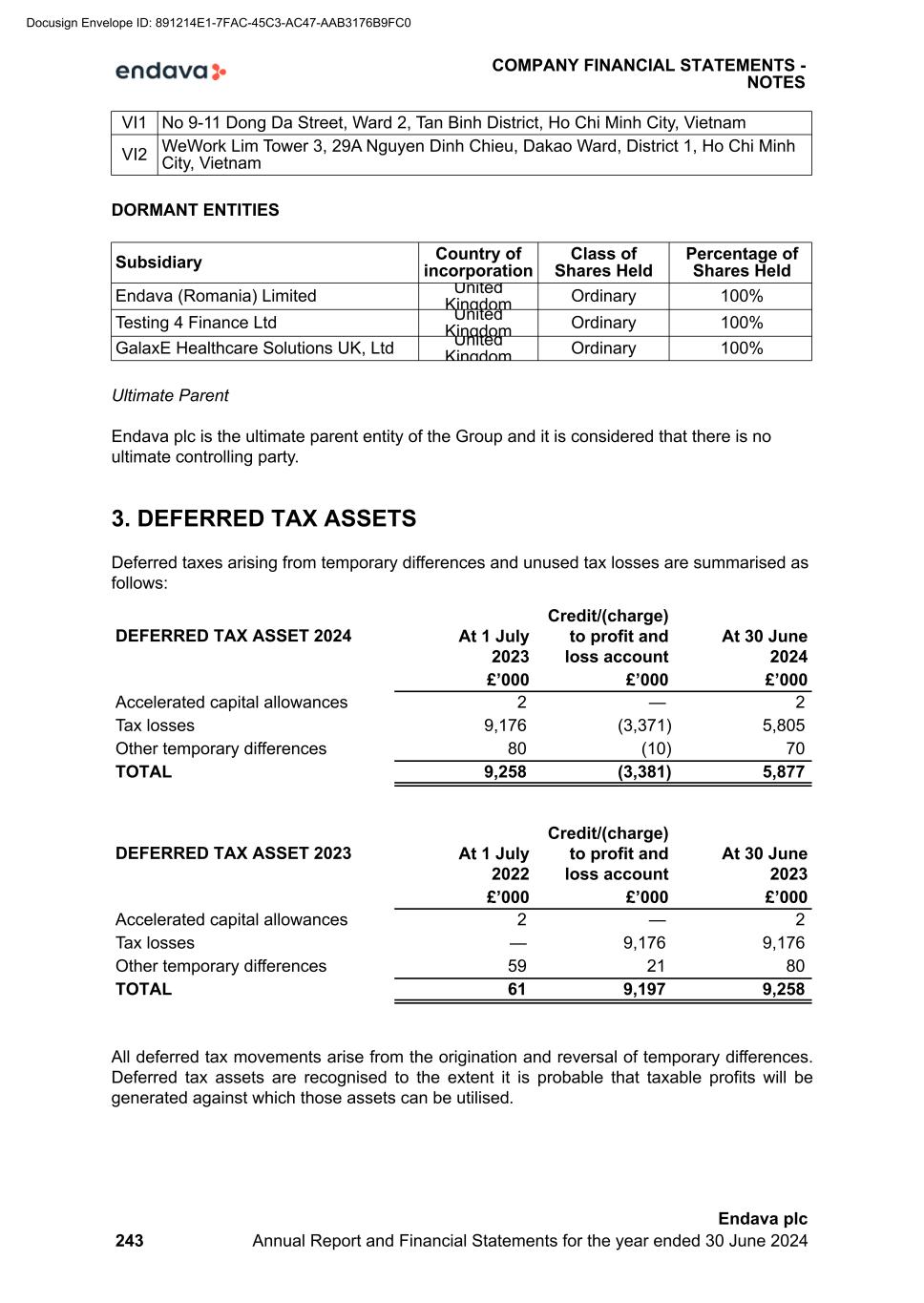
VI1 No 9-11 Dong Da Street, Ward 2, Tan Binh District, Ho Chi Minh City, Vietnam VI2 WeWork Lim Tower 3, 29A Nguyen Dinh Chieu, Dakao Ward, District 1, Ho Chi Minh City, Vietnam DORMANT ENTITIES Subsidiary Country of incorporation Class of Shares Held Percentage of Shares Held Endava (Romania) Limited United Kingdom Ordinary 100% Testing 4 Finance Ltd United Kingdom Ordinary 100% GalaxE Healthcare Solutions UK, Ltd United Kingdom Ordinary 100% Ultimate Parent Endava plc is the ultimate parent entity of the Group and it is considered that there is no ultimate controlling party. 3. DEFERRED TAX ASSETS Deferred taxes arising from temporary differences and unused tax losses are summarised as follows: DEFERRED TAX ASSET 2024 At 1 July 2023 Credit/(charge) to profit and loss account At 30 June 2024 £’000 £’000 £’000 Accelerated capital allowances 2 — 2 Tax losses 9,176 (3,371) 5,805 Other temporary differences 80 (10) 70 TOTAL 9,258 (3,381) 5,877 DEFERRED TAX ASSET 2023 At 1 July 2022 Credit/(charge) to profit and loss account At 30 June 2023 £’000 £’000 £’000 Accelerated capital allowances 2 — 2 Tax losses — 9,176 9,176 Other temporary differences 59 21 80 TOTAL 61 9,197 9,258 All deferred tax movements arise from the origination and reversal of temporary differences. Deferred tax assets are recognised to the extent it is probable that taxable profits will be generated against which those assets can be utilised. COMPANY FINANCIAL STATEMENTS - NOTES 243 Endava plc Annual Report and Financial Statements for the year ended 30 June 2024 Docusign Envelope ID: 891214E1-7FAC-45C3-AC47-AAB3176B9FC0

4. TRADE AND OTHER RECEIVABLES 2024 2023 £’000 £’000 Amounts owed by group undertakings 96,956 124,405 Prepayments 3,890 4,041 Other debtors 2,276 269 TOTAL TRADE AND OTHER RECEIVABLES 103,122 128,715 Amounts owed by group undertakings includes £84.0 million of current intercompany trade receivables which are non-interest bearing and repayable on demand. It also includes £13.0 million of current intercompany loans. Please refer to note 7 for further details. Amounts owed by group undertakings have been reviewed and no expected credit loss allowance is required to be made (2023: £nil). 5. TRADE AND OTHER PAYABLES-CURRENT 2024 2023 £’000 £’000 Trade payables 214 547 Amounts owed to group undertakings 99,719 70,894 Other taxation and social security 9,616 9,956 Other liabilities 384 — Accruals 2,893 2,849 TOTAL TRADE AND OTHER PAYABLES 112,826 84,246 Amounts owed to group undertakings includes £81.2 million of current intercompany payables which are non-interest bearing and repayable on demand. It also includes £18.5 million of current intercompany borrowings. Please refer to note 7 for further details. 6. DEFERRED AND CONTINGENT CONSIDERATION Deferred Consideration: 2024 2023 £’000 £’000 Deferred consideration payable within one year 5,066 1,267 Deferred consideration payable after more than one year — 4,837 TOTAL DEFERRED CONSIDERATION 5,066 6,104 COMPANY FINANCIAL STATEMENTS - NOTES 244 Endava plc Annual Report and Financial Statements for the year ended 30 June 2024 Docusign Envelope ID: 891214E1-7FAC-45C3-AC47-AAB3176B9FC0

Contingent Consideration: 2024 2023 £’000 £’000 Contingent consideration payable within one year 2,296 7,268 Contingent consideration payable after more than one year — 3,809 TOTAL CONTINGENT CONSIDERATION 2,296 11,077 Deferred and contingent consideration in balance as of 30 June 2024 relates to the acquisitions of DEK, Mudbath and Lexicon. Further information on these acquisitions is included in Note 15 of the Group financial statements. 7. FINANCIAL ASSETS AND LIABILITIES CATEGORIES OF FINANCIAL ASSETS AND FINANCIAL LIABILITIES Financial assets The Company has the following financial assets, all of which are classified and measured at amortised cost: FINANCIAL ASSETS 2024 2023 £’000 £’000 Amounts owed by Group undertakings 83,995 57,507 Intercompany loans - current 12,961 66,898 Intercompany loans - non current 81,202 85,217 Cash and cash equivalents 3,095 2,086 TOTAL FINANCIAL ASSETS 181,253 211,708 Intercompany loans - current relate to an interest-bearing loan owed by Endava Gmbh of £11.4 million (2023: £18.2 million) which matures in December 2024 and bears interest at a fixed rate of 4.64%, and a non-interest bearing loan owed by Dek Corporation Pty Ltd of £1.6 million (2023: £nil) which matures in September 2024. For details on non-current intercompany loans, refer to note 10. The Group accounting policies disclosed in the Group Financial Statements, provide a description of the initial recognition and measurement, and also the subsequent measurement of financial assets. Financial liabilities The Company has the following financial liabilities: COMPANY FINANCIAL STATEMENTS - NOTES 245 Endava plc Annual Report and Financial Statements for the year ended 30 June 2024 Docusign Envelope ID: 891214E1-7FAC-45C3-AC47-AAB3176B9FC0

FINANCIAL LIABILITIES 2024 2023 £’000 £’000 Financial liabilities at amortised cost: Borrowings 127,801 — Trade payables 214 547 Amounts owed to group undertakings 81,208 70,095 Intercompany borrowings 18,511 799 Accruals 2,893 2,849 Deferred consideration 5,066 6,104 235,693 80,394 Financial liabilities at fair value through profit or loss Contingent consideration 2,296 11,077 2,296 11,077 TOTAL FINANCIAL LIABILITIES 237,989 91,471 Intercompany borrowings relate to a non-interest bearing loan owed to Endava (UK) Limited of £17.7 million (2023: £nil) with rollover of the loan permissible at the discretion of the lender, and an interest-bearing loan owed to Endava LLC of £0.8 million (2023: £0.8 million) which matures in November 2024 and bears accrued interest at a rate with reference to the monthly average SOFR (Secured Overnight Financing Rate). The Group accounting policies disclosed in the Group Financial Statements, provide a description of the initial recognition and measurement, and also the subsequent measurement of financial liabilities. Where financial assets and financial liabilities are measured at fair value, their measurement should be classified into the following hierarchy: • Level 1 – quoted prices (unadjusted) in active markets for identical assets or liabilities. • Level 2 – inputs other than quoted prices included within Level 1 that are observable for the asset or liability, either directly (i.e. as prices) or indirectly (i.e. derived from prices). • Level 3 – inputs for the asset or liability that are not based on observable market data (unobservable inputs). Contingent consideration has been classified within level 3. The following table includes the roll forward schedule of contingent consideration during the year ended 30 June 2024: Contingent consideration Beginning of the year £’000 Additions £’000 Payments £'000 Remeasurement and discount unwind £'000 Foreign exchange impact £'000 End of the year £'000 2024 11,077 (2,372) (6,441) 32 2,296 COMPANY FINANCIAL STATEMENTS - NOTES 246 Endava plc Annual Report and Financial Statements for the year ended 30 June 2024 Docusign Envelope ID: 891214E1-7FAC-45C3-AC47-AAB3176B9FC0

8. BORROWINGS Terms and conditions of outstanding borrowings as of 30 June 2024 and 2023 are as follows: TYPE NOMINAL INTEREST p.a. YEAR OF MATURITY 2024 £’000 2023 £’000 Revolving Credit Facility SONIA/ EURIBOR/SOFR + variable margin (1.00% - 1.65%) 2027 127,801 — The Company has an unsecured, multi-currency bank revolving credit facility with a carrying amount of £127.8m at 30 June 2024 (2023: £nil). Commitment fees are charged on the undrawn balance of the facility. The available borrowing capacity under the Group's revolving credit facility is £350.0 million less utilised ancillary facilities (HSBC bank guarantees: £2.2 million at 30 June 2024 and £8.8 million at 30 June 2023). The HSBC bank guarantees primarily relate to a performance bond related to a fixed price contract in Germany and various lease guarantees. The facility contains interest cover and net leverage financial covenants. The covenants are tested on a bi-annual basis based on trailing twelve months results. At 30 June 2024 and 30 June 2023, the Group complied with these financial covenants. Guarantees The Group has provided the following guarantees at 30 June 2024: Parent Company Guarantees The parent company provided guarantees relating to certain leases entered into by Endava Romania SRL in Romania and ICS Endava SRL in Moldova. In the fiscal year ended 30 June 2024, the parent company also provided a guarantee under the Merger Agreement with respect to the obligations to be fulfilled by Endava Delaware Inc. under that agreement. No claims are expected to arise from the above guarantees. For the year ended 30 June 2023, the parent company provided guarantees relating to certain leases entered into by Endava Romania SRL in Romania and ICS Endava SRL in Moldova. Bank Guarantees Endava GmbH provided a performance guarantee of €2.0 million in favour of DB Fernverkehr AG in relation to a contract with Deutsche Bahn to provide their Video On Demand experience for passengers. Additionally, various other subsidiaries provided bank guarantees in relation to their leases of office space together with a small number of performance guarantees. No claims are expected to arise from above guarantees. For year ended 30 June 2023, Endava (UK) Ltd provided a holdback guarantee of €6.0 million in favour of Comtrade Group B.V. as part of the acquisition of CDS. COMPANY FINANCIAL STATEMENTS - NOTES 247 Endava plc Annual Report and Financial Statements for the year ended 30 June 2024 Docusign Envelope ID: 891214E1-7FAC-45C3-AC47-AAB3176B9FC0
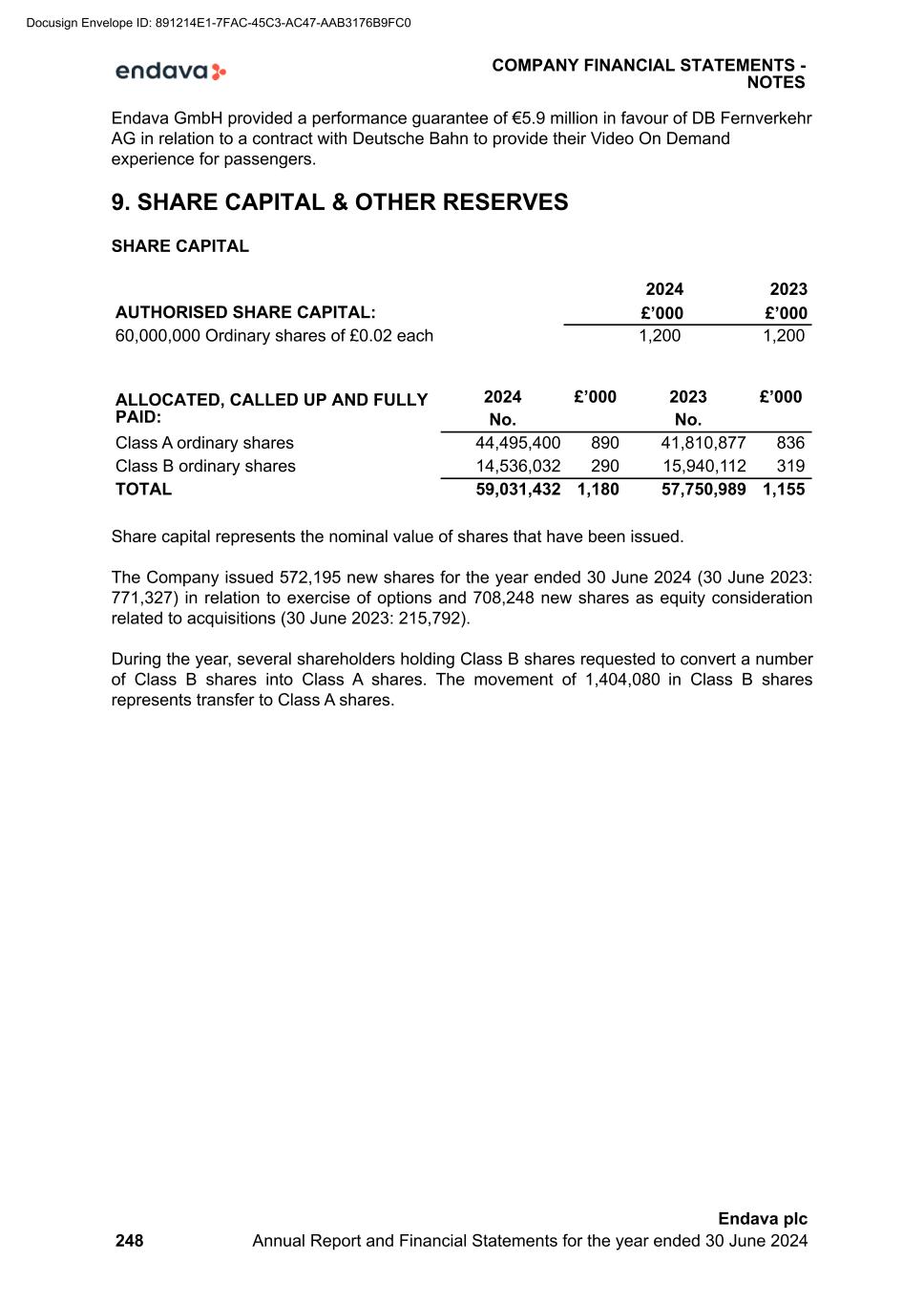
Endava GmbH provided a performance guarantee of €5.9 million in favour of DB Fernverkehr AG in relation to a contract with Deutsche Bahn to provide their Video On Demand experience for passengers. 9. SHARE CAPITAL & OTHER RESERVES SHARE CAPITAL 2024 2023 AUTHORISED SHARE CAPITAL: £’000 £’000 60,000,000 Ordinary shares of £0.02 each 1,200 1,200 ALLOCATED, CALLED UP AND FULLY PAID: 2024 £’000 2023 £’000 No. No. Class A ordinary shares 44,495,400 890 41,810,877 836 Class B ordinary shares 14,536,032 290 15,940,112 319 TOTAL 59,031,432 1,180 57,750,989 1,155 Share capital represents the nominal value of shares that have been issued. The Company issued 572,195 new shares for the year ended 30 June 2024 (30 June 2023: 771,327) in relation to exercise of options and 708,248 new shares as equity consideration related to acquisitions (30 June 2023: 215,792). During the year, several shareholders holding Class B shares requested to convert a number of Class B shares into Class A shares. The movement of 1,404,080 in Class B shares represents transfer to Class A shares. COMPANY FINANCIAL STATEMENTS - NOTES 248 Endava plc Annual Report and Financial Statements for the year ended 30 June 2024 Docusign Envelope ID: 891214E1-7FAC-45C3-AC47-AAB3176B9FC0
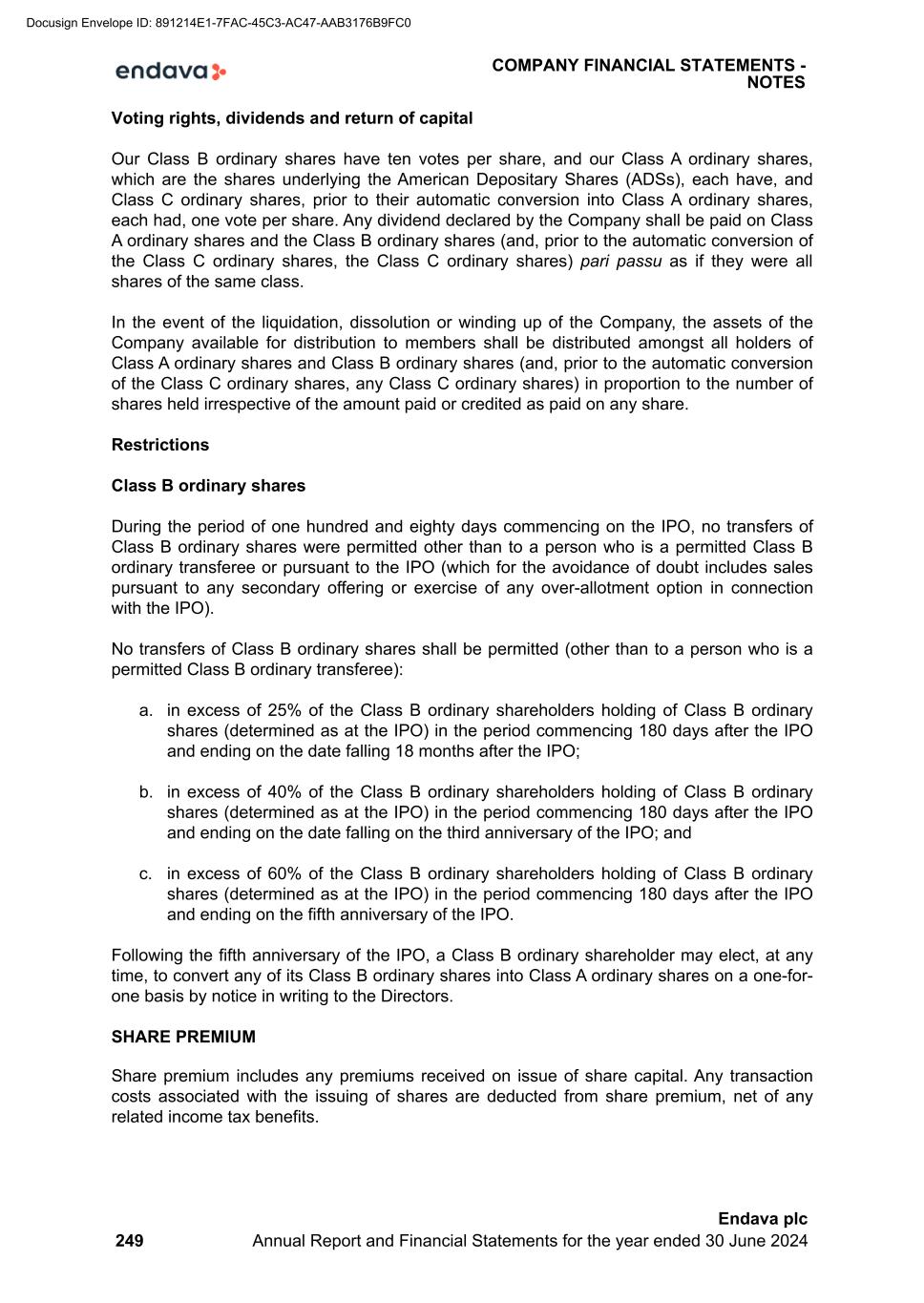
Voting rights, dividends and return of capital Our Class B ordinary shares have ten votes per share, and our Class A ordinary shares, which are the shares underlying the American Depositary Shares (ADSs), each have, and Class C ordinary shares, prior to their automatic conversion into Class A ordinary shares, each had, one vote per share. Any dividend declared by the Company shall be paid on Class A ordinary shares and the Class B ordinary shares (and, prior to the automatic conversion of the Class C ordinary shares, the Class C ordinary shares) pari passu as if they were all shares of the same class. In the event of the liquidation, dissolution or winding up of the Company, the assets of the Company available for distribution to members shall be distributed amongst all holders of Class A ordinary shares and Class B ordinary shares (and, prior to the automatic conversion of the Class C ordinary shares, any Class C ordinary shares) in proportion to the number of shares held irrespective of the amount paid or credited as paid on any share. Restrictions Class B ordinary shares During the period of one hundred and eighty days commencing on the IPO, no transfers of Class B ordinary shares were permitted other than to a person who is a permitted Class B ordinary transferee or pursuant to the IPO (which for the avoidance of doubt includes sales pursuant to any secondary offering or exercise of any over-allotment option in connection with the IPO). No transfers of Class B ordinary shares shall be permitted (other than to a person who is a permitted Class B ordinary transferee): a. in excess of 25% of the Class B ordinary shareholders holding of Class B ordinary shares (determined as at the IPO) in the period commencing 180 days after the IPO and ending on the date falling 18 months after the IPO; b. in excess of 40% of the Class B ordinary shareholders holding of Class B ordinary shares (determined as at the IPO) in the period commencing 180 days after the IPO and ending on the date falling on the third anniversary of the IPO; and c. in excess of 60% of the Class B ordinary shareholders holding of Class B ordinary shares (determined as at the IPO) in the period commencing 180 days after the IPO and ending on the fifth anniversary of the IPO. Following the fifth anniversary of the IPO, a Class B ordinary shareholder may elect, at any time, to convert any of its Class B ordinary shares into Class A ordinary shares on a one-for- one basis by notice in writing to the Directors. SHARE PREMIUM Share premium includes any premiums received on issue of share capital. Any transaction costs associated with the issuing of shares are deducted from share premium, net of any related income tax benefits. COMPANY FINANCIAL STATEMENTS - NOTES 249 Endava plc Annual Report and Financial Statements for the year ended 30 June 2024 Docusign Envelope ID: 891214E1-7FAC-45C3-AC47-AAB3176B9FC0
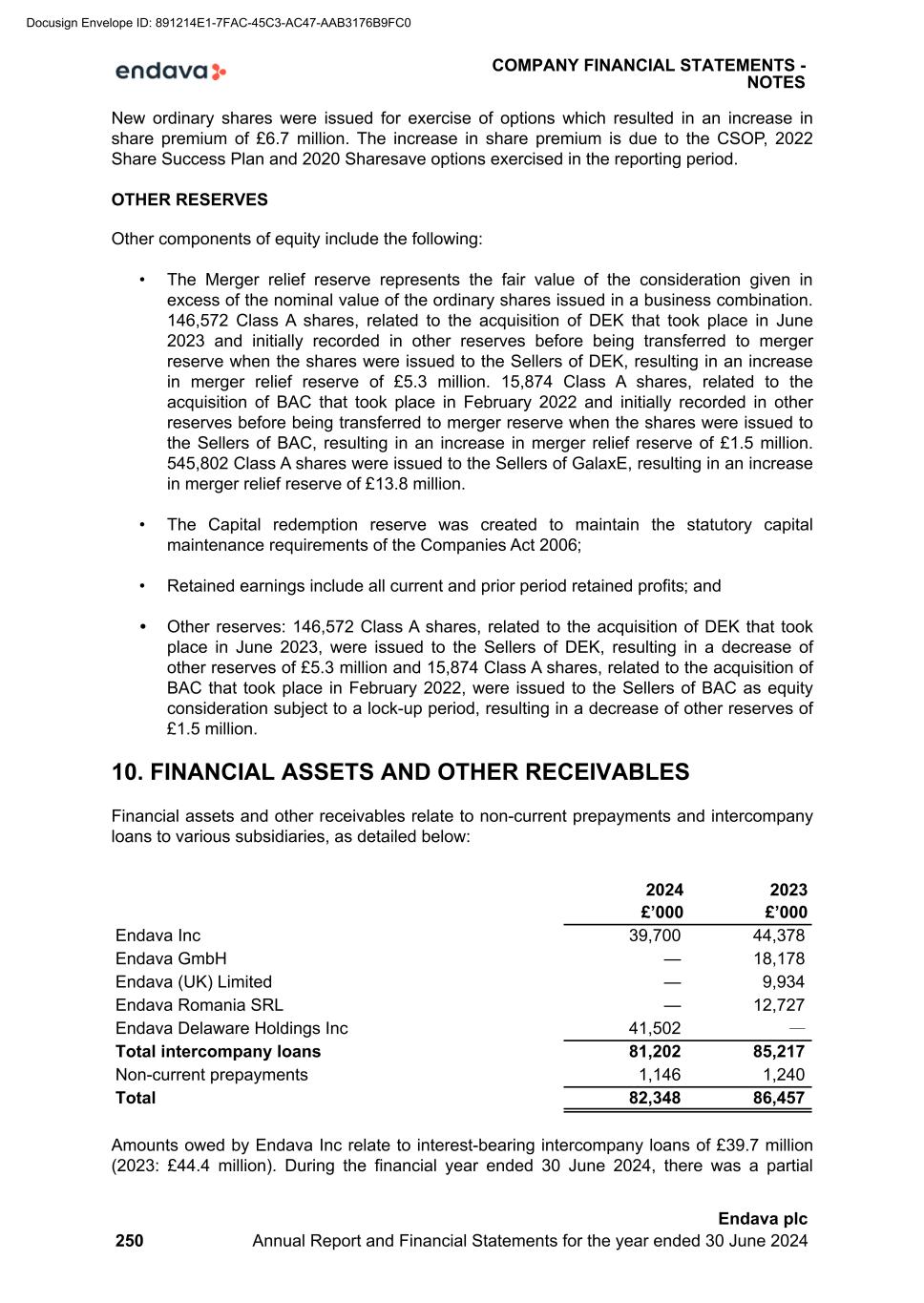
New ordinary shares were issued for exercise of options which resulted in an increase in share premium of £6.7 million. The increase in share premium is due to the CSOP, 2022 Share Success Plan and 2020 Sharesave options exercised in the reporting period. OTHER RESERVES Other components of equity include the following: • The Merger relief reserve represents the fair value of the consideration given in excess of the nominal value of the ordinary shares issued in a business combination. 146,572 Class A shares, related to the acquisition of DEK that took place in June 2023 and initially recorded in other reserves before being transferred to merger reserve when the shares were issued to the Sellers of DEK, resulting in an increase in merger relief reserve of £5.3 million. 15,874 Class A shares, related to the acquisition of BAC that took place in February 2022 and initially recorded in other reserves before being transferred to merger reserve when the shares were issued to the Sellers of BAC, resulting in an increase in merger relief reserve of £1.5 million. 545,802 Class A shares were issued to the Sellers of GalaxE, resulting in an increase in merger relief reserve of £13.8 million. • The Capital redemption reserve was created to maintain the statutory capital maintenance requirements of the Companies Act 2006; • Retained earnings include all current and prior period retained profits; and • Other reserves: 146,572 Class A shares, related to the acquisition of DEK that took place in June 2023, were issued to the Sellers of DEK, resulting in a decrease of other reserves of £5.3 million and 15,874 Class A shares, related to the acquisition of BAC that took place in February 2022, were issued to the Sellers of BAC as equity consideration subject to a lock-up period, resulting in a decrease of other reserves of £1.5 million. 10. FINANCIAL ASSETS AND OTHER RECEIVABLES Financial assets and other receivables relate to non-current prepayments and intercompany loans to various subsidiaries, as detailed below: 2024 2023 £’000 £’000 Endava Inc 39,700 44,378 Endava GmbH — 18,178 Endava (UK) Limited — 9,934 Endava Romania SRL — 12,727 Endava Delaware Holdings Inc 41,502 — Total intercompany loans 81,202 85,217 Non-current prepayments 1,146 1,240 Total 82,348 86,457 Amounts owed by Endava Inc relate to interest-bearing intercompany loans of £39.7 million (2023: £44.4 million). During the financial year ended 30 June 2024, there was a partial COMPANY FINANCIAL STATEMENTS - NOTES 250 Endava plc Annual Report and Financial Statements for the year ended 30 June 2024 Docusign Envelope ID: 891214E1-7FAC-45C3-AC47-AAB3176B9FC0

reimbursement of the loan from Endava Inc to Endava plc resulting in the loan balance outstanding being reduced by £4.7 million. The £39.7 million is made up of a 7-year loan of £20 million (2023: £24.6 million) which matures in March 2028 and bears interest at a fixed rate of 4.8%, and a 5-year loan of £19.7 million (2023: £19.8 million) which matures in March 2026 and bears interest at a fixed rate of 4.50%. Amounts owed by Endava Delaware Holdings Inc relate to interest-bearing intercompany loans of £41.5 million (2023: £nil). This balance of £41.5 million consists of a 7-year loan of £40.6 million (2023: £nil) which matures in April 2031 and bears interest at a fixed rate of 7.3%, and a 7-year loan of £0.9 million (2023: £nil) which matures in June 2031 and bears interest at a fixed rate of 7.3%. The amounts owed by Endava GmbH and Endava Romania SRL, which were disclosed as non-current assets in the prior year, were repaid to Endava plc earlier than their due date within the year, hence why there is a nil balance outstanding as at 30 June 2024. The amounts owed by Endava (UK) Limited, which were disclosed as non-current assets in the prior year, were settled with Endava plc earlier than their due date within the year, hence why there is a nil balance outstanding as at 30 June 2024. Intercompany loans classified as non-current assets have been disclosed as such on the basis that repayment is not expected to occur prior to their due date, which is a period in excess of 12 months of 30 June 2024 in each case. Amounts owed by group undertakings have been reviewed and no expected credit loss allowance is required to be made (2023: £nil). 11. PARTICULARS OF EMPLOYEES (INCLUDING DIRECTORS) No employees are directly employed by Endava Plc. The aggregate payroll costs included in the Company financial statements during the year are £nil (2023: £nil). Details in relation to key management remuneration are included in Note 8 of the Group Financial Statements. 12. SUBSEQUENT EVENTS There were no significant subsequent events from the end of the financial year to the date of signing of this report that would require adjustment to or disclosure in the financial statements. COMPANY FINANCIAL STATEMENTS - NOTES 251 Endava plc Annual Report and Financial Statements for the year ended 30 June 2024 Docusign Envelope ID: 891214E1-7FAC-45C3-AC47-AAB3176B9FC0